Principal Components of All Data
More Plot Information
This module generates a series of high level plots that describe the data overall and may be useful for identifying anomalous data and/or covariates.
- Heatmaps
- PCA
- Study design
- Other QC
Heatmap of Raw Data
More Plot Information Detected/undetected calls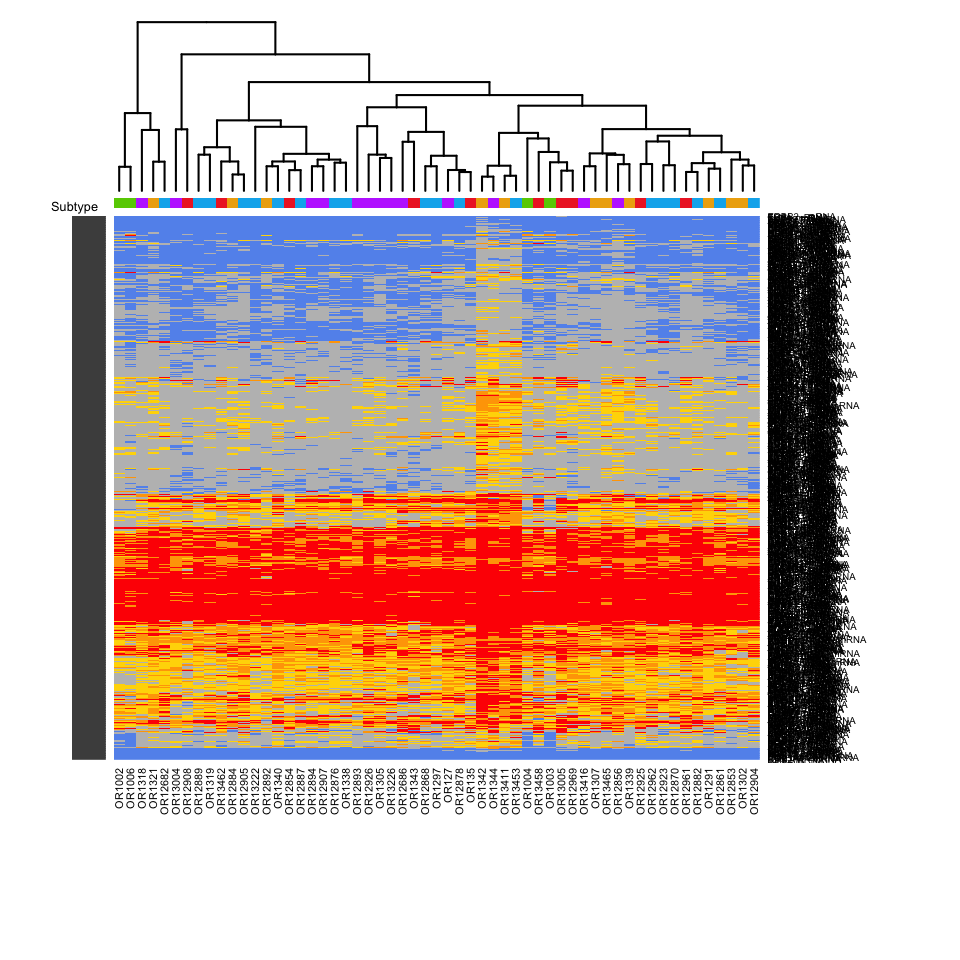
Heatmap of Raw Data
Heatmap of the raw counts. The plot is meant to provide an overview of how robust the raw expression levels are across samples and gene sets. Datasets that entirely lack higher level expressions (e.g. counts > 100) may indicate experimental failure or low input. The detected/undetected calls links to a .csv file stating whether each probe is above background, with 0/1 indicating below/above background. If the user has not specified a detection threshold, probes are called detected if they have more than double the counts of the median negative control.
Heatmap of All Data
More Plot Information
Heatmap of All Data
Heatmap of the normalized data, scaled to give all genes equal variance, generated via unsupervised clustering. Orange indicates high expression; blue indicates low expression. This plot is meant to provide a high level exploratory view of the data.
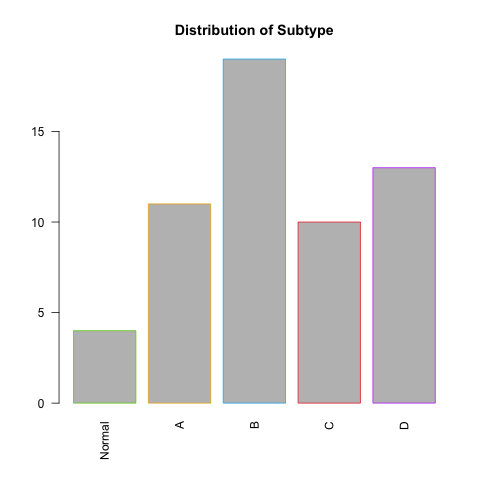
Pairwise comparisons of all covariates in the analysis. The type of plot is dependent on the types of variables compared; A categorical vs. categorical covariate plot is shown as a bar chart of counts (Y axis). Continuous vs. categorical covariates generate a boxplot with whiskers denoting 1.5 IQR. Continuous vs. continuous covariates are compared via a scatter plot. Variables that are correlated with a biological variable of interest are potential confounders that may influence downstream analyses. Additionally, bar plots and histograms show the distributions of categorical and continuous variables, respectively.
Variance vs. Mean normalized signal plot across all targets/probes
More Plot Information Mean and Variance statistics across all genes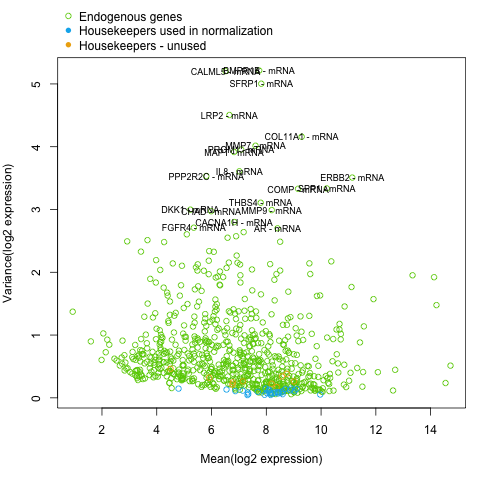
Variance vs. Mean normalized signal plot across all targets/probes
Each gene's variance in the log-scaled, normalized data is plotted against its mean value across all samples. Highly variable genes are indicated by gene name. Housekeeping genes are color coded according to their use in (or omission from) normalization.
p-value distribution plots
More Plot Information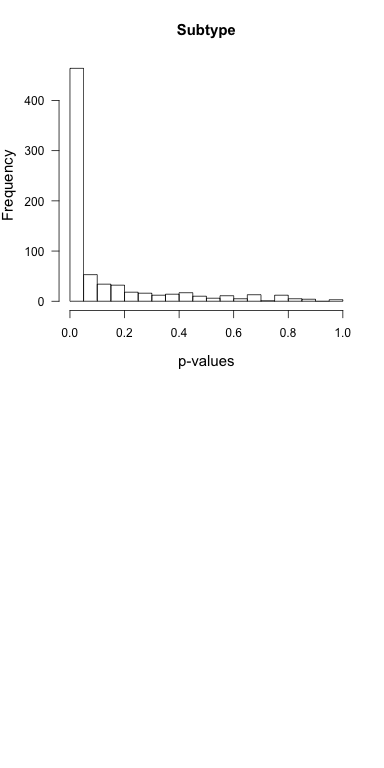
p-value distribution plots
For each covariate included in the analysis, a histogram of p-values testing each gene's univariate association with the chosen covariate is displayed. Covariates with largely flat histograms have minimal association with gene expression; covariates with histograms with significantly more mass on the left are either associated with the expression of many genes or are confounded with a covariate that is associated with the expression. Low p-values indicate strong evidence for an association.
- Heatmaps
- PCA
Heatmap of CC.PLS.Apop Data
More Plot Information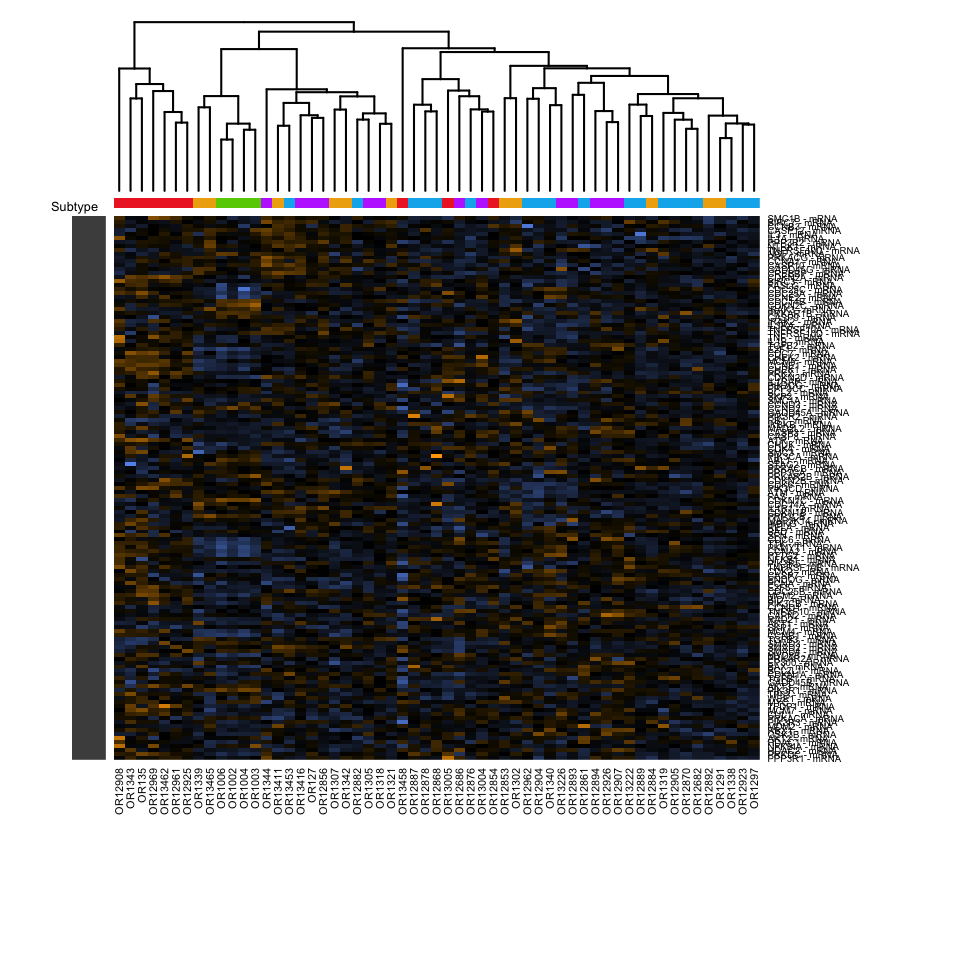
Heatmap of CC.PLS.Apop Data
Heatmap of the normalized data, scaled to give all genes equal variance, generated via unsupervised clustering. Orange indicates high expression; blue indicates low expression. This plot is meant to provide a high level exploratory view of the data.
Principal Components of CC.PLS.Apop Data
More Plot Information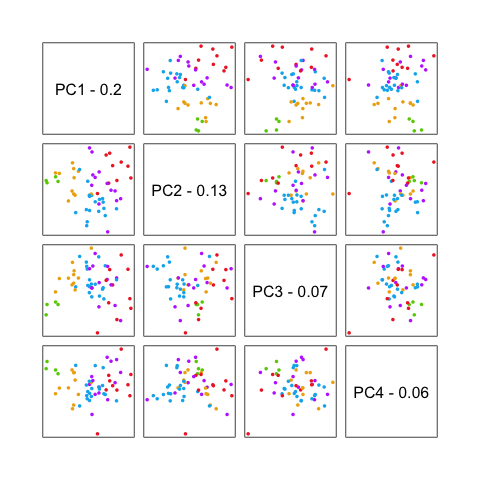
Principal Components of CC.PLS.Apop Data
Principal component analysis maps high-dimensional datasets onto a smaller number of highly informative dimensions. Here, the first four principal components of the gene expression data are plotted against each other and colored by the values of the selected covariate. This plot may be used to identify clusters in the data and to identify variables associated with prominent signal in the data. Variables that are associated with these leading principal components should be considered in downstream analyses.
- Heatmaps
- PCA
Heatmap of ChromMod Data
More Plot Information
Heatmap of ChromMod Data
Heatmap of the normalized data, scaled to give all genes equal variance, generated via unsupervised clustering. Orange indicates high expression; blue indicates low expression. This plot is meant to provide a high level exploratory view of the data.
Principal Components of ChromMod Data
More Plot Information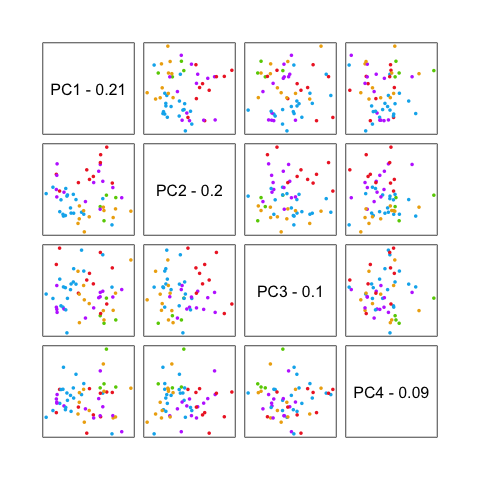
Principal Components of ChromMod Data
Principal component analysis maps high-dimensional datasets onto a smaller number of highly informative dimensions. Here, the first four principal components of the gene expression data are plotted against each other and colored by the values of the selected covariate. This plot may be used to identify clusters in the data and to identify variables associated with prominent signal in the data. Variables that are associated with these leading principal components should be considered in downstream analyses.
- Heatmaps
- PCA
Heatmap of DNARepair Data
More Plot Information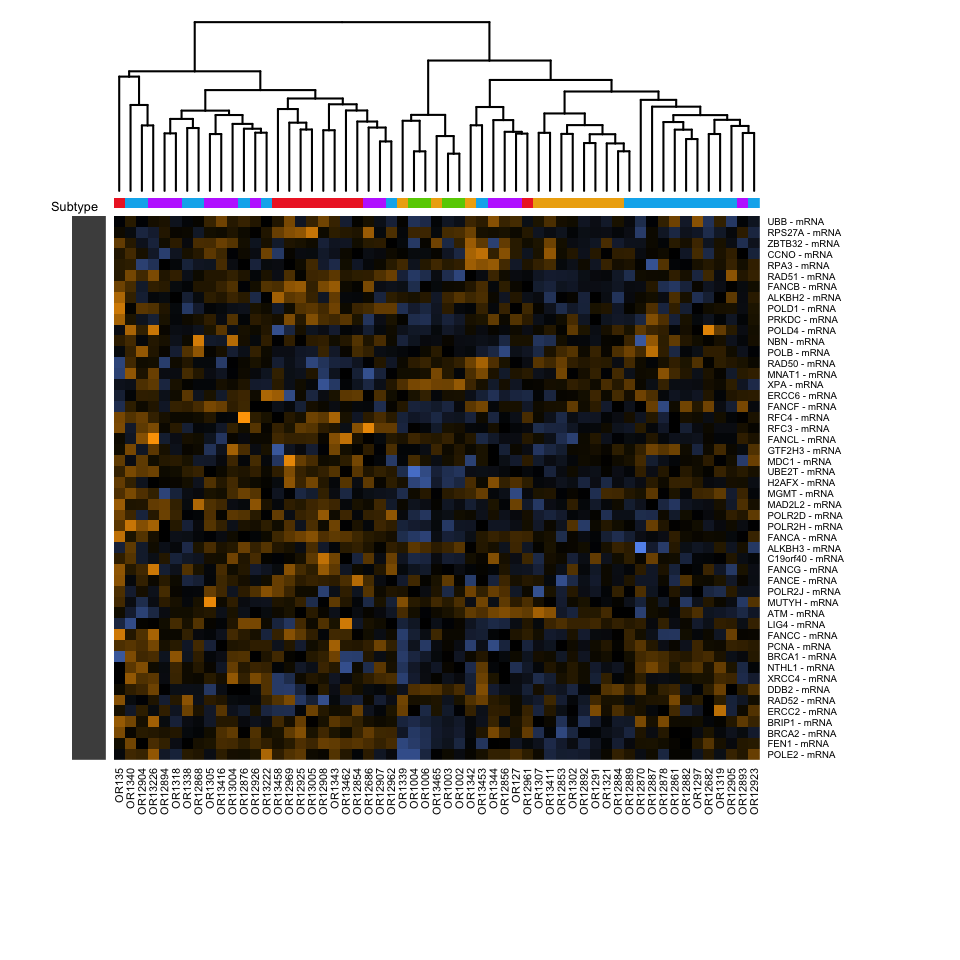
Heatmap of DNARepair Data
Heatmap of the normalized data, scaled to give all genes equal variance, generated via unsupervised clustering. Orange indicates high expression; blue indicates low expression. This plot is meant to provide a high level exploratory view of the data.
Principal Components of DNARepair Data
More Plot Information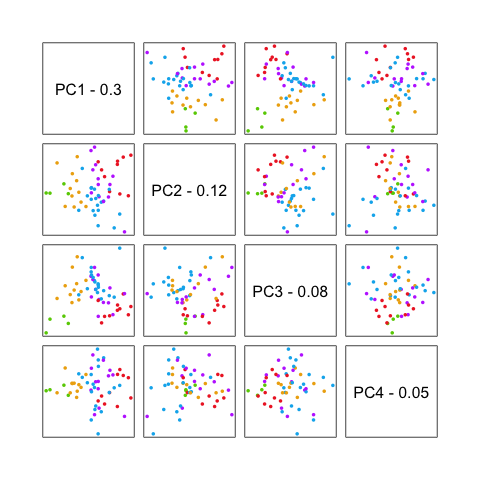
Principal Components of DNARepair Data
Principal component analysis maps high-dimensional datasets onto a smaller number of highly informative dimensions. Here, the first four principal components of the gene expression data are plotted against each other and colored by the values of the selected covariate. This plot may be used to identify clusters in the data and to identify variables associated with prominent signal in the data. Variables that are associated with these leading principal components should be considered in downstream analyses.
- Heatmaps
- PCA
Heatmap of Driver Gene Data
More Plot Information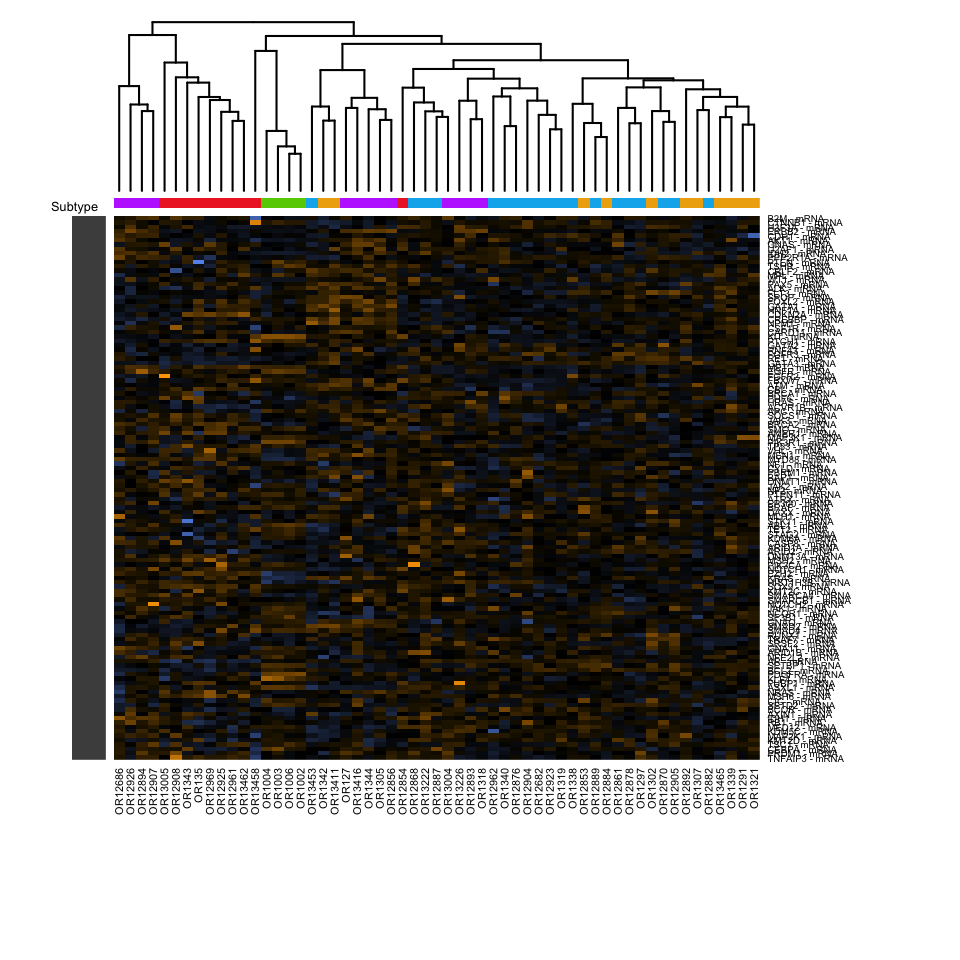
Heatmap of Driver Gene Data
Heatmap of the normalized data, scaled to give all genes equal variance, generated via unsupervised clustering. Orange indicates high expression; blue indicates low expression. This plot is meant to provide a high level exploratory view of the data.
Principal Components of Driver Gene Data
More Plot Information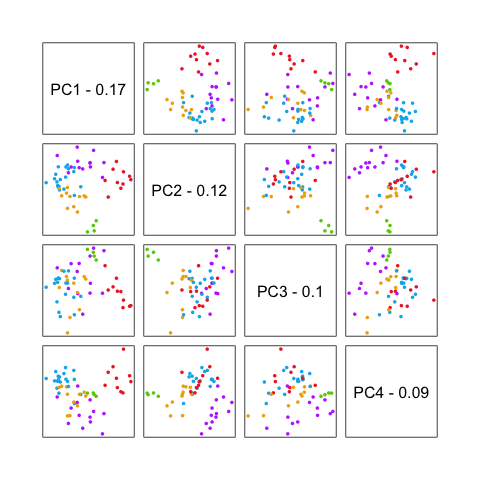
Principal Components of Driver Gene Data
Principal component analysis maps high-dimensional datasets onto a smaller number of highly informative dimensions. Here, the first four principal components of the gene expression data are plotted against each other and colored by the values of the selected covariate. This plot may be used to identify clusters in the data and to identify variables associated with prominent signal in the data. Variables that are associated with these leading principal components should be considered in downstream analyses.
- Heatmaps
- PCA
Heatmap of HH Data
More Plot Information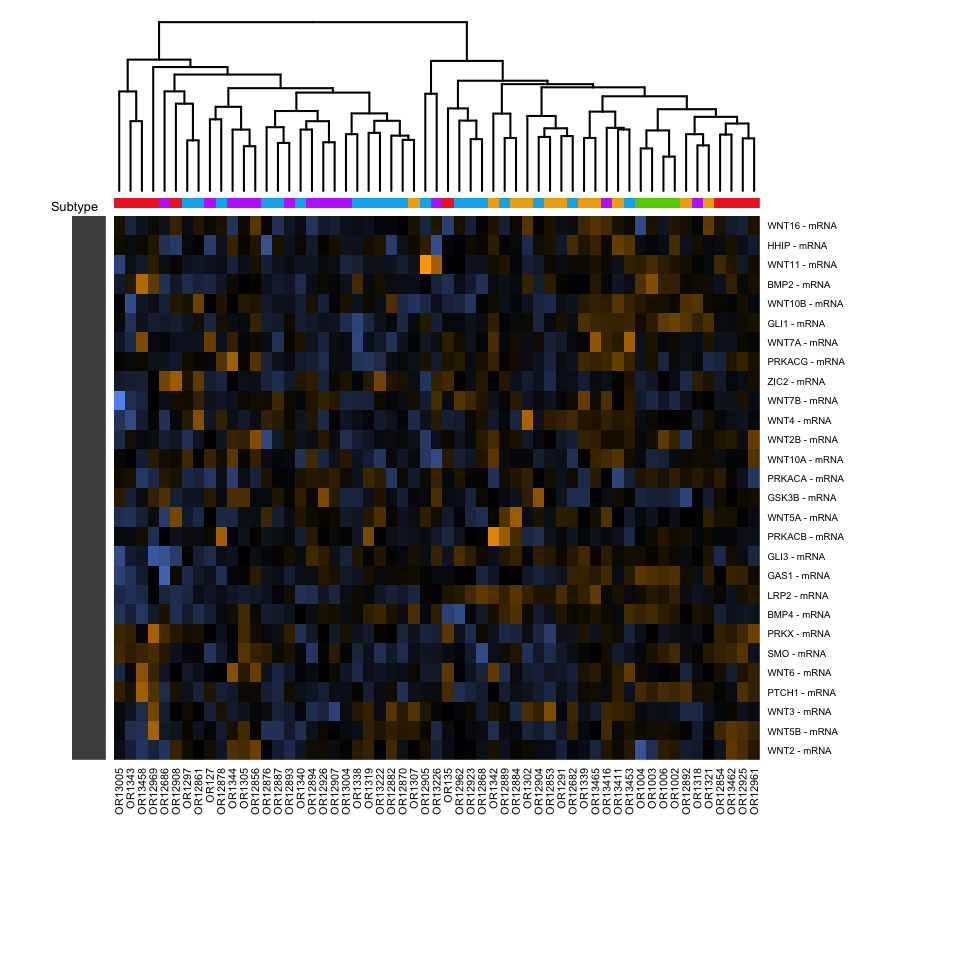
Heatmap of HH Data
Heatmap of the normalized data, scaled to give all genes equal variance, generated via unsupervised clustering. Orange indicates high expression; blue indicates low expression. This plot is meant to provide a high level exploratory view of the data.
Principal Components of HH Data
More Plot Information
Principal Components of HH Data
Principal component analysis maps high-dimensional datasets onto a smaller number of highly informative dimensions. Here, the first four principal components of the gene expression data are plotted against each other and colored by the values of the selected covariate. This plot may be used to identify clusters in the data and to identify variables associated with prominent signal in the data. Variables that are associated with these leading principal components should be considered in downstream analyses.
- Heatmaps
- PCA
Heatmap of JAK-STAT Data
More Plot Information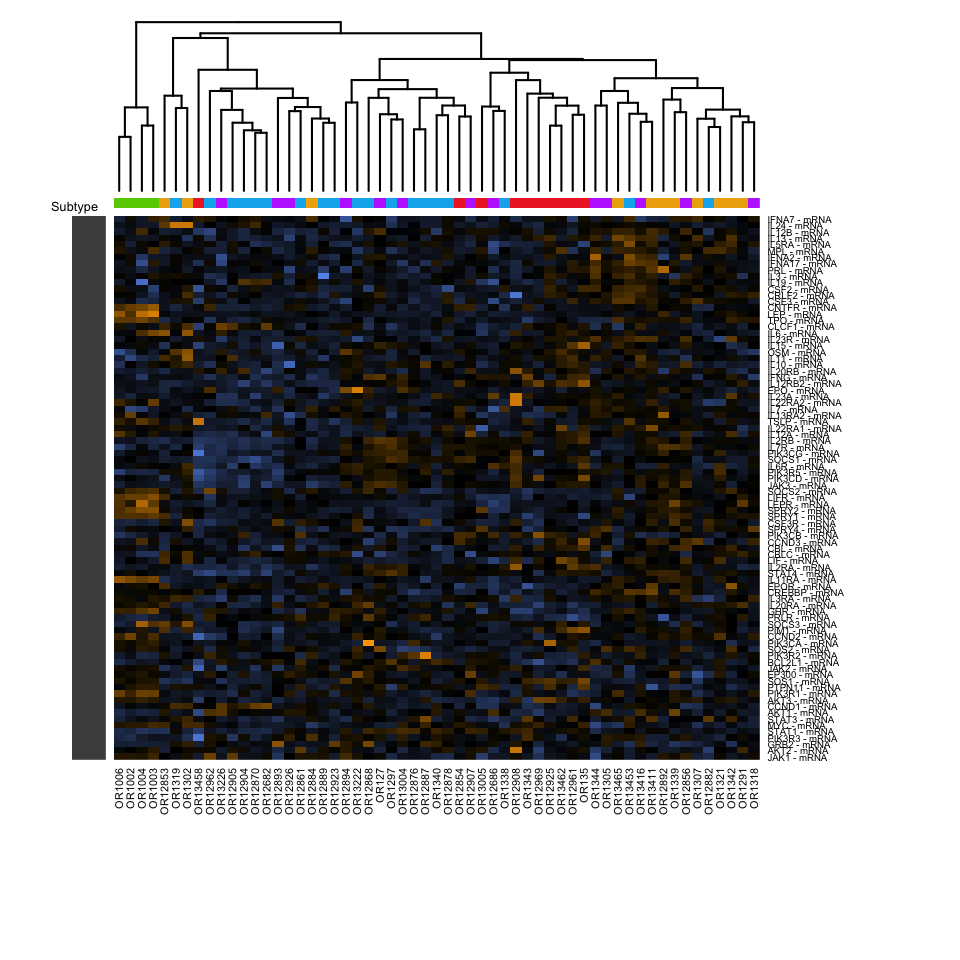
Heatmap of JAK-STAT Data
Heatmap of the normalized data, scaled to give all genes equal variance, generated via unsupervised clustering. Orange indicates high expression; blue indicates low expression. This plot is meant to provide a high level exploratory view of the data.
Principal Components of JAK-STAT Data
More Plot Information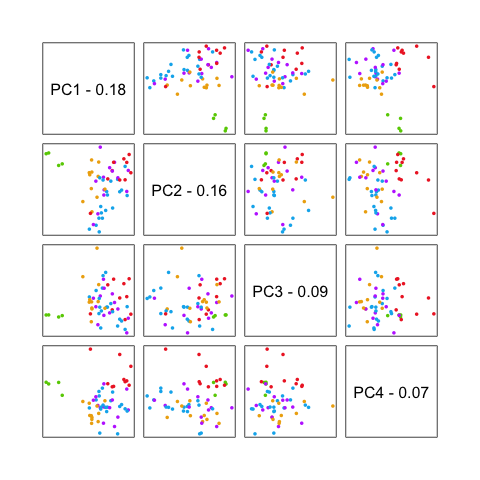
Principal Components of JAK-STAT Data
Principal component analysis maps high-dimensional datasets onto a smaller number of highly informative dimensions. Here, the first four principal components of the gene expression data are plotted against each other and colored by the values of the selected covariate. This plot may be used to identify clusters in the data and to identify variables associated with prominent signal in the data. Variables that are associated with these leading principal components should be considered in downstream analyses.
- Heatmaps
- PCA
Heatmap of MAPK Data
More Plot Information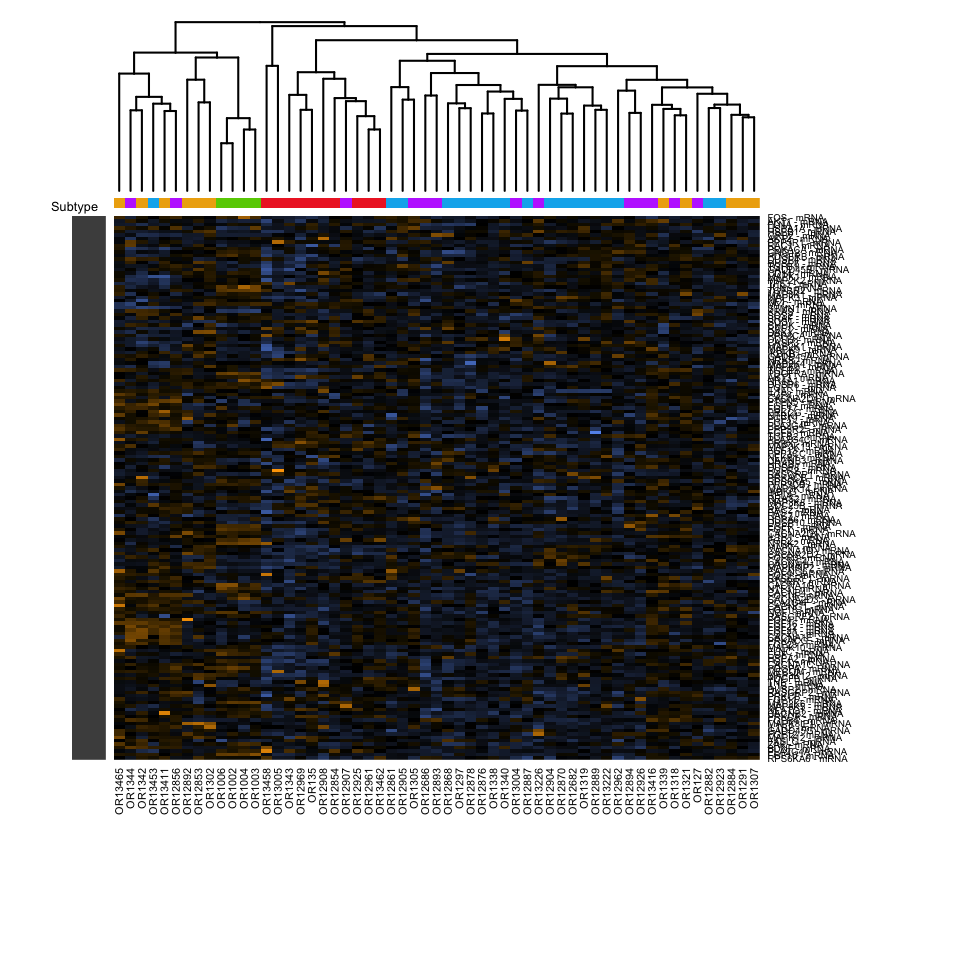
Heatmap of MAPK Data
Heatmap of the normalized data, scaled to give all genes equal variance, generated via unsupervised clustering. Orange indicates high expression; blue indicates low expression. This plot is meant to provide a high level exploratory view of the data.
Principal Components of MAPK Data
More Plot Information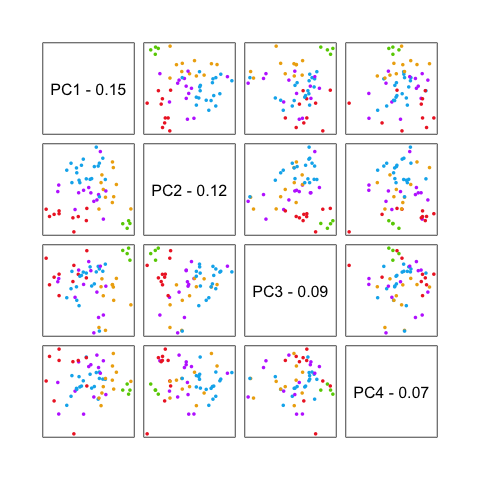
Principal Components of MAPK Data
Principal component analysis maps high-dimensional datasets onto a smaller number of highly informative dimensions. Here, the first four principal components of the gene expression data are plotted against each other and colored by the values of the selected covariate. This plot may be used to identify clusters in the data and to identify variables associated with prominent signal in the data. Variables that are associated with these leading principal components should be considered in downstream analyses.
- Heatmaps
- PCA
Heatmap of Notch Data
More Plot Information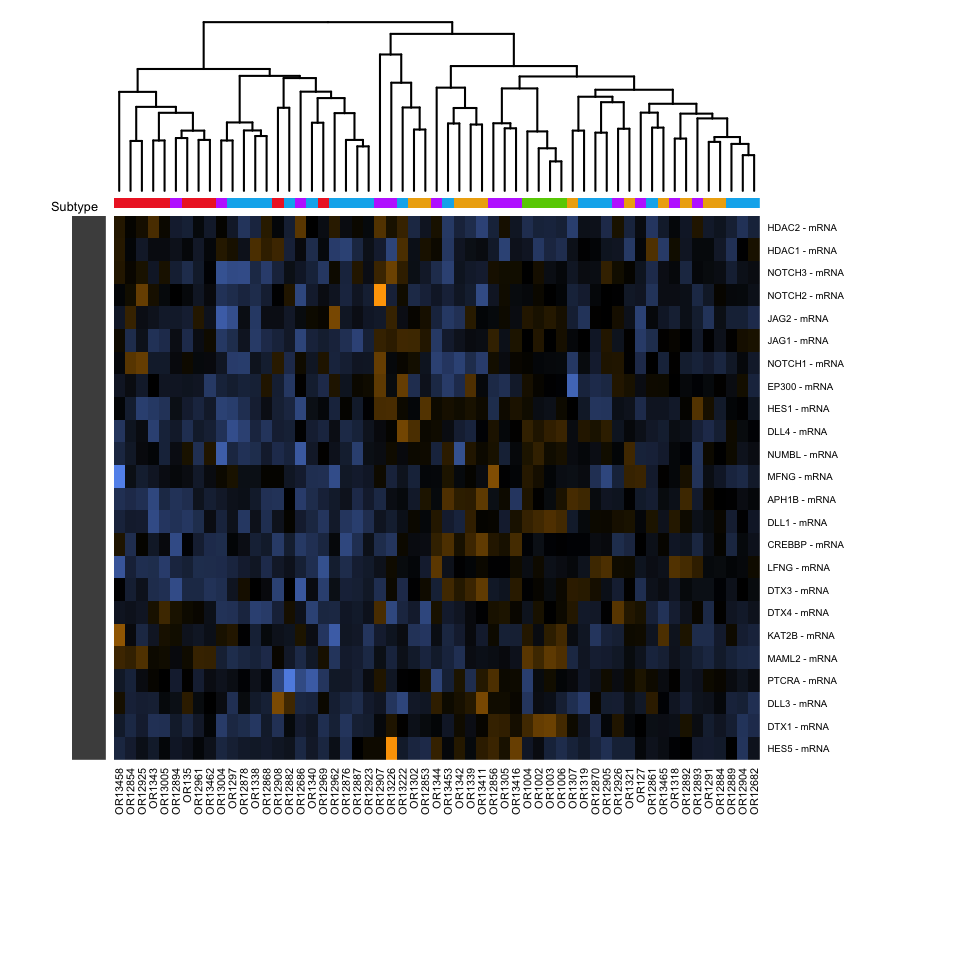
Heatmap of Notch Data
Heatmap of the normalized data, scaled to give all genes equal variance, generated via unsupervised clustering. Orange indicates high expression; blue indicates low expression. This plot is meant to provide a high level exploratory view of the data.
Principal Components of Notch Data
More Plot Information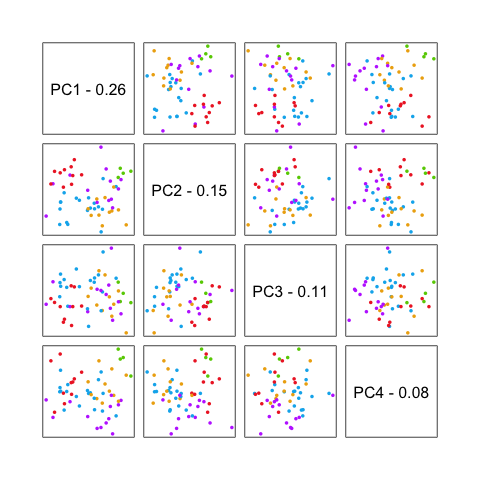
Principal Components of Notch Data
Principal component analysis maps high-dimensional datasets onto a smaller number of highly informative dimensions. Here, the first four principal components of the gene expression data are plotted against each other and colored by the values of the selected covariate. This plot may be used to identify clusters in the data and to identify variables associated with prominent signal in the data. Variables that are associated with these leading principal components should be considered in downstream analyses.
- Heatmaps
- PCA
Heatmap of PI3K Data
More Plot Information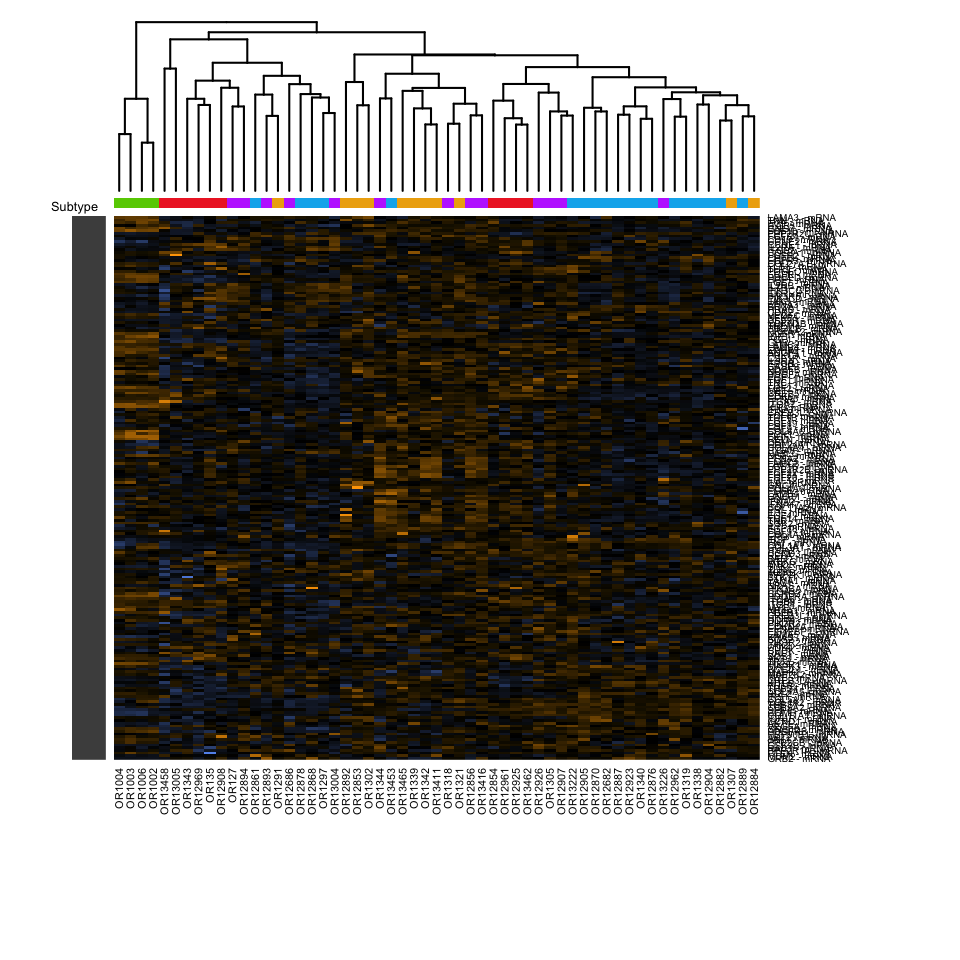
Heatmap of PI3K Data
Heatmap of the normalized data, scaled to give all genes equal variance, generated via unsupervised clustering. Orange indicates high expression; blue indicates low expression. This plot is meant to provide a high level exploratory view of the data.
Principal Components of PI3K Data
More Plot Information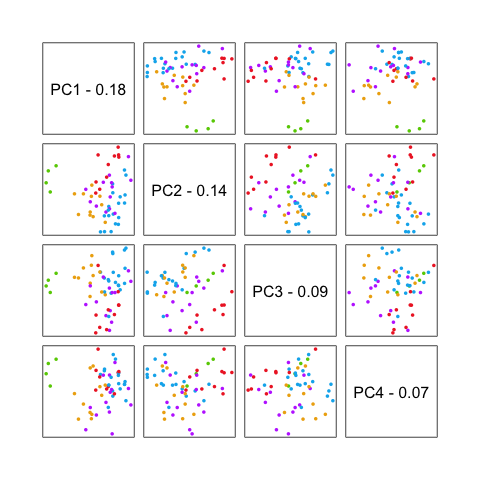
Principal Components of PI3K Data
Principal component analysis maps high-dimensional datasets onto a smaller number of highly informative dimensions. Here, the first four principal components of the gene expression data are plotted against each other and colored by the values of the selected covariate. This plot may be used to identify clusters in the data and to identify variables associated with prominent signal in the data. Variables that are associated with these leading principal components should be considered in downstream analyses.
- Heatmaps
- PCA
Heatmap of RAS Data
More Plot Information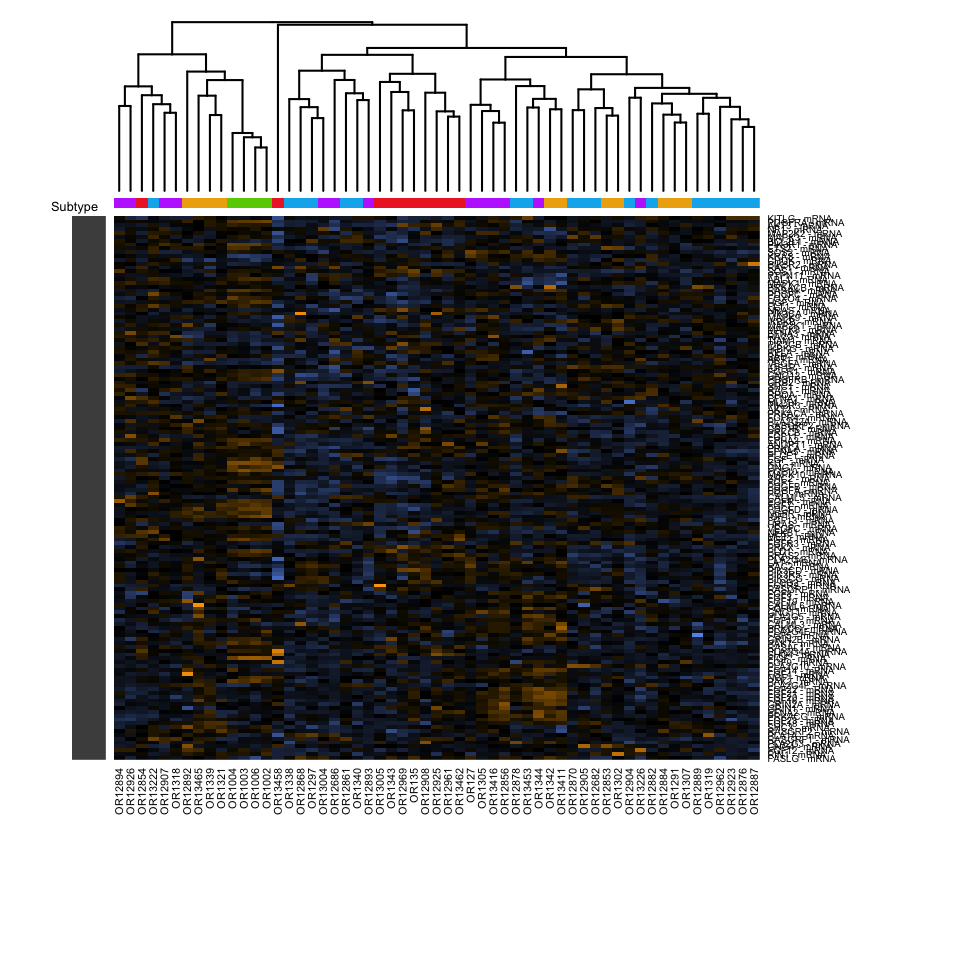
Heatmap of RAS Data
Heatmap of the normalized data, scaled to give all genes equal variance, generated via unsupervised clustering. Orange indicates high expression; blue indicates low expression. This plot is meant to provide a high level exploratory view of the data.
Principal Components of RAS Data
More Plot Information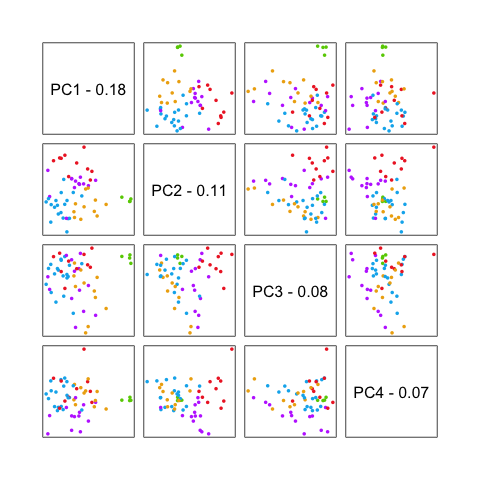
Principal Components of RAS Data
Principal component analysis maps high-dimensional datasets onto a smaller number of highly informative dimensions. Here, the first four principal components of the gene expression data are plotted against each other and colored by the values of the selected covariate. This plot may be used to identify clusters in the data and to identify variables associated with prominent signal in the data. Variables that are associated with these leading principal components should be considered in downstream analyses.
- Heatmaps
- PCA
Heatmap of TGF-B Data
More Plot Information
Heatmap of TGF-B Data
Heatmap of the normalized data, scaled to give all genes equal variance, generated via unsupervised clustering. Orange indicates high expression; blue indicates low expression. This plot is meant to provide a high level exploratory view of the data.
Principal Components of TGF-B Data
More Plot Information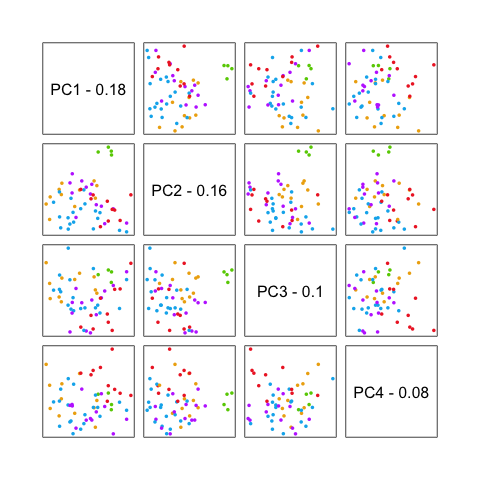
Principal Components of TGF-B Data
Principal component analysis maps high-dimensional datasets onto a smaller number of highly informative dimensions. Here, the first four principal components of the gene expression data are plotted against each other and colored by the values of the selected covariate. This plot may be used to identify clusters in the data and to identify variables associated with prominent signal in the data. Variables that are associated with these leading principal components should be considered in downstream analyses.
- Heatmaps
- PCA
Heatmap of TXmisReg Data
More Plot Information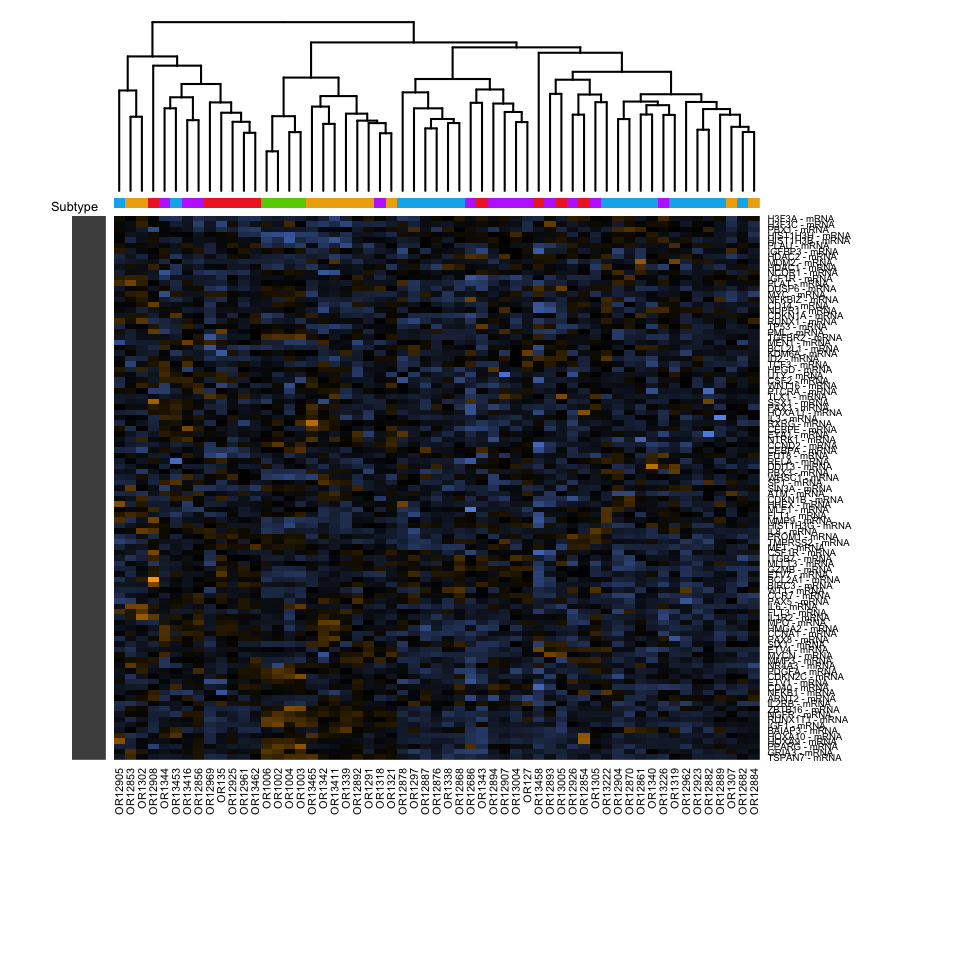
Heatmap of TXmisReg Data
Heatmap of the normalized data, scaled to give all genes equal variance, generated via unsupervised clustering. Orange indicates high expression; blue indicates low expression. This plot is meant to provide a high level exploratory view of the data.
Principal Components of TXmisReg Data
More Plot Information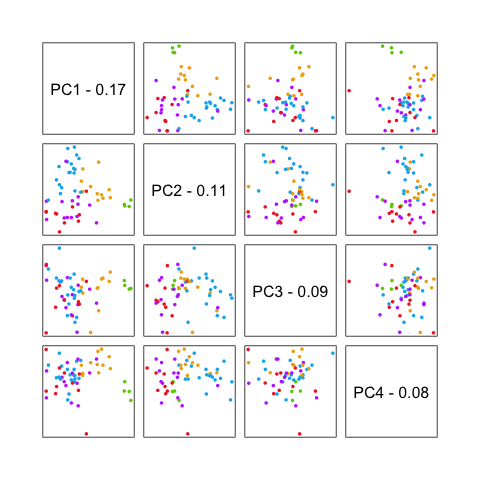
Principal Components of TXmisReg Data
Principal component analysis maps high-dimensional datasets onto a smaller number of highly informative dimensions. Here, the first four principal components of the gene expression data are plotted against each other and colored by the values of the selected covariate. This plot may be used to identify clusters in the data and to identify variables associated with prominent signal in the data. Variables that are associated with these leading principal components should be considered in downstream analyses.
- Heatmaps
- PCA
Heatmap of Wnt Data
More Plot Information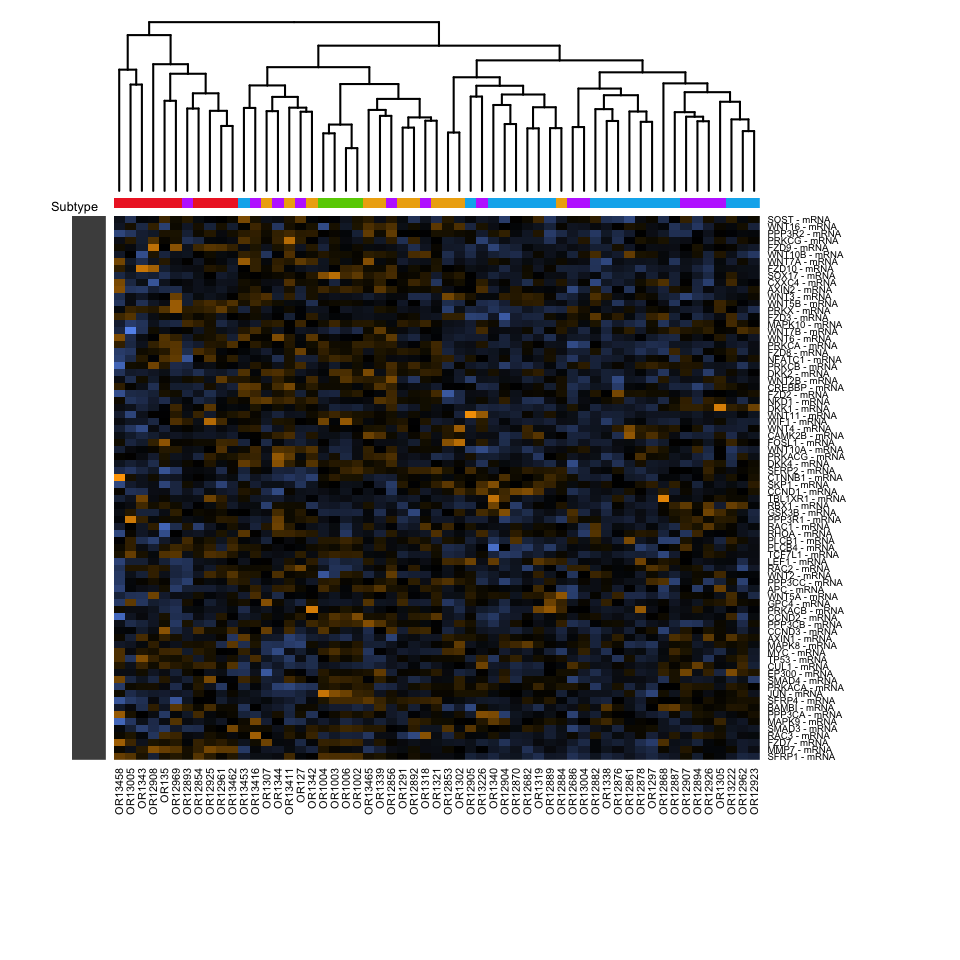
Heatmap of Wnt Data
Heatmap of the normalized data, scaled to give all genes equal variance, generated via unsupervised clustering. Orange indicates high expression; blue indicates low expression. This plot is meant to provide a high level exploratory view of the data.
Principal Components of Wnt Data
More Plot Information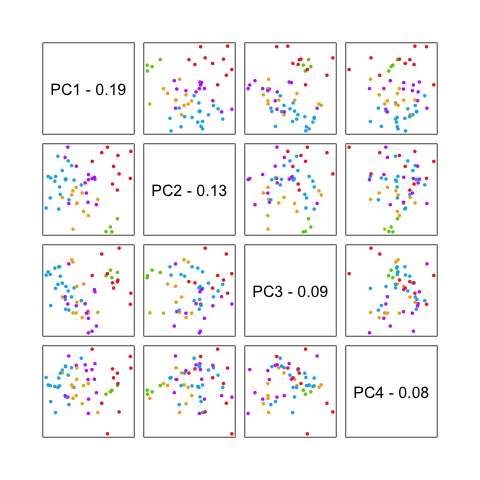
Principal Components of Wnt Data
Principal component analysis maps high-dimensional datasets onto a smaller number of highly informative dimensions. Here, the first four principal components of the gene expression data are plotted against each other and colored by the values of the selected covariate. This plot may be used to identify clusters in the data and to identify variables associated with prominent signal in the data. Variables that are associated with these leading principal components should be considered in downstream analyses.
Displays plots that detail the impact of normalization on the data.
- Analyte:
- mRNA
Pairwise Variance during HK Selection
More Plot Information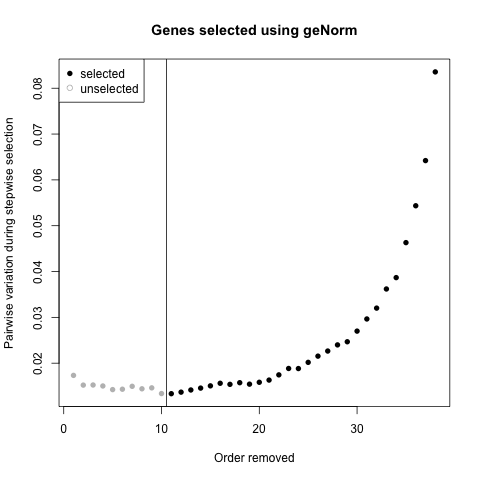
Pairwise Variance during HK Selection
Displays the geNorm pairwise variation statistic after successive genes are removed. This statistic cannot be computed for the final two genes, which are therefore not displayed. The ideal normalization gene set will minimize the pairwise variation statistic.
Normalization Summary: mRNA
More Plot Information Log2 Normalized All Data Log2 Normalized mRNA Data Download HK Genes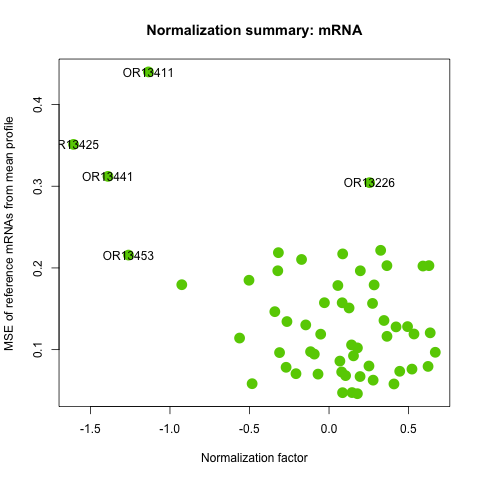
Normalization Summary: mRNA
The lower the MSE of reference profile the higher quality of normalization. The more positive normalization factor, the higher counts were registered for the sample and vice versa
Pathway scores condense each sample's gene expression profile into a small set of pathway scores. An experiment can then be explored through the lens of pathway scores instead of in the much higher-dimension lens of gene expression values. Pathway scores are fit using the first principal component of each gene set's data. They are oriented such that increasing score corresponds to mostly increasing expression (specifically, each pathway score has positive weights for at least half its genes). Summary plots explore the joint behavior of pathways, and Covariates plots compare pathway scores to covariates.
- Summary
- Covariates
Heatmap of Pathway scores
More Plot Information Download Pathway scores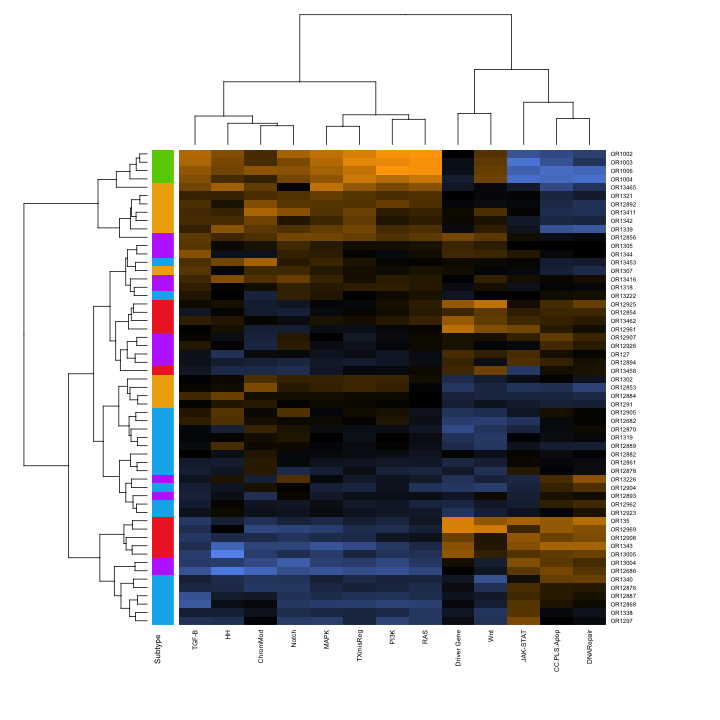
Heatmap of Pathway scores
Heatmap showing pathway score. This plot is a high level overview of how the pathway scores change across samples. Use it to understand how which pathway scores cluster together and which samples exhibit similar pathway score profiles. Orange indicates high scores; blue indicates low scores. Scores are displayed on the same scale via a Z-transformation.
Heatmap of Correlation Matrix of Pathway scores
More Plot Information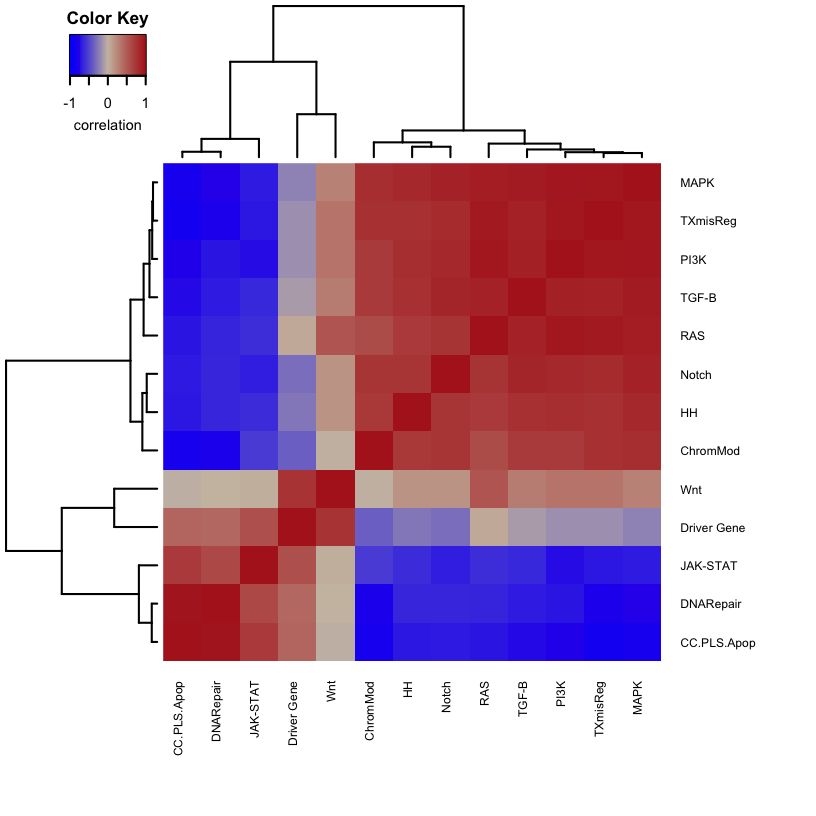
Heatmap of Correlation Matrix of Pathway scores
Heatmap showing the correlation matrix of pathway scores. Red and blue indicate positive and negative correlation, respectively.
CC.PLS.Apop measurements vs. other pathway scores
More Plot Information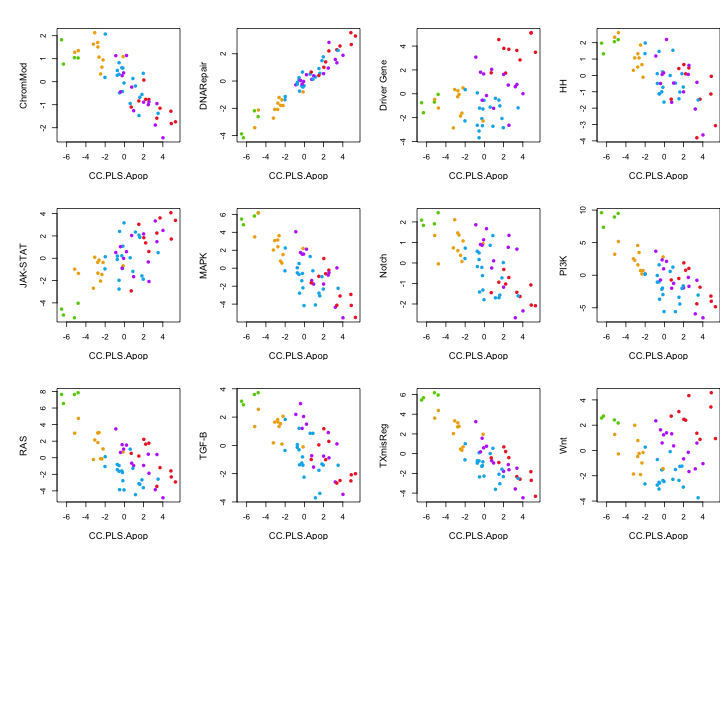
CC.PLS.Apop measurements vs. other pathway scores
Each panel plots CC.PLS.Apop against another pathway score. Points are colored by Subtype.
ChromMod measurements vs. other pathway scores
More Plot Information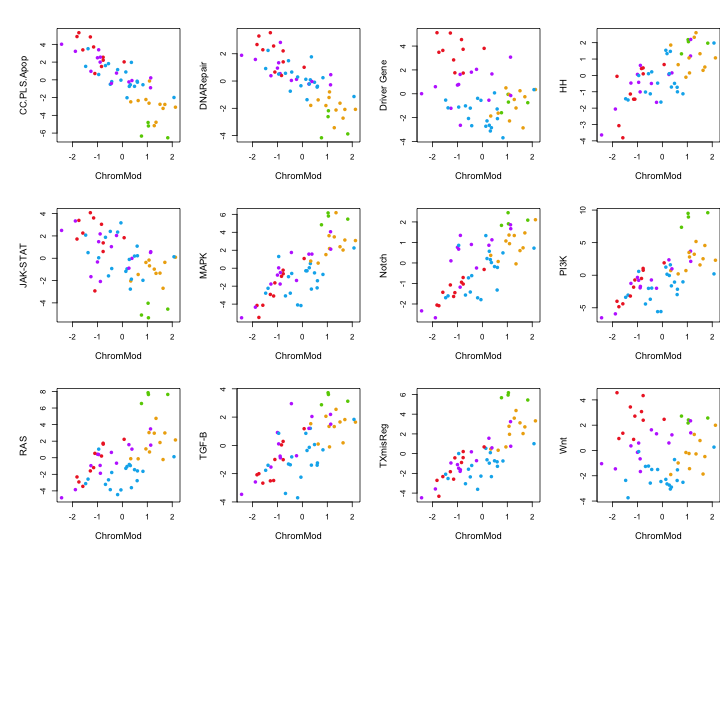
ChromMod measurements vs. other pathway scores
Each panel plots ChromMod against another pathway score. Points are colored by Subtype.
DNARepair measurements vs. other pathway scores
More Plot Information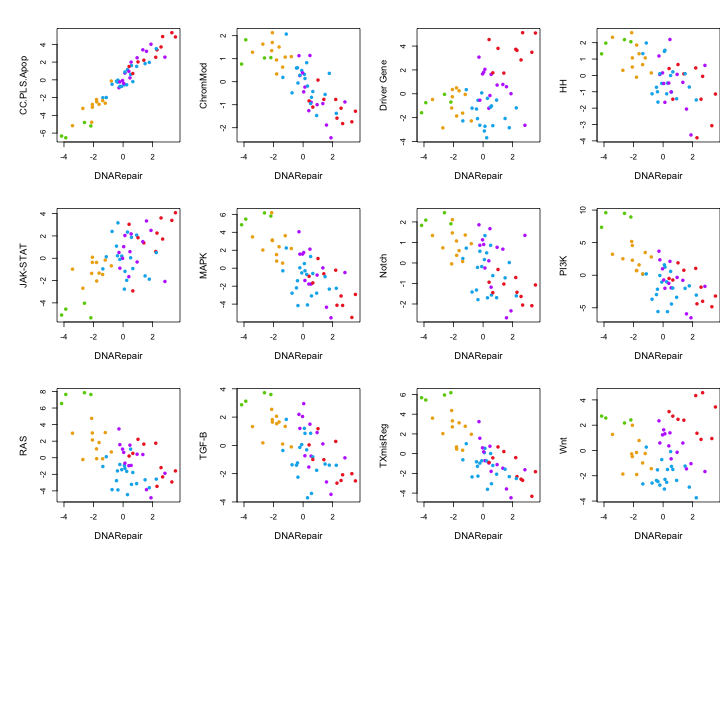
DNARepair measurements vs. other pathway scores
Each panel plots DNARepair against another pathway score. Points are colored by Subtype.
Driver Gene measurements vs. other pathway scores
More Plot Information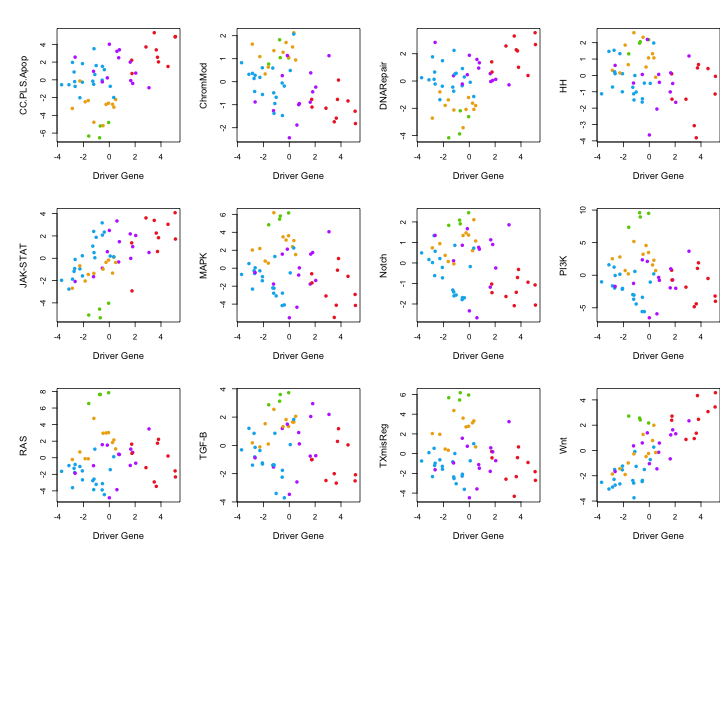
Driver Gene measurements vs. other pathway scores
Each panel plots Driver Gene against another pathway score. Points are colored by Subtype.
HH measurements vs. other pathway scores
More Plot Information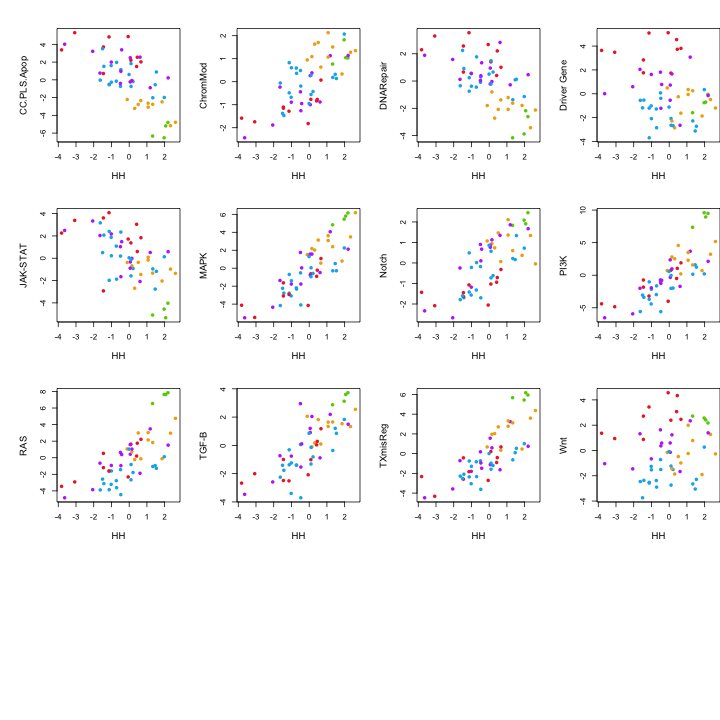
HH measurements vs. other pathway scores
Each panel plots HH against another pathway score. Points are colored by Subtype.
JAK-STAT measurements vs. other pathway scores
More Plot Information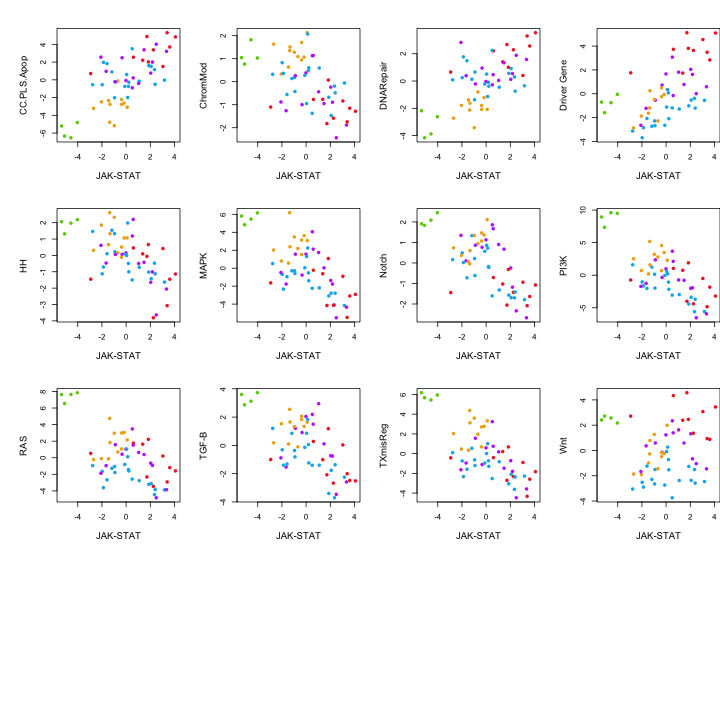
JAK-STAT measurements vs. other pathway scores
Each panel plots JAK-STAT against another pathway score. Points are colored by Subtype.
MAPK measurements vs. other pathway scores
More Plot Information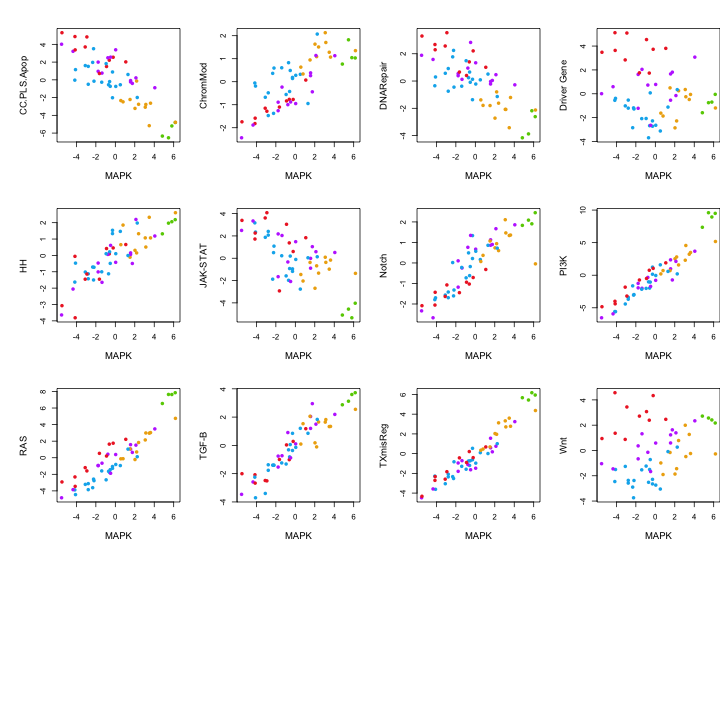
MAPK measurements vs. other pathway scores
Each panel plots MAPK against another pathway score. Points are colored by Subtype.
Notch measurements vs. other pathway scores
More Plot Information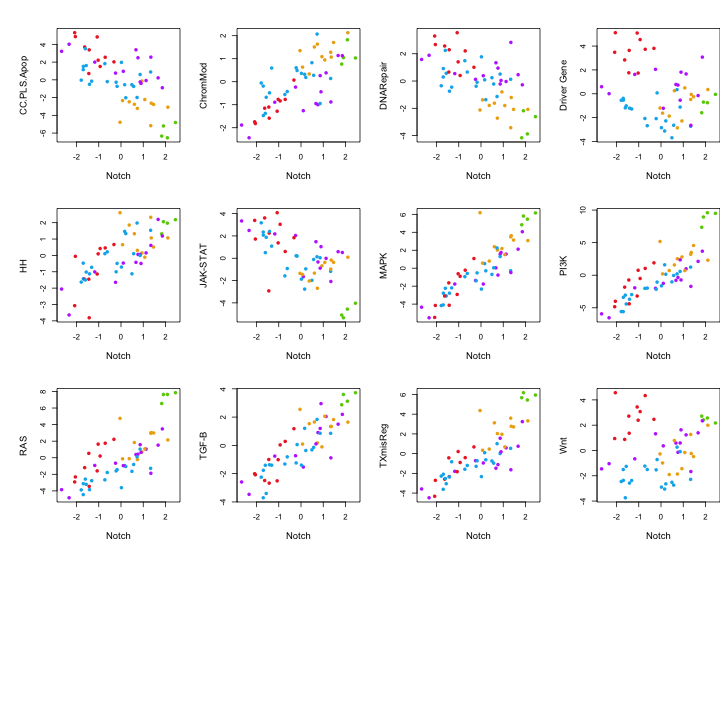
Notch measurements vs. other pathway scores
Each panel plots Notch against another pathway score. Points are colored by Subtype.
PI3K measurements vs. other pathway scores
More Plot Information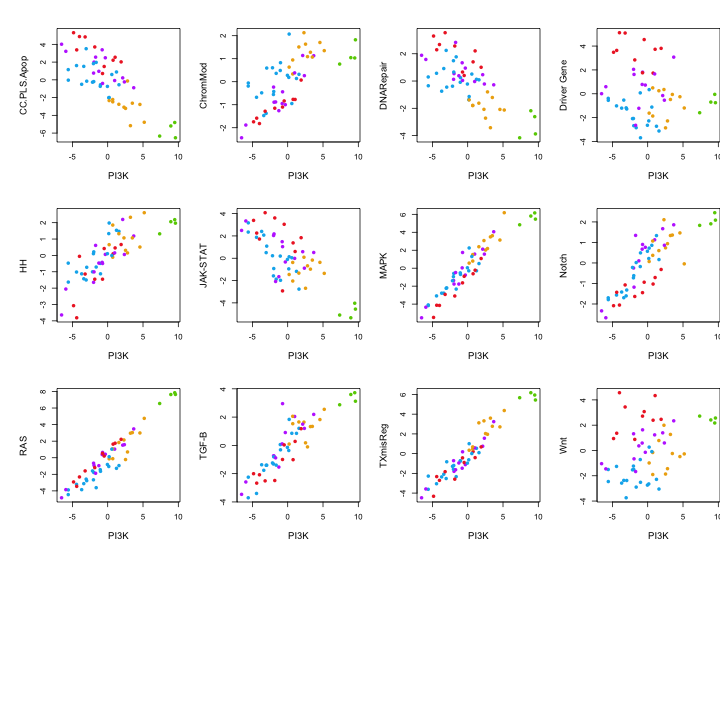
PI3K measurements vs. other pathway scores
Each panel plots PI3K against another pathway score. Points are colored by Subtype.
RAS measurements vs. other pathway scores
More Plot Information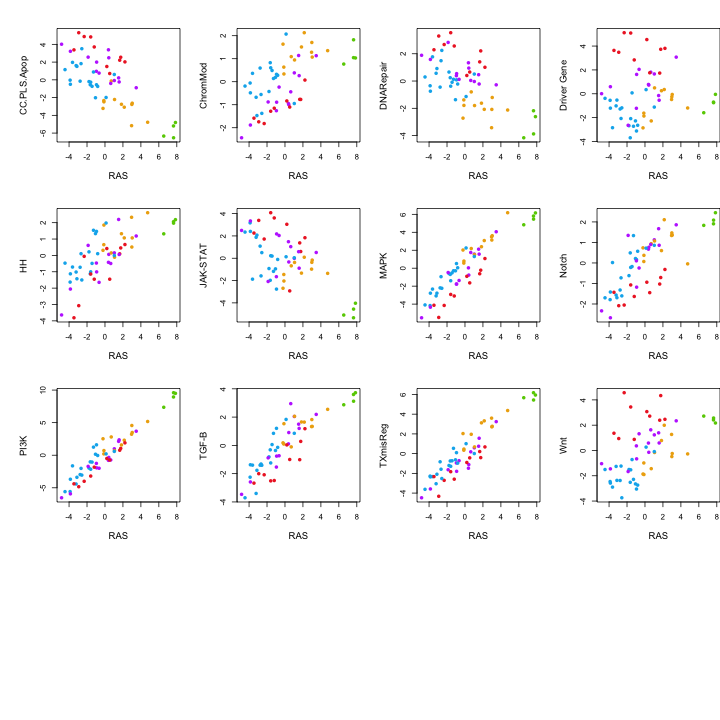
RAS measurements vs. other pathway scores
Each panel plots RAS against another pathway score. Points are colored by Subtype.
TGF-B measurements vs. other pathway scores
More Plot Information
TGF-B measurements vs. other pathway scores
Each panel plots TGF-B against another pathway score. Points are colored by Subtype.
TXmisReg measurements vs. other pathway scores
More Plot Information
TXmisReg measurements vs. other pathway scores
Each panel plots TXmisReg against another pathway score. Points are colored by Subtype.
Wnt measurements vs. other pathway scores
More Plot Information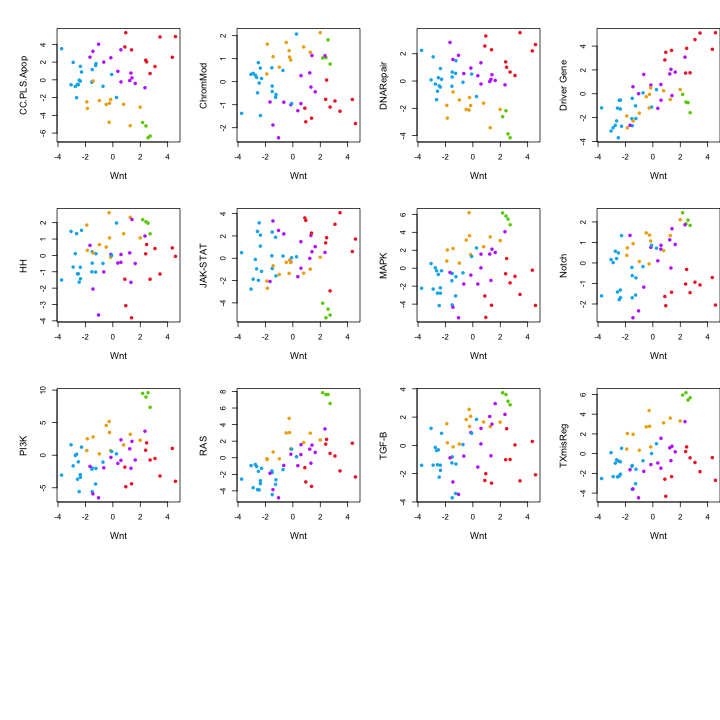
Wnt measurements vs. other pathway scores
Each panel plots Wnt against another pathway score. Points are colored by Subtype.
Pathway scores vs. Subtype
More Plot Information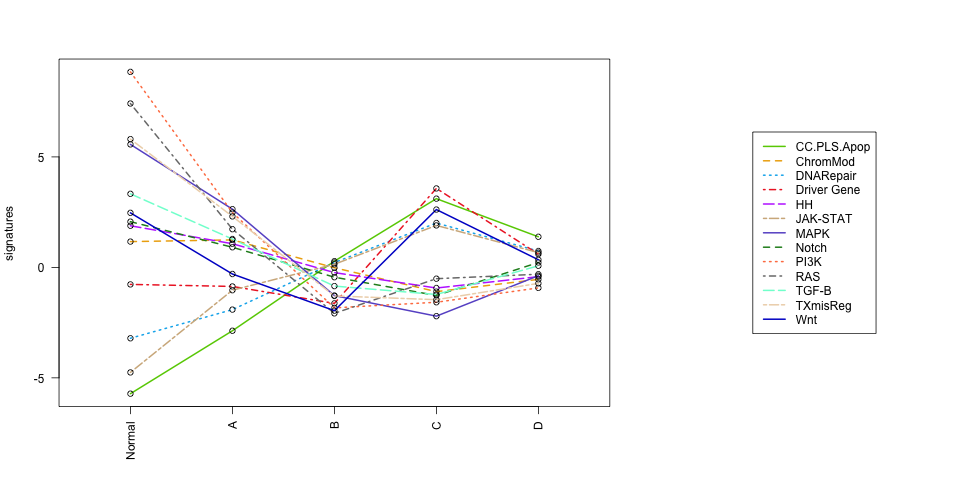
Pathway scores vs. Subtype
Plots the pathway scores against Subtype. The pathway scores are plotted to show how they vary across different values of Subtype conditions. Lines show each pathway's average score across values of Subtype.
CC.PLS.Apop pathway scores vs. Subtype
More Plot Information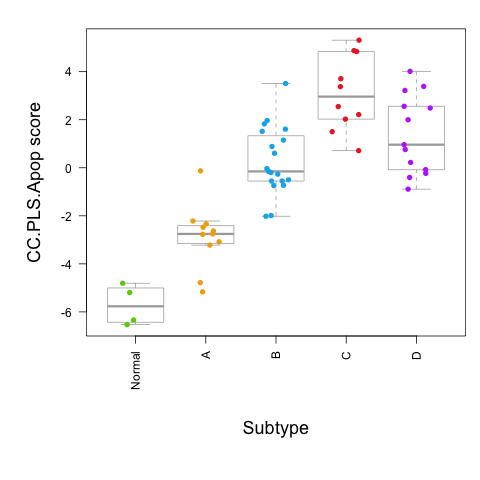
CC.PLS.Apop pathway scores vs. Subtype
Plots CC.PLS.Apop pathway scores against Subtype.
ChromMod pathway scores vs. Subtype
More Plot Information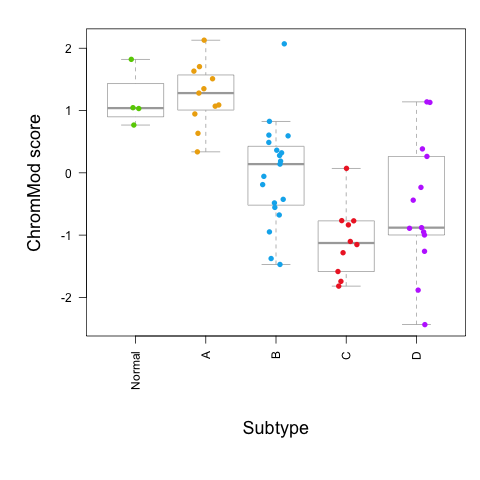
ChromMod pathway scores vs. Subtype
Plots ChromMod pathway scores against Subtype.
DNARepair pathway scores vs. Subtype
More Plot Information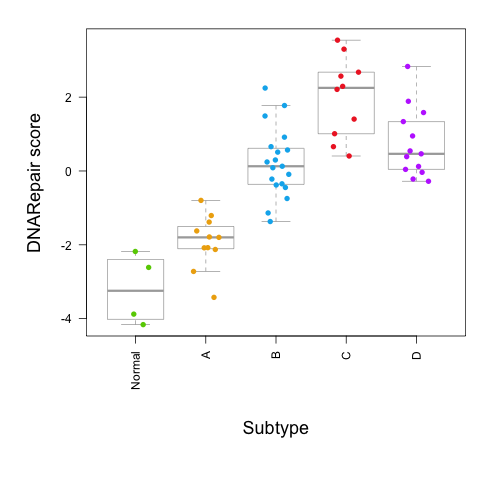
DNARepair pathway scores vs. Subtype
Plots DNARepair pathway scores against Subtype.
Driver Gene pathway scores vs. Subtype
More Plot Information
Driver Gene pathway scores vs. Subtype
Plots Driver Gene pathway scores against Subtype.
HH pathway scores vs. Subtype
More Plot Information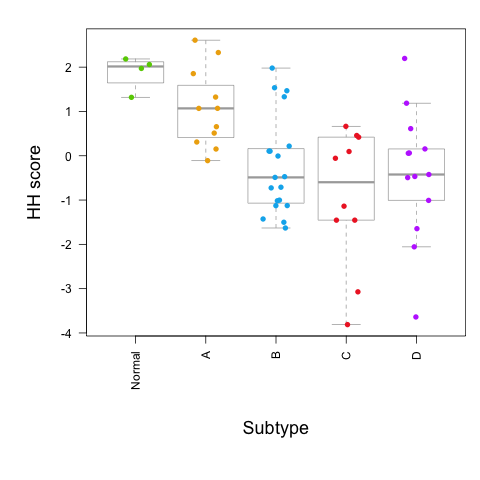
HH pathway scores vs. Subtype
Plots HH pathway scores against Subtype.
JAK-STAT pathway scores vs. Subtype
More Plot Information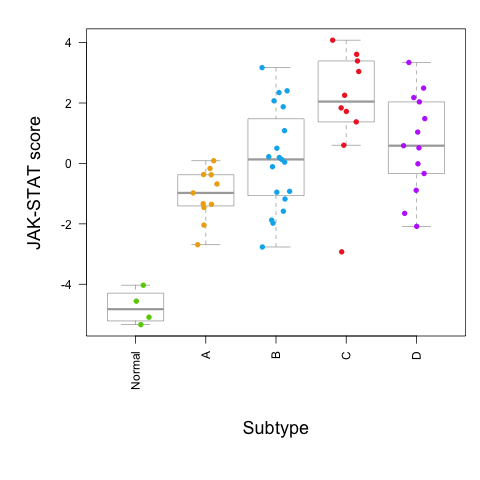
JAK-STAT pathway scores vs. Subtype
Plots JAK-STAT pathway scores against Subtype.
MAPK pathway scores vs. Subtype
More Plot Information
MAPK pathway scores vs. Subtype
Plots MAPK pathway scores against Subtype.
Notch pathway scores vs. Subtype
More Plot Information
Notch pathway scores vs. Subtype
Plots Notch pathway scores against Subtype.
PI3K pathway scores vs. Subtype
More Plot Information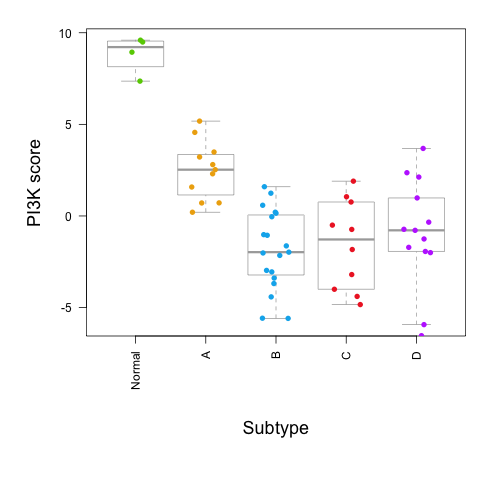
PI3K pathway scores vs. Subtype
Plots PI3K pathway scores against Subtype.
RAS pathway scores vs. Subtype
More Plot Information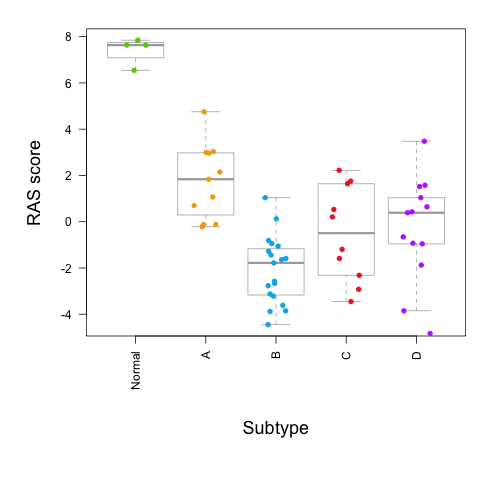
RAS pathway scores vs. Subtype
Plots RAS pathway scores against Subtype.
TGF-B pathway scores vs. Subtype
More Plot Information
TGF-B pathway scores vs. Subtype
Plots TGF-B pathway scores against Subtype.
TXmisReg pathway scores vs. Subtype
More Plot Information
TXmisReg pathway scores vs. Subtype
Plots TXmisReg pathway scores against Subtype.
Wnt pathway scores vs. Subtype
More Plot Information
Wnt pathway scores vs. Subtype
Plots Wnt pathway scores against Subtype.
Genes are tested for differential expression in response to each selected covariate. For each gene, a single linear regression is fit using all selected covariates to predict expression. This approach eliminates confounding due to measured covariates and isolates the independent association of each covariate with gene expression, measuring each variable's association with a gene after holding all other variables constant.
- Subtype:
- SubtypeA
- SubtypeB
- SubtypeC
- SubtypeD
Volcano Plot: SubtypeA
More Plot Information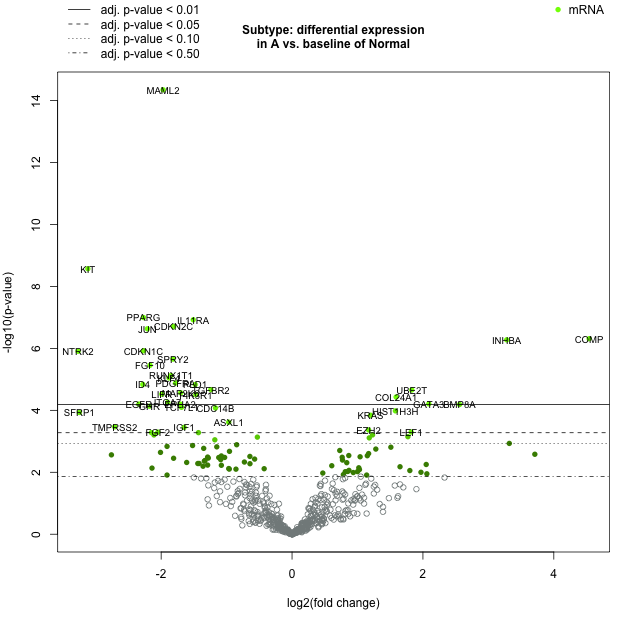
Volcano Plot: SubtypeA
Volcano plot displaying each gene's -log10(p-value) and log2 fold change with the selected covariate. Highly statistically significant genes fall at the top of the plot, and highly differentially expressed genes fall to either side. Green point colors and horizontal lines indicate various False Discovery Rate (FDR) thresholds. The 40 most statistically significant genes are named.
DE Results: SubtypeA
More Plot Information Download CSV DataLog2 fold change std error Lower confidence limit Upper confidence limit P-value BY.p.value Gene.sets probe.ID MAML2-mRNA -1.97 0.18 -2.32 -1.61 4.47e-15 1.78e-11 Notch NM_032427.1:4125 KIT-mRNA -3.12 0.436 -3.98 -2.27 2.68e-09 5.33e-06 Driver Gene, PI3K, RAS NM_000222.1:5 PPARG-mRNA -2.27 0.368 -2.99 -1.55 1.01e-07 0.000118 TXmisReg NM_015869.3:1035 IL11RA-mRNA -1.51 0.246 -1.99 -1.03 1.19e-07 0.000118 JAK-STAT NM_147162.1:400 CDKN2C-mRNA -1.81 0.301 -2.4 -1.22 1.97e-07 0.000155 CC.PLS.Apop, TXmisReg NM_001262.2:1295 JUN-mRNA -2.21 0.371 -2.94 -1.48 2.33e-07 0.000155 MAPK, Wnt NM_002228.3:140 COMP-mRNA 4.54 0.791 2.99 6.09 4.86e-07 0.000263 PI3K NM_000095.2:1744 INHBA-mRNA 3.28 0.574 2.16 4.41 5.29e-07 0.000263 TGF-B NM_002192.2:490 CDKN1C-mRNA -2.27 0.412 -3.07 -1.46 1.19e-06 0.000491 CC.PLS.Apop NM_000076.2:1605 NTRK2-mRNA -3.27 0.595 -4.43 -2.1 1.24e-06 0.000491 MAPK NM_001007097.1:1605 SPRY2-mRNA -1.82 0.342 -2.49 -1.15 2.22e-06 0.000804 JAK-STAT NM_005842.2:85 FGF10-mRNA -2.17 0.418 -2.99 -1.35 3.51e-06 0.00116 MAPK, PI3K, RAS NM_004465.1:85 RUNX1T1-mRNA -1.85 0.372 -2.58 -1.12 7.5e-06 0.0023 TXmisReg NM_004349.2:1085 KLF4-mRNA -1.88 0.383 -2.63 -1.13 9.02e-06 0.00256 Driver Gene NM_004235.4:1980 PDGFRA-mRNA -1.78 0.369 -2.5 -1.05 1.31e-05 0.00345 Driver Gene, MAPK, PI3K, RAS NM_006206.3:1925 ID4-mRNA -2.28 0.476 -3.21 -1.34 1.46e-05 0.00345 TGF-B NM_001546.2:2048 PLD1-mRNA -1.48 0.309 -2.08 -0.872 1.47e-05 0.00345 RAS NM_002662.3:1265 TGFBR2-mRNA -1.24 0.265 -1.75 -0.717 2.15e-05 0.00461 MAPK, TGF-B, TXmisReg NM_001024847.1:1760 UBE2T-mRNA 1.83 0.393 1.06 2.6 2.2e-05 0.00461 DNARepair NM_014176.3:595 MAP2K6-mRNA -1.7 0.369 -2.42 -0.976 2.71e-05 0.00538 MAPK NM_002758.3:555 DE Results: SubtypeA
Table presenting the most statistically significantly differentially expressed genes with the selected covariate. 'Estimated log fold-change' estimates a gene's differential expression. For categorical covariates, a gene is estimated to have 2^(log fold change) times its expression in baseline samples, holding all other variables in the analysis constant. If the covariate is continuous, for each unit increase in the selected covariate, a gene's expression is estimated to increase by 2^(log fold change)-fold, holding all other variables in the analysis constant. The 95% confidence interval for the log fold change is also presented, along with a p-value and an adjusted p-value or FDR if requested.
Volcano Plot: SubtypeB
More Plot Information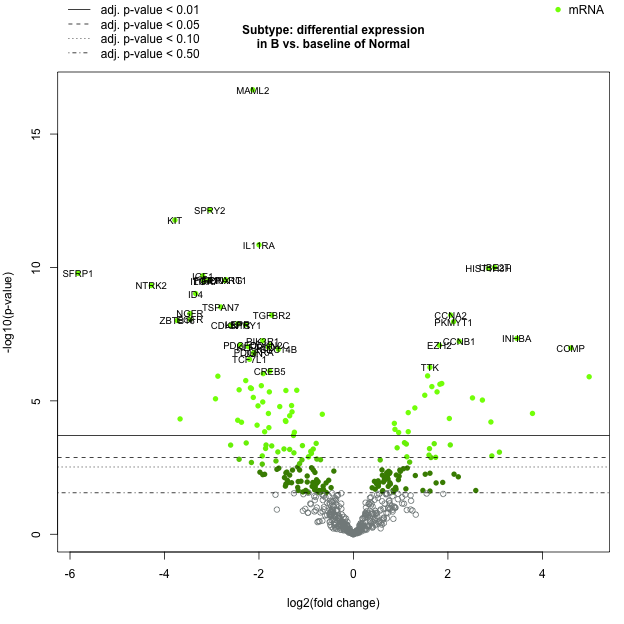
Volcano Plot: SubtypeB
Volcano plot displaying each gene's -log10(p-value) and log2 fold change with the selected covariate. Highly statistically significant genes fall at the top of the plot, and highly differentially expressed genes fall to either side. Green point colors and horizontal lines indicate various False Discovery Rate (FDR) thresholds. The 40 most statistically significant genes are named.
DE Results: SubtypeB
More Plot Information Download CSV DataLog2 fold change std error Lower confidence limit Upper confidence limit P-value BY.p.value Gene.sets probe.ID MAML2-mRNA -2.13 0.169 -2.46 -1.8 2.19e-17 8.69e-14 Notch NM_032427.1:4125 SPRY2-mRNA -3.04 0.322 -3.67 -2.41 6.99e-13 1.39e-09 JAK-STAT NM_005842.2:85 KIT-mRNA -3.78 0.41 -4.58 -2.97 1.68e-12 2.22e-09 Driver Gene, PI3K, RAS NM_000222.1:5 IL11RA-mRNA -2 0.232 -2.45 -1.54 1.42e-11 1.41e-08 JAK-STAT NM_147162.1:400 UBE2T-mRNA 2.99 0.37 2.26 3.71 9.89e-11 7.25e-08 DNARepair NM_014176.3:595 HIST1H3H-mRNA 2.86 0.355 2.16 3.55 1.09e-10 7.25e-08 TXmisReg NM_003536.2:355 SFRP1-mRNA -5.83 0.735 -7.27 -4.39 1.65e-10 9.39e-08 Wnt NM_003012.3:3320 IGF1-mRNA -3.19 0.406 -3.99 -2.4 2.05e-10 1.01e-07 PI3K, RAS, TXmisReg NM_000618.3:491 PPARG-mRNA -2.7 0.347 -3.38 -2.02 2.86e-10 1.01e-07 TXmisReg NM_015869.3:1035 FGF10-mRNA -3.06 0.394 -3.83 -2.29 2.99e-10 1.01e-07 MAPK, PI3K, RAS NM_004465.1:85 RUNX1T1-mRNA -2.72 0.35 -3.4 -2.03 3.11e-10 1.01e-07 TXmisReg NM_004349.2:1085 ITGA7-mRNA -3.16 0.407 -3.96 -2.36 3.14e-10 1.01e-07 PI3K NM_002206.1:1170 LIFR-mRNA -3.17 0.409 -3.97 -2.37 3.3e-10 1.01e-07 JAK-STAT NM_002310.3:2995 NTRK2-mRNA -4.28 0.561 -5.38 -3.19 4.75e-10 1.35e-07 MAPK NM_001007097.1:1605 ID4-mRNA -3.34 0.449 -4.22 -2.46 9.52e-10 2.52e-07 TGF-B NM_001546.2:2048 TSPAN7-mRNA -2.81 0.394 -3.58 -2.04 3.03e-09 7.53e-07 TXmisReg NM_004615.3:725 NGFR-mRNA -3.46 0.495 -4.43 -2.49 5.34e-09 1.25e-06 PI3K, RAS, TXmisReg NM_002507.1:2705 CCNA2-mRNA 2.06 0.297 1.48 2.65 6.1e-09 1.28e-06 CC.PLS.Apop NM_001237.2:1210 TGFBR2-mRNA -1.73 0.249 -2.22 -1.24 6.13e-09 1.28e-06 MAPK, TGF-B, TXmisReg NM_001024847.1:1760 EGFR-mRNA -3.46 0.506 -4.46 -2.47 8.82e-09 1.75e-06 Driver Gene, MAPK, PI3K, RAS NM_201282.1:360 DE Results: SubtypeB
Table presenting the most statistically significantly differentially expressed genes with the selected covariate. 'Estimated log fold-change' estimates a gene's differential expression. For categorical covariates, a gene is estimated to have 2^(log fold change) times its expression in baseline samples, holding all other variables in the analysis constant. If the covariate is continuous, for each unit increase in the selected covariate, a gene's expression is estimated to increase by 2^(log fold change)-fold, holding all other variables in the analysis constant. The 95% confidence interval for the log fold change is also presented, along with a p-value and an adjusted p-value or FDR if requested.
Volcano Plot: SubtypeC
More Plot Information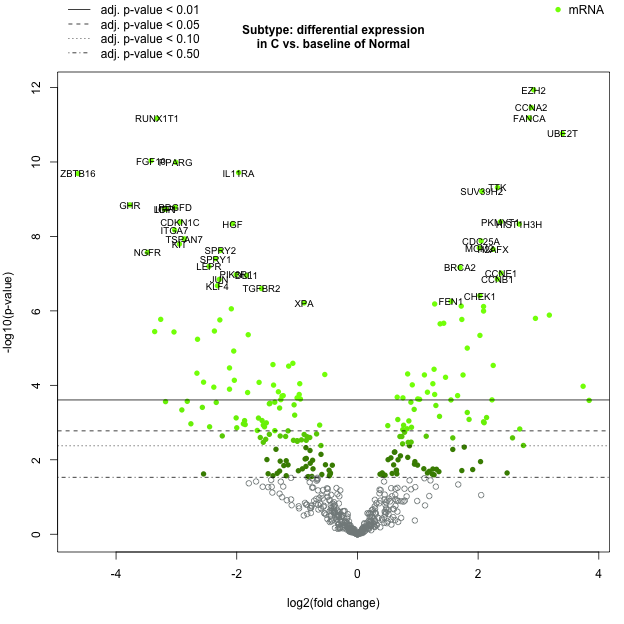
Volcano Plot: SubtypeC
Volcano plot displaying each gene's -log10(p-value) and log2 fold change with the selected covariate. Highly statistically significant genes fall at the top of the plot, and highly differentially expressed genes fall to either side. Green point colors and horizontal lines indicate various False Discovery Rate (FDR) thresholds. The 40 most statistically significant genes are named.
DE Results: SubtypeC
More Plot Information Download CSV DataLog2 fold change std error Lower confidence limit Upper confidence limit P-value BY.p.value Gene.sets probe.ID EZH2-mRNA 2.92 0.314 2.31 3.54 1.15e-12 4.59e-09 Driver Gene NM_004456.3:190 CCNA2-mRNA 2.88 0.32 2.25 3.5 3.45e-12 6.71e-09 CC.PLS.Apop NM_001237.2:1210 FANCA-mRNA 2.85 0.323 2.22 3.49 6.54e-12 6.71e-09 DNARepair NM_000135.2:265 RUNX1T1-mRNA -3.32 0.377 -4.06 -2.58 6.75e-12 6.71e-09 TXmisReg NM_004349.2:1085 UBE2T-mRNA 3.4 0.398 2.62 4.18 1.73e-11 1.38e-08 DNARepair NM_014176.3:595 FGF10-mRNA -3.42 0.423 -4.25 -2.59 9.23e-11 5.8e-08 MAPK, PI3K, RAS NM_004465.1:85 PPARG-mRNA -3.01 0.373 -3.74 -2.28 1.02e-10 5.8e-08 TXmisReg NM_015869.3:1035 IL11RA-mRNA -1.97 0.25 -2.46 -1.48 1.93e-10 9.06e-08 JAK-STAT NM_147162.1:400 ZBTB16-mRNA -4.63 0.589 -5.79 -3.48 2.05e-10 9.06e-08 TXmisReg NM_006006.4:1585 TTK-mRNA 2.32 0.304 1.73 2.92 4.85e-10 1.93e-07 CC.PLS.Apop NM_003318.3:1200 SUV39H2-mRNA 2.06 0.272 1.52 2.59 6.14e-10 2.22e-07 ChromMod NM_024670.3:2035 GHR-mRNA -3.77 0.514 -4.78 -2.76 1.42e-09 4.69e-07 JAK-STAT, PI3K NM_000163.2:1835 PDGFD-mRNA -3.02 0.414 -3.83 -2.21 1.65e-09 4.92e-07 PI3K, RAS NM_025208.4:1120 IGF1-mRNA -3.17 0.436 -4.03 -2.32 1.85e-09 4.92e-07 PI3K, RAS, TXmisReg NM_000618.3:491 LIFR-mRNA -3.2 0.44 -4.06 -2.34 1.85e-09 4.92e-07 JAK-STAT NM_002310.3:2995 PKMYT1-mRNA 2.37 0.336 1.71 3.03 4.07e-09 9.61e-07 CC.PLS.Apop NM_004203.3:780 CDKN1C-mRNA -2.94 0.418 -3.76 -2.13 4.1e-09 9.61e-07 CC.PLS.Apop NM_000076.2:1605 HGF-mRNA -2.07 0.294 -2.64 -1.49 4.53e-09 9.76e-07 PI3K, RAS NM_000601.4:550 HIST1H3H-mRNA 2.68 0.382 1.93 3.43 4.66e-09 9.76e-07 TXmisReg NM_003536.2:355 ITGA7-mRNA -3.03 0.438 -3.89 -2.17 6.69e-09 1.33e-06 PI3K NM_002206.1:1170 DE Results: SubtypeC
Table presenting the most statistically significantly differentially expressed genes with the selected covariate. 'Estimated log fold-change' estimates a gene's differential expression. For categorical covariates, a gene is estimated to have 2^(log fold change) times its expression in baseline samples, holding all other variables in the analysis constant. If the covariate is continuous, for each unit increase in the selected covariate, a gene's expression is estimated to increase by 2^(log fold change)-fold, holding all other variables in the analysis constant. The 95% confidence interval for the log fold change is also presented, along with a p-value and an adjusted p-value or FDR if requested.
Volcano Plot: SubtypeD
More Plot Information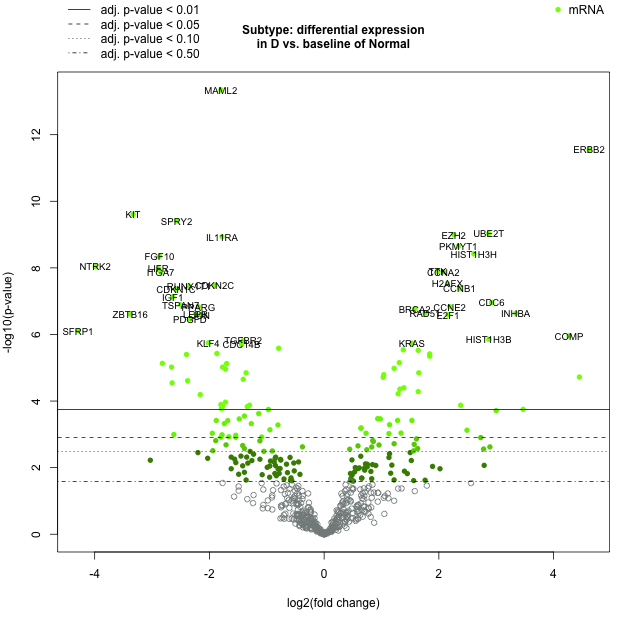
Volcano Plot: SubtypeD
Volcano plot displaying each gene's -log10(p-value) and log2 fold change with the selected covariate. Highly statistically significant genes fall at the top of the plot, and highly differentially expressed genes fall to either side. Green point colors and horizontal lines indicate various False Discovery Rate (FDR) thresholds. The 40 most statistically significant genes are named.
DE Results: SubtypeD
More Plot Information Download CSV DataLog2 fold change std error Lower confidence limit Upper confidence limit P-value BY.p.value Gene.sets probe.ID MAML2-mRNA -1.8 0.176 -2.15 -1.46 4.48e-14 1.78e-10 Notch NM_032427.1:4125 ERBB2-mRNA 4.62 0.51 3.62 5.62 2.79e-12 5.56e-09 Driver Gene NM_004448.2:2380 KIT-mRNA -3.33 0.426 -4.17 -2.5 2.48e-10 3.29e-07 Driver Gene, PI3K, RAS NM_000222.1:5 SPRY2-mRNA -2.57 0.334 -3.23 -1.92 3.91e-10 3.89e-07 JAK-STAT NM_005842.2:85 UBE2T-mRNA 2.87 0.385 2.11 3.62 9.29e-10 6.58e-07 DNARepair NM_014176.3:595 EZH2-mRNA 2.26 0.303 1.66 2.85 1e-09 6.58e-07 Driver Gene NM_004456.3:190 IL11RA-mRNA -1.78 0.241 -2.26 -1.31 1.16e-09 6.58e-07 JAK-STAT NM_147162.1:400 PKMYT1-mRNA 2.34 0.324 1.7 2.98 2.24e-09 1.12e-06 CC.PLS.Apop NM_004203.3:780 HIST1H3H-mRNA 2.61 0.369 1.89 3.33 3.81e-09 1.68e-06 TXmisReg NM_003536.2:355 FGF10-mRNA -2.87 0.409 -3.68 -2.07 4.51e-09 1.79e-06 MAPK, PI3K, RAS NM_004465.1:85 NTRK2-mRNA -3.99 0.583 -5.13 -2.84 9.06e-09 3.28e-06 MAPK NM_001007097.1:1605 LIFR-mRNA -2.89 0.425 -3.73 -2.06 1.04e-08 3.45e-06 JAK-STAT NM_002310.3:2995 TTK-mRNA 1.98 0.294 1.41 2.56 1.28e-08 3.54e-06 CC.PLS.Apop NM_003318.3:1200 CCNA2-mRNA 2.08 0.309 1.47 2.69 1.32e-08 3.54e-06 CC.PLS.Apop NM_001237.2:1210 ITGA7-mRNA -2.85 0.424 -3.68 -2.02 1.34e-08 3.54e-06 PI3K NM_002206.1:1170 H2AFX-mRNA 2.15 0.33 1.5 2.79 2.95e-08 7.32e-06 DNARepair NM_002105.2:1392 CDKN2C-mRNA -1.91 0.295 -2.49 -1.33 3.37e-08 7.57e-06 CC.PLS.Apop, TXmisReg NM_001262.2:1295 RUNX1T1-mRNA -2.36 0.364 -3.07 -1.64 3.43e-08 7.57e-06 TXmisReg NM_004349.2:1085 CCNB1-mRNA 2.36 0.368 1.64 3.08 4.18e-08 8.75e-06 CC.PLS.Apop NM_031966.2:715 CDKN1C-mRNA -2.58 0.404 -3.38 -1.79 4.41e-08 8.78e-06 CC.PLS.Apop NM_000076.2:1605 DE Results: SubtypeD
Table presenting the most statistically significantly differentially expressed genes with the selected covariate. 'Estimated log fold-change' estimates a gene's differential expression. For categorical covariates, a gene is estimated to have 2^(log fold change) times its expression in baseline samples, holding all other variables in the analysis constant. If the covariate is continuous, for each unit increase in the selected covariate, a gene's expression is estimated to increase by 2^(log fold change)-fold, holding all other variables in the analysis constant. The 95% confidence interval for the log fold change is also presented, along with a p-value and an adjusted p-value or FDR if requested.
The results of differential expression testing are summarized at the gene set level. Each gene set's most differentially expressed genes are identified, and the extent of differential expression in each gene set is summarized using a 'global significance score'.
Global Significance Scores
More Plot Information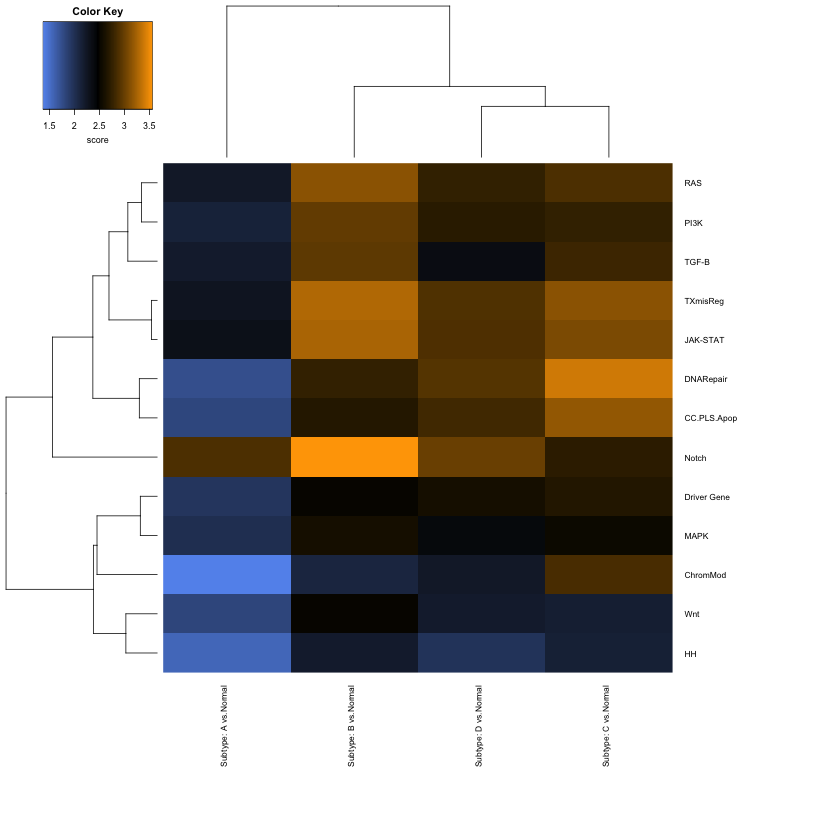
Global Significance Scores
Heatmap displaying each sample's global significance scores. Global significance statistics measure the extent of differential expression of a gene set's genes with a covariate, ignoring whether each gene within the set is up- or down-regulated. Orange denotes gene sets whose genes exhibit extensive differential expression with the covariate, blue denotes gene sets with less differential expression.
Directed Global Significance Scores
More Plot Information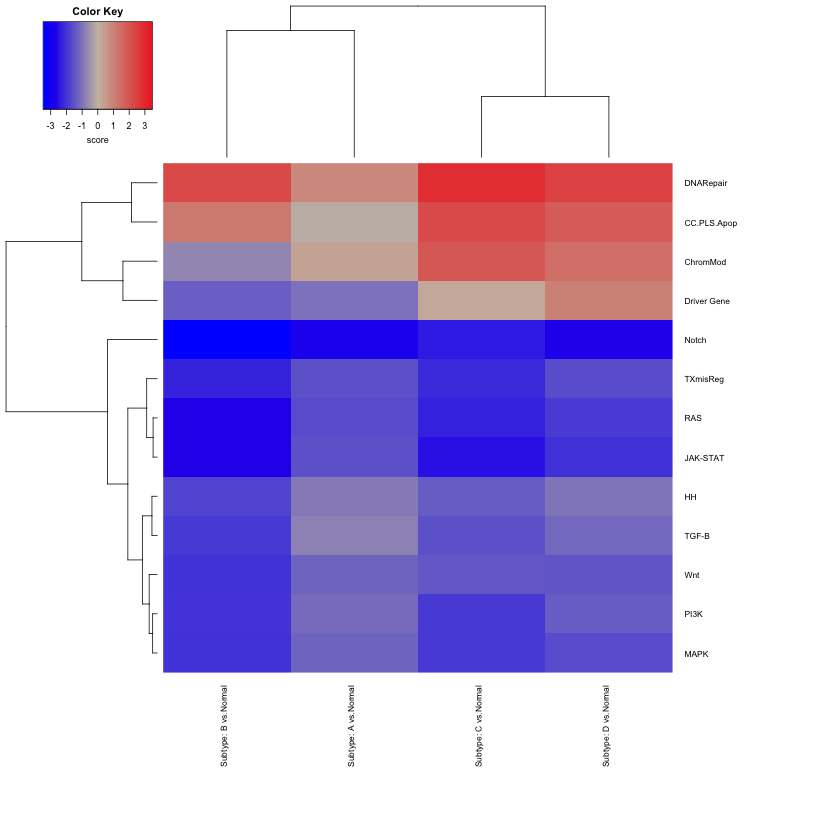
Directed Global Significance Scores
Heatmap displaying each sample's directed global significance scores. Directed global significance statistics measure the extent to which a gene set's genes are up- or down-regulated with the variable. Red denotes gene sets whose genes exhibit extensive over-expression with the covariate, blue denotes gene sets with extensive under-expression.
Undirected and Directed global significance scores table
More Plot Information Download CSV DataUndirected Subtype: differential expression in A vs. baseline of Normal Undirected Subtype: differential expression in B vs. baseline of Normal Undirected Subtype: differential expression in C vs. baseline of Normal Undirected Subtype: differential expression in D vs. baseline of Normal Directed Subtype: differential expression in A vs. baseline of Normal Directed Subtype: differential expression in B vs. baseline of Normal Directed Subtype: differential expression in C vs. baseline of Normal Directed Subtype: differential expression in D vs. baseline of Normal CC.PLS.Apop 1.804 2.664 3.168 2.824 -0.135 1.182 2.226 1.796 ChromMod 1.375 2.097 2.858 2.225 0.322 -0.699 1.906 1.418 DNARepair 1.74 2.756 3.39 2.911 0.865 2.235 2.874 2.426 Driver Gene 1.95 2.495 2.659 2.583 -1.011 -1.317 0.207 1.014 HH 1.557 2.195 2.145 1.966 -0.905 -1.782 -1.376 -0.97 JAK-STAT 2.317 3.258 3.074 2.879 -1.571 -2.681 -2.532 -2.078 MAPK 2.013 2.583 2.521 2.406 -1.237 -2.056 -1.95 -1.642 Notch 2.869 3.558 2.705 2.998 -2.816 -3.48 -2.446 -2.772 PI3K 2.131 2.977 2.745 2.697 -1.125 -2.033 -1.941 -1.365 RAS 2.226 3.136 2.876 2.742 -1.653 -2.691 -2.324 -1.927 TGF-B 2.195 2.948 2.792 2.362 -0.78 -1.953 -1.562 -1.172 TXmisReg 2.264 3.285 3.132 2.885 -1.551 -2.304 -2.181 -1.609 Wnt 1.814 2.499 2.164 2.2 -1.241 -2.051 -1.438 -1.49 Undirected and Directed global significance scores table
Table displaying each sample's global significance scores and directed global significance scores as defined in the heatmaps above. The global significance score is calculated as the square root of the mean squared t-statistic for the genes in a gene set, with t-statistics coming from the linear regression underlying our differential expression analysis. The directed global significance score is calculated as the square root of the mean signed squared t-statistic for the genes in a gene set, with t-statistics coming from the linear regression underlying our differential expression analysis.
- Subtype:
- SubtypeA
- SubtypeB
- SubtypeC
- SubtypeD
Volcano Plot: SubtypeA
More Plot Information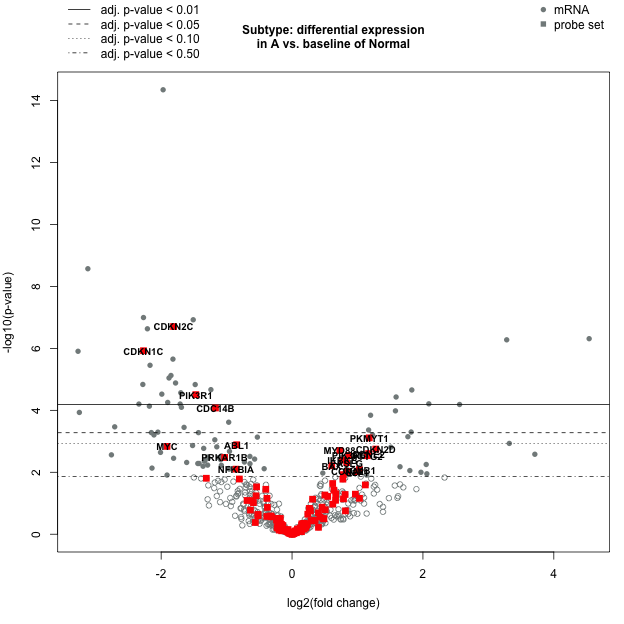
Volcano Plot: SubtypeA
Volcano plot displaying each gene's -log10(p-value) and log2 fold change for the selected covariate. Highly statistically significant genes fall at the top of the plot, and highly differentially expressed genes fall to either side. Genes within the selected gene set are highlighted in blue. Green point colors and horizontal lines indicate various False Discovery Rate (FDR) thresholds.
DE Results - CC.PLS.Apop genes - SubtypeA
More Plot Information Download CSV DataProbe Label Log2 fold change std error Lower confidence limit Upper confidence limit P-value BY.p.value Gene.sets Codeset.Name Probe.Label Analyte.Type Is.Control Control.Type Probe.Annotation KEGG.Pathways Cell.Type Official.Gene.Name volcanocol volcanopch tstats.all CDKN2C-mRNA -1.81 0.301 -2.4 -1.22 1.97e-07 0.000155 CC.PLS.Apop, TXmisReg NS_CANCERPATH_C2535 CDKN2C mRNA 0 CC.PLS.Apop;TXmisReg hsa04110;hsa05166;hsa05202 CDKN2C chartreuse1 16 -6.01328903654485 CDKN1C-mRNA -2.27 0.412 -3.07 -1.46 1.19e-06 0.000491 CC.PLS.Apop NS_CANCERPATH_C2535 CDKN1C mRNA 0 CC.PLS.Apop hsa04110 CDKN1C chartreuse1 16 -5.50970873786408 PIK3R1-mRNA -1.47 0.322 -2.1 -0.838 3.11e-05 0.00562 CC.PLS.Apop, Driver Gene, JAK-STAT, PI3K, RAS NS_CANCERPATH_C2535 PIK3R1 mRNA 0 CC.PLS.Apop;RAS;PI3K;JAK-STAT;Driver Gene hsa04012;hsa04014;hsa04015;hsa04022;hsa04024;hsa04062;hsa04066;hsa04068;hsa04070;hsa04071;hsa04072;hsa04150;hsa04151;hsa04152;hsa04210;hsa04211;hsa04261;hsa04370;hsa04380;hsa04510;hsa04550;hsa04611;hsa04620;hsa04630;hsa04650;hsa04660;hsa04662;hsa04664;hsa04666;hsa04668;hsa04670;hsa04722;hsa04725;hsa04750;hsa04810;hsa04910;hsa04914;hsa04915;hsa04917;hsa04919;hsa04921;hsa04923;hsa04930;hsa04931;hsa04932;hsa04933;hsa04960;hsa04973;hsa05100;hsa05142;hsa05145;hsa05146;hsa05160;hsa05161;hsa05162;hsa05164;hsa05166;hsa05169;hsa05200;hsa05203;hsa05205;hsa05210;hsa05211;hsa05212;hsa05213;hsa05214;hsa05215;hsa05218;hsa05220;hsa05221;hsa05222;hsa05223;hsa05230;hsa05231 PIK3R1 chartreuse1 16 -4.56521739130435 CDC14B-mRNA -1.17 0.275 -1.71 -0.635 8.39e-05 0.0108 CC.PLS.Apop NS_CANCERPATH_C2535 CDC14B mRNA 0 CC.PLS.Apop hsa04110 CDC14B chartreuse2 16 -4.25454545454545 PKMYT1-mRNA 1.18 0.331 0.534 1.83 0.000775 0.0656 CC.PLS.Apop NS_CANCERPATH_C2535 PKMYT1 mRNA 0 CC.PLS.Apop hsa04110;hsa04114;hsa04914 PKMYT1 chartreuse3 16 3.56495468277946 ABL1-mRNA -0.846 0.249 -1.33 -0.359 0.00129 0.103 CC.PLS.Apop, Driver Gene, RAS NS_CANCERPATH_C2535 ABL1 mRNA 0 CC.PLS.Apop;RAS;Driver Gene hsa04012;hsa04014;hsa04110;hsa04360;hsa04722;hsa05130;hsa05131;hsa05200;hsa05206;hsa05220;hsa05416 ABL1 chartreuse4 16 -3.39759036144578 MYC-mRNA -1.91 0.567 -3.02 -0.794 0.00146 0.112 CC.PLS.Apop, JAK-STAT, MAPK, PI3K, TGF-B, TXmisReg, Wnt NS_CANCERPATH_C2535 MYC mRNA 0 CC.PLS.Apop;PI3K;JAK-STAT;MAPK;TGF-B;TXmisReg;Wnt hsa04010;hsa04012;hsa04110;hsa04151;hsa04310;hsa04350;hsa04390;hsa04550;hsa04630;hsa04919;hsa05161;hsa05166;hsa05169;hsa05200;hsa05202;hsa05205;hsa05206;hsa05210;hsa05213;hsa05216;hsa05219;hsa05220;hsa05221;hsa05222;hsa05230 MYC chartreuse4 16 -3.36860670194004 CDKN2D-mRNA 1.28 0.388 0.518 2.04 0.00178 0.127 CC.PLS.Apop NS_CANCERPATH_C2535 CDKN2D mRNA 0 CC.PLS.Apop hsa04068;hsa04110 CDKN2D chartreuse4 16 3.29896907216495 MYD88-mRNA 0.729 0.224 0.29 1.17 0.00198 0.138 CC.PLS.Apop, Driver Gene NS_CANCERPATH_C2535 MYD88 mRNA 0 CC.PLS.Apop;Driver Gene hsa04064;hsa04210;hsa04620;hsa05132;hsa05133;hsa05134;hsa05140;hsa05142;hsa05143;hsa05144;hsa05145;hsa05152;hsa05161;hsa05162;hsa05164;hsa05168 MYD88 chartreuse4 16 3.25446428571429 CCNE2-mRNA 1.17 0.368 0.448 1.89 0.00249 0.165 CC.PLS.Apop, PI3K NS_CANCERPATH_C2535 CCNE2 mRNA 0 CC.PLS.Apop;PI3K hsa04110;hsa04114;hsa04115;hsa04151;hsa05161;hsa05162;hsa05200;hsa05203;hsa05206;hsa05215;hsa05222 CCNE2 chartreuse4 16 3.17934782608696 PIK3R5-mRNA 0.867 0.277 0.324 1.41 0.00288 0.181 CC.PLS.Apop, JAK-STAT, PI3K, RAS NS_CANCERPATH_C2535 PIK3R5 mRNA 0 CC.PLS.Apop;RAS;PI3K;JAK-STAT hsa04012;hsa04014;hsa04015;hsa04022;hsa04024;hsa04062;hsa04066;hsa04068;hsa04070;hsa04071;hsa04072;hsa04150;hsa04151;hsa04152;hsa04210;hsa04211;hsa04261;hsa04370;hsa04380;hsa04510;hsa04550;hsa04611;hsa04620;hsa04630;hsa04650;hsa04660;hsa04662;hsa04664;hsa04666;hsa04668;hsa04670;hsa04722;hsa04725;hsa04750;hsa04810;hsa04910;hsa04914;hsa04915;hsa04917;hsa04919;hsa04921;hsa04923;hsa04930;hsa04931;hsa04932;hsa04933;hsa04960;hsa04973;hsa05100;hsa05142;hsa05145;hsa05146;hsa05160;hsa05161;hsa05162;hsa05164;hsa05166;hsa05169;hsa05200;hsa05203;hsa05205;hsa05210;hsa05211;hsa05212;hsa05213;hsa05214;hsa05215;hsa05218;hsa05220;hsa05221;hsa05222;hsa05223;hsa05230;hsa05231 PIK3R5 chartreuse4 16 3.12996389891697 PTTG2-mRNA 1.15 0.367 0.427 1.86 0.00292 0.181 CC.PLS.Apop NS_CANCERPATH_C2535 PTTG2 mRNA 0 CC.PLS.Apop hsa04110;hsa04114;hsa05166 PTTG2 chartreuse4 16 3.13351498637602 PRKAR1B-mRNA -1.03 0.336 -1.69 -0.375 0.00332 0.187 CC.PLS.Apop NS_CANCERPATH_C2535 PRKAR1B mRNA 0 CC.PLS.Apop hsa04210;hsa04910 PRKAR1B chartreuse4 16 -3.06547619047619 IKBKB-mRNA 0.771 0.256 0.269 1.27 0.00403 0.211 CC.PLS.Apop, MAPK, PI3K, RAS NS_CANCERPATH_C2535 IKBKB mRNA 0 CC.PLS.Apop;RAS;PI3K;MAPK hsa04010;hsa04014;hsa04062;hsa04064;hsa04068;hsa04150;hsa04151;hsa04210;hsa04380;hsa04620;hsa04621;hsa04622;hsa04623;hsa04660;hsa04662;hsa04668;hsa04722;hsa04910;hsa04920;hsa04930;hsa04931;hsa04932;hsa05120;hsa05131;hsa05142;hsa05145;hsa05160;hsa05161;hsa05164;hsa05166;hsa05168;hsa05169;hsa05200;hsa05206;hsa05212;hsa05215;hsa05220;hsa05221;hsa05222 IKBKB chartreuse4 16 3.01171875 FASLG-mRNA 0.836 0.284 0.279 1.39 0.0049 0.24 CC.PLS.Apop, MAPK, PI3K, RAS NS_CANCERPATH_C2535 FASLG mRNA 0 CC.PLS.Apop;RAS;PI3K;MAPK hsa04010;hsa04014;hsa04060;hsa04068;hsa04151;hsa04210;hsa04650;hsa04722;hsa04932;hsa04940;hsa05142;hsa05143;hsa05161;hsa05162;hsa05164;hsa05168;hsa05200;hsa05205;hsa05320;hsa05330;hsa05332 FASLG chartreuse4 16 2.94366197183099 BAX-mRNA 0.607 0.212 0.19 1.02 0.00615 0.278 CC.PLS.Apop NS_CANCERPATH_C2535 BAX mRNA 0 CC.PLS.Apop hsa04071;hsa04115;hsa04141;hsa04210;hsa04211;hsa04722;hsa04932;hsa04933;hsa05014;hsa05016;hsa05020;hsa05152;hsa05161;hsa05166;hsa05200;hsa05203;hsa05210 BAX chartreuse4 16 2.86320754716981 NFKBIA-mRNA -0.857 0.311 -1.47 -0.249 0.00793 0.329 CC.PLS.Apop NS_CANCERPATH_C2535 NFKBIA mRNA 0 CC.PLS.Apop hsa04024;hsa04062;hsa04064;hsa04210;hsa04380;hsa04620;hsa04621;hsa04622;hsa04623;hsa04660;hsa04662;hsa04668;hsa04722;hsa04920;hsa04931;hsa05120;hsa05131;hsa05134;hsa05140;hsa05142;hsa05145;hsa05160;hsa05161;hsa05162;hsa05164;hsa05166;hsa05168;hsa05169;hsa05200;hsa05203;hsa05215;hsa05220;hsa05222 NFKBIA chartreuse4 16 -2.7556270096463 CCNB1-mRNA 1.03 0.376 0.297 1.77 0.0082 0.336 CC.PLS.Apop NS_CANCERPATH_C2535 CCNB1 mRNA 0 CC.PLS.Apop hsa04068;hsa04110;hsa04114;hsa04115;hsa04914 CCNB1 chartreuse4 16 2.73936170212766 CCNA2-mRNA 0.851 0.315 0.232 1.47 0.00942 0.374 CC.PLS.Apop NS_CANCERPATH_C2535 CCNA2 mRNA 0 CC.PLS.Apop hsa04110;hsa04152;hsa04914;hsa05161;hsa05169;hsa05203 CCNA2 chartreuse4 16 2.7015873015873 E2F1-mRNA 1 0.372 0.273 1.73 0.00952 0.374 CC.PLS.Apop NS_CANCERPATH_C2535 E2F1 mRNA 0 CC.PLS.Apop hsa04110;hsa05161;hsa05166;hsa05200;hsa05206;hsa05212;hsa05214;hsa05215;hsa05218;hsa05219;hsa05220;hsa05222;hsa05223 E2F1 chartreuse4 16 2.68817204301075 DE Results - CC.PLS.Apop genes - SubtypeA
Table displaying each sample's global significance scores and directed global significance scores as defined in the heatmaps above. The global significance score is calculated as the square root of the mean squared t-statistic for the genes in a gene set, with t-statistics coming from the linear regression underlying our differential expression analysis. The directed global significance score is calculated as the square root of the mean signed squared t-statistic for the genes in a gene set, with t-statistics coming from the linear regression underlying our differential expression analysis.
Volcano Plot: SubtypeB
More Plot Information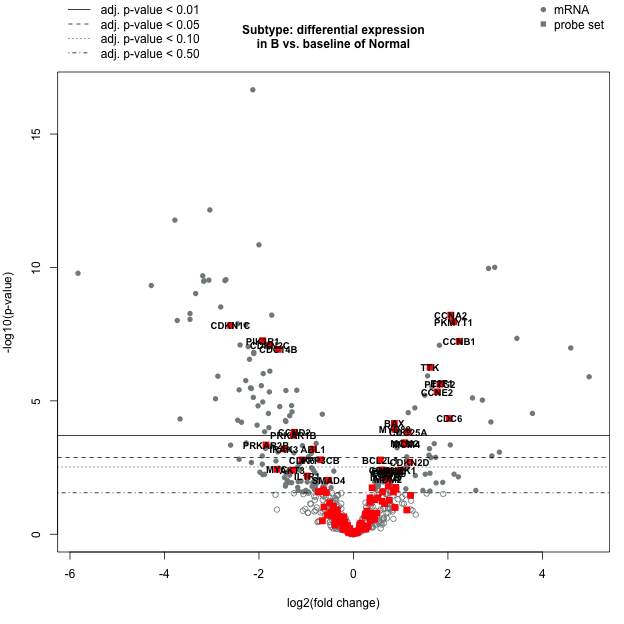
Volcano Plot: SubtypeB
Volcano plot displaying each gene's -log10(p-value) and log2 fold change for the selected covariate. Highly statistically significant genes fall at the top of the plot, and highly differentially expressed genes fall to either side. Genes within the selected gene set are highlighted in blue. Green point colors and horizontal lines indicate various False Discovery Rate (FDR) thresholds.
DE Results - CC.PLS.Apop genes - SubtypeB
More Plot Information Download CSV DataProbe Label Log2 fold change std error Lower confidence limit Upper confidence limit P-value BY.p.value Gene.sets Codeset.Name Probe.Label Analyte.Type Is.Control Control.Type Probe.Annotation KEGG.Pathways Cell.Type Official.Gene.Name volcanocol volcanopch tstats.all CCNA2-mRNA 2.06 0.297 1.48 2.65 6.1e-09 1.28e-06 CC.PLS.Apop NS_CANCERPATH_C2535 CCNA2 mRNA 0 CC.PLS.Apop hsa04110;hsa04152;hsa04914;hsa05161;hsa05169;hsa05203 CCNA2 chartreuse1 16 6.93602693602694 PKMYT1-mRNA 2.12 0.312 1.51 2.73 1.08e-08 1.95e-06 CC.PLS.Apop NS_CANCERPATH_C2535 PKMYT1 mRNA 0 CC.PLS.Apop hsa04110;hsa04114;hsa04914 PKMYT1 chartreuse1 16 6.7948717948718 CDKN1C-mRNA -2.6 0.388 -3.36 -1.84 1.49e-08 2.37e-06 CC.PLS.Apop NS_CANCERPATH_C2535 CDKN1C mRNA 0 CC.PLS.Apop hsa04110 CDKN1C chartreuse1 16 -6.70103092783505 PIK3R1-mRNA -1.92 0.303 -2.52 -1.33 5.54e-08 8.16e-06 CC.PLS.Apop, Driver Gene, JAK-STAT, PI3K, RAS NS_CANCERPATH_C2535 PIK3R1 mRNA 0 CC.PLS.Apop;RAS;PI3K;JAK-STAT;Driver Gene hsa04012;hsa04014;hsa04015;hsa04022;hsa04024;hsa04062;hsa04066;hsa04068;hsa04070;hsa04071;hsa04072;hsa04150;hsa04151;hsa04152;hsa04210;hsa04211;hsa04261;hsa04370;hsa04380;hsa04510;hsa04550;hsa04611;hsa04620;hsa04630;hsa04650;hsa04660;hsa04662;hsa04664;hsa04666;hsa04668;hsa04670;hsa04722;hsa04725;hsa04750;hsa04810;hsa04910;hsa04914;hsa04915;hsa04917;hsa04919;hsa04921;hsa04923;hsa04930;hsa04931;hsa04932;hsa04933;hsa04960;hsa04973;hsa05100;hsa05142;hsa05145;hsa05146;hsa05160;hsa05161;hsa05162;hsa05164;hsa05166;hsa05169;hsa05200;hsa05203;hsa05205;hsa05210;hsa05211;hsa05212;hsa05213;hsa05214;hsa05215;hsa05218;hsa05220;hsa05221;hsa05222;hsa05223;hsa05230;hsa05231 PIK3R1 chartreuse1 16 -6.33663366336634 CCNB1-mRNA 2.24 0.354 1.55 2.93 5.86e-08 8.33e-06 CC.PLS.Apop NS_CANCERPATH_C2535 CCNB1 mRNA 0 CC.PLS.Apop hsa04068;hsa04110;hsa04114;hsa04115;hsa04914 CCNB1 chartreuse1 16 6.32768361581921 CDKN2C-mRNA -1.77 0.284 -2.33 -1.21 8.12e-08 1.06e-05 CC.PLS.Apop, TXmisReg NS_CANCERPATH_C2535 CDKN2C mRNA 0 CC.PLS.Apop;TXmisReg hsa04110;hsa05166;hsa05202 CDKN2C chartreuse1 16 -6.23239436619718 CDC14B-mRNA -1.59 0.259 -2.1 -1.08 1.17e-07 1.33e-05 CC.PLS.Apop NS_CANCERPATH_C2535 CDC14B mRNA 0 CC.PLS.Apop hsa04110 CDC14B chartreuse1 16 -6.13899613899614 TTK-mRNA 1.62 0.283 1.06 2.17 5.53e-07 5.64e-05 CC.PLS.Apop NS_CANCERPATH_C2535 TTK mRNA 0 CC.PLS.Apop hsa04110 TTK chartreuse1 16 5.7243816254417 E2F1-mRNA 1.87 0.351 1.18 2.55 2.24e-06 0.000194 CC.PLS.Apop NS_CANCERPATH_C2535 E2F1 mRNA 0 CC.PLS.Apop hsa04110;hsa05161;hsa05166;hsa05200;hsa05206;hsa05212;hsa05214;hsa05215;hsa05218;hsa05219;hsa05220;hsa05222;hsa05223 E2F1 chartreuse1 16 5.32763532763533 PTTG2-mRNA 1.83 0.346 1.15 2.51 2.38e-06 0.000202 CC.PLS.Apop NS_CANCERPATH_C2535 PTTG2 mRNA 0 CC.PLS.Apop hsa04110;hsa04114;hsa05166 PTTG2 chartreuse1 16 5.28901734104046 CCNE2-mRNA 1.77 0.347 1.09 2.45 4.61e-06 0.000328 CC.PLS.Apop, PI3K NS_CANCERPATH_C2535 CCNE2 mRNA 0 CC.PLS.Apop;PI3K hsa04110;hsa04114;hsa04115;hsa04151;hsa05161;hsa05162;hsa05200;hsa05203;hsa05206;hsa05215;hsa05222 CCNE2 chartreuse1 16 5.10086455331412 CDC6-mRNA 2.03 0.457 1.14 2.93 4.58e-05 0.0025 CC.PLS.Apop NS_CANCERPATH_C2535 CDC6 mRNA 0 CC.PLS.Apop hsa04110 CDC6 chartreuse1 16 4.44201312910284 BAX-mRNA 0.866 0.2 0.473 1.26 6.97e-05 0.00347 CC.PLS.Apop NS_CANCERPATH_C2535 BAX mRNA 0 CC.PLS.Apop hsa04071;hsa04115;hsa04141;hsa04210;hsa04211;hsa04722;hsa04932;hsa04933;hsa05014;hsa05016;hsa05020;hsa05152;hsa05161;hsa05166;hsa05200;hsa05203;hsa05210 BAX chartreuse1 16 4.33 MYD88-mRNA 0.879 0.211 0.465 1.29 0.000117 0.00559 CC.PLS.Apop, Driver Gene NS_CANCERPATH_C2535 MYD88 mRNA 0 CC.PLS.Apop;Driver Gene hsa04064;hsa04210;hsa04620;hsa05132;hsa05133;hsa05134;hsa05140;hsa05142;hsa05143;hsa05144;hsa05145;hsa05152;hsa05161;hsa05162;hsa05164;hsa05168 MYD88 chartreuse1 16 4.16587677725119 CDC25A-mRNA 1.16 0.283 0.608 1.72 0.000143 0.00675 CC.PLS.Apop NS_CANCERPATH_C2535 CDC25A mRNA 0 CC.PLS.Apop hsa04110;hsa04914;hsa05206 CDC25A chartreuse1 16 4.09893992932862 CCND2-mRNA -1.25 0.306 -1.85 -0.652 0.00015 0.00694 CC.PLS.Apop, JAK-STAT, PI3K, TXmisReg, Wnt NS_CANCERPATH_C2535 CCND2 mRNA 0 CC.PLS.Apop;PI3K;JAK-STAT;TXmisReg;Wnt hsa04068;hsa04110;hsa04115;hsa04151;hsa04310;hsa04390;hsa04510;hsa04630;hsa04917;hsa05162;hsa05166;hsa05202;hsa05203;hsa05206 CCND2 chartreuse1 16 -4.08496732026144 PRKAR1B-mRNA -1.27 0.316 -1.89 -0.646 0.000198 0.00897 CC.PLS.Apop NS_CANCERPATH_C2535 PRKAR1B mRNA 0 CC.PLS.Apop hsa04210;hsa04910 PRKAR1B chartreuse2 16 -4.01898734177215 MCM2-mRNA 1.08 0.284 0.526 1.64 0.00037 0.0165 CC.PLS.Apop NS_CANCERPATH_C2535 MCM2 mRNA 0 CC.PLS.Apop hsa03030;hsa04110 MCM2 chartreuse2 16 3.80281690140845 MCM4-mRNA 1.12 0.297 0.539 1.7 0.000415 0.0177 CC.PLS.Apop NS_CANCERPATH_C2535 MCM4 mRNA 0 CC.PLS.Apop hsa03030;hsa04110 MCM4 chartreuse2 16 3.77104377104377 PRKAR2B-mRNA -1.85 0.494 -2.82 -0.882 0.000451 0.0189 CC.PLS.Apop NS_CANCERPATH_C2535 PRKAR2B mRNA 0 CC.PLS.Apop hsa04210;hsa04910 PRKAR2B chartreuse2 16 -3.74493927125506 DE Results - CC.PLS.Apop genes - SubtypeB
Table displaying each sample's global significance scores and directed global significance scores as defined in the heatmaps above. The global significance score is calculated as the square root of the mean squared t-statistic for the genes in a gene set, with t-statistics coming from the linear regression underlying our differential expression analysis. The directed global significance score is calculated as the square root of the mean signed squared t-statistic for the genes in a gene set, with t-statistics coming from the linear regression underlying our differential expression analysis.
Volcano Plot: SubtypeC
More Plot Information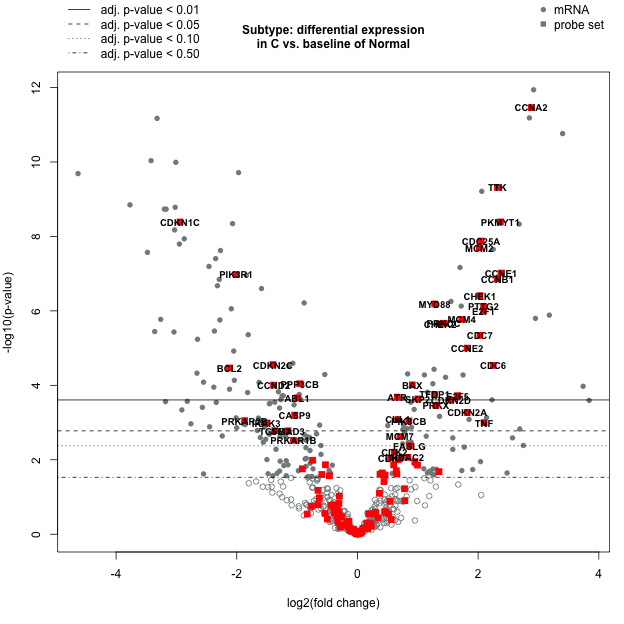
Volcano Plot: SubtypeC
Volcano plot displaying each gene's -log10(p-value) and log2 fold change for the selected covariate. Highly statistically significant genes fall at the top of the plot, and highly differentially expressed genes fall to either side. Genes within the selected gene set are highlighted in blue. Green point colors and horizontal lines indicate various False Discovery Rate (FDR) thresholds.
DE Results - CC.PLS.Apop genes - SubtypeC
More Plot Information Download CSV DataProbe Label Log2 fold change std error Lower confidence limit Upper confidence limit P-value BY.p.value Gene.sets Codeset.Name Probe.Label Analyte.Type Is.Control Control.Type Probe.Annotation KEGG.Pathways Cell.Type Official.Gene.Name volcanocol volcanopch tstats.all CCNA2-mRNA 2.88 0.32 2.25 3.5 3.45e-12 6.71e-09 CC.PLS.Apop NS_CANCERPATH_C2535 CCNA2 mRNA 0 CC.PLS.Apop hsa04110;hsa04152;hsa04914;hsa05161;hsa05169;hsa05203 CCNA2 chartreuse1 16 9 TTK-mRNA 2.32 0.304 1.73 2.92 4.85e-10 1.93e-07 CC.PLS.Apop NS_CANCERPATH_C2535 TTK mRNA 0 CC.PLS.Apop hsa04110 TTK chartreuse1 16 7.63157894736842 PKMYT1-mRNA 2.37 0.336 1.71 3.03 4.07e-09 9.61e-07 CC.PLS.Apop NS_CANCERPATH_C2535 PKMYT1 mRNA 0 CC.PLS.Apop hsa04110;hsa04114;hsa04914 PKMYT1 chartreuse1 16 7.05357142857143 CDKN1C-mRNA -2.94 0.418 -3.76 -2.13 4.1e-09 9.61e-07 CC.PLS.Apop NS_CANCERPATH_C2535 CDKN1C mRNA 0 CC.PLS.Apop hsa04110 CDKN1C chartreuse1 16 -7.03349282296651 CDC25A-mRNA 2.05 0.305 1.45 2.65 1.33e-08 2.41e-06 CC.PLS.Apop NS_CANCERPATH_C2535 CDC25A mRNA 0 CC.PLS.Apop hsa04110;hsa04914;hsa05206 CDC25A chartreuse1 16 6.72131147540984 MCM2-mRNA 2.02 0.306 1.42 2.62 2.03e-08 3.36e-06 CC.PLS.Apop NS_CANCERPATH_C2535 MCM2 mRNA 0 CC.PLS.Apop hsa03030;hsa04110 MCM2 chartreuse1 16 6.60130718954248 CCNE1-mRNA 2.38 0.384 1.62 3.13 9.66e-08 1.24e-05 CC.PLS.Apop, PI3K NS_CANCERPATH_C2535 CCNE1 mRNA 0 CC.PLS.Apop;PI3K hsa04110;hsa04114;hsa04115;hsa04151;hsa05161;hsa05162;hsa05200;hsa05203;hsa05206;hsa05215;hsa05222 CCNE1 chartreuse1 16 6.19791666666667 PIK3R1-mRNA -2.01 0.326 -2.65 -1.37 1.06e-07 1.31e-05 CC.PLS.Apop, Driver Gene, JAK-STAT, PI3K, RAS NS_CANCERPATH_C2535 PIK3R1 mRNA 0 CC.PLS.Apop;RAS;PI3K;JAK-STAT;Driver Gene hsa04012;hsa04014;hsa04015;hsa04022;hsa04024;hsa04062;hsa04066;hsa04068;hsa04070;hsa04071;hsa04072;hsa04150;hsa04151;hsa04152;hsa04210;hsa04211;hsa04261;hsa04370;hsa04380;hsa04510;hsa04550;hsa04611;hsa04620;hsa04630;hsa04650;hsa04660;hsa04662;hsa04664;hsa04666;hsa04668;hsa04670;hsa04722;hsa04725;hsa04750;hsa04810;hsa04910;hsa04914;hsa04915;hsa04917;hsa04919;hsa04921;hsa04923;hsa04930;hsa04931;hsa04932;hsa04933;hsa04960;hsa04973;hsa05100;hsa05142;hsa05145;hsa05146;hsa05160;hsa05161;hsa05162;hsa05164;hsa05166;hsa05169;hsa05200;hsa05203;hsa05205;hsa05210;hsa05211;hsa05212;hsa05213;hsa05214;hsa05215;hsa05218;hsa05220;hsa05221;hsa05222;hsa05223;hsa05230;hsa05231 PIK3R1 chartreuse1 16 -6.16564417177914 CCNB1-mRNA 2.32 0.381 1.57 3.06 1.4e-07 1.62e-05 CC.PLS.Apop NS_CANCERPATH_C2535 CCNB1 mRNA 0 CC.PLS.Apop hsa04068;hsa04110;hsa04114;hsa04115;hsa04914 CCNB1 chartreuse1 16 6.08923884514436 CHEK1-mRNA 2.03 0.35 1.35 2.72 3.89e-07 4.08e-05 CC.PLS.Apop NS_CANCERPATH_C2535 CHEK1 mRNA 0 CC.PLS.Apop hsa04110;hsa04115;hsa05166;hsa05203 CHEK1 chartreuse1 16 5.8 MYD88-mRNA 1.28 0.227 0.84 1.73 6.52e-07 6.32e-05 CC.PLS.Apop, Driver Gene NS_CANCERPATH_C2535 MYD88 mRNA 0 CC.PLS.Apop;Driver Gene hsa04064;hsa04210;hsa04620;hsa05132;hsa05133;hsa05134;hsa05140;hsa05142;hsa05143;hsa05144;hsa05145;hsa05152;hsa05161;hsa05162;hsa05164;hsa05168 MYD88 chartreuse1 16 5.63876651982379 PTTG2-mRNA 2.09 0.372 1.36 2.82 7.64e-07 7.07e-05 CC.PLS.Apop NS_CANCERPATH_C2535 PTTG2 mRNA 0 CC.PLS.Apop hsa04110;hsa04114;hsa05166 PTTG2 chartreuse1 16 5.61827956989247 E2F1-mRNA 2.09 0.377 1.35 2.83 1.01e-06 8.92e-05 CC.PLS.Apop NS_CANCERPATH_C2535 E2F1 mRNA 0 CC.PLS.Apop hsa04110;hsa05161;hsa05166;hsa05200;hsa05206;hsa05212;hsa05214;hsa05215;hsa05218;hsa05219;hsa05220;hsa05222;hsa05223 E2F1 chartreuse1 16 5.54376657824934 MCM4-mRNA 1.73 0.32 1.1 2.35 1.7e-06 0.000138 CC.PLS.Apop NS_CANCERPATH_C2535 MCM4 mRNA 0 CC.PLS.Apop hsa03030;hsa04110 MCM4 chartreuse1 16 5.40625 PRKDC-mRNA 1.43 0.269 0.906 1.96 2.15e-06 0.000168 CC.PLS.Apop, DNARepair NS_CANCERPATH_C2535 PRKDC mRNA 0 CC.PLS.Apop;DNARepair hsa03450;hsa04110 PRKDC chartreuse1 16 5.31598513011152 CHEK2-mRNA 1.37 0.258 0.867 1.88 2.23e-06 0.00017 CC.PLS.Apop NS_CANCERPATH_C2535 CHEK2 mRNA 0 CC.PLS.Apop hsa04110;hsa04115;hsa05166 CHEK2 chartreuse1 16 5.31007751937985 CDC7-mRNA 2.03 0.396 1.25 2.81 4.56e-06 0.000318 CC.PLS.Apop NS_CANCERPATH_C2535 CDC7 mRNA 0 CC.PLS.Apop hsa04110 CDC7 chartreuse1 16 5.12626262626263 CCNE2-mRNA 1.82 0.373 1.09 2.55 1e-05 0.000675 CC.PLS.Apop, PI3K NS_CANCERPATH_C2535 CCNE2 mRNA 0 CC.PLS.Apop;PI3K hsa04110;hsa04114;hsa04115;hsa04151;hsa05161;hsa05162;hsa05200;hsa05203;hsa05206;hsa05215;hsa05222 CCNE2 chartreuse1 16 4.87935656836461 CDKN2C-mRNA -1.4 0.305 -2 -0.805 2.77e-05 0.00178 CC.PLS.Apop, TXmisReg NS_CANCERPATH_C2535 CDKN2C mRNA 0 CC.PLS.Apop;TXmisReg hsa04110;hsa05166;hsa05202 CDKN2C chartreuse1 16 -4.59016393442623 CDC6-mRNA 2.25 0.491 1.29 3.21 2.92e-05 0.00184 CC.PLS.Apop NS_CANCERPATH_C2535 CDC6 mRNA 0 CC.PLS.Apop hsa04110 CDC6 chartreuse1 16 4.58248472505092 DE Results - CC.PLS.Apop genes - SubtypeC
Table displaying each sample's global significance scores and directed global significance scores as defined in the heatmaps above. The global significance score is calculated as the square root of the mean squared t-statistic for the genes in a gene set, with t-statistics coming from the linear regression underlying our differential expression analysis. The directed global significance score is calculated as the square root of the mean signed squared t-statistic for the genes in a gene set, with t-statistics coming from the linear regression underlying our differential expression analysis.
Volcano Plot: SubtypeD
More Plot Information
Volcano Plot: SubtypeD
Volcano plot displaying each gene's -log10(p-value) and log2 fold change for the selected covariate. Highly statistically significant genes fall at the top of the plot, and highly differentially expressed genes fall to either side. Genes within the selected gene set are highlighted in blue. Green point colors and horizontal lines indicate various False Discovery Rate (FDR) thresholds.
DE Results - CC.PLS.Apop genes - SubtypeD
More Plot Information Download CSV DataProbe Label Log2 fold change std error Lower confidence limit Upper confidence limit P-value BY.p.value Gene.sets Codeset.Name Probe.Label Analyte.Type Is.Control Control.Type Probe.Annotation KEGG.Pathways Cell.Type Official.Gene.Name volcanocol volcanopch tstats.all PKMYT1-mRNA 2.34 0.324 1.7 2.98 2.24e-09 1.12e-06 CC.PLS.Apop NS_CANCERPATH_C2535 PKMYT1 mRNA 0 CC.PLS.Apop hsa04110;hsa04114;hsa04914 PKMYT1 chartreuse1 16 7.22222222222222 TTK-mRNA 1.98 0.294 1.41 2.56 1.28e-08 3.54e-06 CC.PLS.Apop NS_CANCERPATH_C2535 TTK mRNA 0 CC.PLS.Apop hsa04110 TTK chartreuse1 16 6.73469387755102 CCNA2-mRNA 2.08 0.309 1.47 2.69 1.32e-08 3.54e-06 CC.PLS.Apop NS_CANCERPATH_C2535 CCNA2 mRNA 0 CC.PLS.Apop hsa04110;hsa04152;hsa04914;hsa05161;hsa05169;hsa05203 CCNA2 chartreuse1 16 6.73139158576052 CDKN2C-mRNA -1.91 0.295 -2.49 -1.33 3.37e-08 7.57e-06 CC.PLS.Apop, TXmisReg NS_CANCERPATH_C2535 CDKN2C mRNA 0 CC.PLS.Apop;TXmisReg hsa04110;hsa05166;hsa05202 CDKN2C chartreuse1 16 -6.47457627118644 CCNB1-mRNA 2.36 0.368 1.64 3.08 4.18e-08 8.75e-06 CC.PLS.Apop NS_CANCERPATH_C2535 CCNB1 mRNA 0 CC.PLS.Apop hsa04068;hsa04110;hsa04114;hsa04115;hsa04914 CCNB1 chartreuse1 16 6.41304347826087 CDKN1C-mRNA -2.58 0.404 -3.38 -1.79 4.41e-08 8.78e-06 CC.PLS.Apop NS_CANCERPATH_C2535 CDKN1C mRNA 0 CC.PLS.Apop hsa04110 CDKN1C chartreuse1 16 -6.38613861386139 CDC6-mRNA 2.92 0.474 1.99 3.85 1.1e-07 2e-05 CC.PLS.Apop NS_CANCERPATH_C2535 CDC6 mRNA 0 CC.PLS.Apop hsa04110 CDC6 chartreuse1 16 6.16033755274262 CCNE2-mRNA 2.19 0.36 1.48 2.9 1.46e-07 2.37e-05 CC.PLS.Apop, PI3K NS_CANCERPATH_C2535 CCNE2 mRNA 0 CC.PLS.Apop;PI3K hsa04110;hsa04114;hsa04115;hsa04151;hsa05161;hsa05162;hsa05200;hsa05203;hsa05206;hsa05215;hsa05222 CCNE2 chartreuse1 16 6.08333333333333 E2F1-mRNA 2.16 0.365 1.45 2.88 2.53e-07 3.21e-05 CC.PLS.Apop NS_CANCERPATH_C2535 E2F1 mRNA 0 CC.PLS.Apop hsa04110;hsa05161;hsa05166;hsa05200;hsa05206;hsa05212;hsa05214;hsa05215;hsa05218;hsa05219;hsa05220;hsa05222;hsa05223 E2F1 chartreuse1 16 5.91780821917808 CDC14B-mRNA -1.44 0.27 -1.97 -0.913 2.01e-06 2e-04 CC.PLS.Apop NS_CANCERPATH_C2535 CDC14B mRNA 0 CC.PLS.Apop hsa04110 CDC14B chartreuse1 16 -5.33333333333333 PTTG2-mRNA 1.84 0.359 1.14 2.54 4.49e-06 0.00038 CC.PLS.Apop NS_CANCERPATH_C2535 PTTG2 mRNA 0 CC.PLS.Apop hsa04110;hsa04114;hsa05166 PTTG2 chartreuse1 16 5.12534818941504 CHEK2-mRNA 1.22 0.249 0.729 1.71 1.04e-05 0.000777 CC.PLS.Apop NS_CANCERPATH_C2535 CHEK2 mRNA 0 CC.PLS.Apop hsa04110;hsa04115;hsa05166 CHEK2 chartreuse1 16 4.8995983935743 MYD88-mRNA 1.04 0.219 0.612 1.47 1.62e-05 0.00113 CC.PLS.Apop, Driver Gene NS_CANCERPATH_C2535 MYD88 mRNA 0 CC.PLS.Apop;Driver Gene hsa04064;hsa04210;hsa04620;hsa05132;hsa05133;hsa05134;hsa05140;hsa05142;hsa05143;hsa05144;hsa05145;hsa05152;hsa05161;hsa05162;hsa05164;hsa05168 MYD88 chartreuse1 16 4.74885844748858 MCM4-mRNA 1.39 0.309 0.782 1.99 4e-05 0.00253 CC.PLS.Apop NS_CANCERPATH_C2535 MCM4 mRNA 0 CC.PLS.Apop hsa03030;hsa04110 MCM4 chartreuse1 16 4.49838187702265 MCM2-mRNA 1.32 0.296 0.739 1.9 4.38e-05 0.00272 CC.PLS.Apop NS_CANCERPATH_C2535 MCM2 mRNA 0 CC.PLS.Apop hsa03030;hsa04110 MCM2 chartreuse1 16 4.45945945945946 CCNE1-mRNA 1.64 0.371 0.909 2.36 5.2e-05 0.00318 CC.PLS.Apop, PI3K NS_CANCERPATH_C2535 CCNE1 mRNA 0 CC.PLS.Apop;PI3K hsa04110;hsa04114;hsa04115;hsa04151;hsa05161;hsa05162;hsa05200;hsa05203;hsa05206;hsa05215;hsa05222 CCNE1 chartreuse1 16 4.42048517520216 CDC25A-mRNA 1.29 0.294 0.708 1.86 6.03e-05 0.00363 CC.PLS.Apop NS_CANCERPATH_C2535 CDC25A mRNA 0 CC.PLS.Apop hsa04110;hsa04914;hsa05206 CDC25A chartreuse1 16 4.38775510204082 PIK3R1-mRNA -1.3 0.315 -1.92 -0.683 0.000133 0.00749 CC.PLS.Apop, Driver Gene, JAK-STAT, PI3K, RAS NS_CANCERPATH_C2535 PIK3R1 mRNA 0 CC.PLS.Apop;RAS;PI3K;JAK-STAT;Driver Gene hsa04012;hsa04014;hsa04015;hsa04022;hsa04024;hsa04062;hsa04066;hsa04068;hsa04070;hsa04071;hsa04072;hsa04150;hsa04151;hsa04152;hsa04210;hsa04211;hsa04261;hsa04370;hsa04380;hsa04510;hsa04550;hsa04611;hsa04620;hsa04630;hsa04650;hsa04660;hsa04662;hsa04664;hsa04666;hsa04668;hsa04670;hsa04722;hsa04725;hsa04750;hsa04810;hsa04910;hsa04914;hsa04915;hsa04917;hsa04919;hsa04921;hsa04923;hsa04930;hsa04931;hsa04932;hsa04933;hsa04960;hsa04973;hsa05100;hsa05142;hsa05145;hsa05146;hsa05160;hsa05161;hsa05162;hsa05164;hsa05166;hsa05169;hsa05200;hsa05203;hsa05205;hsa05210;hsa05211;hsa05212;hsa05213;hsa05214;hsa05215;hsa05218;hsa05220;hsa05221;hsa05222;hsa05223;hsa05230;hsa05231 PIK3R1 chartreuse1 16 -4.12698412698413 CHEK1-mRNA 1.28 0.338 0.622 1.95 0.000382 0.0179 CC.PLS.Apop NS_CANCERPATH_C2535 CHEK1 mRNA 0 CC.PLS.Apop hsa04110;hsa04115;hsa05166;hsa05203 CHEK1 chartreuse2 16 3.78698224852071 AKT1-mRNA 1.14 0.308 0.537 1.74 0.000514 0.023 CC.PLS.Apop, Driver Gene, JAK-STAT, MAPK, PI3K, RAS NS_CANCERPATH_C2535 AKT1 mRNA 0 CC.PLS.Apop;RAS;PI3K;JAK-STAT;MAPK;Driver Gene hsa04010;hsa04012;hsa04014;hsa04015;hsa04022;hsa04024;hsa04062;hsa04066;hsa04068;hsa04071;hsa04072;hsa04150;hsa04151;hsa04152;hsa04210;hsa04211;hsa04261;hsa04370;hsa04380;hsa04510;hsa04530;hsa04550;hsa04611;hsa04620;hsa04630;hsa04660;hsa04662;hsa04664;hsa04666;hsa04668;hsa04722;hsa04725;hsa04728;hsa04910;hsa04914;hsa04915;hsa04917;hsa04919;hsa04920;hsa04922;hsa04923;hsa04931;hsa04932;hsa04933;hsa04973;hsa05142;hsa05145;hsa05152;hsa05160;hsa05161;hsa05162;hsa05164;hsa05166;hsa05169;hsa05200;hsa05205;hsa05210;hsa05211;hsa05212;hsa05213;hsa05214;hsa05215;hsa05218;hsa05220;hsa05221;hsa05222;hsa05223;hsa05230;hsa05231 AKT1 chartreuse2 16 3.7012987012987 DE Results - CC.PLS.Apop genes - SubtypeD
Table displaying each sample's global significance scores and directed global significance scores as defined in the heatmaps above. The global significance score is calculated as the square root of the mean squared t-statistic for the genes in a gene set, with t-statistics coming from the linear regression underlying our differential expression analysis. The directed global significance score is calculated as the square root of the mean signed squared t-statistic for the genes in a gene set, with t-statistics coming from the linear regression underlying our differential expression analysis.
- Subtype:
- SubtypeA
- SubtypeB
- SubtypeC
- SubtypeD
Volcano Plot: SubtypeA
More Plot Information
Volcano Plot: SubtypeA
Volcano plot displaying each gene's -log10(p-value) and log2 fold change for the selected covariate. Highly statistically significant genes fall at the top of the plot, and highly differentially expressed genes fall to either side. Genes within the selected gene set are highlighted in blue. Green point colors and horizontal lines indicate various False Discovery Rate (FDR) thresholds.
DE Results - ChromMod genes - SubtypeA
More Plot Information Download CSV DataProbe Label Log2 fold change std error Lower confidence limit Upper confidence limit P-value BY.p.value Gene.sets Codeset.Name Probe.Label Analyte.Type Is.Control Control.Type Probe.Annotation KEGG.Pathways Cell.Type Official.Gene.Name volcanocol volcanopch tstats.all RPS6KA5-mRNA -0.896 0.373 -1.63 -0.165 0.02 0.64 ChromMod, MAPK NS_CANCERPATH_C2535 RPS6KA5 mRNA 0 MAPK;ChromMod hsa04010;hsa04261;hsa04668;hsa04713;hsa04722;hsa05206;hsa05219 RPS6KA5 azure4 1 -2.40214477211796 NASP-mRNA -0.727 0.305 -1.32 -0.13 0.0207 0.653 ChromMod NS_CANCERPATH_C2535 NASP mRNA 0 ChromMod NASP azure4 1 -2.38360655737705 ARID1A-mRNA 0.435 0.192 0.0584 0.812 0.0278 0.779 ChromMod, Driver Gene NS_CANCERPATH_C2535 ARID1A mRNA 0 ChromMod;Driver Gene ARID1A azure4 1 2.265625 SUV39H2-mRNA 0.486 0.268 -0.0394 1.01 0.0756 1 ChromMod NS_CANCERPATH_C2535 SUV39H2 mRNA 0 ChromMod hsa00310 SUV39H2 azure4 1 1.8134328358209 HDAC10-mRNA 0.389 0.234 -0.0694 0.847 0.102 1 ChromMod NS_CANCERPATH_C2535 HDAC10 mRNA 0 ChromMod hsa05034;hsa05203 HDAC10 azure4 1 1.66239316239316 WHSC1L1-mRNA 0.479 0.362 -0.231 1.19 0.192 1 ChromMod NS_CANCERPATH_C2535 WHSC1L1 mRNA 0 ChromMod hsa00310 WHSC1L1 azure4 1 1.3232044198895 HDAC1-mRNA 0.241 0.197 -0.145 0.628 0.226 1 CC.PLS.Apop, ChromMod, Notch, TXmisReg NS_CANCERPATH_C2535 HDAC1 mRNA 0 CC.PLS.Apop;TXmisReg;ChromMod;Notch hsa04110;hsa04330;hsa04919;hsa05016;hsa05031;hsa05034;hsa05169;hsa05200;hsa05202;hsa05203;hsa05206;hsa05220 HDAC1 azure4 1 1.22335025380711 BNIP3-mRNA -0.607 0.496 -1.58 0.364 0.226 1 ChromMod NS_CANCERPATH_C2535 BNIP3 mRNA 0 ChromMod hsa04068;hsa05134 BNIP3 azure4 1 -1.22379032258065 HDAC11-mRNA 0.442 0.362 -0.268 1.15 0.228 1 ChromMod NS_CANCERPATH_C2535 HDAC11 mRNA 0 ChromMod hsa05034;hsa05203 HDAC11 azure4 1 1.22099447513812 HDAC6-mRNA -0.358 0.304 -0.953 0.237 0.244 1 ChromMod NS_CANCERPATH_C2535 HDAC6 mRNA 0 ChromMod hsa05034;hsa05203 HDAC6 azure4 1 -1.17763157894737 HDAC4-mRNA -0.346 0.296 -0.926 0.234 0.247 1 ChromMod NS_CANCERPATH_C2535 HDAC4 mRNA 0 ChromMod hsa05034;hsa05169;hsa05203;hsa05206 HDAC4 azure4 1 -1.16891891891892 NSD1-mRNA 0.284 0.25 -0.206 0.774 0.261 1 ChromMod NS_CANCERPATH_C2535 NSD1 mRNA 0 ChromMod hsa00310 NSD1 azure4 1 1.136 HELLS-mRNA 0.242 0.278 -0.303 0.788 0.388 1 ChromMod NS_CANCERPATH_C2535 HELLS mRNA 0 ChromMod HELLS azure4 1 0.870503597122302 PPARGC1A-mRNA -0.339 0.396 -1.12 0.437 0.395 1 ChromMod NS_CANCERPATH_C2535 PPARGC1A mRNA 0 ChromMod hsa04152;hsa04211;hsa04910;hsa04920;hsa04922;hsa04931;hsa05016 PPARGC1A azure4 1 -0.856060606060606 HMGA1-mRNA 0.271 0.33 -0.376 0.917 0.415 1 ChromMod NS_CANCERPATH_C2535 HMGA1 mRNA 0 ChromMod HMGA1 azure4 1 0.821212121212121 HDAC5-mRNA -0.19 0.257 -0.694 0.314 0.463 1 ChromMod NS_CANCERPATH_C2535 HDAC5 mRNA 0 ChromMod hsa05034;hsa05169;hsa05203 HDAC5 azure4 1 -0.739299610894942 MAP3K12-mRNA 0.121 0.302 -0.472 0.714 0.691 1 ChromMod, MAPK NS_CANCERPATH_C2535 MAP3K12 mRNA 0 MAPK;ChromMod hsa04010 MAP3K12 azure4 1 0.400662251655629 CREBBP-mRNA 0.0973 0.267 -0.426 0.621 0.717 1 CC.PLS.Apop, ChromMod, Driver Gene, JAK-STAT, Notch, TGF-B, Wnt NS_CANCERPATH_C2535 CREBBP mRNA 0 CC.PLS.Apop;JAK-STAT;TGF-B;ChromMod;Wnt;Notch;Driver Gene hsa04024;hsa04066;hsa04068;hsa04110;hsa04310;hsa04330;hsa04350;hsa04520;hsa04630;hsa04720;hsa04916;hsa04919;hsa04922;hsa05016;hsa05152;hsa05161;hsa05164;hsa05166;hsa05168;hsa05169;hsa05200;hsa05203;hsa05206;hsa05211;hsa05215 CREBBP azure4 1 0.364419475655431 HDAC2-mRNA 0.0311 0.301 -0.56 0.622 0.918 1 CC.PLS.Apop, ChromMod, Notch, TXmisReg NS_CANCERPATH_C2535 HDAC2 mRNA 0 CC.PLS.Apop;TXmisReg;ChromMod;Notch hsa04110;hsa04330;hsa04919;hsa05016;hsa05034;hsa05169;hsa05200;hsa05202;hsa05203;hsa05220 HDAC2 azure4 1 0.103322259136213 DE Results - ChromMod genes - SubtypeA
Table displaying each sample's global significance scores and directed global significance scores as defined in the heatmaps above. The global significance score is calculated as the square root of the mean squared t-statistic for the genes in a gene set, with t-statistics coming from the linear regression underlying our differential expression analysis. The directed global significance score is calculated as the square root of the mean signed squared t-statistic for the genes in a gene set, with t-statistics coming from the linear regression underlying our differential expression analysis.
Volcano Plot: SubtypeB
More Plot Information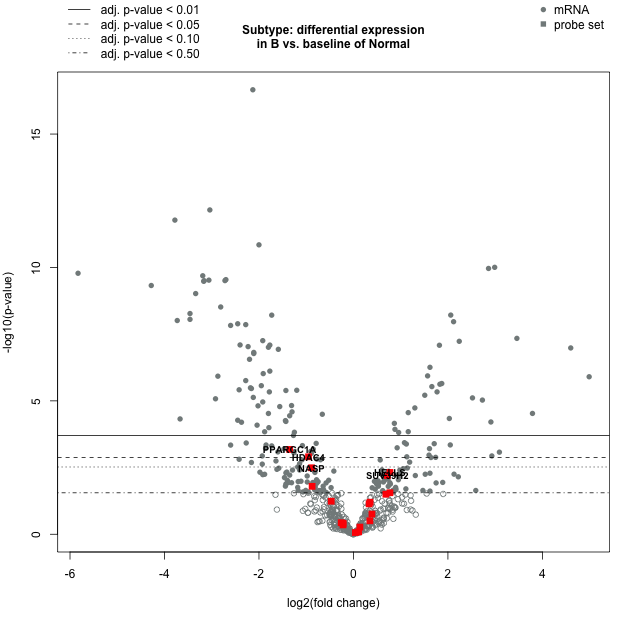
Volcano Plot: SubtypeB
Volcano plot displaying each gene's -log10(p-value) and log2 fold change for the selected covariate. Highly statistically significant genes fall at the top of the plot, and highly differentially expressed genes fall to either side. Genes within the selected gene set are highlighted in blue. Green point colors and horizontal lines indicate various False Discovery Rate (FDR) thresholds.
DE Results - ChromMod genes - SubtypeB
More Plot Information Download CSV DataProbe Label Log2 fold change std error Lower confidence limit Upper confidence limit P-value BY.p.value Gene.sets Codeset.Name Probe.Label Analyte.Type Is.Control Control.Type Probe.Annotation KEGG.Pathways Cell.Type Official.Gene.Name volcanocol volcanopch tstats.all PPARGC1A-mRNA -1.35 0.373 -2.08 -0.62 0.000662 0.0253 ChromMod NS_CANCERPATH_C2535 PPARGC1A mRNA 0 ChromMod hsa04152;hsa04211;hsa04910;hsa04920;hsa04922;hsa04931;hsa05016 PPARGC1A chartreuse2 16 -3.61930294906166 HDAC4-mRNA -0.951 0.279 -1.5 -0.405 0.00125 0.0437 ChromMod NS_CANCERPATH_C2535 HDAC4 mRNA 0 ChromMod hsa05034;hsa05169;hsa05203;hsa05206 HDAC4 chartreuse2 16 -3.40860215053763 NASP-mRNA -0.887 0.287 -1.45 -0.324 0.00322 0.1 ChromMod NS_CANCERPATH_C2535 NASP mRNA 0 ChromMod NASP chartreuse4 16 -3.09059233449477 HELLS-mRNA 0.773 0.262 0.258 1.29 0.00482 0.133 ChromMod NS_CANCERPATH_C2535 HELLS mRNA 0 ChromMod HELLS chartreuse4 16 2.95038167938931 SUV39H2-mRNA 0.719 0.253 0.224 1.21 0.00627 0.16 ChromMod NS_CANCERPATH_C2535 SUV39H2 mRNA 0 ChromMod hsa00310 SUV39H2 chartreuse4 16 2.84189723320158 RPS6KA5-mRNA -0.875 0.351 -1.56 -0.186 0.016 0.329 ChromMod, MAPK NS_CANCERPATH_C2535 RPS6KA5 mRNA 0 MAPK;ChromMod hsa04010;hsa04261;hsa04668;hsa04713;hsa04722;hsa05206;hsa05219 RPS6KA5 chartreuse4 16 -2.49287749287749 HDAC11-mRNA 0.773 0.342 0.104 1.44 0.0278 0.492 ChromMod NS_CANCERPATH_C2535 HDAC11 mRNA 0 ChromMod hsa05034;hsa05203 HDAC11 azure4 1 2.26023391812865 HMGA1-mRNA 0.687 0.311 0.0775 1.3 0.0316 0.531 ChromMod NS_CANCERPATH_C2535 HMGA1 mRNA 0 ChromMod HMGA1 azure4 1 2.20900321543408 HDAC5-mRNA -0.47 0.242 -0.944 0.00475 0.0578 0.861 ChromMod NS_CANCERPATH_C2535 HDAC5 mRNA 0 ChromMod hsa05034;hsa05169;hsa05203 HDAC5 azure4 1 -1.94214876033058 HDAC1-mRNA 0.353 0.186 -0.0109 0.717 0.0628 0.929 CC.PLS.Apop, ChromMod, Notch, TXmisReg NS_CANCERPATH_C2535 HDAC1 mRNA 0 CC.PLS.Apop;TXmisReg;ChromMod;Notch hsa04110;hsa04330;hsa04919;hsa05016;hsa05031;hsa05034;hsa05169;hsa05200;hsa05202;hsa05203;hsa05206;hsa05220 HDAC1 azure4 1 1.89784946236559 ARID1A-mRNA 0.332 0.181 -0.023 0.687 0.0725 1 ChromMod, Driver Gene NS_CANCERPATH_C2535 ARID1A mRNA 0 ChromMod;Driver Gene ARID1A azure4 1 1.83425414364641 HDAC2-mRNA 0.391 0.284 -0.166 0.947 0.175 1 CC.PLS.Apop, ChromMod, Notch, TXmisReg NS_CANCERPATH_C2535 HDAC2 mRNA 0 CC.PLS.Apop;TXmisReg;ChromMod;Notch hsa04110;hsa04330;hsa04919;hsa05016;hsa05034;hsa05169;hsa05200;hsa05202;hsa05203;hsa05220 HDAC2 azure4 1 1.37676056338028 WHSC1L1-mRNA 0.348 0.341 -0.321 1.02 0.313 1 ChromMod NS_CANCERPATH_C2535 WHSC1L1 mRNA 0 ChromMod hsa00310 WHSC1L1 azure4 1 1.02052785923754 MAP3K12-mRNA -0.259 0.285 -0.817 0.3 0.368 1 ChromMod, MAPK NS_CANCERPATH_C2535 MAP3K12 mRNA 0 MAPK;ChromMod hsa04010 MAP3K12 azure4 1 -0.908771929824562 CREBBP-mRNA -0.218 0.252 -0.711 0.275 0.391 1 CC.PLS.Apop, ChromMod, Driver Gene, JAK-STAT, Notch, TGF-B, Wnt NS_CANCERPATH_C2535 CREBBP mRNA 0 CC.PLS.Apop;JAK-STAT;TGF-B;ChromMod;Wnt;Notch;Driver Gene hsa04024;hsa04066;hsa04068;hsa04110;hsa04310;hsa04330;hsa04350;hsa04520;hsa04630;hsa04720;hsa04916;hsa04919;hsa04922;hsa05016;hsa05152;hsa05161;hsa05164;hsa05166;hsa05168;hsa05169;hsa05200;hsa05203;hsa05206;hsa05211;hsa05215 CREBBP azure4 1 -0.865079365079365 HDAC6-mRNA -0.22 0.286 -0.781 0.341 0.446 1 ChromMod NS_CANCERPATH_C2535 HDAC6 mRNA 0 ChromMod hsa05034;hsa05203 HDAC6 azure4 1 -0.769230769230769 HDAC10-mRNA 0.137 0.22 -0.295 0.568 0.538 1 ChromMod NS_CANCERPATH_C2535 HDAC10 mRNA 0 ChromMod hsa05034;hsa05203 HDAC10 azure4 1 0.622727272727273 BNIP3-mRNA 0.11 0.467 -0.806 1.02 0.815 1 ChromMod NS_CANCERPATH_C2535 BNIP3 mRNA 0 ChromMod hsa04068;hsa05134 BNIP3 azure4 1 0.235546038543897 NSD1-mRNA 0.0411 0.235 -0.42 0.503 0.862 1 ChromMod NS_CANCERPATH_C2535 NSD1 mRNA 0 ChromMod hsa00310 NSD1 azure4 1 0.174893617021277 DE Results - ChromMod genes - SubtypeB
Table displaying each sample's global significance scores and directed global significance scores as defined in the heatmaps above. The global significance score is calculated as the square root of the mean squared t-statistic for the genes in a gene set, with t-statistics coming from the linear regression underlying our differential expression analysis. The directed global significance score is calculated as the square root of the mean signed squared t-statistic for the genes in a gene set, with t-statistics coming from the linear regression underlying our differential expression analysis.
Volcano Plot: SubtypeC
More Plot Information
Volcano Plot: SubtypeC
Volcano plot displaying each gene's -log10(p-value) and log2 fold change for the selected covariate. Highly statistically significant genes fall at the top of the plot, and highly differentially expressed genes fall to either side. Genes within the selected gene set are highlighted in blue. Green point colors and horizontal lines indicate various False Discovery Rate (FDR) thresholds.
DE Results - ChromMod genes - SubtypeC
More Plot Information Download CSV DataProbe Label Log2 fold change std error Lower confidence limit Upper confidence limit P-value BY.p.value Gene.sets Codeset.Name Probe.Label Analyte.Type Is.Control Control.Type Probe.Annotation KEGG.Pathways Cell.Type Official.Gene.Name volcanocol volcanopch tstats.all SUV39H2-mRNA 2.06 0.272 1.52 2.59 6.14e-10 2.22e-07 ChromMod NS_CANCERPATH_C2535 SUV39H2 mRNA 0 ChromMod hsa00310 SUV39H2 chartreuse1 16 7.57352941176471 HELLS-mRNA 1.27 0.282 0.72 1.83 3.7e-05 0.00223 ChromMod NS_CANCERPATH_C2535 HELLS mRNA 0 ChromMod HELLS chartreuse1 16 4.50354609929078 HMGA1-mRNA 1.46 0.334 0.803 2.11 6.08e-05 0.00336 ChromMod NS_CANCERPATH_C2535 HMGA1 mRNA 0 ChromMod HMGA1 chartreuse1 16 4.37125748502994 MAP3K12-mRNA -1.23 0.306 -1.83 -0.631 0.000189 0.00847 ChromMod, MAPK NS_CANCERPATH_C2535 MAP3K12 mRNA 0 MAPK;ChromMod hsa04010 MAP3K12 chartreuse1 16 -4.01960784313725 RPS6KA5-mRNA -1.46 0.378 -2.2 -0.719 0.000313 0.0116 ChromMod, MAPK NS_CANCERPATH_C2535 RPS6KA5 mRNA 0 MAPK;ChromMod hsa04010;hsa04261;hsa04668;hsa04713;hsa04722;hsa05206;hsa05219 RPS6KA5 chartreuse2 16 -3.86243386243386 HDAC2-mRNA 0.834 0.305 0.235 1.43 0.00861 0.188 CC.PLS.Apop, ChromMod, Notch, TXmisReg NS_CANCERPATH_C2535 HDAC2 mRNA 0 CC.PLS.Apop;TXmisReg;ChromMod;Notch hsa04110;hsa04330;hsa04919;hsa05016;hsa05034;hsa05169;hsa05200;hsa05202;hsa05203;hsa05220 HDAC2 chartreuse4 16 2.7344262295082 HDAC4-mRNA -0.736 0.3 -1.32 -0.148 0.0175 0.34 ChromMod NS_CANCERPATH_C2535 HDAC4 mRNA 0 ChromMod hsa05034;hsa05169;hsa05203;hsa05206 HDAC4 chartreuse4 16 -2.45333333333333 HDAC1-mRNA 0.458 0.2 0.0665 0.85 0.0259 0.445 CC.PLS.Apop, ChromMod, Notch, TXmisReg NS_CANCERPATH_C2535 HDAC1 mRNA 0 CC.PLS.Apop;TXmisReg;ChromMod;Notch hsa04110;hsa04330;hsa04919;hsa05016;hsa05031;hsa05034;hsa05169;hsa05200;hsa05202;hsa05203;hsa05206;hsa05220 HDAC1 chartreuse4 16 2.29 PPARGC1A-mRNA -0.555 0.401 -1.34 0.231 0.172 1 ChromMod NS_CANCERPATH_C2535 PPARGC1A mRNA 0 ChromMod hsa04152;hsa04211;hsa04910;hsa04920;hsa04922;hsa04931;hsa05016 PPARGC1A azure4 1 -1.38403990024938 ARID1A-mRNA 0.24 0.195 -0.142 0.622 0.224 1 ChromMod, Driver Gene NS_CANCERPATH_C2535 ARID1A mRNA 0 ChromMod;Driver Gene ARID1A azure4 1 1.23076923076923 HDAC5-mRNA -0.3 0.26 -0.81 0.211 0.255 1 ChromMod NS_CANCERPATH_C2535 HDAC5 mRNA 0 ChromMod hsa05034;hsa05169;hsa05203 HDAC5 azure4 1 -1.15384615384615 CREBBP-mRNA -0.306 0.271 -0.836 0.225 0.264 1 CC.PLS.Apop, ChromMod, Driver Gene, JAK-STAT, Notch, TGF-B, Wnt NS_CANCERPATH_C2535 CREBBP mRNA 0 CC.PLS.Apop;JAK-STAT;TGF-B;ChromMod;Wnt;Notch;Driver Gene hsa04024;hsa04066;hsa04068;hsa04110;hsa04310;hsa04330;hsa04350;hsa04520;hsa04630;hsa04720;hsa04916;hsa04919;hsa04922;hsa05016;hsa05152;hsa05161;hsa05164;hsa05166;hsa05168;hsa05169;hsa05200;hsa05203;hsa05206;hsa05211;hsa05215 CREBBP azure4 1 -1.12915129151291 HDAC6-mRNA -0.307 0.308 -0.91 0.296 0.323 1 ChromMod NS_CANCERPATH_C2535 HDAC6 mRNA 0 ChromMod hsa05034;hsa05203 HDAC6 azure4 1 -0.996753246753247 HDAC10-mRNA 0.19 0.237 -0.274 0.655 0.426 1 ChromMod NS_CANCERPATH_C2535 HDAC10 mRNA 0 ChromMod hsa05034;hsa05203 HDAC10 azure4 1 0.80168776371308 NASP-mRNA -0.217 0.309 -0.822 0.388 0.485 1 ChromMod NS_CANCERPATH_C2535 NASP mRNA 0 ChromMod NASP azure4 1 -0.702265372168285 HDAC11-mRNA 0.201 0.367 -0.519 0.921 0.586 1 ChromMod NS_CANCERPATH_C2535 HDAC11 mRNA 0 ChromMod hsa05034;hsa05203 HDAC11 azure4 1 0.547683923705722 NSD1-mRNA 0.072 0.253 -0.424 0.568 0.777 1 ChromMod NS_CANCERPATH_C2535 NSD1 mRNA 0 ChromMod hsa00310 NSD1 azure4 1 0.284584980237154 BNIP3-mRNA 0.13 0.502 -0.854 1.11 0.797 1 ChromMod NS_CANCERPATH_C2535 BNIP3 mRNA 0 ChromMod hsa04068;hsa05134 BNIP3 azure4 1 0.258964143426295 WHSC1L1-mRNA 0.0871 0.367 -0.633 0.807 0.813 1 ChromMod NS_CANCERPATH_C2535 WHSC1L1 mRNA 0 ChromMod hsa00310 WHSC1L1 azure4 1 0.23732970027248 DE Results - ChromMod genes - SubtypeC
Table displaying each sample's global significance scores and directed global significance scores as defined in the heatmaps above. The global significance score is calculated as the square root of the mean squared t-statistic for the genes in a gene set, with t-statistics coming from the linear regression underlying our differential expression analysis. The directed global significance score is calculated as the square root of the mean signed squared t-statistic for the genes in a gene set, with t-statistics coming from the linear regression underlying our differential expression analysis.
Volcano Plot: SubtypeD
More Plot Information
Volcano Plot: SubtypeD
Volcano plot displaying each gene's -log10(p-value) and log2 fold change for the selected covariate. Highly statistically significant genes fall at the top of the plot, and highly differentially expressed genes fall to either side. Genes within the selected gene set are highlighted in blue. Green point colors and horizontal lines indicate various False Discovery Rate (FDR) thresholds.
DE Results - ChromMod genes - SubtypeD
More Plot Information Download CSV DataProbe Label Log2 fold change std error Lower confidence limit Upper confidence limit P-value BY.p.value Gene.sets Codeset.Name Probe.Label Analyte.Type Is.Control Control.Type Probe.Annotation KEGG.Pathways Cell.Type Official.Gene.Name volcanocol volcanopch tstats.all SUV39H2-mRNA 1.38 0.262 0.862 1.89 2.9e-06 0.000275 ChromMod NS_CANCERPATH_C2535 SUV39H2 mRNA 0 ChromMod hsa00310 SUV39H2 chartreuse1 16 5.26717557251908 HMGA1-mRNA 1.13 0.323 0.499 1.76 0.000953 0.0387 ChromMod NS_CANCERPATH_C2535 HMGA1 mRNA 0 ChromMod HMGA1 chartreuse2 16 3.4984520123839 HDAC2-mRNA 0.956 0.295 0.378 1.53 0.00209 0.0721 CC.PLS.Apop, ChromMod, Notch, TXmisReg NS_CANCERPATH_C2535 HDAC2 mRNA 0 CC.PLS.Apop;TXmisReg;ChromMod;Notch hsa04110;hsa04330;hsa04919;hsa05016;hsa05034;hsa05169;hsa05200;hsa05202;hsa05203;hsa05220 HDAC2 chartreuse3 16 3.24067796610169 HELLS-mRNA 0.753 0.273 0.219 1.29 0.00793 0.197 ChromMod NS_CANCERPATH_C2535 HELLS mRNA 0 ChromMod HELLS chartreuse4 16 2.75824175824176 HDAC4-mRNA -0.768 0.29 -1.34 -0.2 0.0106 0.243 ChromMod NS_CANCERPATH_C2535 HDAC4 mRNA 0 ChromMod hsa05034;hsa05169;hsa05203;hsa05206 HDAC4 chartreuse4 16 -2.64827586206897 HDAC5-mRNA -0.639 0.252 -1.13 -0.146 0.0141 0.304 ChromMod NS_CANCERPATH_C2535 HDAC5 mRNA 0 ChromMod hsa05034;hsa05169;hsa05203 HDAC5 chartreuse4 16 -2.53571428571429 MAP3K12-mRNA -0.7 0.296 -1.28 -0.119 0.0219 0.431 ChromMod, MAPK NS_CANCERPATH_C2535 MAP3K12 mRNA 0 MAPK;ChromMod hsa04010 MAP3K12 chartreuse4 16 -2.36486486486486 ARID1A-mRNA 0.386 0.188 0.0174 0.756 0.0452 0.762 ChromMod, Driver Gene NS_CANCERPATH_C2535 ARID1A mRNA 0 ChromMod;Driver Gene ARID1A azure4 1 2.0531914893617 RPS6KA5-mRNA -0.646 0.365 -1.36 0.0699 0.0828 1 ChromMod, MAPK NS_CANCERPATH_C2535 RPS6KA5 mRNA 0 MAPK;ChromMod hsa04010;hsa04261;hsa04668;hsa04713;hsa04722;hsa05206;hsa05219 RPS6KA5 azure4 1 -1.76986301369863 NASP-mRNA -0.463 0.298 -1.05 0.122 0.127 1 ChromMod NS_CANCERPATH_C2535 NASP mRNA 0 ChromMod NASP azure4 1 -1.55369127516779 HDAC1-mRNA 0.288 0.193 -0.0902 0.667 0.142 1 CC.PLS.Apop, ChromMod, Notch, TXmisReg NS_CANCERPATH_C2535 HDAC1 mRNA 0 CC.PLS.Apop;TXmisReg;ChromMod;Notch hsa04110;hsa04330;hsa04919;hsa05016;hsa05031;hsa05034;hsa05169;hsa05200;hsa05202;hsa05203;hsa05206;hsa05220 HDAC1 azure4 1 1.49222797927461 CREBBP-mRNA -0.278 0.261 -0.791 0.234 0.292 1 CC.PLS.Apop, ChromMod, Driver Gene, JAK-STAT, Notch, TGF-B, Wnt NS_CANCERPATH_C2535 CREBBP mRNA 0 CC.PLS.Apop;JAK-STAT;TGF-B;ChromMod;Wnt;Notch;Driver Gene hsa04024;hsa04066;hsa04068;hsa04110;hsa04310;hsa04330;hsa04350;hsa04520;hsa04630;hsa04720;hsa04916;hsa04919;hsa04922;hsa05016;hsa05152;hsa05161;hsa05164;hsa05166;hsa05168;hsa05169;hsa05200;hsa05203;hsa05206;hsa05211;hsa05215 CREBBP azure4 1 -1.06513409961686 NSD1-mRNA 0.232 0.245 -0.248 0.712 0.348 1 ChromMod NS_CANCERPATH_C2535 NSD1 mRNA 0 ChromMod hsa00310 NSD1 azure4 1 0.946938775510204 PPARGC1A-mRNA -0.355 0.388 -1.11 0.405 0.365 1 ChromMod NS_CANCERPATH_C2535 PPARGC1A mRNA 0 ChromMod hsa04152;hsa04211;hsa04910;hsa04920;hsa04922;hsa04931;hsa05016 PPARGC1A azure4 1 -0.914948453608247 HDAC6-mRNA -0.261 0.297 -0.843 0.322 0.384 1 ChromMod NS_CANCERPATH_C2535 HDAC6 mRNA 0 ChromMod hsa05034;hsa05203 HDAC6 azure4 1 -0.878787878787879 HDAC10-mRNA 0.183 0.229 -0.265 0.632 0.427 1 ChromMod NS_CANCERPATH_C2535 HDAC10 mRNA 0 ChromMod hsa05034;hsa05203 HDAC10 azure4 1 0.799126637554585 WHSC1L1-mRNA -0.277 0.355 -0.973 0.418 0.438 1 ChromMod NS_CANCERPATH_C2535 WHSC1L1 mRNA 0 ChromMod hsa00310 WHSC1L1 azure4 1 -0.780281690140845 BNIP3-mRNA 0.129 0.485 -0.822 1.08 0.791 1 ChromMod NS_CANCERPATH_C2535 BNIP3 mRNA 0 ChromMod hsa04068;hsa05134 BNIP3 azure4 1 0.265979381443299 HDAC11-mRNA 0.022 0.355 -0.674 0.718 0.951 1 ChromMod NS_CANCERPATH_C2535 HDAC11 mRNA 0 ChromMod hsa05034;hsa05203 HDAC11 azure4 1 0.0619718309859155 DE Results - ChromMod genes - SubtypeD
Table displaying each sample's global significance scores and directed global significance scores as defined in the heatmaps above. The global significance score is calculated as the square root of the mean squared t-statistic for the genes in a gene set, with t-statistics coming from the linear regression underlying our differential expression analysis. The directed global significance score is calculated as the square root of the mean signed squared t-statistic for the genes in a gene set, with t-statistics coming from the linear regression underlying our differential expression analysis.
- Subtype:
- SubtypeA
- SubtypeB
- SubtypeC
- SubtypeD
Volcano Plot: SubtypeA
More Plot Information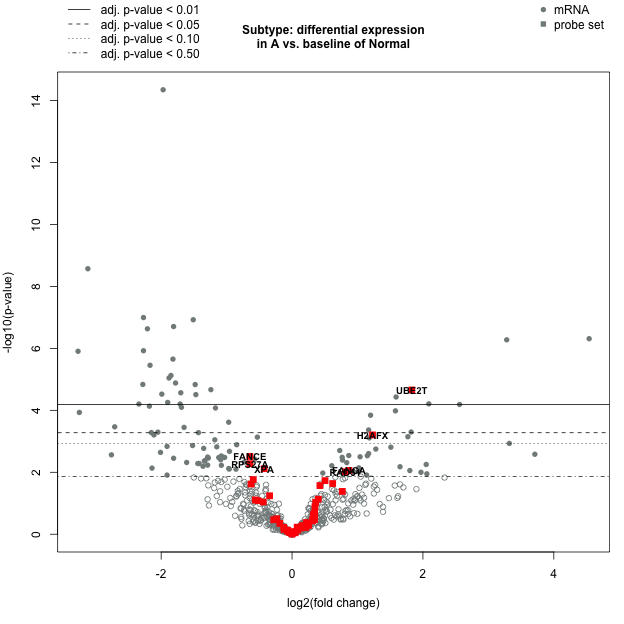
Volcano Plot: SubtypeA
Volcano plot displaying each gene's -log10(p-value) and log2 fold change for the selected covariate. Highly statistically significant genes fall at the top of the plot, and highly differentially expressed genes fall to either side. Genes within the selected gene set are highlighted in blue. Green point colors and horizontal lines indicate various False Discovery Rate (FDR) thresholds.
DE Results - DNARepair genes - SubtypeA
More Plot Information Download CSV DataProbe Label Log2 fold change std error Lower confidence limit Upper confidence limit P-value BY.p.value Gene.sets Codeset.Name Probe.Label Analyte.Type Is.Control Control.Type Probe.Annotation KEGG.Pathways Cell.Type Official.Gene.Name volcanocol volcanopch tstats.all UBE2T-mRNA 1.83 0.393 1.06 2.6 2.2e-05 0.00461 DNARepair NS_CANCERPATH_C2535 UBE2T mRNA 0 DNARepair hsa03460 UBE2T chartreuse1 16 4.65648854961832 H2AFX-mRNA 1.23 0.337 0.567 1.89 0.000621 0.0563 DNARepair NS_CANCERPATH_C2535 H2AFX mRNA 0 DNARepair hsa05034;hsa05322 H2AFX chartreuse3 16 3.64985163204748 FANCE-mRNA -0.644 0.208 -1.05 -0.237 0.00308 0.186 DNARepair NS_CANCERPATH_C2535 FANCE mRNA 0 DNARepair hsa03460 FANCE chartreuse4 16 -3.09615384615385 RPS27A-mRNA -0.643 0.221 -1.08 -0.21 0.00529 0.251 DNARepair NS_CANCERPATH_C2535 RPS27A mRNA 0 DNARepair RPS27A chartreuse4 16 -2.90950226244344 XPA-mRNA -0.426 0.153 -0.726 -0.125 0.00767 0.325 DNARepair NS_CANCERPATH_C2535 XPA mRNA 0 DNARepair hsa03420 XPA chartreuse4 16 -2.7843137254902 FANCA-mRNA 0.87 0.319 0.245 1.5 0.00869 0.353 DNARepair NS_CANCERPATH_C2535 FANCA mRNA 0 DNARepair hsa03460 FANCA chartreuse4 16 2.72727272727273 RAD51-mRNA 0.813 0.302 0.221 1.41 0.00959 0.374 DNARepair NS_CANCERPATH_C2535 RAD51 mRNA 0 DNARepair hsa03440;hsa03460;hsa05200;hsa05212 RAD51 chartreuse4 16 2.69205298013245 ALKBH2-mRNA -0.593 0.241 -1.07 -0.121 0.0173 0.567 DNARepair NS_CANCERPATH_C2535 ALKBH2 mRNA 0 DNARepair ALKBH2 azure4 1 -2.46058091286307 FANCF-mRNA 0.504 0.207 0.0976 0.91 0.0186 0.605 DNARepair NS_CANCERPATH_C2535 FANCF mRNA 0 DNARepair hsa03460 FANCF azure4 1 2.43478260869565 PRKDC-mRNA 0.621 0.265 0.101 1.14 0.0231 0.719 CC.PLS.Apop, DNARepair NS_CANCERPATH_C2535 PRKDC mRNA 0 CC.PLS.Apop;DNARepair hsa03450;hsa04110 PRKDC azure4 1 2.34339622641509 DDB2-mRNA -0.626 0.269 -1.15 -0.0987 0.0239 0.726 DNARepair NS_CANCERPATH_C2535 DDB2 mRNA 0 DNARepair hsa03420;hsa04115;hsa04120;hsa05161 DDB2 azure4 1 -2.3271375464684 UBB-mRNA 0.426 0.187 0.0594 0.794 0.0269 0.759 DNARepair NS_CANCERPATH_C2535 UBB mRNA 0 DNARepair hsa05012 UBB azure4 1 2.27807486631016 POLD4-mRNA 0.768 0.368 0.0477 1.49 0.0415 1 DNARepair NS_CANCERPATH_C2535 POLD4 mRNA 0 DNARepair hsa00230;hsa00240;hsa01100;hsa03030;hsa03410;hsa03420;hsa03430;hsa03440;hsa05166 POLD4 azure4 1 2.08695652173913 MDC1-mRNA -0.343 0.177 -0.689 0.00299 0.0574 1 DNARepair NS_CANCERPATH_C2535 MDC1 mRNA 0 DNARepair MDC1 azure4 1 -1.93785310734463 C19orf40-mRNA 0.401 0.22 -0.0296 0.832 0.0737 1 DNARepair NS_CANCERPATH_C2535 C19orf40 mRNA 0 DNARepair hsa03460 FAAP24 azure4 1 1.82272727272727 RFC3-mRNA -0.562 0.313 -1.17 0.0513 0.0783 1 DNARepair NS_CANCERPATH_C2535 RFC3 mRNA 0 DNARepair hsa03030;hsa03420;hsa03430 RFC3 azure4 1 -1.79552715654952 ALKBH3-mRNA -0.519 0.294 -1.09 0.0558 0.0826 1 DNARepair NS_CANCERPATH_C2535 ALKBH3 mRNA 0 DNARepair ALKBH3 azure4 1 -1.76530612244898 FANCL-mRNA -0.441 0.256 -0.943 0.0609 0.091 1 DNARepair NS_CANCERPATH_C2535 FANCL mRNA 0 DNARepair hsa03460;hsa04120 FANCL azure4 1 -1.72265625 ERCC2-mRNA 0.36 0.211 -0.0527 0.773 0.0933 1 DNARepair NS_CANCERPATH_C2535 ERCC2 mRNA 0 DNARepair hsa03420 ERCC2 azure4 1 1.70616113744076 POLR2H-mRNA 0.35 0.227 -0.0953 0.796 0.129 1 DNARepair NS_CANCERPATH_C2535 POLR2H mRNA 0 DNARepair hsa00230;hsa00240;hsa01100;hsa04623;hsa05016;hsa05169 POLR2H azure4 1 1.54185022026432 DE Results - DNARepair genes - SubtypeA
Table displaying each sample's global significance scores and directed global significance scores as defined in the heatmaps above. The global significance score is calculated as the square root of the mean squared t-statistic for the genes in a gene set, with t-statistics coming from the linear regression underlying our differential expression analysis. The directed global significance score is calculated as the square root of the mean signed squared t-statistic for the genes in a gene set, with t-statistics coming from the linear regression underlying our differential expression analysis.
Volcano Plot: SubtypeB
More Plot Information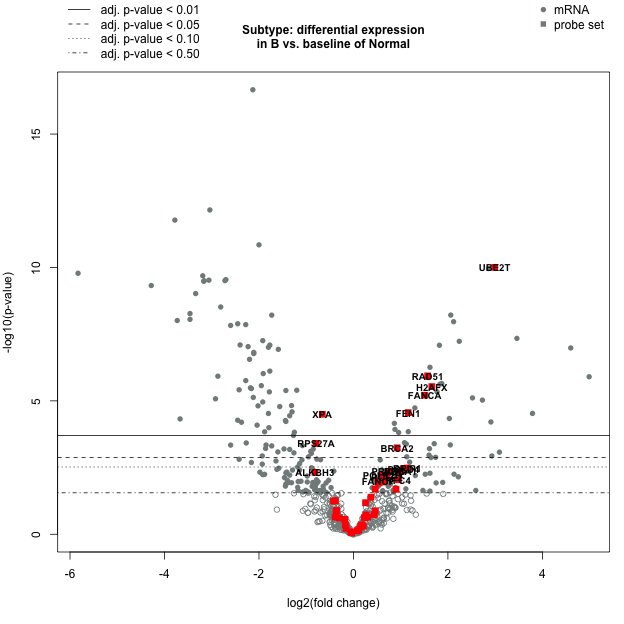
Volcano Plot: SubtypeB
Volcano plot displaying each gene's -log10(p-value) and log2 fold change for the selected covariate. Highly statistically significant genes fall at the top of the plot, and highly differentially expressed genes fall to either side. Genes within the selected gene set are highlighted in blue. Green point colors and horizontal lines indicate various False Discovery Rate (FDR) thresholds.
DE Results - DNARepair genes - SubtypeB
More Plot Information Download CSV DataProbe Label Log2 fold change std error Lower confidence limit Upper confidence limit P-value BY.p.value Gene.sets Codeset.Name Probe.Label Analyte.Type Is.Control Control.Type Probe.Annotation KEGG.Pathways Cell.Type Official.Gene.Name volcanocol volcanopch tstats.all UBE2T-mRNA 2.99 0.37 2.26 3.71 9.89e-11 7.25e-08 DNARepair NS_CANCERPATH_C2535 UBE2T mRNA 0 DNARepair hsa03460 UBE2T chartreuse1 16 8.08108108108108 RAD51-mRNA 1.57 0.285 1.01 2.13 1.16e-06 0.000109 DNARepair NS_CANCERPATH_C2535 RAD51 mRNA 0 DNARepair hsa03440;hsa03460;hsa05200;hsa05212 RAD51 chartreuse1 16 5.50877192982456 H2AFX-mRNA 1.66 0.317 1.04 2.28 2.92e-06 0.000237 DNARepair NS_CANCERPATH_C2535 H2AFX mRNA 0 DNARepair hsa05034;hsa05322 H2AFX chartreuse1 16 5.23659305993691 FANCA-mRNA 1.51 0.301 0.924 2.1 6.16e-06 0.00043 DNARepair NS_CANCERPATH_C2535 FANCA mRNA 0 DNARepair hsa03460 FANCA chartreuse1 16 5.01661129568106 FEN1-mRNA 1.16 0.252 0.666 1.66 2.76e-05 0.00162 DNARepair NS_CANCERPATH_C2535 FEN1 mRNA 0 DNARepair hsa03030;hsa03410;hsa03450 FEN1 chartreuse1 16 4.6031746031746 XPA-mRNA -0.659 0.145 -0.942 -0.375 3.18e-05 0.00178 DNARepair NS_CANCERPATH_C2535 XPA mRNA 0 DNARepair hsa03420 XPA chartreuse1 16 -4.5448275862069 RPS27A-mRNA -0.789 0.208 -1.2 -0.381 0.000393 0.0172 DNARepair NS_CANCERPATH_C2535 RPS27A mRNA 0 DNARepair RPS27A chartreuse2 16 -3.79326923076923 BRCA2-mRNA 0.925 0.252 0.431 1.42 0.000575 0.0231 DNARepair, Driver Gene NS_CANCERPATH_C2535 BRCA2 mRNA 0 DNARepair;Driver Gene hsa03440;hsa03460;hsa05200;hsa05212 BRCA2 chartreuse2 16 3.67063492063492 BRIP1-mRNA 1.14 0.37 0.415 1.87 0.0033 0.102 DNARepair NS_CANCERPATH_C2535 BRIP1 mRNA 0 DNARepair hsa03460 BRIP1 chartreuse4 16 3.08108108108108 POLD4-mRNA 1.06 0.346 0.381 1.74 0.0035 0.106 DNARepair NS_CANCERPATH_C2535 POLD4 mRNA 0 DNARepair hsa00230;hsa00240;hsa01100;hsa03030;hsa03410;hsa03420;hsa03430;hsa03440;hsa05166 POLD4 chartreuse4 16 3.0635838150289 PRKDC-mRNA 0.745 0.25 0.255 1.23 0.00437 0.124 CC.PLS.Apop, DNARepair NS_CANCERPATH_C2535 PRKDC mRNA 0 CC.PLS.Apop;DNARepair hsa03450;hsa04110 PRKDC chartreuse4 16 2.98 BRCA1-mRNA 0.995 0.334 0.341 1.65 0.00437 0.124 DNARepair, Driver Gene, PI3K NS_CANCERPATH_C2535 BRCA1 mRNA 0 PI3K;DNARepair;Driver Gene hsa03460;hsa04120;hsa04151;hsa05206 BRCA1 chartreuse4 16 2.97904191616766 ALKBH3-mRNA -0.815 0.277 -1.36 -0.273 0.00481 0.133 DNARepair NS_CANCERPATH_C2535 ALKBH3 mRNA 0 DNARepair ALKBH3 chartreuse4 16 -2.94223826714801 POLR2H-mRNA 0.612 0.214 0.192 1.03 0.00611 0.157 DNARepair NS_CANCERPATH_C2535 POLR2H mRNA 0 DNARepair hsa00230;hsa00240;hsa01100;hsa04623;hsa05016;hsa05169 POLR2H chartreuse4 16 2.85981308411215 POLE2-mRNA 0.713 0.255 0.214 1.21 0.00716 0.177 DNARepair NS_CANCERPATH_C2535 POLE2 mRNA 0 DNARepair hsa00230;hsa00240;hsa01100;hsa03030;hsa03410;hsa03420;hsa05166 POLE2 chartreuse4 16 2.79607843137255 RFC4-mRNA 0.952 0.351 0.264 1.64 0.00905 0.216 DNARepair NS_CANCERPATH_C2535 RFC4 mRNA 0 DNARepair hsa03030;hsa03420;hsa03430 RFC4 chartreuse4 16 2.71225071225071 FANCF-mRNA 0.523 0.195 0.14 0.906 0.00997 0.232 DNARepair NS_CANCERPATH_C2535 FANCF mRNA 0 DNARepair hsa03460 FANCF chartreuse4 16 2.68205128205128 NTHL1-mRNA 0.635 0.241 0.163 1.11 0.011 0.247 DNARepair NS_CANCERPATH_C2535 NTHL1 mRNA 0 DNARepair hsa03410 NTHL1 chartreuse4 16 2.63485477178423 C19orf40-mRNA 0.54 0.207 0.134 0.946 0.0119 0.256 DNARepair NS_CANCERPATH_C2535 C19orf40 mRNA 0 DNARepair hsa03460 FAAP24 chartreuse4 16 2.60869565217391 XRCC4-mRNA 0.462 0.193 0.0832 0.84 0.0205 0.401 DNARepair NS_CANCERPATH_C2535 XRCC4 mRNA 0 DNARepair hsa03450 XRCC4 chartreuse4 16 2.39378238341969 DE Results - DNARepair genes - SubtypeB
Table displaying each sample's global significance scores and directed global significance scores as defined in the heatmaps above. The global significance score is calculated as the square root of the mean squared t-statistic for the genes in a gene set, with t-statistics coming from the linear regression underlying our differential expression analysis. The directed global significance score is calculated as the square root of the mean signed squared t-statistic for the genes in a gene set, with t-statistics coming from the linear regression underlying our differential expression analysis.
Volcano Plot: SubtypeC
More Plot Information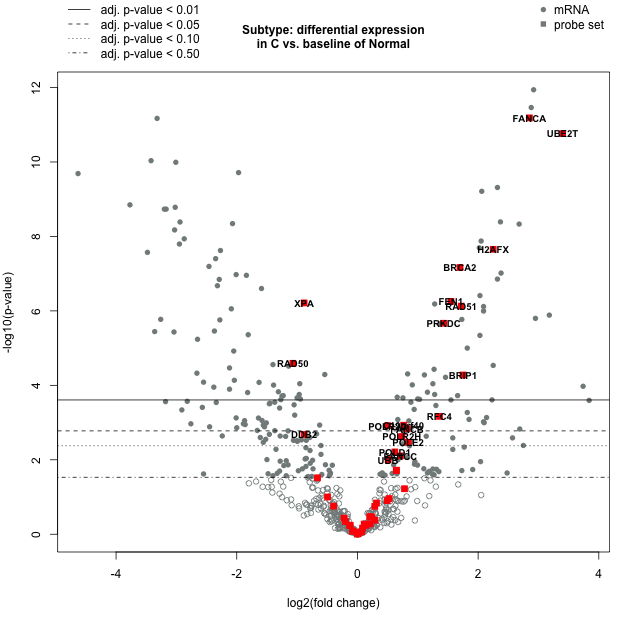
Volcano Plot: SubtypeC
Volcano plot displaying each gene's -log10(p-value) and log2 fold change for the selected covariate. Highly statistically significant genes fall at the top of the plot, and highly differentially expressed genes fall to either side. Genes within the selected gene set are highlighted in blue. Green point colors and horizontal lines indicate various False Discovery Rate (FDR) thresholds.
DE Results - DNARepair genes - SubtypeC
More Plot Information Download CSV DataProbe Label Log2 fold change std error Lower confidence limit Upper confidence limit P-value BY.p.value Gene.sets Codeset.Name Probe.Label Analyte.Type Is.Control Control.Type Probe.Annotation KEGG.Pathways Cell.Type Official.Gene.Name volcanocol volcanopch tstats.all FANCA-mRNA 2.85 0.323 2.22 3.49 6.54e-12 6.71e-09 DNARepair NS_CANCERPATH_C2535 FANCA mRNA 0 DNARepair hsa03460 FANCA chartreuse1 16 8.82352941176471 UBE2T-mRNA 3.4 0.398 2.62 4.18 1.73e-11 1.38e-08 DNARepair NS_CANCERPATH_C2535 UBE2T mRNA 0 DNARepair hsa03460 UBE2T chartreuse1 16 8.5427135678392 H2AFX-mRNA 2.25 0.341 1.58 2.92 2.22e-08 3.53e-06 DNARepair NS_CANCERPATH_C2535 H2AFX mRNA 0 DNARepair hsa05034;hsa05322 H2AFX chartreuse1 16 6.59824046920821 BRCA2-mRNA 1.7 0.271 1.17 2.24 6.83e-08 9.06e-06 DNARepair, Driver Gene NS_CANCERPATH_C2535 BRCA2 mRNA 0 DNARepair;Driver Gene hsa03440;hsa03460;hsa05200;hsa05212 BRCA2 chartreuse1 16 6.27306273062731 FEN1-mRNA 1.55 0.271 1.02 2.08 5.57e-07 5.68e-05 DNARepair NS_CANCERPATH_C2535 FEN1 mRNA 0 DNARepair hsa03030;hsa03410;hsa03450 FEN1 chartreuse1 16 5.71955719557196 XPA-mRNA -0.883 0.155 -1.19 -0.579 6.11e-07 6.08e-05 DNARepair NS_CANCERPATH_C2535 XPA mRNA 0 DNARepair hsa03420 XPA chartreuse1 16 -5.69677419354839 RAD51-mRNA 1.72 0.306 1.12 2.32 7.44e-07 7.05e-05 DNARepair NS_CANCERPATH_C2535 RAD51 mRNA 0 DNARepair hsa03440;hsa03460;hsa05200;hsa05212 RAD51 chartreuse1 16 5.62091503267974 PRKDC-mRNA 1.43 0.269 0.906 1.96 2.15e-06 0.000168 CC.PLS.Apop, DNARepair NS_CANCERPATH_C2535 PRKDC mRNA 0 CC.PLS.Apop;DNARepair hsa03450;hsa04110 PRKDC chartreuse1 16 5.31598513011152 RAD50-mRNA -1.07 0.232 -1.53 -0.618 2.56e-05 0.00167 DNARepair NS_CANCERPATH_C2535 RAD50 mRNA 0 DNARepair hsa03440;hsa03450 RAD50 chartreuse1 16 -4.61206896551724 BRIP1-mRNA 1.75 0.398 0.974 2.53 5.27e-05 0.00295 DNARepair NS_CANCERPATH_C2535 BRIP1 mRNA 0 DNARepair hsa03460 BRIP1 chartreuse1 16 4.39698492462312 RFC4-mRNA 1.36 0.378 0.624 2.1 0.000683 0.0234 DNARepair NS_CANCERPATH_C2535 RFC4 mRNA 0 DNARepair hsa03030;hsa03420;hsa03430 RFC4 chartreuse2 16 3.5978835978836 C19orf40-mRNA 0.765 0.223 0.328 1.2 0.00118 0.0352 DNARepair NS_CANCERPATH_C2535 C19orf40 mRNA 0 DNARepair hsa03460 FAAP24 chartreuse2 16 3.4304932735426 POLR2D-mRNA 0.503 0.147 0.215 0.791 0.00121 0.0358 DNARepair NS_CANCERPATH_C2535 POLR2D mRNA 0 DNARepair hsa00230;hsa00240;hsa01100;hsa05016;hsa05169 POLR2D chartreuse2 16 3.42176870748299 FANCB-mRNA 0.823 0.245 0.343 1.3 0.00147 0.042 DNARepair NS_CANCERPATH_C2535 FANCB mRNA 0 DNARepair hsa03460 FANCB chartreuse2 16 3.35918367346939 DDB2-mRNA -0.883 0.273 -1.42 -0.349 0.00209 0.0561 DNARepair NS_CANCERPATH_C2535 DDB2 mRNA 0 DNARepair hsa03420;hsa04115;hsa04120;hsa05161 DDB2 chartreuse3 16 -3.23443223443223 POLR2H-mRNA 0.736 0.23 0.285 1.19 0.00237 0.0613 DNARepair NS_CANCERPATH_C2535 POLR2H mRNA 0 DNARepair hsa00230;hsa00240;hsa01100;hsa04623;hsa05016;hsa05169 POLR2H chartreuse3 16 3.2 POLE2-mRNA 0.841 0.274 0.304 1.38 0.00341 0.0809 DNARepair NS_CANCERPATH_C2535 POLE2 mRNA 0 DNARepair hsa00230;hsa00240;hsa01100;hsa03030;hsa03410;hsa03420;hsa05166 POLE2 chartreuse3 16 3.06934306569343 POLD1-mRNA 0.62 0.217 0.195 1.05 0.00615 0.138 DNARepair NS_CANCERPATH_C2535 POLD1 mRNA 0 DNARepair hsa00230;hsa00240;hsa01100;hsa03030;hsa03410;hsa03420;hsa03430;hsa03440;hsa05166 POLD1 chartreuse4 16 2.85714285714286 FANCC-mRNA 0.713 0.258 0.208 1.22 0.00785 0.173 DNARepair NS_CANCERPATH_C2535 FANCC mRNA 0 DNARepair hsa03460 FANCC chartreuse4 16 2.76356589147287 UBB-mRNA 0.508 0.19 0.136 0.88 0.00992 0.211 DNARepair NS_CANCERPATH_C2535 UBB mRNA 0 DNARepair hsa05012 UBB chartreuse4 16 2.67368421052632 DE Results - DNARepair genes - SubtypeC
Table displaying each sample's global significance scores and directed global significance scores as defined in the heatmaps above. The global significance score is calculated as the square root of the mean squared t-statistic for the genes in a gene set, with t-statistics coming from the linear regression underlying our differential expression analysis. The directed global significance score is calculated as the square root of the mean signed squared t-statistic for the genes in a gene set, with t-statistics coming from the linear regression underlying our differential expression analysis.
Volcano Plot: SubtypeD
More Plot Information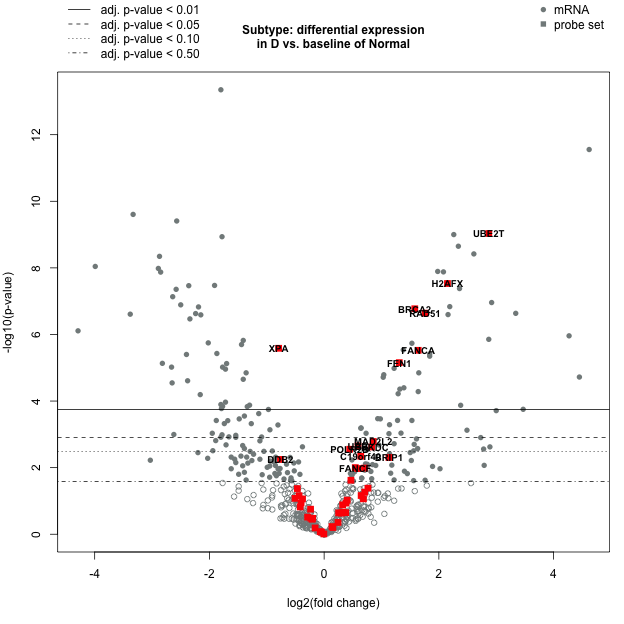
Volcano Plot: SubtypeD
Volcano plot displaying each gene's -log10(p-value) and log2 fold change for the selected covariate. Highly statistically significant genes fall at the top of the plot, and highly differentially expressed genes fall to either side. Genes within the selected gene set are highlighted in blue. Green point colors and horizontal lines indicate various False Discovery Rate (FDR) thresholds.
DE Results - DNARepair genes - SubtypeD
More Plot Information Download CSV DataProbe Label Log2 fold change std error Lower confidence limit Upper confidence limit P-value BY.p.value Gene.sets Codeset.Name Probe.Label Analyte.Type Is.Control Control.Type Probe.Annotation KEGG.Pathways Cell.Type Official.Gene.Name volcanocol volcanopch tstats.all UBE2T-mRNA 2.87 0.385 2.11 3.62 9.29e-10 6.58e-07 DNARepair NS_CANCERPATH_C2535 UBE2T mRNA 0 DNARepair hsa03460 UBE2T chartreuse1 16 7.45454545454546 H2AFX-mRNA 2.15 0.33 1.5 2.79 2.95e-08 7.32e-06 DNARepair NS_CANCERPATH_C2535 H2AFX mRNA 0 DNARepair hsa05034;hsa05322 H2AFX chartreuse1 16 6.51515151515151 BRCA2-mRNA 1.58 0.262 1.07 2.1 1.69e-07 2.58e-05 DNARepair, Driver Gene NS_CANCERPATH_C2535 BRCA2 mRNA 0 DNARepair;Driver Gene hsa03440;hsa03460;hsa05200;hsa05212 BRCA2 chartreuse1 16 6.03053435114504 RAD51-mRNA 1.76 0.296 1.18 2.34 2.29e-07 3.21e-05 DNARepair NS_CANCERPATH_C2535 RAD51 mRNA 0 DNARepair hsa03440;hsa03460;hsa05200;hsa05212 RAD51 chartreuse1 16 5.94594594594595 XPA-mRNA -0.793 0.15 -1.09 -0.498 2.6e-06 0.000253 DNARepair NS_CANCERPATH_C2535 XPA mRNA 0 DNARepair hsa03420 XPA chartreuse1 16 -5.28666666666667 FANCA-mRNA 1.64 0.313 1.02 2.25 2.99e-06 0.000276 DNARepair NS_CANCERPATH_C2535 FANCA mRNA 0 DNARepair hsa03460 FANCA chartreuse1 16 5.23961661341853 FEN1-mRNA 1.31 0.262 0.796 1.82 7.02e-06 0.000582 DNARepair NS_CANCERPATH_C2535 FEN1 mRNA 0 DNARepair hsa03030;hsa03410;hsa03450 FEN1 chartreuse1 16 5 MAD2L2-mRNA 0.857 0.258 0.351 1.36 0.00164 0.0589 CC.PLS.Apop, DNARepair NS_CANCERPATH_C2535 MAD2L2 mRNA 0 CC.PLS.Apop;DNARepair hsa04110;hsa04114;hsa04914;hsa05100;hsa05131 MAD2L2 chartreuse3 16 3.32170542635659 UBB-mRNA 0.59 0.183 0.231 0.95 0.00222 0.0755 DNARepair NS_CANCERPATH_C2535 UBB mRNA 0 DNARepair hsa05012 UBB chartreuse3 16 3.22404371584699 PRKDC-mRNA 0.829 0.26 0.32 1.34 0.00239 0.0793 CC.PLS.Apop, DNARepair NS_CANCERPATH_C2535 PRKDC mRNA 0 CC.PLS.Apop;DNARepair hsa03450;hsa04110 PRKDC chartreuse3 16 3.18846153846154 POLR2D-mRNA 0.446 0.142 0.167 0.724 0.0028 0.0899 DNARepair NS_CANCERPATH_C2535 POLR2D mRNA 0 DNARepair hsa00230;hsa00240;hsa01100;hsa05016;hsa05169 POLR2D chartreuse3 16 3.14084507042254 C19orf40-mRNA 0.639 0.215 0.217 1.06 0.00455 0.133 DNARepair NS_CANCERPATH_C2535 C19orf40 mRNA 0 DNARepair hsa03460 FAAP24 chartreuse4 16 2.97209302325581 BRIP1-mRNA 1.13 0.385 0.375 1.88 0.00495 0.14 DNARepair NS_CANCERPATH_C2535 BRIP1 mRNA 0 DNARepair hsa03460 BRIP1 chartreuse4 16 2.93506493506493 DDB2-mRNA -0.761 0.264 -1.28 -0.244 0.00567 0.154 DNARepair NS_CANCERPATH_C2535 DDB2 mRNA 0 DNARepair hsa03420;hsa04115;hsa04120;hsa05161 DDB2 chartreuse4 16 -2.88257575757576 FANCF-mRNA 0.543 0.203 0.145 0.941 0.00997 0.232 DNARepair NS_CANCERPATH_C2535 FANCF mRNA 0 DNARepair hsa03460 FANCF chartreuse4 16 2.67487684729064 POLE2-mRNA 0.705 0.265 0.186 1.22 0.0103 0.237 DNARepair NS_CANCERPATH_C2535 POLE2 mRNA 0 DNARepair hsa00230;hsa00240;hsa01100;hsa03030;hsa03410;hsa03420;hsa05166 POLE2 chartreuse4 16 2.66037735849057 POLR2H-mRNA 0.589 0.223 0.153 1.03 0.0107 0.244 DNARepair NS_CANCERPATH_C2535 POLR2H mRNA 0 DNARepair hsa00230;hsa00240;hsa01100;hsa04623;hsa05016;hsa05169 POLR2H chartreuse4 16 2.64125560538117 XRCC4-mRNA 0.467 0.201 0.0736 0.861 0.0239 0.462 DNARepair NS_CANCERPATH_C2535 XRCC4 mRNA 0 DNARepair hsa03450 XRCC4 chartreuse4 16 2.32338308457711 RFC4-mRNA 0.764 0.365 0.0484 1.48 0.0413 0.723 DNARepair NS_CANCERPATH_C2535 RFC4 mRNA 0 DNARepair hsa03030;hsa03420;hsa03430 RFC4 azure4 1 2.09315068493151 RAD50-mRNA -0.467 0.224 -0.906 -0.0268 0.0425 0.733 DNARepair NS_CANCERPATH_C2535 RAD50 mRNA 0 DNARepair hsa03440;hsa03450 RAD50 azure4 1 -2.08482142857143 DE Results - DNARepair genes - SubtypeD
Table displaying each sample's global significance scores and directed global significance scores as defined in the heatmaps above. The global significance score is calculated as the square root of the mean squared t-statistic for the genes in a gene set, with t-statistics coming from the linear regression underlying our differential expression analysis. The directed global significance score is calculated as the square root of the mean signed squared t-statistic for the genes in a gene set, with t-statistics coming from the linear regression underlying our differential expression analysis.
- Subtype:
- SubtypeA
- SubtypeB
- SubtypeC
- SubtypeD
Volcano Plot: SubtypeA
More Plot Information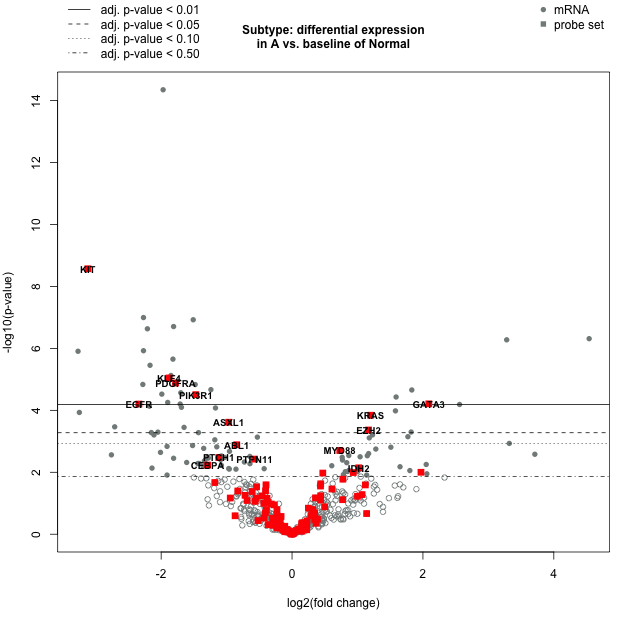
Volcano Plot: SubtypeA
Volcano plot displaying each gene's -log10(p-value) and log2 fold change for the selected covariate. Highly statistically significant genes fall at the top of the plot, and highly differentially expressed genes fall to either side. Genes within the selected gene set are highlighted in blue. Green point colors and horizontal lines indicate various False Discovery Rate (FDR) thresholds.
DE Results - Driver Gene genes - SubtypeA
More Plot Information Download CSV DataProbe Label Log2 fold change std error Lower confidence limit Upper confidence limit P-value BY.p.value Gene.sets Codeset.Name Probe.Label Analyte.Type Is.Control Control.Type Probe.Annotation KEGG.Pathways Cell.Type Official.Gene.Name volcanocol volcanopch tstats.all KIT-mRNA -3.12 0.436 -3.98 -2.27 2.68e-09 5.33e-06 Driver Gene, PI3K, RAS NS_CANCERPATH_C2535 KIT mRNA 0 RAS;PI3K;Driver Gene hsa04014;hsa04015;hsa04060;hsa04072;hsa04144;hsa04151;hsa04640;hsa04916;hsa05200;hsa05221;hsa05230 KIT chartreuse1 16 -7.15596330275229 KLF4-mRNA -1.88 0.383 -2.63 -1.13 9.02e-06 0.00256 Driver Gene NS_CANCERPATH_C2535 KLF4 mRNA 0 Driver Gene hsa04550 KLF4 chartreuse1 16 -4.90861618798956 PDGFRA-mRNA -1.78 0.369 -2.5 -1.05 1.31e-05 0.00345 Driver Gene, MAPK, PI3K, RAS NS_CANCERPATH_C2535 PDGFRA mRNA 0 RAS;PI3K;MAPK;Driver Gene hsa04010;hsa04014;hsa04015;hsa04020;hsa04060;hsa04072;hsa04144;hsa04151;hsa04510;hsa04540;hsa04810;hsa05166;hsa05200;hsa05206;hsa05214;hsa05215;hsa05218;hsa05230;hsa05231 PDGFRA chartreuse1 16 -4.82384823848238 PIK3R1-mRNA -1.47 0.322 -2.1 -0.838 3.11e-05 0.00562 CC.PLS.Apop, Driver Gene, JAK-STAT, PI3K, RAS NS_CANCERPATH_C2535 PIK3R1 mRNA 0 CC.PLS.Apop;RAS;PI3K;JAK-STAT;Driver Gene hsa04012;hsa04014;hsa04015;hsa04022;hsa04024;hsa04062;hsa04066;hsa04068;hsa04070;hsa04071;hsa04072;hsa04150;hsa04151;hsa04152;hsa04210;hsa04211;hsa04261;hsa04370;hsa04380;hsa04510;hsa04550;hsa04611;hsa04620;hsa04630;hsa04650;hsa04660;hsa04662;hsa04664;hsa04666;hsa04668;hsa04670;hsa04722;hsa04725;hsa04750;hsa04810;hsa04910;hsa04914;hsa04915;hsa04917;hsa04919;hsa04921;hsa04923;hsa04930;hsa04931;hsa04932;hsa04933;hsa04960;hsa04973;hsa05100;hsa05142;hsa05145;hsa05146;hsa05160;hsa05161;hsa05162;hsa05164;hsa05166;hsa05169;hsa05200;hsa05203;hsa05205;hsa05210;hsa05211;hsa05212;hsa05213;hsa05214;hsa05215;hsa05218;hsa05220;hsa05221;hsa05222;hsa05223;hsa05230;hsa05231 PIK3R1 chartreuse1 16 -4.56521739130435 GATA3-mRNA 2.09 0.479 1.15 3.03 6.17e-05 0.0092 Driver Gene NS_CANCERPATH_C2535 GATA3 mRNA 0 Driver Gene hsa05321 GATA3 chartreuse1 16 4.36325678496868 EGFR-mRNA -2.34 0.537 -3.39 -1.29 6.27e-05 0.0092 Driver Gene, MAPK, PI3K, RAS NS_CANCERPATH_C2535 EGFR mRNA 0 RAS;PI3K;MAPK;Driver Gene hsa04010;hsa04012;hsa04014;hsa04015;hsa04020;hsa04060;hsa04066;hsa04068;hsa04072;hsa04144;hsa04151;hsa04320;hsa04510;hsa04520;hsa04540;hsa04810;hsa04912;hsa04915;hsa04921;hsa05120;hsa05160;hsa05200;hsa05205;hsa05206;hsa05212;hsa05213;hsa05214;hsa05215;hsa05218;hsa05219;hsa05223;hsa05230;hsa05231 EGFR chartreuse1 16 -4.35754189944134 KRAS-mRNA 1.2 0.292 0.625 1.77 0.000144 0.0168 Driver Gene, MAPK, PI3K, RAS NS_CANCERPATH_C2535 KRAS mRNA 0 RAS;PI3K;MAPK;Driver Gene hsa04010;hsa04012;hsa04014;hsa04015;hsa04062;hsa04068;hsa04071;hsa04072;hsa04151;hsa04211;hsa04320;hsa04360;hsa04370;hsa04530;hsa04540;hsa04550;hsa04650;hsa04660;hsa04662;hsa04664;hsa04720;hsa04722;hsa04725;hsa04726;hsa04730;hsa04810;hsa04910;hsa04912;hsa04914;hsa04915;hsa04916;hsa04917;hsa04919;hsa04921;hsa04933;hsa04960;hsa05034;hsa05160;hsa05161;hsa05166;hsa05200;hsa05203;hsa05205;hsa05206;hsa05210;hsa05211;hsa05212;hsa05213;hsa05214;hsa05215;hsa05216;hsa05218;hsa05219;hsa05220;hsa05221;hsa05223;hsa05230;hsa05231 KRAS chartreuse2 16 4.10958904109589 ASXL1-mRNA -0.968 0.246 -1.45 -0.487 0.000242 0.0275 Driver Gene NS_CANCERPATH_C2535 ASXL1 mRNA 0 Driver Gene ASXL1 chartreuse2 16 -3.9349593495935 EZH2-mRNA 1.17 0.31 0.558 1.77 0.000431 0.0451 Driver Gene NS_CANCERPATH_C2535 EZH2 mRNA 0 Driver Gene hsa05206 EZH2 chartreuse2 16 3.7741935483871 ABL1-mRNA -0.846 0.249 -1.33 -0.359 0.00129 0.103 CC.PLS.Apop, Driver Gene, RAS NS_CANCERPATH_C2535 ABL1 mRNA 0 CC.PLS.Apop;RAS;Driver Gene hsa04012;hsa04014;hsa04110;hsa04360;hsa04722;hsa05130;hsa05131;hsa05200;hsa05206;hsa05220;hsa05416 ABL1 chartreuse4 16 -3.39759036144578 MYD88-mRNA 0.729 0.224 0.29 1.17 0.00198 0.138 CC.PLS.Apop, Driver Gene NS_CANCERPATH_C2535 MYD88 mRNA 0 CC.PLS.Apop;Driver Gene hsa04064;hsa04210;hsa04620;hsa05132;hsa05133;hsa05134;hsa05140;hsa05142;hsa05143;hsa05144;hsa05145;hsa05152;hsa05161;hsa05162;hsa05164;hsa05168 MYD88 chartreuse4 16 3.25446428571429 PTCH1-mRNA -1.12 0.365 -1.84 -0.408 0.00334 0.187 Driver Gene, HH NS_CANCERPATH_C2535 PTCH1 mRNA 0 HH;Driver Gene hsa04024;hsa04340;hsa05200;hsa05205;hsa05217 PTCH1 chartreuse4 16 -3.06849315068493 PTPN11-mRNA -0.572 0.189 -0.942 -0.203 0.00375 0.202 Driver Gene, JAK-STAT, RAS NS_CANCERPATH_C2535 PTPN11 mRNA 0 RAS;JAK-STAT;Driver Gene hsa04014;hsa04072;hsa04630;hsa04650;hsa04670;hsa04722;hsa04920;hsa04931;hsa05120;hsa05168;hsa05205;hsa05211;hsa05220 PTPN11 chartreuse4 16 -3.02645502645503 CEBPA-mRNA -1.29 0.448 -2.17 -0.409 0.00586 0.271 Driver Gene, TXmisReg NS_CANCERPATH_C2535 CEBPA mRNA 0 TXmisReg;Driver Gene hsa04932;hsa05200;hsa05202;hsa05221 CEBPA chartreuse4 16 -2.87946428571429 IDH2-mRNA 1.02 0.363 0.305 1.73 0.00716 0.313 Driver Gene NS_CANCERPATH_C2535 IDH2 mRNA 0 Driver Gene hsa01100 IDH2 chartreuse4 16 2.8099173553719 RET-mRNA 1.97 0.739 0.527 3.42 0.01 0.387 Driver Gene NS_CANCERPATH_C2535 RET mRNA 0 Driver Gene hsa04144;hsa05200;hsa05216;hsa05230 RET chartreuse4 16 2.66576454668471 RUNX1-mRNA 0.936 0.351 0.248 1.62 0.0102 0.391 Driver Gene, TXmisReg NS_CANCERPATH_C2535 RUNX1 mRNA 0 TXmisReg;Driver Gene hsa05200;hsa05202;hsa05220;hsa05221 RUNX1 chartreuse4 16 2.66666666666667 BCOR-mRNA 0.47 0.177 0.122 0.817 0.0106 0.402 Driver Gene NS_CANCERPATH_C2535 BCOR mRNA 0 Driver Gene BCOR chartreuse4 16 2.65536723163842 AKT1-mRNA 0.777 0.314 0.161 1.39 0.0167 0.559 CC.PLS.Apop, Driver Gene, JAK-STAT, MAPK, PI3K, RAS NS_CANCERPATH_C2535 AKT1 mRNA 0 CC.PLS.Apop;RAS;PI3K;JAK-STAT;MAPK;Driver Gene hsa04010;hsa04012;hsa04014;hsa04015;hsa04022;hsa04024;hsa04062;hsa04066;hsa04068;hsa04071;hsa04072;hsa04150;hsa04151;hsa04152;hsa04210;hsa04211;hsa04261;hsa04370;hsa04380;hsa04510;hsa04530;hsa04550;hsa04611;hsa04620;hsa04630;hsa04660;hsa04662;hsa04664;hsa04666;hsa04668;hsa04722;hsa04725;hsa04728;hsa04910;hsa04914;hsa04915;hsa04917;hsa04919;hsa04920;hsa04922;hsa04923;hsa04931;hsa04932;hsa04933;hsa04973;hsa05142;hsa05145;hsa05152;hsa05160;hsa05161;hsa05162;hsa05164;hsa05166;hsa05169;hsa05200;hsa05205;hsa05210;hsa05211;hsa05212;hsa05213;hsa05214;hsa05215;hsa05218;hsa05220;hsa05221;hsa05222;hsa05223;hsa05230;hsa05231 AKT1 azure4 1 2.47452229299363 MET-mRNA -1.18 0.498 -2.16 -0.205 0.0214 0.671 Driver Gene, PI3K, RAS, TXmisReg NS_CANCERPATH_C2535 MET mRNA 0 RAS;PI3K;TXmisReg;Driver Gene hsa04014;hsa04015;hsa04060;hsa04144;hsa04151;hsa04360;hsa04510;hsa04520;hsa05100;hsa05120;hsa05144;hsa05200;hsa05202;hsa05205;hsa05206;hsa05211;hsa05218;hsa05230 MET azure4 1 -2.36947791164659 DE Results - Driver Gene genes - SubtypeA
Table displaying each sample's global significance scores and directed global significance scores as defined in the heatmaps above. The global significance score is calculated as the square root of the mean squared t-statistic for the genes in a gene set, with t-statistics coming from the linear regression underlying our differential expression analysis. The directed global significance score is calculated as the square root of the mean signed squared t-statistic for the genes in a gene set, with t-statistics coming from the linear regression underlying our differential expression analysis.
Volcano Plot: SubtypeB
More Plot Information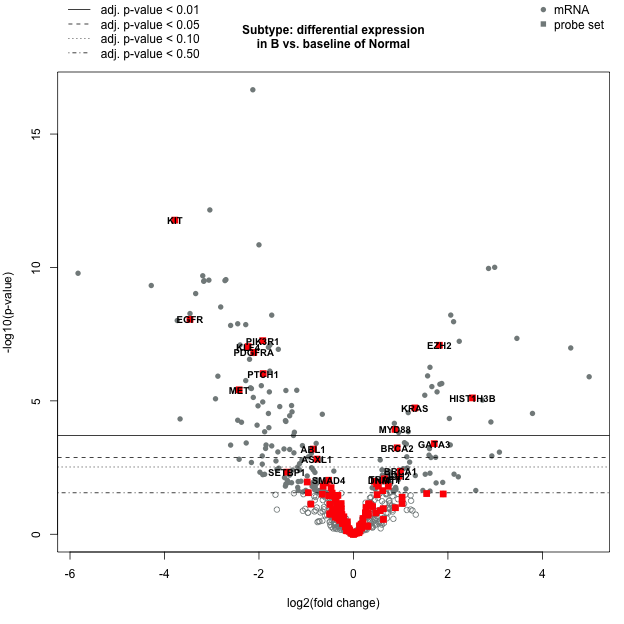
Volcano Plot: SubtypeB
Volcano plot displaying each gene's -log10(p-value) and log2 fold change for the selected covariate. Highly statistically significant genes fall at the top of the plot, and highly differentially expressed genes fall to either side. Genes within the selected gene set are highlighted in blue. Green point colors and horizontal lines indicate various False Discovery Rate (FDR) thresholds.
DE Results - Driver Gene genes - SubtypeB
More Plot Information Download CSV DataProbe Label Log2 fold change std error Lower confidence limit Upper confidence limit P-value BY.p.value Gene.sets Codeset.Name Probe.Label Analyte.Type Is.Control Control.Type Probe.Annotation KEGG.Pathways Cell.Type Official.Gene.Name volcanocol volcanopch tstats.all KIT-mRNA -3.78 0.41 -4.58 -2.97 1.68e-12 2.22e-09 Driver Gene, PI3K, RAS NS_CANCERPATH_C2535 KIT mRNA 0 RAS;PI3K;Driver Gene hsa04014;hsa04015;hsa04060;hsa04072;hsa04144;hsa04151;hsa04640;hsa04916;hsa05200;hsa05221;hsa05230 KIT chartreuse1 16 -9.21951219512195 EGFR-mRNA -3.46 0.506 -4.46 -2.47 8.82e-09 1.75e-06 Driver Gene, MAPK, PI3K, RAS NS_CANCERPATH_C2535 EGFR mRNA 0 RAS;PI3K;MAPK;Driver Gene hsa04010;hsa04012;hsa04014;hsa04015;hsa04020;hsa04060;hsa04066;hsa04068;hsa04072;hsa04144;hsa04151;hsa04320;hsa04510;hsa04520;hsa04540;hsa04810;hsa04912;hsa04915;hsa04921;hsa05120;hsa05160;hsa05200;hsa05205;hsa05206;hsa05212;hsa05213;hsa05214;hsa05215;hsa05218;hsa05219;hsa05223;hsa05230;hsa05231 EGFR chartreuse1 16 -6.83794466403162 PIK3R1-mRNA -1.92 0.303 -2.52 -1.33 5.54e-08 8.16e-06 CC.PLS.Apop, Driver Gene, JAK-STAT, PI3K, RAS NS_CANCERPATH_C2535 PIK3R1 mRNA 0 CC.PLS.Apop;RAS;PI3K;JAK-STAT;Driver Gene hsa04012;hsa04014;hsa04015;hsa04022;hsa04024;hsa04062;hsa04066;hsa04068;hsa04070;hsa04071;hsa04072;hsa04150;hsa04151;hsa04152;hsa04210;hsa04211;hsa04261;hsa04370;hsa04380;hsa04510;hsa04550;hsa04611;hsa04620;hsa04630;hsa04650;hsa04660;hsa04662;hsa04664;hsa04666;hsa04668;hsa04670;hsa04722;hsa04725;hsa04750;hsa04810;hsa04910;hsa04914;hsa04915;hsa04917;hsa04919;hsa04921;hsa04923;hsa04930;hsa04931;hsa04932;hsa04933;hsa04960;hsa04973;hsa05100;hsa05142;hsa05145;hsa05146;hsa05160;hsa05161;hsa05162;hsa05164;hsa05166;hsa05169;hsa05200;hsa05203;hsa05205;hsa05210;hsa05211;hsa05212;hsa05213;hsa05214;hsa05215;hsa05218;hsa05220;hsa05221;hsa05222;hsa05223;hsa05230;hsa05231 PIK3R1 chartreuse1 16 -6.33663366336634 EZH2-mRNA 1.82 0.292 1.25 2.39 8.24e-08 1.06e-05 Driver Gene NS_CANCERPATH_C2535 EZH2 mRNA 0 Driver Gene hsa05206 EZH2 chartreuse1 16 6.23287671232877 KLF4-mRNA -2.23 0.36 -2.94 -1.53 9.26e-08 1.15e-05 Driver Gene NS_CANCERPATH_C2535 KLF4 mRNA 0 Driver Gene hsa04550 KLF4 chartreuse1 16 -6.19444444444444 PDGFRA-mRNA -2.11 0.348 -2.79 -1.43 1.53e-07 1.69e-05 Driver Gene, MAPK, PI3K, RAS NS_CANCERPATH_C2535 PDGFRA mRNA 0 RAS;PI3K;MAPK;Driver Gene hsa04010;hsa04014;hsa04015;hsa04020;hsa04060;hsa04072;hsa04144;hsa04151;hsa04510;hsa04540;hsa04810;hsa05166;hsa05200;hsa05206;hsa05214;hsa05215;hsa05218;hsa05230;hsa05231 PDGFRA chartreuse1 16 -6.0632183908046 PTCH1-mRNA -1.91 0.344 -2.59 -1.24 9.52e-07 9.24e-05 Driver Gene, HH NS_CANCERPATH_C2535 PTCH1 mRNA 0 HH;Driver Gene hsa04024;hsa04340;hsa05200;hsa05205;hsa05217 PTCH1 chartreuse1 16 -5.55232558139535 MET-mRNA -2.42 0.469 -3.34 -1.5 3.85e-06 0.000295 Driver Gene, PI3K, RAS, TXmisReg NS_CANCERPATH_C2535 MET mRNA 0 RAS;PI3K;TXmisReg;Driver Gene hsa04014;hsa04015;hsa04060;hsa04144;hsa04151;hsa04360;hsa04510;hsa04520;hsa05100;hsa05120;hsa05144;hsa05200;hsa05202;hsa05205;hsa05206;hsa05211;hsa05218;hsa05230 MET chartreuse1 16 -5.15991471215352 HIST1H3B-mRNA 2.52 0.507 1.52 3.51 7.75e-06 0.000522 Driver Gene, TXmisReg NS_CANCERPATH_C2535 HIST1H3B mRNA 0 TXmisReg;Driver Gene hsa05034;hsa05202;hsa05322 HIST1H3B chartreuse1 16 4.97041420118343 KRAS-mRNA 1.3 0.275 0.757 1.83 1.84e-05 0.00111 Driver Gene, MAPK, PI3K, RAS NS_CANCERPATH_C2535 KRAS mRNA 0 RAS;PI3K;MAPK;Driver Gene hsa04010;hsa04012;hsa04014;hsa04015;hsa04062;hsa04068;hsa04071;hsa04072;hsa04151;hsa04211;hsa04320;hsa04360;hsa04370;hsa04530;hsa04540;hsa04550;hsa04650;hsa04660;hsa04662;hsa04664;hsa04720;hsa04722;hsa04725;hsa04726;hsa04730;hsa04810;hsa04910;hsa04912;hsa04914;hsa04915;hsa04916;hsa04917;hsa04919;hsa04921;hsa04933;hsa04960;hsa05034;hsa05160;hsa05161;hsa05166;hsa05200;hsa05203;hsa05205;hsa05206;hsa05210;hsa05211;hsa05212;hsa05213;hsa05214;hsa05215;hsa05216;hsa05218;hsa05219;hsa05220;hsa05221;hsa05223;hsa05230;hsa05231 KRAS chartreuse1 16 4.72727272727273 MYD88-mRNA 0.879 0.211 0.465 1.29 0.000117 0.00559 CC.PLS.Apop, Driver Gene NS_CANCERPATH_C2535 MYD88 mRNA 0 CC.PLS.Apop;Driver Gene hsa04064;hsa04210;hsa04620;hsa05132;hsa05133;hsa05134;hsa05140;hsa05142;hsa05143;hsa05144;hsa05145;hsa05152;hsa05161;hsa05162;hsa05164;hsa05168 MYD88 chartreuse1 16 4.16587677725119 GATA3-mRNA 1.71 0.451 0.823 2.59 0.000403 0.0174 Driver Gene NS_CANCERPATH_C2535 GATA3 mRNA 0 Driver Gene hsa05321 GATA3 chartreuse2 16 3.79157427937916 BRCA2-mRNA 0.925 0.252 0.431 1.42 0.000575 0.0231 DNARepair, Driver Gene NS_CANCERPATH_C2535 BRCA2 mRNA 0 DNARepair;Driver Gene hsa03440;hsa03460;hsa05200;hsa05212 BRCA2 chartreuse2 16 3.67063492063492 ABL1-mRNA -0.851 0.234 -1.31 -0.392 0.000641 0.0247 CC.PLS.Apop, Driver Gene, RAS NS_CANCERPATH_C2535 ABL1 mRNA 0 CC.PLS.Apop;RAS;Driver Gene hsa04012;hsa04014;hsa04110;hsa04360;hsa04722;hsa05130;hsa05131;hsa05200;hsa05206;hsa05220;hsa05416 ABL1 chartreuse2 16 -3.63675213675214 ASXL1-mRNA -0.775 0.231 -1.23 -0.321 0.00152 0.0515 Driver Gene NS_CANCERPATH_C2535 ASXL1 mRNA 0 Driver Gene ASXL1 chartreuse3 16 -3.35497835497835 BRCA1-mRNA 0.995 0.334 0.341 1.65 0.00437 0.124 DNARepair, Driver Gene, PI3K NS_CANCERPATH_C2535 BRCA1 mRNA 0 PI3K;DNARepair;Driver Gene hsa03460;hsa04120;hsa04151;hsa05206 BRCA1 chartreuse4 16 2.97904191616766 SETBP1-mRNA -1.41 0.477 -2.34 -0.475 0.00468 0.132 Driver Gene NS_CANCERPATH_C2535 SETBP1 mRNA 0 Driver Gene SETBP1 chartreuse4 16 -2.9559748427673 IDH2-mRNA 0.967 0.342 0.297 1.64 0.00665 0.166 Driver Gene NS_CANCERPATH_C2535 IDH2 mRNA 0 Driver Gene hsa01100 IDH2 chartreuse4 16 2.82748538011696 TRAF7-mRNA 0.656 0.24 0.187 1.13 0.00838 0.203 Driver Gene NS_CANCERPATH_C2535 TRAF7 mRNA 0 Driver Gene TRAF7 chartreuse4 16 2.73333333333333 SMAD4-mRNA -0.524 0.195 -0.906 -0.143 0.00946 0.224 CC.PLS.Apop, Driver Gene, TGF-B, Wnt NS_CANCERPATH_C2535 SMAD4 mRNA 0 CC.PLS.Apop;TGF-B;Wnt;Driver Gene hsa04068;hsa04110;hsa04310;hsa04350;hsa04390;hsa04520;hsa04550;hsa04933;hsa05161;hsa05166;hsa05200;hsa05210;hsa05212;hsa05220 SMAD4 chartreuse4 16 -2.68717948717949 DE Results - Driver Gene genes - SubtypeB
Table displaying each sample's global significance scores and directed global significance scores as defined in the heatmaps above. The global significance score is calculated as the square root of the mean squared t-statistic for the genes in a gene set, with t-statistics coming from the linear regression underlying our differential expression analysis. The directed global significance score is calculated as the square root of the mean signed squared t-statistic for the genes in a gene set, with t-statistics coming from the linear regression underlying our differential expression analysis.
Volcano Plot: SubtypeC
More Plot Information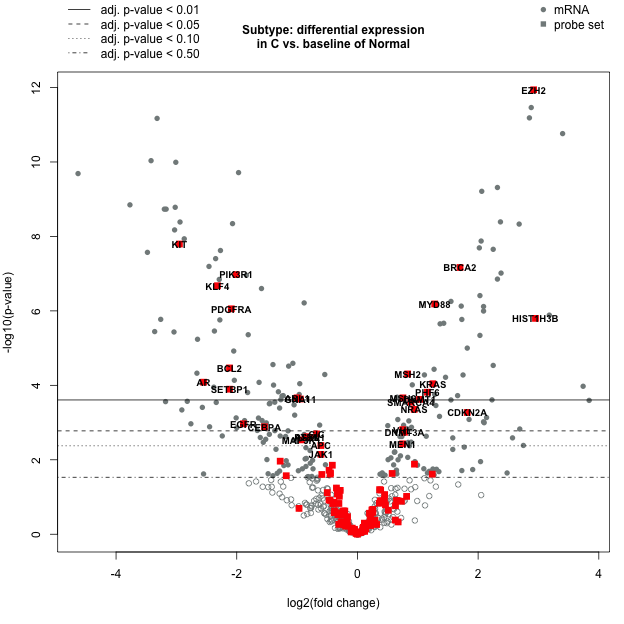
Volcano Plot: SubtypeC
Volcano plot displaying each gene's -log10(p-value) and log2 fold change for the selected covariate. Highly statistically significant genes fall at the top of the plot, and highly differentially expressed genes fall to either side. Genes within the selected gene set are highlighted in blue. Green point colors and horizontal lines indicate various False Discovery Rate (FDR) thresholds.
DE Results - Driver Gene genes - SubtypeC
More Plot Information Download CSV DataProbe Label Log2 fold change std error Lower confidence limit Upper confidence limit P-value BY.p.value Gene.sets Codeset.Name Probe.Label Analyte.Type Is.Control Control.Type Probe.Annotation KEGG.Pathways Cell.Type Official.Gene.Name volcanocol volcanopch tstats.all EZH2-mRNA 2.92 0.314 2.31 3.54 1.15e-12 4.59e-09 Driver Gene NS_CANCERPATH_C2535 EZH2 mRNA 0 Driver Gene hsa05206 EZH2 chartreuse1 16 9.29936305732484 KIT-mRNA -2.95 0.441 -3.81 -2.08 1.6e-08 2.76e-06 Driver Gene, PI3K, RAS NS_CANCERPATH_C2535 KIT mRNA 0 RAS;PI3K;Driver Gene hsa04014;hsa04015;hsa04060;hsa04072;hsa04144;hsa04151;hsa04640;hsa04916;hsa05200;hsa05221;hsa05230 KIT chartreuse1 16 -6.68934240362812 BRCA2-mRNA 1.7 0.271 1.17 2.24 6.83e-08 9.06e-06 DNARepair, Driver Gene NS_CANCERPATH_C2535 BRCA2 mRNA 0 DNARepair;Driver Gene hsa03440;hsa03460;hsa05200;hsa05212 BRCA2 chartreuse1 16 6.27306273062731 PIK3R1-mRNA -2.01 0.326 -2.65 -1.37 1.06e-07 1.31e-05 CC.PLS.Apop, Driver Gene, JAK-STAT, PI3K, RAS NS_CANCERPATH_C2535 PIK3R1 mRNA 0 CC.PLS.Apop;RAS;PI3K;JAK-STAT;Driver Gene hsa04012;hsa04014;hsa04015;hsa04022;hsa04024;hsa04062;hsa04066;hsa04068;hsa04070;hsa04071;hsa04072;hsa04150;hsa04151;hsa04152;hsa04210;hsa04211;hsa04261;hsa04370;hsa04380;hsa04510;hsa04550;hsa04611;hsa04620;hsa04630;hsa04650;hsa04660;hsa04662;hsa04664;hsa04666;hsa04668;hsa04670;hsa04722;hsa04725;hsa04750;hsa04810;hsa04910;hsa04914;hsa04915;hsa04917;hsa04919;hsa04921;hsa04923;hsa04930;hsa04931;hsa04932;hsa04933;hsa04960;hsa04973;hsa05100;hsa05142;hsa05145;hsa05146;hsa05160;hsa05161;hsa05162;hsa05164;hsa05166;hsa05169;hsa05200;hsa05203;hsa05205;hsa05210;hsa05211;hsa05212;hsa05213;hsa05214;hsa05215;hsa05218;hsa05220;hsa05221;hsa05222;hsa05223;hsa05230;hsa05231 PIK3R1 chartreuse1 16 -6.16564417177914 KLF4-mRNA -2.32 0.388 -3.08 -1.56 2.11e-07 2.33e-05 Driver Gene NS_CANCERPATH_C2535 KLF4 mRNA 0 Driver Gene hsa04550 KLF4 chartreuse1 16 -5.97938144329897 MYD88-mRNA 1.28 0.227 0.84 1.73 6.52e-07 6.32e-05 CC.PLS.Apop, Driver Gene NS_CANCERPATH_C2535 MYD88 mRNA 0 CC.PLS.Apop;Driver Gene hsa04064;hsa04210;hsa04620;hsa05132;hsa05133;hsa05134;hsa05140;hsa05142;hsa05143;hsa05144;hsa05145;hsa05152;hsa05161;hsa05162;hsa05164;hsa05168 MYD88 chartreuse1 16 5.63876651982379 PDGFRA-mRNA -2.09 0.374 -2.82 -1.35 8.8e-07 7.95e-05 Driver Gene, MAPK, PI3K, RAS NS_CANCERPATH_C2535 PDGFRA mRNA 0 RAS;PI3K;MAPK;Driver Gene hsa04010;hsa04014;hsa04015;hsa04020;hsa04060;hsa04072;hsa04144;hsa04151;hsa04510;hsa04540;hsa04810;hsa05166;hsa05200;hsa05206;hsa05214;hsa05215;hsa05218;hsa05230;hsa05231 PDGFRA chartreuse1 16 -5.58823529411765 HIST1H3B-mRNA 2.95 0.545 1.88 4.02 1.59e-06 0.000135 Driver Gene, TXmisReg NS_CANCERPATH_C2535 HIST1H3B mRNA 0 TXmisReg;Driver Gene hsa05034;hsa05202;hsa05322 HIST1H3B chartreuse1 16 5.41284403669725 BCL2-mRNA -2.12 0.467 -3.04 -1.2 3.41e-05 0.00208 CC.PLS.Apop, Driver Gene, PI3K NS_CANCERPATH_C2535 BCL2 mRNA 0 CC.PLS.Apop;PI3K;Driver Gene hsa04064;hsa04066;hsa04071;hsa04141;hsa04151;hsa04210;hsa04261;hsa04510;hsa04630;hsa04722;hsa04725;hsa04933;hsa05014;hsa05145;hsa05152;hsa05161;hsa05169;hsa05200;hsa05206;hsa05210;hsa05215;hsa05222 BCL2 chartreuse1 16 -4.53961456102784 MSH2-mRNA 0.832 0.188 0.464 1.2 4.94e-05 0.00289 Driver Gene NS_CANCERPATH_C2535 MSH2 mRNA 0 Driver Gene hsa03430;hsa05200;hsa05210 MSH2 chartreuse1 16 4.42553191489362 AR-mRNA -2.55 0.597 -3.72 -1.38 8.23e-05 0.00442 Driver Gene NS_CANCERPATH_C2535 AR mRNA 0 Driver Gene hsa04114;hsa05200;hsa05215 AR chartreuse1 16 -4.2713567839196 KRAS-mRNA 1.25 0.296 0.675 1.83 9.06e-05 0.00468 Driver Gene, MAPK, PI3K, RAS NS_CANCERPATH_C2535 KRAS mRNA 0 RAS;PI3K;MAPK;Driver Gene hsa04010;hsa04012;hsa04014;hsa04015;hsa04062;hsa04068;hsa04071;hsa04072;hsa04151;hsa04211;hsa04320;hsa04360;hsa04370;hsa04530;hsa04540;hsa04550;hsa04650;hsa04660;hsa04662;hsa04664;hsa04720;hsa04722;hsa04725;hsa04726;hsa04730;hsa04810;hsa04910;hsa04912;hsa04914;hsa04915;hsa04916;hsa04917;hsa04919;hsa04921;hsa04933;hsa04960;hsa05034;hsa05160;hsa05161;hsa05166;hsa05200;hsa05203;hsa05205;hsa05206;hsa05210;hsa05211;hsa05212;hsa05213;hsa05214;hsa05215;hsa05216;hsa05218;hsa05219;hsa05220;hsa05221;hsa05223;hsa05230;hsa05231 KRAS chartreuse1 16 4.22297297297297 SETBP1-mRNA -2.12 0.513 -3.13 -1.12 0.000127 0.00615 Driver Gene NS_CANCERPATH_C2535 SETBP1 mRNA 0 Driver Gene SETBP1 chartreuse1 16 -4.13255360623782 PHF6-mRNA 1.16 0.285 0.606 1.72 0.000153 0.00723 Driver Gene NS_CANCERPATH_C2535 PHF6 mRNA 0 Driver Gene PHF6 chartreuse1 16 4.07017543859649 ABL1-mRNA -1 0.252 -1.5 -0.508 0.000217 0.0093 CC.PLS.Apop, Driver Gene, RAS NS_CANCERPATH_C2535 ABL1 mRNA 0 CC.PLS.Apop;RAS;Driver Gene hsa04012;hsa04014;hsa04110;hsa04360;hsa04722;hsa05130;hsa05131;hsa05200;hsa05206;hsa05220;hsa05416 ABL1 chartreuse1 16 -3.96825396825397 MSH6-mRNA 0.754 0.19 0.382 1.13 0.000217 0.0093 Driver Gene NS_CANCERPATH_C2535 MSH6 mRNA 0 Driver Gene hsa03430;hsa05200;hsa05210 MSH6 chartreuse1 16 3.96842105263158 GNA11-mRNA -0.945 0.239 -1.41 -0.477 0.000233 0.00975 Driver Gene NS_CANCERPATH_C2535 GNA11 mRNA 0 Driver Gene hsa04020;hsa04022;hsa04270;hsa04540;hsa04725;hsa04730;hsa04911;hsa04912;hsa04925;hsa05142;hsa05146;hsa05200 GNA11 chartreuse1 16 -3.95397489539749 DNMT1-mRNA 1.03 0.262 0.521 1.55 0.000238 0.00986 Driver Gene NS_CANCERPATH_C2535 DNMT1 mRNA 0 Driver Gene hsa01100;hsa05206 DNMT1 chartreuse1 16 3.93129770992366 SMARCA4-mRNA 0.886 0.228 0.44 1.33 0.000284 0.0109 Driver Gene NS_CANCERPATH_C2535 SMARCA4 mRNA 0 Driver Gene SMARCA4 chartreuse2 16 3.8859649122807 NRAS-mRNA 0.94 0.251 0.449 1.43 0.000443 0.0157 Driver Gene, MAPK, PI3K, RAS NS_CANCERPATH_C2535 NRAS mRNA 0 RAS;PI3K;MAPK;Driver Gene hsa04010;hsa04012;hsa04014;hsa04015;hsa04062;hsa04068;hsa04071;hsa04072;hsa04151;hsa04211;hsa04360;hsa04370;hsa04530;hsa04540;hsa04550;hsa04650;hsa04660;hsa04662;hsa04664;hsa04720;hsa04722;hsa04725;hsa04726;hsa04730;hsa04810;hsa04910;hsa04912;hsa04915;hsa04916;hsa04917;hsa04919;hsa04921;hsa04933;hsa05034;hsa05160;hsa05161;hsa05166;hsa05200;hsa05203;hsa05205;hsa05206;hsa05211;hsa05213;hsa05214;hsa05215;hsa05216;hsa05218;hsa05219;hsa05220;hsa05221;hsa05223;hsa05230;hsa05231 NRAS chartreuse2 16 3.74501992031872 DE Results - Driver Gene genes - SubtypeC
Table displaying each sample's global significance scores and directed global significance scores as defined in the heatmaps above. The global significance score is calculated as the square root of the mean squared t-statistic for the genes in a gene set, with t-statistics coming from the linear regression underlying our differential expression analysis. The directed global significance score is calculated as the square root of the mean signed squared t-statistic for the genes in a gene set, with t-statistics coming from the linear regression underlying our differential expression analysis.
Volcano Plot: SubtypeD
More Plot Information
Volcano Plot: SubtypeD
Volcano plot displaying each gene's -log10(p-value) and log2 fold change for the selected covariate. Highly statistically significant genes fall at the top of the plot, and highly differentially expressed genes fall to either side. Genes within the selected gene set are highlighted in blue. Green point colors and horizontal lines indicate various False Discovery Rate (FDR) thresholds.
DE Results - Driver Gene genes - SubtypeD
More Plot Information Download CSV DataProbe Label Log2 fold change std error Lower confidence limit Upper confidence limit P-value BY.p.value Gene.sets Codeset.Name Probe.Label Analyte.Type Is.Control Control.Type Probe.Annotation KEGG.Pathways Cell.Type Official.Gene.Name volcanocol volcanopch tstats.all ERBB2-mRNA 4.62 0.51 3.62 5.62 2.79e-12 5.56e-09 Driver Gene NS_CANCERPATH_C2535 ERBB2 mRNA 0 Driver Gene hsa04012;hsa04020;hsa04066;hsa04510;hsa04520;hsa05200;hsa05205;hsa05206;hsa05212;hsa05213;hsa05215;hsa05219;hsa05223;hsa05230 ERBB2 chartreuse1 16 9.05882352941176 KIT-mRNA -3.33 0.426 -4.17 -2.5 2.48e-10 3.29e-07 Driver Gene, PI3K, RAS NS_CANCERPATH_C2535 KIT mRNA 0 RAS;PI3K;Driver Gene hsa04014;hsa04015;hsa04060;hsa04072;hsa04144;hsa04151;hsa04640;hsa04916;hsa05200;hsa05221;hsa05230 KIT chartreuse1 16 -7.8169014084507 EZH2-mRNA 2.26 0.303 1.66 2.85 1e-09 6.58e-07 Driver Gene NS_CANCERPATH_C2535 EZH2 mRNA 0 Driver Gene hsa05206 EZH2 chartreuse1 16 7.45874587458746 BRCA2-mRNA 1.58 0.262 1.07 2.1 1.69e-07 2.58e-05 DNARepair, Driver Gene NS_CANCERPATH_C2535 BRCA2 mRNA 0 DNARepair;Driver Gene hsa03440;hsa03460;hsa05200;hsa05212 BRCA2 chartreuse1 16 6.03053435114504 HIST1H3B-mRNA 2.87 0.526 1.84 3.9 1.4e-06 0.000155 Driver Gene, TXmisReg NS_CANCERPATH_C2535 HIST1H3B mRNA 0 TXmisReg;Driver Gene hsa05034;hsa05202;hsa05322 HIST1H3B chartreuse1 16 5.45627376425856 KLF4-mRNA -2.02 0.375 -2.75 -1.28 1.79e-06 0.000187 Driver Gene NS_CANCERPATH_C2535 KLF4 mRNA 0 Driver Gene hsa04550 KLF4 chartreuse1 16 -5.38666666666667 KRAS-mRNA 1.53 0.286 0.975 2.09 1.84e-06 0.000188 Driver Gene, MAPK, PI3K, RAS NS_CANCERPATH_C2535 KRAS mRNA 0 RAS;PI3K;MAPK;Driver Gene hsa04010;hsa04012;hsa04014;hsa04015;hsa04062;hsa04068;hsa04071;hsa04072;hsa04151;hsa04211;hsa04320;hsa04360;hsa04370;hsa04530;hsa04540;hsa04550;hsa04650;hsa04660;hsa04662;hsa04664;hsa04720;hsa04722;hsa04725;hsa04726;hsa04730;hsa04810;hsa04910;hsa04912;hsa04914;hsa04915;hsa04916;hsa04917;hsa04919;hsa04921;hsa04933;hsa04960;hsa05034;hsa05160;hsa05161;hsa05166;hsa05200;hsa05203;hsa05205;hsa05206;hsa05210;hsa05211;hsa05212;hsa05213;hsa05214;hsa05215;hsa05216;hsa05218;hsa05219;hsa05220;hsa05221;hsa05223;hsa05230;hsa05231 KRAS chartreuse1 16 5.34965034965035 PDGFRA-mRNA -1.87 0.361 -2.58 -1.16 3.73e-06 0.000337 Driver Gene, MAPK, PI3K, RAS NS_CANCERPATH_C2535 PDGFRA mRNA 0 RAS;PI3K;MAPK;Driver Gene hsa04010;hsa04014;hsa04015;hsa04020;hsa04060;hsa04072;hsa04144;hsa04151;hsa04510;hsa04540;hsa04810;hsa05166;hsa05200;hsa05206;hsa05214;hsa05215;hsa05218;hsa05230;hsa05231 PDGFRA chartreuse1 16 -5.18005540166205 IDH2-mRNA 1.84 0.355 1.14 2.53 3.84e-06 0.00034 Driver Gene NS_CANCERPATH_C2535 IDH2 mRNA 0 Driver Gene hsa01100 IDH2 chartreuse1 16 5.1830985915493 MYD88-mRNA 1.04 0.219 0.612 1.47 1.62e-05 0.00113 CC.PLS.Apop, Driver Gene NS_CANCERPATH_C2535 MYD88 mRNA 0 CC.PLS.Apop;Driver Gene hsa04064;hsa04210;hsa04620;hsa05132;hsa05133;hsa05134;hsa05140;hsa05142;hsa05143;hsa05144;hsa05145;hsa05152;hsa05161;hsa05162;hsa05164;hsa05168 MYD88 chartreuse1 16 4.74885844748858 SMARCA4-mRNA 1.03 0.22 0.603 1.47 1.93e-05 0.0013 Driver Gene NS_CANCERPATH_C2535 SMARCA4 mRNA 0 Driver Gene SMARCA4 chartreuse1 16 4.68181818181818 PIK3R1-mRNA -1.3 0.315 -1.92 -0.683 0.000133 0.00749 CC.PLS.Apop, Driver Gene, JAK-STAT, PI3K, RAS NS_CANCERPATH_C2535 PIK3R1 mRNA 0 CC.PLS.Apop;RAS;PI3K;JAK-STAT;Driver Gene hsa04012;hsa04014;hsa04015;hsa04022;hsa04024;hsa04062;hsa04066;hsa04068;hsa04070;hsa04071;hsa04072;hsa04150;hsa04151;hsa04152;hsa04210;hsa04211;hsa04261;hsa04370;hsa04380;hsa04510;hsa04550;hsa04611;hsa04620;hsa04630;hsa04650;hsa04660;hsa04662;hsa04664;hsa04666;hsa04668;hsa04670;hsa04722;hsa04725;hsa04750;hsa04810;hsa04910;hsa04914;hsa04915;hsa04917;hsa04919;hsa04921;hsa04923;hsa04930;hsa04931;hsa04932;hsa04933;hsa04960;hsa04973;hsa05100;hsa05142;hsa05145;hsa05146;hsa05160;hsa05161;hsa05162;hsa05164;hsa05166;hsa05169;hsa05200;hsa05203;hsa05205;hsa05210;hsa05211;hsa05212;hsa05213;hsa05214;hsa05215;hsa05218;hsa05220;hsa05221;hsa05222;hsa05223;hsa05230;hsa05231 PIK3R1 chartreuse1 16 -4.12698412698413 ASXL1-mRNA -0.971 0.241 -1.44 -0.499 0.000179 0.00939 Driver Gene NS_CANCERPATH_C2535 ASXL1 mRNA 0 Driver Gene ASXL1 chartreuse2 16 -4.02904564315353 PTCH1-mRNA -1.39 0.358 -2.09 -0.692 0.000282 0.0142 Driver Gene, HH NS_CANCERPATH_C2535 PTCH1 mRNA 0 HH;Driver Gene hsa04024;hsa04340;hsa05200;hsa05205;hsa05217 PTCH1 chartreuse2 16 -3.88268156424581 SETBP1-mRNA -1.88 0.496 -2.85 -0.911 0.000384 0.0179 Driver Gene NS_CANCERPATH_C2535 SETBP1 mRNA 0 Driver Gene SETBP1 chartreuse2 16 -3.79032258064516 AKT1-mRNA 1.14 0.308 0.537 1.74 0.000514 0.023 CC.PLS.Apop, Driver Gene, JAK-STAT, MAPK, PI3K, RAS NS_CANCERPATH_C2535 AKT1 mRNA 0 CC.PLS.Apop;RAS;PI3K;JAK-STAT;MAPK;Driver Gene hsa04010;hsa04012;hsa04014;hsa04015;hsa04022;hsa04024;hsa04062;hsa04066;hsa04068;hsa04071;hsa04072;hsa04150;hsa04151;hsa04152;hsa04210;hsa04211;hsa04261;hsa04370;hsa04380;hsa04510;hsa04530;hsa04550;hsa04611;hsa04620;hsa04630;hsa04660;hsa04662;hsa04664;hsa04666;hsa04668;hsa04722;hsa04725;hsa04728;hsa04910;hsa04914;hsa04915;hsa04917;hsa04919;hsa04920;hsa04922;hsa04923;hsa04931;hsa04932;hsa04933;hsa04973;hsa05142;hsa05145;hsa05152;hsa05160;hsa05161;hsa05162;hsa05164;hsa05166;hsa05169;hsa05200;hsa05205;hsa05210;hsa05211;hsa05212;hsa05213;hsa05214;hsa05215;hsa05218;hsa05220;hsa05221;hsa05222;hsa05223;hsa05230;hsa05231 AKT1 chartreuse2 16 3.7012987012987 EGFR-mRNA -1.8 0.526 -2.83 -0.769 0.00122 0.0465 Driver Gene, MAPK, PI3K, RAS NS_CANCERPATH_C2535 EGFR mRNA 0 RAS;PI3K;MAPK;Driver Gene hsa04010;hsa04012;hsa04014;hsa04015;hsa04020;hsa04060;hsa04066;hsa04068;hsa04072;hsa04144;hsa04151;hsa04320;hsa04510;hsa04520;hsa04540;hsa04810;hsa04912;hsa04915;hsa04921;hsa05120;hsa05160;hsa05200;hsa05205;hsa05206;hsa05212;hsa05213;hsa05214;hsa05215;hsa05218;hsa05219;hsa05223;hsa05230;hsa05231 EGFR chartreuse2 16 -3.42205323193916 BCL2-mRNA -1.54 0.452 -2.43 -0.659 0.00123 0.0465 CC.PLS.Apop, Driver Gene, PI3K NS_CANCERPATH_C2535 BCL2 mRNA 0 CC.PLS.Apop;PI3K;Driver Gene hsa04064;hsa04066;hsa04071;hsa04141;hsa04151;hsa04210;hsa04261;hsa04510;hsa04630;hsa04722;hsa04725;hsa04933;hsa05014;hsa05145;hsa05152;hsa05161;hsa05169;hsa05200;hsa05206;hsa05210;hsa05215;hsa05222 BCL2 chartreuse2 16 -3.4070796460177 DNMT1-mRNA 0.848 0.253 0.351 1.34 0.00153 0.0562 Driver Gene NS_CANCERPATH_C2535 DNMT1 mRNA 0 Driver Gene hsa01100;hsa05206 DNMT1 chartreuse3 16 3.35177865612648 MEN1-mRNA 0.744 0.238 0.278 1.21 0.0029 0.0922 Driver Gene, TXmisReg NS_CANCERPATH_C2535 MEN1 mRNA 0 TXmisReg;Driver Gene hsa05202 MEN1 chartreuse3 16 3.12605042016807 DE Results - Driver Gene genes - SubtypeD
Table displaying each sample's global significance scores and directed global significance scores as defined in the heatmaps above. The global significance score is calculated as the square root of the mean squared t-statistic for the genes in a gene set, with t-statistics coming from the linear regression underlying our differential expression analysis. The directed global significance score is calculated as the square root of the mean signed squared t-statistic for the genes in a gene set, with t-statistics coming from the linear regression underlying our differential expression analysis.
- Subtype:
- SubtypeA
- SubtypeB
- SubtypeC
- SubtypeD
Volcano Plot: SubtypeA
More Plot Information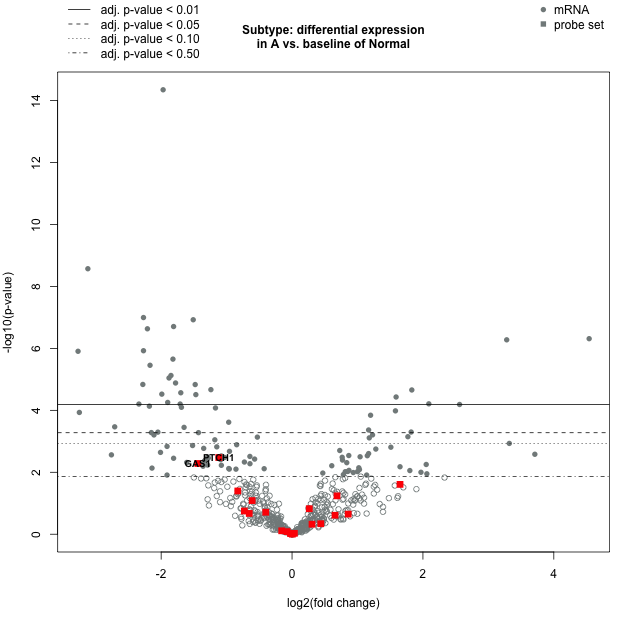
Volcano Plot: SubtypeA
Volcano plot displaying each gene's -log10(p-value) and log2 fold change for the selected covariate. Highly statistically significant genes fall at the top of the plot, and highly differentially expressed genes fall to either side. Genes within the selected gene set are highlighted in blue. Green point colors and horizontal lines indicate various False Discovery Rate (FDR) thresholds.
DE Results - HH genes - SubtypeA
More Plot Information Download CSV DataProbe Label Log2 fold change std error Lower confidence limit Upper confidence limit P-value BY.p.value Gene.sets Codeset.Name Probe.Label Analyte.Type Is.Control Control.Type Probe.Annotation KEGG.Pathways Cell.Type Official.Gene.Name volcanocol volcanopch tstats.all PTCH1-mRNA -1.12 0.365 -1.84 -0.408 0.00334 0.187 Driver Gene, HH NS_CANCERPATH_C2535 PTCH1 mRNA 0 HH;Driver Gene hsa04024;hsa04340;hsa05200;hsa05205;hsa05217 PTCH1 chartreuse4 16 -3.06849315068493 GAS1-mRNA -1.44 0.494 -2.41 -0.473 0.00521 0.25 HH NS_CANCERPATH_C2535 GAS1 mRNA 0 HH hsa04340 GAS1 chartreuse4 16 -2.91497975708502 WNT7B-mRNA 1.65 0.712 0.253 3.04 0.0246 0.74 HH, Wnt NS_CANCERPATH_C2535 WNT7B mRNA 0 HH;Wnt hsa04310;hsa04340;hsa04390;hsa04550;hsa04916;hsa05166;hsa05200;hsa05205;hsa05217 WNT7B azure4 1 2.31741573033708 SMO-mRNA -0.829 0.394 -1.6 -0.0572 0.0401 1 Driver Gene, HH NS_CANCERPATH_C2535 SMO mRNA 0 HH;Driver Gene hsa04340;hsa05200;hsa05205;hsa05217 SMO azure4 1 -2.10406091370558 WNT10A-mRNA 0.687 0.354 -0.00666 1.38 0.0577 1 HH, Wnt NS_CANCERPATH_C2535 WNT10A mRNA 0 HH;Wnt hsa04310;hsa04340;hsa04390;hsa04550;hsa04916;hsa05166;hsa05200;hsa05205;hsa05217 WNT10A azure4 1 1.9406779661017 PRKACA-mRNA -0.61 0.344 -1.28 0.0642 0.082 1 CC.PLS.Apop, HH, MAPK, RAS, Wnt NS_CANCERPATH_C2535 PRKACA mRNA 0 CC.PLS.Apop;RAS;MAPK;HH;Wnt hsa04010;hsa04014;hsa04020;hsa04024;hsa04062;hsa04114;hsa04210;hsa04211;hsa04261;hsa04270;hsa04310;hsa04340;hsa04540;hsa04611;hsa04713;hsa04720;hsa04723;hsa04724;hsa04725;hsa04726;hsa04727;hsa04728;hsa04740;hsa04750;hsa04910;hsa04911;hsa04912;hsa04913;hsa04914;hsa04915;hsa04916;hsa04918;hsa04919;hsa04921;hsa04922;hsa04923;hsa04924;hsa04925;hsa04961;hsa04962;hsa04970;hsa04971;hsa05012;hsa05020;hsa05030;hsa05031;hsa05032;hsa05034;hsa05110;hsa05146;hsa05166;hsa05169;hsa05200;hsa05203;hsa05205;hsa05414 PRKACA azure4 1 -1.77325581395349 GSK3B-mRNA 0.263 0.18 -0.0895 0.616 0.15 1 CC.PLS.Apop, HH, PI3K, Wnt NS_CANCERPATH_C2535 GSK3B mRNA 0 CC.PLS.Apop;PI3K;HH;Wnt hsa04012;hsa04062;hsa04110;hsa04151;hsa04310;hsa04340;hsa04360;hsa04390;hsa04510;hsa04550;hsa04660;hsa04662;hsa04722;hsa04728;hsa04910;hsa04916;hsa04917;hsa04919;hsa04931;hsa04932;hsa05010;hsa05160;hsa05162;hsa05164;hsa05166;hsa05169;hsa05200;hsa05210;hsa05213;hsa05215;hsa05217 GSK3B azure4 1 1.46111111111111 WNT5B-mRNA -0.729 0.534 -1.78 0.318 0.178 1 HH, Wnt NS_CANCERPATH_C2535 WNT5B mRNA 0 HH;Wnt hsa04310;hsa04340;hsa04390;hsa04550;hsa04916;hsa05166;hsa05200;hsa05205;hsa05217 WNT5B azure4 1 -1.36516853932584 WNT2B-mRNA -0.402 0.306 -1 0.198 0.195 1 HH, Wnt NS_CANCERPATH_C2535 WNT2B mRNA 0 HH;Wnt hsa04310;hsa04340;hsa04390;hsa04550;hsa04916;hsa05166;hsa05200;hsa05205;hsa05217 WNT2B azure4 1 -1.31372549019608 BMP4-mRNA -0.654 0.518 -1.67 0.362 0.213 1 HH, TGF-B NS_CANCERPATH_C2535 BMP4 mRNA 0 TGF-B;HH hsa04340;hsa04350;hsa04390;hsa04550;hsa04919;hsa05200;hsa05217 BMP4 azure4 1 -1.26254826254826 WNT5A-mRNA 0.858 0.698 -0.51 2.23 0.224 1 HH, Wnt NS_CANCERPATH_C2535 WNT5A mRNA 0 HH;Wnt hsa04310;hsa04340;hsa04390;hsa04550;hsa04916;hsa05166;hsa05200;hsa05205;hsa05217 WNT5A azure4 1 1.22922636103152 WNT3-mRNA 0.657 0.558 -0.436 1.75 0.244 1 HH, Wnt NS_CANCERPATH_C2535 WNT3 mRNA 0 HH;Wnt hsa04310;hsa04340;hsa04390;hsa04550;hsa04916;hsa05166;hsa05200;hsa05205;hsa05206;hsa05217 WNT3 azure4 1 1.17741935483871 WNT4-mRNA 0.439 0.588 -0.713 1.59 0.458 1 HH, Wnt NS_CANCERPATH_C2535 WNT4 mRNA 0 HH;Wnt hsa04310;hsa04340;hsa04390;hsa04550;hsa04916;hsa04919;hsa05166;hsa05200;hsa05205;hsa05217 WNT4 azure4 1 0.746598639455782 WNT2-mRNA 0.305 0.424 -0.527 1.14 0.475 1 HH, Wnt NS_CANCERPATH_C2535 WNT2 mRNA 0 HH;Wnt hsa04310;hsa04340;hsa04390;hsa04550;hsa04916;hsa05166;hsa05200;hsa05205;hsa05217 WNT2 azure4 1 0.719339622641509 PRKACB-mRNA -0.158 0.55 -1.24 0.92 0.775 1 CC.PLS.Apop, HH, MAPK, RAS, Wnt NS_CANCERPATH_C2535 PRKACB mRNA 0 CC.PLS.Apop;RAS;MAPK;HH;Wnt hsa04010;hsa04014;hsa04020;hsa04024;hsa04062;hsa04114;hsa04210;hsa04211;hsa04261;hsa04270;hsa04310;hsa04340;hsa04540;hsa04611;hsa04713;hsa04720;hsa04723;hsa04724;hsa04725;hsa04726;hsa04727;hsa04728;hsa04740;hsa04750;hsa04910;hsa04911;hsa04912;hsa04913;hsa04914;hsa04915;hsa04916;hsa04918;hsa04919;hsa04921;hsa04922;hsa04923;hsa04924;hsa04925;hsa04961;hsa04962;hsa04970;hsa04971;hsa05012;hsa05020;hsa05030;hsa05031;hsa05032;hsa05110;hsa05146;hsa05166;hsa05169;hsa05200;hsa05203;hsa05205;hsa05414 PRKACB azure4 1 -0.287272727272727 PRKX-mRNA -0.0751 0.334 -0.729 0.579 0.823 1 CC.PLS.Apop, HH, MAPK, RAS, Wnt NS_CANCERPATH_C2535 PRKX mRNA 0 CC.PLS.Apop;RAS;MAPK;HH;Wnt PRKX azure4 1 -0.224850299401198 GLI3-mRNA 0.0358 0.443 -0.832 0.904 0.936 1 HH NS_CANCERPATH_C2535 GLI3 mRNA 0 HH hsa04024;hsa04340;hsa05200;hsa05217 GLI3 azure4 1 0.0808126410835214 WNT6-mRNA -0.0245 0.373 -0.755 0.706 0.948 1 HH, Wnt NS_CANCERPATH_C2535 WNT6 mRNA 0 HH;Wnt hsa04310;hsa04340;hsa04390;hsa04550;hsa04916;hsa05166;hsa05200;hsa05205;hsa05217 WNT6 azure4 1 -0.0656836461126005 LRP2-mRNA 0.00423 1.08 -2.11 2.12 0.997 1 HH NS_CANCERPATH_C2535 LRP2 mRNA 0 HH hsa04340;hsa04918 LRP2 azure4 1 0.00391666666666667 DE Results - HH genes - SubtypeA
Table displaying each sample's global significance scores and directed global significance scores as defined in the heatmaps above. The global significance score is calculated as the square root of the mean squared t-statistic for the genes in a gene set, with t-statistics coming from the linear regression underlying our differential expression analysis. The directed global significance score is calculated as the square root of the mean signed squared t-statistic for the genes in a gene set, with t-statistics coming from the linear regression underlying our differential expression analysis.
Volcano Plot: SubtypeB
More Plot Information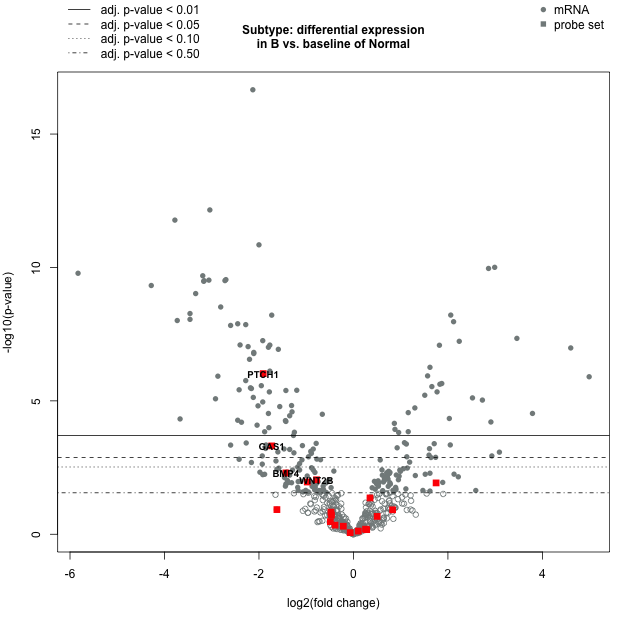
Volcano Plot: SubtypeB
Volcano plot displaying each gene's -log10(p-value) and log2 fold change for the selected covariate. Highly statistically significant genes fall at the top of the plot, and highly differentially expressed genes fall to either side. Genes within the selected gene set are highlighted in blue. Green point colors and horizontal lines indicate various False Discovery Rate (FDR) thresholds.
DE Results - HH genes - SubtypeB
More Plot Information Download CSV DataProbe Label Log2 fold change std error Lower confidence limit Upper confidence limit P-value BY.p.value Gene.sets Codeset.Name Probe.Label Analyte.Type Is.Control Control.Type Probe.Annotation KEGG.Pathways Cell.Type Official.Gene.Name volcanocol volcanopch tstats.all PTCH1-mRNA -1.91 0.344 -2.59 -1.24 9.52e-07 9.24e-05 Driver Gene, HH NS_CANCERPATH_C2535 PTCH1 mRNA 0 HH;Driver Gene hsa04024;hsa04340;hsa05200;hsa05205;hsa05217 PTCH1 chartreuse1 16 -5.55232558139535 GAS1-mRNA -1.73 0.466 -2.65 -0.82 0.000488 0.0198 HH NS_CANCERPATH_C2535 GAS1 mRNA 0 HH hsa04340 GAS1 chartreuse2 16 -3.71244635193133 BMP4-mRNA -1.43 0.488 -2.39 -0.474 0.00503 0.137 HH, TGF-B NS_CANCERPATH_C2535 BMP4 mRNA 0 TGF-B;HH hsa04340;hsa04350;hsa04390;hsa04550;hsa04919;hsa05200;hsa05217 BMP4 chartreuse4 16 -2.93032786885246 WNT2B-mRNA -0.781 0.288 -1.35 -0.216 0.00907 0.216 HH, Wnt NS_CANCERPATH_C2535 WNT2B mRNA 0 HH;Wnt hsa04310;hsa04340;hsa04390;hsa04550;hsa04916;hsa05166;hsa05200;hsa05205;hsa05217 WNT2B chartreuse4 16 -2.71180555555556 SMO-mRNA -0.978 0.371 -1.71 -0.251 0.011 0.247 Driver Gene, HH NS_CANCERPATH_C2535 SMO mRNA 0 HH;Driver Gene hsa04340;hsa05200;hsa05205;hsa05217 SMO chartreuse4 16 -2.63611859838275 WNT7B-mRNA 1.75 0.671 0.433 3.06 0.0119 0.256 HH, Wnt NS_CANCERPATH_C2535 WNT7B mRNA 0 HH;Wnt hsa04310;hsa04340;hsa04390;hsa04550;hsa04916;hsa05166;hsa05200;hsa05205;hsa05217 WNT7B chartreuse4 16 2.6080476900149 GSK3B-mRNA 0.351 0.17 0.0186 0.684 0.0435 0.681 CC.PLS.Apop, HH, PI3K, Wnt NS_CANCERPATH_C2535 GSK3B mRNA 0 CC.PLS.Apop;PI3K;HH;Wnt hsa04012;hsa04062;hsa04110;hsa04151;hsa04310;hsa04340;hsa04360;hsa04390;hsa04510;hsa04550;hsa04660;hsa04662;hsa04722;hsa04728;hsa04910;hsa04916;hsa04917;hsa04919;hsa04931;hsa04932;hsa05010;hsa05160;hsa05162;hsa05164;hsa05166;hsa05169;hsa05200;hsa05210;hsa05213;hsa05215;hsa05217 GSK3B azure4 1 2.06470588235294 LRP2-mRNA -1.62 1.02 -3.61 0.381 0.119 1 HH NS_CANCERPATH_C2535 LRP2 mRNA 0 HH hsa04340;hsa04918 LRP2 azure4 1 -1.58823529411765 WNT3-mRNA 0.829 0.526 -0.201 1.86 0.121 1 HH, Wnt NS_CANCERPATH_C2535 WNT3 mRNA 0 HH;Wnt hsa04310;hsa04340;hsa04390;hsa04550;hsa04916;hsa05166;hsa05200;hsa05205;hsa05206;hsa05217 WNT3 azure4 1 1.57604562737643 PRKACA-mRNA -0.476 0.324 -1.11 0.159 0.148 1 CC.PLS.Apop, HH, MAPK, RAS, Wnt NS_CANCERPATH_C2535 PRKACA mRNA 0 CC.PLS.Apop;RAS;MAPK;HH;Wnt hsa04010;hsa04014;hsa04020;hsa04024;hsa04062;hsa04114;hsa04210;hsa04211;hsa04261;hsa04270;hsa04310;hsa04340;hsa04540;hsa04611;hsa04713;hsa04720;hsa04723;hsa04724;hsa04725;hsa04726;hsa04727;hsa04728;hsa04740;hsa04750;hsa04910;hsa04911;hsa04912;hsa04913;hsa04914;hsa04915;hsa04916;hsa04918;hsa04919;hsa04921;hsa04922;hsa04923;hsa04924;hsa04925;hsa04961;hsa04962;hsa04970;hsa04971;hsa05012;hsa05020;hsa05030;hsa05031;hsa05032;hsa05034;hsa05110;hsa05146;hsa05166;hsa05169;hsa05200;hsa05203;hsa05205;hsa05414 PRKACA azure4 1 -1.46913580246914 WNT6-mRNA -0.465 0.351 -1.15 0.223 0.191 1 HH, Wnt NS_CANCERPATH_C2535 WNT6 mRNA 0 HH;Wnt hsa04310;hsa04340;hsa04390;hsa04550;hsa04916;hsa05166;hsa05200;hsa05205;hsa05217 WNT6 azure4 1 -1.32478632478632 WNT2-mRNA 0.503 0.4 -0.28 1.29 0.214 1 HH, Wnt NS_CANCERPATH_C2535 WNT2 mRNA 0 HH;Wnt hsa04310;hsa04340;hsa04390;hsa04550;hsa04916;hsa05166;hsa05200;hsa05205;hsa05217 WNT2 azure4 1 1.2575 WNT5B-mRNA -0.488 0.503 -1.47 0.498 0.336 1 HH, Wnt NS_CANCERPATH_C2535 WNT5B mRNA 0 HH;Wnt hsa04310;hsa04340;hsa04390;hsa04550;hsa04916;hsa05166;hsa05200;hsa05205;hsa05217 WNT5B azure4 1 -0.970178926441352 PRKACB-mRNA -0.39 0.518 -1.41 0.625 0.455 1 CC.PLS.Apop, HH, MAPK, RAS, Wnt NS_CANCERPATH_C2535 PRKACB mRNA 0 CC.PLS.Apop;RAS;MAPK;HH;Wnt hsa04010;hsa04014;hsa04020;hsa04024;hsa04062;hsa04114;hsa04210;hsa04211;hsa04261;hsa04270;hsa04310;hsa04340;hsa04540;hsa04611;hsa04713;hsa04720;hsa04723;hsa04724;hsa04725;hsa04726;hsa04727;hsa04728;hsa04740;hsa04750;hsa04910;hsa04911;hsa04912;hsa04913;hsa04914;hsa04915;hsa04916;hsa04918;hsa04919;hsa04921;hsa04922;hsa04923;hsa04924;hsa04925;hsa04961;hsa04962;hsa04970;hsa04971;hsa05012;hsa05020;hsa05030;hsa05031;hsa05032;hsa05110;hsa05146;hsa05166;hsa05169;hsa05200;hsa05203;hsa05205;hsa05414 PRKACB azure4 1 -0.752895752895753 PRKX-mRNA -0.214 0.315 -0.83 0.403 0.5 1 CC.PLS.Apop, HH, MAPK, RAS, Wnt NS_CANCERPATH_C2535 PRKX mRNA 0 CC.PLS.Apop;RAS;MAPK;HH;Wnt PRKX azure4 1 -0.679365079365079 WNT4-mRNA 0.256 0.554 -0.83 1.34 0.646 1 HH, Wnt NS_CANCERPATH_C2535 WNT4 mRNA 0 HH;Wnt hsa04310;hsa04340;hsa04390;hsa04550;hsa04916;hsa04919;hsa05166;hsa05200;hsa05205;hsa05217 WNT4 azure4 1 0.462093862815884 WNT5A-mRNA 0.281 0.658 -1.01 1.57 0.671 1 HH, Wnt NS_CANCERPATH_C2535 WNT5A mRNA 0 HH;Wnt hsa04310;hsa04340;hsa04390;hsa04550;hsa04916;hsa05166;hsa05200;hsa05205;hsa05217 WNT5A azure4 1 0.427051671732523 WNT10A-mRNA 0.103 0.333 -0.551 0.756 0.759 1 HH, Wnt NS_CANCERPATH_C2535 WNT10A mRNA 0 HH;Wnt hsa04310;hsa04340;hsa04390;hsa04550;hsa04916;hsa05166;hsa05200;hsa05205;hsa05217 WNT10A azure4 1 0.309309309309309 GLI3-mRNA -0.0685 0.417 -0.886 0.75 0.87 1 HH NS_CANCERPATH_C2535 GLI3 mRNA 0 HH hsa04024;hsa04340;hsa05200;hsa05217 GLI3 azure4 1 -0.164268585131895 DE Results - HH genes - SubtypeB
Table displaying each sample's global significance scores and directed global significance scores as defined in the heatmaps above. The global significance score is calculated as the square root of the mean squared t-statistic for the genes in a gene set, with t-statistics coming from the linear regression underlying our differential expression analysis. The directed global significance score is calculated as the square root of the mean signed squared t-statistic for the genes in a gene set, with t-statistics coming from the linear regression underlying our differential expression analysis.
Volcano Plot: SubtypeC
More Plot Information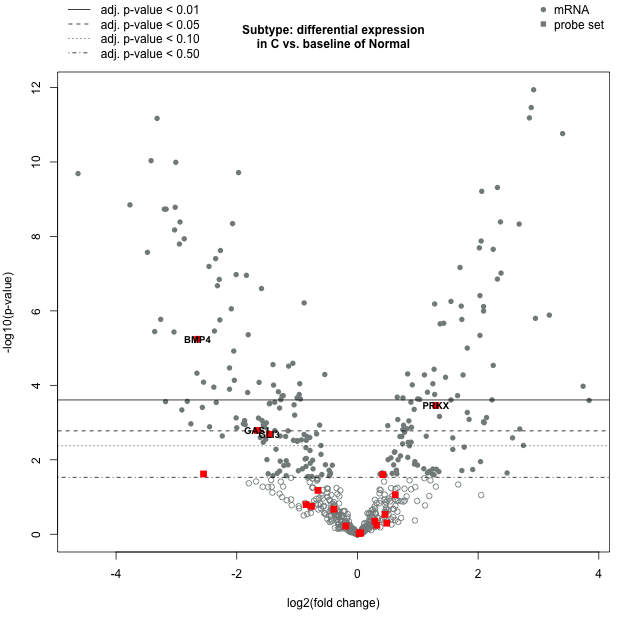
Volcano Plot: SubtypeC
Volcano plot displaying each gene's -log10(p-value) and log2 fold change for the selected covariate. Highly statistically significant genes fall at the top of the plot, and highly differentially expressed genes fall to either side. Genes within the selected gene set are highlighted in blue. Green point colors and horizontal lines indicate various False Discovery Rate (FDR) thresholds.
DE Results - HH genes - SubtypeC
More Plot Information Download CSV DataProbe Label Log2 fold change std error Lower confidence limit Upper confidence limit P-value BY.p.value Gene.sets Codeset.Name Probe.Label Analyte.Type Is.Control Control.Type Probe.Annotation KEGG.Pathways Cell.Type Official.Gene.Name volcanocol volcanopch tstats.all BMP4-mRNA -2.65 0.525 -3.68 -1.62 5.79e-06 0.000397 HH, TGF-B NS_CANCERPATH_C2535 BMP4 mRNA 0 TGF-B;HH hsa04340;hsa04350;hsa04390;hsa04550;hsa04919;hsa05200;hsa05217 BMP4 chartreuse1 16 -5.04761904761905 PRKX-mRNA 1.3 0.338 0.632 1.96 0.000348 0.0127 CC.PLS.Apop, HH, MAPK, RAS, Wnt NS_CANCERPATH_C2535 PRKX mRNA 0 CC.PLS.Apop;RAS;MAPK;HH;Wnt PRKX chartreuse2 16 3.84615384615385 GAS1-mRNA -1.66 0.501 -2.65 -0.683 0.00163 0.0457 HH NS_CANCERPATH_C2535 GAS1 mRNA 0 HH hsa04340 GAS1 chartreuse2 16 -3.31337325349301 GLI3-mRNA -1.46 0.449 -2.33 -0.576 0.00207 0.0561 HH NS_CANCERPATH_C2535 GLI3 mRNA 0 HH hsa04024;hsa04340;hsa05200;hsa05217 GLI3 chartreuse3 16 -3.25167037861915 LRP2-mRNA -2.55 1.1 -4.69 -0.4 0.024 0.424 HH NS_CANCERPATH_C2535 LRP2 mRNA 0 HH hsa04340;hsa04918 LRP2 chartreuse4 16 -2.31818181818182 GSK3B-mRNA 0.422 0.182 0.0639 0.779 0.0249 0.43 CC.PLS.Apop, HH, PI3K, Wnt NS_CANCERPATH_C2535 GSK3B mRNA 0 CC.PLS.Apop;PI3K;HH;Wnt hsa04012;hsa04062;hsa04110;hsa04151;hsa04310;hsa04340;hsa04360;hsa04390;hsa04510;hsa04550;hsa04660;hsa04662;hsa04722;hsa04728;hsa04910;hsa04916;hsa04917;hsa04919;hsa04931;hsa04932;hsa05010;hsa05160;hsa05162;hsa05164;hsa05166;hsa05169;hsa05200;hsa05210;hsa05213;hsa05215;hsa05217 GSK3B chartreuse4 16 2.31868131868132 PRKACA-mRNA -0.654 0.349 -1.34 0.0294 0.0663 0.959 CC.PLS.Apop, HH, MAPK, RAS, Wnt NS_CANCERPATH_C2535 PRKACA mRNA 0 CC.PLS.Apop;RAS;MAPK;HH;Wnt hsa04010;hsa04014;hsa04020;hsa04024;hsa04062;hsa04114;hsa04210;hsa04211;hsa04261;hsa04270;hsa04310;hsa04340;hsa04540;hsa04611;hsa04713;hsa04720;hsa04723;hsa04724;hsa04725;hsa04726;hsa04727;hsa04728;hsa04740;hsa04750;hsa04910;hsa04911;hsa04912;hsa04913;hsa04914;hsa04915;hsa04916;hsa04918;hsa04919;hsa04921;hsa04922;hsa04923;hsa04924;hsa04925;hsa04961;hsa04962;hsa04970;hsa04971;hsa05012;hsa05020;hsa05030;hsa05031;hsa05032;hsa05034;hsa05110;hsa05146;hsa05166;hsa05169;hsa05200;hsa05203;hsa05205;hsa05414 PRKACA azure4 1 -1.87392550143267 WNT10A-mRNA 0.626 0.359 -0.0762 1.33 0.0865 1 HH, Wnt NS_CANCERPATH_C2535 WNT10A mRNA 0 HH;Wnt hsa04310;hsa04340;hsa04390;hsa04550;hsa04916;hsa05166;hsa05200;hsa05205;hsa05217 WNT10A azure4 1 1.74373259052925 WNT4-mRNA -0.85 0.596 -2.02 0.318 0.16 1 HH, Wnt NS_CANCERPATH_C2535 WNT4 mRNA 0 HH;Wnt hsa04310;hsa04340;hsa04390;hsa04550;hsa04916;hsa04919;hsa05166;hsa05200;hsa05205;hsa05217 WNT4 azure4 1 -1.4261744966443 PRKACB-mRNA -0.761 0.557 -1.85 0.331 0.178 1 CC.PLS.Apop, HH, MAPK, RAS, Wnt NS_CANCERPATH_C2535 PRKACB mRNA 0 CC.PLS.Apop;RAS;MAPK;HH;Wnt hsa04010;hsa04014;hsa04020;hsa04024;hsa04062;hsa04114;hsa04210;hsa04211;hsa04261;hsa04270;hsa04310;hsa04340;hsa04540;hsa04611;hsa04713;hsa04720;hsa04723;hsa04724;hsa04725;hsa04726;hsa04727;hsa04728;hsa04740;hsa04750;hsa04910;hsa04911;hsa04912;hsa04913;hsa04914;hsa04915;hsa04916;hsa04918;hsa04919;hsa04921;hsa04922;hsa04923;hsa04924;hsa04925;hsa04961;hsa04962;hsa04970;hsa04971;hsa05012;hsa05020;hsa05030;hsa05031;hsa05032;hsa05110;hsa05146;hsa05166;hsa05169;hsa05200;hsa05203;hsa05205;hsa05414 PRKACB azure4 1 -1.36624775583483 WNT2B-mRNA -0.391 0.31 -0.999 0.216 0.212 1 HH, Wnt NS_CANCERPATH_C2535 WNT2B mRNA 0 HH;Wnt hsa04310;hsa04340;hsa04390;hsa04550;hsa04916;hsa05166;hsa05200;hsa05205;hsa05217 WNT2B azure4 1 -1.26129032258065 WNT2-mRNA 0.457 0.43 -0.386 1.3 0.293 1 HH, Wnt NS_CANCERPATH_C2535 WNT2 mRNA 0 HH;Wnt hsa04310;hsa04340;hsa04390;hsa04550;hsa04916;hsa05166;hsa05200;hsa05205;hsa05217 WNT2 azure4 1 1.06279069767442 WNT6-mRNA 0.29 0.378 -0.45 1.03 0.445 1 HH, Wnt NS_CANCERPATH_C2535 WNT6 mRNA 0 HH;Wnt hsa04310;hsa04340;hsa04390;hsa04550;hsa04916;hsa05166;hsa05200;hsa05205;hsa05217 WNT6 azure4 1 0.767195767195767 WNT7B-mRNA 0.486 0.721 -0.927 1.9 0.503 1 HH, Wnt NS_CANCERPATH_C2535 WNT7B mRNA 0 HH;Wnt hsa04310;hsa04340;hsa04390;hsa04550;hsa04916;hsa05166;hsa05200;hsa05205;hsa05217 WNT7B azure4 1 0.674063800277393 WNT3-mRNA 0.321 0.565 -0.787 1.43 0.573 1 HH, Wnt NS_CANCERPATH_C2535 WNT3 mRNA 0 HH;Wnt hsa04310;hsa04340;hsa04390;hsa04550;hsa04916;hsa05166;hsa05200;hsa05205;hsa05206;hsa05217 WNT3 azure4 1 0.568141592920354 PTCH1-mRNA -0.194 0.37 -0.92 0.531 0.602 1 Driver Gene, HH NS_CANCERPATH_C2535 PTCH1 mRNA 0 HH;Driver Gene hsa04024;hsa04340;hsa05200;hsa05205;hsa05217 PTCH1 azure4 1 -0.524324324324324 SMO-mRNA 0.0479 0.399 -0.734 0.83 0.905 1 Driver Gene, HH NS_CANCERPATH_C2535 SMO mRNA 0 HH;Driver Gene hsa04340;hsa05200;hsa05205;hsa05217 SMO azure4 1 0.120050125313283 WNT5A-mRNA 0.0489 0.707 -1.34 1.44 0.945 1 HH, Wnt NS_CANCERPATH_C2535 WNT5A mRNA 0 HH;Wnt hsa04310;hsa04340;hsa04390;hsa04550;hsa04916;hsa05166;hsa05200;hsa05205;hsa05217 WNT5A azure4 1 0.0691654879773692 WNT5B-mRNA 0.0266 0.541 -1.03 1.09 0.961 1 HH, Wnt NS_CANCERPATH_C2535 WNT5B mRNA 0 HH;Wnt hsa04310;hsa04340;hsa04390;hsa04550;hsa04916;hsa05166;hsa05200;hsa05205;hsa05217 WNT5B azure4 1 0.0491682070240296 DE Results - HH genes - SubtypeC
Table displaying each sample's global significance scores and directed global significance scores as defined in the heatmaps above. The global significance score is calculated as the square root of the mean squared t-statistic for the genes in a gene set, with t-statistics coming from the linear regression underlying our differential expression analysis. The directed global significance score is calculated as the square root of the mean signed squared t-statistic for the genes in a gene set, with t-statistics coming from the linear regression underlying our differential expression analysis.
Volcano Plot: SubtypeD
More Plot Information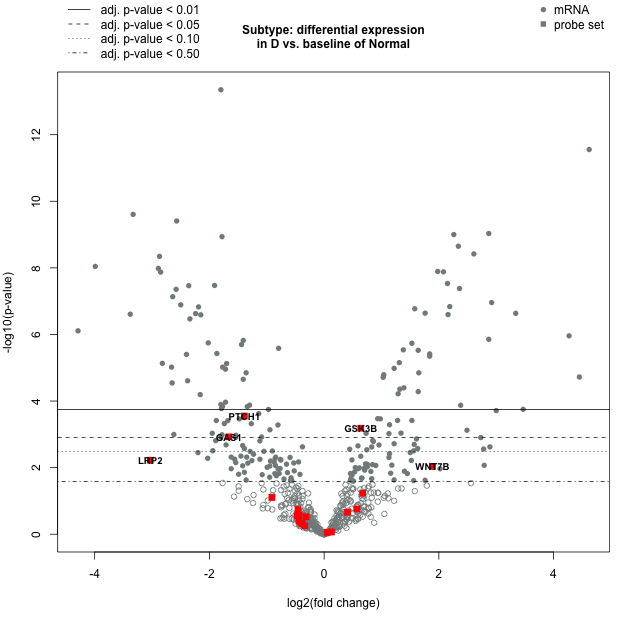
Volcano Plot: SubtypeD
Volcano plot displaying each gene's -log10(p-value) and log2 fold change for the selected covariate. Highly statistically significant genes fall at the top of the plot, and highly differentially expressed genes fall to either side. Genes within the selected gene set are highlighted in blue. Green point colors and horizontal lines indicate various False Discovery Rate (FDR) thresholds.
DE Results - HH genes - SubtypeD
More Plot Information Download CSV DataProbe Label Log2 fold change std error Lower confidence limit Upper confidence limit P-value BY.p.value Gene.sets Codeset.Name Probe.Label Analyte.Type Is.Control Control.Type Probe.Annotation KEGG.Pathways Cell.Type Official.Gene.Name volcanocol volcanopch tstats.all PTCH1-mRNA -1.39 0.358 -2.09 -0.692 0.000282 0.0142 Driver Gene, HH NS_CANCERPATH_C2535 PTCH1 mRNA 0 HH;Driver Gene hsa04024;hsa04340;hsa05200;hsa05205;hsa05217 PTCH1 chartreuse2 16 -3.88268156424581 GSK3B-mRNA 0.639 0.176 0.294 0.985 0.000654 0.0283 CC.PLS.Apop, HH, PI3K, Wnt NS_CANCERPATH_C2535 GSK3B mRNA 0 CC.PLS.Apop;PI3K;HH;Wnt hsa04012;hsa04062;hsa04110;hsa04151;hsa04310;hsa04340;hsa04360;hsa04390;hsa04510;hsa04550;hsa04660;hsa04662;hsa04722;hsa04728;hsa04910;hsa04916;hsa04917;hsa04919;hsa04931;hsa04932;hsa05010;hsa05160;hsa05162;hsa05164;hsa05166;hsa05169;hsa05200;hsa05210;hsa05213;hsa05215;hsa05217 GSK3B chartreuse2 16 3.63068181818182 GAS1-mRNA -1.66 0.484 -2.61 -0.712 0.00119 0.0464 HH NS_CANCERPATH_C2535 GAS1 mRNA 0 HH hsa04340 GAS1 chartreuse2 16 -3.4297520661157 LRP2-mRNA -3.03 1.06 -5.11 -0.959 0.00599 0.16 HH NS_CANCERPATH_C2535 LRP2 mRNA 0 HH hsa04340;hsa04918 LRP2 chartreuse4 16 -2.85849056603774 WNT7B-mRNA 1.89 0.697 0.52 3.25 0.00919 0.218 HH, Wnt NS_CANCERPATH_C2535 WNT7B mRNA 0 HH;Wnt hsa04310;hsa04340;hsa04390;hsa04550;hsa04916;hsa05166;hsa05200;hsa05205;hsa05217 WNT7B chartreuse4 16 2.7116212338594 WNT10A-mRNA 0.671 0.346 -0.00815 1.35 0.0583 0.92 HH, Wnt NS_CANCERPATH_C2535 WNT10A mRNA 0 HH;Wnt hsa04310;hsa04340;hsa04390;hsa04550;hsa04916;hsa05166;hsa05200;hsa05205;hsa05217 WNT10A azure4 1 1.9393063583815 BMP4-mRNA -0.91 0.508 -1.91 0.0851 0.0789 1 HH, TGF-B NS_CANCERPATH_C2535 BMP4 mRNA 0 TGF-B;HH hsa04340;hsa04350;hsa04390;hsa04550;hsa04919;hsa05200;hsa05217 BMP4 azure4 1 -1.79133858267717 WNT2-mRNA 0.571 0.416 -0.244 1.39 0.175 1 HH, Wnt NS_CANCERPATH_C2535 WNT2 mRNA 0 HH;Wnt hsa04310;hsa04340;hsa04390;hsa04550;hsa04916;hsa05166;hsa05200;hsa05205;hsa05217 WNT2 azure4 1 1.37259615384615 PRKACA-mRNA -0.455 0.337 -1.12 0.205 0.182 1 CC.PLS.Apop, HH, MAPK, RAS, Wnt NS_CANCERPATH_C2535 PRKACA mRNA 0 CC.PLS.Apop;RAS;MAPK;HH;Wnt hsa04010;hsa04014;hsa04020;hsa04024;hsa04062;hsa04114;hsa04210;hsa04211;hsa04261;hsa04270;hsa04310;hsa04340;hsa04540;hsa04611;hsa04713;hsa04720;hsa04723;hsa04724;hsa04725;hsa04726;hsa04727;hsa04728;hsa04740;hsa04750;hsa04910;hsa04911;hsa04912;hsa04913;hsa04914;hsa04915;hsa04916;hsa04918;hsa04919;hsa04921;hsa04922;hsa04923;hsa04924;hsa04925;hsa04961;hsa04962;hsa04970;hsa04971;hsa05012;hsa05020;hsa05030;hsa05031;hsa05032;hsa05034;hsa05110;hsa05146;hsa05166;hsa05169;hsa05200;hsa05203;hsa05205;hsa05414 PRKACA azure4 1 -1.35014836795252 PRKX-mRNA 0.407 0.327 -0.233 1.05 0.218 1 CC.PLS.Apop, HH, MAPK, RAS, Wnt NS_CANCERPATH_C2535 PRKX mRNA 0 CC.PLS.Apop;RAS;MAPK;HH;Wnt PRKX azure4 1 1.24464831804281 SMO-mRNA -0.434 0.386 -1.19 0.321 0.265 1 Driver Gene, HH NS_CANCERPATH_C2535 SMO mRNA 0 HH;Driver Gene hsa04340;hsa05200;hsa05205;hsa05217 SMO azure4 1 -1.12435233160622 GLI3-mRNA -0.47 0.434 -1.32 0.38 0.284 1 HH NS_CANCERPATH_C2535 GLI3 mRNA 0 HH hsa04024;hsa04340;hsa05200;hsa05217 GLI3 azure4 1 -1.08294930875576 WNT2B-mRNA -0.314 0.299 -0.901 0.273 0.3 1 HH, Wnt NS_CANCERPATH_C2535 WNT2B mRNA 0 HH;Wnt hsa04310;hsa04340;hsa04390;hsa04550;hsa04916;hsa05166;hsa05200;hsa05205;hsa05217 WNT2B azure4 1 -1.05016722408027 WNT5B-mRNA -0.44 0.523 -1.46 0.585 0.404 1 HH, Wnt NS_CANCERPATH_C2535 WNT5B mRNA 0 HH;Wnt hsa04310;hsa04340;hsa04390;hsa04550;hsa04916;hsa05166;hsa05200;hsa05205;hsa05217 WNT5B azure4 1 -0.841300191204589 WNT3-mRNA -0.396 0.546 -1.47 0.675 0.471 1 HH, Wnt NS_CANCERPATH_C2535 WNT3 mRNA 0 HH;Wnt hsa04310;hsa04340;hsa04390;hsa04550;hsa04916;hsa05166;hsa05200;hsa05205;hsa05206;hsa05217 WNT3 azure4 1 -0.725274725274725 PRKACB-mRNA -0.384 0.539 -1.44 0.672 0.48 1 CC.PLS.Apop, HH, MAPK, RAS, Wnt NS_CANCERPATH_C2535 PRKACB mRNA 0 CC.PLS.Apop;RAS;MAPK;HH;Wnt hsa04010;hsa04014;hsa04020;hsa04024;hsa04062;hsa04114;hsa04210;hsa04211;hsa04261;hsa04270;hsa04310;hsa04340;hsa04540;hsa04611;hsa04713;hsa04720;hsa04723;hsa04724;hsa04725;hsa04726;hsa04727;hsa04728;hsa04740;hsa04750;hsa04910;hsa04911;hsa04912;hsa04913;hsa04914;hsa04915;hsa04916;hsa04918;hsa04919;hsa04921;hsa04922;hsa04923;hsa04924;hsa04925;hsa04961;hsa04962;hsa04970;hsa04971;hsa05012;hsa05020;hsa05030;hsa05031;hsa05032;hsa05110;hsa05146;hsa05166;hsa05169;hsa05200;hsa05203;hsa05205;hsa05414 PRKACB azure4 1 -0.712430426716141 WNT4-mRNA -0.338 0.576 -1.47 0.791 0.56 1 HH, Wnt NS_CANCERPATH_C2535 WNT4 mRNA 0 HH;Wnt hsa04310;hsa04340;hsa04390;hsa04550;hsa04916;hsa04919;hsa05166;hsa05200;hsa05205;hsa05217 WNT4 azure4 1 -0.586805555555556 WNT5A-mRNA 0.127 0.684 -1.21 1.47 0.854 1 HH, Wnt NS_CANCERPATH_C2535 WNT5A mRNA 0 HH;Wnt hsa04310;hsa04340;hsa04390;hsa04550;hsa04916;hsa05166;hsa05200;hsa05205;hsa05217 WNT5A azure4 1 0.185672514619883 WNT6-mRNA 0.0556 0.365 -0.659 0.771 0.879 1 HH, Wnt NS_CANCERPATH_C2535 WNT6 mRNA 0 HH;Wnt hsa04310;hsa04340;hsa04390;hsa04550;hsa04916;hsa05166;hsa05200;hsa05205;hsa05217 WNT6 azure4 1 0.152328767123288 DE Results - HH genes - SubtypeD
Table displaying each sample's global significance scores and directed global significance scores as defined in the heatmaps above. The global significance score is calculated as the square root of the mean squared t-statistic for the genes in a gene set, with t-statistics coming from the linear regression underlying our differential expression analysis. The directed global significance score is calculated as the square root of the mean signed squared t-statistic for the genes in a gene set, with t-statistics coming from the linear regression underlying our differential expression analysis.
- Subtype:
- SubtypeA
- SubtypeB
- SubtypeC
- SubtypeD
Volcano Plot: SubtypeA
More Plot Information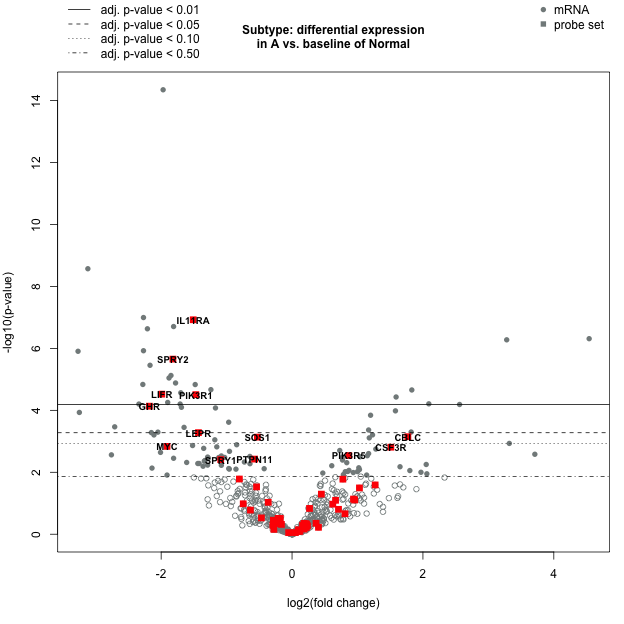
Volcano Plot: SubtypeA
Volcano plot displaying each gene's -log10(p-value) and log2 fold change for the selected covariate. Highly statistically significant genes fall at the top of the plot, and highly differentially expressed genes fall to either side. Genes within the selected gene set are highlighted in blue. Green point colors and horizontal lines indicate various False Discovery Rate (FDR) thresholds.
DE Results - JAK-STAT genes - SubtypeA
More Plot Information Download CSV DataProbe Label Log2 fold change std error Lower confidence limit Upper confidence limit P-value BY.p.value Gene.sets Codeset.Name Probe.Label Analyte.Type Is.Control Control.Type Probe.Annotation KEGG.Pathways Cell.Type Official.Gene.Name volcanocol volcanopch tstats.all IL11RA-mRNA -1.51 0.246 -1.99 -1.03 1.19e-07 0.000118 JAK-STAT NS_CANCERPATH_C2535 IL11RA mRNA 0 JAK-STAT hsa04060;hsa04630;hsa04640 IL11RA chartreuse1 16 -6.13821138211382 SPRY2-mRNA -1.82 0.342 -2.49 -1.15 2.22e-06 0.000804 JAK-STAT NS_CANCERPATH_C2535 SPRY2 mRNA 0 JAK-STAT hsa05206 SPRY2 chartreuse1 16 -5.32163742690058 LIFR-mRNA -1.99 0.434 -2.84 -1.14 3e-05 0.00562 JAK-STAT NS_CANCERPATH_C2535 LIFR mRNA 0 JAK-STAT hsa04060;hsa04550;hsa04630 LIFR chartreuse1 16 -4.5852534562212 PIK3R1-mRNA -1.47 0.322 -2.1 -0.838 3.11e-05 0.00562 CC.PLS.Apop, Driver Gene, JAK-STAT, PI3K, RAS NS_CANCERPATH_C2535 PIK3R1 mRNA 0 CC.PLS.Apop;RAS;PI3K;JAK-STAT;Driver Gene hsa04012;hsa04014;hsa04015;hsa04022;hsa04024;hsa04062;hsa04066;hsa04068;hsa04070;hsa04071;hsa04072;hsa04150;hsa04151;hsa04152;hsa04210;hsa04211;hsa04261;hsa04370;hsa04380;hsa04510;hsa04550;hsa04611;hsa04620;hsa04630;hsa04650;hsa04660;hsa04662;hsa04664;hsa04666;hsa04668;hsa04670;hsa04722;hsa04725;hsa04750;hsa04810;hsa04910;hsa04914;hsa04915;hsa04917;hsa04919;hsa04921;hsa04923;hsa04930;hsa04931;hsa04932;hsa04933;hsa04960;hsa04973;hsa05100;hsa05142;hsa05145;hsa05146;hsa05160;hsa05161;hsa05162;hsa05164;hsa05166;hsa05169;hsa05200;hsa05203;hsa05205;hsa05210;hsa05211;hsa05212;hsa05213;hsa05214;hsa05215;hsa05218;hsa05220;hsa05221;hsa05222;hsa05223;hsa05230;hsa05231 PIK3R1 chartreuse1 16 -4.56521739130435 GHR-mRNA -2.18 0.507 -3.18 -1.19 7.34e-05 0.0101 JAK-STAT, PI3K NS_CANCERPATH_C2535 GHR mRNA 0 PI3K;JAK-STAT hsa04060;hsa04080;hsa04151;hsa04630 GHR chartreuse2 16 -4.29980276134122 LEPR-mRNA -1.43 0.386 -2.18 -0.67 0.000525 0.0497 JAK-STAT NS_CANCERPATH_C2535 LEPR mRNA 0 JAK-STAT hsa04060;hsa04080;hsa04152;hsa04630;hsa04920;hsa04932 LEPR chartreuse3 16 -3.70466321243523 CBLC-mRNA 1.77 0.491 0.805 2.73 0.00071 0.0628 JAK-STAT NS_CANCERPATH_C2535 CBLC mRNA 0 JAK-STAT hsa04012;hsa04120;hsa04144;hsa04660;hsa04910;hsa05100;hsa05200;hsa05205;hsa05220 CBLC chartreuse3 16 3.60488798370672 SOS1-mRNA -0.53 0.148 -0.819 -0.241 0.000733 0.0634 JAK-STAT, MAPK, PI3K, RAS NS_CANCERPATH_C2535 SOS1 mRNA 0 RAS;PI3K;JAK-STAT;MAPK hsa04010;hsa04012;hsa04014;hsa04062;hsa04068;hsa04072;hsa04151;hsa04320;hsa04510;hsa04540;hsa04630;hsa04650;hsa04660;hsa04662;hsa04664;hsa04722;hsa04810;hsa04910;hsa04912;hsa04915;hsa04917;hsa05034;hsa05160;hsa05200;hsa05205;hsa05206;hsa05211;hsa05213;hsa05214;hsa05215;hsa05220;hsa05221;hsa05223;hsa05231 SOS1 chartreuse3 16 -3.58108108108108 MYC-mRNA -1.91 0.567 -3.02 -0.794 0.00146 0.112 CC.PLS.Apop, JAK-STAT, MAPK, PI3K, TGF-B, TXmisReg, Wnt NS_CANCERPATH_C2535 MYC mRNA 0 CC.PLS.Apop;PI3K;JAK-STAT;MAPK;TGF-B;TXmisReg;Wnt hsa04010;hsa04012;hsa04110;hsa04151;hsa04310;hsa04350;hsa04390;hsa04550;hsa04630;hsa04919;hsa05161;hsa05166;hsa05169;hsa05200;hsa05202;hsa05205;hsa05206;hsa05210;hsa05213;hsa05216;hsa05219;hsa05220;hsa05221;hsa05222;hsa05230 MYC chartreuse4 16 -3.36860670194004 CSF3R-mRNA 1.51 0.453 0.627 2.4 0.00155 0.114 JAK-STAT, PI3K NS_CANCERPATH_C2535 CSF3R mRNA 0 PI3K;JAK-STAT hsa04060;hsa04151;hsa04630;hsa04640;hsa05200 Neutrophils CSF3R chartreuse4 16 3.33333333333333 PIK3R5-mRNA 0.867 0.277 0.324 1.41 0.00288 0.181 CC.PLS.Apop, JAK-STAT, PI3K, RAS NS_CANCERPATH_C2535 PIK3R5 mRNA 0 CC.PLS.Apop;RAS;PI3K;JAK-STAT hsa04012;hsa04014;hsa04015;hsa04022;hsa04024;hsa04062;hsa04066;hsa04068;hsa04070;hsa04071;hsa04072;hsa04150;hsa04151;hsa04152;hsa04210;hsa04211;hsa04261;hsa04370;hsa04380;hsa04510;hsa04550;hsa04611;hsa04620;hsa04630;hsa04650;hsa04660;hsa04662;hsa04664;hsa04666;hsa04668;hsa04670;hsa04722;hsa04725;hsa04750;hsa04810;hsa04910;hsa04914;hsa04915;hsa04917;hsa04919;hsa04921;hsa04923;hsa04930;hsa04931;hsa04932;hsa04933;hsa04960;hsa04973;hsa05100;hsa05142;hsa05145;hsa05146;hsa05160;hsa05161;hsa05162;hsa05164;hsa05166;hsa05169;hsa05200;hsa05203;hsa05205;hsa05210;hsa05211;hsa05212;hsa05213;hsa05214;hsa05215;hsa05218;hsa05220;hsa05221;hsa05222;hsa05223;hsa05230;hsa05231 PIK3R5 chartreuse4 16 3.12996389891697 PTPN11-mRNA -0.572 0.189 -0.942 -0.203 0.00375 0.202 Driver Gene, JAK-STAT, RAS NS_CANCERPATH_C2535 PTPN11 mRNA 0 RAS;JAK-STAT;Driver Gene hsa04014;hsa04072;hsa04630;hsa04650;hsa04670;hsa04722;hsa04920;hsa04931;hsa05120;hsa05168;hsa05205;hsa05211;hsa05220 PTPN11 chartreuse4 16 -3.02645502645503 SPRY1-mRNA -1.09 0.361 -1.8 -0.383 0.00391 0.207 JAK-STAT NS_CANCERPATH_C2535 SPRY1 mRNA 0 JAK-STAT SPRY1 chartreuse4 16 -3.01939058171745 CCND2-mRNA -0.805 0.325 -1.44 -0.168 0.0165 0.557 CC.PLS.Apop, JAK-STAT, PI3K, TXmisReg, Wnt NS_CANCERPATH_C2535 CCND2 mRNA 0 CC.PLS.Apop;PI3K;JAK-STAT;TXmisReg;Wnt hsa04068;hsa04110;hsa04115;hsa04151;hsa04310;hsa04390;hsa04510;hsa04630;hsa04917;hsa05162;hsa05166;hsa05202;hsa05203;hsa05206 CCND2 azure4 1 -2.47692307692308 AKT1-mRNA 0.777 0.314 0.161 1.39 0.0167 0.559 CC.PLS.Apop, Driver Gene, JAK-STAT, MAPK, PI3K, RAS NS_CANCERPATH_C2535 AKT1 mRNA 0 CC.PLS.Apop;RAS;PI3K;JAK-STAT;MAPK;Driver Gene hsa04010;hsa04012;hsa04014;hsa04015;hsa04022;hsa04024;hsa04062;hsa04066;hsa04068;hsa04071;hsa04072;hsa04150;hsa04151;hsa04152;hsa04210;hsa04211;hsa04261;hsa04370;hsa04380;hsa04510;hsa04530;hsa04550;hsa04611;hsa04620;hsa04630;hsa04660;hsa04662;hsa04664;hsa04666;hsa04668;hsa04722;hsa04725;hsa04728;hsa04910;hsa04914;hsa04915;hsa04917;hsa04919;hsa04920;hsa04922;hsa04923;hsa04931;hsa04932;hsa04933;hsa04973;hsa05142;hsa05145;hsa05152;hsa05160;hsa05161;hsa05162;hsa05164;hsa05166;hsa05169;hsa05200;hsa05205;hsa05210;hsa05211;hsa05212;hsa05213;hsa05214;hsa05215;hsa05218;hsa05220;hsa05221;hsa05222;hsa05223;hsa05230;hsa05231 AKT1 azure4 1 2.47452229299363 IL7R-mRNA 1.27 0.553 0.187 2.35 0.0256 0.744 JAK-STAT, PI3K NS_CANCERPATH_C2535 IL7R mRNA 0 PI3K;JAK-STAT hsa04060;hsa04068;hsa04151;hsa04630;hsa04640;hsa05340 IL7R azure4 1 2.29656419529837 PIK3CA-mRNA -0.542 0.242 -1.02 -0.0671 0.0296 0.807 CC.PLS.Apop, Driver Gene, JAK-STAT, PI3K, RAS NS_CANCERPATH_C2535 PIK3CA mRNA 0 CC.PLS.Apop;RAS;PI3K;JAK-STAT;Driver Gene hsa00562;hsa04012;hsa04014;hsa04015;hsa04022;hsa04024;hsa04062;hsa04066;hsa04068;hsa04070;hsa04071;hsa04072;hsa04150;hsa04151;hsa04152;hsa04210;hsa04211;hsa04261;hsa04370;hsa04380;hsa04510;hsa04550;hsa04611;hsa04620;hsa04630;hsa04650;hsa04660;hsa04662;hsa04664;hsa04666;hsa04668;hsa04670;hsa04722;hsa04725;hsa04750;hsa04810;hsa04910;hsa04914;hsa04915;hsa04917;hsa04919;hsa04921;hsa04923;hsa04930;hsa04931;hsa04932;hsa04933;hsa04960;hsa04973;hsa05100;hsa05142;hsa05145;hsa05146;hsa05160;hsa05161;hsa05162;hsa05164;hsa05166;hsa05169;hsa05200;hsa05203;hsa05205;hsa05206;hsa05210;hsa05211;hsa05212;hsa05213;hsa05214;hsa05215;hsa05218;hsa05220;hsa05221;hsa05222;hsa05223;hsa05230;hsa05231 PIK3CA azure4 1 -2.2396694214876 PRLR-mRNA 1.03 0.47 0.114 1.96 0.032 0.855 JAK-STAT, PI3K NS_CANCERPATH_C2535 PRLR mRNA 0 PI3K;JAK-STAT hsa04060;hsa04080;hsa04151;hsa04630;hsa04917 PRLR azure4 1 2.19148936170213 STAT3-mRNA 0.448 0.224 0.00905 0.886 0.0507 1 JAK-STAT NS_CANCERPATH_C2535 STAT3 mRNA 0 JAK-STAT hsa04062;hsa04066;hsa04068;hsa04550;hsa04630;hsa04917;hsa04920;hsa04931;hsa04933;hsa05145;hsa05160;hsa05161;hsa05162;hsa05169;hsa05200;hsa05203;hsa05205;hsa05206;hsa05212;hsa05221;hsa05321 STAT3 azure4 1 2 STAT1-mRNA 0.939 0.513 -0.0673 1.94 0.0732 1 JAK-STAT NS_CANCERPATH_C2535 STAT1 mRNA 0 JAK-STAT hsa04062;hsa04380;hsa04620;hsa04630;hsa04917;hsa04919;hsa04933;hsa05140;hsa05145;hsa05152;hsa05160;hsa05161;hsa05162;hsa05164;hsa05168;hsa05200;hsa05212;hsa05321 STAT1 azure4 1 1.83040935672515 DE Results - JAK-STAT genes - SubtypeA
Table displaying each sample's global significance scores and directed global significance scores as defined in the heatmaps above. The global significance score is calculated as the square root of the mean squared t-statistic for the genes in a gene set, with t-statistics coming from the linear regression underlying our differential expression analysis. The directed global significance score is calculated as the square root of the mean signed squared t-statistic for the genes in a gene set, with t-statistics coming from the linear regression underlying our differential expression analysis.
Volcano Plot: SubtypeB
More Plot Information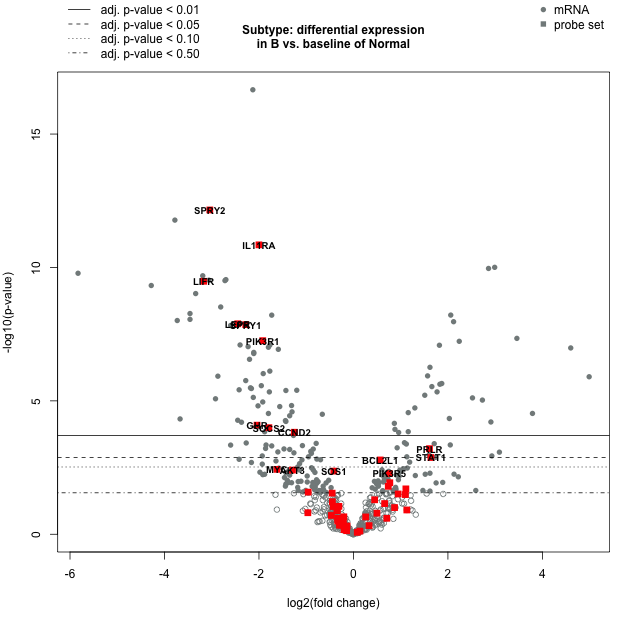
Volcano Plot: SubtypeB
Volcano plot displaying each gene's -log10(p-value) and log2 fold change for the selected covariate. Highly statistically significant genes fall at the top of the plot, and highly differentially expressed genes fall to either side. Genes within the selected gene set are highlighted in blue. Green point colors and horizontal lines indicate various False Discovery Rate (FDR) thresholds.
DE Results - JAK-STAT genes - SubtypeB
More Plot Information Download CSV DataProbe Label Log2 fold change std error Lower confidence limit Upper confidence limit P-value BY.p.value Gene.sets Codeset.Name Probe.Label Analyte.Type Is.Control Control.Type Probe.Annotation KEGG.Pathways Cell.Type Official.Gene.Name volcanocol volcanopch tstats.all SPRY2-mRNA -3.04 0.322 -3.67 -2.41 6.99e-13 1.39e-09 JAK-STAT NS_CANCERPATH_C2535 SPRY2 mRNA 0 JAK-STAT hsa05206 SPRY2 chartreuse1 16 -9.44099378881988 IL11RA-mRNA -2 0.232 -2.45 -1.54 1.42e-11 1.41e-08 JAK-STAT NS_CANCERPATH_C2535 IL11RA mRNA 0 JAK-STAT hsa04060;hsa04630;hsa04640 IL11RA chartreuse1 16 -8.62068965517241 LIFR-mRNA -3.17 0.409 -3.97 -2.37 3.3e-10 1.01e-07 JAK-STAT NS_CANCERPATH_C2535 LIFR mRNA 0 JAK-STAT hsa04060;hsa04550;hsa04630 LIFR chartreuse1 16 -7.75061124694377 LEPR-mRNA -2.45 0.363 -3.16 -1.74 1.29e-08 2.23e-06 JAK-STAT NS_CANCERPATH_C2535 LEPR mRNA 0 JAK-STAT hsa04060;hsa04080;hsa04152;hsa04630;hsa04920;hsa04932 LEPR chartreuse1 16 -6.74931129476584 SPRY1-mRNA -2.28 0.34 -2.95 -1.62 1.39e-08 2.31e-06 JAK-STAT NS_CANCERPATH_C2535 SPRY1 mRNA 0 JAK-STAT SPRY1 chartreuse1 16 -6.70588235294118 PIK3R1-mRNA -1.92 0.303 -2.52 -1.33 5.54e-08 8.16e-06 CC.PLS.Apop, Driver Gene, JAK-STAT, PI3K, RAS NS_CANCERPATH_C2535 PIK3R1 mRNA 0 CC.PLS.Apop;RAS;PI3K;JAK-STAT;Driver Gene hsa04012;hsa04014;hsa04015;hsa04022;hsa04024;hsa04062;hsa04066;hsa04068;hsa04070;hsa04071;hsa04072;hsa04150;hsa04151;hsa04152;hsa04210;hsa04211;hsa04261;hsa04370;hsa04380;hsa04510;hsa04550;hsa04611;hsa04620;hsa04630;hsa04650;hsa04660;hsa04662;hsa04664;hsa04666;hsa04668;hsa04670;hsa04722;hsa04725;hsa04750;hsa04810;hsa04910;hsa04914;hsa04915;hsa04917;hsa04919;hsa04921;hsa04923;hsa04930;hsa04931;hsa04932;hsa04933;hsa04960;hsa04973;hsa05100;hsa05142;hsa05145;hsa05146;hsa05160;hsa05161;hsa05162;hsa05164;hsa05166;hsa05169;hsa05200;hsa05203;hsa05205;hsa05210;hsa05211;hsa05212;hsa05213;hsa05214;hsa05215;hsa05218;hsa05220;hsa05221;hsa05222;hsa05223;hsa05230;hsa05231 PIK3R1 chartreuse1 16 -6.33663366336634 GHR-mRNA -2.04 0.478 -2.98 -1.11 8.15e-05 0.004 JAK-STAT, PI3K NS_CANCERPATH_C2535 GHR mRNA 0 PI3K;JAK-STAT hsa04060;hsa04080;hsa04151;hsa04630 GHR chartreuse1 16 -4.26778242677824 SOCS2-mRNA -1.79 0.425 -2.62 -0.957 0.000101 0.00488 JAK-STAT NS_CANCERPATH_C2535 SOCS2 mRNA 0 JAK-STAT hsa04630;hsa04910;hsa04917;hsa04930 SOCS2 chartreuse1 16 -4.21176470588235 CCND2-mRNA -1.25 0.306 -1.85 -0.652 0.00015 0.00694 CC.PLS.Apop, JAK-STAT, PI3K, TXmisReg, Wnt NS_CANCERPATH_C2535 CCND2 mRNA 0 CC.PLS.Apop;PI3K;JAK-STAT;TXmisReg;Wnt hsa04068;hsa04110;hsa04115;hsa04151;hsa04310;hsa04390;hsa04510;hsa04630;hsa04917;hsa05162;hsa05166;hsa05202;hsa05203;hsa05206 CCND2 chartreuse1 16 -4.08496732026144 PRLR-mRNA 1.61 0.443 0.745 2.48 0.000619 0.0244 JAK-STAT, PI3K NS_CANCERPATH_C2535 PRLR mRNA 0 PI3K;JAK-STAT hsa04060;hsa04080;hsa04151;hsa04630;hsa04917 PRLR chartreuse2 16 3.63431151241535 STAT1-mRNA 1.64 0.484 0.692 2.59 0.00133 0.0457 JAK-STAT NS_CANCERPATH_C2535 STAT1 mRNA 0 JAK-STAT hsa04062;hsa04380;hsa04620;hsa04630;hsa04917;hsa04919;hsa04933;hsa05140;hsa05145;hsa05152;hsa05160;hsa05161;hsa05162;hsa05164;hsa05168;hsa05200;hsa05212;hsa05321 STAT1 chartreuse3 16 3.38842975206612 BCL2L1-mRNA 0.567 0.171 0.233 0.902 0.00164 0.0539 CC.PLS.Apop, JAK-STAT, PI3K, RAS, TXmisReg NS_CANCERPATH_C2535 BCL2L1 mRNA 0 CC.PLS.Apop;RAS;PI3K;JAK-STAT;TXmisReg hsa04014;hsa04064;hsa04151;hsa04210;hsa04630;hsa05014;hsa05145;hsa05166;hsa05200;hsa05202;hsa05212;hsa05220;hsa05222 BCL2L1 chartreuse3 16 3.31578947368421 MYC-mRNA -1.62 0.534 -2.67 -0.577 0.00369 0.111 CC.PLS.Apop, JAK-STAT, MAPK, PI3K, TGF-B, TXmisReg, Wnt NS_CANCERPATH_C2535 MYC mRNA 0 CC.PLS.Apop;PI3K;JAK-STAT;MAPK;TGF-B;TXmisReg;Wnt hsa04010;hsa04012;hsa04110;hsa04151;hsa04310;hsa04350;hsa04390;hsa04550;hsa04630;hsa04919;hsa05161;hsa05166;hsa05169;hsa05200;hsa05202;hsa05205;hsa05206;hsa05210;hsa05213;hsa05216;hsa05219;hsa05220;hsa05221;hsa05222;hsa05230 MYC chartreuse4 16 -3.03370786516854 AKT3-mRNA -1.29 0.426 -2.12 -0.451 0.00393 0.114 CC.PLS.Apop, JAK-STAT, MAPK, PI3K, RAS NS_CANCERPATH_C2535 AKT3 mRNA 0 CC.PLS.Apop;RAS;PI3K;JAK-STAT;MAPK hsa04010;hsa04012;hsa04014;hsa04015;hsa04022;hsa04024;hsa04062;hsa04066;hsa04068;hsa04071;hsa04072;hsa04150;hsa04151;hsa04152;hsa04210;hsa04211;hsa04261;hsa04370;hsa04380;hsa04510;hsa04530;hsa04550;hsa04611;hsa04620;hsa04630;hsa04660;hsa04662;hsa04664;hsa04666;hsa04668;hsa04722;hsa04725;hsa04728;hsa04910;hsa04914;hsa04915;hsa04917;hsa04919;hsa04920;hsa04922;hsa04923;hsa04931;hsa04932;hsa04933;hsa04973;hsa05142;hsa05145;hsa05152;hsa05160;hsa05161;hsa05162;hsa05164;hsa05166;hsa05169;hsa05200;hsa05205;hsa05210;hsa05211;hsa05212;hsa05213;hsa05214;hsa05215;hsa05218;hsa05220;hsa05221;hsa05222;hsa05223;hsa05230;hsa05231 AKT3 chartreuse4 16 -3.02816901408451 SOS1-mRNA -0.415 0.139 -0.688 -0.143 0.00429 0.124 JAK-STAT, MAPK, PI3K, RAS NS_CANCERPATH_C2535 SOS1 mRNA 0 RAS;PI3K;JAK-STAT;MAPK hsa04010;hsa04012;hsa04014;hsa04062;hsa04068;hsa04072;hsa04151;hsa04320;hsa04510;hsa04540;hsa04630;hsa04650;hsa04660;hsa04662;hsa04664;hsa04722;hsa04810;hsa04910;hsa04912;hsa04915;hsa04917;hsa05034;hsa05160;hsa05200;hsa05205;hsa05206;hsa05211;hsa05213;hsa05214;hsa05215;hsa05220;hsa05221;hsa05223;hsa05231 SOS1 chartreuse4 16 -2.98561151079137 PIK3R5-mRNA 0.76 0.261 0.248 1.27 0.0053 0.143 CC.PLS.Apop, JAK-STAT, PI3K, RAS NS_CANCERPATH_C2535 PIK3R5 mRNA 0 CC.PLS.Apop;RAS;PI3K;JAK-STAT hsa04012;hsa04014;hsa04015;hsa04022;hsa04024;hsa04062;hsa04066;hsa04068;hsa04070;hsa04071;hsa04072;hsa04150;hsa04151;hsa04152;hsa04210;hsa04211;hsa04261;hsa04370;hsa04380;hsa04510;hsa04550;hsa04611;hsa04620;hsa04630;hsa04650;hsa04660;hsa04662;hsa04664;hsa04666;hsa04668;hsa04670;hsa04722;hsa04725;hsa04750;hsa04810;hsa04910;hsa04914;hsa04915;hsa04917;hsa04919;hsa04921;hsa04923;hsa04930;hsa04931;hsa04932;hsa04933;hsa04960;hsa04973;hsa05100;hsa05142;hsa05145;hsa05146;hsa05160;hsa05161;hsa05162;hsa05164;hsa05166;hsa05169;hsa05200;hsa05203;hsa05205;hsa05210;hsa05211;hsa05212;hsa05213;hsa05214;hsa05215;hsa05218;hsa05220;hsa05221;hsa05222;hsa05223;hsa05230;hsa05231 PIK3R5 chartreuse4 16 2.91187739463602 GRB2-mRNA 0.77 0.295 0.193 1.35 0.0117 0.256 JAK-STAT, MAPK, PI3K, RAS NS_CANCERPATH_C2535 GRB2 mRNA 0 RAS;PI3K;JAK-STAT;MAPK hsa04010;hsa04012;hsa04014;hsa04062;hsa04068;hsa04072;hsa04151;hsa04320;hsa04380;hsa04510;hsa04540;hsa04550;hsa04630;hsa04650;hsa04660;hsa04662;hsa04664;hsa04722;hsa04910;hsa04912;hsa04915;hsa04917;hsa05034;hsa05160;hsa05161;hsa05200;hsa05203;hsa05205;hsa05206;hsa05211;hsa05213;hsa05214;hsa05215;hsa05220;hsa05221;hsa05223;hsa05231 GRB2 chartreuse4 16 2.61016949152542 AKT1-mRNA 0.737 0.296 0.157 1.32 0.016 0.329 CC.PLS.Apop, Driver Gene, JAK-STAT, MAPK, PI3K, RAS NS_CANCERPATH_C2535 AKT1 mRNA 0 CC.PLS.Apop;RAS;PI3K;JAK-STAT;MAPK;Driver Gene hsa04010;hsa04012;hsa04014;hsa04015;hsa04022;hsa04024;hsa04062;hsa04066;hsa04068;hsa04071;hsa04072;hsa04150;hsa04151;hsa04152;hsa04210;hsa04211;hsa04261;hsa04370;hsa04380;hsa04510;hsa04530;hsa04550;hsa04611;hsa04620;hsa04630;hsa04660;hsa04662;hsa04664;hsa04666;hsa04668;hsa04722;hsa04725;hsa04728;hsa04910;hsa04914;hsa04915;hsa04917;hsa04919;hsa04920;hsa04922;hsa04923;hsa04931;hsa04932;hsa04933;hsa04973;hsa05142;hsa05145;hsa05152;hsa05160;hsa05161;hsa05162;hsa05164;hsa05166;hsa05169;hsa05200;hsa05205;hsa05210;hsa05211;hsa05212;hsa05213;hsa05214;hsa05215;hsa05218;hsa05220;hsa05221;hsa05222;hsa05223;hsa05230;hsa05231 AKT1 chartreuse4 16 2.48986486486486 CBLC-mRNA 1.11 0.463 0.205 2.02 0.0199 0.392 JAK-STAT NS_CANCERPATH_C2535 CBLC mRNA 0 JAK-STAT hsa04012;hsa04120;hsa04144;hsa04660;hsa04910;hsa05100;hsa05200;hsa05205;hsa05220 CBLC chartreuse4 16 2.39740820734341 SOCS3-mRNA -0.958 0.419 -1.78 -0.137 0.0263 0.474 JAK-STAT NS_CANCERPATH_C2535 SOCS3 mRNA 0 JAK-STAT hsa04120;hsa04380;hsa04630;hsa04668;hsa04910;hsa04917;hsa04920;hsa04930;hsa04931;hsa04932;hsa05160;hsa05164;hsa05168 SOCS3 chartreuse4 16 -2.28639618138425 DE Results - JAK-STAT genes - SubtypeB
Table displaying each sample's global significance scores and directed global significance scores as defined in the heatmaps above. The global significance score is calculated as the square root of the mean squared t-statistic for the genes in a gene set, with t-statistics coming from the linear regression underlying our differential expression analysis. The directed global significance score is calculated as the square root of the mean signed squared t-statistic for the genes in a gene set, with t-statistics coming from the linear regression underlying our differential expression analysis.
Volcano Plot: SubtypeC
More Plot Information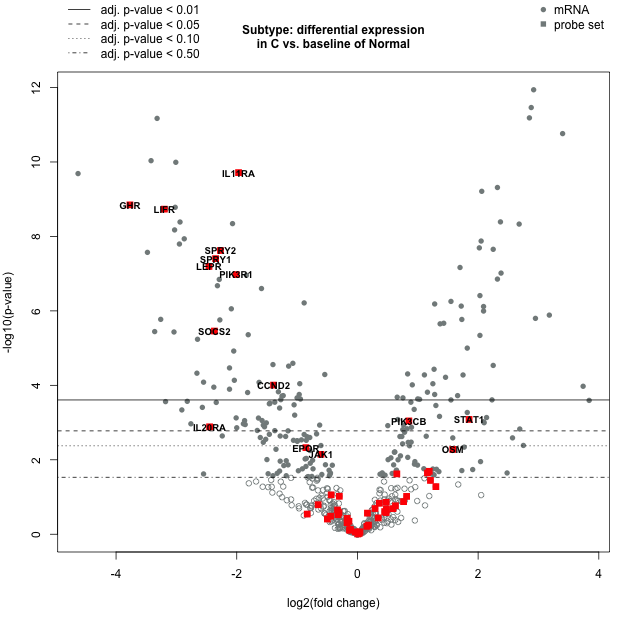
Volcano Plot: SubtypeC
Volcano plot displaying each gene's -log10(p-value) and log2 fold change for the selected covariate. Highly statistically significant genes fall at the top of the plot, and highly differentially expressed genes fall to either side. Genes within the selected gene set are highlighted in blue. Green point colors and horizontal lines indicate various False Discovery Rate (FDR) thresholds.
DE Results - JAK-STAT genes - SubtypeC
More Plot Information Download CSV DataProbe Label Log2 fold change std error Lower confidence limit Upper confidence limit P-value BY.p.value Gene.sets Codeset.Name Probe.Label Analyte.Type Is.Control Control.Type Probe.Annotation KEGG.Pathways Cell.Type Official.Gene.Name volcanocol volcanopch tstats.all IL11RA-mRNA -1.97 0.25 -2.46 -1.48 1.93e-10 9.06e-08 JAK-STAT NS_CANCERPATH_C2535 IL11RA mRNA 0 JAK-STAT hsa04060;hsa04630;hsa04640 IL11RA chartreuse1 16 -7.88 GHR-mRNA -3.77 0.514 -4.78 -2.76 1.42e-09 4.69e-07 JAK-STAT, PI3K NS_CANCERPATH_C2535 GHR mRNA 0 PI3K;JAK-STAT hsa04060;hsa04080;hsa04151;hsa04630 GHR chartreuse1 16 -7.33463035019455 LIFR-mRNA -3.2 0.44 -4.06 -2.34 1.85e-09 4.92e-07 JAK-STAT NS_CANCERPATH_C2535 LIFR mRNA 0 JAK-STAT hsa04060;hsa04550;hsa04630 LIFR chartreuse1 16 -7.27272727272727 SPRY2-mRNA -2.27 0.346 -2.95 -1.6 2.39e-08 3.65e-06 JAK-STAT NS_CANCERPATH_C2535 SPRY2 mRNA 0 JAK-STAT hsa05206 SPRY2 chartreuse1 16 -6.5606936416185 SPRY1-mRNA -2.35 0.366 -3.07 -1.64 3.95e-08 5.61e-06 JAK-STAT NS_CANCERPATH_C2535 SPRY1 mRNA 0 JAK-STAT SPRY1 chartreuse1 16 -6.42076502732241 LEPR-mRNA -2.46 0.391 -3.23 -1.7 6.4e-08 8.78e-06 JAK-STAT NS_CANCERPATH_C2535 LEPR mRNA 0 JAK-STAT hsa04060;hsa04080;hsa04152;hsa04630;hsa04920;hsa04932 LEPR chartreuse1 16 -6.29156010230179 PIK3R1-mRNA -2.01 0.326 -2.65 -1.37 1.06e-07 1.31e-05 CC.PLS.Apop, Driver Gene, JAK-STAT, PI3K, RAS NS_CANCERPATH_C2535 PIK3R1 mRNA 0 CC.PLS.Apop;RAS;PI3K;JAK-STAT;Driver Gene hsa04012;hsa04014;hsa04015;hsa04022;hsa04024;hsa04062;hsa04066;hsa04068;hsa04070;hsa04071;hsa04072;hsa04150;hsa04151;hsa04152;hsa04210;hsa04211;hsa04261;hsa04370;hsa04380;hsa04510;hsa04550;hsa04611;hsa04620;hsa04630;hsa04650;hsa04660;hsa04662;hsa04664;hsa04666;hsa04668;hsa04670;hsa04722;hsa04725;hsa04750;hsa04810;hsa04910;hsa04914;hsa04915;hsa04917;hsa04919;hsa04921;hsa04923;hsa04930;hsa04931;hsa04932;hsa04933;hsa04960;hsa04973;hsa05100;hsa05142;hsa05145;hsa05146;hsa05160;hsa05161;hsa05162;hsa05164;hsa05166;hsa05169;hsa05200;hsa05203;hsa05205;hsa05210;hsa05211;hsa05212;hsa05213;hsa05214;hsa05215;hsa05218;hsa05220;hsa05221;hsa05222;hsa05223;hsa05230;hsa05231 PIK3R1 chartreuse1 16 -6.16564417177914 SOCS2-mRNA -2.37 0.457 -3.27 -1.48 3.48e-06 0.000261 JAK-STAT NS_CANCERPATH_C2535 SOCS2 mRNA 0 JAK-STAT hsa04630;hsa04910;hsa04917;hsa04930 SOCS2 chartreuse1 16 -5.18599562363238 CCND2-mRNA -1.39 0.329 -2.03 -0.744 9.86e-05 0.00497 CC.PLS.Apop, JAK-STAT, PI3K, TXmisReg, Wnt NS_CANCERPATH_C2535 CCND2 mRNA 0 CC.PLS.Apop;PI3K;JAK-STAT;TXmisReg;Wnt hsa04068;hsa04110;hsa04115;hsa04151;hsa04310;hsa04390;hsa04510;hsa04630;hsa04917;hsa05162;hsa05166;hsa05202;hsa05203;hsa05206 CCND2 chartreuse1 16 -4.22492401215805 STAT1-mRNA 1.85 0.52 0.827 2.87 0.000824 0.0272 JAK-STAT NS_CANCERPATH_C2535 STAT1 mRNA 0 JAK-STAT hsa04062;hsa04380;hsa04620;hsa04630;hsa04917;hsa04919;hsa04933;hsa05140;hsa05145;hsa05152;hsa05160;hsa05161;hsa05162;hsa05164;hsa05168;hsa05200;hsa05212;hsa05321 STAT1 chartreuse2 16 3.55769230769231 PIK3CB-mRNA 0.852 0.242 0.378 1.33 0.000903 0.029 CC.PLS.Apop, JAK-STAT, PI3K, RAS NS_CANCERPATH_C2535 PIK3CB mRNA 0 CC.PLS.Apop;RAS;PI3K;JAK-STAT hsa00562;hsa04012;hsa04014;hsa04015;hsa04022;hsa04024;hsa04062;hsa04066;hsa04068;hsa04070;hsa04071;hsa04072;hsa04150;hsa04151;hsa04152;hsa04210;hsa04211;hsa04261;hsa04370;hsa04380;hsa04510;hsa04550;hsa04611;hsa04620;hsa04630;hsa04650;hsa04660;hsa04662;hsa04664;hsa04666;hsa04668;hsa04670;hsa04722;hsa04725;hsa04750;hsa04810;hsa04910;hsa04914;hsa04915;hsa04917;hsa04919;hsa04921;hsa04923;hsa04930;hsa04931;hsa04932;hsa04933;hsa04960;hsa04973;hsa05100;hsa05142;hsa05145;hsa05146;hsa05160;hsa05161;hsa05162;hsa05164;hsa05166;hsa05169;hsa05200;hsa05203;hsa05205;hsa05210;hsa05211;hsa05212;hsa05213;hsa05214;hsa05215;hsa05218;hsa05220;hsa05221;hsa05222;hsa05223;hsa05230;hsa05231 PIK3CB chartreuse2 16 3.52066115702479 IL20RA-mRNA -2.45 0.721 -3.87 -1.04 0.0013 0.0381 JAK-STAT NS_CANCERPATH_C2535 IL20RA mRNA 0 JAK-STAT hsa04060;hsa04630 IL20RA chartreuse2 16 -3.39805825242718 EPOR-mRNA -0.854 0.289 -1.42 -0.287 0.00472 0.108 JAK-STAT, PI3K NS_CANCERPATH_C2535 EPOR mRNA 0 PI3K;JAK-STAT hsa04060;hsa04151;hsa04630;hsa04640 EPOR chartreuse4 16 -2.95501730103806 OSM-mRNA 1.58 0.541 0.515 2.64 0.00527 0.119 JAK-STAT, PI3K NS_CANCERPATH_C2535 OSM mRNA 0 PI3K;JAK-STAT hsa04060;hsa04151;hsa04630 OSM chartreuse4 16 2.92051756007394 JAK1-mRNA -0.604 0.216 -1.03 -0.181 0.00715 0.158 Driver Gene, JAK-STAT, PI3K NS_CANCERPATH_C2535 JAK1 mRNA 0 PI3K;JAK-STAT;Driver Gene hsa04151;hsa04380;hsa04550;hsa04630;hsa05140;hsa05145;hsa05152;hsa05160;hsa05161;hsa05162;hsa05164;hsa05166;hsa05168;hsa05169;hsa05200;hsa05203;hsa05212 JAK1 chartreuse4 16 -2.7962962962963 CBLC-mRNA 1.19 0.498 0.215 2.17 0.0204 0.377 JAK-STAT NS_CANCERPATH_C2535 CBLC mRNA 0 JAK-STAT hsa04012;hsa04120;hsa04144;hsa04660;hsa04910;hsa05100;hsa05200;hsa05205;hsa05220 CBLC chartreuse4 16 2.38955823293173 IL2RA-mRNA 1.16 0.494 0.193 2.13 0.0226 0.409 JAK-STAT, PI3K NS_CANCERPATH_C2535 IL2RA mRNA 0 PI3K;JAK-STAT hsa04060;hsa04144;hsa04151;hsa04630;hsa04640;hsa05162;hsa05166 IL2RA chartreuse4 16 2.34817813765182 PIK3R5-mRNA 0.653 0.281 0.103 1.2 0.0239 0.424 CC.PLS.Apop, JAK-STAT, PI3K, RAS NS_CANCERPATH_C2535 PIK3R5 mRNA 0 CC.PLS.Apop;RAS;PI3K;JAK-STAT hsa04012;hsa04014;hsa04015;hsa04022;hsa04024;hsa04062;hsa04066;hsa04068;hsa04070;hsa04071;hsa04072;hsa04150;hsa04151;hsa04152;hsa04210;hsa04211;hsa04261;hsa04370;hsa04380;hsa04510;hsa04550;hsa04611;hsa04620;hsa04630;hsa04650;hsa04660;hsa04662;hsa04664;hsa04666;hsa04668;hsa04670;hsa04722;hsa04725;hsa04750;hsa04810;hsa04910;hsa04914;hsa04915;hsa04917;hsa04919;hsa04921;hsa04923;hsa04930;hsa04931;hsa04932;hsa04933;hsa04960;hsa04973;hsa05100;hsa05142;hsa05145;hsa05146;hsa05160;hsa05161;hsa05162;hsa05164;hsa05166;hsa05169;hsa05200;hsa05203;hsa05205;hsa05210;hsa05211;hsa05212;hsa05213;hsa05214;hsa05215;hsa05218;hsa05220;hsa05221;hsa05222;hsa05223;hsa05230;hsa05231 PIK3R5 chartreuse4 16 2.32384341637011 IL7R-mRNA 1.21 0.56 0.109 2.3 0.0358 0.577 JAK-STAT, PI3K NS_CANCERPATH_C2535 IL7R mRNA 0 PI3K;JAK-STAT hsa04060;hsa04068;hsa04151;hsa04630;hsa04640;hsa05340 IL7R azure4 1 2.16071428571429 IL2RB-mRNA 1.3 0.657 0.0152 2.59 0.0526 0.818 JAK-STAT, PI3K, TXmisReg NS_CANCERPATH_C2535 IL2RB mRNA 0 PI3K;JAK-STAT;TXmisReg hsa04060;hsa04144;hsa04151;hsa04630;hsa05162;hsa05166;hsa05202 IL2RB azure4 1 1.97869101978691 DE Results - JAK-STAT genes - SubtypeC
Table displaying each sample's global significance scores and directed global significance scores as defined in the heatmaps above. The global significance score is calculated as the square root of the mean squared t-statistic for the genes in a gene set, with t-statistics coming from the linear regression underlying our differential expression analysis. The directed global significance score is calculated as the square root of the mean signed squared t-statistic for the genes in a gene set, with t-statistics coming from the linear regression underlying our differential expression analysis.
Volcano Plot: SubtypeD
More Plot Information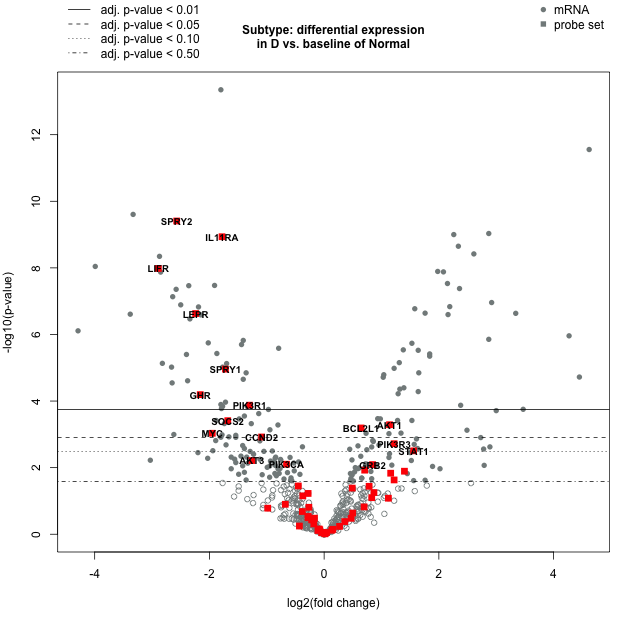
Volcano Plot: SubtypeD
Volcano plot displaying each gene's -log10(p-value) and log2 fold change for the selected covariate. Highly statistically significant genes fall at the top of the plot, and highly differentially expressed genes fall to either side. Genes within the selected gene set are highlighted in blue. Green point colors and horizontal lines indicate various False Discovery Rate (FDR) thresholds.
DE Results - JAK-STAT genes - SubtypeD
More Plot Information Download CSV DataProbe Label Log2 fold change std error Lower confidence limit Upper confidence limit P-value BY.p.value Gene.sets Codeset.Name Probe.Label Analyte.Type Is.Control Control.Type Probe.Annotation KEGG.Pathways Cell.Type Official.Gene.Name volcanocol volcanopch tstats.all SPRY2-mRNA -2.57 0.334 -3.23 -1.92 3.91e-10 3.89e-07 JAK-STAT NS_CANCERPATH_C2535 SPRY2 mRNA 0 JAK-STAT hsa05206 SPRY2 chartreuse1 16 -7.69461077844311 IL11RA-mRNA -1.78 0.241 -2.26 -1.31 1.16e-09 6.58e-07 JAK-STAT NS_CANCERPATH_C2535 IL11RA mRNA 0 JAK-STAT hsa04060;hsa04630;hsa04640 IL11RA chartreuse1 16 -7.38589211618257 LIFR-mRNA -2.89 0.425 -3.73 -2.06 1.04e-08 3.45e-06 JAK-STAT NS_CANCERPATH_C2535 LIFR mRNA 0 JAK-STAT hsa04060;hsa04550;hsa04630 LIFR chartreuse1 16 -6.8 LEPR-mRNA -2.24 0.378 -2.98 -1.5 2.36e-07 3.21e-05 JAK-STAT NS_CANCERPATH_C2535 LEPR mRNA 0 JAK-STAT hsa04060;hsa04080;hsa04152;hsa04630;hsa04920;hsa04932 LEPR chartreuse1 16 -5.92592592592593 SPRY1-mRNA -1.72 0.353 -2.41 -1.03 1.1e-05 0.000808 JAK-STAT NS_CANCERPATH_C2535 SPRY1 mRNA 0 JAK-STAT SPRY1 chartreuse1 16 -4.87252124645892 GHR-mRNA -2.16 0.497 -3.13 -1.19 6.41e-05 0.00381 JAK-STAT, PI3K NS_CANCERPATH_C2535 GHR mRNA 0 PI3K;JAK-STAT hsa04060;hsa04080;hsa04151;hsa04630 GHR chartreuse1 16 -4.34607645875252 PIK3R1-mRNA -1.3 0.315 -1.92 -0.683 0.000133 0.00749 CC.PLS.Apop, Driver Gene, JAK-STAT, PI3K, RAS NS_CANCERPATH_C2535 PIK3R1 mRNA 0 CC.PLS.Apop;RAS;PI3K;JAK-STAT;Driver Gene hsa04012;hsa04014;hsa04015;hsa04022;hsa04024;hsa04062;hsa04066;hsa04068;hsa04070;hsa04071;hsa04072;hsa04150;hsa04151;hsa04152;hsa04210;hsa04211;hsa04261;hsa04370;hsa04380;hsa04510;hsa04550;hsa04611;hsa04620;hsa04630;hsa04650;hsa04660;hsa04662;hsa04664;hsa04666;hsa04668;hsa04670;hsa04722;hsa04725;hsa04750;hsa04810;hsa04910;hsa04914;hsa04915;hsa04917;hsa04919;hsa04921;hsa04923;hsa04930;hsa04931;hsa04932;hsa04933;hsa04960;hsa04973;hsa05100;hsa05142;hsa05145;hsa05146;hsa05160;hsa05161;hsa05162;hsa05164;hsa05166;hsa05169;hsa05200;hsa05203;hsa05205;hsa05210;hsa05211;hsa05212;hsa05213;hsa05214;hsa05215;hsa05218;hsa05220;hsa05221;hsa05222;hsa05223;hsa05230;hsa05231 PIK3R1 chartreuse1 16 -4.12698412698413 SOCS2-mRNA -1.68 0.441 -2.54 -0.81 0.000388 0.0179 JAK-STAT NS_CANCERPATH_C2535 SOCS2 mRNA 0 JAK-STAT hsa04630;hsa04910;hsa04917;hsa04930 SOCS2 chartreuse2 16 -3.80952380952381 AKT1-mRNA 1.14 0.308 0.537 1.74 0.000514 0.023 CC.PLS.Apop, Driver Gene, JAK-STAT, MAPK, PI3K, RAS NS_CANCERPATH_C2535 AKT1 mRNA 0 CC.PLS.Apop;RAS;PI3K;JAK-STAT;MAPK;Driver Gene hsa04010;hsa04012;hsa04014;hsa04015;hsa04022;hsa04024;hsa04062;hsa04066;hsa04068;hsa04071;hsa04072;hsa04150;hsa04151;hsa04152;hsa04210;hsa04211;hsa04261;hsa04370;hsa04380;hsa04510;hsa04530;hsa04550;hsa04611;hsa04620;hsa04630;hsa04660;hsa04662;hsa04664;hsa04666;hsa04668;hsa04722;hsa04725;hsa04728;hsa04910;hsa04914;hsa04915;hsa04917;hsa04919;hsa04920;hsa04922;hsa04923;hsa04931;hsa04932;hsa04933;hsa04973;hsa05142;hsa05145;hsa05152;hsa05160;hsa05161;hsa05162;hsa05164;hsa05166;hsa05169;hsa05200;hsa05205;hsa05210;hsa05211;hsa05212;hsa05213;hsa05214;hsa05215;hsa05218;hsa05220;hsa05221;hsa05222;hsa05223;hsa05230;hsa05231 AKT1 chartreuse2 16 3.7012987012987 BCL2L1-mRNA 0.645 0.177 0.297 0.993 0.000643 0.0281 CC.PLS.Apop, JAK-STAT, PI3K, RAS, TXmisReg NS_CANCERPATH_C2535 BCL2L1 mRNA 0 CC.PLS.Apop;RAS;PI3K;JAK-STAT;TXmisReg hsa04014;hsa04064;hsa04151;hsa04210;hsa04630;hsa05014;hsa05145;hsa05166;hsa05200;hsa05202;hsa05212;hsa05220;hsa05222 BCL2L1 chartreuse2 16 3.64406779661017 MYC-mRNA -1.95 0.555 -3.04 -0.862 0.000928 0.0381 CC.PLS.Apop, JAK-STAT, MAPK, PI3K, TGF-B, TXmisReg, Wnt NS_CANCERPATH_C2535 MYC mRNA 0 CC.PLS.Apop;PI3K;JAK-STAT;MAPK;TGF-B;TXmisReg;Wnt hsa04010;hsa04012;hsa04110;hsa04151;hsa04310;hsa04350;hsa04390;hsa04550;hsa04630;hsa04919;hsa05161;hsa05166;hsa05169;hsa05200;hsa05202;hsa05205;hsa05206;hsa05210;hsa05213;hsa05216;hsa05219;hsa05220;hsa05221;hsa05222;hsa05230 MYC chartreuse2 16 -3.51351351351351 CCND2-mRNA -1.09 0.318 -1.71 -0.467 0.0012 0.0464 CC.PLS.Apop, JAK-STAT, PI3K, TXmisReg, Wnt NS_CANCERPATH_C2535 CCND2 mRNA 0 CC.PLS.Apop;PI3K;JAK-STAT;TXmisReg;Wnt hsa04068;hsa04110;hsa04115;hsa04151;hsa04310;hsa04390;hsa04510;hsa04630;hsa04917;hsa05162;hsa05166;hsa05202;hsa05203;hsa05206 CCND2 chartreuse2 16 -3.42767295597484 PIK3R3-mRNA 1.22 0.372 0.487 1.94 0.00191 0.0679 CC.PLS.Apop, JAK-STAT, PI3K, RAS NS_CANCERPATH_C2535 PIK3R3 mRNA 0 CC.PLS.Apop;RAS;PI3K;JAK-STAT hsa04012;hsa04014;hsa04015;hsa04022;hsa04024;hsa04062;hsa04066;hsa04068;hsa04070;hsa04071;hsa04072;hsa04150;hsa04151;hsa04152;hsa04210;hsa04211;hsa04261;hsa04370;hsa04380;hsa04510;hsa04550;hsa04611;hsa04620;hsa04630;hsa04650;hsa04660;hsa04662;hsa04664;hsa04666;hsa04668;hsa04670;hsa04722;hsa04725;hsa04750;hsa04810;hsa04910;hsa04914;hsa04915;hsa04917;hsa04919;hsa04921;hsa04923;hsa04930;hsa04931;hsa04932;hsa04933;hsa04960;hsa04973;hsa05100;hsa05142;hsa05145;hsa05146;hsa05160;hsa05161;hsa05162;hsa05164;hsa05166;hsa05169;hsa05200;hsa05203;hsa05205;hsa05210;hsa05211;hsa05212;hsa05213;hsa05214;hsa05215;hsa05218;hsa05220;hsa05221;hsa05222;hsa05223;hsa05230;hsa05231 PIK3R3 chartreuse3 16 3.27956989247312 STAT1-mRNA 1.56 0.503 0.572 2.54 0.00313 0.098 JAK-STAT NS_CANCERPATH_C2535 STAT1 mRNA 0 JAK-STAT hsa04062;hsa04380;hsa04620;hsa04630;hsa04917;hsa04919;hsa04933;hsa05140;hsa05145;hsa05152;hsa05160;hsa05161;hsa05162;hsa05164;hsa05168;hsa05200;hsa05212;hsa05321 STAT1 chartreuse3 16 3.1013916500994 AKT3-mRNA -1.26 0.443 -2.13 -0.397 0.00613 0.161 CC.PLS.Apop, JAK-STAT, MAPK, PI3K, RAS NS_CANCERPATH_C2535 AKT3 mRNA 0 CC.PLS.Apop;RAS;PI3K;JAK-STAT;MAPK hsa04010;hsa04012;hsa04014;hsa04015;hsa04022;hsa04024;hsa04062;hsa04066;hsa04068;hsa04071;hsa04072;hsa04150;hsa04151;hsa04152;hsa04210;hsa04211;hsa04261;hsa04370;hsa04380;hsa04510;hsa04530;hsa04550;hsa04611;hsa04620;hsa04630;hsa04660;hsa04662;hsa04664;hsa04666;hsa04668;hsa04722;hsa04725;hsa04728;hsa04910;hsa04914;hsa04915;hsa04917;hsa04919;hsa04920;hsa04922;hsa04923;hsa04931;hsa04932;hsa04933;hsa04973;hsa05142;hsa05145;hsa05152;hsa05160;hsa05161;hsa05162;hsa05164;hsa05166;hsa05169;hsa05200;hsa05205;hsa05210;hsa05211;hsa05212;hsa05213;hsa05214;hsa05215;hsa05218;hsa05220;hsa05221;hsa05222;hsa05223;hsa05230;hsa05231 AKT3 chartreuse4 16 -2.84424379232506 PIK3CA-mRNA -0.656 0.237 -1.12 -0.191 0.00788 0.197 CC.PLS.Apop, Driver Gene, JAK-STAT, PI3K, RAS NS_CANCERPATH_C2535 PIK3CA mRNA 0 CC.PLS.Apop;RAS;PI3K;JAK-STAT;Driver Gene hsa00562;hsa04012;hsa04014;hsa04015;hsa04022;hsa04024;hsa04062;hsa04066;hsa04068;hsa04070;hsa04071;hsa04072;hsa04150;hsa04151;hsa04152;hsa04210;hsa04211;hsa04261;hsa04370;hsa04380;hsa04510;hsa04550;hsa04611;hsa04620;hsa04630;hsa04650;hsa04660;hsa04662;hsa04664;hsa04666;hsa04668;hsa04670;hsa04722;hsa04725;hsa04750;hsa04810;hsa04910;hsa04914;hsa04915;hsa04917;hsa04919;hsa04921;hsa04923;hsa04930;hsa04931;hsa04932;hsa04933;hsa04960;hsa04973;hsa05100;hsa05142;hsa05145;hsa05146;hsa05160;hsa05161;hsa05162;hsa05164;hsa05166;hsa05169;hsa05200;hsa05203;hsa05205;hsa05206;hsa05210;hsa05211;hsa05212;hsa05213;hsa05214;hsa05215;hsa05218;hsa05220;hsa05221;hsa05222;hsa05223;hsa05230;hsa05231 PIK3CA chartreuse4 16 -2.76793248945148 GRB2-mRNA 0.844 0.306 0.243 1.44 0.0081 0.2 JAK-STAT, MAPK, PI3K, RAS NS_CANCERPATH_C2535 GRB2 mRNA 0 RAS;PI3K;JAK-STAT;MAPK hsa04010;hsa04012;hsa04014;hsa04062;hsa04068;hsa04072;hsa04151;hsa04320;hsa04380;hsa04510;hsa04540;hsa04550;hsa04630;hsa04650;hsa04660;hsa04662;hsa04664;hsa04722;hsa04910;hsa04912;hsa04915;hsa04917;hsa05034;hsa05160;hsa05161;hsa05200;hsa05203;hsa05205;hsa05206;hsa05211;hsa05213;hsa05214;hsa05215;hsa05220;hsa05221;hsa05223;hsa05231 GRB2 chartreuse4 16 2.75816993464052 PIK3R5-mRNA 0.707 0.271 0.175 1.24 0.0119 0.265 CC.PLS.Apop, JAK-STAT, PI3K, RAS NS_CANCERPATH_C2535 PIK3R5 mRNA 0 CC.PLS.Apop;RAS;PI3K;JAK-STAT hsa04012;hsa04014;hsa04015;hsa04022;hsa04024;hsa04062;hsa04066;hsa04068;hsa04070;hsa04071;hsa04072;hsa04150;hsa04151;hsa04152;hsa04210;hsa04211;hsa04261;hsa04370;hsa04380;hsa04510;hsa04550;hsa04611;hsa04620;hsa04630;hsa04650;hsa04660;hsa04662;hsa04664;hsa04666;hsa04668;hsa04670;hsa04722;hsa04725;hsa04750;hsa04810;hsa04910;hsa04914;hsa04915;hsa04917;hsa04919;hsa04921;hsa04923;hsa04930;hsa04931;hsa04932;hsa04933;hsa04960;hsa04973;hsa05100;hsa05142;hsa05145;hsa05146;hsa05160;hsa05161;hsa05162;hsa05164;hsa05166;hsa05169;hsa05200;hsa05203;hsa05205;hsa05210;hsa05211;hsa05212;hsa05213;hsa05214;hsa05215;hsa05218;hsa05220;hsa05221;hsa05222;hsa05223;hsa05230;hsa05231 PIK3R5 chartreuse4 16 2.60885608856089 IL7R-mRNA 1.4 0.541 0.335 2.46 0.0128 0.281 JAK-STAT, PI3K NS_CANCERPATH_C2535 IL7R mRNA 0 PI3K;JAK-STAT hsa04060;hsa04068;hsa04151;hsa04630;hsa04640;hsa05340 IL7R chartreuse4 16 2.58780036968577 PRLR-mRNA 1.16 0.46 0.259 2.06 0.0147 0.315 JAK-STAT, PI3K NS_CANCERPATH_C2535 PRLR mRNA 0 PI3K;JAK-STAT hsa04060;hsa04080;hsa04151;hsa04630;hsa04917 PRLR chartreuse4 16 2.52173913043478 DE Results - JAK-STAT genes - SubtypeD
Table displaying each sample's global significance scores and directed global significance scores as defined in the heatmaps above. The global significance score is calculated as the square root of the mean squared t-statistic for the genes in a gene set, with t-statistics coming from the linear regression underlying our differential expression analysis. The directed global significance score is calculated as the square root of the mean signed squared t-statistic for the genes in a gene set, with t-statistics coming from the linear regression underlying our differential expression analysis.
- Subtype:
- SubtypeA
- SubtypeB
- SubtypeC
- SubtypeD
Volcano Plot: SubtypeA
More Plot Information
Volcano Plot: SubtypeA
Volcano plot displaying each gene's -log10(p-value) and log2 fold change for the selected covariate. Highly statistically significant genes fall at the top of the plot, and highly differentially expressed genes fall to either side. Genes within the selected gene set are highlighted in blue. Green point colors and horizontal lines indicate various False Discovery Rate (FDR) thresholds.
DE Results - MAPK genes - SubtypeA
More Plot Information Download CSV DataProbe Label Log2 fold change std error Lower confidence limit Upper confidence limit P-value BY.p.value Gene.sets Codeset.Name Probe.Label Analyte.Type Is.Control Control.Type Probe.Annotation KEGG.Pathways Cell.Type Official.Gene.Name volcanocol volcanopch tstats.all JUN-mRNA -2.21 0.371 -2.94 -1.48 2.33e-07 0.000155 MAPK, Wnt NS_CANCERPATH_C2535 JUN mRNA 0 MAPK;Wnt hsa04010;hsa04012;hsa04024;hsa04310;hsa04380;hsa04510;hsa04620;hsa04660;hsa04662;hsa04668;hsa04722;hsa04912;hsa04915;hsa04921;hsa04932;hsa04933;hsa05030;hsa05031;hsa05120;hsa05132;hsa05133;hsa05140;hsa05142;hsa05161;hsa05164;hsa05166;hsa05168;hsa05169;hsa05200;hsa05203;hsa05210;hsa05211;hsa05231;hsa05321;hsa05323 JUN chartreuse1 16 -5.95687331536388 NTRK2-mRNA -3.27 0.595 -4.43 -2.1 1.24e-06 0.000491 MAPK NS_CANCERPATH_C2535 NTRK2 mRNA 0 MAPK hsa04010;hsa04722;hsa05034 NTRK2 chartreuse1 16 -5.49579831932773 FGF10-mRNA -2.17 0.418 -2.99 -1.35 3.51e-06 0.00116 MAPK, PI3K, RAS NS_CANCERPATH_C2535 FGF10 mRNA 0 RAS;PI3K;MAPK hsa04010;hsa04014;hsa04015;hsa04151;hsa04810;hsa05200;hsa05218 FGF10 chartreuse1 16 -5.19138755980861 PDGFRA-mRNA -1.78 0.369 -2.5 -1.05 1.31e-05 0.00345 Driver Gene, MAPK, PI3K, RAS NS_CANCERPATH_C2535 PDGFRA mRNA 0 RAS;PI3K;MAPK;Driver Gene hsa04010;hsa04014;hsa04015;hsa04020;hsa04060;hsa04072;hsa04144;hsa04151;hsa04510;hsa04540;hsa04810;hsa05166;hsa05200;hsa05206;hsa05214;hsa05215;hsa05218;hsa05230;hsa05231 PDGFRA chartreuse1 16 -4.82384823848238 TGFBR2-mRNA -1.24 0.265 -1.75 -0.717 2.15e-05 0.00461 MAPK, TGF-B, TXmisReg NS_CANCERPATH_C2535 TGFBR2 mRNA 0 MAPK;TGF-B;TXmisReg hsa04010;hsa04060;hsa04068;hsa04144;hsa04350;hsa04380;hsa04390;hsa04520;hsa04933;hsa05142;hsa05166;hsa05200;hsa05202;hsa05210;hsa05212;hsa05220 TGFBR2 chartreuse1 16 -4.67924528301887 MAP2K6-mRNA -1.7 0.369 -2.42 -0.976 2.71e-05 0.00538 MAPK NS_CANCERPATH_C2535 MAP2K6 mRNA 0 MAPK hsa04010;hsa04015;hsa04380;hsa04620;hsa04664;hsa04668;hsa04750;hsa04912;hsa05014;hsa05145;hsa05164;hsa05169 MAP2K6 chartreuse1 16 -4.6070460704607 EGFR-mRNA -2.34 0.537 -3.39 -1.29 6.27e-05 0.0092 Driver Gene, MAPK, PI3K, RAS NS_CANCERPATH_C2535 EGFR mRNA 0 RAS;PI3K;MAPK;Driver Gene hsa04010;hsa04012;hsa04014;hsa04015;hsa04020;hsa04060;hsa04066;hsa04068;hsa04072;hsa04144;hsa04151;hsa04320;hsa04510;hsa04520;hsa04540;hsa04810;hsa04912;hsa04915;hsa04921;hsa05120;hsa05160;hsa05200;hsa05205;hsa05206;hsa05212;hsa05213;hsa05214;hsa05215;hsa05218;hsa05219;hsa05223;hsa05230;hsa05231 EGFR chartreuse1 16 -4.35754189944134 KRAS-mRNA 1.2 0.292 0.625 1.77 0.000144 0.0168 Driver Gene, MAPK, PI3K, RAS NS_CANCERPATH_C2535 KRAS mRNA 0 RAS;PI3K;MAPK;Driver Gene hsa04010;hsa04012;hsa04014;hsa04015;hsa04062;hsa04068;hsa04071;hsa04072;hsa04151;hsa04211;hsa04320;hsa04360;hsa04370;hsa04530;hsa04540;hsa04550;hsa04650;hsa04660;hsa04662;hsa04664;hsa04720;hsa04722;hsa04725;hsa04726;hsa04730;hsa04810;hsa04910;hsa04912;hsa04914;hsa04915;hsa04916;hsa04917;hsa04919;hsa04921;hsa04933;hsa04960;hsa05034;hsa05160;hsa05161;hsa05166;hsa05200;hsa05203;hsa05205;hsa05206;hsa05210;hsa05211;hsa05212;hsa05213;hsa05214;hsa05215;hsa05216;hsa05218;hsa05219;hsa05220;hsa05221;hsa05223;hsa05230;hsa05231 KRAS chartreuse2 16 4.10958904109589 FGF2-mRNA -2.05 0.554 -3.14 -0.968 0.000506 0.0497 MAPK, PI3K, RAS NS_CANCERPATH_C2535 FGF2 mRNA 0 RAS;PI3K;MAPK hsa04010;hsa04014;hsa04015;hsa04151;hsa04550;hsa04810;hsa05200;hsa05205;hsa05218 FGF2 chartreuse2 16 -3.70036101083032 FOS-mRNA -2.11 0.579 -3.24 -0.974 0.000623 0.0563 MAPK NS_CANCERPATH_C2535 FOS mRNA 0 MAPK hsa04010;hsa04024;hsa04380;hsa04620;hsa04660;hsa04662;hsa04668;hsa04713;hsa04725;hsa04728;hsa04915;hsa04917;hsa04921;hsa05031;hsa05132;hsa05133;hsa05140;hsa05142;hsa05161;hsa05166;hsa05168;hsa05200;hsa05210;hsa05231;hsa05323 FOS chartreuse3 16 -3.64421416234888 SOS1-mRNA -0.53 0.148 -0.819 -0.241 0.000733 0.0634 JAK-STAT, MAPK, PI3K, RAS NS_CANCERPATH_C2535 SOS1 mRNA 0 RAS;PI3K;JAK-STAT;MAPK hsa04010;hsa04012;hsa04014;hsa04062;hsa04068;hsa04072;hsa04151;hsa04320;hsa04510;hsa04540;hsa04630;hsa04650;hsa04660;hsa04662;hsa04664;hsa04722;hsa04810;hsa04910;hsa04912;hsa04915;hsa04917;hsa05034;hsa05160;hsa05200;hsa05205;hsa05206;hsa05211;hsa05213;hsa05214;hsa05215;hsa05220;hsa05221;hsa05223;hsa05231 SOS1 chartreuse3 16 -3.58108108108108 MYC-mRNA -1.91 0.567 -3.02 -0.794 0.00146 0.112 CC.PLS.Apop, JAK-STAT, MAPK, PI3K, TGF-B, TXmisReg, Wnt NS_CANCERPATH_C2535 MYC mRNA 0 CC.PLS.Apop;PI3K;JAK-STAT;MAPK;TGF-B;TXmisReg;Wnt hsa04010;hsa04012;hsa04110;hsa04151;hsa04310;hsa04350;hsa04390;hsa04550;hsa04630;hsa04919;hsa05161;hsa05166;hsa05169;hsa05200;hsa05202;hsa05205;hsa05206;hsa05210;hsa05213;hsa05216;hsa05219;hsa05220;hsa05221;hsa05222;hsa05230 MYC chartreuse4 16 -3.36860670194004 RRAS2-mRNA -1.08 0.347 -1.76 -0.401 0.00297 0.182 MAPK, RAS NS_CANCERPATH_C2535 RRAS2 mRNA 0 RAS;MAPK hsa04010;hsa04014;hsa04024;hsa04072;hsa04530;hsa04810;hsa05166;hsa05205 RRAS2 chartreuse4 16 -3.11239193083574 CACNB3-mRNA 1.04 0.336 0.382 1.7 0.00316 0.187 MAPK NS_CANCERPATH_C2535 CACNB3 mRNA 0 MAPK hsa04010;hsa04260;hsa04261;hsa04921;hsa05410;hsa05412;hsa05414 CACNB3 chartreuse4 16 3.0952380952381 FGF7-mRNA -1.29 0.418 -2.11 -0.472 0.00323 0.187 MAPK, PI3K, RAS NS_CANCERPATH_C2535 FGF7 mRNA 0 RAS;PI3K;MAPK hsa04010;hsa04014;hsa04015;hsa04151;hsa04810;hsa05200;hsa05218 FGF7 chartreuse4 16 -3.08612440191388 IKBKB-mRNA 0.771 0.256 0.269 1.27 0.00403 0.211 CC.PLS.Apop, MAPK, PI3K, RAS NS_CANCERPATH_C2535 IKBKB mRNA 0 CC.PLS.Apop;RAS;PI3K;MAPK hsa04010;hsa04014;hsa04062;hsa04064;hsa04068;hsa04150;hsa04151;hsa04210;hsa04380;hsa04620;hsa04621;hsa04622;hsa04623;hsa04660;hsa04662;hsa04668;hsa04722;hsa04910;hsa04920;hsa04930;hsa04931;hsa04932;hsa05120;hsa05131;hsa05142;hsa05145;hsa05160;hsa05161;hsa05164;hsa05166;hsa05168;hsa05169;hsa05200;hsa05206;hsa05212;hsa05215;hsa05220;hsa05221;hsa05222 IKBKB chartreuse4 16 3.01171875 FASLG-mRNA 0.836 0.284 0.279 1.39 0.0049 0.24 CC.PLS.Apop, MAPK, PI3K, RAS NS_CANCERPATH_C2535 FASLG mRNA 0 CC.PLS.Apop;RAS;PI3K;MAPK hsa04010;hsa04014;hsa04060;hsa04068;hsa04151;hsa04210;hsa04650;hsa04722;hsa04932;hsa04940;hsa05142;hsa05143;hsa05161;hsa05162;hsa05164;hsa05168;hsa05200;hsa05205;hsa05320;hsa05330;hsa05332 FASLG chartreuse4 16 2.94366197183099 EGF-mRNA -2.14 0.767 -3.64 -0.638 0.00733 0.317 MAPK, PI3K, RAS NS_CANCERPATH_C2535 EGF mRNA 0 RAS;PI3K;MAPK hsa04010;hsa04012;hsa04014;hsa04015;hsa04060;hsa04066;hsa04068;hsa04072;hsa04144;hsa04151;hsa04510;hsa04540;hsa04810;hsa05160;hsa05200;hsa05212;hsa05213;hsa05214;hsa05215;hsa05218;hsa05219;hsa05223;hsa05231 EGF chartreuse4 16 -2.79009126466754 PDGFA-mRNA -0.959 0.347 -1.64 -0.279 0.00788 0.329 MAPK, PI3K, RAS, TXmisReg NS_CANCERPATH_C2535 PDGFA mRNA 0 RAS;PI3K;MAPK;TXmisReg hsa04010;hsa04014;hsa04015;hsa04060;hsa04072;hsa04151;hsa04510;hsa04540;hsa04810;hsa05166;hsa05200;hsa05202;hsa05206;hsa05214;hsa05215;hsa05218;hsa05231 PDGFA chartreuse4 16 -2.76368876080692 MAPK8IP2-mRNA 2.06 0.782 0.525 3.59 0.0112 0.419 MAPK NS_CANCERPATH_C2535 MAPK8IP2 mRNA 0 MAPK hsa04010 MAPK8IP2 chartreuse4 16 2.63427109974425 DE Results - MAPK genes - SubtypeA
Table displaying each sample's global significance scores and directed global significance scores as defined in the heatmaps above. The global significance score is calculated as the square root of the mean squared t-statistic for the genes in a gene set, with t-statistics coming from the linear regression underlying our differential expression analysis. The directed global significance score is calculated as the square root of the mean signed squared t-statistic for the genes in a gene set, with t-statistics coming from the linear regression underlying our differential expression analysis.
Volcano Plot: SubtypeB
More Plot Information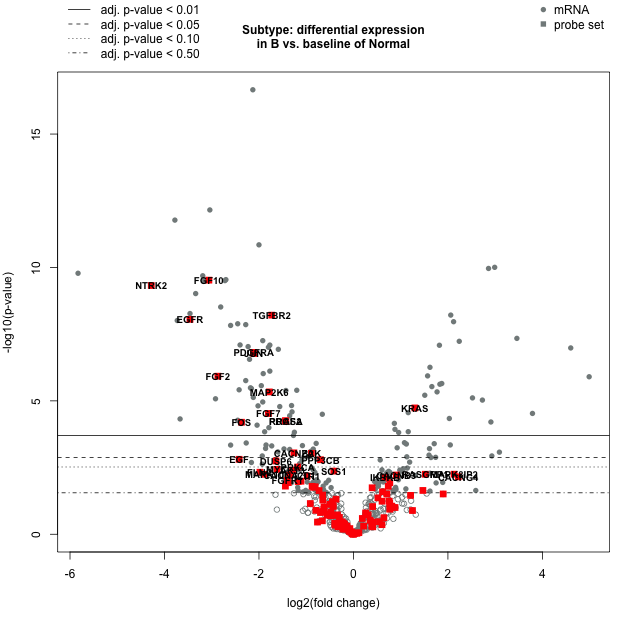
Volcano Plot: SubtypeB
Volcano plot displaying each gene's -log10(p-value) and log2 fold change for the selected covariate. Highly statistically significant genes fall at the top of the plot, and highly differentially expressed genes fall to either side. Genes within the selected gene set are highlighted in blue. Green point colors and horizontal lines indicate various False Discovery Rate (FDR) thresholds.
DE Results - MAPK genes - SubtypeB
More Plot Information Download CSV DataProbe Label Log2 fold change std error Lower confidence limit Upper confidence limit P-value BY.p.value Gene.sets Codeset.Name Probe.Label Analyte.Type Is.Control Control.Type Probe.Annotation KEGG.Pathways Cell.Type Official.Gene.Name volcanocol volcanopch tstats.all FGF10-mRNA -3.06 0.394 -3.83 -2.29 2.99e-10 1.01e-07 MAPK, PI3K, RAS NS_CANCERPATH_C2535 FGF10 mRNA 0 RAS;PI3K;MAPK hsa04010;hsa04014;hsa04015;hsa04151;hsa04810;hsa05200;hsa05218 FGF10 chartreuse1 16 -7.76649746192893 NTRK2-mRNA -4.28 0.561 -5.38 -3.19 4.75e-10 1.35e-07 MAPK NS_CANCERPATH_C2535 NTRK2 mRNA 0 MAPK hsa04010;hsa04722;hsa05034 NTRK2 chartreuse1 16 -7.62923351158645 TGFBR2-mRNA -1.73 0.249 -2.22 -1.24 6.13e-09 1.28e-06 MAPK, TGF-B, TXmisReg NS_CANCERPATH_C2535 TGFBR2 mRNA 0 MAPK;TGF-B;TXmisReg hsa04010;hsa04060;hsa04068;hsa04144;hsa04350;hsa04380;hsa04390;hsa04520;hsa04933;hsa05142;hsa05166;hsa05200;hsa05202;hsa05210;hsa05212;hsa05220 TGFBR2 chartreuse1 16 -6.94779116465863 EGFR-mRNA -3.46 0.506 -4.46 -2.47 8.82e-09 1.75e-06 Driver Gene, MAPK, PI3K, RAS NS_CANCERPATH_C2535 EGFR mRNA 0 RAS;PI3K;MAPK;Driver Gene hsa04010;hsa04012;hsa04014;hsa04015;hsa04020;hsa04060;hsa04066;hsa04068;hsa04072;hsa04144;hsa04151;hsa04320;hsa04510;hsa04520;hsa04540;hsa04810;hsa04912;hsa04915;hsa04921;hsa05120;hsa05160;hsa05200;hsa05205;hsa05206;hsa05212;hsa05213;hsa05214;hsa05215;hsa05218;hsa05219;hsa05223;hsa05230;hsa05231 EGFR chartreuse1 16 -6.83794466403162 PDGFRA-mRNA -2.11 0.348 -2.79 -1.43 1.53e-07 1.69e-05 Driver Gene, MAPK, PI3K, RAS NS_CANCERPATH_C2535 PDGFRA mRNA 0 RAS;PI3K;MAPK;Driver Gene hsa04010;hsa04014;hsa04015;hsa04020;hsa04060;hsa04072;hsa04144;hsa04151;hsa04510;hsa04540;hsa04810;hsa05166;hsa05200;hsa05206;hsa05214;hsa05215;hsa05218;hsa05230;hsa05231 PDGFRA chartreuse1 16 -6.0632183908046 JUN-mRNA -2.11 0.35 -2.8 -1.43 1.68e-07 1.81e-05 MAPK, Wnt NS_CANCERPATH_C2535 JUN mRNA 0 MAPK;Wnt hsa04010;hsa04012;hsa04024;hsa04310;hsa04380;hsa04510;hsa04620;hsa04660;hsa04662;hsa04668;hsa04722;hsa04912;hsa04915;hsa04921;hsa04932;hsa04933;hsa05030;hsa05031;hsa05120;hsa05132;hsa05133;hsa05140;hsa05142;hsa05161;hsa05164;hsa05166;hsa05168;hsa05169;hsa05200;hsa05203;hsa05210;hsa05211;hsa05231;hsa05321;hsa05323 JUN chartreuse1 16 -6.02857142857143 FGF2-mRNA -2.87 0.522 -3.89 -1.84 1.19e-06 0.00011 MAPK, PI3K, RAS NS_CANCERPATH_C2535 FGF2 mRNA 0 RAS;PI3K;MAPK hsa04010;hsa04014;hsa04015;hsa04151;hsa04550;hsa04810;hsa05200;hsa05205;hsa05218 FGF2 chartreuse1 16 -5.49808429118774 MAP2K6-mRNA -1.78 0.348 -2.46 -1.1 4.62e-06 0.000328 MAPK NS_CANCERPATH_C2535 MAP2K6 mRNA 0 MAPK hsa04010;hsa04015;hsa04380;hsa04620;hsa04664;hsa04668;hsa04750;hsa04912;hsa05014;hsa05145;hsa05164;hsa05169 MAP2K6 chartreuse1 16 -5.11494252873563 KRAS-mRNA 1.3 0.275 0.757 1.83 1.84e-05 0.00111 Driver Gene, MAPK, PI3K, RAS NS_CANCERPATH_C2535 KRAS mRNA 0 RAS;PI3K;MAPK;Driver Gene hsa04010;hsa04012;hsa04014;hsa04015;hsa04062;hsa04068;hsa04071;hsa04072;hsa04151;hsa04211;hsa04320;hsa04360;hsa04370;hsa04530;hsa04540;hsa04550;hsa04650;hsa04660;hsa04662;hsa04664;hsa04720;hsa04722;hsa04725;hsa04726;hsa04730;hsa04810;hsa04910;hsa04912;hsa04914;hsa04915;hsa04916;hsa04917;hsa04919;hsa04921;hsa04933;hsa04960;hsa05034;hsa05160;hsa05161;hsa05166;hsa05200;hsa05203;hsa05205;hsa05206;hsa05210;hsa05211;hsa05212;hsa05213;hsa05214;hsa05215;hsa05216;hsa05218;hsa05219;hsa05220;hsa05221;hsa05223;hsa05230;hsa05231 KRAS chartreuse1 16 4.72727272727273 FGF7-mRNA -1.8 0.394 -2.58 -1.03 2.97e-05 0.00169 MAPK, PI3K, RAS NS_CANCERPATH_C2535 FGF7 mRNA 0 RAS;PI3K;MAPK hsa04010;hsa04014;hsa04015;hsa04151;hsa04810;hsa05200;hsa05218 FGF7 chartreuse1 16 -4.56852791878173 RRAS2-mRNA -1.44 0.327 -2.08 -0.795 5.5e-05 0.00288 MAPK, RAS NS_CANCERPATH_C2535 RRAS2 mRNA 0 RAS;MAPK hsa04010;hsa04014;hsa04024;hsa04072;hsa04530;hsa04810;hsa05166;hsa05205 RRAS2 chartreuse1 16 -4.40366972477064 PDGFA-mRNA -1.43 0.327 -2.07 -0.789 5.91e-05 0.00305 MAPK, PI3K, RAS, TXmisReg NS_CANCERPATH_C2535 PDGFA mRNA 0 RAS;PI3K;MAPK;TXmisReg hsa04010;hsa04014;hsa04015;hsa04060;hsa04072;hsa04151;hsa04510;hsa04540;hsa04810;hsa05166;hsa05200;hsa05202;hsa05206;hsa05214;hsa05215;hsa05218;hsa05231 PDGFA chartreuse1 16 -4.37308868501529 FOS-mRNA -2.37 0.546 -3.44 -1.31 6.33e-05 0.00319 MAPK NS_CANCERPATH_C2535 FOS mRNA 0 MAPK hsa04010;hsa04024;hsa04380;hsa04620;hsa04660;hsa04662;hsa04668;hsa04713;hsa04725;hsa04728;hsa04915;hsa04917;hsa04921;hsa05031;hsa05132;hsa05133;hsa05140;hsa05142;hsa05161;hsa05166;hsa05168;hsa05200;hsa05210;hsa05231;hsa05323 FOS chartreuse1 16 -4.34065934065934 CACNB2-mRNA -1.26 0.357 -1.96 -0.56 0.000888 0.0327 MAPK NS_CANCERPATH_C2535 CACNB2 mRNA 0 MAPK hsa04010;hsa04260;hsa04261;hsa04921;hsa05410;hsa05412;hsa05414 CACNB2 chartreuse2 16 -3.52941176470588 ZAK-mRNA -0.89 0.253 -1.39 -0.393 0.000927 0.0338 MAPK NS_CANCERPATH_C2535 ZAK mRNA 0 MAPK hsa04010;hsa04530 ZAK chartreuse2 16 -3.51778656126482 EGF-mRNA -2.42 0.723 -3.83 -0.999 0.00155 0.0521 MAPK, PI3K, RAS NS_CANCERPATH_C2535 EGF mRNA 0 RAS;PI3K;MAPK hsa04010;hsa04012;hsa04014;hsa04015;hsa04060;hsa04066;hsa04068;hsa04072;hsa04144;hsa04151;hsa04510;hsa04540;hsa04810;hsa05160;hsa05200;hsa05212;hsa05213;hsa05214;hsa05215;hsa05218;hsa05219;hsa05223;hsa05231 EGF chartreuse3 16 -3.34716459197787 PPP3CB-mRNA -0.697 0.209 -1.11 -0.287 0.00161 0.0537 CC.PLS.Apop, MAPK, Wnt NS_CANCERPATH_C2535 PPP3CB mRNA 0 CC.PLS.Apop;MAPK;Wnt hsa04010;hsa04020;hsa04022;hsa04114;hsa04210;hsa04310;hsa04360;hsa04370;hsa04380;hsa04650;hsa04660;hsa04662;hsa04720;hsa04724;hsa04728;hsa04921;hsa04922;hsa04924;hsa05010;hsa05014;hsa05031;hsa05152;hsa05166 PPP3CB chartreuse3 16 -3.33492822966507 DUSP6-mRNA -1.64 0.499 -2.62 -0.665 0.00179 0.0585 MAPK, TXmisReg NS_CANCERPATH_C2535 DUSP6 mRNA 0 MAPK;TXmisReg hsa04010;hsa05202 DUSP6 chartreuse3 16 -3.28657314629258 PRKCA-mRNA -1.18 0.379 -1.92 -0.437 0.00301 0.0942 MAPK, PI3K, RAS, Wnt NS_CANCERPATH_C2535 PRKCA mRNA 0 RAS;PI3K;MAPK;Wnt hsa04010;hsa04012;hsa04014;hsa04015;hsa04020;hsa04066;hsa04070;hsa04071;hsa04072;hsa04150;hsa04151;hsa04261;hsa04270;hsa04310;hsa04370;hsa04510;hsa04530;hsa04540;hsa04650;hsa04664;hsa04666;hsa04670;hsa04713;hsa04720;hsa04723;hsa04724;hsa04725;hsa04726;hsa04727;hsa04728;hsa04730;hsa04750;hsa04911;hsa04912;hsa04916;hsa04918;hsa04919;hsa04921;hsa04925;hsa04933;hsa04960;hsa04961;hsa04970;hsa04971;hsa04972;hsa05031;hsa05032;hsa05110;hsa05130;hsa05143;hsa05146;hsa05161;hsa05164;hsa05200;hsa05205;hsa05206;hsa05214;hsa05223;hsa05231 PRKCA chartreuse4 16 -3.11345646437995 MYC-mRNA -1.62 0.534 -2.67 -0.577 0.00369 0.111 CC.PLS.Apop, JAK-STAT, MAPK, PI3K, TGF-B, TXmisReg, Wnt NS_CANCERPATH_C2535 MYC mRNA 0 CC.PLS.Apop;PI3K;JAK-STAT;MAPK;TGF-B;TXmisReg;Wnt hsa04010;hsa04012;hsa04110;hsa04151;hsa04310;hsa04350;hsa04390;hsa04550;hsa04630;hsa04919;hsa05161;hsa05166;hsa05169;hsa05200;hsa05202;hsa05205;hsa05206;hsa05210;hsa05213;hsa05216;hsa05219;hsa05220;hsa05221;hsa05222;hsa05230 MYC chartreuse4 16 -3.03370786516854 DE Results - MAPK genes - SubtypeB
Table displaying each sample's global significance scores and directed global significance scores as defined in the heatmaps above. The global significance score is calculated as the square root of the mean squared t-statistic for the genes in a gene set, with t-statistics coming from the linear regression underlying our differential expression analysis. The directed global significance score is calculated as the square root of the mean signed squared t-statistic for the genes in a gene set, with t-statistics coming from the linear regression underlying our differential expression analysis.
Volcano Plot: SubtypeC
More Plot Information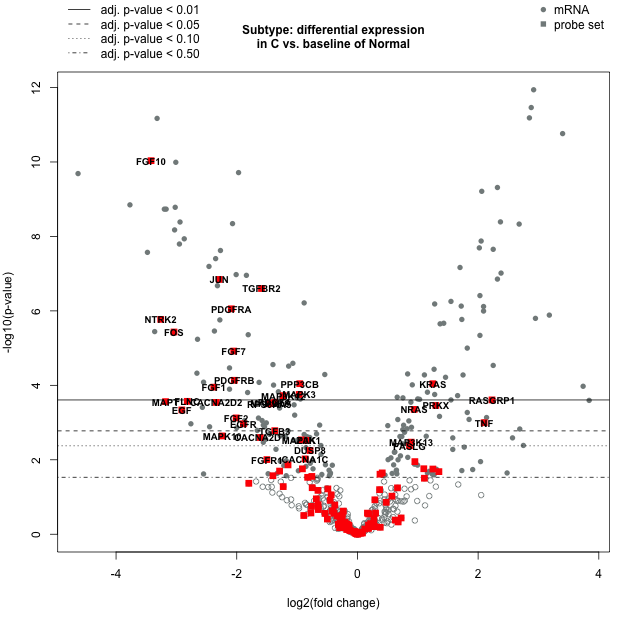
Volcano Plot: SubtypeC
Volcano plot displaying each gene's -log10(p-value) and log2 fold change for the selected covariate. Highly statistically significant genes fall at the top of the plot, and highly differentially expressed genes fall to either side. Genes within the selected gene set are highlighted in blue. Green point colors and horizontal lines indicate various False Discovery Rate (FDR) thresholds.
DE Results - MAPK genes - SubtypeC
More Plot Information Download CSV DataProbe Label Log2 fold change std error Lower confidence limit Upper confidence limit P-value BY.p.value Gene.sets Codeset.Name Probe.Label Analyte.Type Is.Control Control.Type Probe.Annotation KEGG.Pathways Cell.Type Official.Gene.Name volcanocol volcanopch tstats.all FGF10-mRNA -3.42 0.423 -4.25 -2.59 9.23e-11 5.8e-08 MAPK, PI3K, RAS NS_CANCERPATH_C2535 FGF10 mRNA 0 RAS;PI3K;MAPK hsa04010;hsa04014;hsa04015;hsa04151;hsa04810;hsa05200;hsa05218 FGF10 chartreuse1 16 -8.08510638297872 JUN-mRNA -2.29 0.376 -3.03 -1.55 1.43e-07 1.62e-05 MAPK, Wnt NS_CANCERPATH_C2535 JUN mRNA 0 MAPK;Wnt hsa04010;hsa04012;hsa04024;hsa04310;hsa04380;hsa04510;hsa04620;hsa04660;hsa04662;hsa04668;hsa04722;hsa04912;hsa04915;hsa04921;hsa04932;hsa04933;hsa05030;hsa05031;hsa05120;hsa05132;hsa05133;hsa05140;hsa05142;hsa05161;hsa05164;hsa05166;hsa05168;hsa05169;hsa05200;hsa05203;hsa05210;hsa05211;hsa05231;hsa05321;hsa05323 JUN chartreuse1 16 -6.09042553191489 TGFBR2-mRNA -1.59 0.268 -2.11 -1.06 2.51e-07 2.7e-05 MAPK, TGF-B, TXmisReg NS_CANCERPATH_C2535 TGFBR2 mRNA 0 MAPK;TGF-B;TXmisReg hsa04010;hsa04060;hsa04068;hsa04144;hsa04350;hsa04380;hsa04390;hsa04520;hsa04933;hsa05142;hsa05166;hsa05200;hsa05202;hsa05210;hsa05212;hsa05220 TGFBR2 chartreuse1 16 -5.93283582089552 PDGFRA-mRNA -2.09 0.374 -2.82 -1.35 8.8e-07 7.95e-05 Driver Gene, MAPK, PI3K, RAS NS_CANCERPATH_C2535 PDGFRA mRNA 0 RAS;PI3K;MAPK;Driver Gene hsa04010;hsa04014;hsa04015;hsa04020;hsa04060;hsa04072;hsa04144;hsa04151;hsa04510;hsa04540;hsa04810;hsa05166;hsa05200;hsa05206;hsa05214;hsa05215;hsa05218;hsa05230;hsa05231 PDGFRA chartreuse1 16 -5.58823529411765 NTRK2-mRNA -3.26 0.603 -4.44 -2.07 1.69e-06 0.000138 MAPK NS_CANCERPATH_C2535 NTRK2 mRNA 0 MAPK hsa04010;hsa04722;hsa05034 NTRK2 chartreuse1 16 -5.40630182421227 FOS-mRNA -3.04 0.587 -4.19 -1.89 3.69e-06 0.000267 MAPK NS_CANCERPATH_C2535 FOS mRNA 0 MAPK hsa04010;hsa04024;hsa04380;hsa04620;hsa04660;hsa04662;hsa04668;hsa04713;hsa04725;hsa04728;hsa04915;hsa04917;hsa04921;hsa05031;hsa05132;hsa05133;hsa05140;hsa05142;hsa05161;hsa05166;hsa05168;hsa05200;hsa05210;hsa05231;hsa05323 FOS chartreuse1 16 -5.17887563884157 FGF7-mRNA -2.05 0.424 -2.88 -1.22 1.2e-05 0.000794 MAPK, PI3K, RAS NS_CANCERPATH_C2535 FGF7 mRNA 0 RAS;PI3K;MAPK hsa04010;hsa04014;hsa04015;hsa04151;hsa04810;hsa05200;hsa05218 FGF7 chartreuse1 16 -4.83490566037736 PDGFRB-mRNA -2.04 0.473 -2.97 -1.11 7.32e-05 0.00399 MAPK, PI3K, RAS NS_CANCERPATH_C2535 PDGFRB mRNA 0 RAS;PI3K;MAPK hsa04010;hsa04014;hsa04015;hsa04020;hsa04060;hsa04072;hsa04151;hsa04510;hsa04540;hsa04810;hsa05166;hsa05200;hsa05206;hsa05214;hsa05215;hsa05218;hsa05230;hsa05231 PDGFRB chartreuse1 16 -4.31289640591966 PPP3CB-mRNA -0.956 0.225 -1.4 -0.515 9.04e-05 0.00468 CC.PLS.Apop, MAPK, Wnt NS_CANCERPATH_C2535 PPP3CB mRNA 0 CC.PLS.Apop;MAPK;Wnt hsa04010;hsa04020;hsa04022;hsa04114;hsa04210;hsa04310;hsa04360;hsa04370;hsa04380;hsa04650;hsa04660;hsa04662;hsa04720;hsa04724;hsa04728;hsa04921;hsa04922;hsa04924;hsa05010;hsa05014;hsa05031;hsa05152;hsa05166 PPP3CB chartreuse1 16 -4.24888888888889 KRAS-mRNA 1.25 0.296 0.675 1.83 9.06e-05 0.00468 Driver Gene, MAPK, PI3K, RAS NS_CANCERPATH_C2535 KRAS mRNA 0 RAS;PI3K;MAPK;Driver Gene hsa04010;hsa04012;hsa04014;hsa04015;hsa04062;hsa04068;hsa04071;hsa04072;hsa04151;hsa04211;hsa04320;hsa04360;hsa04370;hsa04530;hsa04540;hsa04550;hsa04650;hsa04660;hsa04662;hsa04664;hsa04720;hsa04722;hsa04725;hsa04726;hsa04730;hsa04810;hsa04910;hsa04912;hsa04914;hsa04915;hsa04916;hsa04917;hsa04919;hsa04921;hsa04933;hsa04960;hsa05034;hsa05160;hsa05161;hsa05166;hsa05200;hsa05203;hsa05205;hsa05206;hsa05210;hsa05211;hsa05212;hsa05213;hsa05214;hsa05215;hsa05216;hsa05218;hsa05219;hsa05220;hsa05221;hsa05223;hsa05230;hsa05231 KRAS chartreuse1 16 4.22297297297297 FGF1-mRNA -2.38 0.569 -3.49 -1.26 0.000112 0.00549 MAPK, PI3K, RAS NS_CANCERPATH_C2535 FGF1 mRNA 0 RAS;PI3K;MAPK hsa04010;hsa04014;hsa04015;hsa04151;hsa04390;hsa04810;hsa05200;hsa05218 FGF1 chartreuse1 16 -4.18277680140598 MAPK3-mRNA -0.965 0.239 -1.43 -0.497 0.000176 0.00804 MAPK, PI3K, RAS, TGF-B NS_CANCERPATH_C2535 MAPK3 mRNA 0 RAS;PI3K;MAPK;TGF-B hsa04010;hsa04012;hsa04014;hsa04015;hsa04022;hsa04024;hsa04062;hsa04066;hsa04068;hsa04071;hsa04072;hsa04114;hsa04150;hsa04151;hsa04261;hsa04270;hsa04320;hsa04350;hsa04360;hsa04370;hsa04380;hsa04510;hsa04520;hsa04540;hsa04550;hsa04611;hsa04620;hsa04621;hsa04650;hsa04660;hsa04662;hsa04664;hsa04666;hsa04668;hsa04713;hsa04720;hsa04722;hsa04723;hsa04724;hsa04725;hsa04726;hsa04730;hsa04810;hsa04910;hsa04912;hsa04914;hsa04915;hsa04916;hsa04917;hsa04919;hsa04921;hsa04930;hsa04933;hsa04960;hsa05010;hsa05020;hsa05034;hsa05131;hsa05132;hsa05133;hsa05140;hsa05142;hsa05145;hsa05152;hsa05160;hsa05161;hsa05164;hsa05200;hsa05203;hsa05205;hsa05210;hsa05211;hsa05212;hsa05213;hsa05214;hsa05215;hsa05216;hsa05218;hsa05219;hsa05220;hsa05221;hsa05223;hsa05230;hsa05231 MAPK3 chartreuse1 16 -4.03765690376569 MAP3K12-mRNA -1.23 0.306 -1.83 -0.631 0.000189 0.00847 ChromMod, MAPK NS_CANCERPATH_C2535 MAP3K12 mRNA 0 MAPK;ChromMod hsa04010 MAP3K12 chartreuse1 16 -4.01960784313725 RASGRP1-mRNA 2.23 0.566 1.12 3.34 0.000246 0.00992 MAPK, RAS NS_CANCERPATH_C2535 RASGRP1 mRNA 0 RAS;MAPK hsa04010;hsa04014;hsa04611;hsa04660;hsa05200 RASGRP1 chartreuse1 16 3.93992932862191 FLNC-mRNA -2.82 0.722 -4.24 -1.41 0.000269 0.0106 MAPK NS_CANCERPATH_C2535 FLNC mRNA 0 MAPK hsa04010;hsa04510;hsa05132;hsa05205 FLNC chartreuse2 16 -3.90581717451524 MAPT-mRNA -3.18 0.813 -4.77 -1.58 0.000274 0.0107 MAPK NS_CANCERPATH_C2535 MAPT mRNA 0 MAPK hsa04010;hsa05010 MAPT chartreuse2 16 -3.91143911439114 PDGFA-mRNA -1.37 0.352 -2.06 -0.679 0.000284 0.0109 MAPK, PI3K, RAS, TXmisReg NS_CANCERPATH_C2535 PDGFA mRNA 0 RAS;PI3K;MAPK;TXmisReg hsa04010;hsa04014;hsa04015;hsa04060;hsa04072;hsa04151;hsa04510;hsa04540;hsa04810;hsa05166;hsa05200;hsa05202;hsa05206;hsa05214;hsa05215;hsa05218;hsa05231 PDGFA chartreuse2 16 -3.89204545454546 CACNA2D2-mRNA -2.34 0.601 -3.51 -1.16 0.000288 0.0109 MAPK NS_CANCERPATH_C2535 CACNA2D2 mRNA 0 MAPK hsa04010;hsa04260;hsa04261;hsa04921;hsa05410;hsa05412;hsa05414 CACNA2D2 chartreuse2 16 -3.89351081530782 MAP2K6-mRNA -1.45 0.374 -2.18 -0.715 0.000304 0.0114 MAPK NS_CANCERPATH_C2535 MAP2K6 mRNA 0 MAPK hsa04010;hsa04015;hsa04380;hsa04620;hsa04664;hsa04668;hsa04750;hsa04912;hsa05014;hsa05145;hsa05164;hsa05169 MAP2K6 chartreuse2 16 -3.87700534759358 RPS6KA5-mRNA -1.46 0.378 -2.2 -0.719 0.000313 0.0116 ChromMod, MAPK NS_CANCERPATH_C2535 RPS6KA5 mRNA 0 MAPK;ChromMod hsa04010;hsa04261;hsa04668;hsa04713;hsa04722;hsa05206;hsa05219 RPS6KA5 chartreuse2 16 -3.86243386243386 DE Results - MAPK genes - SubtypeC
Table displaying each sample's global significance scores and directed global significance scores as defined in the heatmaps above. The global significance score is calculated as the square root of the mean squared t-statistic for the genes in a gene set, with t-statistics coming from the linear regression underlying our differential expression analysis. The directed global significance score is calculated as the square root of the mean signed squared t-statistic for the genes in a gene set, with t-statistics coming from the linear regression underlying our differential expression analysis.
Volcano Plot: SubtypeD
More Plot Information
Volcano Plot: SubtypeD
Volcano plot displaying each gene's -log10(p-value) and log2 fold change for the selected covariate. Highly statistically significant genes fall at the top of the plot, and highly differentially expressed genes fall to either side. Genes within the selected gene set are highlighted in blue. Green point colors and horizontal lines indicate various False Discovery Rate (FDR) thresholds.
DE Results - MAPK genes - SubtypeD
More Plot Information Download CSV DataProbe Label Log2 fold change std error Lower confidence limit Upper confidence limit P-value BY.p.value Gene.sets Codeset.Name Probe.Label Analyte.Type Is.Control Control.Type Probe.Annotation KEGG.Pathways Cell.Type Official.Gene.Name volcanocol volcanopch tstats.all FGF10-mRNA -2.87 0.409 -3.68 -2.07 4.51e-09 1.79e-06 MAPK, PI3K, RAS NS_CANCERPATH_C2535 FGF10 mRNA 0 RAS;PI3K;MAPK hsa04010;hsa04014;hsa04015;hsa04151;hsa04810;hsa05200;hsa05218 FGF10 chartreuse1 16 -7.01711491442543 NTRK2-mRNA -3.99 0.583 -5.13 -2.84 9.06e-09 3.28e-06 MAPK NS_CANCERPATH_C2535 NTRK2 mRNA 0 MAPK hsa04010;hsa04722;hsa05034 NTRK2 chartreuse1 16 -6.84391080617496 JUN-mRNA -2.15 0.364 -2.87 -1.44 2.58e-07 3.21e-05 MAPK, Wnt NS_CANCERPATH_C2535 JUN mRNA 0 MAPK;Wnt hsa04010;hsa04012;hsa04024;hsa04310;hsa04380;hsa04510;hsa04620;hsa04660;hsa04662;hsa04668;hsa04722;hsa04912;hsa04915;hsa04921;hsa04932;hsa04933;hsa05030;hsa05031;hsa05120;hsa05132;hsa05133;hsa05140;hsa05142;hsa05161;hsa05164;hsa05166;hsa05168;hsa05169;hsa05200;hsa05203;hsa05210;hsa05211;hsa05231;hsa05321;hsa05323 JUN chartreuse1 16 -5.90659340659341 TGFBR2-mRNA -1.41 0.259 -1.91 -0.899 1.51e-06 0.000163 MAPK, TGF-B, TXmisReg NS_CANCERPATH_C2535 TGFBR2 mRNA 0 MAPK;TGF-B;TXmisReg hsa04010;hsa04060;hsa04068;hsa04144;hsa04350;hsa04380;hsa04390;hsa04520;hsa04933;hsa05142;hsa05166;hsa05200;hsa05202;hsa05210;hsa05212;hsa05220 TGFBR2 chartreuse1 16 -5.44401544401544 KRAS-mRNA 1.53 0.286 0.975 2.09 1.84e-06 0.000188 Driver Gene, MAPK, PI3K, RAS NS_CANCERPATH_C2535 KRAS mRNA 0 RAS;PI3K;MAPK;Driver Gene hsa04010;hsa04012;hsa04014;hsa04015;hsa04062;hsa04068;hsa04071;hsa04072;hsa04151;hsa04211;hsa04320;hsa04360;hsa04370;hsa04530;hsa04540;hsa04550;hsa04650;hsa04660;hsa04662;hsa04664;hsa04720;hsa04722;hsa04725;hsa04726;hsa04730;hsa04810;hsa04910;hsa04912;hsa04914;hsa04915;hsa04916;hsa04917;hsa04919;hsa04921;hsa04933;hsa04960;hsa05034;hsa05160;hsa05161;hsa05166;hsa05200;hsa05203;hsa05205;hsa05206;hsa05210;hsa05211;hsa05212;hsa05213;hsa05214;hsa05215;hsa05216;hsa05218;hsa05219;hsa05220;hsa05221;hsa05223;hsa05230;hsa05231 KRAS chartreuse1 16 5.34965034965035 PDGFRA-mRNA -1.87 0.361 -2.58 -1.16 3.73e-06 0.000337 Driver Gene, MAPK, PI3K, RAS NS_CANCERPATH_C2535 PDGFRA mRNA 0 RAS;PI3K;MAPK;Driver Gene hsa04010;hsa04014;hsa04015;hsa04020;hsa04060;hsa04072;hsa04144;hsa04151;hsa04510;hsa04540;hsa04810;hsa05166;hsa05200;hsa05206;hsa05214;hsa05215;hsa05218;hsa05230;hsa05231 PDGFRA chartreuse1 16 -5.18005540166205 FOS-mRNA -2.82 0.567 -3.94 -1.71 7.37e-06 0.000596 MAPK NS_CANCERPATH_C2535 FOS mRNA 0 MAPK hsa04010;hsa04024;hsa04380;hsa04620;hsa04660;hsa04662;hsa04668;hsa04713;hsa04725;hsa04728;hsa04915;hsa04917;hsa04921;hsa05031;hsa05132;hsa05133;hsa05140;hsa05142;hsa05161;hsa05166;hsa05168;hsa05200;hsa05210;hsa05231;hsa05323 FOS chartreuse1 16 -4.97354497354497 FGF2-mRNA -2.66 0.542 -3.72 -1.6 9.57e-06 0.000733 MAPK, PI3K, RAS NS_CANCERPATH_C2535 FGF2 mRNA 0 RAS;PI3K;MAPK hsa04010;hsa04014;hsa04015;hsa04151;hsa04550;hsa04810;hsa05200;hsa05205;hsa05218 FGF2 chartreuse1 16 -4.90774907749077 MAP2K6-mRNA -1.77 0.362 -2.48 -1.07 9.58e-06 0.000733 MAPK NS_CANCERPATH_C2535 MAP2K6 mRNA 0 MAPK hsa04010;hsa04015;hsa04380;hsa04620;hsa04664;hsa04668;hsa04750;hsa04912;hsa05014;hsa05145;hsa05164;hsa05169 MAP2K6 chartreuse1 16 -4.88950276243094 FGF7-mRNA -1.72 0.41 -2.52 -0.914 0.000108 0.00634 MAPK, PI3K, RAS NS_CANCERPATH_C2535 FGF7 mRNA 0 RAS;PI3K;MAPK hsa04010;hsa04014;hsa04015;hsa04151;hsa04810;hsa05200;hsa05218 FGF7 chartreuse1 16 -4.19512195121951 DUSP10-mRNA 1.53 0.404 0.743 2.33 0.000383 0.0179 MAPK NS_CANCERPATH_C2535 DUSP10 mRNA 0 MAPK hsa04010 DUSP10 chartreuse2 16 3.78712871287129 PDGFA-mRNA -1.27 0.34 -1.93 -0.601 0.000477 0.0216 MAPK, PI3K, RAS, TXmisReg NS_CANCERPATH_C2535 PDGFA mRNA 0 RAS;PI3K;MAPK;TXmisReg hsa04010;hsa04014;hsa04015;hsa04060;hsa04072;hsa04151;hsa04510;hsa04540;hsa04810;hsa05166;hsa05200;hsa05202;hsa05206;hsa05214;hsa05215;hsa05218;hsa05231 PDGFA chartreuse2 16 -3.73529411764706 AKT1-mRNA 1.14 0.308 0.537 1.74 0.000514 0.023 CC.PLS.Apop, Driver Gene, JAK-STAT, MAPK, PI3K, RAS NS_CANCERPATH_C2535 AKT1 mRNA 0 CC.PLS.Apop;RAS;PI3K;JAK-STAT;MAPK;Driver Gene hsa04010;hsa04012;hsa04014;hsa04015;hsa04022;hsa04024;hsa04062;hsa04066;hsa04068;hsa04071;hsa04072;hsa04150;hsa04151;hsa04152;hsa04210;hsa04211;hsa04261;hsa04370;hsa04380;hsa04510;hsa04530;hsa04550;hsa04611;hsa04620;hsa04630;hsa04660;hsa04662;hsa04664;hsa04666;hsa04668;hsa04722;hsa04725;hsa04728;hsa04910;hsa04914;hsa04915;hsa04917;hsa04919;hsa04920;hsa04922;hsa04923;hsa04931;hsa04932;hsa04933;hsa04973;hsa05142;hsa05145;hsa05152;hsa05160;hsa05161;hsa05162;hsa05164;hsa05166;hsa05169;hsa05200;hsa05205;hsa05210;hsa05211;hsa05212;hsa05213;hsa05214;hsa05215;hsa05218;hsa05220;hsa05221;hsa05222;hsa05223;hsa05230;hsa05231 AKT1 chartreuse2 16 3.7012987012987 PPP3CB-mRNA -0.805 0.218 -1.23 -0.378 0.000523 0.0231 CC.PLS.Apop, MAPK, Wnt NS_CANCERPATH_C2535 PPP3CB mRNA 0 CC.PLS.Apop;MAPK;Wnt hsa04010;hsa04020;hsa04022;hsa04114;hsa04210;hsa04310;hsa04360;hsa04370;hsa04380;hsa04650;hsa04660;hsa04662;hsa04720;hsa04724;hsa04728;hsa04921;hsa04922;hsa04924;hsa05010;hsa05014;hsa05031;hsa05152;hsa05166 PPP3CB chartreuse2 16 -3.69266055045872 MYC-mRNA -1.95 0.555 -3.04 -0.862 0.000928 0.0381 CC.PLS.Apop, JAK-STAT, MAPK, PI3K, TGF-B, TXmisReg, Wnt NS_CANCERPATH_C2535 MYC mRNA 0 CC.PLS.Apop;PI3K;JAK-STAT;MAPK;TGF-B;TXmisReg;Wnt hsa04010;hsa04012;hsa04110;hsa04151;hsa04310;hsa04350;hsa04390;hsa04550;hsa04630;hsa04919;hsa05161;hsa05166;hsa05169;hsa05200;hsa05202;hsa05205;hsa05206;hsa05210;hsa05213;hsa05216;hsa05219;hsa05220;hsa05221;hsa05222;hsa05230 MYC chartreuse2 16 -3.51351351351351 EGF-mRNA -2.62 0.751 -4.09 -1.15 0.00101 0.0406 MAPK, PI3K, RAS NS_CANCERPATH_C2535 EGF mRNA 0 RAS;PI3K;MAPK hsa04010;hsa04012;hsa04014;hsa04015;hsa04060;hsa04066;hsa04068;hsa04072;hsa04144;hsa04151;hsa04510;hsa04540;hsa04810;hsa05160;hsa05200;hsa05212;hsa05213;hsa05214;hsa05215;hsa05218;hsa05219;hsa05223;hsa05231 EGF chartreuse2 16 -3.48868175765646 EGFR-mRNA -1.8 0.526 -2.83 -0.769 0.00122 0.0465 Driver Gene, MAPK, PI3K, RAS NS_CANCERPATH_C2535 EGFR mRNA 0 RAS;PI3K;MAPK;Driver Gene hsa04010;hsa04012;hsa04014;hsa04015;hsa04020;hsa04060;hsa04066;hsa04068;hsa04072;hsa04144;hsa04151;hsa04320;hsa04510;hsa04520;hsa04540;hsa04810;hsa04912;hsa04915;hsa04921;hsa05120;hsa05160;hsa05200;hsa05205;hsa05206;hsa05212;hsa05213;hsa05214;hsa05215;hsa05218;hsa05219;hsa05223;hsa05230;hsa05231 EGFR chartreuse2 16 -3.42205323193916 FGFR4-mRNA 2.73 0.8 1.16 4.3 0.00125 0.0467 MAPK, PI3K, RAS NS_CANCERPATH_C2535 FGFR4 mRNA 0 RAS;PI3K;MAPK hsa04010;hsa04014;hsa04015;hsa04144;hsa04151;hsa04550;hsa04810 FGFR4 chartreuse3 16 3.4125 NFATC1-mRNA -1.05 0.34 -1.72 -0.383 0.00324 0.0997 MAPK, Wnt NS_CANCERPATH_C2535 NFATC1 mRNA 0 MAPK;Wnt hsa04010;hsa04022;hsa04024;hsa04310;hsa04380;hsa04650;hsa04660;hsa04662;hsa04921;hsa04933;hsa05161;hsa05166;hsa05321 NFATC1 chartreuse3 16 -3.08823529411765 RAC3-mRNA 1.5 0.491 0.539 2.46 0.00353 0.107 MAPK, RAS, Wnt NS_CANCERPATH_C2535 RAC3 mRNA 0 RAS;MAPK;Wnt hsa04010;hsa04014;hsa04015;hsa04024;hsa04071;hsa04310;hsa04360;hsa04370;hsa04510;hsa04520;hsa04650;hsa04662;hsa04664;hsa04810;hsa05200;hsa05210;hsa05212;hsa05231;hsa05416 RAC3 chartreuse4 16 3.05498981670061 DE Results - MAPK genes - SubtypeD
Table displaying each sample's global significance scores and directed global significance scores as defined in the heatmaps above. The global significance score is calculated as the square root of the mean squared t-statistic for the genes in a gene set, with t-statistics coming from the linear regression underlying our differential expression analysis. The directed global significance score is calculated as the square root of the mean signed squared t-statistic for the genes in a gene set, with t-statistics coming from the linear regression underlying our differential expression analysis.
- Subtype:
- SubtypeA
- SubtypeB
- SubtypeC
- SubtypeD
Volcano Plot: SubtypeA
More Plot Information
Volcano Plot: SubtypeA
Volcano plot displaying each gene's -log10(p-value) and log2 fold change for the selected covariate. Highly statistically significant genes fall at the top of the plot, and highly differentially expressed genes fall to either side. Genes within the selected gene set are highlighted in blue. Green point colors and horizontal lines indicate various False Discovery Rate (FDR) thresholds.
DE Results - Notch genes - SubtypeA
More Plot Information Download CSV DataProbe Label Log2 fold change std error Lower confidence limit Upper confidence limit P-value BY.p.value Gene.sets Codeset.Name Probe.Label Analyte.Type Is.Control Control.Type Probe.Annotation KEGG.Pathways Cell.Type Official.Gene.Name volcanocol volcanopch tstats.all MAML2-mRNA -1.97 0.18 -2.32 -1.61 4.47e-15 1.78e-11 Notch NS_CANCERPATH_C2535 MAML2 mRNA 0 Notch hsa04330 MAML2 chartreuse1 16 -10.9444444444444 DLL1-mRNA -0.956 0.295 -1.53 -0.377 0.00211 0.144 Notch NS_CANCERPATH_C2535 DLL1 mRNA 0 Notch hsa04330 DLL1 chartreuse4 16 -3.24067796610169 DLL4-mRNA -1.08 0.378 -1.82 -0.343 0.00595 0.272 Notch NS_CANCERPATH_C2535 DLL4 mRNA 0 Notch hsa04330 DLL4 chartreuse4 16 -2.85714285714286 KAT2B-mRNA -0.686 0.299 -1.27 -0.101 0.0256 0.744 Notch NS_CANCERPATH_C2535 KAT2B mRNA 0 Notch hsa04330;hsa04919;hsa05166;hsa05203 KAT2B azure4 1 -2.2943143812709 NOTCH1-mRNA -0.61 0.292 -1.18 -0.0368 0.0419 1 Driver Gene, Notch NS_CANCERPATH_C2535 NOTCH1 mRNA 0 Notch;Driver Gene hsa04320;hsa04330;hsa04919;hsa05020;hsa05206 NOTCH1 azure4 1 -2.08904109589041 JAG2-mRNA -0.717 0.349 -1.4 -0.0334 0.0448 1 Notch NS_CANCERPATH_C2535 JAG2 mRNA 0 Notch hsa04330 JAG2 azure4 1 -2.05444126074499 NOTCH2-mRNA -0.563 0.323 -1.2 0.0694 0.0869 1 Driver Gene, Notch NS_CANCERPATH_C2535 NOTCH2 mRNA 0 Notch;Driver Gene hsa04320;hsa04330;hsa04919;hsa05206 NOTCH2 azure4 1 -1.74303405572755 NUMBL-mRNA -0.406 0.3 -0.994 0.181 0.181 1 Notch NS_CANCERPATH_C2535 NUMBL mRNA 0 Notch hsa04330 NUMBL azure4 1 -1.35333333333333 HDAC1-mRNA 0.241 0.197 -0.145 0.628 0.226 1 CC.PLS.Apop, ChromMod, Notch, TXmisReg NS_CANCERPATH_C2535 HDAC1 mRNA 0 CC.PLS.Apop;TXmisReg;ChromMod;Notch hsa04110;hsa04330;hsa04919;hsa05016;hsa05031;hsa05034;hsa05169;hsa05200;hsa05202;hsa05203;hsa05206;hsa05220 HDAC1 azure4 1 1.22335025380711 DTX4-mRNA -0.621 0.509 -1.62 0.376 0.228 1 Notch NS_CANCERPATH_C2535 DTX4 mRNA 0 Notch hsa04330 DTX4 azure4 1 -1.22003929273084 NOTCH3-mRNA -0.375 0.341 -1.04 0.294 0.277 1 Notch NS_CANCERPATH_C2535 NOTCH3 mRNA 0 Notch hsa04320;hsa04330;hsa04919;hsa05206 NOTCH3 azure4 1 -1.09970674486804 EP300-mRNA -0.179 0.174 -0.52 0.163 0.309 1 CC.PLS.Apop, Driver Gene, JAK-STAT, Notch, TGF-B, Wnt NS_CANCERPATH_C2535 EP300 mRNA 0 CC.PLS.Apop;JAK-STAT;TGF-B;Wnt;Notch;Driver Gene hsa04024;hsa04066;hsa04068;hsa04110;hsa04310;hsa04330;hsa04350;hsa04520;hsa04630;hsa04720;hsa04916;hsa04919;hsa04922;hsa05016;hsa05152;hsa05161;hsa05164;hsa05166;hsa05168;hsa05169;hsa05200;hsa05203;hsa05206;hsa05211;hsa05215 EP300 azure4 1 -1.02873563218391 DTX3-mRNA 0.251 0.318 -0.372 0.874 0.433 1 Notch NS_CANCERPATH_C2535 DTX3 mRNA 0 Notch hsa04330 DTX3 azure4 1 0.789308176100629 APH1B-mRNA 0.216 0.315 -0.402 0.834 0.497 1 Notch NS_CANCERPATH_C2535 APH1B mRNA 0 Notch hsa04330;hsa05010 APH1B azure4 1 0.685714285714286 MFNG-mRNA -0.201 0.31 -0.809 0.406 0.519 1 Notch NS_CANCERPATH_C2535 MFNG mRNA 0 Notch hsa04330 MFNG azure4 1 -0.648387096774194 JAG1-mRNA -0.169 0.3 -0.758 0.419 0.576 1 Notch NS_CANCERPATH_C2535 JAG1 mRNA 0 Notch hsa04330;hsa04668 JAG1 azure4 1 -0.563333333333333 LFNG-mRNA 0.213 0.501 -0.77 1.2 0.673 1 Notch NS_CANCERPATH_C2535 LFNG mRNA 0 Notch hsa04330 LFNG azure4 1 0.425149700598802 CREBBP-mRNA 0.0973 0.267 -0.426 0.621 0.717 1 CC.PLS.Apop, ChromMod, Driver Gene, JAK-STAT, Notch, TGF-B, Wnt NS_CANCERPATH_C2535 CREBBP mRNA 0 CC.PLS.Apop;JAK-STAT;TGF-B;ChromMod;Wnt;Notch;Driver Gene hsa04024;hsa04066;hsa04068;hsa04110;hsa04310;hsa04330;hsa04350;hsa04520;hsa04630;hsa04720;hsa04916;hsa04919;hsa04922;hsa05016;hsa05152;hsa05161;hsa05164;hsa05166;hsa05168;hsa05169;hsa05200;hsa05203;hsa05206;hsa05211;hsa05215 CREBBP azure4 1 0.364419475655431 HES1-mRNA 0.122 0.37 -0.604 0.847 0.743 1 Notch NS_CANCERPATH_C2535 HES1 mRNA 0 Notch hsa03460;hsa04330 HES1 azure4 1 0.32972972972973 HDAC2-mRNA 0.0311 0.301 -0.56 0.622 0.918 1 CC.PLS.Apop, ChromMod, Notch, TXmisReg NS_CANCERPATH_C2535 HDAC2 mRNA 0 CC.PLS.Apop;TXmisReg;ChromMod;Notch hsa04110;hsa04330;hsa04919;hsa05016;hsa05034;hsa05169;hsa05200;hsa05202;hsa05203;hsa05220 HDAC2 azure4 1 0.103322259136213 DE Results - Notch genes - SubtypeA
Table displaying each sample's global significance scores and directed global significance scores as defined in the heatmaps above. The global significance score is calculated as the square root of the mean squared t-statistic for the genes in a gene set, with t-statistics coming from the linear regression underlying our differential expression analysis. The directed global significance score is calculated as the square root of the mean signed squared t-statistic for the genes in a gene set, with t-statistics coming from the linear regression underlying our differential expression analysis.
Volcano Plot: SubtypeB
More Plot Information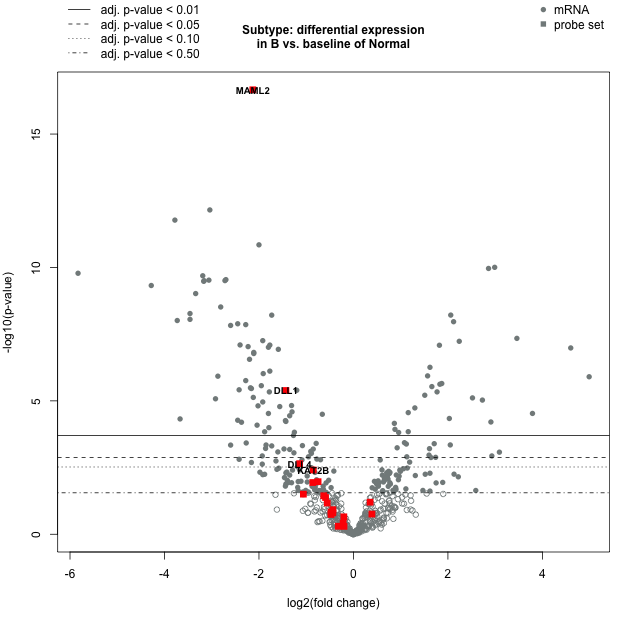
Volcano Plot: SubtypeB
Volcano plot displaying each gene's -log10(p-value) and log2 fold change for the selected covariate. Highly statistically significant genes fall at the top of the plot, and highly differentially expressed genes fall to either side. Genes within the selected gene set are highlighted in blue. Green point colors and horizontal lines indicate various False Discovery Rate (FDR) thresholds.
DE Results - Notch genes - SubtypeB
More Plot Information Download CSV DataProbe Label Log2 fold change std error Lower confidence limit Upper confidence limit P-value BY.p.value Gene.sets Codeset.Name Probe.Label Analyte.Type Is.Control Control.Type Probe.Annotation KEGG.Pathways Cell.Type Official.Gene.Name volcanocol volcanopch tstats.all MAML2-mRNA -2.13 0.169 -2.46 -1.8 2.19e-17 8.69e-14 Notch NS_CANCERPATH_C2535 MAML2 mRNA 0 Notch hsa04330 MAML2 chartreuse1 16 -12.603550295858 DLL1-mRNA -1.43 0.278 -1.98 -0.887 4.09e-06 0.000301 Notch NS_CANCERPATH_C2535 DLL1 mRNA 0 Notch hsa04330 DLL1 chartreuse1 16 -5.14388489208633 DLL4-mRNA -1.14 0.356 -1.84 -0.446 0.00226 0.0718 Notch NS_CANCERPATH_C2535 DLL4 mRNA 0 Notch hsa04330 DLL4 chartreuse3 16 -3.20224719101124 KAT2B-mRNA -0.85 0.281 -1.4 -0.298 0.00391 0.114 Notch NS_CANCERPATH_C2535 KAT2B mRNA 0 Notch hsa04330;hsa04919;hsa05166;hsa05203 KAT2B chartreuse4 16 -3.02491103202847 NUMBL-mRNA -0.748 0.282 -1.3 -0.195 0.0107 0.243 Notch NS_CANCERPATH_C2535 NUMBL mRNA 0 Notch hsa04330 NUMBL chartreuse4 16 -2.65248226950355 JAG2-mRNA -0.861 0.329 -1.51 -0.217 0.0115 0.255 Notch NS_CANCERPATH_C2535 JAG2 mRNA 0 Notch hsa04330 JAG2 chartreuse4 16 -2.61702127659574 DTX4-mRNA -1.06 0.479 -2 -0.121 0.0314 0.531 Notch NS_CANCERPATH_C2535 DTX4 mRNA 0 Notch hsa04330 DTX4 azure4 1 -2.21294363256785 MFNG-mRNA -0.628 0.292 -1.2 -0.056 0.0361 0.586 Notch NS_CANCERPATH_C2535 MFNG mRNA 0 Notch hsa04330 MFNG azure4 1 -2.15068493150685 JAG1-mRNA -0.59 0.283 -1.15 -0.0358 0.0419 0.661 Notch NS_CANCERPATH_C2535 JAG1 mRNA 0 Notch hsa04330;hsa04668 JAG1 azure4 1 -2.08480565371025 HDAC1-mRNA 0.353 0.186 -0.0109 0.717 0.0628 0.929 CC.PLS.Apop, ChromMod, Notch, TXmisReg NS_CANCERPATH_C2535 HDAC1 mRNA 0 CC.PLS.Apop;TXmisReg;ChromMod;Notch hsa04110;hsa04330;hsa04919;hsa05016;hsa05031;hsa05034;hsa05169;hsa05200;hsa05202;hsa05203;hsa05206;hsa05220 HDAC1 azure4 1 1.89784946236559 APH1B-mRNA -0.555 0.297 -1.14 0.0276 0.0675 0.988 Notch NS_CANCERPATH_C2535 APH1B mRNA 0 Notch hsa04330;hsa05010 APH1B azure4 1 -1.86868686868687 NOTCH1-mRNA -0.435 0.275 -0.975 0.104 0.12 1 Driver Gene, Notch NS_CANCERPATH_C2535 NOTCH1 mRNA 0 Notch;Driver Gene hsa04320;hsa04330;hsa04919;hsa05020;hsa05206 NOTCH1 azure4 1 -1.58181818181818 NOTCH3-mRNA -0.473 0.321 -1.1 0.156 0.147 1 Notch NS_CANCERPATH_C2535 NOTCH3 mRNA 0 Notch hsa04320;hsa04330;hsa04919;hsa05206 NOTCH3 azure4 1 -1.47352024922118 NOTCH2-mRNA -0.435 0.304 -1.03 0.161 0.158 1 Driver Gene, Notch NS_CANCERPATH_C2535 NOTCH2 mRNA 0 Notch;Driver Gene hsa04320;hsa04330;hsa04919;hsa05206 NOTCH2 azure4 1 -1.43092105263158 HDAC2-mRNA 0.391 0.284 -0.166 0.947 0.175 1 CC.PLS.Apop, ChromMod, Notch, TXmisReg NS_CANCERPATH_C2535 HDAC2 mRNA 0 CC.PLS.Apop;TXmisReg;ChromMod;Notch hsa04110;hsa04330;hsa04919;hsa05016;hsa05034;hsa05169;hsa05200;hsa05202;hsa05203;hsa05220 HDAC2 azure4 1 1.37676056338028 HES1-mRNA -0.473 0.349 -1.16 0.21 0.181 1 Notch NS_CANCERPATH_C2535 HES1 mRNA 0 Notch hsa03460;hsa04330 HES1 azure4 1 -1.35530085959885 EP300-mRNA -0.203 0.164 -0.525 0.119 0.222 1 CC.PLS.Apop, Driver Gene, JAK-STAT, Notch, TGF-B, Wnt NS_CANCERPATH_C2535 EP300 mRNA 0 CC.PLS.Apop;JAK-STAT;TGF-B;Wnt;Notch;Driver Gene hsa04024;hsa04066;hsa04068;hsa04110;hsa04310;hsa04330;hsa04350;hsa04520;hsa04630;hsa04720;hsa04916;hsa04919;hsa04922;hsa05016;hsa05152;hsa05161;hsa05164;hsa05166;hsa05168;hsa05169;hsa05200;hsa05203;hsa05206;hsa05211;hsa05215 EP300 azure4 1 -1.23780487804878 CREBBP-mRNA -0.218 0.252 -0.711 0.275 0.391 1 CC.PLS.Apop, ChromMod, Driver Gene, JAK-STAT, Notch, TGF-B, Wnt NS_CANCERPATH_C2535 CREBBP mRNA 0 CC.PLS.Apop;JAK-STAT;TGF-B;ChromMod;Wnt;Notch;Driver Gene hsa04024;hsa04066;hsa04068;hsa04110;hsa04310;hsa04330;hsa04350;hsa04520;hsa04630;hsa04720;hsa04916;hsa04919;hsa04922;hsa05016;hsa05152;hsa05161;hsa05164;hsa05166;hsa05168;hsa05169;hsa05200;hsa05203;hsa05206;hsa05211;hsa05215 CREBBP azure4 1 -0.865079365079365 LFNG-mRNA -0.321 0.472 -1.25 0.605 0.5 1 Notch NS_CANCERPATH_C2535 LFNG mRNA 0 Notch hsa04330 LFNG azure4 1 -0.680084745762712 DTX3-mRNA -0.2 0.299 -0.787 0.387 0.507 1 Notch NS_CANCERPATH_C2535 DTX3 mRNA 0 Notch hsa04330 DTX3 azure4 1 -0.668896321070234 DE Results - Notch genes - SubtypeB
Table displaying each sample's global significance scores and directed global significance scores as defined in the heatmaps above. The global significance score is calculated as the square root of the mean squared t-statistic for the genes in a gene set, with t-statistics coming from the linear regression underlying our differential expression analysis. The directed global significance score is calculated as the square root of the mean signed squared t-statistic for the genes in a gene set, with t-statistics coming from the linear regression underlying our differential expression analysis.
Volcano Plot: SubtypeC
More Plot Information
Volcano Plot: SubtypeC
Volcano plot displaying each gene's -log10(p-value) and log2 fold change for the selected covariate. Highly statistically significant genes fall at the top of the plot, and highly differentially expressed genes fall to either side. Genes within the selected gene set are highlighted in blue. Green point colors and horizontal lines indicate various False Discovery Rate (FDR) thresholds.
DE Results - Notch genes - SubtypeC
More Plot Information Download CSV DataProbe Label Log2 fold change std error Lower confidence limit Upper confidence limit P-value BY.p.value Gene.sets Codeset.Name Probe.Label Analyte.Type Is.Control Control.Type Probe.Annotation KEGG.Pathways Cell.Type Official.Gene.Name volcanocol volcanopch tstats.all DLL1-mRNA -1.84 0.299 -2.43 -1.25 1.11e-07 1.33e-05 Notch NS_CANCERPATH_C2535 DLL1 mRNA 0 Notch hsa04330 DLL1 chartreuse1 16 -6.15384615384615 DLL4-mRNA -1.63 0.383 -2.38 -0.884 8.33e-05 0.00442 Notch NS_CANCERPATH_C2535 DLL4 mRNA 0 Notch hsa04330 DLL4 chartreuse1 16 -4.25587467362924 APH1B-mRNA -1.31 0.319 -1.93 -0.681 0.000149 0.00713 Notch NS_CANCERPATH_C2535 APH1B mRNA 0 Notch hsa04330;hsa05010 APH1B chartreuse1 16 -4.10658307210031 MAML2-mRNA -0.626 0.182 -0.983 -0.269 0.00117 0.0352 Notch NS_CANCERPATH_C2535 MAML2 mRNA 0 Notch hsa04330 MAML2 chartreuse2 16 -3.43956043956044 DTX3-mRNA -0.996 0.322 -1.63 -0.365 0.00319 0.077 Notch NS_CANCERPATH_C2535 DTX3 mRNA 0 Notch hsa04330 DTX3 chartreuse3 16 -3.09316770186335 LFNG-mRNA -1.56 0.508 -2.56 -0.565 0.00339 0.0807 Notch NS_CANCERPATH_C2535 LFNG mRNA 0 Notch hsa04330 LFNG chartreuse3 16 -3.07086614173228 HDAC2-mRNA 0.834 0.305 0.235 1.43 0.00861 0.188 CC.PLS.Apop, ChromMod, Notch, TXmisReg NS_CANCERPATH_C2535 HDAC2 mRNA 0 CC.PLS.Apop;TXmisReg;ChromMod;Notch hsa04110;hsa04330;hsa04919;hsa05016;hsa05034;hsa05169;hsa05200;hsa05202;hsa05203;hsa05220 HDAC2 chartreuse4 16 2.7344262295082 HDAC1-mRNA 0.458 0.2 0.0665 0.85 0.0259 0.445 CC.PLS.Apop, ChromMod, Notch, TXmisReg NS_CANCERPATH_C2535 HDAC1 mRNA 0 CC.PLS.Apop;TXmisReg;ChromMod;Notch hsa04110;hsa04330;hsa04919;hsa05016;hsa05031;hsa05034;hsa05169;hsa05200;hsa05202;hsa05203;hsa05206;hsa05220 HDAC1 chartreuse4 16 2.29 NUMBL-mRNA -0.667 0.304 -1.26 -0.072 0.0325 0.532 Notch NS_CANCERPATH_C2535 NUMBL mRNA 0 Notch hsa04330 NUMBL azure4 1 -2.19407894736842 JAG1-mRNA -0.662 0.304 -1.26 -0.0654 0.0342 0.558 Notch NS_CANCERPATH_C2535 JAG1 mRNA 0 Notch hsa04330;hsa04668 JAG1 azure4 1 -2.17763157894737 MFNG-mRNA -0.674 0.314 -1.29 -0.059 0.0364 0.584 Notch NS_CANCERPATH_C2535 MFNG mRNA 0 Notch hsa04330 MFNG azure4 1 -2.14649681528662 HES1-mRNA -0.735 0.375 -1.47 0.000522 0.0555 0.846 Notch NS_CANCERPATH_C2535 HES1 mRNA 0 Notch hsa03460;hsa04330 HES1 azure4 1 -1.96 KAT2B-mRNA -0.571 0.302 -1.16 0.0222 0.0648 0.948 Notch NS_CANCERPATH_C2535 KAT2B mRNA 0 Notch hsa04330;hsa04919;hsa05166;hsa05203 KAT2B azure4 1 -1.89072847682119 EP300-mRNA -0.3 0.177 -0.646 0.0464 0.0956 1 CC.PLS.Apop, Driver Gene, JAK-STAT, Notch, TGF-B, Wnt NS_CANCERPATH_C2535 EP300 mRNA 0 CC.PLS.Apop;JAK-STAT;TGF-B;Wnt;Notch;Driver Gene hsa04024;hsa04066;hsa04068;hsa04110;hsa04310;hsa04330;hsa04350;hsa04520;hsa04630;hsa04720;hsa04916;hsa04919;hsa04922;hsa05016;hsa05152;hsa05161;hsa05164;hsa05166;hsa05168;hsa05169;hsa05200;hsa05203;hsa05206;hsa05211;hsa05215 EP300 azure4 1 -1.69491525423729 JAG2-mRNA -0.576 0.353 -1.27 0.117 0.109 1 Notch NS_CANCERPATH_C2535 JAG2 mRNA 0 Notch hsa04330 JAG2 azure4 1 -1.63172804532578 CREBBP-mRNA -0.306 0.271 -0.836 0.225 0.264 1 CC.PLS.Apop, ChromMod, Driver Gene, JAK-STAT, Notch, TGF-B, Wnt NS_CANCERPATH_C2535 CREBBP mRNA 0 CC.PLS.Apop;JAK-STAT;TGF-B;ChromMod;Wnt;Notch;Driver Gene hsa04024;hsa04066;hsa04068;hsa04110;hsa04310;hsa04330;hsa04350;hsa04520;hsa04630;hsa04720;hsa04916;hsa04919;hsa04922;hsa05016;hsa05152;hsa05161;hsa05164;hsa05166;hsa05168;hsa05169;hsa05200;hsa05203;hsa05206;hsa05211;hsa05215 CREBBP azure4 1 -1.12915129151291 NOTCH1-mRNA 0.236 0.296 -0.345 0.816 0.43 1 Driver Gene, Notch NS_CANCERPATH_C2535 NOTCH1 mRNA 0 Notch;Driver Gene hsa04320;hsa04330;hsa04919;hsa05020;hsa05206 NOTCH1 azure4 1 0.797297297297297 NOTCH3-mRNA -0.263 0.345 -0.94 0.414 0.45 1 Notch NS_CANCERPATH_C2535 NOTCH3 mRNA 0 Notch hsa04320;hsa04330;hsa04919;hsa05206 NOTCH3 azure4 1 -0.76231884057971 DTX4-mRNA -0.312 0.515 -1.32 0.698 0.547 1 Notch NS_CANCERPATH_C2535 DTX4 mRNA 0 Notch hsa04330 DTX4 azure4 1 -0.605825242718447 NOTCH2-mRNA 0.052 0.327 -0.589 0.693 0.874 1 Driver Gene, Notch NS_CANCERPATH_C2535 NOTCH2 mRNA 0 Notch;Driver Gene hsa04320;hsa04330;hsa04919;hsa05206 NOTCH2 azure4 1 0.159021406727829 DE Results - Notch genes - SubtypeC
Table displaying each sample's global significance scores and directed global significance scores as defined in the heatmaps above. The global significance score is calculated as the square root of the mean squared t-statistic for the genes in a gene set, with t-statistics coming from the linear regression underlying our differential expression analysis. The directed global significance score is calculated as the square root of the mean signed squared t-statistic for the genes in a gene set, with t-statistics coming from the linear regression underlying our differential expression analysis.
Volcano Plot: SubtypeD
More Plot Information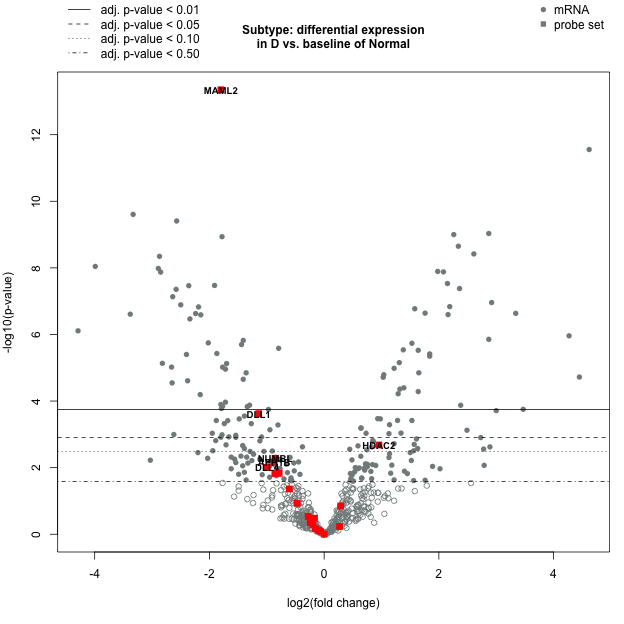
Volcano Plot: SubtypeD
Volcano plot displaying each gene's -log10(p-value) and log2 fold change for the selected covariate. Highly statistically significant genes fall at the top of the plot, and highly differentially expressed genes fall to either side. Genes within the selected gene set are highlighted in blue. Green point colors and horizontal lines indicate various False Discovery Rate (FDR) thresholds.
DE Results - Notch genes - SubtypeD
More Plot Information Download CSV DataProbe Label Log2 fold change std error Lower confidence limit Upper confidence limit P-value BY.p.value Gene.sets Codeset.Name Probe.Label Analyte.Type Is.Control Control.Type Probe.Annotation KEGG.Pathways Cell.Type Official.Gene.Name volcanocol volcanopch tstats.all MAML2-mRNA -1.8 0.176 -2.15 -1.46 4.48e-14 1.78e-10 Notch NS_CANCERPATH_C2535 MAML2 mRNA 0 Notch hsa04330 MAML2 chartreuse1 16 -10.2272727272727 DLL1-mRNA -1.14 0.289 -1.71 -0.575 0.000238 0.0121 Notch NS_CANCERPATH_C2535 DLL1 mRNA 0 Notch hsa04330 DLL1 chartreuse2 16 -3.94463667820069 HDAC2-mRNA 0.956 0.295 0.378 1.53 0.00209 0.0721 CC.PLS.Apop, ChromMod, Notch, TXmisReg NS_CANCERPATH_C2535 HDAC2 mRNA 0 CC.PLS.Apop;TXmisReg;ChromMod;Notch hsa04110;hsa04330;hsa04919;hsa05016;hsa05034;hsa05169;hsa05200;hsa05202;hsa05203;hsa05220 HDAC2 chartreuse3 16 3.24067796610169 NUMBL-mRNA -0.855 0.294 -1.43 -0.28 0.00526 0.146 Notch NS_CANCERPATH_C2535 NUMBL mRNA 0 Notch hsa04330 NUMBL chartreuse4 16 -2.90816326530612 APH1B-mRNA -0.871 0.309 -1.48 -0.265 0.00678 0.175 Notch NS_CANCERPATH_C2535 APH1B mRNA 0 Notch hsa04330;hsa05010 APH1B chartreuse4 16 -2.81877022653722 DLL4-mRNA -0.992 0.37 -1.72 -0.267 0.00979 0.229 Notch NS_CANCERPATH_C2535 DLL4 mRNA 0 Notch hsa04330 DLL4 chartreuse4 16 -2.68108108108108 DTX3-mRNA -0.784 0.311 -1.39 -0.174 0.0149 0.315 Notch NS_CANCERPATH_C2535 DTX3 mRNA 0 Notch hsa04330 DTX3 chartreuse4 16 -2.52090032154341 JAG2-mRNA -0.859 0.342 -1.53 -0.19 0.015 0.315 Notch NS_CANCERPATH_C2535 JAG2 mRNA 0 Notch hsa04330 JAG2 chartreuse4 16 -2.51169590643275 KAT2B-mRNA -0.605 0.292 -1.18 -0.0317 0.0436 0.744 Notch NS_CANCERPATH_C2535 KAT2B mRNA 0 Notch hsa04330;hsa04919;hsa05166;hsa05203 KAT2B azure4 1 -2.07191780821918 JAG1-mRNA -0.469 0.294 -1.05 0.107 0.117 1 Notch NS_CANCERPATH_C2535 JAG1 mRNA 0 Notch hsa04330;hsa04668 JAG1 azure4 1 -1.5952380952381 HDAC1-mRNA 0.288 0.193 -0.0902 0.667 0.142 1 CC.PLS.Apop, ChromMod, Notch, TXmisReg NS_CANCERPATH_C2535 HDAC1 mRNA 0 CC.PLS.Apop;TXmisReg;ChromMod;Notch hsa04110;hsa04330;hsa04919;hsa05016;hsa05031;hsa05034;hsa05169;hsa05200;hsa05202;hsa05203;hsa05206;hsa05220 HDAC1 azure4 1 1.49222797927461 CREBBP-mRNA -0.278 0.261 -0.791 0.234 0.292 1 CC.PLS.Apop, ChromMod, Driver Gene, JAK-STAT, Notch, TGF-B, Wnt NS_CANCERPATH_C2535 CREBBP mRNA 0 CC.PLS.Apop;JAK-STAT;TGF-B;ChromMod;Wnt;Notch;Driver Gene hsa04024;hsa04066;hsa04068;hsa04110;hsa04310;hsa04330;hsa04350;hsa04520;hsa04630;hsa04720;hsa04916;hsa04919;hsa04922;hsa05016;hsa05152;hsa05161;hsa05164;hsa05166;hsa05168;hsa05169;hsa05200;hsa05203;hsa05206;hsa05211;hsa05215 CREBBP azure4 1 -1.06513409961686 EP300-mRNA -0.168 0.171 -0.503 0.166 0.329 1 CC.PLS.Apop, Driver Gene, JAK-STAT, Notch, TGF-B, Wnt NS_CANCERPATH_C2535 EP300 mRNA 0 CC.PLS.Apop;JAK-STAT;TGF-B;Wnt;Notch;Driver Gene hsa04024;hsa04066;hsa04068;hsa04110;hsa04310;hsa04330;hsa04350;hsa04520;hsa04630;hsa04720;hsa04916;hsa04919;hsa04922;hsa05016;hsa05152;hsa05161;hsa05164;hsa05166;hsa05168;hsa05169;hsa05200;hsa05203;hsa05206;hsa05211;hsa05215 EP300 azure4 1 -0.982456140350877 NOTCH2-mRNA -0.241 0.316 -0.86 0.378 0.449 1 Driver Gene, Notch NS_CANCERPATH_C2535 NOTCH2 mRNA 0 Notch;Driver Gene hsa04320;hsa04330;hsa04919;hsa05206 NOTCH2 azure4 1 -0.762658227848101 MFNG-mRNA -0.195 0.303 -0.789 0.4 0.524 1 Notch NS_CANCERPATH_C2535 MFNG mRNA 0 Notch hsa04330 MFNG azure4 1 -0.643564356435644 LFNG-mRNA 0.269 0.491 -0.693 1.23 0.586 1 Notch NS_CANCERPATH_C2535 LFNG mRNA 0 Notch hsa04330 LFNG azure4 1 0.54786150712831 HES1-mRNA -0.153 0.363 -0.863 0.558 0.675 1 Notch NS_CANCERPATH_C2535 HES1 mRNA 0 Notch hsa03460;hsa04330 HES1 azure4 1 -0.421487603305785 NOTCH3-mRNA -0.102 0.334 -0.756 0.552 0.761 1 Notch NS_CANCERPATH_C2535 NOTCH3 mRNA 0 Notch hsa04320;hsa04330;hsa04919;hsa05206 NOTCH3 azure4 1 -0.305389221556886 NOTCH1-mRNA -0.0653 0.286 -0.626 0.496 0.821 1 Driver Gene, Notch NS_CANCERPATH_C2535 NOTCH1 mRNA 0 Notch;Driver Gene hsa04320;hsa04330;hsa04919;hsa05020;hsa05206 NOTCH1 azure4 1 -0.228321678321678 DTX4-mRNA 0.000862 0.498 -0.975 0.977 0.999 1 Notch NS_CANCERPATH_C2535 DTX4 mRNA 0 Notch hsa04330 DTX4 azure4 1 0.00173092369477912 DE Results - Notch genes - SubtypeD
Table displaying each sample's global significance scores and directed global significance scores as defined in the heatmaps above. The global significance score is calculated as the square root of the mean squared t-statistic for the genes in a gene set, with t-statistics coming from the linear regression underlying our differential expression analysis. The directed global significance score is calculated as the square root of the mean signed squared t-statistic for the genes in a gene set, with t-statistics coming from the linear regression underlying our differential expression analysis.
- Subtype:
- SubtypeA
- SubtypeB
- SubtypeC
- SubtypeD
Volcano Plot: SubtypeA
More Plot Information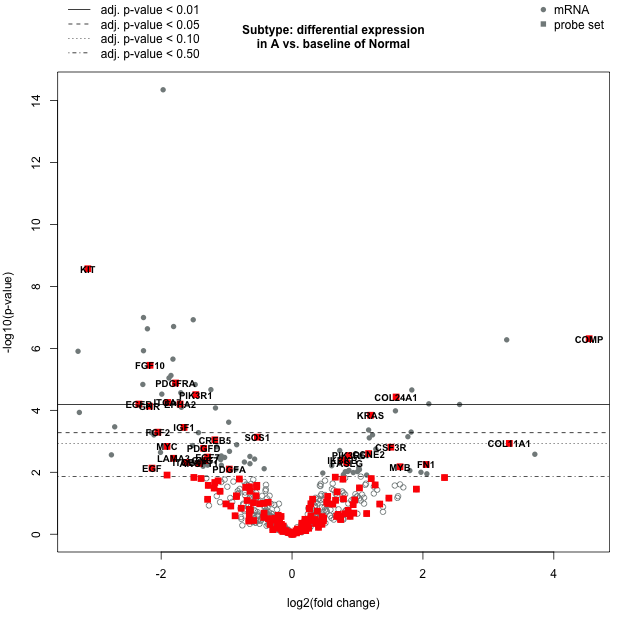
Volcano Plot: SubtypeA
Volcano plot displaying each gene's -log10(p-value) and log2 fold change for the selected covariate. Highly statistically significant genes fall at the top of the plot, and highly differentially expressed genes fall to either side. Genes within the selected gene set are highlighted in blue. Green point colors and horizontal lines indicate various False Discovery Rate (FDR) thresholds.
DE Results - PI3K genes - SubtypeA
More Plot Information Download CSV DataProbe Label Log2 fold change std error Lower confidence limit Upper confidence limit P-value BY.p.value Gene.sets Codeset.Name Probe.Label Analyte.Type Is.Control Control.Type Probe.Annotation KEGG.Pathways Cell.Type Official.Gene.Name volcanocol volcanopch tstats.all KIT-mRNA -3.12 0.436 -3.98 -2.27 2.68e-09 5.33e-06 Driver Gene, PI3K, RAS NS_CANCERPATH_C2535 KIT mRNA 0 RAS;PI3K;Driver Gene hsa04014;hsa04015;hsa04060;hsa04072;hsa04144;hsa04151;hsa04640;hsa04916;hsa05200;hsa05221;hsa05230 KIT chartreuse1 16 -7.15596330275229 COMP-mRNA 4.54 0.791 2.99 6.09 4.86e-07 0.000263 PI3K NS_CANCERPATH_C2535 COMP mRNA 0 PI3K hsa04145;hsa04151;hsa04510;hsa04512;hsa05144 COMP chartreuse1 16 5.73957016434893 FGF10-mRNA -2.17 0.418 -2.99 -1.35 3.51e-06 0.00116 MAPK, PI3K, RAS NS_CANCERPATH_C2535 FGF10 mRNA 0 RAS;PI3K;MAPK hsa04010;hsa04014;hsa04015;hsa04151;hsa04810;hsa05200;hsa05218 FGF10 chartreuse1 16 -5.19138755980861 PDGFRA-mRNA -1.78 0.369 -2.5 -1.05 1.31e-05 0.00345 Driver Gene, MAPK, PI3K, RAS NS_CANCERPATH_C2535 PDGFRA mRNA 0 RAS;PI3K;MAPK;Driver Gene hsa04010;hsa04014;hsa04015;hsa04020;hsa04060;hsa04072;hsa04144;hsa04151;hsa04510;hsa04540;hsa04810;hsa05166;hsa05200;hsa05206;hsa05214;hsa05215;hsa05218;hsa05230;hsa05231 PDGFRA chartreuse1 16 -4.82384823848238 PIK3R1-mRNA -1.47 0.322 -2.1 -0.838 3.11e-05 0.00562 CC.PLS.Apop, Driver Gene, JAK-STAT, PI3K, RAS NS_CANCERPATH_C2535 PIK3R1 mRNA 0 CC.PLS.Apop;RAS;PI3K;JAK-STAT;Driver Gene hsa04012;hsa04014;hsa04015;hsa04022;hsa04024;hsa04062;hsa04066;hsa04068;hsa04070;hsa04071;hsa04072;hsa04150;hsa04151;hsa04152;hsa04210;hsa04211;hsa04261;hsa04370;hsa04380;hsa04510;hsa04550;hsa04611;hsa04620;hsa04630;hsa04650;hsa04660;hsa04662;hsa04664;hsa04666;hsa04668;hsa04670;hsa04722;hsa04725;hsa04750;hsa04810;hsa04910;hsa04914;hsa04915;hsa04917;hsa04919;hsa04921;hsa04923;hsa04930;hsa04931;hsa04932;hsa04933;hsa04960;hsa04973;hsa05100;hsa05142;hsa05145;hsa05146;hsa05160;hsa05161;hsa05162;hsa05164;hsa05166;hsa05169;hsa05200;hsa05203;hsa05205;hsa05210;hsa05211;hsa05212;hsa05213;hsa05214;hsa05215;hsa05218;hsa05220;hsa05221;hsa05222;hsa05223;hsa05230;hsa05231 PIK3R1 chartreuse1 16 -4.56521739130435 COL24A1-mRNA 1.59 0.351 0.897 2.27 3.71e-05 0.00642 PI3K NS_CANCERPATH_C2535 COL24A1 mRNA 0 PI3K hsa04974 COL24A1 chartreuse1 16 4.52991452991453 ITGA7-mRNA -1.9 0.432 -2.75 -1.05 5.56e-05 0.0092 PI3K NS_CANCERPATH_C2535 ITGA7 mRNA 0 PI3K hsa04151;hsa04510;hsa04512;hsa04810;hsa05410;hsa05412;hsa05414 ITGA7 chartreuse1 16 -4.39814814814815 EPHA2-mRNA -1.71 0.393 -2.49 -0.943 6.26e-05 0.0092 PI3K, RAS NS_CANCERPATH_C2535 EPHA2 mRNA 0 RAS;PI3K hsa04014;hsa04015;hsa04151;hsa04360 EPHA2 chartreuse1 16 -4.35114503816794 EGFR-mRNA -2.34 0.537 -3.39 -1.29 6.27e-05 0.0092 Driver Gene, MAPK, PI3K, RAS NS_CANCERPATH_C2535 EGFR mRNA 0 RAS;PI3K;MAPK;Driver Gene hsa04010;hsa04012;hsa04014;hsa04015;hsa04020;hsa04060;hsa04066;hsa04068;hsa04072;hsa04144;hsa04151;hsa04320;hsa04510;hsa04520;hsa04540;hsa04810;hsa04912;hsa04915;hsa04921;hsa05120;hsa05160;hsa05200;hsa05205;hsa05206;hsa05212;hsa05213;hsa05214;hsa05215;hsa05218;hsa05219;hsa05223;hsa05230;hsa05231 EGFR chartreuse1 16 -4.35754189944134 GHR-mRNA -2.18 0.507 -3.18 -1.19 7.34e-05 0.0101 JAK-STAT, PI3K NS_CANCERPATH_C2535 GHR mRNA 0 PI3K;JAK-STAT hsa04060;hsa04080;hsa04151;hsa04630 GHR chartreuse2 16 -4.29980276134122 KRAS-mRNA 1.2 0.292 0.625 1.77 0.000144 0.0168 Driver Gene, MAPK, PI3K, RAS NS_CANCERPATH_C2535 KRAS mRNA 0 RAS;PI3K;MAPK;Driver Gene hsa04010;hsa04012;hsa04014;hsa04015;hsa04062;hsa04068;hsa04071;hsa04072;hsa04151;hsa04211;hsa04320;hsa04360;hsa04370;hsa04530;hsa04540;hsa04550;hsa04650;hsa04660;hsa04662;hsa04664;hsa04720;hsa04722;hsa04725;hsa04726;hsa04730;hsa04810;hsa04910;hsa04912;hsa04914;hsa04915;hsa04916;hsa04917;hsa04919;hsa04921;hsa04933;hsa04960;hsa05034;hsa05160;hsa05161;hsa05166;hsa05200;hsa05203;hsa05205;hsa05206;hsa05210;hsa05211;hsa05212;hsa05213;hsa05214;hsa05215;hsa05216;hsa05218;hsa05219;hsa05220;hsa05221;hsa05223;hsa05230;hsa05231 KRAS chartreuse2 16 4.10958904109589 IGF1-mRNA -1.65 0.431 -2.49 -0.802 0.000355 0.0382 PI3K, RAS, TXmisReg NS_CANCERPATH_C2535 IGF1 mRNA 0 RAS;PI3K;TXmisReg hsa04014;hsa04015;hsa04066;hsa04068;hsa04114;hsa04115;hsa04150;hsa04151;hsa04152;hsa04211;hsa04510;hsa04550;hsa04730;hsa04750;hsa04913;hsa04914;hsa04960;hsa05200;hsa05202;hsa05205;hsa05214;hsa05215;hsa05218;hsa05410;hsa05414 IGF1 chartreuse2 16 -3.82830626450116 FGF2-mRNA -2.05 0.554 -3.14 -0.968 0.000506 0.0497 MAPK, PI3K, RAS NS_CANCERPATH_C2535 FGF2 mRNA 0 RAS;PI3K;MAPK hsa04010;hsa04014;hsa04015;hsa04151;hsa04550;hsa04810;hsa05200;hsa05205;hsa05218 FGF2 chartreuse2 16 -3.70036101083032 SOS1-mRNA -0.53 0.148 -0.819 -0.241 0.000733 0.0634 JAK-STAT, MAPK, PI3K, RAS NS_CANCERPATH_C2535 SOS1 mRNA 0 RAS;PI3K;JAK-STAT;MAPK hsa04010;hsa04012;hsa04014;hsa04062;hsa04068;hsa04072;hsa04151;hsa04320;hsa04510;hsa04540;hsa04630;hsa04650;hsa04660;hsa04662;hsa04664;hsa04722;hsa04810;hsa04910;hsa04912;hsa04915;hsa04917;hsa05034;hsa05160;hsa05200;hsa05205;hsa05206;hsa05211;hsa05213;hsa05214;hsa05215;hsa05220;hsa05221;hsa05223;hsa05231 SOS1 chartreuse3 16 -3.58108108108108 CREB5-mRNA -1.18 0.335 -1.83 -0.523 0.000895 0.0742 PI3K NS_CANCERPATH_C2535 CREB5 mRNA 0 PI3K hsa04022;hsa04024;hsa04151;hsa04152;hsa04211;hsa04261;hsa04668;hsa04725;hsa04728;hsa04911;hsa04915;hsa04918;hsa04922;hsa04925;hsa04931;hsa04962;hsa05016;hsa05030;hsa05031;hsa05034;hsa05161;hsa05203;hsa05215 CREB5 chartreuse3 16 -3.52238805970149 COL11A1-mRNA 3.32 0.966 1.42 5.21 0.00117 0.0952 PI3K NS_CANCERPATH_C2535 COL11A1 mRNA 0 PI3K hsa04974 COL11A1 chartreuse4 16 3.43685300207039 MYC-mRNA -1.91 0.567 -3.02 -0.794 0.00146 0.112 CC.PLS.Apop, JAK-STAT, MAPK, PI3K, TGF-B, TXmisReg, Wnt NS_CANCERPATH_C2535 MYC mRNA 0 CC.PLS.Apop;PI3K;JAK-STAT;MAPK;TGF-B;TXmisReg;Wnt hsa04010;hsa04012;hsa04110;hsa04151;hsa04310;hsa04350;hsa04390;hsa04550;hsa04630;hsa04919;hsa05161;hsa05166;hsa05169;hsa05200;hsa05202;hsa05205;hsa05206;hsa05210;hsa05213;hsa05216;hsa05219;hsa05220;hsa05221;hsa05222;hsa05230 MYC chartreuse4 16 -3.36860670194004 CSF3R-mRNA 1.51 0.453 0.627 2.4 0.00155 0.114 JAK-STAT, PI3K NS_CANCERPATH_C2535 CSF3R mRNA 0 PI3K;JAK-STAT hsa04060;hsa04151;hsa04630;hsa04640;hsa05200 Neutrophils CSF3R chartreuse4 16 3.33333333333333 PDGFD-mRNA -1.35 0.409 -2.15 -0.552 0.00169 0.123 PI3K, RAS NS_CANCERPATH_C2535 PDGFD mRNA 0 RAS;PI3K hsa04014;hsa04015;hsa04072;hsa04151;hsa04510;hsa04540;hsa04810;hsa05215;hsa05218;hsa05231 PDGFD chartreuse4 16 -3.30073349633252 CCNE2-mRNA 1.17 0.368 0.448 1.89 0.00249 0.165 CC.PLS.Apop, PI3K NS_CANCERPATH_C2535 CCNE2 mRNA 0 CC.PLS.Apop;PI3K hsa04110;hsa04114;hsa04115;hsa04151;hsa05161;hsa05162;hsa05200;hsa05203;hsa05206;hsa05215;hsa05222 CCNE2 chartreuse4 16 3.17934782608696 DE Results - PI3K genes - SubtypeA
Table displaying each sample's global significance scores and directed global significance scores as defined in the heatmaps above. The global significance score is calculated as the square root of the mean squared t-statistic for the genes in a gene set, with t-statistics coming from the linear regression underlying our differential expression analysis. The directed global significance score is calculated as the square root of the mean signed squared t-statistic for the genes in a gene set, with t-statistics coming from the linear regression underlying our differential expression analysis.
Volcano Plot: SubtypeB
More Plot Information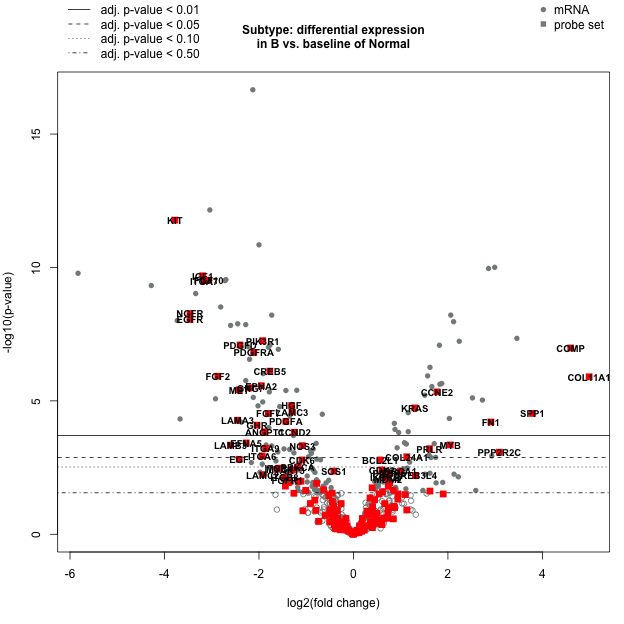
Volcano Plot: SubtypeB
Volcano plot displaying each gene's -log10(p-value) and log2 fold change for the selected covariate. Highly statistically significant genes fall at the top of the plot, and highly differentially expressed genes fall to either side. Genes within the selected gene set are highlighted in blue. Green point colors and horizontal lines indicate various False Discovery Rate (FDR) thresholds.
DE Results - PI3K genes - SubtypeB
More Plot Information Download CSV DataProbe Label Log2 fold change std error Lower confidence limit Upper confidence limit P-value BY.p.value Gene.sets Codeset.Name Probe.Label Analyte.Type Is.Control Control.Type Probe.Annotation KEGG.Pathways Cell.Type Official.Gene.Name volcanocol volcanopch tstats.all KIT-mRNA -3.78 0.41 -4.58 -2.97 1.68e-12 2.22e-09 Driver Gene, PI3K, RAS NS_CANCERPATH_C2535 KIT mRNA 0 RAS;PI3K;Driver Gene hsa04014;hsa04015;hsa04060;hsa04072;hsa04144;hsa04151;hsa04640;hsa04916;hsa05200;hsa05221;hsa05230 KIT chartreuse1 16 -9.21951219512195 IGF1-mRNA -3.19 0.406 -3.99 -2.4 2.05e-10 1.01e-07 PI3K, RAS, TXmisReg NS_CANCERPATH_C2535 IGF1 mRNA 0 RAS;PI3K;TXmisReg hsa04014;hsa04015;hsa04066;hsa04068;hsa04114;hsa04115;hsa04150;hsa04151;hsa04152;hsa04211;hsa04510;hsa04550;hsa04730;hsa04750;hsa04913;hsa04914;hsa04960;hsa05200;hsa05202;hsa05205;hsa05214;hsa05215;hsa05218;hsa05410;hsa05414 IGF1 chartreuse1 16 -7.85714285714286 FGF10-mRNA -3.06 0.394 -3.83 -2.29 2.99e-10 1.01e-07 MAPK, PI3K, RAS NS_CANCERPATH_C2535 FGF10 mRNA 0 RAS;PI3K;MAPK hsa04010;hsa04014;hsa04015;hsa04151;hsa04810;hsa05200;hsa05218 FGF10 chartreuse1 16 -7.76649746192893 ITGA7-mRNA -3.16 0.407 -3.96 -2.36 3.14e-10 1.01e-07 PI3K NS_CANCERPATH_C2535 ITGA7 mRNA 0 PI3K hsa04151;hsa04510;hsa04512;hsa04810;hsa05410;hsa05412;hsa05414 ITGA7 chartreuse1 16 -7.76412776412776 NGFR-mRNA -3.46 0.495 -4.43 -2.49 5.34e-09 1.25e-06 PI3K, RAS, TXmisReg NS_CANCERPATH_C2535 NGFR mRNA 0 RAS;PI3K;TXmisReg hsa04014;hsa04015;hsa04060;hsa04151;hsa04722;hsa05202 NGFR chartreuse1 16 -6.98989898989899 EGFR-mRNA -3.46 0.506 -4.46 -2.47 8.82e-09 1.75e-06 Driver Gene, MAPK, PI3K, RAS NS_CANCERPATH_C2535 EGFR mRNA 0 RAS;PI3K;MAPK;Driver Gene hsa04010;hsa04012;hsa04014;hsa04015;hsa04020;hsa04060;hsa04066;hsa04068;hsa04072;hsa04144;hsa04151;hsa04320;hsa04510;hsa04520;hsa04540;hsa04810;hsa04912;hsa04915;hsa04921;hsa05120;hsa05160;hsa05200;hsa05205;hsa05206;hsa05212;hsa05213;hsa05214;hsa05215;hsa05218;hsa05219;hsa05223;hsa05230;hsa05231 EGFR chartreuse1 16 -6.83794466403162 PIK3R1-mRNA -1.92 0.303 -2.52 -1.33 5.54e-08 8.16e-06 CC.PLS.Apop, Driver Gene, JAK-STAT, PI3K, RAS NS_CANCERPATH_C2535 PIK3R1 mRNA 0 CC.PLS.Apop;RAS;PI3K;JAK-STAT;Driver Gene hsa04012;hsa04014;hsa04015;hsa04022;hsa04024;hsa04062;hsa04066;hsa04068;hsa04070;hsa04071;hsa04072;hsa04150;hsa04151;hsa04152;hsa04210;hsa04211;hsa04261;hsa04370;hsa04380;hsa04510;hsa04550;hsa04611;hsa04620;hsa04630;hsa04650;hsa04660;hsa04662;hsa04664;hsa04666;hsa04668;hsa04670;hsa04722;hsa04725;hsa04750;hsa04810;hsa04910;hsa04914;hsa04915;hsa04917;hsa04919;hsa04921;hsa04923;hsa04930;hsa04931;hsa04932;hsa04933;hsa04960;hsa04973;hsa05100;hsa05142;hsa05145;hsa05146;hsa05160;hsa05161;hsa05162;hsa05164;hsa05166;hsa05169;hsa05200;hsa05203;hsa05205;hsa05210;hsa05211;hsa05212;hsa05213;hsa05214;hsa05215;hsa05218;hsa05220;hsa05221;hsa05222;hsa05223;hsa05230;hsa05231 PIK3R1 chartreuse1 16 -6.33663366336634 PDGFD-mRNA -2.4 0.385 -3.16 -1.65 8.03e-08 1.06e-05 PI3K, RAS NS_CANCERPATH_C2535 PDGFD mRNA 0 RAS;PI3K hsa04014;hsa04015;hsa04072;hsa04151;hsa04510;hsa04540;hsa04810;hsa05215;hsa05218;hsa05231 PDGFD chartreuse1 16 -6.23376623376623 COMP-mRNA 4.6 0.745 3.14 6.06 1.04e-07 1.21e-05 PI3K NS_CANCERPATH_C2535 COMP mRNA 0 PI3K hsa04145;hsa04151;hsa04510;hsa04512;hsa05144 COMP chartreuse1 16 6.1744966442953 PDGFRA-mRNA -2.11 0.348 -2.79 -1.43 1.53e-07 1.69e-05 Driver Gene, MAPK, PI3K, RAS NS_CANCERPATH_C2535 PDGFRA mRNA 0 RAS;PI3K;MAPK;Driver Gene hsa04010;hsa04014;hsa04015;hsa04020;hsa04060;hsa04072;hsa04144;hsa04151;hsa04510;hsa04540;hsa04810;hsa05166;hsa05200;hsa05206;hsa05214;hsa05215;hsa05218;hsa05230;hsa05231 PDGFRA chartreuse1 16 -6.0632183908046 CREB5-mRNA -1.77 0.315 -2.39 -1.15 7.69e-07 7.65e-05 PI3K NS_CANCERPATH_C2535 CREB5 mRNA 0 PI3K hsa04022;hsa04024;hsa04151;hsa04152;hsa04211;hsa04261;hsa04668;hsa04725;hsa04728;hsa04911;hsa04915;hsa04918;hsa04922;hsa04925;hsa04931;hsa04962;hsa05016;hsa05030;hsa05031;hsa05034;hsa05161;hsa05203;hsa05215 CREB5 chartreuse1 16 -5.61904761904762 FGF2-mRNA -2.87 0.522 -3.89 -1.84 1.19e-06 0.00011 MAPK, PI3K, RAS NS_CANCERPATH_C2535 FGF2 mRNA 0 RAS;PI3K;MAPK hsa04010;hsa04014;hsa04015;hsa04151;hsa04550;hsa04810;hsa05200;hsa05205;hsa05218 FGF2 chartreuse1 16 -5.49808429118774 COL11A1-mRNA 4.99 0.91 3.21 6.77 1.25e-06 0.000113 PI3K NS_CANCERPATH_C2535 COL11A1 mRNA 0 PI3K hsa04974 COL11A1 chartreuse1 16 5.48351648351648 EPHA2-mRNA -1.95 0.371 -2.68 -1.23 2.7e-06 0.000224 PI3K, RAS NS_CANCERPATH_C2535 EPHA2 mRNA 0 RAS;PI3K hsa04014;hsa04015;hsa04151;hsa04360 EPHA2 chartreuse1 16 -5.25606469002695 GNG7-mRNA -2.18 0.418 -3 -1.36 3.25e-06 0.000259 PI3K, RAS NS_CANCERPATH_C2535 GNG7 mRNA 0 RAS;PI3K hsa04014;hsa04062;hsa04151;hsa04713;hsa04723;hsa04724;hsa04725;hsa04726;hsa04727;hsa04728;hsa04740;hsa05032;hsa05034;hsa05200 GNG7 chartreuse1 16 -5.21531100478469 MET-mRNA -2.42 0.469 -3.34 -1.5 3.85e-06 0.000295 Driver Gene, PI3K, RAS, TXmisReg NS_CANCERPATH_C2535 MET mRNA 0 RAS;PI3K;TXmisReg;Driver Gene hsa04014;hsa04015;hsa04060;hsa04144;hsa04151;hsa04360;hsa04510;hsa04520;hsa05100;hsa05120;hsa05144;hsa05200;hsa05202;hsa05205;hsa05206;hsa05211;hsa05218;hsa05230 MET chartreuse1 16 -5.15991471215352 CCNE2-mRNA 1.77 0.347 1.09 2.45 4.61e-06 0.000328 CC.PLS.Apop, PI3K NS_CANCERPATH_C2535 CCNE2 mRNA 0 CC.PLS.Apop;PI3K hsa04110;hsa04114;hsa04115;hsa04151;hsa05161;hsa05162;hsa05200;hsa05203;hsa05206;hsa05215;hsa05222 CCNE2 chartreuse1 16 5.10086455331412 HGF-mRNA -1.31 0.274 -1.84 -0.771 1.5e-05 0.000949 PI3K, RAS NS_CANCERPATH_C2535 HGF mRNA 0 RAS;PI3K hsa04014;hsa04015;hsa04060;hsa04151;hsa04510;hsa05144;hsa05200;hsa05205;hsa05211;hsa05218 HGF chartreuse1 16 -4.78102189781022 KRAS-mRNA 1.3 0.275 0.757 1.83 1.84e-05 0.00111 Driver Gene, MAPK, PI3K, RAS NS_CANCERPATH_C2535 KRAS mRNA 0 RAS;PI3K;MAPK;Driver Gene hsa04010;hsa04012;hsa04014;hsa04015;hsa04062;hsa04068;hsa04071;hsa04072;hsa04151;hsa04211;hsa04320;hsa04360;hsa04370;hsa04530;hsa04540;hsa04550;hsa04650;hsa04660;hsa04662;hsa04664;hsa04720;hsa04722;hsa04725;hsa04726;hsa04730;hsa04810;hsa04910;hsa04912;hsa04914;hsa04915;hsa04916;hsa04917;hsa04919;hsa04921;hsa04933;hsa04960;hsa05034;hsa05160;hsa05161;hsa05166;hsa05200;hsa05203;hsa05205;hsa05206;hsa05210;hsa05211;hsa05212;hsa05213;hsa05214;hsa05215;hsa05216;hsa05218;hsa05219;hsa05220;hsa05221;hsa05223;hsa05230;hsa05231 KRAS chartreuse1 16 4.72727272727273 LAMC3-mRNA -1.3 0.281 -1.85 -0.746 2.58e-05 0.00153 PI3K NS_CANCERPATH_C2535 LAMC3 mRNA 0 PI3K hsa04151;hsa04510;hsa04512;hsa05145;hsa05146;hsa05200;hsa05222 LAMC3 chartreuse1 16 -4.62633451957295 DE Results - PI3K genes - SubtypeB
Table displaying each sample's global significance scores and directed global significance scores as defined in the heatmaps above. The global significance score is calculated as the square root of the mean squared t-statistic for the genes in a gene set, with t-statistics coming from the linear regression underlying our differential expression analysis. The directed global significance score is calculated as the square root of the mean signed squared t-statistic for the genes in a gene set, with t-statistics coming from the linear regression underlying our differential expression analysis.
Volcano Plot: SubtypeC
More Plot Information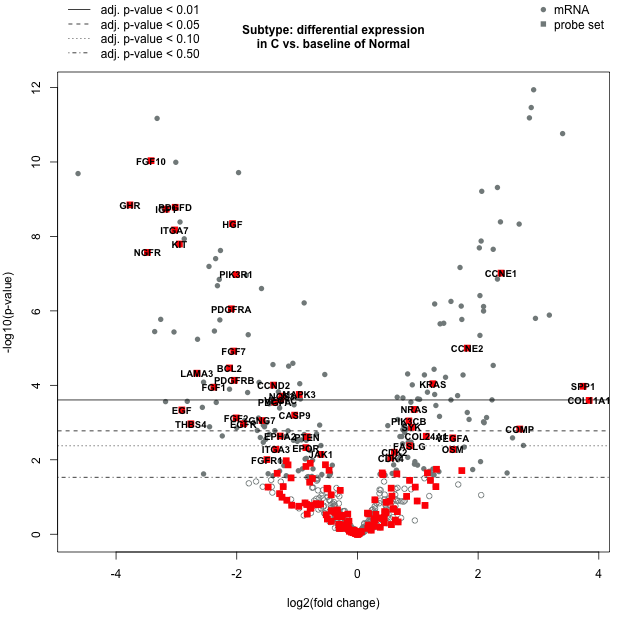
Volcano Plot: SubtypeC
Volcano plot displaying each gene's -log10(p-value) and log2 fold change for the selected covariate. Highly statistically significant genes fall at the top of the plot, and highly differentially expressed genes fall to either side. Genes within the selected gene set are highlighted in blue. Green point colors and horizontal lines indicate various False Discovery Rate (FDR) thresholds.
DE Results - PI3K genes - SubtypeC
More Plot Information Download CSV DataProbe Label Log2 fold change std error Lower confidence limit Upper confidence limit P-value BY.p.value Gene.sets Codeset.Name Probe.Label Analyte.Type Is.Control Control.Type Probe.Annotation KEGG.Pathways Cell.Type Official.Gene.Name volcanocol volcanopch tstats.all FGF10-mRNA -3.42 0.423 -4.25 -2.59 9.23e-11 5.8e-08 MAPK, PI3K, RAS NS_CANCERPATH_C2535 FGF10 mRNA 0 RAS;PI3K;MAPK hsa04010;hsa04014;hsa04015;hsa04151;hsa04810;hsa05200;hsa05218 FGF10 chartreuse1 16 -8.08510638297872 GHR-mRNA -3.77 0.514 -4.78 -2.76 1.42e-09 4.69e-07 JAK-STAT, PI3K NS_CANCERPATH_C2535 GHR mRNA 0 PI3K;JAK-STAT hsa04060;hsa04080;hsa04151;hsa04630 GHR chartreuse1 16 -7.33463035019455 PDGFD-mRNA -3.02 0.414 -3.83 -2.21 1.65e-09 4.92e-07 PI3K, RAS NS_CANCERPATH_C2535 PDGFD mRNA 0 RAS;PI3K hsa04014;hsa04015;hsa04072;hsa04151;hsa04510;hsa04540;hsa04810;hsa05215;hsa05218;hsa05231 PDGFD chartreuse1 16 -7.29468599033816 IGF1-mRNA -3.17 0.436 -4.03 -2.32 1.85e-09 4.92e-07 PI3K, RAS, TXmisReg NS_CANCERPATH_C2535 IGF1 mRNA 0 RAS;PI3K;TXmisReg hsa04014;hsa04015;hsa04066;hsa04068;hsa04114;hsa04115;hsa04150;hsa04151;hsa04152;hsa04211;hsa04510;hsa04550;hsa04730;hsa04750;hsa04913;hsa04914;hsa04960;hsa05200;hsa05202;hsa05205;hsa05214;hsa05215;hsa05218;hsa05410;hsa05414 IGF1 chartreuse1 16 -7.27064220183486 HGF-mRNA -2.07 0.294 -2.64 -1.49 4.53e-09 9.76e-07 PI3K, RAS NS_CANCERPATH_C2535 HGF mRNA 0 RAS;PI3K hsa04014;hsa04015;hsa04060;hsa04151;hsa04510;hsa05144;hsa05200;hsa05205;hsa05211;hsa05218 HGF chartreuse1 16 -7.04081632653061 ITGA7-mRNA -3.03 0.438 -3.89 -2.17 6.69e-09 1.33e-06 PI3K NS_CANCERPATH_C2535 ITGA7 mRNA 0 PI3K hsa04151;hsa04510;hsa04512;hsa04810;hsa05410;hsa05412;hsa05414 ITGA7 chartreuse1 16 -6.91780821917808 KIT-mRNA -2.95 0.441 -3.81 -2.08 1.6e-08 2.76e-06 Driver Gene, PI3K, RAS NS_CANCERPATH_C2535 KIT mRNA 0 RAS;PI3K;Driver Gene hsa04014;hsa04015;hsa04060;hsa04072;hsa04144;hsa04151;hsa04640;hsa04916;hsa05200;hsa05221;hsa05230 KIT chartreuse1 16 -6.68934240362812 NGFR-mRNA -3.48 0.533 -4.53 -2.44 2.68e-08 3.94e-06 PI3K, RAS, TXmisReg NS_CANCERPATH_C2535 NGFR mRNA 0 RAS;PI3K;TXmisReg hsa04014;hsa04015;hsa04060;hsa04151;hsa04722;hsa05202 NGFR chartreuse1 16 -6.52908067542214 CCNE1-mRNA 2.38 0.384 1.62 3.13 9.66e-08 1.24e-05 CC.PLS.Apop, PI3K NS_CANCERPATH_C2535 CCNE1 mRNA 0 CC.PLS.Apop;PI3K hsa04110;hsa04114;hsa04115;hsa04151;hsa05161;hsa05162;hsa05200;hsa05203;hsa05206;hsa05215;hsa05222 CCNE1 chartreuse1 16 6.19791666666667 PIK3R1-mRNA -2.01 0.326 -2.65 -1.37 1.06e-07 1.31e-05 CC.PLS.Apop, Driver Gene, JAK-STAT, PI3K, RAS NS_CANCERPATH_C2535 PIK3R1 mRNA 0 CC.PLS.Apop;RAS;PI3K;JAK-STAT;Driver Gene hsa04012;hsa04014;hsa04015;hsa04022;hsa04024;hsa04062;hsa04066;hsa04068;hsa04070;hsa04071;hsa04072;hsa04150;hsa04151;hsa04152;hsa04210;hsa04211;hsa04261;hsa04370;hsa04380;hsa04510;hsa04550;hsa04611;hsa04620;hsa04630;hsa04650;hsa04660;hsa04662;hsa04664;hsa04666;hsa04668;hsa04670;hsa04722;hsa04725;hsa04750;hsa04810;hsa04910;hsa04914;hsa04915;hsa04917;hsa04919;hsa04921;hsa04923;hsa04930;hsa04931;hsa04932;hsa04933;hsa04960;hsa04973;hsa05100;hsa05142;hsa05145;hsa05146;hsa05160;hsa05161;hsa05162;hsa05164;hsa05166;hsa05169;hsa05200;hsa05203;hsa05205;hsa05210;hsa05211;hsa05212;hsa05213;hsa05214;hsa05215;hsa05218;hsa05220;hsa05221;hsa05222;hsa05223;hsa05230;hsa05231 PIK3R1 chartreuse1 16 -6.16564417177914 PDGFRA-mRNA -2.09 0.374 -2.82 -1.35 8.8e-07 7.95e-05 Driver Gene, MAPK, PI3K, RAS NS_CANCERPATH_C2535 PDGFRA mRNA 0 RAS;PI3K;MAPK;Driver Gene hsa04010;hsa04014;hsa04015;hsa04020;hsa04060;hsa04072;hsa04144;hsa04151;hsa04510;hsa04540;hsa04810;hsa05166;hsa05200;hsa05206;hsa05214;hsa05215;hsa05218;hsa05230;hsa05231 PDGFRA chartreuse1 16 -5.58823529411765 CCNE2-mRNA 1.82 0.373 1.09 2.55 1e-05 0.000675 CC.PLS.Apop, PI3K NS_CANCERPATH_C2535 CCNE2 mRNA 0 CC.PLS.Apop;PI3K hsa04110;hsa04114;hsa04115;hsa04151;hsa05161;hsa05162;hsa05200;hsa05203;hsa05206;hsa05215;hsa05222 CCNE2 chartreuse1 16 4.87935656836461 FGF7-mRNA -2.05 0.424 -2.88 -1.22 1.2e-05 0.000794 MAPK, PI3K, RAS NS_CANCERPATH_C2535 FGF7 mRNA 0 RAS;PI3K;MAPK hsa04010;hsa04014;hsa04015;hsa04151;hsa04810;hsa05200;hsa05218 FGF7 chartreuse1 16 -4.83490566037736 BCL2-mRNA -2.12 0.467 -3.04 -1.2 3.41e-05 0.00208 CC.PLS.Apop, Driver Gene, PI3K NS_CANCERPATH_C2535 BCL2 mRNA 0 CC.PLS.Apop;PI3K;Driver Gene hsa04064;hsa04066;hsa04071;hsa04141;hsa04151;hsa04210;hsa04261;hsa04510;hsa04630;hsa04722;hsa04725;hsa04933;hsa05014;hsa05145;hsa05152;hsa05161;hsa05169;hsa05200;hsa05206;hsa05210;hsa05215;hsa05222 BCL2 chartreuse1 16 -4.53961456102784 LAMA3-mRNA -2.66 0.598 -3.83 -1.48 4.72e-05 0.0028 PI3K NS_CANCERPATH_C2535 LAMA3 mRNA 0 PI3K hsa04151;hsa04510;hsa04512;hsa05145;hsa05146;hsa05200;hsa05222 LAMA3 chartreuse1 16 -4.44816053511706 PDGFRB-mRNA -2.04 0.473 -2.97 -1.11 7.32e-05 0.00399 MAPK, PI3K, RAS NS_CANCERPATH_C2535 PDGFRB mRNA 0 RAS;PI3K;MAPK hsa04010;hsa04014;hsa04015;hsa04020;hsa04060;hsa04072;hsa04151;hsa04510;hsa04540;hsa04810;hsa05166;hsa05200;hsa05206;hsa05214;hsa05215;hsa05218;hsa05230;hsa05231 PDGFRB chartreuse1 16 -4.31289640591966 KRAS-mRNA 1.25 0.296 0.675 1.83 9.06e-05 0.00468 Driver Gene, MAPK, PI3K, RAS NS_CANCERPATH_C2535 KRAS mRNA 0 RAS;PI3K;MAPK;Driver Gene hsa04010;hsa04012;hsa04014;hsa04015;hsa04062;hsa04068;hsa04071;hsa04072;hsa04151;hsa04211;hsa04320;hsa04360;hsa04370;hsa04530;hsa04540;hsa04550;hsa04650;hsa04660;hsa04662;hsa04664;hsa04720;hsa04722;hsa04725;hsa04726;hsa04730;hsa04810;hsa04910;hsa04912;hsa04914;hsa04915;hsa04916;hsa04917;hsa04919;hsa04921;hsa04933;hsa04960;hsa05034;hsa05160;hsa05161;hsa05166;hsa05200;hsa05203;hsa05205;hsa05206;hsa05210;hsa05211;hsa05212;hsa05213;hsa05214;hsa05215;hsa05216;hsa05218;hsa05219;hsa05220;hsa05221;hsa05223;hsa05230;hsa05231 KRAS chartreuse1 16 4.22297297297297 CCND2-mRNA -1.39 0.329 -2.03 -0.744 9.86e-05 0.00497 CC.PLS.Apop, JAK-STAT, PI3K, TXmisReg, Wnt NS_CANCERPATH_C2535 CCND2 mRNA 0 CC.PLS.Apop;PI3K;JAK-STAT;TXmisReg;Wnt hsa04068;hsa04110;hsa04115;hsa04151;hsa04310;hsa04390;hsa04510;hsa04630;hsa04917;hsa05162;hsa05166;hsa05202;hsa05203;hsa05206 CCND2 chartreuse1 16 -4.22492401215805 SPP1-mRNA 3.74 0.89 1.99 5.48 0.000106 0.00525 PI3K NS_CANCERPATH_C2535 SPP1 mRNA 0 PI3K hsa04151;hsa04510;hsa04512;hsa04620 SPP1 chartreuse1 16 4.20224719101124 FGF1-mRNA -2.38 0.569 -3.49 -1.26 0.000112 0.00549 MAPK, PI3K, RAS NS_CANCERPATH_C2535 FGF1 mRNA 0 RAS;PI3K;MAPK hsa04010;hsa04014;hsa04015;hsa04151;hsa04390;hsa04810;hsa05200;hsa05218 FGF1 chartreuse1 16 -4.18277680140598 DE Results - PI3K genes - SubtypeC
Table displaying each sample's global significance scores and directed global significance scores as defined in the heatmaps above. The global significance score is calculated as the square root of the mean squared t-statistic for the genes in a gene set, with t-statistics coming from the linear regression underlying our differential expression analysis. The directed global significance score is calculated as the square root of the mean signed squared t-statistic for the genes in a gene set, with t-statistics coming from the linear regression underlying our differential expression analysis.
Volcano Plot: SubtypeD
More Plot Information
Volcano Plot: SubtypeD
Volcano plot displaying each gene's -log10(p-value) and log2 fold change for the selected covariate. Highly statistically significant genes fall at the top of the plot, and highly differentially expressed genes fall to either side. Genes within the selected gene set are highlighted in blue. Green point colors and horizontal lines indicate various False Discovery Rate (FDR) thresholds.
DE Results - PI3K genes - SubtypeD
More Plot Information Download CSV DataProbe Label Log2 fold change std error Lower confidence limit Upper confidence limit P-value BY.p.value Gene.sets Codeset.Name Probe.Label Analyte.Type Is.Control Control.Type Probe.Annotation KEGG.Pathways Cell.Type Official.Gene.Name volcanocol volcanopch tstats.all KIT-mRNA -3.33 0.426 -4.17 -2.5 2.48e-10 3.29e-07 Driver Gene, PI3K, RAS NS_CANCERPATH_C2535 KIT mRNA 0 RAS;PI3K;Driver Gene hsa04014;hsa04015;hsa04060;hsa04072;hsa04144;hsa04151;hsa04640;hsa04916;hsa05200;hsa05221;hsa05230 KIT chartreuse1 16 -7.8169014084507 FGF10-mRNA -2.87 0.409 -3.68 -2.07 4.51e-09 1.79e-06 MAPK, PI3K, RAS NS_CANCERPATH_C2535 FGF10 mRNA 0 RAS;PI3K;MAPK hsa04010;hsa04014;hsa04015;hsa04151;hsa04810;hsa05200;hsa05218 FGF10 chartreuse1 16 -7.01711491442543 ITGA7-mRNA -2.85 0.424 -3.68 -2.02 1.34e-08 3.54e-06 PI3K NS_CANCERPATH_C2535 ITGA7 mRNA 0 PI3K hsa04151;hsa04510;hsa04512;hsa04810;hsa05410;hsa05412;hsa05414 ITGA7 chartreuse1 16 -6.72169811320755 IGF1-mRNA -2.64 0.422 -3.47 -1.82 7.35e-08 1.39e-05 PI3K, RAS, TXmisReg NS_CANCERPATH_C2535 IGF1 mRNA 0 RAS;PI3K;TXmisReg hsa04014;hsa04015;hsa04066;hsa04068;hsa04114;hsa04115;hsa04150;hsa04151;hsa04152;hsa04211;hsa04510;hsa04550;hsa04730;hsa04750;hsa04913;hsa04914;hsa04960;hsa05200;hsa05202;hsa05205;hsa05214;hsa05215;hsa05218;hsa05410;hsa05414 IGF1 chartreuse1 16 -6.25592417061611 CCNE2-mRNA 2.19 0.36 1.48 2.9 1.46e-07 2.37e-05 CC.PLS.Apop, PI3K NS_CANCERPATH_C2535 CCNE2 mRNA 0 CC.PLS.Apop;PI3K hsa04110;hsa04114;hsa04115;hsa04151;hsa05161;hsa05162;hsa05200;hsa05203;hsa05206;hsa05215;hsa05222 CCNE2 chartreuse1 16 6.08333333333333 PDGFD-mRNA -2.34 0.4 -3.12 -1.55 3.41e-07 4.11e-05 PI3K, RAS NS_CANCERPATH_C2535 PDGFD mRNA 0 RAS;PI3K hsa04014;hsa04015;hsa04072;hsa04151;hsa04510;hsa04540;hsa04810;hsa05215;hsa05218;hsa05231 PDGFD chartreuse1 16 -5.85 COMP-mRNA 4.27 0.775 2.76 5.79 1.1e-06 0.000125 PI3K NS_CANCERPATH_C2535 COMP mRNA 0 PI3K hsa04145;hsa04151;hsa04510;hsa04512;hsa05144 COMP chartreuse1 16 5.50967741935484 KRAS-mRNA 1.53 0.286 0.975 2.09 1.84e-06 0.000188 Driver Gene, MAPK, PI3K, RAS NS_CANCERPATH_C2535 KRAS mRNA 0 RAS;PI3K;MAPK;Driver Gene hsa04010;hsa04012;hsa04014;hsa04015;hsa04062;hsa04068;hsa04071;hsa04072;hsa04151;hsa04211;hsa04320;hsa04360;hsa04370;hsa04530;hsa04540;hsa04550;hsa04650;hsa04660;hsa04662;hsa04664;hsa04720;hsa04722;hsa04725;hsa04726;hsa04730;hsa04810;hsa04910;hsa04912;hsa04914;hsa04915;hsa04916;hsa04917;hsa04919;hsa04921;hsa04933;hsa04960;hsa05034;hsa05160;hsa05161;hsa05166;hsa05200;hsa05203;hsa05205;hsa05206;hsa05210;hsa05211;hsa05212;hsa05213;hsa05214;hsa05215;hsa05216;hsa05218;hsa05219;hsa05220;hsa05221;hsa05223;hsa05230;hsa05231 KRAS chartreuse1 16 5.34965034965035 PDGFRA-mRNA -1.87 0.361 -2.58 -1.16 3.73e-06 0.000337 Driver Gene, MAPK, PI3K, RAS NS_CANCERPATH_C2535 PDGFRA mRNA 0 RAS;PI3K;MAPK;Driver Gene hsa04010;hsa04014;hsa04015;hsa04020;hsa04060;hsa04072;hsa04144;hsa04151;hsa04510;hsa04540;hsa04810;hsa05166;hsa05200;hsa05206;hsa05214;hsa05215;hsa05218;hsa05230;hsa05231 PDGFRA chartreuse1 16 -5.18005540166205 FGF2-mRNA -2.66 0.542 -3.72 -1.6 9.57e-06 0.000733 MAPK, PI3K, RAS NS_CANCERPATH_C2535 FGF2 mRNA 0 RAS;PI3K;MAPK hsa04010;hsa04014;hsa04015;hsa04151;hsa04550;hsa04810;hsa05200;hsa05205;hsa05218 FGF2 chartreuse1 16 -4.90774907749077 COL24A1-mRNA 1.65 0.344 0.975 2.32 1.42e-05 0.00101 PI3K NS_CANCERPATH_C2535 COL24A1 mRNA 0 PI3K hsa04974 COL24A1 chartreuse1 16 4.79651162790698 HGF-mRNA -1.36 0.284 -1.92 -0.806 1.42e-05 0.00101 PI3K, RAS NS_CANCERPATH_C2535 HGF mRNA 0 RAS;PI3K hsa04014;hsa04015;hsa04060;hsa04151;hsa04510;hsa05144;hsa05200;hsa05205;hsa05211;hsa05218 HGF chartreuse1 16 -4.7887323943662 COL11A1-mRNA 4.45 0.946 2.6 6.31 1.9e-05 0.0013 PI3K NS_CANCERPATH_C2535 COL11A1 mRNA 0 PI3K hsa04974 COL11A1 chartreuse1 16 4.70401691331924 NGFR-mRNA -2.38 0.515 -3.39 -1.38 2.46e-05 0.0016 PI3K, RAS, TXmisReg NS_CANCERPATH_C2535 NGFR mRNA 0 RAS;PI3K;TXmisReg hsa04014;hsa04015;hsa04060;hsa04151;hsa04722;hsa05202 NGFR chartreuse1 16 -4.62135922330097 LAMA3-mRNA -2.65 0.578 -3.79 -1.52 2.85e-05 0.00183 PI3K NS_CANCERPATH_C2535 LAMA3 mRNA 0 PI3K hsa04151;hsa04510;hsa04512;hsa05145;hsa05146;hsa05200;hsa05222 LAMA3 chartreuse1 16 -4.58477508650519 CCNE1-mRNA 1.64 0.371 0.909 2.36 5.2e-05 0.00318 CC.PLS.Apop, PI3K NS_CANCERPATH_C2535 CCNE1 mRNA 0 CC.PLS.Apop;PI3K hsa04110;hsa04114;hsa04115;hsa04151;hsa05161;hsa05162;hsa05200;hsa05203;hsa05206;hsa05215;hsa05222 CCNE1 chartreuse1 16 4.42048517520216 GHR-mRNA -2.16 0.497 -3.13 -1.19 6.41e-05 0.00381 JAK-STAT, PI3K NS_CANCERPATH_C2535 GHR mRNA 0 PI3K;JAK-STAT hsa04060;hsa04080;hsa04151;hsa04630 GHR chartreuse1 16 -4.34607645875252 FGF7-mRNA -1.72 0.41 -2.52 -0.914 0.000108 0.00634 MAPK, PI3K, RAS NS_CANCERPATH_C2535 FGF7 mRNA 0 RAS;PI3K;MAPK hsa04010;hsa04014;hsa04015;hsa04151;hsa04810;hsa05200;hsa05218 FGF7 chartreuse1 16 -4.19512195121951 GNG7-mRNA -1.8 0.434 -2.65 -0.947 0.000127 0.00733 PI3K, RAS NS_CANCERPATH_C2535 GNG7 mRNA 0 RAS;PI3K hsa04014;hsa04062;hsa04151;hsa04713;hsa04723;hsa04724;hsa04725;hsa04726;hsa04727;hsa04728;hsa04740;hsa05032;hsa05034;hsa05200 GNG7 chartreuse1 16 -4.14746543778802 PIK3R1-mRNA -1.3 0.315 -1.92 -0.683 0.000133 0.00749 CC.PLS.Apop, Driver Gene, JAK-STAT, PI3K, RAS NS_CANCERPATH_C2535 PIK3R1 mRNA 0 CC.PLS.Apop;RAS;PI3K;JAK-STAT;Driver Gene hsa04012;hsa04014;hsa04015;hsa04022;hsa04024;hsa04062;hsa04066;hsa04068;hsa04070;hsa04071;hsa04072;hsa04150;hsa04151;hsa04152;hsa04210;hsa04211;hsa04261;hsa04370;hsa04380;hsa04510;hsa04550;hsa04611;hsa04620;hsa04630;hsa04650;hsa04660;hsa04662;hsa04664;hsa04666;hsa04668;hsa04670;hsa04722;hsa04725;hsa04750;hsa04810;hsa04910;hsa04914;hsa04915;hsa04917;hsa04919;hsa04921;hsa04923;hsa04930;hsa04931;hsa04932;hsa04933;hsa04960;hsa04973;hsa05100;hsa05142;hsa05145;hsa05146;hsa05160;hsa05161;hsa05162;hsa05164;hsa05166;hsa05169;hsa05200;hsa05203;hsa05205;hsa05210;hsa05211;hsa05212;hsa05213;hsa05214;hsa05215;hsa05218;hsa05220;hsa05221;hsa05222;hsa05223;hsa05230;hsa05231 PIK3R1 chartreuse1 16 -4.12698412698413 DE Results - PI3K genes - SubtypeD
Table displaying each sample's global significance scores and directed global significance scores as defined in the heatmaps above. The global significance score is calculated as the square root of the mean squared t-statistic for the genes in a gene set, with t-statistics coming from the linear regression underlying our differential expression analysis. The directed global significance score is calculated as the square root of the mean signed squared t-statistic for the genes in a gene set, with t-statistics coming from the linear regression underlying our differential expression analysis.
- Subtype:
- SubtypeA
- SubtypeB
- SubtypeC
- SubtypeD
Volcano Plot: SubtypeA
More Plot Information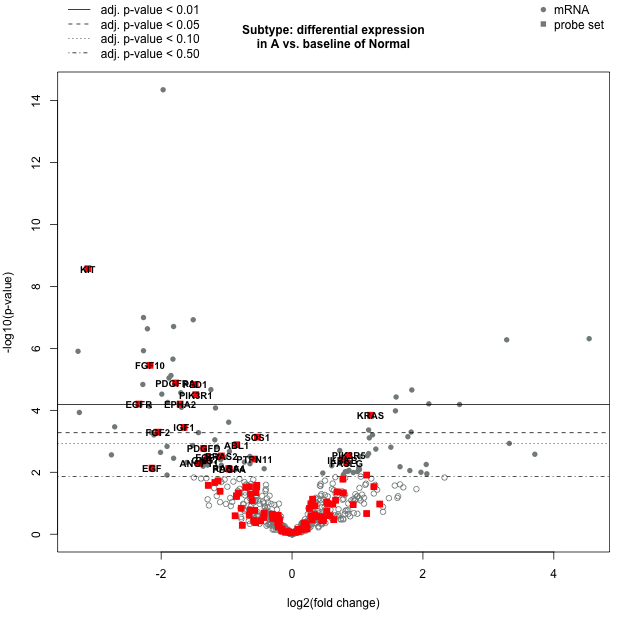
Volcano Plot: SubtypeA
Volcano plot displaying each gene's -log10(p-value) and log2 fold change for the selected covariate. Highly statistically significant genes fall at the top of the plot, and highly differentially expressed genes fall to either side. Genes within the selected gene set are highlighted in blue. Green point colors and horizontal lines indicate various False Discovery Rate (FDR) thresholds.
DE Results - RAS genes - SubtypeA
More Plot Information Download CSV DataProbe Label Log2 fold change std error Lower confidence limit Upper confidence limit P-value BY.p.value Gene.sets Codeset.Name Probe.Label Analyte.Type Is.Control Control.Type Probe.Annotation KEGG.Pathways Cell.Type Official.Gene.Name volcanocol volcanopch tstats.all KIT-mRNA -3.12 0.436 -3.98 -2.27 2.68e-09 5.33e-06 Driver Gene, PI3K, RAS NS_CANCERPATH_C2535 KIT mRNA 0 RAS;PI3K;Driver Gene hsa04014;hsa04015;hsa04060;hsa04072;hsa04144;hsa04151;hsa04640;hsa04916;hsa05200;hsa05221;hsa05230 KIT chartreuse1 16 -7.15596330275229 FGF10-mRNA -2.17 0.418 -2.99 -1.35 3.51e-06 0.00116 MAPK, PI3K, RAS NS_CANCERPATH_C2535 FGF10 mRNA 0 RAS;PI3K;MAPK hsa04010;hsa04014;hsa04015;hsa04151;hsa04810;hsa05200;hsa05218 FGF10 chartreuse1 16 -5.19138755980861 PDGFRA-mRNA -1.78 0.369 -2.5 -1.05 1.31e-05 0.00345 Driver Gene, MAPK, PI3K, RAS NS_CANCERPATH_C2535 PDGFRA mRNA 0 RAS;PI3K;MAPK;Driver Gene hsa04010;hsa04014;hsa04015;hsa04020;hsa04060;hsa04072;hsa04144;hsa04151;hsa04510;hsa04540;hsa04810;hsa05166;hsa05200;hsa05206;hsa05214;hsa05215;hsa05218;hsa05230;hsa05231 PDGFRA chartreuse1 16 -4.82384823848238 PLD1-mRNA -1.48 0.309 -2.08 -0.872 1.47e-05 0.00345 RAS NS_CANCERPATH_C2535 PLD1 mRNA 0 RAS hsa00564;hsa00565;hsa01100;hsa04014;hsa04024;hsa04071;hsa04072;hsa04144;hsa04666;hsa04724;hsa04912;hsa05200;hsa05212;hsa05231 PLD1 chartreuse1 16 -4.78964401294498 PIK3R1-mRNA -1.47 0.322 -2.1 -0.838 3.11e-05 0.00562 CC.PLS.Apop, Driver Gene, JAK-STAT, PI3K, RAS NS_CANCERPATH_C2535 PIK3R1 mRNA 0 CC.PLS.Apop;RAS;PI3K;JAK-STAT;Driver Gene hsa04012;hsa04014;hsa04015;hsa04022;hsa04024;hsa04062;hsa04066;hsa04068;hsa04070;hsa04071;hsa04072;hsa04150;hsa04151;hsa04152;hsa04210;hsa04211;hsa04261;hsa04370;hsa04380;hsa04510;hsa04550;hsa04611;hsa04620;hsa04630;hsa04650;hsa04660;hsa04662;hsa04664;hsa04666;hsa04668;hsa04670;hsa04722;hsa04725;hsa04750;hsa04810;hsa04910;hsa04914;hsa04915;hsa04917;hsa04919;hsa04921;hsa04923;hsa04930;hsa04931;hsa04932;hsa04933;hsa04960;hsa04973;hsa05100;hsa05142;hsa05145;hsa05146;hsa05160;hsa05161;hsa05162;hsa05164;hsa05166;hsa05169;hsa05200;hsa05203;hsa05205;hsa05210;hsa05211;hsa05212;hsa05213;hsa05214;hsa05215;hsa05218;hsa05220;hsa05221;hsa05222;hsa05223;hsa05230;hsa05231 PIK3R1 chartreuse1 16 -4.56521739130435 EPHA2-mRNA -1.71 0.393 -2.49 -0.943 6.26e-05 0.0092 PI3K, RAS NS_CANCERPATH_C2535 EPHA2 mRNA 0 RAS;PI3K hsa04014;hsa04015;hsa04151;hsa04360 EPHA2 chartreuse1 16 -4.35114503816794 EGFR-mRNA -2.34 0.537 -3.39 -1.29 6.27e-05 0.0092 Driver Gene, MAPK, PI3K, RAS NS_CANCERPATH_C2535 EGFR mRNA 0 RAS;PI3K;MAPK;Driver Gene hsa04010;hsa04012;hsa04014;hsa04015;hsa04020;hsa04060;hsa04066;hsa04068;hsa04072;hsa04144;hsa04151;hsa04320;hsa04510;hsa04520;hsa04540;hsa04810;hsa04912;hsa04915;hsa04921;hsa05120;hsa05160;hsa05200;hsa05205;hsa05206;hsa05212;hsa05213;hsa05214;hsa05215;hsa05218;hsa05219;hsa05223;hsa05230;hsa05231 EGFR chartreuse1 16 -4.35754189944134 KRAS-mRNA 1.2 0.292 0.625 1.77 0.000144 0.0168 Driver Gene, MAPK, PI3K, RAS NS_CANCERPATH_C2535 KRAS mRNA 0 RAS;PI3K;MAPK;Driver Gene hsa04010;hsa04012;hsa04014;hsa04015;hsa04062;hsa04068;hsa04071;hsa04072;hsa04151;hsa04211;hsa04320;hsa04360;hsa04370;hsa04530;hsa04540;hsa04550;hsa04650;hsa04660;hsa04662;hsa04664;hsa04720;hsa04722;hsa04725;hsa04726;hsa04730;hsa04810;hsa04910;hsa04912;hsa04914;hsa04915;hsa04916;hsa04917;hsa04919;hsa04921;hsa04933;hsa04960;hsa05034;hsa05160;hsa05161;hsa05166;hsa05200;hsa05203;hsa05205;hsa05206;hsa05210;hsa05211;hsa05212;hsa05213;hsa05214;hsa05215;hsa05216;hsa05218;hsa05219;hsa05220;hsa05221;hsa05223;hsa05230;hsa05231 KRAS chartreuse2 16 4.10958904109589 IGF1-mRNA -1.65 0.431 -2.49 -0.802 0.000355 0.0382 PI3K, RAS, TXmisReg NS_CANCERPATH_C2535 IGF1 mRNA 0 RAS;PI3K;TXmisReg hsa04014;hsa04015;hsa04066;hsa04068;hsa04114;hsa04115;hsa04150;hsa04151;hsa04152;hsa04211;hsa04510;hsa04550;hsa04730;hsa04750;hsa04913;hsa04914;hsa04960;hsa05200;hsa05202;hsa05205;hsa05214;hsa05215;hsa05218;hsa05410;hsa05414 IGF1 chartreuse2 16 -3.82830626450116 FGF2-mRNA -2.05 0.554 -3.14 -0.968 0.000506 0.0497 MAPK, PI3K, RAS NS_CANCERPATH_C2535 FGF2 mRNA 0 RAS;PI3K;MAPK hsa04010;hsa04014;hsa04015;hsa04151;hsa04550;hsa04810;hsa05200;hsa05205;hsa05218 FGF2 chartreuse2 16 -3.70036101083032 SOS1-mRNA -0.53 0.148 -0.819 -0.241 0.000733 0.0634 JAK-STAT, MAPK, PI3K, RAS NS_CANCERPATH_C2535 SOS1 mRNA 0 RAS;PI3K;JAK-STAT;MAPK hsa04010;hsa04012;hsa04014;hsa04062;hsa04068;hsa04072;hsa04151;hsa04320;hsa04510;hsa04540;hsa04630;hsa04650;hsa04660;hsa04662;hsa04664;hsa04722;hsa04810;hsa04910;hsa04912;hsa04915;hsa04917;hsa05034;hsa05160;hsa05200;hsa05205;hsa05206;hsa05211;hsa05213;hsa05214;hsa05215;hsa05220;hsa05221;hsa05223;hsa05231 SOS1 chartreuse3 16 -3.58108108108108 ABL1-mRNA -0.846 0.249 -1.33 -0.359 0.00129 0.103 CC.PLS.Apop, Driver Gene, RAS NS_CANCERPATH_C2535 ABL1 mRNA 0 CC.PLS.Apop;RAS;Driver Gene hsa04012;hsa04014;hsa04110;hsa04360;hsa04722;hsa05130;hsa05131;hsa05200;hsa05206;hsa05220;hsa05416 ABL1 chartreuse4 16 -3.39759036144578 PDGFD-mRNA -1.35 0.409 -2.15 -0.552 0.00169 0.123 PI3K, RAS NS_CANCERPATH_C2535 PDGFD mRNA 0 RAS;PI3K hsa04014;hsa04015;hsa04072;hsa04151;hsa04510;hsa04540;hsa04810;hsa05215;hsa05218;hsa05231 PDGFD chartreuse4 16 -3.30073349633252 PIK3R5-mRNA 0.867 0.277 0.324 1.41 0.00288 0.181 CC.PLS.Apop, JAK-STAT, PI3K, RAS NS_CANCERPATH_C2535 PIK3R5 mRNA 0 CC.PLS.Apop;RAS;PI3K;JAK-STAT hsa04012;hsa04014;hsa04015;hsa04022;hsa04024;hsa04062;hsa04066;hsa04068;hsa04070;hsa04071;hsa04072;hsa04150;hsa04151;hsa04152;hsa04210;hsa04211;hsa04261;hsa04370;hsa04380;hsa04510;hsa04550;hsa04611;hsa04620;hsa04630;hsa04650;hsa04660;hsa04662;hsa04664;hsa04666;hsa04668;hsa04670;hsa04722;hsa04725;hsa04750;hsa04810;hsa04910;hsa04914;hsa04915;hsa04917;hsa04919;hsa04921;hsa04923;hsa04930;hsa04931;hsa04932;hsa04933;hsa04960;hsa04973;hsa05100;hsa05142;hsa05145;hsa05146;hsa05160;hsa05161;hsa05162;hsa05164;hsa05166;hsa05169;hsa05200;hsa05203;hsa05205;hsa05210;hsa05211;hsa05212;hsa05213;hsa05214;hsa05215;hsa05218;hsa05220;hsa05221;hsa05222;hsa05223;hsa05230;hsa05231 PIK3R5 chartreuse4 16 3.12996389891697 RRAS2-mRNA -1.08 0.347 -1.76 -0.401 0.00297 0.182 MAPK, RAS NS_CANCERPATH_C2535 RRAS2 mRNA 0 RAS;MAPK hsa04010;hsa04014;hsa04024;hsa04072;hsa04530;hsa04810;hsa05166;hsa05205 RRAS2 chartreuse4 16 -3.11239193083574 FGF7-mRNA -1.29 0.418 -2.11 -0.472 0.00323 0.187 MAPK, PI3K, RAS NS_CANCERPATH_C2535 FGF7 mRNA 0 RAS;PI3K;MAPK hsa04010;hsa04014;hsa04015;hsa04151;hsa04810;hsa05200;hsa05218 FGF7 chartreuse4 16 -3.08612440191388 PTPN11-mRNA -0.572 0.189 -0.942 -0.203 0.00375 0.202 Driver Gene, JAK-STAT, RAS NS_CANCERPATH_C2535 PTPN11 mRNA 0 RAS;JAK-STAT;Driver Gene hsa04014;hsa04072;hsa04630;hsa04650;hsa04670;hsa04722;hsa04920;hsa04931;hsa05120;hsa05168;hsa05205;hsa05211;hsa05220 PTPN11 chartreuse4 16 -3.02645502645503 IKBKB-mRNA 0.771 0.256 0.269 1.27 0.00403 0.211 CC.PLS.Apop, MAPK, PI3K, RAS NS_CANCERPATH_C2535 IKBKB mRNA 0 CC.PLS.Apop;RAS;PI3K;MAPK hsa04010;hsa04014;hsa04062;hsa04064;hsa04068;hsa04150;hsa04151;hsa04210;hsa04380;hsa04620;hsa04621;hsa04622;hsa04623;hsa04660;hsa04662;hsa04668;hsa04722;hsa04910;hsa04920;hsa04930;hsa04931;hsa04932;hsa05120;hsa05131;hsa05142;hsa05145;hsa05160;hsa05161;hsa05164;hsa05166;hsa05168;hsa05169;hsa05200;hsa05206;hsa05212;hsa05215;hsa05220;hsa05221;hsa05222 IKBKB chartreuse4 16 3.01171875 GNG7-mRNA -1.33 0.443 -2.2 -0.46 0.00417 0.215 PI3K, RAS NS_CANCERPATH_C2535 GNG7 mRNA 0 RAS;PI3K hsa04014;hsa04062;hsa04151;hsa04713;hsa04723;hsa04724;hsa04725;hsa04726;hsa04727;hsa04728;hsa04740;hsa05032;hsa05034;hsa05200 GNG7 chartreuse4 16 -3.00225733634312 FASLG-mRNA 0.836 0.284 0.279 1.39 0.0049 0.24 CC.PLS.Apop, MAPK, PI3K, RAS NS_CANCERPATH_C2535 FASLG mRNA 0 CC.PLS.Apop;RAS;PI3K;MAPK hsa04010;hsa04014;hsa04060;hsa04068;hsa04151;hsa04210;hsa04650;hsa04722;hsa04932;hsa04940;hsa05142;hsa05143;hsa05161;hsa05162;hsa05164;hsa05168;hsa05200;hsa05205;hsa05320;hsa05330;hsa05332 FASLG chartreuse4 16 2.94366197183099 DE Results - RAS genes - SubtypeA
Table displaying each sample's global significance scores and directed global significance scores as defined in the heatmaps above. The global significance score is calculated as the square root of the mean squared t-statistic for the genes in a gene set, with t-statistics coming from the linear regression underlying our differential expression analysis. The directed global significance score is calculated as the square root of the mean signed squared t-statistic for the genes in a gene set, with t-statistics coming from the linear regression underlying our differential expression analysis.
Volcano Plot: SubtypeB
More Plot Information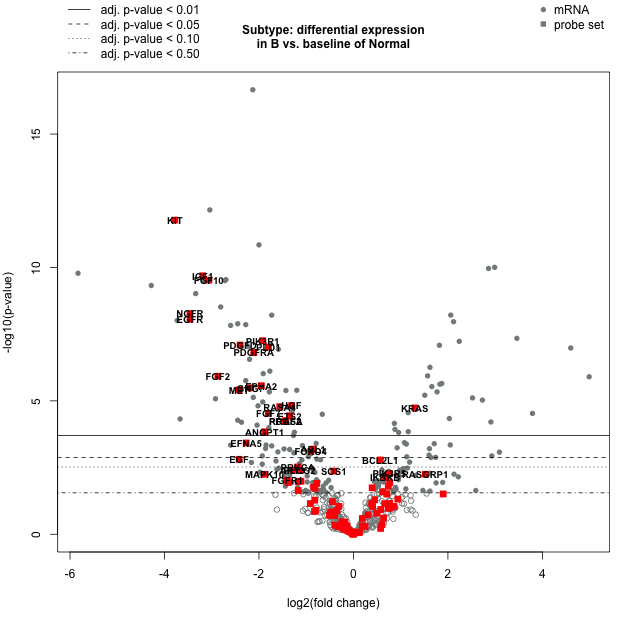
Volcano Plot: SubtypeB
Volcano plot displaying each gene's -log10(p-value) and log2 fold change for the selected covariate. Highly statistically significant genes fall at the top of the plot, and highly differentially expressed genes fall to either side. Genes within the selected gene set are highlighted in blue. Green point colors and horizontal lines indicate various False Discovery Rate (FDR) thresholds.
DE Results - RAS genes - SubtypeB
More Plot Information Download CSV DataProbe Label Log2 fold change std error Lower confidence limit Upper confidence limit P-value BY.p.value Gene.sets Codeset.Name Probe.Label Analyte.Type Is.Control Control.Type Probe.Annotation KEGG.Pathways Cell.Type Official.Gene.Name volcanocol volcanopch tstats.all KIT-mRNA -3.78 0.41 -4.58 -2.97 1.68e-12 2.22e-09 Driver Gene, PI3K, RAS NS_CANCERPATH_C2535 KIT mRNA 0 RAS;PI3K;Driver Gene hsa04014;hsa04015;hsa04060;hsa04072;hsa04144;hsa04151;hsa04640;hsa04916;hsa05200;hsa05221;hsa05230 KIT chartreuse1 16 -9.21951219512195 IGF1-mRNA -3.19 0.406 -3.99 -2.4 2.05e-10 1.01e-07 PI3K, RAS, TXmisReg NS_CANCERPATH_C2535 IGF1 mRNA 0 RAS;PI3K;TXmisReg hsa04014;hsa04015;hsa04066;hsa04068;hsa04114;hsa04115;hsa04150;hsa04151;hsa04152;hsa04211;hsa04510;hsa04550;hsa04730;hsa04750;hsa04913;hsa04914;hsa04960;hsa05200;hsa05202;hsa05205;hsa05214;hsa05215;hsa05218;hsa05410;hsa05414 IGF1 chartreuse1 16 -7.85714285714286 FGF10-mRNA -3.06 0.394 -3.83 -2.29 2.99e-10 1.01e-07 MAPK, PI3K, RAS NS_CANCERPATH_C2535 FGF10 mRNA 0 RAS;PI3K;MAPK hsa04010;hsa04014;hsa04015;hsa04151;hsa04810;hsa05200;hsa05218 FGF10 chartreuse1 16 -7.76649746192893 NGFR-mRNA -3.46 0.495 -4.43 -2.49 5.34e-09 1.25e-06 PI3K, RAS, TXmisReg NS_CANCERPATH_C2535 NGFR mRNA 0 RAS;PI3K;TXmisReg hsa04014;hsa04015;hsa04060;hsa04151;hsa04722;hsa05202 NGFR chartreuse1 16 -6.98989898989899 EGFR-mRNA -3.46 0.506 -4.46 -2.47 8.82e-09 1.75e-06 Driver Gene, MAPK, PI3K, RAS NS_CANCERPATH_C2535 EGFR mRNA 0 RAS;PI3K;MAPK;Driver Gene hsa04010;hsa04012;hsa04014;hsa04015;hsa04020;hsa04060;hsa04066;hsa04068;hsa04072;hsa04144;hsa04151;hsa04320;hsa04510;hsa04520;hsa04540;hsa04810;hsa04912;hsa04915;hsa04921;hsa05120;hsa05160;hsa05200;hsa05205;hsa05206;hsa05212;hsa05213;hsa05214;hsa05215;hsa05218;hsa05219;hsa05223;hsa05230;hsa05231 EGFR chartreuse1 16 -6.83794466403162 PIK3R1-mRNA -1.92 0.303 -2.52 -1.33 5.54e-08 8.16e-06 CC.PLS.Apop, Driver Gene, JAK-STAT, PI3K, RAS NS_CANCERPATH_C2535 PIK3R1 mRNA 0 CC.PLS.Apop;RAS;PI3K;JAK-STAT;Driver Gene hsa04012;hsa04014;hsa04015;hsa04022;hsa04024;hsa04062;hsa04066;hsa04068;hsa04070;hsa04071;hsa04072;hsa04150;hsa04151;hsa04152;hsa04210;hsa04211;hsa04261;hsa04370;hsa04380;hsa04510;hsa04550;hsa04611;hsa04620;hsa04630;hsa04650;hsa04660;hsa04662;hsa04664;hsa04666;hsa04668;hsa04670;hsa04722;hsa04725;hsa04750;hsa04810;hsa04910;hsa04914;hsa04915;hsa04917;hsa04919;hsa04921;hsa04923;hsa04930;hsa04931;hsa04932;hsa04933;hsa04960;hsa04973;hsa05100;hsa05142;hsa05145;hsa05146;hsa05160;hsa05161;hsa05162;hsa05164;hsa05166;hsa05169;hsa05200;hsa05203;hsa05205;hsa05210;hsa05211;hsa05212;hsa05213;hsa05214;hsa05215;hsa05218;hsa05220;hsa05221;hsa05222;hsa05223;hsa05230;hsa05231 PIK3R1 chartreuse1 16 -6.33663366336634 PDGFD-mRNA -2.4 0.385 -3.16 -1.65 8.03e-08 1.06e-05 PI3K, RAS NS_CANCERPATH_C2535 PDGFD mRNA 0 RAS;PI3K hsa04014;hsa04015;hsa04072;hsa04151;hsa04510;hsa04540;hsa04810;hsa05215;hsa05218;hsa05231 PDGFD chartreuse1 16 -6.23376623376623 PLD1-mRNA -1.8 0.291 -2.37 -1.23 9.8e-08 1.18e-05 RAS NS_CANCERPATH_C2535 PLD1 mRNA 0 RAS hsa00564;hsa00565;hsa01100;hsa04014;hsa04024;hsa04071;hsa04072;hsa04144;hsa04666;hsa04724;hsa04912;hsa05200;hsa05212;hsa05231 PLD1 chartreuse1 16 -6.18556701030928 PDGFRA-mRNA -2.11 0.348 -2.79 -1.43 1.53e-07 1.69e-05 Driver Gene, MAPK, PI3K, RAS NS_CANCERPATH_C2535 PDGFRA mRNA 0 RAS;PI3K;MAPK;Driver Gene hsa04010;hsa04014;hsa04015;hsa04020;hsa04060;hsa04072;hsa04144;hsa04151;hsa04510;hsa04540;hsa04810;hsa05166;hsa05200;hsa05206;hsa05214;hsa05215;hsa05218;hsa05230;hsa05231 PDGFRA chartreuse1 16 -6.0632183908046 FGF2-mRNA -2.87 0.522 -3.89 -1.84 1.19e-06 0.00011 MAPK, PI3K, RAS NS_CANCERPATH_C2535 FGF2 mRNA 0 RAS;PI3K;MAPK hsa04010;hsa04014;hsa04015;hsa04151;hsa04550;hsa04810;hsa05200;hsa05205;hsa05218 FGF2 chartreuse1 16 -5.49808429118774 EPHA2-mRNA -1.95 0.371 -2.68 -1.23 2.7e-06 0.000224 PI3K, RAS NS_CANCERPATH_C2535 EPHA2 mRNA 0 RAS;PI3K hsa04014;hsa04015;hsa04151;hsa04360 EPHA2 chartreuse1 16 -5.25606469002695 GNG7-mRNA -2.18 0.418 -3 -1.36 3.25e-06 0.000259 PI3K, RAS NS_CANCERPATH_C2535 GNG7 mRNA 0 RAS;PI3K hsa04014;hsa04062;hsa04151;hsa04713;hsa04723;hsa04724;hsa04725;hsa04726;hsa04727;hsa04728;hsa04740;hsa05032;hsa05034;hsa05200 GNG7 chartreuse1 16 -5.21531100478469 MET-mRNA -2.42 0.469 -3.34 -1.5 3.85e-06 0.000295 Driver Gene, PI3K, RAS, TXmisReg NS_CANCERPATH_C2535 MET mRNA 0 RAS;PI3K;TXmisReg;Driver Gene hsa04014;hsa04015;hsa04060;hsa04144;hsa04151;hsa04360;hsa04510;hsa04520;hsa05100;hsa05120;hsa05144;hsa05200;hsa05202;hsa05205;hsa05206;hsa05211;hsa05218;hsa05230 MET chartreuse1 16 -5.15991471215352 HGF-mRNA -1.31 0.274 -1.84 -0.771 1.5e-05 0.000949 PI3K, RAS NS_CANCERPATH_C2535 HGF mRNA 0 RAS;PI3K hsa04014;hsa04015;hsa04060;hsa04151;hsa04510;hsa05144;hsa05200;hsa05205;hsa05211;hsa05218 HGF chartreuse1 16 -4.78102189781022 RASA4-mRNA -1.56 0.328 -2.2 -0.915 1.64e-05 0.00101 RAS NS_CANCERPATH_C2535 RASA4 mRNA 0 RAS hsa04014 RASA4 chartreuse1 16 -4.75609756097561 KRAS-mRNA 1.3 0.275 0.757 1.83 1.84e-05 0.00111 Driver Gene, MAPK, PI3K, RAS NS_CANCERPATH_C2535 KRAS mRNA 0 RAS;PI3K;MAPK;Driver Gene hsa04010;hsa04012;hsa04014;hsa04015;hsa04062;hsa04068;hsa04071;hsa04072;hsa04151;hsa04211;hsa04320;hsa04360;hsa04370;hsa04530;hsa04540;hsa04550;hsa04650;hsa04660;hsa04662;hsa04664;hsa04720;hsa04722;hsa04725;hsa04726;hsa04730;hsa04810;hsa04910;hsa04912;hsa04914;hsa04915;hsa04916;hsa04917;hsa04919;hsa04921;hsa04933;hsa04960;hsa05034;hsa05160;hsa05161;hsa05166;hsa05200;hsa05203;hsa05205;hsa05206;hsa05210;hsa05211;hsa05212;hsa05213;hsa05214;hsa05215;hsa05216;hsa05218;hsa05219;hsa05220;hsa05221;hsa05223;hsa05230;hsa05231 KRAS chartreuse1 16 4.72727272727273 FGF7-mRNA -1.8 0.394 -2.58 -1.03 2.97e-05 0.00169 MAPK, PI3K, RAS NS_CANCERPATH_C2535 FGF7 mRNA 0 RAS;PI3K;MAPK hsa04010;hsa04014;hsa04015;hsa04151;hsa04810;hsa05200;hsa05218 FGF7 chartreuse1 16 -4.56852791878173 ETS2-mRNA -1.35 0.299 -1.94 -0.765 3.62e-05 0.002 RAS NS_CANCERPATH_C2535 ETS2 mRNA 0 RAS hsa04014;hsa04320;hsa05166 ETS2 chartreuse1 16 -4.51505016722408 RRAS2-mRNA -1.44 0.327 -2.08 -0.795 5.5e-05 0.00288 MAPK, RAS NS_CANCERPATH_C2535 RRAS2 mRNA 0 RAS;MAPK hsa04010;hsa04014;hsa04024;hsa04072;hsa04530;hsa04810;hsa05166;hsa05205 RRAS2 chartreuse1 16 -4.40366972477064 PDGFA-mRNA -1.43 0.327 -2.07 -0.789 5.91e-05 0.00305 MAPK, PI3K, RAS, TXmisReg NS_CANCERPATH_C2535 PDGFA mRNA 0 RAS;PI3K;MAPK;TXmisReg hsa04010;hsa04014;hsa04015;hsa04060;hsa04072;hsa04151;hsa04510;hsa04540;hsa04810;hsa05166;hsa05200;hsa05202;hsa05206;hsa05214;hsa05215;hsa05218;hsa05231 PDGFA chartreuse1 16 -4.37308868501529 DE Results - RAS genes - SubtypeB
Table displaying each sample's global significance scores and directed global significance scores as defined in the heatmaps above. The global significance score is calculated as the square root of the mean squared t-statistic for the genes in a gene set, with t-statistics coming from the linear regression underlying our differential expression analysis. The directed global significance score is calculated as the square root of the mean signed squared t-statistic for the genes in a gene set, with t-statistics coming from the linear regression underlying our differential expression analysis.
Volcano Plot: SubtypeC
More Plot Information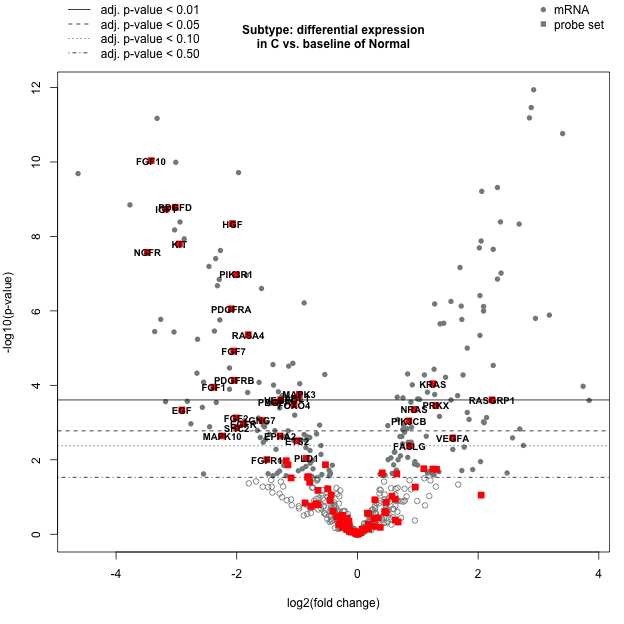
Volcano Plot: SubtypeC
Volcano plot displaying each gene's -log10(p-value) and log2 fold change for the selected covariate. Highly statistically significant genes fall at the top of the plot, and highly differentially expressed genes fall to either side. Genes within the selected gene set are highlighted in blue. Green point colors and horizontal lines indicate various False Discovery Rate (FDR) thresholds.
DE Results - RAS genes - SubtypeC
More Plot Information Download CSV DataProbe Label Log2 fold change std error Lower confidence limit Upper confidence limit P-value BY.p.value Gene.sets Codeset.Name Probe.Label Analyte.Type Is.Control Control.Type Probe.Annotation KEGG.Pathways Cell.Type Official.Gene.Name volcanocol volcanopch tstats.all FGF10-mRNA -3.42 0.423 -4.25 -2.59 9.23e-11 5.8e-08 MAPK, PI3K, RAS NS_CANCERPATH_C2535 FGF10 mRNA 0 RAS;PI3K;MAPK hsa04010;hsa04014;hsa04015;hsa04151;hsa04810;hsa05200;hsa05218 FGF10 chartreuse1 16 -8.08510638297872 PDGFD-mRNA -3.02 0.414 -3.83 -2.21 1.65e-09 4.92e-07 PI3K, RAS NS_CANCERPATH_C2535 PDGFD mRNA 0 RAS;PI3K hsa04014;hsa04015;hsa04072;hsa04151;hsa04510;hsa04540;hsa04810;hsa05215;hsa05218;hsa05231 PDGFD chartreuse1 16 -7.29468599033816 IGF1-mRNA -3.17 0.436 -4.03 -2.32 1.85e-09 4.92e-07 PI3K, RAS, TXmisReg NS_CANCERPATH_C2535 IGF1 mRNA 0 RAS;PI3K;TXmisReg hsa04014;hsa04015;hsa04066;hsa04068;hsa04114;hsa04115;hsa04150;hsa04151;hsa04152;hsa04211;hsa04510;hsa04550;hsa04730;hsa04750;hsa04913;hsa04914;hsa04960;hsa05200;hsa05202;hsa05205;hsa05214;hsa05215;hsa05218;hsa05410;hsa05414 IGF1 chartreuse1 16 -7.27064220183486 HGF-mRNA -2.07 0.294 -2.64 -1.49 4.53e-09 9.76e-07 PI3K, RAS NS_CANCERPATH_C2535 HGF mRNA 0 RAS;PI3K hsa04014;hsa04015;hsa04060;hsa04151;hsa04510;hsa05144;hsa05200;hsa05205;hsa05211;hsa05218 HGF chartreuse1 16 -7.04081632653061 KIT-mRNA -2.95 0.441 -3.81 -2.08 1.6e-08 2.76e-06 Driver Gene, PI3K, RAS NS_CANCERPATH_C2535 KIT mRNA 0 RAS;PI3K;Driver Gene hsa04014;hsa04015;hsa04060;hsa04072;hsa04144;hsa04151;hsa04640;hsa04916;hsa05200;hsa05221;hsa05230 KIT chartreuse1 16 -6.68934240362812 NGFR-mRNA -3.48 0.533 -4.53 -2.44 2.68e-08 3.94e-06 PI3K, RAS, TXmisReg NS_CANCERPATH_C2535 NGFR mRNA 0 RAS;PI3K;TXmisReg hsa04014;hsa04015;hsa04060;hsa04151;hsa04722;hsa05202 NGFR chartreuse1 16 -6.52908067542214 PIK3R1-mRNA -2.01 0.326 -2.65 -1.37 1.06e-07 1.31e-05 CC.PLS.Apop, Driver Gene, JAK-STAT, PI3K, RAS NS_CANCERPATH_C2535 PIK3R1 mRNA 0 CC.PLS.Apop;RAS;PI3K;JAK-STAT;Driver Gene hsa04012;hsa04014;hsa04015;hsa04022;hsa04024;hsa04062;hsa04066;hsa04068;hsa04070;hsa04071;hsa04072;hsa04150;hsa04151;hsa04152;hsa04210;hsa04211;hsa04261;hsa04370;hsa04380;hsa04510;hsa04550;hsa04611;hsa04620;hsa04630;hsa04650;hsa04660;hsa04662;hsa04664;hsa04666;hsa04668;hsa04670;hsa04722;hsa04725;hsa04750;hsa04810;hsa04910;hsa04914;hsa04915;hsa04917;hsa04919;hsa04921;hsa04923;hsa04930;hsa04931;hsa04932;hsa04933;hsa04960;hsa04973;hsa05100;hsa05142;hsa05145;hsa05146;hsa05160;hsa05161;hsa05162;hsa05164;hsa05166;hsa05169;hsa05200;hsa05203;hsa05205;hsa05210;hsa05211;hsa05212;hsa05213;hsa05214;hsa05215;hsa05218;hsa05220;hsa05221;hsa05222;hsa05223;hsa05230;hsa05231 PIK3R1 chartreuse1 16 -6.16564417177914 PDGFRA-mRNA -2.09 0.374 -2.82 -1.35 8.8e-07 7.95e-05 Driver Gene, MAPK, PI3K, RAS NS_CANCERPATH_C2535 PDGFRA mRNA 0 RAS;PI3K;MAPK;Driver Gene hsa04010;hsa04014;hsa04015;hsa04020;hsa04060;hsa04072;hsa04144;hsa04151;hsa04510;hsa04540;hsa04810;hsa05166;hsa05200;hsa05206;hsa05214;hsa05215;hsa05218;hsa05230;hsa05231 PDGFRA chartreuse1 16 -5.58823529411765 RASA4-mRNA -1.81 0.353 -2.5 -1.12 4.37e-06 0.000311 RAS NS_CANCERPATH_C2535 RASA4 mRNA 0 RAS hsa04014 RASA4 chartreuse1 16 -5.12747875354108 FGF7-mRNA -2.05 0.424 -2.88 -1.22 1.2e-05 0.000794 MAPK, PI3K, RAS NS_CANCERPATH_C2535 FGF7 mRNA 0 RAS;PI3K;MAPK hsa04010;hsa04014;hsa04015;hsa04151;hsa04810;hsa05200;hsa05218 FGF7 chartreuse1 16 -4.83490566037736 PDGFRB-mRNA -2.04 0.473 -2.97 -1.11 7.32e-05 0.00399 MAPK, PI3K, RAS NS_CANCERPATH_C2535 PDGFRB mRNA 0 RAS;PI3K;MAPK hsa04010;hsa04014;hsa04015;hsa04020;hsa04060;hsa04072;hsa04151;hsa04510;hsa04540;hsa04810;hsa05166;hsa05200;hsa05206;hsa05214;hsa05215;hsa05218;hsa05230;hsa05231 PDGFRB chartreuse1 16 -4.31289640591966 KRAS-mRNA 1.25 0.296 0.675 1.83 9.06e-05 0.00468 Driver Gene, MAPK, PI3K, RAS NS_CANCERPATH_C2535 KRAS mRNA 0 RAS;PI3K;MAPK;Driver Gene hsa04010;hsa04012;hsa04014;hsa04015;hsa04062;hsa04068;hsa04071;hsa04072;hsa04151;hsa04211;hsa04320;hsa04360;hsa04370;hsa04530;hsa04540;hsa04550;hsa04650;hsa04660;hsa04662;hsa04664;hsa04720;hsa04722;hsa04725;hsa04726;hsa04730;hsa04810;hsa04910;hsa04912;hsa04914;hsa04915;hsa04916;hsa04917;hsa04919;hsa04921;hsa04933;hsa04960;hsa05034;hsa05160;hsa05161;hsa05166;hsa05200;hsa05203;hsa05205;hsa05206;hsa05210;hsa05211;hsa05212;hsa05213;hsa05214;hsa05215;hsa05216;hsa05218;hsa05219;hsa05220;hsa05221;hsa05223;hsa05230;hsa05231 KRAS chartreuse1 16 4.22297297297297 FGF1-mRNA -2.38 0.569 -3.49 -1.26 0.000112 0.00549 MAPK, PI3K, RAS NS_CANCERPATH_C2535 FGF1 mRNA 0 RAS;PI3K;MAPK hsa04010;hsa04014;hsa04015;hsa04151;hsa04390;hsa04810;hsa05200;hsa05218 FGF1 chartreuse1 16 -4.18277680140598 MAPK3-mRNA -0.965 0.239 -1.43 -0.497 0.000176 0.00804 MAPK, PI3K, RAS, TGF-B NS_CANCERPATH_C2535 MAPK3 mRNA 0 RAS;PI3K;MAPK;TGF-B hsa04010;hsa04012;hsa04014;hsa04015;hsa04022;hsa04024;hsa04062;hsa04066;hsa04068;hsa04071;hsa04072;hsa04114;hsa04150;hsa04151;hsa04261;hsa04270;hsa04320;hsa04350;hsa04360;hsa04370;hsa04380;hsa04510;hsa04520;hsa04540;hsa04550;hsa04611;hsa04620;hsa04621;hsa04650;hsa04660;hsa04662;hsa04664;hsa04666;hsa04668;hsa04713;hsa04720;hsa04722;hsa04723;hsa04724;hsa04725;hsa04726;hsa04730;hsa04810;hsa04910;hsa04912;hsa04914;hsa04915;hsa04916;hsa04917;hsa04919;hsa04921;hsa04930;hsa04933;hsa04960;hsa05010;hsa05020;hsa05034;hsa05131;hsa05132;hsa05133;hsa05140;hsa05142;hsa05145;hsa05152;hsa05160;hsa05161;hsa05164;hsa05200;hsa05203;hsa05205;hsa05210;hsa05211;hsa05212;hsa05213;hsa05214;hsa05215;hsa05216;hsa05218;hsa05219;hsa05220;hsa05221;hsa05223;hsa05230;hsa05231 MAPK3 chartreuse1 16 -4.03765690376569 ABL1-mRNA -1 0.252 -1.5 -0.508 0.000217 0.0093 CC.PLS.Apop, Driver Gene, RAS NS_CANCERPATH_C2535 ABL1 mRNA 0 CC.PLS.Apop;RAS;Driver Gene hsa04012;hsa04014;hsa04110;hsa04360;hsa04722;hsa05130;hsa05131;hsa05200;hsa05206;hsa05220;hsa05416 ABL1 chartreuse1 16 -3.96825396825397 VEGFC-mRNA -1.27 0.323 -1.91 -0.64 0.000243 0.00992 PI3K, RAS NS_CANCERPATH_C2535 VEGFC mRNA 0 RAS;PI3K hsa04014;hsa04015;hsa04060;hsa04151;hsa04510;hsa04668;hsa04933;hsa05200 VEGFC chartreuse1 16 -3.93188854489164 RASGRP1-mRNA 2.23 0.566 1.12 3.34 0.000246 0.00992 MAPK, RAS NS_CANCERPATH_C2535 RASGRP1 mRNA 0 RAS;MAPK hsa04010;hsa04014;hsa04611;hsa04660;hsa05200 RASGRP1 chartreuse1 16 3.93992932862191 PDGFA-mRNA -1.37 0.352 -2.06 -0.679 0.000284 0.0109 MAPK, PI3K, RAS, TXmisReg NS_CANCERPATH_C2535 PDGFA mRNA 0 RAS;PI3K;MAPK;TXmisReg hsa04010;hsa04014;hsa04015;hsa04060;hsa04072;hsa04151;hsa04510;hsa04540;hsa04810;hsa05166;hsa05200;hsa05202;hsa05206;hsa05214;hsa05215;hsa05218;hsa05231 PDGFA chartreuse2 16 -3.89204545454546 FOXO4-mRNA -1.05 0.272 -1.58 -0.512 0.000334 0.0123 RAS NS_CANCERPATH_C2535 FOXO4 mRNA 0 RAS hsa04014;hsa04068 FOXO4 chartreuse2 16 -3.86029411764706 PRKX-mRNA 1.3 0.338 0.632 1.96 0.000348 0.0127 CC.PLS.Apop, HH, MAPK, RAS, Wnt NS_CANCERPATH_C2535 PRKX mRNA 0 CC.PLS.Apop;RAS;MAPK;HH;Wnt PRKX chartreuse2 16 3.84615384615385 DE Results - RAS genes - SubtypeC
Table displaying each sample's global significance scores and directed global significance scores as defined in the heatmaps above. The global significance score is calculated as the square root of the mean squared t-statistic for the genes in a gene set, with t-statistics coming from the linear regression underlying our differential expression analysis. The directed global significance score is calculated as the square root of the mean signed squared t-statistic for the genes in a gene set, with t-statistics coming from the linear regression underlying our differential expression analysis.
Volcano Plot: SubtypeD
More Plot Information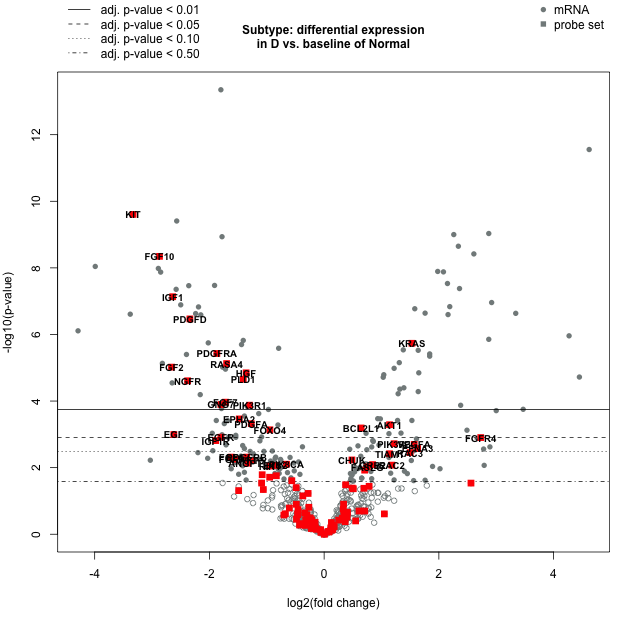
Volcano Plot: SubtypeD
Volcano plot displaying each gene's -log10(p-value) and log2 fold change for the selected covariate. Highly statistically significant genes fall at the top of the plot, and highly differentially expressed genes fall to either side. Genes within the selected gene set are highlighted in blue. Green point colors and horizontal lines indicate various False Discovery Rate (FDR) thresholds.
DE Results - RAS genes - SubtypeD
More Plot Information Download CSV DataProbe Label Log2 fold change std error Lower confidence limit Upper confidence limit P-value BY.p.value Gene.sets Codeset.Name Probe.Label Analyte.Type Is.Control Control.Type Probe.Annotation KEGG.Pathways Cell.Type Official.Gene.Name volcanocol volcanopch tstats.all KIT-mRNA -3.33 0.426 -4.17 -2.5 2.48e-10 3.29e-07 Driver Gene, PI3K, RAS NS_CANCERPATH_C2535 KIT mRNA 0 RAS;PI3K;Driver Gene hsa04014;hsa04015;hsa04060;hsa04072;hsa04144;hsa04151;hsa04640;hsa04916;hsa05200;hsa05221;hsa05230 KIT chartreuse1 16 -7.8169014084507 FGF10-mRNA -2.87 0.409 -3.68 -2.07 4.51e-09 1.79e-06 MAPK, PI3K, RAS NS_CANCERPATH_C2535 FGF10 mRNA 0 RAS;PI3K;MAPK hsa04010;hsa04014;hsa04015;hsa04151;hsa04810;hsa05200;hsa05218 FGF10 chartreuse1 16 -7.01711491442543 IGF1-mRNA -2.64 0.422 -3.47 -1.82 7.35e-08 1.39e-05 PI3K, RAS, TXmisReg NS_CANCERPATH_C2535 IGF1 mRNA 0 RAS;PI3K;TXmisReg hsa04014;hsa04015;hsa04066;hsa04068;hsa04114;hsa04115;hsa04150;hsa04151;hsa04152;hsa04211;hsa04510;hsa04550;hsa04730;hsa04750;hsa04913;hsa04914;hsa04960;hsa05200;hsa05202;hsa05205;hsa05214;hsa05215;hsa05218;hsa05410;hsa05414 IGF1 chartreuse1 16 -6.25592417061611 PDGFD-mRNA -2.34 0.4 -3.12 -1.55 3.41e-07 4.11e-05 PI3K, RAS NS_CANCERPATH_C2535 PDGFD mRNA 0 RAS;PI3K hsa04014;hsa04015;hsa04072;hsa04151;hsa04510;hsa04540;hsa04810;hsa05215;hsa05218;hsa05231 PDGFD chartreuse1 16 -5.85 KRAS-mRNA 1.53 0.286 0.975 2.09 1.84e-06 0.000188 Driver Gene, MAPK, PI3K, RAS NS_CANCERPATH_C2535 KRAS mRNA 0 RAS;PI3K;MAPK;Driver Gene hsa04010;hsa04012;hsa04014;hsa04015;hsa04062;hsa04068;hsa04071;hsa04072;hsa04151;hsa04211;hsa04320;hsa04360;hsa04370;hsa04530;hsa04540;hsa04550;hsa04650;hsa04660;hsa04662;hsa04664;hsa04720;hsa04722;hsa04725;hsa04726;hsa04730;hsa04810;hsa04910;hsa04912;hsa04914;hsa04915;hsa04916;hsa04917;hsa04919;hsa04921;hsa04933;hsa04960;hsa05034;hsa05160;hsa05161;hsa05166;hsa05200;hsa05203;hsa05205;hsa05206;hsa05210;hsa05211;hsa05212;hsa05213;hsa05214;hsa05215;hsa05216;hsa05218;hsa05219;hsa05220;hsa05221;hsa05223;hsa05230;hsa05231 KRAS chartreuse1 16 5.34965034965035 PDGFRA-mRNA -1.87 0.361 -2.58 -1.16 3.73e-06 0.000337 Driver Gene, MAPK, PI3K, RAS NS_CANCERPATH_C2535 PDGFRA mRNA 0 RAS;PI3K;MAPK;Driver Gene hsa04010;hsa04014;hsa04015;hsa04020;hsa04060;hsa04072;hsa04144;hsa04151;hsa04510;hsa04540;hsa04810;hsa05166;hsa05200;hsa05206;hsa05214;hsa05215;hsa05218;hsa05230;hsa05231 PDGFRA chartreuse1 16 -5.18005540166205 RASA4-mRNA -1.7 0.341 -2.36 -1.03 7.49e-06 0.000596 RAS NS_CANCERPATH_C2535 RASA4 mRNA 0 RAS hsa04014 RASA4 chartreuse1 16 -4.98533724340176 FGF2-mRNA -2.66 0.542 -3.72 -1.6 9.57e-06 0.000733 MAPK, PI3K, RAS NS_CANCERPATH_C2535 FGF2 mRNA 0 RAS;PI3K;MAPK hsa04010;hsa04014;hsa04015;hsa04151;hsa04550;hsa04810;hsa05200;hsa05205;hsa05218 FGF2 chartreuse1 16 -4.90774907749077 HGF-mRNA -1.36 0.284 -1.92 -0.806 1.42e-05 0.00101 PI3K, RAS NS_CANCERPATH_C2535 HGF mRNA 0 RAS;PI3K hsa04014;hsa04015;hsa04060;hsa04151;hsa04510;hsa05144;hsa05200;hsa05205;hsa05211;hsa05218 HGF chartreuse1 16 -4.7887323943662 PLD1-mRNA -1.41 0.303 -2 -0.818 2.22e-05 0.00147 RAS NS_CANCERPATH_C2535 PLD1 mRNA 0 RAS hsa00564;hsa00565;hsa01100;hsa04014;hsa04024;hsa04071;hsa04072;hsa04144;hsa04666;hsa04724;hsa04912;hsa05200;hsa05212;hsa05231 PLD1 chartreuse1 16 -4.65346534653465 NGFR-mRNA -2.38 0.515 -3.39 -1.38 2.46e-05 0.0016 PI3K, RAS, TXmisReg NS_CANCERPATH_C2535 NGFR mRNA 0 RAS;PI3K;TXmisReg hsa04014;hsa04015;hsa04060;hsa04151;hsa04722;hsa05202 NGFR chartreuse1 16 -4.62135922330097 FGF7-mRNA -1.72 0.41 -2.52 -0.914 0.000108 0.00634 MAPK, PI3K, RAS NS_CANCERPATH_C2535 FGF7 mRNA 0 RAS;PI3K;MAPK hsa04010;hsa04014;hsa04015;hsa04151;hsa04810;hsa05200;hsa05218 FGF7 chartreuse1 16 -4.19512195121951 GNG7-mRNA -1.8 0.434 -2.65 -0.947 0.000127 0.00733 PI3K, RAS NS_CANCERPATH_C2535 GNG7 mRNA 0 RAS;PI3K hsa04014;hsa04062;hsa04151;hsa04713;hsa04723;hsa04724;hsa04725;hsa04726;hsa04727;hsa04728;hsa04740;hsa05032;hsa05034;hsa05200 GNG7 chartreuse1 16 -4.14746543778802 PIK3R1-mRNA -1.3 0.315 -1.92 -0.683 0.000133 0.00749 CC.PLS.Apop, Driver Gene, JAK-STAT, PI3K, RAS NS_CANCERPATH_C2535 PIK3R1 mRNA 0 CC.PLS.Apop;RAS;PI3K;JAK-STAT;Driver Gene hsa04012;hsa04014;hsa04015;hsa04022;hsa04024;hsa04062;hsa04066;hsa04068;hsa04070;hsa04071;hsa04072;hsa04150;hsa04151;hsa04152;hsa04210;hsa04211;hsa04261;hsa04370;hsa04380;hsa04510;hsa04550;hsa04611;hsa04620;hsa04630;hsa04650;hsa04660;hsa04662;hsa04664;hsa04666;hsa04668;hsa04670;hsa04722;hsa04725;hsa04750;hsa04810;hsa04910;hsa04914;hsa04915;hsa04917;hsa04919;hsa04921;hsa04923;hsa04930;hsa04931;hsa04932;hsa04933;hsa04960;hsa04973;hsa05100;hsa05142;hsa05145;hsa05146;hsa05160;hsa05161;hsa05162;hsa05164;hsa05166;hsa05169;hsa05200;hsa05203;hsa05205;hsa05210;hsa05211;hsa05212;hsa05213;hsa05214;hsa05215;hsa05218;hsa05220;hsa05221;hsa05222;hsa05223;hsa05230;hsa05231 PIK3R1 chartreuse1 16 -4.12698412698413 EPHA2-mRNA -1.48 0.385 -2.23 -0.721 0.000344 0.0167 PI3K, RAS NS_CANCERPATH_C2535 EPHA2 mRNA 0 RAS;PI3K hsa04014;hsa04015;hsa04151;hsa04360 EPHA2 chartreuse2 16 -3.84415584415584 PDGFA-mRNA -1.27 0.34 -1.93 -0.601 0.000477 0.0216 MAPK, PI3K, RAS, TXmisReg NS_CANCERPATH_C2535 PDGFA mRNA 0 RAS;PI3K;MAPK;TXmisReg hsa04010;hsa04014;hsa04015;hsa04060;hsa04072;hsa04151;hsa04510;hsa04540;hsa04810;hsa05166;hsa05200;hsa05202;hsa05206;hsa05214;hsa05215;hsa05218;hsa05231 PDGFA chartreuse2 16 -3.73529411764706 AKT1-mRNA 1.14 0.308 0.537 1.74 0.000514 0.023 CC.PLS.Apop, Driver Gene, JAK-STAT, MAPK, PI3K, RAS NS_CANCERPATH_C2535 AKT1 mRNA 0 CC.PLS.Apop;RAS;PI3K;JAK-STAT;MAPK;Driver Gene hsa04010;hsa04012;hsa04014;hsa04015;hsa04022;hsa04024;hsa04062;hsa04066;hsa04068;hsa04071;hsa04072;hsa04150;hsa04151;hsa04152;hsa04210;hsa04211;hsa04261;hsa04370;hsa04380;hsa04510;hsa04530;hsa04550;hsa04611;hsa04620;hsa04630;hsa04660;hsa04662;hsa04664;hsa04666;hsa04668;hsa04722;hsa04725;hsa04728;hsa04910;hsa04914;hsa04915;hsa04917;hsa04919;hsa04920;hsa04922;hsa04923;hsa04931;hsa04932;hsa04933;hsa04973;hsa05142;hsa05145;hsa05152;hsa05160;hsa05161;hsa05162;hsa05164;hsa05166;hsa05169;hsa05200;hsa05205;hsa05210;hsa05211;hsa05212;hsa05213;hsa05214;hsa05215;hsa05218;hsa05220;hsa05221;hsa05222;hsa05223;hsa05230;hsa05231 AKT1 chartreuse2 16 3.7012987012987 BCL2L1-mRNA 0.645 0.177 0.297 0.993 0.000643 0.0281 CC.PLS.Apop, JAK-STAT, PI3K, RAS, TXmisReg NS_CANCERPATH_C2535 BCL2L1 mRNA 0 CC.PLS.Apop;RAS;PI3K;JAK-STAT;TXmisReg hsa04014;hsa04064;hsa04151;hsa04210;hsa04630;hsa05014;hsa05145;hsa05166;hsa05200;hsa05202;hsa05212;hsa05220;hsa05222 BCL2L1 chartreuse2 16 3.64406779661017 FOXO4-mRNA -0.945 0.263 -1.46 -0.429 0.000729 0.0312 RAS NS_CANCERPATH_C2535 FOXO4 mRNA 0 RAS hsa04014;hsa04068 FOXO4 chartreuse2 16 -3.59315589353612 EGF-mRNA -2.62 0.751 -4.09 -1.15 0.00101 0.0406 MAPK, PI3K, RAS NS_CANCERPATH_C2535 EGF mRNA 0 RAS;PI3K;MAPK hsa04010;hsa04012;hsa04014;hsa04015;hsa04060;hsa04066;hsa04068;hsa04072;hsa04144;hsa04151;hsa04510;hsa04540;hsa04810;hsa05160;hsa05200;hsa05212;hsa05213;hsa05214;hsa05215;hsa05218;hsa05219;hsa05223;hsa05231 EGF chartreuse2 16 -3.48868175765646 DE Results - RAS genes - SubtypeD
Table displaying each sample's global significance scores and directed global significance scores as defined in the heatmaps above. The global significance score is calculated as the square root of the mean squared t-statistic for the genes in a gene set, with t-statistics coming from the linear regression underlying our differential expression analysis. The directed global significance score is calculated as the square root of the mean signed squared t-statistic for the genes in a gene set, with t-statistics coming from the linear regression underlying our differential expression analysis.
- Subtype:
- SubtypeA
- SubtypeB
- SubtypeC
- SubtypeD
Volcano Plot: SubtypeA
More Plot Information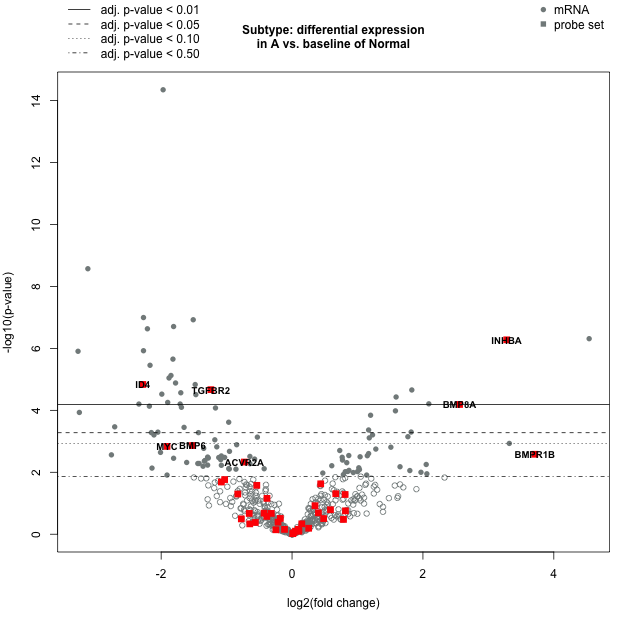
Volcano Plot: SubtypeA
Volcano plot displaying each gene's -log10(p-value) and log2 fold change for the selected covariate. Highly statistically significant genes fall at the top of the plot, and highly differentially expressed genes fall to either side. Genes within the selected gene set are highlighted in blue. Green point colors and horizontal lines indicate various False Discovery Rate (FDR) thresholds.
DE Results - TGF-B genes - SubtypeA
More Plot Information Download CSV DataProbe Label Log2 fold change std error Lower confidence limit Upper confidence limit P-value BY.p.value Gene.sets Codeset.Name Probe.Label Analyte.Type Is.Control Control.Type Probe.Annotation KEGG.Pathways Cell.Type Official.Gene.Name volcanocol volcanopch tstats.all INHBA-mRNA 3.28 0.574 2.16 4.41 5.29e-07 0.000263 TGF-B NS_CANCERPATH_C2535 INHBA mRNA 0 TGF-B hsa04060;hsa04350;hsa04550 INHBA chartreuse1 16 5.71428571428571 ID4-mRNA -2.28 0.476 -3.21 -1.34 1.46e-05 0.00345 TGF-B NS_CANCERPATH_C2535 ID4 mRNA 0 TGF-B hsa04350;hsa04550 ID4 chartreuse1 16 -4.78991596638655 TGFBR2-mRNA -1.24 0.265 -1.75 -0.717 2.15e-05 0.00461 MAPK, TGF-B, TXmisReg NS_CANCERPATH_C2535 TGFBR2 mRNA 0 MAPK;TGF-B;TXmisReg hsa04010;hsa04060;hsa04068;hsa04144;hsa04350;hsa04380;hsa04390;hsa04520;hsa04933;hsa05142;hsa05166;hsa05200;hsa05202;hsa05210;hsa05212;hsa05220 TGFBR2 chartreuse1 16 -4.67924528301887 BMP8A-mRNA 2.56 0.589 1.4 3.71 6.47e-05 0.0092 TGF-B NS_CANCERPATH_C2535 BMP8A mRNA 0 TGF-B hsa04350;hsa04390 BMP8A chartreuse2 16 4.34634974533107 BMP6-mRNA -1.52 0.448 -2.39 -0.638 0.00137 0.107 TGF-B NS_CANCERPATH_C2535 BMP6 mRNA 0 TGF-B hsa04350;hsa04390;hsa04913 BMP6 chartreuse4 16 -3.39285714285714 MYC-mRNA -1.91 0.567 -3.02 -0.794 0.00146 0.112 CC.PLS.Apop, JAK-STAT, MAPK, PI3K, TGF-B, TXmisReg, Wnt NS_CANCERPATH_C2535 MYC mRNA 0 CC.PLS.Apop;PI3K;JAK-STAT;MAPK;TGF-B;TXmisReg;Wnt hsa04010;hsa04012;hsa04110;hsa04151;hsa04310;hsa04350;hsa04390;hsa04550;hsa04630;hsa04919;hsa05161;hsa05166;hsa05169;hsa05200;hsa05202;hsa05205;hsa05206;hsa05210;hsa05213;hsa05216;hsa05219;hsa05220;hsa05221;hsa05222;hsa05230 MYC chartreuse4 16 -3.36860670194004 BMPR1B-mRNA 3.71 1.17 1.41 6.01 0.00262 0.171 TGF-B NS_CANCERPATH_C2535 BMPR1B mRNA 0 TGF-B hsa04060;hsa04350;hsa04390;hsa04550 BMPR1B chartreuse4 16 3.17094017094017 ACVR2A-mRNA -0.728 0.246 -1.21 -0.245 0.00467 0.235 TGF-B NS_CANCERPATH_C2535 ACVR2A mRNA 0 TGF-B hsa04060;hsa04350;hsa04550 ACVR2A chartreuse4 16 -2.95934959349594 ID1-mRNA -1.03 0.418 -1.85 -0.21 0.0172 0.567 TGF-B NS_CANCERPATH_C2535 ID1 mRNA 0 TGF-B hsa04015;hsa04350;hsa04390;hsa04550 ID1 azure4 1 -2.46411483253589 SMAD9-mRNA -1.08 0.451 -1.96 -0.194 0.0206 0.653 TGF-B NS_CANCERPATH_C2535 SMAD9 mRNA 0 TGF-B hsa04350;hsa04550 SMAD9 azure4 1 -2.39467849223947 ACVR1B-mRNA 0.438 0.188 0.07 0.806 0.0236 0.721 Driver Gene, TGF-B NS_CANCERPATH_C2535 ACVR1B mRNA 0 TGF-B;Driver Gene hsa04060;hsa04350;hsa04550 ACVR1B azure4 1 2.32978723404255 MAPK3-mRNA -0.538 0.236 -1 -0.0766 0.0264 0.758 MAPK, PI3K, RAS, TGF-B NS_CANCERPATH_C2535 MAPK3 mRNA 0 RAS;PI3K;MAPK;TGF-B hsa04010;hsa04012;hsa04014;hsa04015;hsa04022;hsa04024;hsa04062;hsa04066;hsa04068;hsa04071;hsa04072;hsa04114;hsa04150;hsa04151;hsa04261;hsa04270;hsa04320;hsa04350;hsa04360;hsa04370;hsa04380;hsa04510;hsa04520;hsa04540;hsa04550;hsa04611;hsa04620;hsa04621;hsa04650;hsa04660;hsa04662;hsa04664;hsa04666;hsa04668;hsa04713;hsa04720;hsa04722;hsa04723;hsa04724;hsa04725;hsa04726;hsa04730;hsa04810;hsa04910;hsa04912;hsa04914;hsa04915;hsa04916;hsa04917;hsa04919;hsa04921;hsa04930;hsa04933;hsa04960;hsa05010;hsa05020;hsa05034;hsa05131;hsa05132;hsa05133;hsa05140;hsa05142;hsa05145;hsa05152;hsa05160;hsa05161;hsa05164;hsa05200;hsa05203;hsa05205;hsa05210;hsa05211;hsa05212;hsa05213;hsa05214;hsa05215;hsa05216;hsa05218;hsa05219;hsa05220;hsa05221;hsa05223;hsa05230;hsa05231 MAPK3 azure4 1 -2.27966101694915 TGFB1-mRNA 0.668 0.332 0.018 1.32 0.0492 1 CC.PLS.Apop, MAPK, TGF-B NS_CANCERPATH_C2535 TGFB1 mRNA 0 CC.PLS.Apop;MAPK;TGF-B hsa04010;hsa04060;hsa04068;hsa04110;hsa04144;hsa04350;hsa04380;hsa04390;hsa04672;hsa04932;hsa04933;hsa05140;hsa05142;hsa05144;hsa05145;hsa05146;hsa05152;hsa05161;hsa05166;hsa05200;hsa05205;hsa05210;hsa05211;hsa05212;hsa05220;hsa05321;hsa05323;hsa05410;hsa05414 TGFB1 azure4 1 2.01204819277108 LTBP1-mRNA -0.829 0.414 -1.64 -0.0178 0.0504 1 TGF-B NS_CANCERPATH_C2535 LTBP1 mRNA 0 TGF-B hsa04350 LTBP1 azure4 1 -2.0024154589372 TGFB3-mRNA 0.811 0.408 0.0115 1.61 0.0521 1 CC.PLS.Apop, MAPK, TGF-B NS_CANCERPATH_C2535 TGFB3 mRNA 0 CC.PLS.Apop;MAPK;TGF-B hsa04010;hsa04060;hsa04068;hsa04110;hsa04144;hsa04350;hsa04390;hsa04933;hsa05140;hsa05142;hsa05144;hsa05145;hsa05146;hsa05152;hsa05161;hsa05166;hsa05200;hsa05210;hsa05211;hsa05212;hsa05220;hsa05321;hsa05323;hsa05410;hsa05414 TGFB3 azure4 1 1.98774509803922 SMAD4-mRNA -0.383 0.207 -0.787 0.0223 0.0697 1 CC.PLS.Apop, Driver Gene, TGF-B, Wnt NS_CANCERPATH_C2535 SMAD4 mRNA 0 CC.PLS.Apop;TGF-B;Wnt;Driver Gene hsa04068;hsa04110;hsa04310;hsa04350;hsa04390;hsa04520;hsa04550;hsa04933;hsa05161;hsa05166;hsa05200;hsa05210;hsa05212;hsa05220 SMAD4 azure4 1 -1.85024154589372 RHOA-mRNA 0.351 0.222 -0.0836 0.785 0.12 1 RAS, TGF-B, Wnt NS_CANCERPATH_C2535 RHOA mRNA 0 RAS;TGF-B;Wnt hsa04014;hsa04015;hsa04022;hsa04024;hsa04062;hsa04071;hsa04072;hsa04144;hsa04270;hsa04310;hsa04350;hsa04360;hsa04510;hsa04520;hsa04530;hsa04611;hsa04660;hsa04670;hsa04722;hsa04810;hsa04921;hsa04972;hsa05100;hsa05130;hsa05133;hsa05152;hsa05200;hsa05203;hsa05205;hsa05206;hsa05210 RHOA azure4 1 1.58108108108108 LEFTY1-mRNA 0.587 0.414 -0.224 1.4 0.162 1 TGF-B NS_CANCERPATH_C2535 LEFTY1 mRNA 0 TGF-B hsa04350 LEFTY1 azure4 1 1.41787439613527 TNF-mRNA 0.816 0.595 -0.35 1.98 0.176 1 CC.PLS.Apop, MAPK, TGF-B NS_CANCERPATH_C2535 TNF mRNA 0 CC.PLS.Apop;MAPK;TGF-B hsa04010;hsa04060;hsa04064;hsa04071;hsa04150;hsa04210;hsa04350;hsa04380;hsa04612;hsa04620;hsa04621;hsa04622;hsa04640;hsa04650;hsa04660;hsa04664;hsa04668;hsa04920;hsa04930;hsa04931;hsa04932;hsa04933;hsa04940;hsa05010;hsa05014;hsa05133;hsa05134;hsa05140;hsa05142;hsa05143;hsa05144;hsa05145;hsa05146;hsa05152;hsa05160;hsa05161;hsa05164;hsa05166;hsa05168;hsa05205;hsa05310;hsa05321;hsa05322;hsa05323;hsa05330;hsa05332;hsa05410;hsa05414 TNF azure4 1 1.37142857142857 TFDP1-mRNA 0.403 0.313 -0.211 1.02 0.204 1 CC.PLS.Apop, TGF-B NS_CANCERPATH_C2535 TFDP1 mRNA 0 CC.PLS.Apop;TGF-B hsa04110;hsa04350 TFDP1 azure4 1 1.28753993610224 DE Results - TGF-B genes - SubtypeA
Table displaying each sample's global significance scores and directed global significance scores as defined in the heatmaps above. The global significance score is calculated as the square root of the mean squared t-statistic for the genes in a gene set, with t-statistics coming from the linear regression underlying our differential expression analysis. The directed global significance score is calculated as the square root of the mean signed squared t-statistic for the genes in a gene set, with t-statistics coming from the linear regression underlying our differential expression analysis.
Volcano Plot: SubtypeB
More Plot Information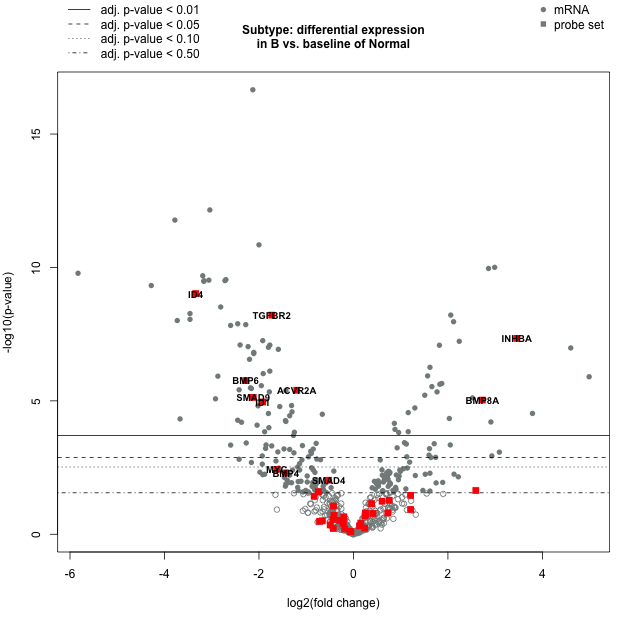
Volcano Plot: SubtypeB
Volcano plot displaying each gene's -log10(p-value) and log2 fold change for the selected covariate. Highly statistically significant genes fall at the top of the plot, and highly differentially expressed genes fall to either side. Genes within the selected gene set are highlighted in blue. Green point colors and horizontal lines indicate various False Discovery Rate (FDR) thresholds.
DE Results - TGF-B genes - SubtypeB
More Plot Information Download CSV DataProbe Label Log2 fold change std error Lower confidence limit Upper confidence limit P-value BY.p.value Gene.sets Codeset.Name Probe.Label Analyte.Type Is.Control Control.Type Probe.Annotation KEGG.Pathways Cell.Type Official.Gene.Name volcanocol volcanopch tstats.all ID4-mRNA -3.34 0.449 -4.22 -2.46 9.52e-10 2.52e-07 TGF-B NS_CANCERPATH_C2535 ID4 mRNA 0 TGF-B hsa04350;hsa04550 ID4 chartreuse1 16 -7.43875278396436 TGFBR2-mRNA -1.73 0.249 -2.22 -1.24 6.13e-09 1.28e-06 MAPK, TGF-B, TXmisReg NS_CANCERPATH_C2535 TGFBR2 mRNA 0 MAPK;TGF-B;TXmisReg hsa04010;hsa04060;hsa04068;hsa04144;hsa04350;hsa04380;hsa04390;hsa04520;hsa04933;hsa05142;hsa05166;hsa05200;hsa05202;hsa05210;hsa05212;hsa05220 TGFBR2 chartreuse1 16 -6.94779116465863 INHBA-mRNA 3.46 0.541 2.4 4.52 4.55e-08 6.96e-06 TGF-B NS_CANCERPATH_C2535 INHBA mRNA 0 TGF-B hsa04060;hsa04350;hsa04550 INHBA chartreuse1 16 6.39556377079482 BMP6-mRNA -2.28 0.422 -3.1 -1.45 1.74e-06 0.000154 TGF-B NS_CANCERPATH_C2535 BMP6 mRNA 0 TGF-B hsa04350;hsa04390;hsa04913 BMP6 chartreuse1 16 -5.40284360189573 ACVR2A-mRNA -1.2 0.232 -1.65 -0.741 4.01e-06 0.000301 TGF-B NS_CANCERPATH_C2535 ACVR2A mRNA 0 TGF-B hsa04060;hsa04350;hsa04550 ACVR2A chartreuse1 16 -5.17241379310345 SMAD9-mRNA -2.12 0.425 -2.95 -1.28 7.43e-06 0.00051 TGF-B NS_CANCERPATH_C2535 SMAD9 mRNA 0 TGF-B hsa04350;hsa04550 SMAD9 chartreuse1 16 -4.98823529411765 BMP8A-mRNA 2.73 0.555 1.64 3.81 9.35e-06 0.00061 TGF-B NS_CANCERPATH_C2535 BMP8A mRNA 0 TGF-B hsa04350;hsa04390 BMP8A chartreuse1 16 4.91891891891892 ID1-mRNA -1.92 0.394 -2.69 -1.14 1.1e-05 0.000704 TGF-B NS_CANCERPATH_C2535 ID1 mRNA 0 TGF-B hsa04015;hsa04350;hsa04390;hsa04550 ID1 chartreuse1 16 -4.87309644670051 MYC-mRNA -1.62 0.534 -2.67 -0.577 0.00369 0.111 CC.PLS.Apop, JAK-STAT, MAPK, PI3K, TGF-B, TXmisReg, Wnt NS_CANCERPATH_C2535 MYC mRNA 0 CC.PLS.Apop;PI3K;JAK-STAT;MAPK;TGF-B;TXmisReg;Wnt hsa04010;hsa04012;hsa04110;hsa04151;hsa04310;hsa04350;hsa04390;hsa04550;hsa04630;hsa04919;hsa05161;hsa05166;hsa05169;hsa05200;hsa05202;hsa05205;hsa05206;hsa05210;hsa05213;hsa05216;hsa05219;hsa05220;hsa05221;hsa05222;hsa05230 MYC chartreuse4 16 -3.03370786516854 BMP4-mRNA -1.43 0.488 -2.39 -0.474 0.00503 0.137 HH, TGF-B NS_CANCERPATH_C2535 BMP4 mRNA 0 TGF-B;HH hsa04340;hsa04350;hsa04390;hsa04550;hsa04919;hsa05200;hsa05217 BMP4 chartreuse4 16 -2.93032786885246 SMAD4-mRNA -0.524 0.195 -0.906 -0.143 0.00946 0.224 CC.PLS.Apop, Driver Gene, TGF-B, Wnt NS_CANCERPATH_C2535 SMAD4 mRNA 0 CC.PLS.Apop;TGF-B;Wnt;Driver Gene hsa04068;hsa04110;hsa04310;hsa04350;hsa04390;hsa04520;hsa04550;hsa04933;hsa05161;hsa05166;hsa05200;hsa05210;hsa05212;hsa05220 SMAD4 chartreuse4 16 -2.68717948717949 BMPR1B-mRNA 2.59 1.11 0.424 4.76 0.0229 0.429 TGF-B NS_CANCERPATH_C2535 BMPR1B mRNA 0 TGF-B hsa04060;hsa04350;hsa04390;hsa04550 BMPR1B chartreuse4 16 2.33333333333333 SMAD3-mRNA -0.742 0.323 -1.38 -0.109 0.0256 0.468 CC.PLS.Apop, TGF-B, Wnt NS_CANCERPATH_C2535 SMAD3 mRNA 0 CC.PLS.Apop;TGF-B;Wnt hsa04068;hsa04110;hsa04144;hsa04310;hsa04350;hsa04390;hsa04520;hsa04550;hsa04933;hsa05142;hsa05161;hsa05166;hsa05200;hsa05210;hsa05212;hsa05220;hsa05321 SMAD3 chartreuse4 16 -2.29721362229102 TNF-mRNA 1.21 0.56 0.116 2.31 0.0349 0.57 CC.PLS.Apop, MAPK, TGF-B NS_CANCERPATH_C2535 TNF mRNA 0 CC.PLS.Apop;MAPK;TGF-B hsa04010;hsa04060;hsa04064;hsa04071;hsa04150;hsa04210;hsa04350;hsa04380;hsa04612;hsa04620;hsa04621;hsa04622;hsa04640;hsa04650;hsa04660;hsa04664;hsa04668;hsa04920;hsa04930;hsa04931;hsa04932;hsa04933;hsa04940;hsa05010;hsa05014;hsa05133;hsa05134;hsa05140;hsa05142;hsa05143;hsa05144;hsa05145;hsa05146;hsa05152;hsa05160;hsa05161;hsa05164;hsa05166;hsa05168;hsa05205;hsa05310;hsa05321;hsa05322;hsa05323;hsa05330;hsa05332;hsa05410;hsa05414 TNF azure4 1 2.16071428571429 LTBP1-mRNA -0.832 0.39 -1.6 -0.0677 0.0376 0.603 TGF-B NS_CANCERPATH_C2535 LTBP1 mRNA 0 TGF-B hsa04350 LTBP1 azure4 1 -2.13333333333333 E2F5-mRNA 0.758 0.383 0.00665 1.51 0.0533 0.813 CC.PLS.Apop, TGF-B NS_CANCERPATH_C2535 E2F5 mRNA 0 CC.PLS.Apop;TGF-B hsa04110;hsa04350 E2F5 azure4 1 1.97911227154047 TGFB1-mRNA 0.606 0.312 -0.0062 1.22 0.0578 0.861 CC.PLS.Apop, MAPK, TGF-B NS_CANCERPATH_C2535 TGFB1 mRNA 0 CC.PLS.Apop;MAPK;TGF-B hsa04010;hsa04060;hsa04068;hsa04110;hsa04144;hsa04350;hsa04380;hsa04390;hsa04672;hsa04932;hsa04933;hsa05140;hsa05142;hsa05144;hsa05145;hsa05146;hsa05152;hsa05161;hsa05166;hsa05200;hsa05205;hsa05210;hsa05211;hsa05212;hsa05220;hsa05321;hsa05323;hsa05410;hsa05414 TGFB1 azure4 1 1.94230769230769 RHOA-mRNA 0.385 0.209 -0.0243 0.794 0.071 1 RAS, TGF-B, Wnt NS_CANCERPATH_C2535 RHOA mRNA 0 RAS;TGF-B;Wnt hsa04014;hsa04015;hsa04022;hsa04024;hsa04062;hsa04071;hsa04072;hsa04144;hsa04270;hsa04310;hsa04350;hsa04360;hsa04510;hsa04520;hsa04530;hsa04611;hsa04660;hsa04670;hsa04722;hsa04810;hsa04921;hsa04972;hsa05100;hsa05130;hsa05133;hsa05152;hsa05200;hsa05203;hsa05205;hsa05206;hsa05210 RHOA azure4 1 1.84210526315789 PPP2CB-mRNA -0.422 0.242 -0.897 0.0534 0.0878 1 PI3K, TGF-B NS_CANCERPATH_C2535 PPP2CB mRNA 0 PI3K;TGF-B hsa04071;hsa04114;hsa04151;hsa04152;hsa04261;hsa04350;hsa04390;hsa04530;hsa04728;hsa04730;hsa05142;hsa05160 PPP2CB azure4 1 -1.74380165289256 BAMBI-mRNA 1.21 0.758 -0.28 2.69 0.118 1 TGF-B, Wnt NS_CANCERPATH_C2535 BAMBI mRNA 0 TGF-B;Wnt hsa04310;hsa04350 BAMBI azure4 1 1.59630606860158 DE Results - TGF-B genes - SubtypeB
Table displaying each sample's global significance scores and directed global significance scores as defined in the heatmaps above. The global significance score is calculated as the square root of the mean squared t-statistic for the genes in a gene set, with t-statistics coming from the linear regression underlying our differential expression analysis. The directed global significance score is calculated as the square root of the mean signed squared t-statistic for the genes in a gene set, with t-statistics coming from the linear regression underlying our differential expression analysis.
Volcano Plot: SubtypeC
More Plot Information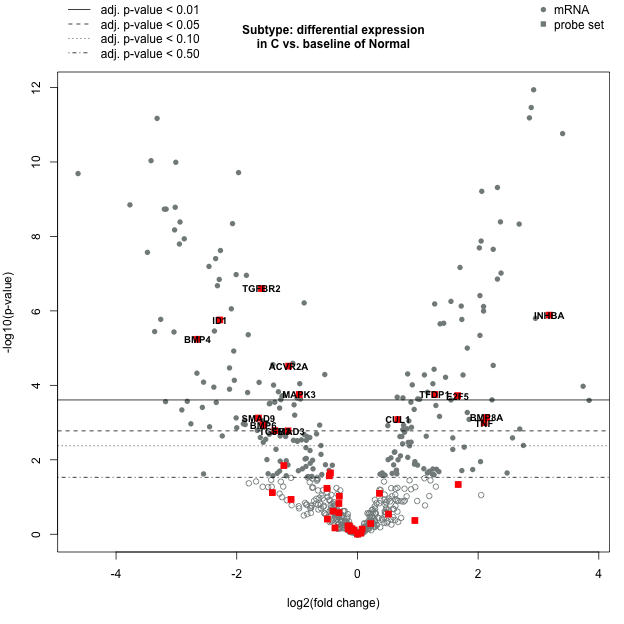
Volcano Plot: SubtypeC
Volcano plot displaying each gene's -log10(p-value) and log2 fold change for the selected covariate. Highly statistically significant genes fall at the top of the plot, and highly differentially expressed genes fall to either side. Genes within the selected gene set are highlighted in blue. Green point colors and horizontal lines indicate various False Discovery Rate (FDR) thresholds.
DE Results - TGF-B genes - SubtypeC
More Plot Information Download CSV DataProbe Label Log2 fold change std error Lower confidence limit Upper confidence limit P-value BY.p.value Gene.sets Codeset.Name Probe.Label Analyte.Type Is.Control Control.Type Probe.Annotation KEGG.Pathways Cell.Type Official.Gene.Name volcanocol volcanopch tstats.all TGFBR2-mRNA -1.59 0.268 -2.11 -1.06 2.51e-07 2.7e-05 MAPK, TGF-B, TXmisReg NS_CANCERPATH_C2535 TGFBR2 mRNA 0 MAPK;TGF-B;TXmisReg hsa04010;hsa04060;hsa04068;hsa04144;hsa04350;hsa04380;hsa04390;hsa04520;hsa04933;hsa05142;hsa05166;hsa05200;hsa05202;hsa05210;hsa05212;hsa05220 TGFBR2 chartreuse1 16 -5.93283582089552 INHBA-mRNA 3.18 0.582 2.04 4.32 1.3e-06 0.000112 TGF-B NS_CANCERPATH_C2535 INHBA mRNA 0 TGF-B hsa04060;hsa04350;hsa04550 INHBA chartreuse1 16 5.4639175257732 ID1-mRNA -2.28 0.423 -3.11 -1.45 1.75e-06 0.000139 TGF-B NS_CANCERPATH_C2535 ID1 mRNA 0 TGF-B hsa04015;hsa04350;hsa04390;hsa04550 ID1 chartreuse1 16 -5.39007092198582 BMP4-mRNA -2.65 0.525 -3.68 -1.62 5.79e-06 0.000397 HH, TGF-B NS_CANCERPATH_C2535 BMP4 mRNA 0 TGF-B;HH hsa04340;hsa04350;hsa04390;hsa04550;hsa04919;hsa05200;hsa05217 BMP4 chartreuse1 16 -5.04761904761905 ACVR2A-mRNA -1.14 0.249 -1.63 -0.651 3.05e-05 0.0019 TGF-B NS_CANCERPATH_C2535 ACVR2A mRNA 0 TGF-B hsa04060;hsa04350;hsa04550 ACVR2A chartreuse1 16 -4.57831325301205 TFDP1-mRNA 1.28 0.317 0.66 1.9 0.000176 0.00804 CC.PLS.Apop, TGF-B NS_CANCERPATH_C2535 TFDP1 mRNA 0 CC.PLS.Apop;TGF-B hsa04110;hsa04350 TFDP1 chartreuse1 16 4.03785488958991 MAPK3-mRNA -0.965 0.239 -1.43 -0.497 0.000176 0.00804 MAPK, PI3K, RAS, TGF-B NS_CANCERPATH_C2535 MAPK3 mRNA 0 RAS;PI3K;MAPK;TGF-B hsa04010;hsa04012;hsa04014;hsa04015;hsa04022;hsa04024;hsa04062;hsa04066;hsa04068;hsa04071;hsa04072;hsa04114;hsa04150;hsa04151;hsa04261;hsa04270;hsa04320;hsa04350;hsa04360;hsa04370;hsa04380;hsa04510;hsa04520;hsa04540;hsa04550;hsa04611;hsa04620;hsa04621;hsa04650;hsa04660;hsa04662;hsa04664;hsa04666;hsa04668;hsa04713;hsa04720;hsa04722;hsa04723;hsa04724;hsa04725;hsa04726;hsa04730;hsa04810;hsa04910;hsa04912;hsa04914;hsa04915;hsa04916;hsa04917;hsa04919;hsa04921;hsa04930;hsa04933;hsa04960;hsa05010;hsa05020;hsa05034;hsa05131;hsa05132;hsa05133;hsa05140;hsa05142;hsa05145;hsa05152;hsa05160;hsa05161;hsa05164;hsa05200;hsa05203;hsa05205;hsa05210;hsa05211;hsa05212;hsa05213;hsa05214;hsa05215;hsa05216;hsa05218;hsa05219;hsa05220;hsa05221;hsa05223;hsa05230;hsa05231 MAPK3 chartreuse1 16 -4.03765690376569 E2F5-mRNA 1.66 0.412 0.849 2.47 0.000189 0.00847 CC.PLS.Apop, TGF-B NS_CANCERPATH_C2535 E2F5 mRNA 0 CC.PLS.Apop;TGF-B hsa04110;hsa04350 E2F5 chartreuse1 16 4.02912621359223 BMP8A-mRNA 2.14 0.597 0.972 3.31 0.000733 0.0249 TGF-B NS_CANCERPATH_C2535 BMP8A mRNA 0 TGF-B hsa04350;hsa04390 BMP8A chartreuse2 16 3.58458961474037 SMAD9-mRNA -1.64 0.457 -2.53 -0.74 0.000757 0.0253 TGF-B NS_CANCERPATH_C2535 SMAD9 mRNA 0 TGF-B hsa04350;hsa04550 SMAD9 chartreuse2 16 -3.58862144420131 CUL1-mRNA 0.669 0.188 0.299 1.04 0.000829 0.0272 CC.PLS.Apop, TGF-B, Wnt NS_CANCERPATH_C2535 CUL1 mRNA 0 CC.PLS.Apop;TGF-B;Wnt hsa04110;hsa04114;hsa04120;hsa04141;hsa04310;hsa04350;hsa05168 CUL1 chartreuse2 16 3.55851063829787 TNF-mRNA 2.1 0.602 0.919 3.28 0.00101 0.0318 CC.PLS.Apop, MAPK, TGF-B NS_CANCERPATH_C2535 TNF mRNA 0 CC.PLS.Apop;MAPK;TGF-B hsa04010;hsa04060;hsa04064;hsa04071;hsa04150;hsa04210;hsa04350;hsa04380;hsa04612;hsa04620;hsa04621;hsa04622;hsa04640;hsa04650;hsa04660;hsa04664;hsa04668;hsa04920;hsa04930;hsa04931;hsa04932;hsa04933;hsa04940;hsa05010;hsa05014;hsa05133;hsa05134;hsa05140;hsa05142;hsa05143;hsa05144;hsa05145;hsa05146;hsa05152;hsa05160;hsa05161;hsa05164;hsa05166;hsa05168;hsa05205;hsa05310;hsa05321;hsa05322;hsa05323;hsa05330;hsa05332;hsa05410;hsa05414 TNF chartreuse2 16 3.48837209302326 BMP6-mRNA -1.56 0.454 -2.45 -0.67 0.00117 0.0352 TGF-B NS_CANCERPATH_C2535 BMP6 mRNA 0 TGF-B hsa04350;hsa04390;hsa04913 BMP6 chartreuse2 16 -3.43612334801762 TGFB3-mRNA -1.37 0.413 -2.18 -0.562 0.00165 0.0459 CC.PLS.Apop, MAPK, TGF-B NS_CANCERPATH_C2535 TGFB3 mRNA 0 CC.PLS.Apop;MAPK;TGF-B hsa04010;hsa04060;hsa04068;hsa04110;hsa04144;hsa04350;hsa04390;hsa04933;hsa05140;hsa05142;hsa05144;hsa05145;hsa05146;hsa05152;hsa05161;hsa05166;hsa05200;hsa05210;hsa05211;hsa05212;hsa05220;hsa05321;hsa05323;hsa05410;hsa05414 TGFB3 chartreuse2 16 -3.31719128329298 SMAD3-mRNA -1.15 0.347 -1.83 -0.471 0.00167 0.0461 CC.PLS.Apop, TGF-B, Wnt NS_CANCERPATH_C2535 SMAD3 mRNA 0 CC.PLS.Apop;TGF-B;Wnt hsa04068;hsa04110;hsa04144;hsa04310;hsa04350;hsa04390;hsa04520;hsa04550;hsa04933;hsa05142;hsa05161;hsa05166;hsa05200;hsa05210;hsa05212;hsa05220;hsa05321 SMAD3 chartreuse3 16 -3.31412103746398 ID4-mRNA -1.22 0.483 -2.17 -0.278 0.0143 0.283 TGF-B NS_CANCERPATH_C2535 ID4 mRNA 0 TGF-B hsa04350;hsa04550 ID4 chartreuse4 16 -2.52587991718427 ACVR1B-mRNA -0.447 0.19 -0.82 -0.0742 0.0226 0.409 Driver Gene, TGF-B NS_CANCERPATH_C2535 ACVR1B mRNA 0 TGF-B;Driver Gene hsa04060;hsa04350;hsa04550 ACVR1B chartreuse4 16 -2.35263157894737 SKP1-mRNA -0.465 0.204 -0.864 -0.0649 0.0269 0.455 CC.PLS.Apop, TGF-B, Wnt NS_CANCERPATH_C2535 SKP1 mRNA 0 CC.PLS.Apop;TGF-B;Wnt hsa04110;hsa04114;hsa04120;hsa04141;hsa04310;hsa04350;hsa05168 SKP1 chartreuse4 16 -2.27941176470588 BAMBI-mRNA 1.67 0.815 0.0683 3.26 0.0461 0.721 TGF-B, Wnt NS_CANCERPATH_C2535 BAMBI mRNA 0 TGF-B;Wnt hsa04310;hsa04350 BAMBI azure4 1 2.04907975460123 PPP2CB-mRNA -0.505 0.261 -1.02 0.00626 0.0583 0.872 PI3K, TGF-B NS_CANCERPATH_C2535 PPP2CB mRNA 0 PI3K;TGF-B hsa04071;hsa04114;hsa04151;hsa04152;hsa04261;hsa04350;hsa04390;hsa04530;hsa04728;hsa04730;hsa05142;hsa05160 PPP2CB azure4 1 -1.93486590038314 DE Results - TGF-B genes - SubtypeC
Table displaying each sample's global significance scores and directed global significance scores as defined in the heatmaps above. The global significance score is calculated as the square root of the mean squared t-statistic for the genes in a gene set, with t-statistics coming from the linear regression underlying our differential expression analysis. The directed global significance score is calculated as the square root of the mean signed squared t-statistic for the genes in a gene set, with t-statistics coming from the linear regression underlying our differential expression analysis.
Volcano Plot: SubtypeD
More Plot Information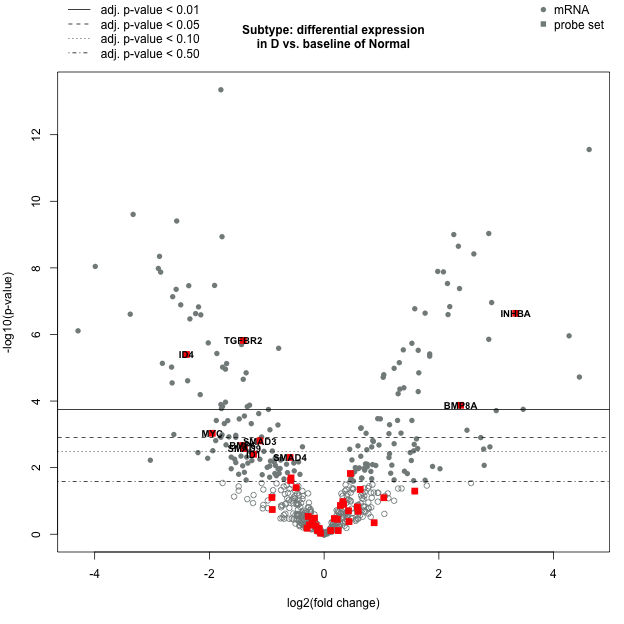
Volcano Plot: SubtypeD
Volcano plot displaying each gene's -log10(p-value) and log2 fold change for the selected covariate. Highly statistically significant genes fall at the top of the plot, and highly differentially expressed genes fall to either side. Genes within the selected gene set are highlighted in blue. Green point colors and horizontal lines indicate various False Discovery Rate (FDR) thresholds.
DE Results - TGF-B genes - SubtypeD
More Plot Information Download CSV DataProbe Label Log2 fold change std error Lower confidence limit Upper confidence limit P-value BY.p.value Gene.sets Codeset.Name Probe.Label Analyte.Type Is.Control Control.Type Probe.Annotation KEGG.Pathways Cell.Type Official.Gene.Name volcanocol volcanopch tstats.all INHBA-mRNA 3.34 0.562 2.24 4.45 2.32e-07 3.21e-05 TGF-B NS_CANCERPATH_C2535 INHBA mRNA 0 TGF-B hsa04060;hsa04350;hsa04550 INHBA chartreuse1 16 5.94306049822064 TGFBR2-mRNA -1.41 0.259 -1.91 -0.899 1.51e-06 0.000163 MAPK, TGF-B, TXmisReg NS_CANCERPATH_C2535 TGFBR2 mRNA 0 MAPK;TGF-B;TXmisReg hsa04010;hsa04060;hsa04068;hsa04144;hsa04350;hsa04380;hsa04390;hsa04520;hsa04933;hsa05142;hsa05166;hsa05200;hsa05202;hsa05210;hsa05212;hsa05220 TGFBR2 chartreuse1 16 -5.44401544401544 ID4-mRNA -2.4 0.466 -3.32 -1.49 3.99e-06 0.000345 TGF-B NS_CANCERPATH_C2535 ID4 mRNA 0 TGF-B hsa04350;hsa04550 ID4 chartreuse1 16 -5.15021459227468 BMP8A-mRNA 2.38 0.577 1.25 3.51 0.000134 0.00749 TGF-B NS_CANCERPATH_C2535 BMP8A mRNA 0 TGF-B hsa04350;hsa04390 BMP8A chartreuse1 16 4.12478336221837 MYC-mRNA -1.95 0.555 -3.04 -0.862 0.000928 0.0381 CC.PLS.Apop, JAK-STAT, MAPK, PI3K, TGF-B, TXmisReg, Wnt NS_CANCERPATH_C2535 MYC mRNA 0 CC.PLS.Apop;PI3K;JAK-STAT;MAPK;TGF-B;TXmisReg;Wnt hsa04010;hsa04012;hsa04110;hsa04151;hsa04310;hsa04350;hsa04390;hsa04550;hsa04630;hsa04919;hsa05161;hsa05166;hsa05169;hsa05200;hsa05202;hsa05205;hsa05206;hsa05210;hsa05213;hsa05216;hsa05219;hsa05220;hsa05221;hsa05222;hsa05230 MYC chartreuse2 16 -3.51351351351351 SMAD3-mRNA -1.12 0.336 -1.78 -0.463 0.00157 0.0566 CC.PLS.Apop, TGF-B, Wnt NS_CANCERPATH_C2535 SMAD3 mRNA 0 CC.PLS.Apop;TGF-B;Wnt hsa04068;hsa04110;hsa04144;hsa04310;hsa04350;hsa04390;hsa04520;hsa04550;hsa04933;hsa05142;hsa05161;hsa05166;hsa05200;hsa05210;hsa05212;hsa05220;hsa05321 SMAD3 chartreuse3 16 -3.33333333333333 BMP6-mRNA -1.42 0.439 -2.28 -0.556 0.00217 0.0745 TGF-B NS_CANCERPATH_C2535 BMP6 mRNA 0 TGF-B hsa04350;hsa04390;hsa04913 BMP6 chartreuse3 16 -3.23462414578588 SMAD9-mRNA -1.39 0.442 -2.26 -0.528 0.00267 0.087 TGF-B NS_CANCERPATH_C2535 SMAD9 mRNA 0 TGF-B hsa04350;hsa04550 SMAD9 chartreuse3 16 -3.1447963800905 ID1-mRNA -1.23 0.409 -2.04 -0.432 0.00396 0.118 TGF-B NS_CANCERPATH_C2535 ID1 mRNA 0 TGF-B hsa04015;hsa04350;hsa04390;hsa04550 ID1 chartreuse4 16 -3.00733496332518 SMAD4-mRNA -0.594 0.202 -0.991 -0.198 0.00493 0.14 CC.PLS.Apop, Driver Gene, TGF-B, Wnt NS_CANCERPATH_C2535 SMAD4 mRNA 0 CC.PLS.Apop;TGF-B;Wnt;Driver Gene hsa04068;hsa04110;hsa04310;hsa04350;hsa04390;hsa04520;hsa04550;hsa04933;hsa05161;hsa05166;hsa05200;hsa05210;hsa05212;hsa05220 SMAD4 chartreuse4 16 -2.94059405940594 CUL1-mRNA 0.458 0.182 0.101 0.815 0.015 0.315 CC.PLS.Apop, TGF-B, Wnt NS_CANCERPATH_C2535 CUL1 mRNA 0 CC.PLS.Apop;TGF-B;Wnt hsa04110;hsa04114;hsa04120;hsa04141;hsa04310;hsa04350;hsa05168 CUL1 chartreuse4 16 2.51648351648352 ACVR2A-mRNA -0.577 0.241 -1.05 -0.105 0.0203 0.409 TGF-B NS_CANCERPATH_C2535 ACVR2A mRNA 0 TGF-B hsa04060;hsa04350;hsa04550 ACVR2A chartreuse4 16 -2.39419087136929 PPP2CB-mRNA -0.585 0.252 -1.08 -0.0911 0.0242 0.465 PI3K, TGF-B NS_CANCERPATH_C2535 PPP2CB mRNA 0 PI3K;TGF-B hsa04071;hsa04114;hsa04151;hsa04152;hsa04261;hsa04350;hsa04390;hsa04530;hsa04728;hsa04730;hsa05142;hsa05160 PPP2CB chartreuse4 16 -2.32142857142857 MAPK3-mRNA -0.487 0.231 -0.939 -0.0344 0.0398 0.703 MAPK, PI3K, RAS, TGF-B NS_CANCERPATH_C2535 MAPK3 mRNA 0 RAS;PI3K;MAPK;TGF-B hsa04010;hsa04012;hsa04014;hsa04015;hsa04022;hsa04024;hsa04062;hsa04066;hsa04068;hsa04071;hsa04072;hsa04114;hsa04150;hsa04151;hsa04261;hsa04270;hsa04320;hsa04350;hsa04360;hsa04370;hsa04380;hsa04510;hsa04520;hsa04540;hsa04550;hsa04611;hsa04620;hsa04621;hsa04650;hsa04660;hsa04662;hsa04664;hsa04666;hsa04668;hsa04713;hsa04720;hsa04722;hsa04723;hsa04724;hsa04725;hsa04726;hsa04730;hsa04810;hsa04910;hsa04912;hsa04914;hsa04915;hsa04916;hsa04917;hsa04919;hsa04921;hsa04930;hsa04933;hsa04960;hsa05010;hsa05020;hsa05034;hsa05131;hsa05132;hsa05133;hsa05140;hsa05142;hsa05145;hsa05152;hsa05160;hsa05161;hsa05164;hsa05200;hsa05203;hsa05205;hsa05210;hsa05211;hsa05212;hsa05213;hsa05214;hsa05215;hsa05216;hsa05218;hsa05219;hsa05220;hsa05221;hsa05223;hsa05230;hsa05231 MAPK3 azure4 1 -2.10822510822511 TFDP1-mRNA 0.629 0.306 0.0286 1.23 0.0451 0.762 CC.PLS.Apop, TGF-B NS_CANCERPATH_C2535 TFDP1 mRNA 0 CC.PLS.Apop;TGF-B hsa04110;hsa04350 TFDP1 azure4 1 2.05555555555556 BAMBI-mRNA 1.58 0.788 0.0327 3.12 0.0506 0.825 TGF-B, Wnt NS_CANCERPATH_C2535 BAMBI mRNA 0 TGF-B;Wnt hsa04310;hsa04350 BAMBI azure4 1 2.00507614213198 BMP4-mRNA -0.91 0.508 -1.91 0.0851 0.0789 1 HH, TGF-B NS_CANCERPATH_C2535 BMP4 mRNA 0 TGF-B;HH hsa04340;hsa04350;hsa04390;hsa04550;hsa04919;hsa05200;hsa05217 BMP4 azure4 1 -1.79133858267717 TNF-mRNA 1.04 0.582 -0.102 2.18 0.0801 1 CC.PLS.Apop, MAPK, TGF-B NS_CANCERPATH_C2535 TNF mRNA 0 CC.PLS.Apop;MAPK;TGF-B hsa04010;hsa04060;hsa04064;hsa04071;hsa04150;hsa04210;hsa04350;hsa04380;hsa04612;hsa04620;hsa04621;hsa04622;hsa04640;hsa04650;hsa04660;hsa04664;hsa04668;hsa04920;hsa04930;hsa04931;hsa04932;hsa04933;hsa04940;hsa05010;hsa05014;hsa05133;hsa05134;hsa05140;hsa05142;hsa05143;hsa05144;hsa05145;hsa05146;hsa05152;hsa05160;hsa05161;hsa05164;hsa05166;hsa05168;hsa05205;hsa05310;hsa05321;hsa05322;hsa05323;hsa05330;hsa05332;hsa05410;hsa05414 TNF azure4 1 1.78694158075601 RBX1-mRNA 0.325 0.197 -0.0613 0.712 0.105 1 CC.PLS.Apop, TGF-B, Wnt NS_CANCERPATH_C2535 RBX1 mRNA 0 CC.PLS.Apop;TGF-B;Wnt hsa03420;hsa04066;hsa04110;hsa04114;hsa04120;hsa04141;hsa04310;hsa04350;hsa05200;hsa05211 RBX1 azure4 1 1.6497461928934 RHOA-mRNA 0.339 0.217 -0.0865 0.764 0.125 1 RAS, TGF-B, Wnt NS_CANCERPATH_C2535 RHOA mRNA 0 RAS;TGF-B;Wnt hsa04014;hsa04015;hsa04022;hsa04024;hsa04062;hsa04071;hsa04072;hsa04144;hsa04270;hsa04310;hsa04350;hsa04360;hsa04510;hsa04520;hsa04530;hsa04611;hsa04660;hsa04670;hsa04722;hsa04810;hsa04921;hsa04972;hsa05100;hsa05130;hsa05133;hsa05152;hsa05200;hsa05203;hsa05205;hsa05206;hsa05210 RHOA azure4 1 1.56221198156682 DE Results - TGF-B genes - SubtypeD
Table displaying each sample's global significance scores and directed global significance scores as defined in the heatmaps above. The global significance score is calculated as the square root of the mean squared t-statistic for the genes in a gene set, with t-statistics coming from the linear regression underlying our differential expression analysis. The directed global significance score is calculated as the square root of the mean signed squared t-statistic for the genes in a gene set, with t-statistics coming from the linear regression underlying our differential expression analysis.
- Subtype:
- SubtypeA
- SubtypeB
- SubtypeC
- SubtypeD
Volcano Plot: SubtypeA
More Plot Information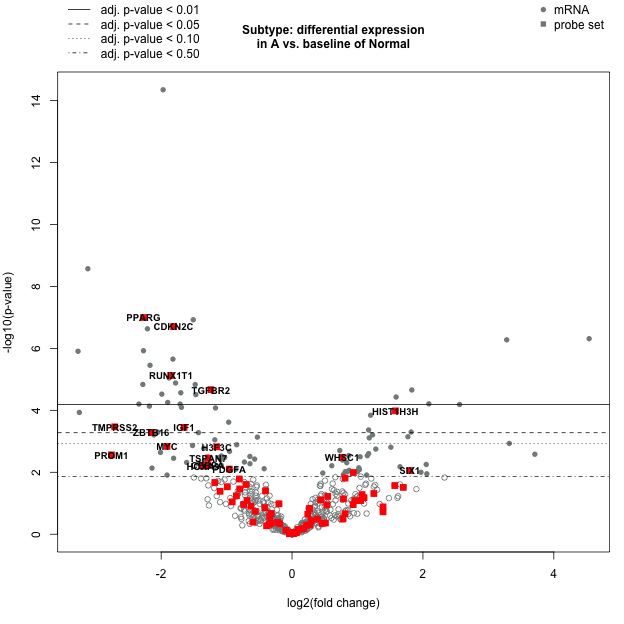
Volcano Plot: SubtypeA
Volcano plot displaying each gene's -log10(p-value) and log2 fold change for the selected covariate. Highly statistically significant genes fall at the top of the plot, and highly differentially expressed genes fall to either side. Genes within the selected gene set are highlighted in blue. Green point colors and horizontal lines indicate various False Discovery Rate (FDR) thresholds.
DE Results - TXmisReg genes - SubtypeA
More Plot Information Download CSV DataProbe Label Log2 fold change std error Lower confidence limit Upper confidence limit P-value BY.p.value Gene.sets Codeset.Name Probe.Label Analyte.Type Is.Control Control.Type Probe.Annotation KEGG.Pathways Cell.Type Official.Gene.Name volcanocol volcanopch tstats.all PPARG-mRNA -2.27 0.368 -2.99 -1.55 1.01e-07 0.000118 TXmisReg NS_CANCERPATH_C2535 PPARG mRNA 0 TXmisReg hsa04152;hsa04211;hsa04380;hsa05016;hsa05200;hsa05202;hsa05216 PPARG chartreuse1 16 -6.16847826086957 CDKN2C-mRNA -1.81 0.301 -2.4 -1.22 1.97e-07 0.000155 CC.PLS.Apop, TXmisReg NS_CANCERPATH_C2535 CDKN2C mRNA 0 CC.PLS.Apop;TXmisReg hsa04110;hsa05166;hsa05202 CDKN2C chartreuse1 16 -6.01328903654485 RUNX1T1-mRNA -1.85 0.372 -2.58 -1.12 7.5e-06 0.0023 TXmisReg NS_CANCERPATH_C2535 RUNX1T1 mRNA 0 TXmisReg hsa05200;hsa05202;hsa05221 RUNX1T1 chartreuse1 16 -4.97311827956989 TGFBR2-mRNA -1.24 0.265 -1.75 -0.717 2.15e-05 0.00461 MAPK, TGF-B, TXmisReg NS_CANCERPATH_C2535 TGFBR2 mRNA 0 MAPK;TGF-B;TXmisReg hsa04010;hsa04060;hsa04068;hsa04144;hsa04350;hsa04380;hsa04390;hsa04520;hsa04933;hsa05142;hsa05166;hsa05200;hsa05202;hsa05210;hsa05212;hsa05220 TGFBR2 chartreuse1 16 -4.67924528301887 HIST1H3H-mRNA 1.58 0.377 0.846 2.32 0.000104 0.0129 TXmisReg NS_CANCERPATH_C2535 HIST1H3H mRNA 0 TXmisReg hsa05034;hsa05202;hsa05322 HIST1H3H chartreuse2 16 4.19098143236074 TMPRSS2-mRNA -2.71 0.707 -4.1 -1.33 0.000341 0.0377 TXmisReg NS_CANCERPATH_C2535 TMPRSS2 mRNA 0 TXmisReg hsa05164;hsa05202 TMPRSS2 chartreuse2 16 -3.83309759547383 IGF1-mRNA -1.65 0.431 -2.49 -0.802 0.000355 0.0382 PI3K, RAS, TXmisReg NS_CANCERPATH_C2535 IGF1 mRNA 0 RAS;PI3K;TXmisReg hsa04014;hsa04015;hsa04066;hsa04068;hsa04114;hsa04115;hsa04150;hsa04151;hsa04152;hsa04211;hsa04510;hsa04550;hsa04730;hsa04750;hsa04913;hsa04914;hsa04960;hsa05200;hsa05202;hsa05205;hsa05214;hsa05215;hsa05218;hsa05410;hsa05414 IGF1 chartreuse2 16 -3.82830626450116 ZBTB16-mRNA -2.15 0.581 -3.29 -1.01 0.000523 0.0497 TXmisReg NS_CANCERPATH_C2535 ZBTB16 mRNA 0 TXmisReg hsa05200;hsa05202;hsa05221 ZBTB16 chartreuse2 16 -3.70051635111876 MYC-mRNA -1.91 0.567 -3.02 -0.794 0.00146 0.112 CC.PLS.Apop, JAK-STAT, MAPK, PI3K, TGF-B, TXmisReg, Wnt NS_CANCERPATH_C2535 MYC mRNA 0 CC.PLS.Apop;PI3K;JAK-STAT;MAPK;TGF-B;TXmisReg;Wnt hsa04010;hsa04012;hsa04110;hsa04151;hsa04310;hsa04350;hsa04390;hsa04550;hsa04630;hsa04919;hsa05161;hsa05166;hsa05169;hsa05200;hsa05202;hsa05205;hsa05206;hsa05210;hsa05213;hsa05216;hsa05219;hsa05220;hsa05221;hsa05222;hsa05230 MYC chartreuse4 16 -3.36860670194004 H3F3C-mRNA -1.15 0.342 -1.82 -0.475 0.00151 0.113 TXmisReg NS_CANCERPATH_C2535 H3F3C mRNA 0 TXmisReg hsa05034;hsa05202;hsa05322 H3F3C chartreuse4 16 -3.3625730994152 PROM1-mRNA -2.76 0.877 -4.48 -1.04 0.00274 0.176 TXmisReg NS_CANCERPATH_C2535 PROM1 mRNA 0 TXmisReg hsa05202 PROM1 chartreuse4 16 -3.14709236031927 WHSC1-mRNA 0.766 0.249 0.279 1.25 0.00328 0.187 TXmisReg NS_CANCERPATH_C2535 WHSC1 mRNA 0 TXmisReg hsa00310;hsa05202 WHSC1 chartreuse4 16 3.07630522088353 TSPAN7-mRNA -1.28 0.418 -2.1 -0.46 0.00348 0.192 TXmisReg NS_CANCERPATH_C2535 TSPAN7 mRNA 0 TXmisReg hsa05202 TSPAN7 chartreuse4 16 -3.0622009569378 CEBPA-mRNA -1.29 0.448 -2.17 -0.409 0.00586 0.271 Driver Gene, TXmisReg NS_CANCERPATH_C2535 CEBPA mRNA 0 TXmisReg;Driver Gene hsa04932;hsa05200;hsa05202;hsa05221 CEBPA chartreuse4 16 -2.87946428571429 HOXA9-mRNA -1.36 0.477 -2.29 -0.421 0.00638 0.285 TXmisReg NS_CANCERPATH_C2535 HOXA9 mRNA 0 TXmisReg hsa05202 HOXA9 chartreuse4 16 -2.85115303983229 PDGFA-mRNA -0.959 0.347 -1.64 -0.279 0.00788 0.329 MAPK, PI3K, RAS, TXmisReg NS_CANCERPATH_C2535 PDGFA mRNA 0 RAS;PI3K;MAPK;TXmisReg hsa04010;hsa04014;hsa04015;hsa04060;hsa04072;hsa04151;hsa04510;hsa04540;hsa04810;hsa05166;hsa05200;hsa05202;hsa05206;hsa05214;hsa05215;hsa05218;hsa05231 PDGFA chartreuse4 16 -2.76368876080692 SIX1-mRNA 1.8 0.662 0.504 3.1 0.0088 0.354 TXmisReg NS_CANCERPATH_C2535 SIX1 mRNA 0 TXmisReg hsa05202 SIX1 chartreuse4 16 2.7190332326284 RUNX1-mRNA 0.936 0.351 0.248 1.62 0.0102 0.391 Driver Gene, TXmisReg NS_CANCERPATH_C2535 RUNX1 mRNA 0 TXmisReg;Driver Gene hsa05200;hsa05202;hsa05220;hsa05221 RUNX1 chartreuse4 16 2.66666666666667 PBX3-mRNA 0.81 0.324 0.176 1.44 0.0154 0.539 TXmisReg NS_CANCERPATH_C2535 PBX3 mRNA 0 TXmisReg hsa05202 PBX3 azure4 1 2.5 CCND2-mRNA -0.805 0.325 -1.44 -0.168 0.0165 0.557 CC.PLS.Apop, JAK-STAT, PI3K, TXmisReg, Wnt NS_CANCERPATH_C2535 CCND2 mRNA 0 CC.PLS.Apop;PI3K;JAK-STAT;TXmisReg;Wnt hsa04068;hsa04110;hsa04115;hsa04151;hsa04310;hsa04390;hsa04510;hsa04630;hsa04917;hsa05162;hsa05166;hsa05202;hsa05203;hsa05206 CCND2 azure4 1 -2.47692307692308 DE Results - TXmisReg genes - SubtypeA
Table displaying each sample's global significance scores and directed global significance scores as defined in the heatmaps above. The global significance score is calculated as the square root of the mean squared t-statistic for the genes in a gene set, with t-statistics coming from the linear regression underlying our differential expression analysis. The directed global significance score is calculated as the square root of the mean signed squared t-statistic for the genes in a gene set, with t-statistics coming from the linear regression underlying our differential expression analysis.
Volcano Plot: SubtypeB
More Plot Information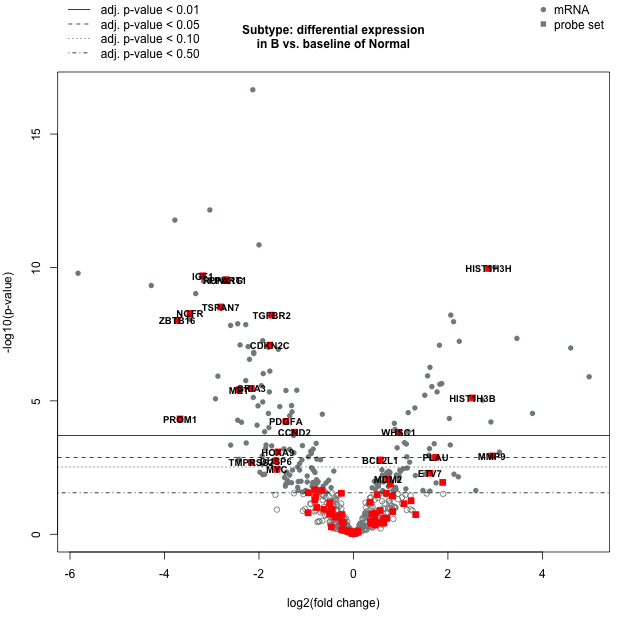
Volcano Plot: SubtypeB
Volcano plot displaying each gene's -log10(p-value) and log2 fold change for the selected covariate. Highly statistically significant genes fall at the top of the plot, and highly differentially expressed genes fall to either side. Genes within the selected gene set are highlighted in blue. Green point colors and horizontal lines indicate various False Discovery Rate (FDR) thresholds.
DE Results - TXmisReg genes - SubtypeB
More Plot Information Download CSV DataProbe Label Log2 fold change std error Lower confidence limit Upper confidence limit P-value BY.p.value Gene.sets Codeset.Name Probe.Label Analyte.Type Is.Control Control.Type Probe.Annotation KEGG.Pathways Cell.Type Official.Gene.Name volcanocol volcanopch tstats.all HIST1H3H-mRNA 2.86 0.355 2.16 3.55 1.09e-10 7.25e-08 TXmisReg NS_CANCERPATH_C2535 HIST1H3H mRNA 0 TXmisReg hsa05034;hsa05202;hsa05322 HIST1H3H chartreuse1 16 8.05633802816901 IGF1-mRNA -3.19 0.406 -3.99 -2.4 2.05e-10 1.01e-07 PI3K, RAS, TXmisReg NS_CANCERPATH_C2535 IGF1 mRNA 0 RAS;PI3K;TXmisReg hsa04014;hsa04015;hsa04066;hsa04068;hsa04114;hsa04115;hsa04150;hsa04151;hsa04152;hsa04211;hsa04510;hsa04550;hsa04730;hsa04750;hsa04913;hsa04914;hsa04960;hsa05200;hsa05202;hsa05205;hsa05214;hsa05215;hsa05218;hsa05410;hsa05414 IGF1 chartreuse1 16 -7.85714285714286 PPARG-mRNA -2.7 0.347 -3.38 -2.02 2.86e-10 1.01e-07 TXmisReg NS_CANCERPATH_C2535 PPARG mRNA 0 TXmisReg hsa04152;hsa04211;hsa04380;hsa05016;hsa05200;hsa05202;hsa05216 PPARG chartreuse1 16 -7.78097982708934 RUNX1T1-mRNA -2.72 0.35 -3.4 -2.03 3.11e-10 1.01e-07 TXmisReg NS_CANCERPATH_C2535 RUNX1T1 mRNA 0 TXmisReg hsa05200;hsa05202;hsa05221 RUNX1T1 chartreuse1 16 -7.77142857142857 TSPAN7-mRNA -2.81 0.394 -3.58 -2.04 3.03e-09 7.53e-07 TXmisReg NS_CANCERPATH_C2535 TSPAN7 mRNA 0 TXmisReg hsa05202 TSPAN7 chartreuse1 16 -7.13197969543147 NGFR-mRNA -3.46 0.495 -4.43 -2.49 5.34e-09 1.25e-06 PI3K, RAS, TXmisReg NS_CANCERPATH_C2535 NGFR mRNA 0 RAS;PI3K;TXmisReg hsa04014;hsa04015;hsa04060;hsa04151;hsa04722;hsa05202 NGFR chartreuse1 16 -6.98989898989899 TGFBR2-mRNA -1.73 0.249 -2.22 -1.24 6.13e-09 1.28e-06 MAPK, TGF-B, TXmisReg NS_CANCERPATH_C2535 TGFBR2 mRNA 0 MAPK;TGF-B;TXmisReg hsa04010;hsa04060;hsa04068;hsa04144;hsa04350;hsa04380;hsa04390;hsa04520;hsa04933;hsa05142;hsa05166;hsa05200;hsa05202;hsa05210;hsa05212;hsa05220 TGFBR2 chartreuse1 16 -6.94779116465863 ZBTB16-mRNA -3.73 0.548 -4.81 -2.66 9.75e-09 1.85e-06 TXmisReg NS_CANCERPATH_C2535 ZBTB16 mRNA 0 TXmisReg hsa05200;hsa05202;hsa05221 ZBTB16 chartreuse1 16 -6.80656934306569 CDKN2C-mRNA -1.77 0.284 -2.33 -1.21 8.12e-08 1.06e-05 CC.PLS.Apop, TXmisReg NS_CANCERPATH_C2535 CDKN2C mRNA 0 CC.PLS.Apop;TXmisReg hsa04110;hsa05166;hsa05202 CDKN2C chartreuse1 16 -6.23239436619718 GRIA3-mRNA -2.16 0.416 -2.97 -1.34 3.45e-06 0.000269 TXmisReg NS_CANCERPATH_C2535 GRIA3 mRNA 0 TXmisReg hsa04024;hsa04080;hsa04713;hsa04723;hsa04724;hsa04728;hsa04730;hsa05031;hsa05202 GRIA3 chartreuse1 16 -5.19230769230769 MET-mRNA -2.42 0.469 -3.34 -1.5 3.85e-06 0.000295 Driver Gene, PI3K, RAS, TXmisReg NS_CANCERPATH_C2535 MET mRNA 0 RAS;PI3K;TXmisReg;Driver Gene hsa04014;hsa04015;hsa04060;hsa04144;hsa04151;hsa04360;hsa04510;hsa04520;hsa05100;hsa05120;hsa05144;hsa05200;hsa05202;hsa05205;hsa05206;hsa05211;hsa05218;hsa05230 MET chartreuse1 16 -5.15991471215352 HIST1H3B-mRNA 2.52 0.507 1.52 3.51 7.75e-06 0.000522 Driver Gene, TXmisReg NS_CANCERPATH_C2535 HIST1H3B mRNA 0 TXmisReg;Driver Gene hsa05034;hsa05202;hsa05322 HIST1H3B chartreuse1 16 4.97041420118343 PROM1-mRNA -3.67 0.826 -5.29 -2.05 4.76e-05 0.00256 TXmisReg NS_CANCERPATH_C2535 PROM1 mRNA 0 TXmisReg hsa05202 PROM1 chartreuse1 16 -4.44309927360775 PDGFA-mRNA -1.43 0.327 -2.07 -0.789 5.91e-05 0.00305 MAPK, PI3K, RAS, TXmisReg NS_CANCERPATH_C2535 PDGFA mRNA 0 RAS;PI3K;MAPK;TXmisReg hsa04010;hsa04014;hsa04015;hsa04060;hsa04072;hsa04151;hsa04510;hsa04540;hsa04810;hsa05166;hsa05200;hsa05202;hsa05206;hsa05214;hsa05215;hsa05218;hsa05231 PDGFA chartreuse1 16 -4.37308868501529 CCND2-mRNA -1.25 0.306 -1.85 -0.652 0.00015 0.00694 CC.PLS.Apop, JAK-STAT, PI3K, TXmisReg, Wnt NS_CANCERPATH_C2535 CCND2 mRNA 0 CC.PLS.Apop;PI3K;JAK-STAT;TXmisReg;Wnt hsa04068;hsa04110;hsa04115;hsa04151;hsa04310;hsa04390;hsa04510;hsa04630;hsa04917;hsa05162;hsa05166;hsa05202;hsa05203;hsa05206 CCND2 chartreuse1 16 -4.08496732026144 WHSC1-mRNA 0.957 0.234 0.498 1.42 0.000153 0.00699 TXmisReg NS_CANCERPATH_C2535 WHSC1 mRNA 0 TXmisReg hsa00310;hsa05202 WHSC1 chartreuse1 16 4.08974358974359 HOXA9-mRNA -1.6 0.45 -2.48 -0.716 0.000821 0.0308 TXmisReg NS_CANCERPATH_C2535 HOXA9 mRNA 0 TXmisReg hsa05202 HOXA9 chartreuse2 16 -3.55555555555556 MMP9-mRNA 2.93 0.852 1.26 4.6 0.00116 0.0413 TXmisReg NS_CANCERPATH_C2535 MMP9 mRNA 0 TXmisReg hsa04668;hsa04670;hsa04915;hsa05161;hsa05200;hsa05202;hsa05205;hsa05206;hsa05219 MMP9 chartreuse2 16 3.43896713615023 PLAU-mRNA 1.74 0.511 0.734 2.74 0.00131 0.0454 TXmisReg NS_CANCERPATH_C2535 PLAU mRNA 0 TXmisReg hsa04064;hsa05202;hsa05205;hsa05206 PLAU chartreuse2 16 3.40508806262231 BCL2L1-mRNA 0.567 0.171 0.233 0.902 0.00164 0.0539 CC.PLS.Apop, JAK-STAT, PI3K, RAS, TXmisReg NS_CANCERPATH_C2535 BCL2L1 mRNA 0 CC.PLS.Apop;RAS;PI3K;JAK-STAT;TXmisReg hsa04014;hsa04064;hsa04151;hsa04210;hsa04630;hsa05014;hsa05145;hsa05166;hsa05200;hsa05202;hsa05212;hsa05220;hsa05222 BCL2L1 chartreuse3 16 3.31578947368421 DE Results - TXmisReg genes - SubtypeB
Table displaying each sample's global significance scores and directed global significance scores as defined in the heatmaps above. The global significance score is calculated as the square root of the mean squared t-statistic for the genes in a gene set, with t-statistics coming from the linear regression underlying our differential expression analysis. The directed global significance score is calculated as the square root of the mean signed squared t-statistic for the genes in a gene set, with t-statistics coming from the linear regression underlying our differential expression analysis.
Volcano Plot: SubtypeC
More Plot Information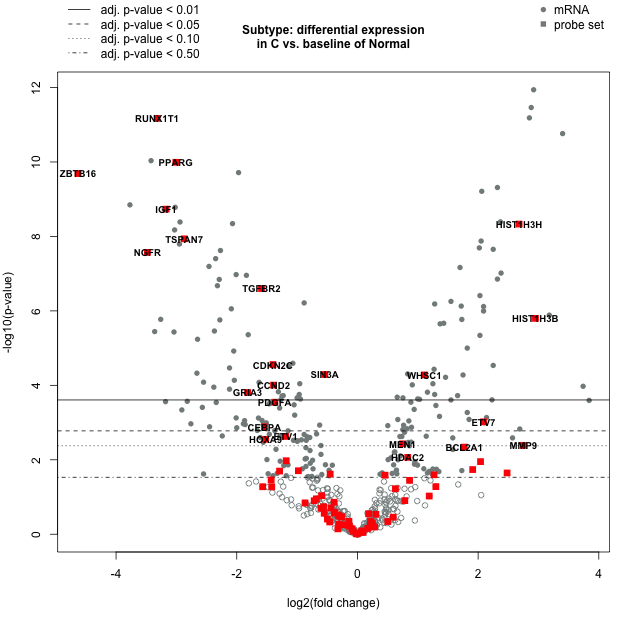
Volcano Plot: SubtypeC
Volcano plot displaying each gene's -log10(p-value) and log2 fold change for the selected covariate. Highly statistically significant genes fall at the top of the plot, and highly differentially expressed genes fall to either side. Genes within the selected gene set are highlighted in blue. Green point colors and horizontal lines indicate various False Discovery Rate (FDR) thresholds.
DE Results - TXmisReg genes - SubtypeC
More Plot Information Download CSV DataProbe Label Log2 fold change std error Lower confidence limit Upper confidence limit P-value BY.p.value Gene.sets Codeset.Name Probe.Label Analyte.Type Is.Control Control.Type Probe.Annotation KEGG.Pathways Cell.Type Official.Gene.Name volcanocol volcanopch tstats.all RUNX1T1-mRNA -3.32 0.377 -4.06 -2.58 6.75e-12 6.71e-09 TXmisReg NS_CANCERPATH_C2535 RUNX1T1 mRNA 0 TXmisReg hsa05200;hsa05202;hsa05221 RUNX1T1 chartreuse1 16 -8.80636604774536 PPARG-mRNA -3.01 0.373 -3.74 -2.28 1.02e-10 5.8e-08 TXmisReg NS_CANCERPATH_C2535 PPARG mRNA 0 TXmisReg hsa04152;hsa04211;hsa04380;hsa05016;hsa05200;hsa05202;hsa05216 PPARG chartreuse1 16 -8.06970509383378 ZBTB16-mRNA -4.63 0.589 -5.79 -3.48 2.05e-10 9.06e-08 TXmisReg NS_CANCERPATH_C2535 ZBTB16 mRNA 0 TXmisReg hsa05200;hsa05202;hsa05221 ZBTB16 chartreuse1 16 -7.86078098471986 IGF1-mRNA -3.17 0.436 -4.03 -2.32 1.85e-09 4.92e-07 PI3K, RAS, TXmisReg NS_CANCERPATH_C2535 IGF1 mRNA 0 RAS;PI3K;TXmisReg hsa04014;hsa04015;hsa04066;hsa04068;hsa04114;hsa04115;hsa04150;hsa04151;hsa04152;hsa04211;hsa04510;hsa04550;hsa04730;hsa04750;hsa04913;hsa04914;hsa04960;hsa05200;hsa05202;hsa05205;hsa05214;hsa05215;hsa05218;hsa05410;hsa05414 IGF1 chartreuse1 16 -7.27064220183486 HIST1H3H-mRNA 2.68 0.382 1.93 3.43 4.66e-09 9.76e-07 TXmisReg NS_CANCERPATH_C2535 HIST1H3H mRNA 0 TXmisReg hsa05034;hsa05202;hsa05322 HIST1H3H chartreuse1 16 7.01570680628272 TSPAN7-mRNA -2.87 0.423 -3.7 -2.04 1.16e-08 2.2e-06 TXmisReg NS_CANCERPATH_C2535 TSPAN7 mRNA 0 TXmisReg hsa05202 TSPAN7 chartreuse1 16 -6.78486997635934 NGFR-mRNA -3.48 0.533 -4.53 -2.44 2.68e-08 3.94e-06 PI3K, RAS, TXmisReg NS_CANCERPATH_C2535 NGFR mRNA 0 RAS;PI3K;TXmisReg hsa04014;hsa04015;hsa04060;hsa04151;hsa04722;hsa05202 NGFR chartreuse1 16 -6.52908067542214 TGFBR2-mRNA -1.59 0.268 -2.11 -1.06 2.51e-07 2.7e-05 MAPK, TGF-B, TXmisReg NS_CANCERPATH_C2535 TGFBR2 mRNA 0 MAPK;TGF-B;TXmisReg hsa04010;hsa04060;hsa04068;hsa04144;hsa04350;hsa04380;hsa04390;hsa04520;hsa04933;hsa05142;hsa05166;hsa05200;hsa05202;hsa05210;hsa05212;hsa05220 TGFBR2 chartreuse1 16 -5.93283582089552 HIST1H3B-mRNA 2.95 0.545 1.88 4.02 1.59e-06 0.000135 Driver Gene, TXmisReg NS_CANCERPATH_C2535 HIST1H3B mRNA 0 TXmisReg;Driver Gene hsa05034;hsa05202;hsa05322 HIST1H3B chartreuse1 16 5.41284403669725 CDKN2C-mRNA -1.4 0.305 -2 -0.805 2.77e-05 0.00178 CC.PLS.Apop, TXmisReg NS_CANCERPATH_C2535 CDKN2C mRNA 0 CC.PLS.Apop;TXmisReg hsa04110;hsa05166;hsa05202 CDKN2C chartreuse1 16 -4.59016393442623 SIN3A-mRNA -0.541 0.122 -0.781 -0.301 5.12e-05 0.00295 TXmisReg NS_CANCERPATH_C2535 SIN3A mRNA 0 TXmisReg hsa04919;hsa05016;hsa05202 SIN3A chartreuse1 16 -4.4344262295082 WHSC1-mRNA 1.11 0.252 0.617 1.6 5.25e-05 0.00295 TXmisReg NS_CANCERPATH_C2535 WHSC1 mRNA 0 TXmisReg hsa00310;hsa05202 WHSC1 chartreuse1 16 4.40476190476191 CCND2-mRNA -1.39 0.329 -2.03 -0.744 9.86e-05 0.00497 CC.PLS.Apop, JAK-STAT, PI3K, TXmisReg, Wnt NS_CANCERPATH_C2535 CCND2 mRNA 0 CC.PLS.Apop;PI3K;JAK-STAT;TXmisReg;Wnt hsa04068;hsa04110;hsa04115;hsa04151;hsa04310;hsa04390;hsa04510;hsa04630;hsa04917;hsa05162;hsa05166;hsa05202;hsa05203;hsa05206 CCND2 chartreuse1 16 -4.22492401215805 GRIA3-mRNA -1.82 0.447 -2.7 -0.947 0.000156 0.00731 TXmisReg NS_CANCERPATH_C2535 GRIA3 mRNA 0 TXmisReg hsa04024;hsa04080;hsa04713;hsa04723;hsa04724;hsa04728;hsa04730;hsa05031;hsa05202 GRIA3 chartreuse1 16 -4.07158836689038 PDGFA-mRNA -1.37 0.352 -2.06 -0.679 0.000284 0.0109 MAPK, PI3K, RAS, TXmisReg NS_CANCERPATH_C2535 PDGFA mRNA 0 RAS;PI3K;MAPK;TXmisReg hsa04010;hsa04014;hsa04015;hsa04060;hsa04072;hsa04151;hsa04510;hsa04540;hsa04810;hsa05166;hsa05200;hsa05202;hsa05206;hsa05214;hsa05215;hsa05218;hsa05231 PDGFA chartreuse2 16 -3.89204545454546 ETV7-mRNA 2.09 0.596 0.92 3.26 0.000955 0.0304 TXmisReg NS_CANCERPATH_C2535 ETV7 mRNA 0 TXmisReg hsa04320;hsa05202 ETV7 chartreuse2 16 3.50671140939597 CEBPA-mRNA -1.54 0.454 -2.43 -0.654 0.0013 0.0381 Driver Gene, TXmisReg NS_CANCERPATH_C2535 CEBPA mRNA 0 TXmisReg;Driver Gene hsa04932;hsa05200;hsa05202;hsa05221 CEBPA chartreuse2 16 -3.3920704845815 ETV1-mRNA -1.19 0.373 -1.92 -0.461 0.00236 0.0613 TXmisReg NS_CANCERPATH_C2535 ETV1 mRNA 0 TXmisReg hsa05202 ETV1 chartreuse3 16 -3.19034852546917 HOXA9-mRNA -1.52 0.484 -2.46 -0.569 0.00282 0.0701 TXmisReg NS_CANCERPATH_C2535 HOXA9 mRNA 0 TXmisReg hsa05202 HOXA9 chartreuse3 16 -3.1404958677686 MEN1-mRNA 0.748 0.246 0.265 1.23 0.00373 0.0878 Driver Gene, TXmisReg NS_CANCERPATH_C2535 MEN1 mRNA 0 TXmisReg;Driver Gene hsa05202 MEN1 chartreuse3 16 3.04065040650406 DE Results - TXmisReg genes - SubtypeC
Table displaying each sample's global significance scores and directed global significance scores as defined in the heatmaps above. The global significance score is calculated as the square root of the mean squared t-statistic for the genes in a gene set, with t-statistics coming from the linear regression underlying our differential expression analysis. The directed global significance score is calculated as the square root of the mean signed squared t-statistic for the genes in a gene set, with t-statistics coming from the linear regression underlying our differential expression analysis.
Volcano Plot: SubtypeD
More Plot Information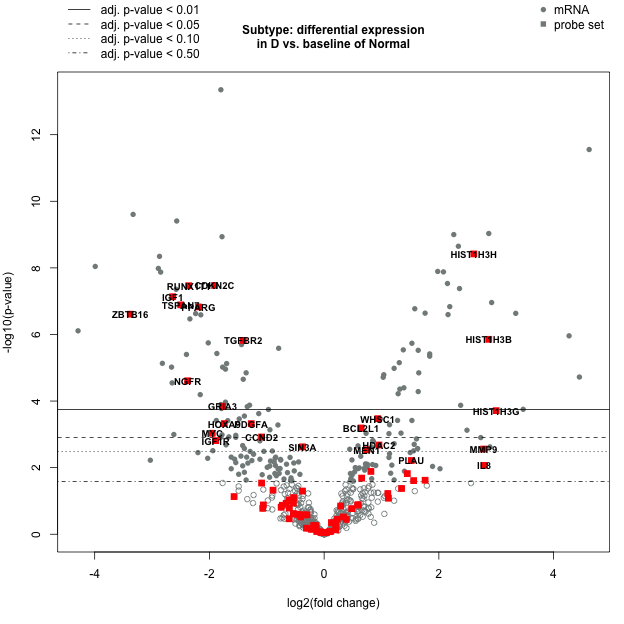
Volcano Plot: SubtypeD
Volcano plot displaying each gene's -log10(p-value) and log2 fold change for the selected covariate. Highly statistically significant genes fall at the top of the plot, and highly differentially expressed genes fall to either side. Genes within the selected gene set are highlighted in blue. Green point colors and horizontal lines indicate various False Discovery Rate (FDR) thresholds.
DE Results - TXmisReg genes - SubtypeD
More Plot Information Download CSV DataProbe Label Log2 fold change std error Lower confidence limit Upper confidence limit P-value BY.p.value Gene.sets Codeset.Name Probe.Label Analyte.Type Is.Control Control.Type Probe.Annotation KEGG.Pathways Cell.Type Official.Gene.Name volcanocol volcanopch tstats.all HIST1H3H-mRNA 2.61 0.369 1.89 3.33 3.81e-09 1.68e-06 TXmisReg NS_CANCERPATH_C2535 HIST1H3H mRNA 0 TXmisReg hsa05034;hsa05202;hsa05322 HIST1H3H chartreuse1 16 7.07317073170732 CDKN2C-mRNA -1.91 0.295 -2.49 -1.33 3.37e-08 7.57e-06 CC.PLS.Apop, TXmisReg NS_CANCERPATH_C2535 CDKN2C mRNA 0 CC.PLS.Apop;TXmisReg hsa04110;hsa05166;hsa05202 CDKN2C chartreuse1 16 -6.47457627118644 RUNX1T1-mRNA -2.36 0.364 -3.07 -1.64 3.43e-08 7.57e-06 TXmisReg NS_CANCERPATH_C2535 RUNX1T1 mRNA 0 TXmisReg hsa05200;hsa05202;hsa05221 RUNX1T1 chartreuse1 16 -6.48351648351648 IGF1-mRNA -2.64 0.422 -3.47 -1.82 7.35e-08 1.39e-05 PI3K, RAS, TXmisReg NS_CANCERPATH_C2535 IGF1 mRNA 0 RAS;PI3K;TXmisReg hsa04014;hsa04015;hsa04066;hsa04068;hsa04114;hsa04115;hsa04150;hsa04151;hsa04152;hsa04211;hsa04510;hsa04550;hsa04730;hsa04750;hsa04913;hsa04914;hsa04960;hsa05200;hsa05202;hsa05205;hsa05214;hsa05215;hsa05218;hsa05410;hsa05414 IGF1 chartreuse1 16 -6.25592417061611 TSPAN7-mRNA -2.5 0.409 -3.3 -1.7 1.29e-07 2.23e-05 TXmisReg NS_CANCERPATH_C2535 TSPAN7 mRNA 0 TXmisReg hsa05202 TSPAN7 chartreuse1 16 -6.11246943765281 PPARG-mRNA -2.19 0.36 -2.89 -1.48 1.49e-07 2.37e-05 TXmisReg NS_CANCERPATH_C2535 PPARG mRNA 0 TXmisReg hsa04152;hsa04211;hsa04380;hsa05016;hsa05200;hsa05202;hsa05216 PPARG chartreuse1 16 -6.08333333333333 ZBTB16-mRNA -3.38 0.569 -4.49 -2.26 2.46e-07 3.21e-05 TXmisReg NS_CANCERPATH_C2535 ZBTB16 mRNA 0 TXmisReg hsa05200;hsa05202;hsa05221 ZBTB16 chartreuse1 16 -5.9402460456942 HIST1H3B-mRNA 2.87 0.526 1.84 3.9 1.4e-06 0.000155 Driver Gene, TXmisReg NS_CANCERPATH_C2535 HIST1H3B mRNA 0 TXmisReg;Driver Gene hsa05034;hsa05202;hsa05322 HIST1H3B chartreuse1 16 5.45627376425856 TGFBR2-mRNA -1.41 0.259 -1.91 -0.899 1.51e-06 0.000163 MAPK, TGF-B, TXmisReg NS_CANCERPATH_C2535 TGFBR2 mRNA 0 MAPK;TGF-B;TXmisReg hsa04010;hsa04060;hsa04068;hsa04144;hsa04350;hsa04380;hsa04390;hsa04520;hsa04933;hsa05142;hsa05166;hsa05200;hsa05202;hsa05210;hsa05212;hsa05220 TGFBR2 chartreuse1 16 -5.44401544401544 NGFR-mRNA -2.38 0.515 -3.39 -1.38 2.46e-05 0.0016 PI3K, RAS, TXmisReg NS_CANCERPATH_C2535 NGFR mRNA 0 RAS;PI3K;TXmisReg hsa04014;hsa04015;hsa04060;hsa04151;hsa04722;hsa05202 NGFR chartreuse1 16 -4.62135922330097 GRIA3-mRNA -1.77 0.432 -2.62 -0.926 0.000144 0.00795 TXmisReg NS_CANCERPATH_C2535 GRIA3 mRNA 0 TXmisReg hsa04024;hsa04080;hsa04713;hsa04723;hsa04724;hsa04728;hsa04730;hsa05031;hsa05202 GRIA3 chartreuse1 16 -4.09722222222222 HIST1H3G-mRNA 3 0.748 1.53 4.47 0.000194 0.01 TXmisReg NS_CANCERPATH_C2535 HIST1H3G mRNA 0 TXmisReg hsa05034;hsa05202;hsa05322 HIST1H3G chartreuse2 16 4.01069518716578 WHSC1-mRNA 0.934 0.243 0.457 1.41 0.000338 0.0167 TXmisReg NS_CANCERPATH_C2535 WHSC1 mRNA 0 TXmisReg hsa00310;hsa05202 WHSC1 chartreuse2 16 3.84362139917696 HOXA9-mRNA -1.74 0.467 -2.66 -0.827 0.000475 0.0216 TXmisReg NS_CANCERPATH_C2535 HOXA9 mRNA 0 TXmisReg hsa05202 HOXA9 chartreuse2 16 -3.72591006423983 PDGFA-mRNA -1.27 0.34 -1.93 -0.601 0.000477 0.0216 MAPK, PI3K, RAS, TXmisReg NS_CANCERPATH_C2535 PDGFA mRNA 0 RAS;PI3K;MAPK;TXmisReg hsa04010;hsa04014;hsa04015;hsa04060;hsa04072;hsa04151;hsa04510;hsa04540;hsa04810;hsa05166;hsa05200;hsa05202;hsa05206;hsa05214;hsa05215;hsa05218;hsa05231 PDGFA chartreuse2 16 -3.73529411764706 BCL2L1-mRNA 0.645 0.177 0.297 0.993 0.000643 0.0281 CC.PLS.Apop, JAK-STAT, PI3K, RAS, TXmisReg NS_CANCERPATH_C2535 BCL2L1 mRNA 0 CC.PLS.Apop;RAS;PI3K;JAK-STAT;TXmisReg hsa04014;hsa04064;hsa04151;hsa04210;hsa04630;hsa05014;hsa05145;hsa05166;hsa05200;hsa05202;hsa05212;hsa05220;hsa05222 BCL2L1 chartreuse2 16 3.64406779661017 MYC-mRNA -1.95 0.555 -3.04 -0.862 0.000928 0.0381 CC.PLS.Apop, JAK-STAT, MAPK, PI3K, TGF-B, TXmisReg, Wnt NS_CANCERPATH_C2535 MYC mRNA 0 CC.PLS.Apop;PI3K;JAK-STAT;MAPK;TGF-B;TXmisReg;Wnt hsa04010;hsa04012;hsa04110;hsa04151;hsa04310;hsa04350;hsa04390;hsa04550;hsa04630;hsa04919;hsa05161;hsa05166;hsa05169;hsa05200;hsa05202;hsa05205;hsa05206;hsa05210;hsa05213;hsa05216;hsa05219;hsa05220;hsa05221;hsa05222;hsa05230 MYC chartreuse2 16 -3.51351351351351 CCND2-mRNA -1.09 0.318 -1.71 -0.467 0.0012 0.0464 CC.PLS.Apop, JAK-STAT, PI3K, TXmisReg, Wnt NS_CANCERPATH_C2535 CCND2 mRNA 0 CC.PLS.Apop;PI3K;JAK-STAT;TXmisReg;Wnt hsa04068;hsa04110;hsa04115;hsa04151;hsa04310;hsa04390;hsa04510;hsa04630;hsa04917;hsa05162;hsa05166;hsa05202;hsa05203;hsa05206 CCND2 chartreuse2 16 -3.42767295597484 IGF1R-mRNA -1.89 0.565 -3 -0.782 0.00154 0.0562 PI3K, RAS, TXmisReg NS_CANCERPATH_C2535 IGF1R mRNA 0 RAS;PI3K;TXmisReg hsa04014;hsa04015;hsa04066;hsa04068;hsa04114;hsa04144;hsa04151;hsa04152;hsa04211;hsa04510;hsa04520;hsa04550;hsa04730;hsa04913;hsa04914;hsa05200;hsa05202;hsa05205;hsa05214;hsa05215;hsa05218 IGF1R chartreuse3 16 -3.34513274336283 HDAC2-mRNA 0.956 0.295 0.378 1.53 0.00209 0.0721 CC.PLS.Apop, ChromMod, Notch, TXmisReg NS_CANCERPATH_C2535 HDAC2 mRNA 0 CC.PLS.Apop;TXmisReg;ChromMod;Notch hsa04110;hsa04330;hsa04919;hsa05016;hsa05034;hsa05169;hsa05200;hsa05202;hsa05203;hsa05220 HDAC2 chartreuse3 16 3.24067796610169 DE Results - TXmisReg genes - SubtypeD
Table displaying each sample's global significance scores and directed global significance scores as defined in the heatmaps above. The global significance score is calculated as the square root of the mean squared t-statistic for the genes in a gene set, with t-statistics coming from the linear regression underlying our differential expression analysis. The directed global significance score is calculated as the square root of the mean signed squared t-statistic for the genes in a gene set, with t-statistics coming from the linear regression underlying our differential expression analysis.
- Subtype:
- SubtypeA
- SubtypeB
- SubtypeC
- SubtypeD
Volcano Plot: SubtypeA
More Plot Information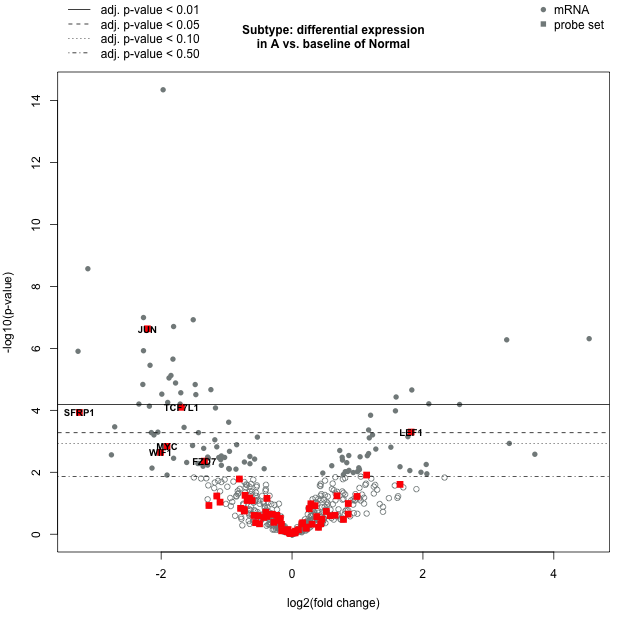
Volcano Plot: SubtypeA
Volcano plot displaying each gene's -log10(p-value) and log2 fold change for the selected covariate. Highly statistically significant genes fall at the top of the plot, and highly differentially expressed genes fall to either side. Genes within the selected gene set are highlighted in blue. Green point colors and horizontal lines indicate various False Discovery Rate (FDR) thresholds.
DE Results - Wnt genes - SubtypeA
More Plot Information Download CSV DataProbe Label Log2 fold change std error Lower confidence limit Upper confidence limit P-value BY.p.value Gene.sets Codeset.Name Probe.Label Analyte.Type Is.Control Control.Type Probe.Annotation KEGG.Pathways Cell.Type Official.Gene.Name volcanocol volcanopch tstats.all JUN-mRNA -2.21 0.371 -2.94 -1.48 2.33e-07 0.000155 MAPK, Wnt NS_CANCERPATH_C2535 JUN mRNA 0 MAPK;Wnt hsa04010;hsa04012;hsa04024;hsa04310;hsa04380;hsa04510;hsa04620;hsa04660;hsa04662;hsa04668;hsa04722;hsa04912;hsa04915;hsa04921;hsa04932;hsa04933;hsa05030;hsa05031;hsa05120;hsa05132;hsa05133;hsa05140;hsa05142;hsa05161;hsa05164;hsa05166;hsa05168;hsa05169;hsa05200;hsa05203;hsa05210;hsa05211;hsa05231;hsa05321;hsa05323 JUN chartreuse1 16 -5.95687331536388 TCF7L1-mRNA -1.69 0.395 -2.47 -0.918 7.98e-05 0.0106 Wnt NS_CANCERPATH_C2535 TCF7L1 mRNA 0 Wnt hsa04310;hsa04390;hsa04520;hsa04916;hsa05200;hsa05210;hsa05213;hsa05215;hsa05216;hsa05217;hsa05221;hsa05412 TCF7L1 chartreuse2 16 -4.27848101265823 SFRP1-mRNA -3.25 0.78 -4.78 -1.72 0.000117 0.0141 Wnt NS_CANCERPATH_C2535 SFRP1 mRNA 0 Wnt hsa04310 SFRP1 chartreuse2 16 -4.16666666666667 LEF1-mRNA 1.82 0.49 0.858 2.78 0.000502 0.0497 Wnt NS_CANCERPATH_C2535 LEF1 mRNA 0 Wnt hsa04310;hsa04390;hsa04520;hsa04916;hsa05200;hsa05210;hsa05213;hsa05215;hsa05216;hsa05217;hsa05221;hsa05412 LEF1 chartreuse2 16 3.71428571428571 MYC-mRNA -1.91 0.567 -3.02 -0.794 0.00146 0.112 CC.PLS.Apop, JAK-STAT, MAPK, PI3K, TGF-B, TXmisReg, Wnt NS_CANCERPATH_C2535 MYC mRNA 0 CC.PLS.Apop;PI3K;JAK-STAT;MAPK;TGF-B;TXmisReg;Wnt hsa04010;hsa04012;hsa04110;hsa04151;hsa04310;hsa04350;hsa04390;hsa04550;hsa04630;hsa04919;hsa05161;hsa05166;hsa05169;hsa05200;hsa05202;hsa05205;hsa05206;hsa05210;hsa05213;hsa05216;hsa05219;hsa05220;hsa05221;hsa05222;hsa05230 MYC chartreuse4 16 -3.36860670194004 WIF1-mRNA -2.01 0.628 -3.24 -0.784 0.00228 0.154 Wnt NS_CANCERPATH_C2535 WIF1 mRNA 0 Wnt hsa04310 WIF1 chartreuse4 16 -3.20063694267516 FZD7-mRNA -1.34 0.45 -2.22 -0.46 0.00437 0.223 Wnt NS_CANCERPATH_C2535 FZD7 mRNA 0 Wnt hsa04310;hsa04390;hsa04550;hsa04916;hsa05166;hsa05200;hsa05205;hsa05217 FZD7 chartreuse4 16 -2.97777777777778 RAC2-mRNA 1.14 0.44 0.279 2 0.0123 0.451 MAPK, RAS, Wnt NS_CANCERPATH_C2535 RAC2 mRNA 0 RAS;MAPK;Wnt hsa04010;hsa04014;hsa04015;hsa04024;hsa04062;hsa04071;hsa04310;hsa04360;hsa04370;hsa04510;hsa04520;hsa04650;hsa04662;hsa04664;hsa04666;hsa04670;hsa04810;hsa05200;hsa05210;hsa05212;hsa05231;hsa05416 RAC2 chartreuse4 16 2.59090909090909 CCND2-mRNA -0.805 0.325 -1.44 -0.168 0.0165 0.557 CC.PLS.Apop, JAK-STAT, PI3K, TXmisReg, Wnt NS_CANCERPATH_C2535 CCND2 mRNA 0 CC.PLS.Apop;PI3K;JAK-STAT;TXmisReg;Wnt hsa04068;hsa04110;hsa04115;hsa04151;hsa04310;hsa04390;hsa04510;hsa04630;hsa04917;hsa05162;hsa05166;hsa05202;hsa05203;hsa05206 CCND2 azure4 1 -2.47692307692308 WNT7B-mRNA 1.65 0.712 0.253 3.04 0.0246 0.74 HH, Wnt NS_CANCERPATH_C2535 WNT7B mRNA 0 HH;Wnt hsa04310;hsa04340;hsa04390;hsa04550;hsa04916;hsa05166;hsa05200;hsa05205;hsa05217 WNT7B azure4 1 2.31741573033708 CTNNB1-mRNA -0.718 0.366 -1.44 0.000357 0.0555 1 Driver Gene, Wnt NS_CANCERPATH_C2535 CTNNB1 mRNA 0 Wnt;Driver Gene hsa04015;hsa04310;hsa04390;hsa04510;hsa04520;hsa04530;hsa04550;hsa04670;hsa04916;hsa04919;hsa05100;hsa05130;hsa05166;hsa05200;hsa05205;hsa05210;hsa05213;hsa05215;hsa05216;hsa05217;hsa05412 CTNNB1 azure4 1 -1.96174863387978 WNT10A-mRNA 0.687 0.354 -0.00666 1.38 0.0577 1 HH, Wnt NS_CANCERPATH_C2535 WNT10A mRNA 0 HH;Wnt hsa04310;hsa04340;hsa04390;hsa04550;hsa04916;hsa05166;hsa05200;hsa05205;hsa05217 WNT10A azure4 1 1.9406779661017 PLCB1-mRNA -1.15 0.592 -2.31 0.0148 0.0584 1 Wnt NS_CANCERPATH_C2535 PLCB1 mRNA 0 Wnt hsa00562;hsa01100;hsa04015;hsa04020;hsa04022;hsa04062;hsa04070;hsa04071;hsa04072;hsa04261;hsa04270;hsa04310;hsa04540;hsa04611;hsa04713;hsa04720;hsa04723;hsa04724;hsa04725;hsa04726;hsa04728;hsa04730;hsa04750;hsa04911;hsa04912;hsa04915;hsa04916;hsa04918;hsa04919;hsa04921;hsa04922;hsa04924;hsa04925;hsa04933;hsa04961;hsa04970;hsa04971;hsa04972;hsa05010;hsa05016;hsa05142;hsa05143;hsa05146;hsa05200 PLCB1 azure4 1 -1.94256756756757 CAMK2B-mRNA 0.993 0.517 -0.0207 2.01 0.0604 1 Wnt NS_CANCERPATH_C2535 CAMK2B mRNA 0 Wnt hsa04012;hsa04020;hsa04024;hsa04066;hsa04114;hsa04261;hsa04310;hsa04713;hsa04720;hsa04722;hsa04725;hsa04728;hsa04740;hsa04750;hsa04911;hsa04912;hsa04916;hsa04921;hsa04922;hsa04925;hsa04971;hsa05031;hsa05152;hsa05205;hsa05214 CAMK2B azure4 1 1.92069632495164 NFATC1-mRNA -0.648 0.347 -1.33 0.0329 0.0678 1 MAPK, Wnt NS_CANCERPATH_C2535 NFATC1 mRNA 0 MAPK;Wnt hsa04010;hsa04022;hsa04024;hsa04310;hsa04380;hsa04650;hsa04660;hsa04662;hsa04921;hsa04933;hsa05161;hsa05166;hsa05321 NFATC1 azure4 1 -1.86743515850144 SMAD4-mRNA -0.383 0.207 -0.787 0.0223 0.0697 1 CC.PLS.Apop, Driver Gene, TGF-B, Wnt NS_CANCERPATH_C2535 SMAD4 mRNA 0 CC.PLS.Apop;TGF-B;Wnt;Driver Gene hsa04068;hsa04110;hsa04310;hsa04350;hsa04390;hsa04520;hsa04550;hsa04933;hsa05161;hsa05166;hsa05200;hsa05210;hsa05212;hsa05220 SMAD4 azure4 1 -1.85024154589372 TP53-mRNA -0.687 0.386 -1.44 0.0707 0.0814 1 CC.PLS.Apop, Driver Gene, MAPK, PI3K, TXmisReg, Wnt NS_CANCERPATH_C2535 TP53 mRNA 0 CC.PLS.Apop;PI3K;MAPK;TXmisReg;Wnt;Driver Gene hsa04010;hsa04071;hsa04110;hsa04115;hsa04151;hsa04210;hsa04211;hsa04310;hsa04722;hsa04919;hsa05014;hsa05016;hsa05160;hsa05161;hsa05162;hsa05166;hsa05168;hsa05169;hsa05200;hsa05202;hsa05203;hsa05205;hsa05206;hsa05210;hsa05212;hsa05213;hsa05214;hsa05215;hsa05216;hsa05217;hsa05218;hsa05219;hsa05220;hsa05222;hsa05223;hsa05230 TP53 azure4 1 -1.77979274611399 PRKACA-mRNA -0.61 0.344 -1.28 0.0642 0.082 1 CC.PLS.Apop, HH, MAPK, RAS, Wnt NS_CANCERPATH_C2535 PRKACA mRNA 0 CC.PLS.Apop;RAS;MAPK;HH;Wnt hsa04010;hsa04014;hsa04020;hsa04024;hsa04062;hsa04114;hsa04210;hsa04211;hsa04261;hsa04270;hsa04310;hsa04340;hsa04540;hsa04611;hsa04713;hsa04720;hsa04723;hsa04724;hsa04725;hsa04726;hsa04727;hsa04728;hsa04740;hsa04750;hsa04910;hsa04911;hsa04912;hsa04913;hsa04914;hsa04915;hsa04916;hsa04918;hsa04919;hsa04921;hsa04922;hsa04923;hsa04924;hsa04925;hsa04961;hsa04962;hsa04970;hsa04971;hsa05012;hsa05020;hsa05030;hsa05031;hsa05032;hsa05034;hsa05110;hsa05146;hsa05166;hsa05169;hsa05200;hsa05203;hsa05205;hsa05414 PRKACA azure4 1 -1.77325581395349 SFRP4-mRNA -1.1 0.64 -2.35 0.156 0.092 1 Wnt NS_CANCERPATH_C2535 SFRP4 mRNA 0 Wnt hsa04310 SFRP4 azure4 1 -1.71875 GPC4-mRNA 0.859 0.516 -0.152 1.87 0.102 1 Wnt NS_CANCERPATH_C2535 GPC4 mRNA 0 Wnt hsa04310 GPC4 azure4 1 1.66472868217054 DE Results - Wnt genes - SubtypeA
Table displaying each sample's global significance scores and directed global significance scores as defined in the heatmaps above. The global significance score is calculated as the square root of the mean squared t-statistic for the genes in a gene set, with t-statistics coming from the linear regression underlying our differential expression analysis. The directed global significance score is calculated as the square root of the mean signed squared t-statistic for the genes in a gene set, with t-statistics coming from the linear regression underlying our differential expression analysis.
Volcano Plot: SubtypeB
More Plot Information
Volcano Plot: SubtypeB
Volcano plot displaying each gene's -log10(p-value) and log2 fold change for the selected covariate. Highly statistically significant genes fall at the top of the plot, and highly differentially expressed genes fall to either side. Genes within the selected gene set are highlighted in blue. Green point colors and horizontal lines indicate various False Discovery Rate (FDR) thresholds.
DE Results - Wnt genes - SubtypeB
More Plot Information Download CSV DataProbe Label Log2 fold change std error Lower confidence limit Upper confidence limit P-value BY.p.value Gene.sets Codeset.Name Probe.Label Analyte.Type Is.Control Control.Type Probe.Annotation KEGG.Pathways Cell.Type Official.Gene.Name volcanocol volcanopch tstats.all SFRP1-mRNA -5.83 0.735 -7.27 -4.39 1.65e-10 9.39e-08 Wnt NS_CANCERPATH_C2535 SFRP1 mRNA 0 Wnt hsa04310 SFRP1 chartreuse1 16 -7.93197278911565 JUN-mRNA -2.11 0.35 -2.8 -1.43 1.68e-07 1.81e-05 MAPK, Wnt NS_CANCERPATH_C2535 JUN mRNA 0 MAPK;Wnt hsa04010;hsa04012;hsa04024;hsa04310;hsa04380;hsa04510;hsa04620;hsa04660;hsa04662;hsa04668;hsa04722;hsa04912;hsa04915;hsa04921;hsa04932;hsa04933;hsa05030;hsa05031;hsa05120;hsa05132;hsa05133;hsa05140;hsa05142;hsa05161;hsa05164;hsa05166;hsa05168;hsa05169;hsa05200;hsa05203;hsa05210;hsa05211;hsa05231;hsa05321;hsa05323 JUN chartreuse1 16 -6.02857142857143 TCF7L1-mRNA -2.2 0.372 -2.93 -1.47 2.77e-07 2.9e-05 Wnt NS_CANCERPATH_C2535 TCF7L1 mRNA 0 Wnt hsa04310;hsa04390;hsa04520;hsa04916;hsa05200;hsa05210;hsa05213;hsa05215;hsa05216;hsa05217;hsa05221;hsa05412 TCF7L1 chartreuse1 16 -5.91397849462366 WIF1-mRNA -2.92 0.591 -4.08 -1.76 8.37e-06 0.000555 Wnt NS_CANCERPATH_C2535 WIF1 mRNA 0 Wnt hsa04310 WIF1 chartreuse1 16 -4.94077834179357 FZD7-mRNA -2.02 0.424 -2.86 -1.19 1.54e-05 0.000955 Wnt NS_CANCERPATH_C2535 FZD7 mRNA 0 Wnt hsa04310;hsa04390;hsa04550;hsa04916;hsa05166;hsa05200;hsa05205;hsa05217 FZD7 chartreuse1 16 -4.76415094339623 CCND2-mRNA -1.25 0.306 -1.85 -0.652 0.00015 0.00694 CC.PLS.Apop, JAK-STAT, PI3K, TXmisReg, Wnt NS_CANCERPATH_C2535 CCND2 mRNA 0 CC.PLS.Apop;PI3K;JAK-STAT;TXmisReg;Wnt hsa04068;hsa04110;hsa04115;hsa04151;hsa04310;hsa04390;hsa04510;hsa04630;hsa04917;hsa05162;hsa05166;hsa05202;hsa05203;hsa05206 CCND2 chartreuse1 16 -4.08496732026144 LEF1-mRNA 1.6 0.461 0.692 2.5 0.00108 0.0392 Wnt NS_CANCERPATH_C2535 LEF1 mRNA 0 Wnt hsa04310;hsa04390;hsa04520;hsa04916;hsa05200;hsa05210;hsa05213;hsa05215;hsa05216;hsa05217;hsa05221;hsa05412 LEF1 chartreuse2 16 3.470715835141 PPP3CB-mRNA -0.697 0.209 -1.11 -0.287 0.00161 0.0537 CC.PLS.Apop, MAPK, Wnt NS_CANCERPATH_C2535 PPP3CB mRNA 0 CC.PLS.Apop;MAPK;Wnt hsa04010;hsa04020;hsa04022;hsa04114;hsa04210;hsa04310;hsa04360;hsa04370;hsa04380;hsa04650;hsa04660;hsa04662;hsa04720;hsa04724;hsa04728;hsa04921;hsa04922;hsa04924;hsa05010;hsa05014;hsa05031;hsa05152;hsa05166 PPP3CB chartreuse3 16 -3.33492822966507 SFRP4-mRNA -1.93 0.603 -3.11 -0.747 0.00235 0.0741 Wnt NS_CANCERPATH_C2535 SFRP4 mRNA 0 Wnt hsa04310 SFRP4 chartreuse3 16 -3.20066334991708 PRKCA-mRNA -1.18 0.379 -1.92 -0.437 0.00301 0.0942 MAPK, PI3K, RAS, Wnt NS_CANCERPATH_C2535 PRKCA mRNA 0 RAS;PI3K;MAPK;Wnt hsa04010;hsa04012;hsa04014;hsa04015;hsa04020;hsa04066;hsa04070;hsa04071;hsa04072;hsa04150;hsa04151;hsa04261;hsa04270;hsa04310;hsa04370;hsa04510;hsa04530;hsa04540;hsa04650;hsa04664;hsa04666;hsa04670;hsa04713;hsa04720;hsa04723;hsa04724;hsa04725;hsa04726;hsa04727;hsa04728;hsa04730;hsa04750;hsa04911;hsa04912;hsa04916;hsa04918;hsa04919;hsa04921;hsa04925;hsa04933;hsa04960;hsa04961;hsa04970;hsa04971;hsa04972;hsa05031;hsa05032;hsa05110;hsa05130;hsa05143;hsa05146;hsa05161;hsa05164;hsa05200;hsa05205;hsa05206;hsa05214;hsa05223;hsa05231 PRKCA chartreuse4 16 -3.11345646437995 MYC-mRNA -1.62 0.534 -2.67 -0.577 0.00369 0.111 CC.PLS.Apop, JAK-STAT, MAPK, PI3K, TGF-B, TXmisReg, Wnt NS_CANCERPATH_C2535 MYC mRNA 0 CC.PLS.Apop;PI3K;JAK-STAT;MAPK;TGF-B;TXmisReg;Wnt hsa04010;hsa04012;hsa04110;hsa04151;hsa04310;hsa04350;hsa04390;hsa04550;hsa04630;hsa04919;hsa05161;hsa05166;hsa05169;hsa05200;hsa05202;hsa05205;hsa05206;hsa05210;hsa05213;hsa05216;hsa05219;hsa05220;hsa05221;hsa05222;hsa05230 MYC chartreuse4 16 -3.03370786516854 MAPK10-mRNA -1.88 0.65 -3.15 -0.603 0.00565 0.149 MAPK, RAS, Wnt NS_CANCERPATH_C2535 MAPK10 mRNA 0 RAS;MAPK;Wnt hsa04010;hsa04012;hsa04014;hsa04024;hsa04068;hsa04071;hsa04141;hsa04310;hsa04380;hsa04510;hsa04620;hsa04621;hsa04622;hsa04664;hsa04668;hsa04722;hsa04723;hsa04728;hsa04750;hsa04910;hsa04912;hsa04914;hsa04917;hsa04920;hsa04930;hsa04931;hsa04932;hsa04933;hsa05120;hsa05131;hsa05132;hsa05133;hsa05142;hsa05145;hsa05152;hsa05160;hsa05161;hsa05164;hsa05168;hsa05169;hsa05200;hsa05210;hsa05212;hsa05231 MAPK10 chartreuse4 16 -2.89230769230769 WNT2B-mRNA -0.781 0.288 -1.35 -0.216 0.00907 0.216 HH, Wnt NS_CANCERPATH_C2535 WNT2B mRNA 0 HH;Wnt hsa04310;hsa04340;hsa04390;hsa04550;hsa04916;hsa05166;hsa05200;hsa05205;hsa05217 WNT2B chartreuse4 16 -2.71180555555556 SMAD4-mRNA -0.524 0.195 -0.906 -0.143 0.00946 0.224 CC.PLS.Apop, Driver Gene, TGF-B, Wnt NS_CANCERPATH_C2535 SMAD4 mRNA 0 CC.PLS.Apop;TGF-B;Wnt;Driver Gene hsa04068;hsa04110;hsa04310;hsa04350;hsa04390;hsa04520;hsa04550;hsa04933;hsa05161;hsa05166;hsa05200;hsa05210;hsa05212;hsa05220 SMAD4 chartreuse4 16 -2.68717948717949 AXIN2-mRNA -1.31 0.502 -2.29 -0.328 0.0117 0.256 Wnt NS_CANCERPATH_C2535 AXIN2 mRNA 0 Wnt hsa04310;hsa04390;hsa04550;hsa05200;hsa05210;hsa05213;hsa05217 AXIN2 chartreuse4 16 -2.60956175298805 WNT7B-mRNA 1.75 0.671 0.433 3.06 0.0119 0.256 HH, Wnt NS_CANCERPATH_C2535 WNT7B mRNA 0 HH;Wnt hsa04310;hsa04340;hsa04390;hsa04550;hsa04916;hsa05166;hsa05200;hsa05205;hsa05217 WNT7B chartreuse4 16 2.6080476900149 AXIN1-mRNA 0.49 0.19 0.117 0.863 0.0129 0.274 Driver Gene, Wnt NS_CANCERPATH_C2535 AXIN1 mRNA 0 Wnt;Driver Gene hsa04310;hsa04390;hsa04550;hsa05200;hsa05210;hsa05213;hsa05217 AXIN1 chartreuse4 16 2.57894736842105 PLCB1-mRNA -1.43 0.558 -2.53 -0.341 0.0131 0.276 Wnt NS_CANCERPATH_C2535 PLCB1 mRNA 0 Wnt hsa00562;hsa01100;hsa04015;hsa04020;hsa04022;hsa04062;hsa04070;hsa04071;hsa04072;hsa04261;hsa04270;hsa04310;hsa04540;hsa04611;hsa04713;hsa04720;hsa04723;hsa04724;hsa04725;hsa04726;hsa04728;hsa04730;hsa04750;hsa04911;hsa04912;hsa04915;hsa04916;hsa04918;hsa04919;hsa04921;hsa04922;hsa04924;hsa04925;hsa04933;hsa04961;hsa04970;hsa04971;hsa04972;hsa05010;hsa05016;hsa05142;hsa05143;hsa05146;hsa05200 PLCB1 chartreuse4 16 -2.56272401433692 NFATC1-mRNA -0.81 0.327 -1.45 -0.168 0.0166 0.339 MAPK, Wnt NS_CANCERPATH_C2535 NFATC1 mRNA 0 MAPK;Wnt hsa04010;hsa04022;hsa04024;hsa04310;hsa04380;hsa04650;hsa04660;hsa04662;hsa04921;hsa04933;hsa05161;hsa05166;hsa05321 NFATC1 chartreuse4 16 -2.47706422018349 PLCB4-mRNA -1.18 0.482 -2.13 -0.238 0.0175 0.352 Wnt NS_CANCERPATH_C2535 PLCB4 mRNA 0 Wnt hsa00562;hsa01100;hsa04015;hsa04020;hsa04022;hsa04062;hsa04070;hsa04071;hsa04072;hsa04261;hsa04270;hsa04310;hsa04540;hsa04611;hsa04713;hsa04720;hsa04723;hsa04724;hsa04725;hsa04726;hsa04728;hsa04730;hsa04750;hsa04911;hsa04912;hsa04915;hsa04916;hsa04918;hsa04919;hsa04921;hsa04922;hsa04924;hsa04925;hsa04933;hsa04961;hsa04970;hsa04971;hsa04972;hsa05010;hsa05016;hsa05142;hsa05143;hsa05146;hsa05200 PLCB4 chartreuse4 16 -2.44813278008299 DE Results - Wnt genes - SubtypeB
Table displaying each sample's global significance scores and directed global significance scores as defined in the heatmaps above. The global significance score is calculated as the square root of the mean squared t-statistic for the genes in a gene set, with t-statistics coming from the linear regression underlying our differential expression analysis. The directed global significance score is calculated as the square root of the mean signed squared t-statistic for the genes in a gene set, with t-statistics coming from the linear regression underlying our differential expression analysis.
Volcano Plot: SubtypeC
More Plot Information
Volcano Plot: SubtypeC
Volcano plot displaying each gene's -log10(p-value) and log2 fold change for the selected covariate. Highly statistically significant genes fall at the top of the plot, and highly differentially expressed genes fall to either side. Genes within the selected gene set are highlighted in blue. Green point colors and horizontal lines indicate various False Discovery Rate (FDR) thresholds.
DE Results - Wnt genes - SubtypeC
More Plot Information Download CSV DataProbe Label Log2 fold change std error Lower confidence limit Upper confidence limit P-value BY.p.value Gene.sets Codeset.Name Probe.Label Analyte.Type Is.Control Control.Type Probe.Annotation KEGG.Pathways Cell.Type Official.Gene.Name volcanocol volcanopch tstats.all JUN-mRNA -2.29 0.376 -3.03 -1.55 1.43e-07 1.62e-05 MAPK, Wnt NS_CANCERPATH_C2535 JUN mRNA 0 MAPK;Wnt hsa04010;hsa04012;hsa04024;hsa04310;hsa04380;hsa04510;hsa04620;hsa04660;hsa04662;hsa04668;hsa04722;hsa04912;hsa04915;hsa04921;hsa04932;hsa04933;hsa05030;hsa05031;hsa05120;hsa05132;hsa05133;hsa05140;hsa05142;hsa05161;hsa05164;hsa05166;hsa05168;hsa05169;hsa05200;hsa05203;hsa05210;hsa05211;hsa05231;hsa05321;hsa05323 JUN chartreuse1 16 -6.09042553191489 SFRP4-mRNA -3.36 0.648 -4.63 -2.09 3.6e-06 0.000265 Wnt NS_CANCERPATH_C2535 SFRP4 mRNA 0 Wnt hsa04310 SFRP4 chartreuse1 16 -5.18518518518519 PPP3CB-mRNA -0.956 0.225 -1.4 -0.515 9.04e-05 0.00468 CC.PLS.Apop, MAPK, Wnt NS_CANCERPATH_C2535 PPP3CB mRNA 0 CC.PLS.Apop;MAPK;Wnt hsa04010;hsa04020;hsa04022;hsa04114;hsa04210;hsa04310;hsa04360;hsa04370;hsa04380;hsa04650;hsa04660;hsa04662;hsa04720;hsa04724;hsa04728;hsa04921;hsa04922;hsa04924;hsa05010;hsa05014;hsa05031;hsa05152;hsa05166 PPP3CB chartreuse1 16 -4.24888888888889 CCND2-mRNA -1.39 0.329 -2.03 -0.744 9.86e-05 0.00497 CC.PLS.Apop, JAK-STAT, PI3K, TXmisReg, Wnt NS_CANCERPATH_C2535 CCND2 mRNA 0 CC.PLS.Apop;PI3K;JAK-STAT;TXmisReg;Wnt hsa04068;hsa04110;hsa04115;hsa04151;hsa04310;hsa04390;hsa04510;hsa04630;hsa04917;hsa05162;hsa05166;hsa05202;hsa05203;hsa05206 CCND2 chartreuse1 16 -4.22492401215805 PRKX-mRNA 1.3 0.338 0.632 1.96 0.000348 0.0127 CC.PLS.Apop, HH, MAPK, RAS, Wnt NS_CANCERPATH_C2535 PRKX mRNA 0 CC.PLS.Apop;RAS;MAPK;HH;Wnt PRKX chartreuse2 16 3.84615384615385 SFRP2-mRNA -2.57 0.678 -3.9 -1.24 0.000391 0.0141 Wnt NS_CANCERPATH_C2535 SFRP2 mRNA 0 Wnt hsa04310 SFRP2 chartreuse2 16 -3.7905604719764 DKK2-mRNA -1.29 0.34 -1.95 -0.619 0.000407 0.0146 Wnt NS_CANCERPATH_C2535 DKK2 mRNA 0 Wnt hsa04310 DKK2 chartreuse2 16 -3.79411764705882 CUL1-mRNA 0.669 0.188 0.299 1.04 0.000829 0.0272 CC.PLS.Apop, TGF-B, Wnt NS_CANCERPATH_C2535 CUL1 mRNA 0 CC.PLS.Apop;TGF-B;Wnt hsa04110;hsa04114;hsa04120;hsa04141;hsa04310;hsa04350;hsa05168 CUL1 chartreuse2 16 3.55851063829787 AXIN2-mRNA -1.86 0.539 -2.92 -0.802 0.00113 0.0347 Wnt NS_CANCERPATH_C2535 AXIN2 mRNA 0 Wnt hsa04310;hsa04390;hsa04550;hsa05200;hsa05210;hsa05213;hsa05217 AXIN2 chartreuse2 16 -3.45083487940631 SMAD3-mRNA -1.15 0.347 -1.83 -0.471 0.00167 0.0461 CC.PLS.Apop, TGF-B, Wnt NS_CANCERPATH_C2535 SMAD3 mRNA 0 CC.PLS.Apop;TGF-B;Wnt hsa04068;hsa04110;hsa04144;hsa04310;hsa04350;hsa04390;hsa04520;hsa04550;hsa04933;hsa05142;hsa05161;hsa05166;hsa05200;hsa05210;hsa05212;hsa05220;hsa05321 SMAD3 chartreuse3 16 -3.31412103746398 MAPK10-mRNA -2.24 0.699 -3.61 -0.873 0.00229 0.0609 MAPK, RAS, Wnt NS_CANCERPATH_C2535 MAPK10 mRNA 0 RAS;MAPK;Wnt hsa04010;hsa04012;hsa04014;hsa04024;hsa04068;hsa04071;hsa04141;hsa04310;hsa04380;hsa04510;hsa04620;hsa04621;hsa04622;hsa04664;hsa04668;hsa04722;hsa04723;hsa04728;hsa04750;hsa04910;hsa04912;hsa04914;hsa04917;hsa04920;hsa04930;hsa04931;hsa04932;hsa04933;hsa05120;hsa05131;hsa05132;hsa05133;hsa05142;hsa05145;hsa05152;hsa05160;hsa05161;hsa05164;hsa05168;hsa05169;hsa05200;hsa05210;hsa05212;hsa05231 MAPK10 chartreuse3 16 -3.20457796852647 MMP7-mRNA 2.57 0.81 0.978 4.15 0.00258 0.0646 Wnt NS_CANCERPATH_C2535 MMP7 mRNA 0 Wnt hsa04310 MMP7 chartreuse3 16 3.17283950617284 APC-mRNA -0.605 0.202 -1 -0.21 0.00414 0.0963 Driver Gene, Wnt NS_CANCERPATH_C2535 APC mRNA 0 Wnt;Driver Gene hsa04310;hsa04390;hsa04550;hsa04810;hsa05166;hsa05200;hsa05206;hsa05210;hsa05213;hsa05217 APC chartreuse3 16 -2.99504950495049 RAC2-mRNA 1.1 0.446 0.221 1.97 0.0174 0.34 MAPK, RAS, Wnt NS_CANCERPATH_C2535 RAC2 mRNA 0 RAS;MAPK;Wnt hsa04010;hsa04014;hsa04015;hsa04024;hsa04062;hsa04071;hsa04310;hsa04360;hsa04370;hsa04510;hsa04520;hsa04650;hsa04662;hsa04664;hsa04666;hsa04670;hsa04810;hsa05200;hsa05210;hsa05212;hsa05231;hsa05416 RAC2 chartreuse4 16 2.46636771300448 RAC3-mRNA 1.25 0.508 0.249 2.24 0.0177 0.342 MAPK, RAS, Wnt NS_CANCERPATH_C2535 RAC3 mRNA 0 RAS;MAPK;Wnt hsa04010;hsa04014;hsa04015;hsa04024;hsa04071;hsa04310;hsa04360;hsa04370;hsa04510;hsa04520;hsa04650;hsa04662;hsa04664;hsa04810;hsa05200;hsa05210;hsa05212;hsa05231;hsa05416 RAC3 chartreuse4 16 2.46062992125984 WIF1-mRNA -1.48 0.636 -2.73 -0.236 0.0237 0.422 Wnt NS_CANCERPATH_C2535 WIF1 mRNA 0 Wnt hsa04310 WIF1 chartreuse4 16 -2.32704402515723 PPP3R1-mRNA 0.374 0.162 0.0579 0.691 0.0244 0.426 CC.PLS.Apop, MAPK, Wnt NS_CANCERPATH_C2535 PPP3R1 mRNA 0 CC.PLS.Apop;MAPK;Wnt hsa04010;hsa04020;hsa04022;hsa04114;hsa04210;hsa04310;hsa04360;hsa04370;hsa04380;hsa04650;hsa04660;hsa04662;hsa04720;hsa04724;hsa04921;hsa04922;hsa04924;hsa05010;hsa05014;hsa05031;hsa05152;hsa05166 PPP3R1 chartreuse4 16 2.30864197530864 GSK3B-mRNA 0.422 0.182 0.0639 0.779 0.0249 0.43 CC.PLS.Apop, HH, PI3K, Wnt NS_CANCERPATH_C2535 GSK3B mRNA 0 CC.PLS.Apop;PI3K;HH;Wnt hsa04012;hsa04062;hsa04110;hsa04151;hsa04310;hsa04340;hsa04360;hsa04390;hsa04510;hsa04550;hsa04660;hsa04662;hsa04722;hsa04728;hsa04910;hsa04916;hsa04917;hsa04919;hsa04931;hsa04932;hsa05010;hsa05160;hsa05162;hsa05164;hsa05166;hsa05169;hsa05200;hsa05210;hsa05213;hsa05215;hsa05217 GSK3B chartreuse4 16 2.31868131868132 SKP1-mRNA -0.465 0.204 -0.864 -0.0649 0.0269 0.455 CC.PLS.Apop, TGF-B, Wnt NS_CANCERPATH_C2535 SKP1 mRNA 0 CC.PLS.Apop;TGF-B;Wnt hsa04110;hsa04114;hsa04120;hsa04141;hsa04310;hsa04350;hsa05168 SKP1 chartreuse4 16 -2.27941176470588 SFRP1-mRNA -1.68 0.791 -3.23 -0.131 0.0383 0.612 Wnt NS_CANCERPATH_C2535 SFRP1 mRNA 0 Wnt hsa04310 SFRP1 azure4 1 -2.12389380530973 DE Results - Wnt genes - SubtypeC
Table displaying each sample's global significance scores and directed global significance scores as defined in the heatmaps above. The global significance score is calculated as the square root of the mean squared t-statistic for the genes in a gene set, with t-statistics coming from the linear regression underlying our differential expression analysis. The directed global significance score is calculated as the square root of the mean signed squared t-statistic for the genes in a gene set, with t-statistics coming from the linear regression underlying our differential expression analysis.
Volcano Plot: SubtypeD
More Plot Information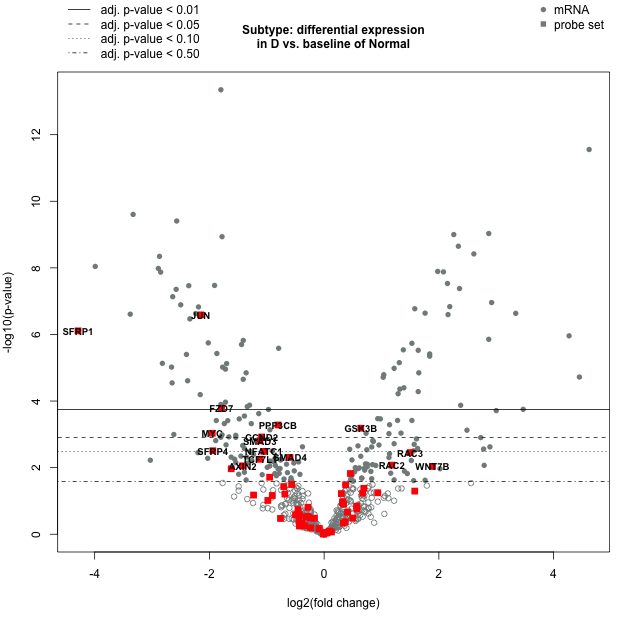
Volcano Plot: SubtypeD
Volcano plot displaying each gene's -log10(p-value) and log2 fold change for the selected covariate. Highly statistically significant genes fall at the top of the plot, and highly differentially expressed genes fall to either side. Genes within the selected gene set are highlighted in blue. Green point colors and horizontal lines indicate various False Discovery Rate (FDR) thresholds.
DE Results - Wnt genes - SubtypeD
More Plot Information Download CSV DataProbe Label Log2 fold change std error Lower confidence limit Upper confidence limit P-value BY.p.value Gene.sets Codeset.Name Probe.Label Analyte.Type Is.Control Control.Type Probe.Annotation KEGG.Pathways Cell.Type Official.Gene.Name volcanocol volcanopch tstats.all JUN-mRNA -2.15 0.364 -2.87 -1.44 2.58e-07 3.21e-05 MAPK, Wnt NS_CANCERPATH_C2535 JUN mRNA 0 MAPK;Wnt hsa04010;hsa04012;hsa04024;hsa04310;hsa04380;hsa04510;hsa04620;hsa04660;hsa04662;hsa04668;hsa04722;hsa04912;hsa04915;hsa04921;hsa04932;hsa04933;hsa05030;hsa05031;hsa05120;hsa05132;hsa05133;hsa05140;hsa05142;hsa05161;hsa05164;hsa05166;hsa05168;hsa05169;hsa05200;hsa05203;hsa05210;hsa05211;hsa05231;hsa05321;hsa05323 JUN chartreuse1 16 -5.90659340659341 SFRP1-mRNA -4.29 0.764 -5.79 -2.79 7.78e-07 9.1e-05 Wnt NS_CANCERPATH_C2535 SFRP1 mRNA 0 Wnt hsa04310 SFRP1 chartreuse1 16 -5.6151832460733 FZD7-mRNA -1.79 0.441 -2.65 -0.924 0.000168 0.00902 Wnt NS_CANCERPATH_C2535 FZD7 mRNA 0 Wnt hsa04310;hsa04390;hsa04550;hsa04916;hsa05166;hsa05200;hsa05205;hsa05217 FZD7 chartreuse1 16 -4.05895691609977 PPP3CB-mRNA -0.805 0.218 -1.23 -0.378 0.000523 0.0231 CC.PLS.Apop, MAPK, Wnt NS_CANCERPATH_C2535 PPP3CB mRNA 0 CC.PLS.Apop;MAPK;Wnt hsa04010;hsa04020;hsa04022;hsa04114;hsa04210;hsa04310;hsa04360;hsa04370;hsa04380;hsa04650;hsa04660;hsa04662;hsa04720;hsa04724;hsa04728;hsa04921;hsa04922;hsa04924;hsa05010;hsa05014;hsa05031;hsa05152;hsa05166 PPP3CB chartreuse2 16 -3.69266055045872 GSK3B-mRNA 0.639 0.176 0.294 0.985 0.000654 0.0283 CC.PLS.Apop, HH, PI3K, Wnt NS_CANCERPATH_C2535 GSK3B mRNA 0 CC.PLS.Apop;PI3K;HH;Wnt hsa04012;hsa04062;hsa04110;hsa04151;hsa04310;hsa04340;hsa04360;hsa04390;hsa04510;hsa04550;hsa04660;hsa04662;hsa04722;hsa04728;hsa04910;hsa04916;hsa04917;hsa04919;hsa04931;hsa04932;hsa05010;hsa05160;hsa05162;hsa05164;hsa05166;hsa05169;hsa05200;hsa05210;hsa05213;hsa05215;hsa05217 GSK3B chartreuse2 16 3.63068181818182 MYC-mRNA -1.95 0.555 -3.04 -0.862 0.000928 0.0381 CC.PLS.Apop, JAK-STAT, MAPK, PI3K, TGF-B, TXmisReg, Wnt NS_CANCERPATH_C2535 MYC mRNA 0 CC.PLS.Apop;PI3K;JAK-STAT;MAPK;TGF-B;TXmisReg;Wnt hsa04010;hsa04012;hsa04110;hsa04151;hsa04310;hsa04350;hsa04390;hsa04550;hsa04630;hsa04919;hsa05161;hsa05166;hsa05169;hsa05200;hsa05202;hsa05205;hsa05206;hsa05210;hsa05213;hsa05216;hsa05219;hsa05220;hsa05221;hsa05222;hsa05230 MYC chartreuse2 16 -3.51351351351351 CCND2-mRNA -1.09 0.318 -1.71 -0.467 0.0012 0.0464 CC.PLS.Apop, JAK-STAT, PI3K, TXmisReg, Wnt NS_CANCERPATH_C2535 CCND2 mRNA 0 CC.PLS.Apop;PI3K;JAK-STAT;TXmisReg;Wnt hsa04068;hsa04110;hsa04115;hsa04151;hsa04310;hsa04390;hsa04510;hsa04630;hsa04917;hsa05162;hsa05166;hsa05202;hsa05203;hsa05206 CCND2 chartreuse2 16 -3.42767295597484 SMAD3-mRNA -1.12 0.336 -1.78 -0.463 0.00157 0.0566 CC.PLS.Apop, TGF-B, Wnt NS_CANCERPATH_C2535 SMAD3 mRNA 0 CC.PLS.Apop;TGF-B;Wnt hsa04068;hsa04110;hsa04144;hsa04310;hsa04350;hsa04390;hsa04520;hsa04550;hsa04933;hsa05142;hsa05161;hsa05166;hsa05200;hsa05210;hsa05212;hsa05220;hsa05321 SMAD3 chartreuse3 16 -3.33333333333333 SFRP4-mRNA -1.94 0.626 -3.17 -0.716 0.0031 0.0977 Wnt NS_CANCERPATH_C2535 SFRP4 mRNA 0 Wnt hsa04310 SFRP4 chartreuse3 16 -3.09904153354633 NFATC1-mRNA -1.05 0.34 -1.72 -0.383 0.00324 0.0997 MAPK, Wnt NS_CANCERPATH_C2535 NFATC1 mRNA 0 MAPK;Wnt hsa04010;hsa04022;hsa04024;hsa04310;hsa04380;hsa04650;hsa04660;hsa04662;hsa04921;hsa04933;hsa05161;hsa05166;hsa05321 NFATC1 chartreuse3 16 -3.08823529411765 RAC3-mRNA 1.5 0.491 0.539 2.46 0.00353 0.107 MAPK, RAS, Wnt NS_CANCERPATH_C2535 RAC3 mRNA 0 RAS;MAPK;Wnt hsa04010;hsa04014;hsa04015;hsa04024;hsa04071;hsa04310;hsa04360;hsa04370;hsa04510;hsa04520;hsa04650;hsa04662;hsa04664;hsa04810;hsa05200;hsa05210;hsa05212;hsa05231;hsa05416 RAC3 chartreuse4 16 3.05498981670061 SMAD4-mRNA -0.594 0.202 -0.991 -0.198 0.00493 0.14 CC.PLS.Apop, Driver Gene, TGF-B, Wnt NS_CANCERPATH_C2535 SMAD4 mRNA 0 CC.PLS.Apop;TGF-B;Wnt;Driver Gene hsa04068;hsa04110;hsa04310;hsa04350;hsa04390;hsa04520;hsa04550;hsa04933;hsa05161;hsa05166;hsa05200;hsa05210;hsa05212;hsa05220 SMAD4 chartreuse4 16 -2.94059405940594 TCF7L1-mRNA -1.12 0.387 -1.88 -0.36 0.00559 0.153 Wnt NS_CANCERPATH_C2535 TCF7L1 mRNA 0 Wnt hsa04310;hsa04390;hsa04520;hsa04916;hsa05200;hsa05210;hsa05213;hsa05215;hsa05216;hsa05217;hsa05221;hsa05412 TCF7L1 chartreuse4 16 -2.89405684754522 RAC2-mRNA 1.18 0.431 0.336 2.03 0.0084 0.206 MAPK, RAS, Wnt NS_CANCERPATH_C2535 RAC2 mRNA 0 RAS;MAPK;Wnt hsa04010;hsa04014;hsa04015;hsa04024;hsa04062;hsa04071;hsa04310;hsa04360;hsa04370;hsa04510;hsa04520;hsa04650;hsa04662;hsa04664;hsa04666;hsa04670;hsa04810;hsa05200;hsa05210;hsa05212;hsa05231;hsa05416 RAC2 chartreuse4 16 2.73781902552204 AXIN2-mRNA -1.42 0.521 -2.44 -0.397 0.00881 0.211 Wnt NS_CANCERPATH_C2535 AXIN2 mRNA 0 Wnt hsa04310;hsa04390;hsa04550;hsa05200;hsa05210;hsa05213;hsa05217 AXIN2 chartreuse4 16 -2.72552783109405 WNT7B-mRNA 1.89 0.697 0.52 3.25 0.00919 0.218 HH, Wnt NS_CANCERPATH_C2535 WNT7B mRNA 0 HH;Wnt hsa04310;hsa04340;hsa04390;hsa04550;hsa04916;hsa05166;hsa05200;hsa05205;hsa05217 WNT7B chartreuse4 16 2.7116212338594 WIF1-mRNA -1.62 0.614 -2.83 -0.42 0.0108 0.244 Wnt NS_CANCERPATH_C2535 WIF1 mRNA 0 Wnt hsa04310 WIF1 chartreuse4 16 -2.63843648208469 CUL1-mRNA 0.458 0.182 0.101 0.815 0.015 0.315 CC.PLS.Apop, TGF-B, Wnt NS_CANCERPATH_C2535 CUL1 mRNA 0 CC.PLS.Apop;TGF-B;Wnt hsa04110;hsa04114;hsa04120;hsa04141;hsa04310;hsa04350;hsa05168 CUL1 chartreuse4 16 2.51648351648352 PRKCA-mRNA -0.95 0.394 -1.72 -0.178 0.0194 0.394 MAPK, PI3K, RAS, Wnt NS_CANCERPATH_C2535 PRKCA mRNA 0 RAS;PI3K;MAPK;Wnt hsa04010;hsa04012;hsa04014;hsa04015;hsa04020;hsa04066;hsa04070;hsa04071;hsa04072;hsa04150;hsa04151;hsa04261;hsa04270;hsa04310;hsa04370;hsa04510;hsa04530;hsa04540;hsa04650;hsa04664;hsa04666;hsa04670;hsa04713;hsa04720;hsa04723;hsa04724;hsa04725;hsa04726;hsa04727;hsa04728;hsa04730;hsa04750;hsa04911;hsa04912;hsa04916;hsa04918;hsa04919;hsa04921;hsa04925;hsa04933;hsa04960;hsa04961;hsa04970;hsa04971;hsa04972;hsa05031;hsa05032;hsa05110;hsa05130;hsa05143;hsa05146;hsa05161;hsa05164;hsa05200;hsa05205;hsa05206;hsa05214;hsa05223;hsa05231 PRKCA chartreuse4 16 -2.41116751269035 PPP3CC-mRNA -0.565 0.257 -1.07 -0.0621 0.0321 0.592 CC.PLS.Apop, MAPK, Wnt NS_CANCERPATH_C2535 PPP3CC mRNA 0 CC.PLS.Apop;MAPK;Wnt hsa04010;hsa04020;hsa04022;hsa04114;hsa04210;hsa04310;hsa04360;hsa04370;hsa04380;hsa04650;hsa04660;hsa04662;hsa04720;hsa04724;hsa04728;hsa04921;hsa04922;hsa04924;hsa05010;hsa05014;hsa05031;hsa05152;hsa05166 PPP3CC azure4 1 -2.19844357976654 DE Results - Wnt genes - SubtypeD
Table displaying each sample's global significance scores and directed global significance scores as defined in the heatmaps above. The global significance score is calculated as the square root of the mean squared t-statistic for the genes in a gene set, with t-statistics coming from the linear regression underlying our differential expression analysis. The directed global significance score is calculated as the square root of the mean signed squared t-statistic for the genes in a gene set, with t-statistics coming from the linear regression underlying our differential expression analysis.
Pathview is used to overlay differential expression results on KEGG pathways
- Subtype:
- SubtypeA
- SubtypeB
- SubtypeC
- SubtypeD
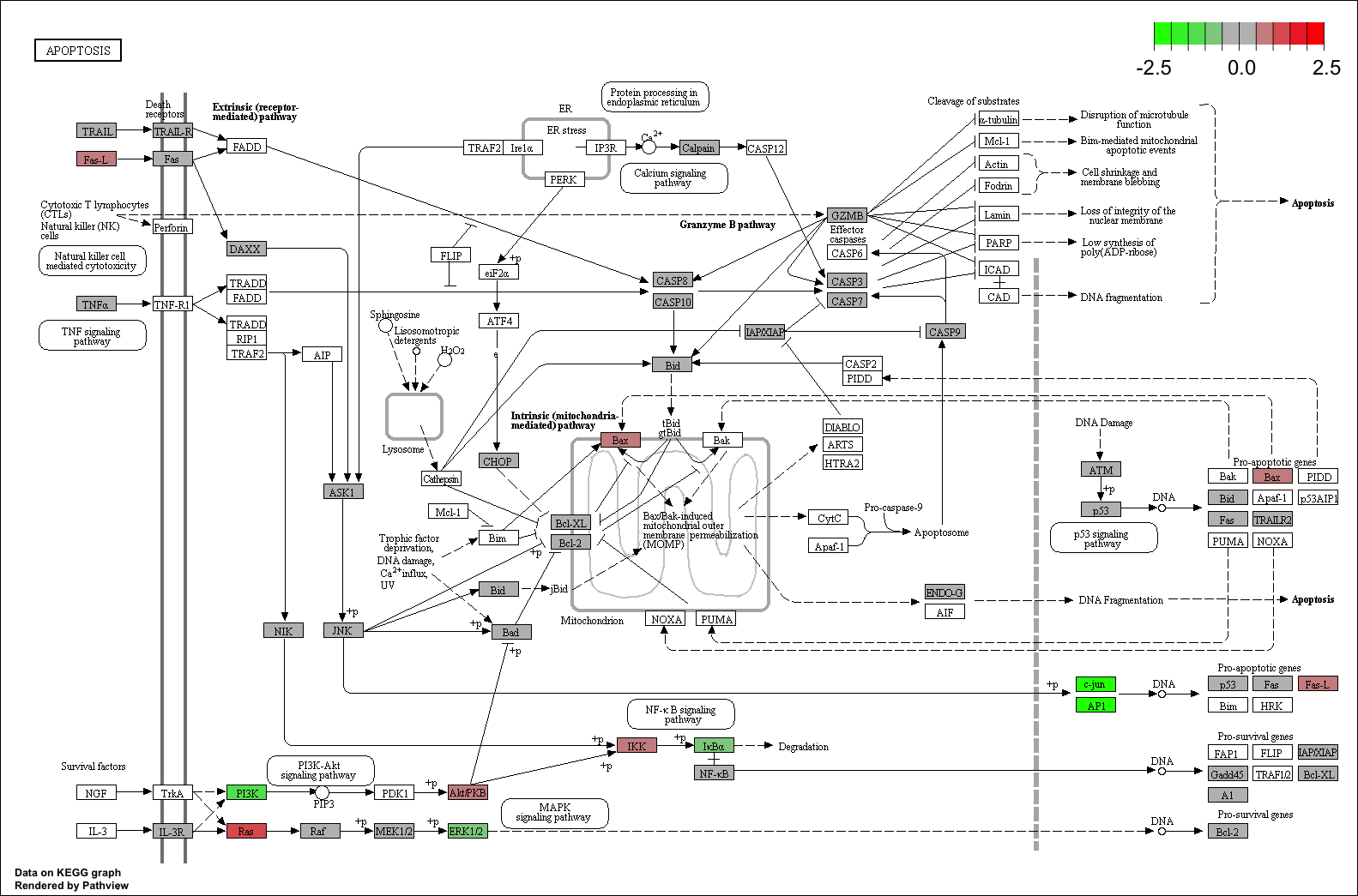
For each KEGG pathway, genes within the panel are mapped to the pathway and differential expression information is overlaid on the protein-based KEGG pathway image. Pathway nodes shown in white have no genes in the panel that map to them. Pathway nodes in grey have corresponding genes in the panel, however no significant differential expression is observed. Nodes in green denote downregulation relative to the selected baseline, whereas nodes in red denote upregulation relative to the selected baseline.
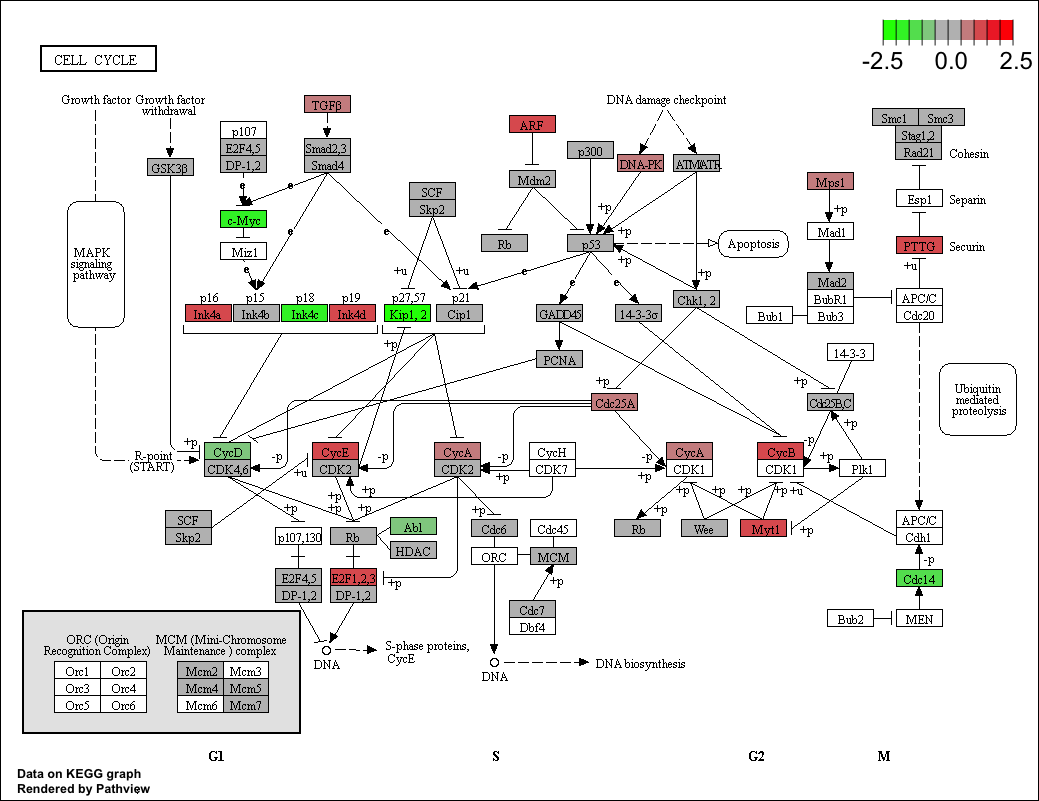
For each KEGG pathway, genes within the panel are mapped to the pathway and differential expression information is overlaid on the protein-based KEGG pathway image. Pathway nodes shown in white have no genes in the panel that map to them. Pathway nodes in grey have corresponding genes in the panel, however no significant differential expression is observed. Nodes in green denote downregulation relative to the selected baseline, whereas nodes in red denote upregulation relative to the selected baseline.
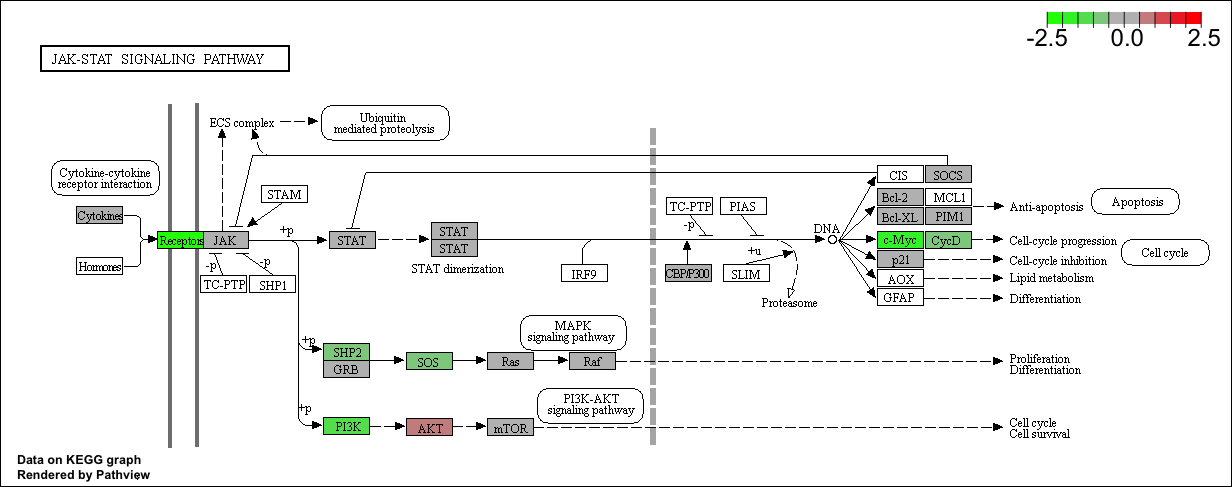
For each KEGG pathway, genes within the panel are mapped to the pathway and differential expression information is overlaid on the protein-based KEGG pathway image. Pathway nodes shown in white have no genes in the panel that map to them. Pathway nodes in grey have corresponding genes in the panel, however no significant differential expression is observed. Nodes in green denote downregulation relative to the selected baseline, whereas nodes in red denote upregulation relative to the selected baseline.

For each KEGG pathway, genes within the panel are mapped to the pathway and differential expression information is overlaid on the protein-based KEGG pathway image. Pathway nodes shown in white have no genes in the panel that map to them. Pathway nodes in grey have corresponding genes in the panel, however no significant differential expression is observed. Nodes in green denote downregulation relative to the selected baseline, whereas nodes in red denote upregulation relative to the selected baseline.
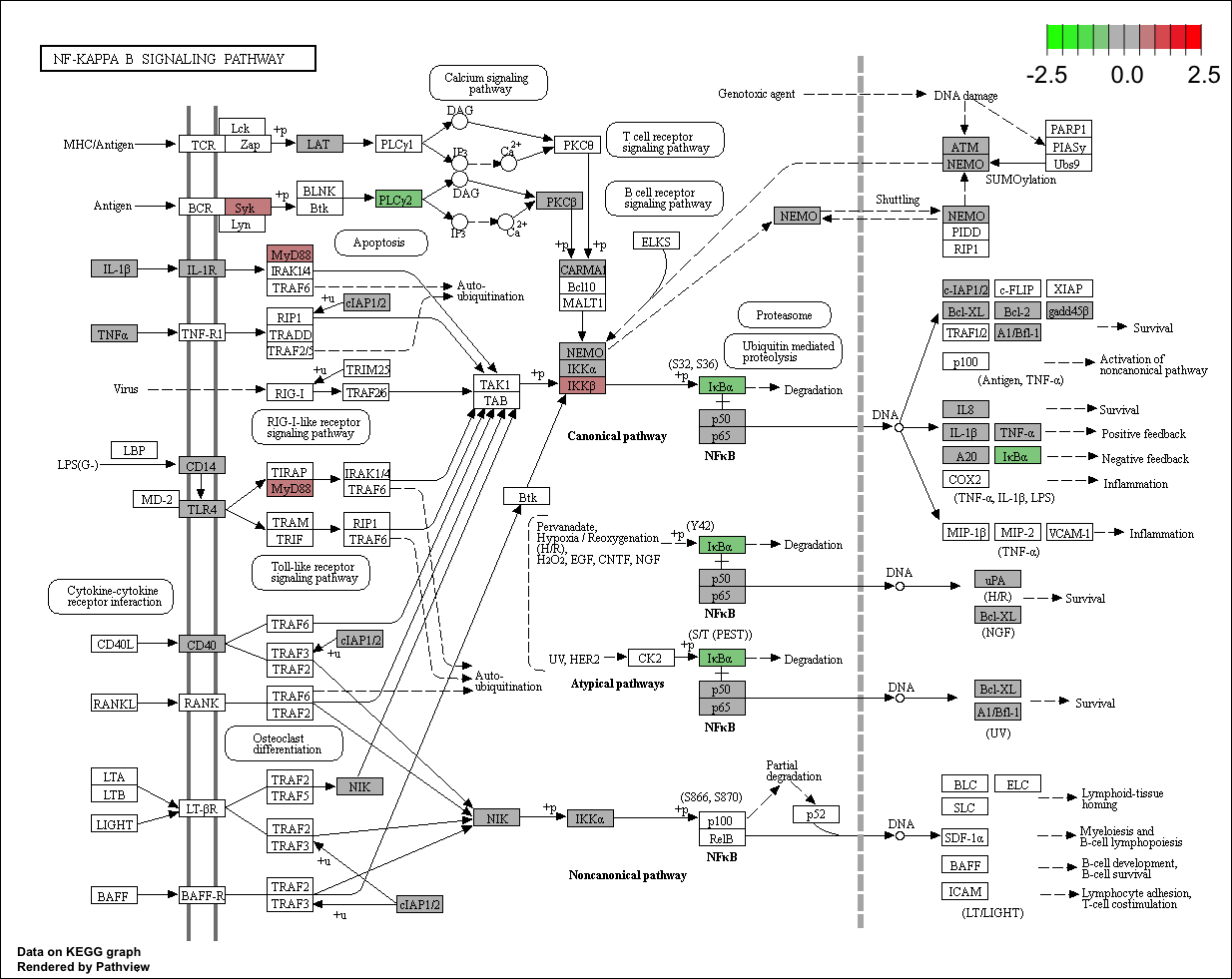
For each KEGG pathway, genes within the panel are mapped to the pathway and differential expression information is overlaid on the protein-based KEGG pathway image. Pathway nodes shown in white have no genes in the panel that map to them. Pathway nodes in grey have corresponding genes in the panel, however no significant differential expression is observed. Nodes in green denote downregulation relative to the selected baseline, whereas nodes in red denote upregulation relative to the selected baseline.
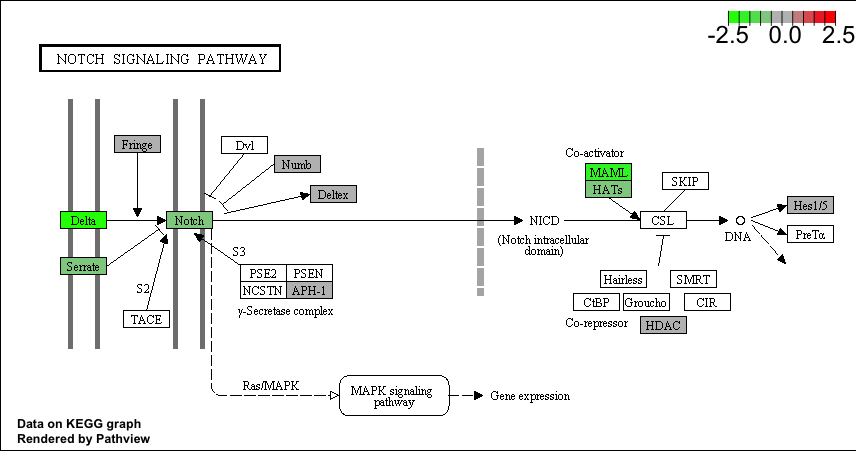
For each KEGG pathway, genes within the panel are mapped to the pathway and differential expression information is overlaid on the protein-based KEGG pathway image. Pathway nodes shown in white have no genes in the panel that map to them. Pathway nodes in grey have corresponding genes in the panel, however no significant differential expression is observed. Nodes in green denote downregulation relative to the selected baseline, whereas nodes in red denote upregulation relative to the selected baseline.
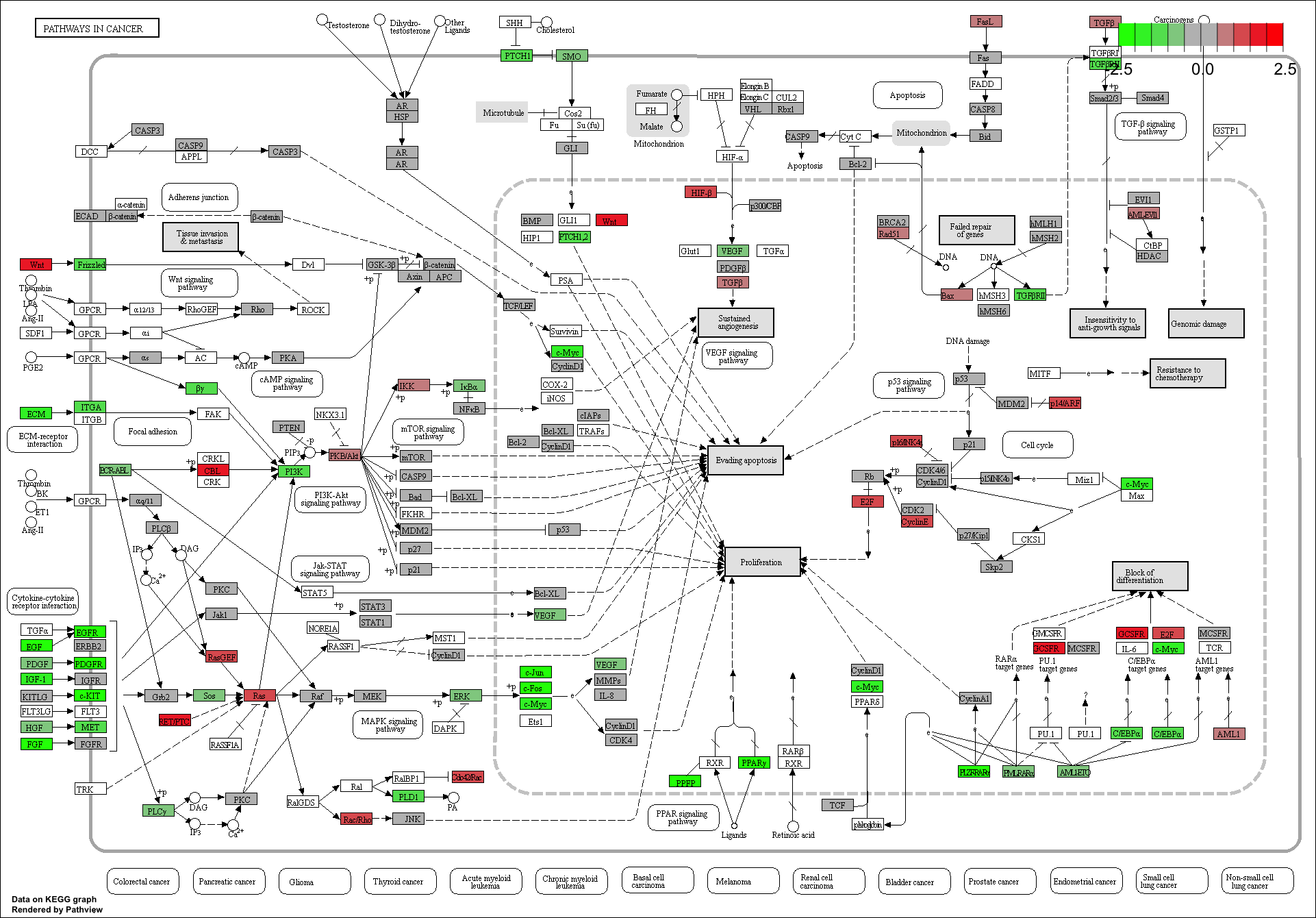
For each KEGG pathway, genes within the panel are mapped to the pathway and differential expression information is overlaid on the protein-based KEGG pathway image. Pathway nodes shown in white have no genes in the panel that map to them. Pathway nodes in grey have corresponding genes in the panel, however no significant differential expression is observed. Nodes in green denote downregulation relative to the selected baseline, whereas nodes in red denote upregulation relative to the selected baseline.

For each KEGG pathway, genes within the panel are mapped to the pathway and differential expression information is overlaid on the protein-based KEGG pathway image. Pathway nodes shown in white have no genes in the panel that map to them. Pathway nodes in grey have corresponding genes in the panel, however no significant differential expression is observed. Nodes in green denote downregulation relative to the selected baseline, whereas nodes in red denote upregulation relative to the selected baseline.

For each KEGG pathway, genes within the panel are mapped to the pathway and differential expression information is overlaid on the protein-based KEGG pathway image. Pathway nodes shown in white have no genes in the panel that map to them. Pathway nodes in grey have corresponding genes in the panel, however no significant differential expression is observed. Nodes in green denote downregulation relative to the selected baseline, whereas nodes in red denote upregulation relative to the selected baseline.
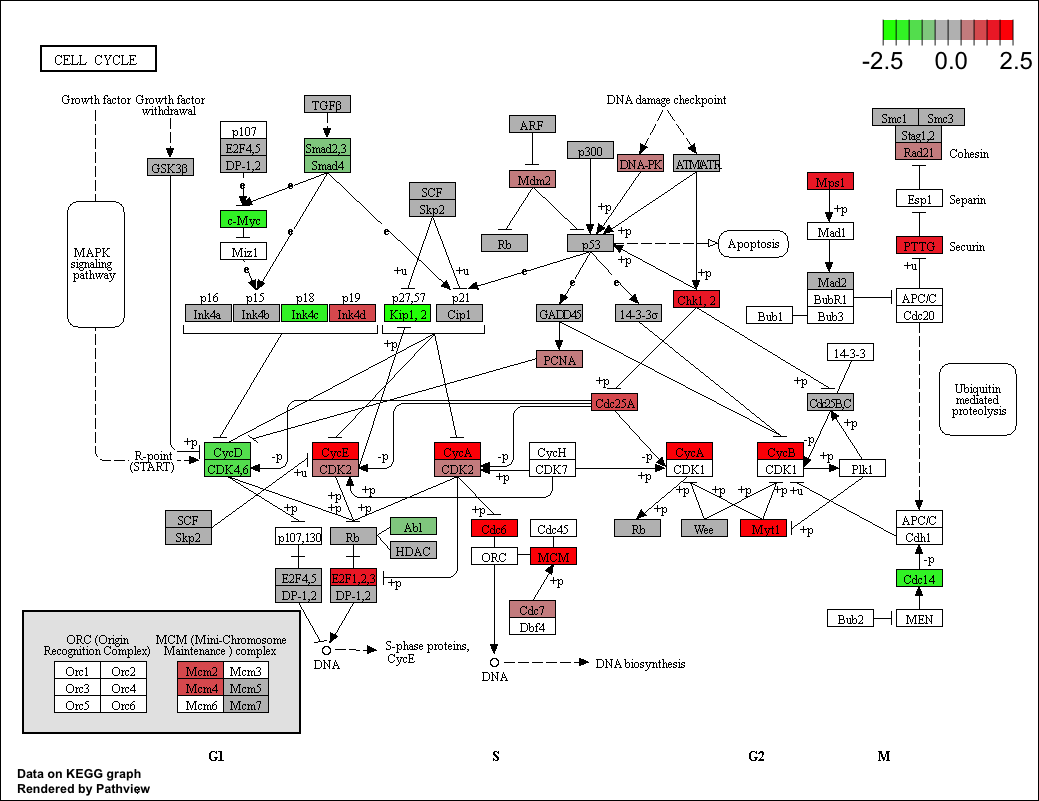
For each KEGG pathway, genes within the panel are mapped to the pathway and differential expression information is overlaid on the protein-based KEGG pathway image. Pathway nodes shown in white have no genes in the panel that map to them. Pathway nodes in grey have corresponding genes in the panel, however no significant differential expression is observed. Nodes in green denote downregulation relative to the selected baseline, whereas nodes in red denote upregulation relative to the selected baseline.
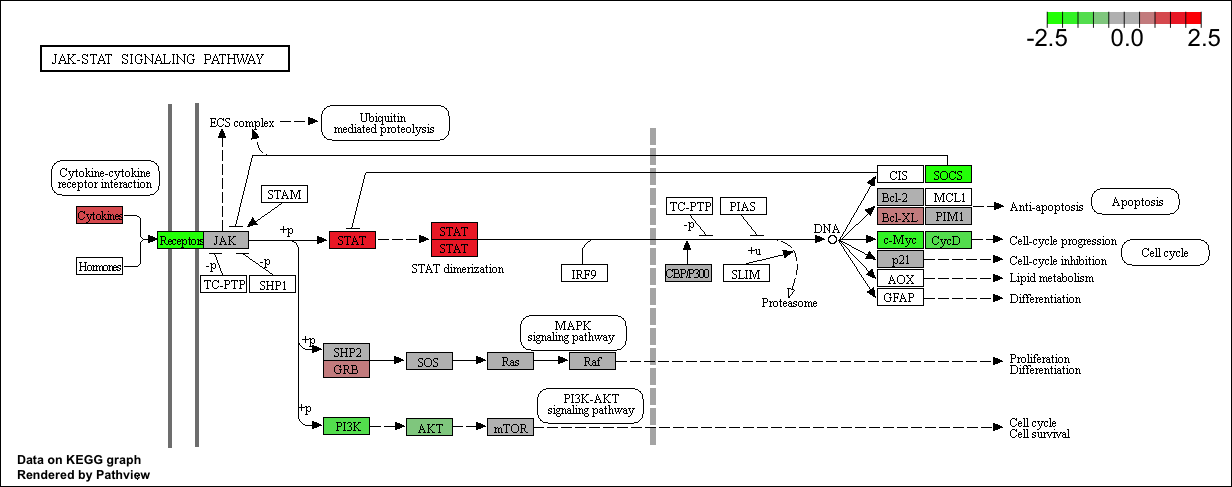
For each KEGG pathway, genes within the panel are mapped to the pathway and differential expression information is overlaid on the protein-based KEGG pathway image. Pathway nodes shown in white have no genes in the panel that map to them. Pathway nodes in grey have corresponding genes in the panel, however no significant differential expression is observed. Nodes in green denote downregulation relative to the selected baseline, whereas nodes in red denote upregulation relative to the selected baseline.
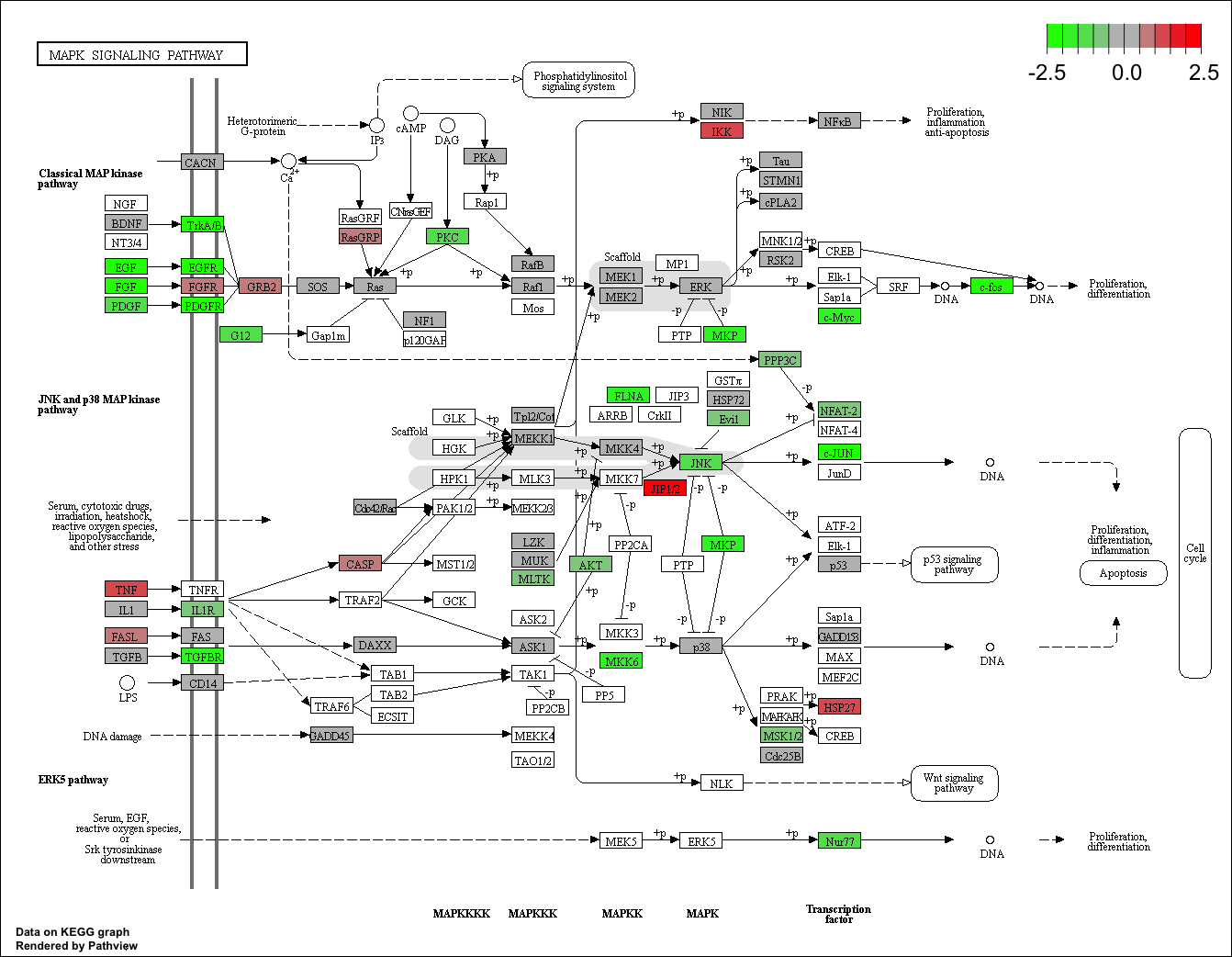
For each KEGG pathway, genes within the panel are mapped to the pathway and differential expression information is overlaid on the protein-based KEGG pathway image. Pathway nodes shown in white have no genes in the panel that map to them. Pathway nodes in grey have corresponding genes in the panel, however no significant differential expression is observed. Nodes in green denote downregulation relative to the selected baseline, whereas nodes in red denote upregulation relative to the selected baseline.
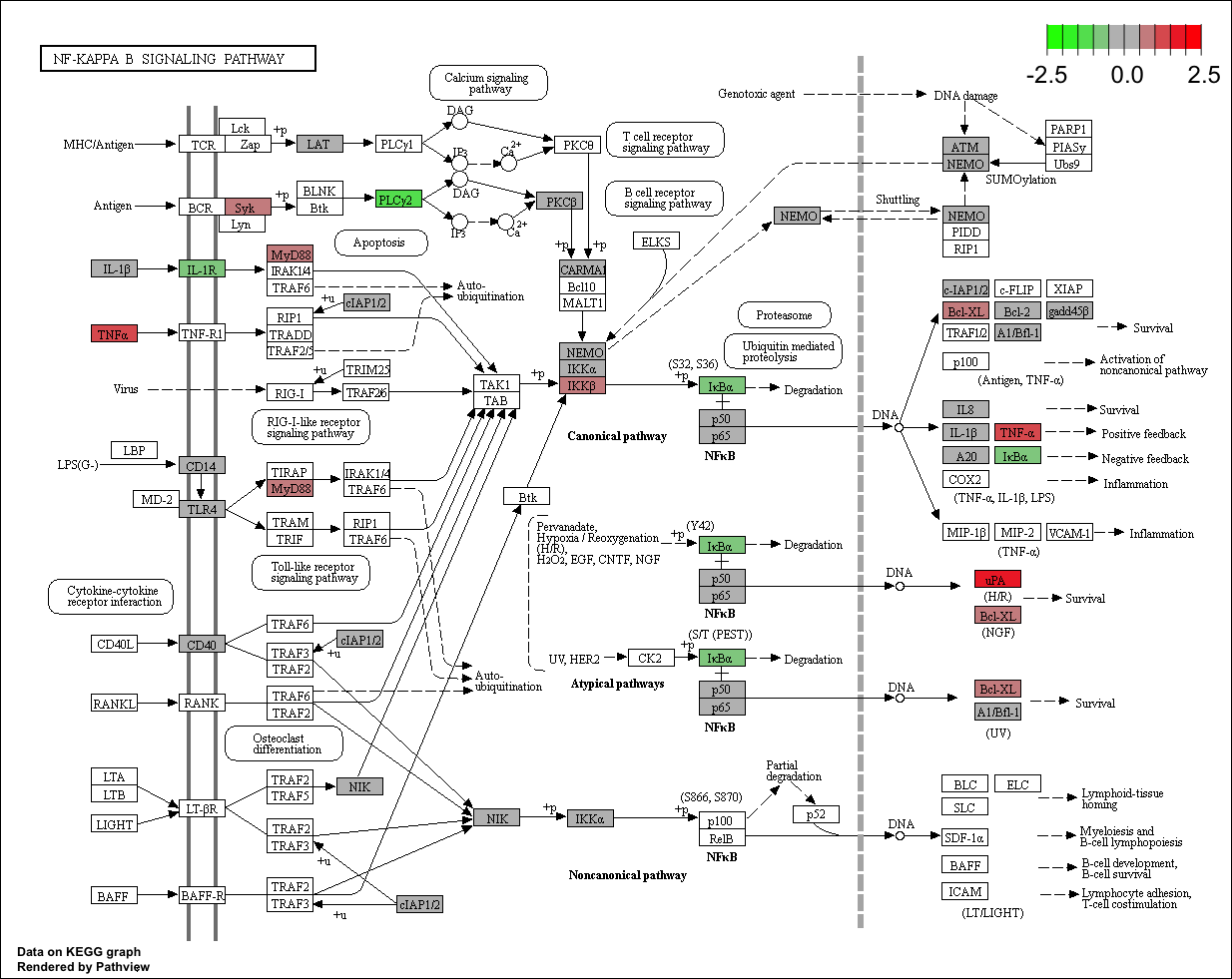
For each KEGG pathway, genes within the panel are mapped to the pathway and differential expression information is overlaid on the protein-based KEGG pathway image. Pathway nodes shown in white have no genes in the panel that map to them. Pathway nodes in grey have corresponding genes in the panel, however no significant differential expression is observed. Nodes in green denote downregulation relative to the selected baseline, whereas nodes in red denote upregulation relative to the selected baseline.
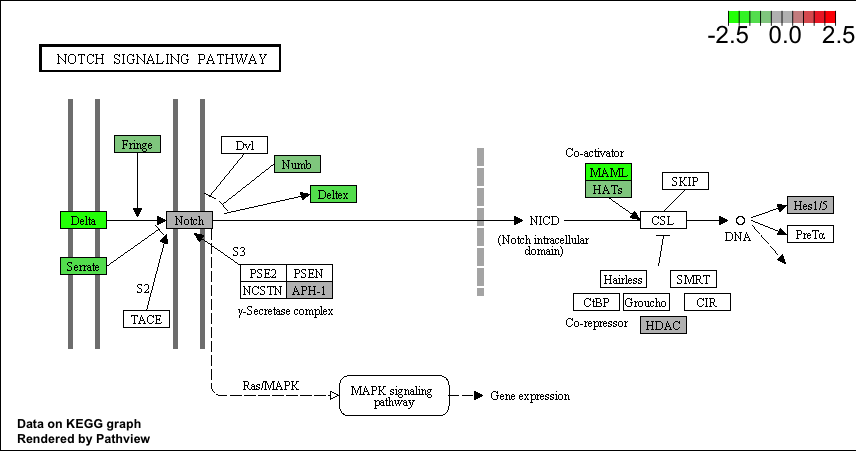
For each KEGG pathway, genes within the panel are mapped to the pathway and differential expression information is overlaid on the protein-based KEGG pathway image. Pathway nodes shown in white have no genes in the panel that map to them. Pathway nodes in grey have corresponding genes in the panel, however no significant differential expression is observed. Nodes in green denote downregulation relative to the selected baseline, whereas nodes in red denote upregulation relative to the selected baseline.
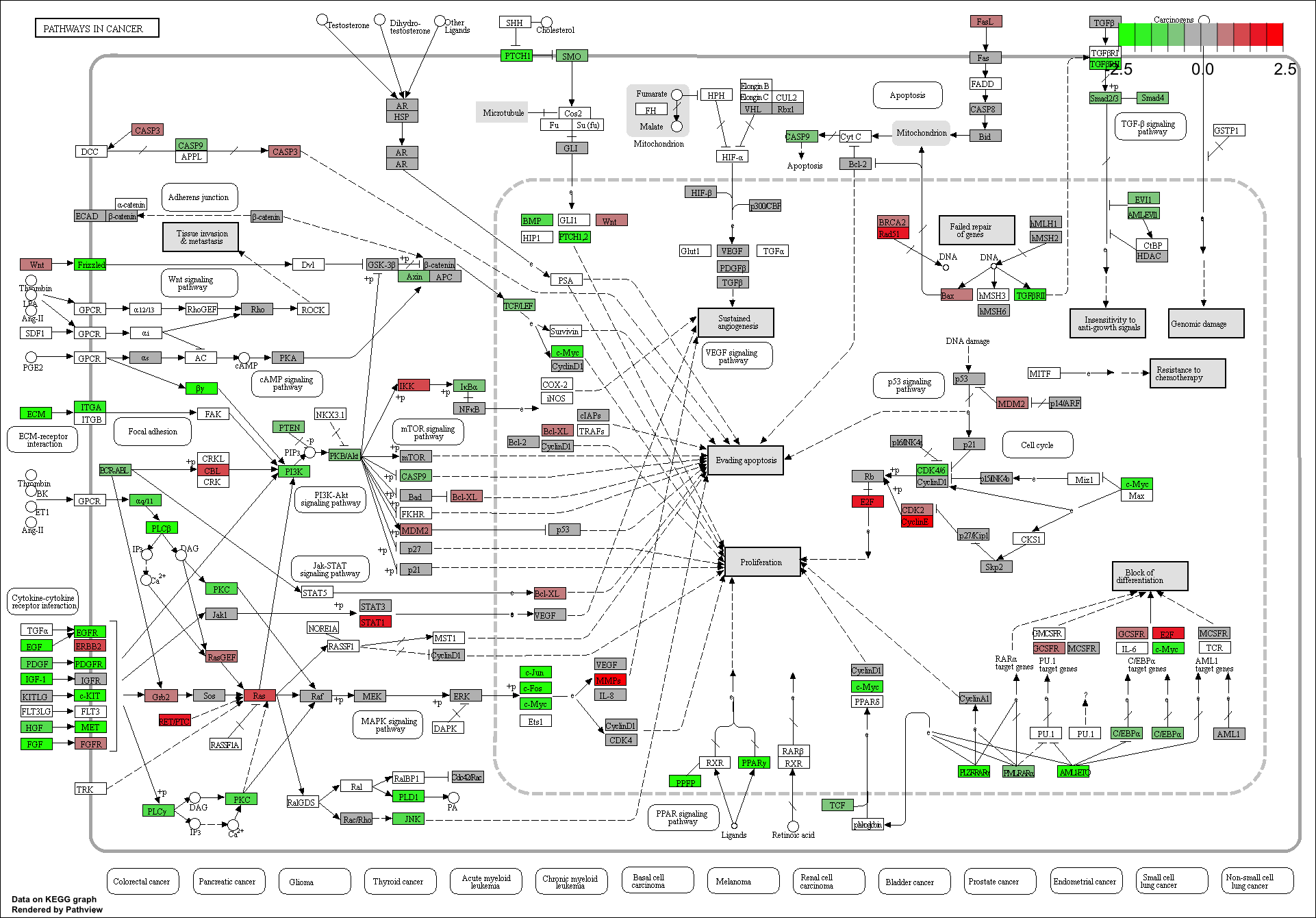
For each KEGG pathway, genes within the panel are mapped to the pathway and differential expression information is overlaid on the protein-based KEGG pathway image. Pathway nodes shown in white have no genes in the panel that map to them. Pathway nodes in grey have corresponding genes in the panel, however no significant differential expression is observed. Nodes in green denote downregulation relative to the selected baseline, whereas nodes in red denote upregulation relative to the selected baseline.
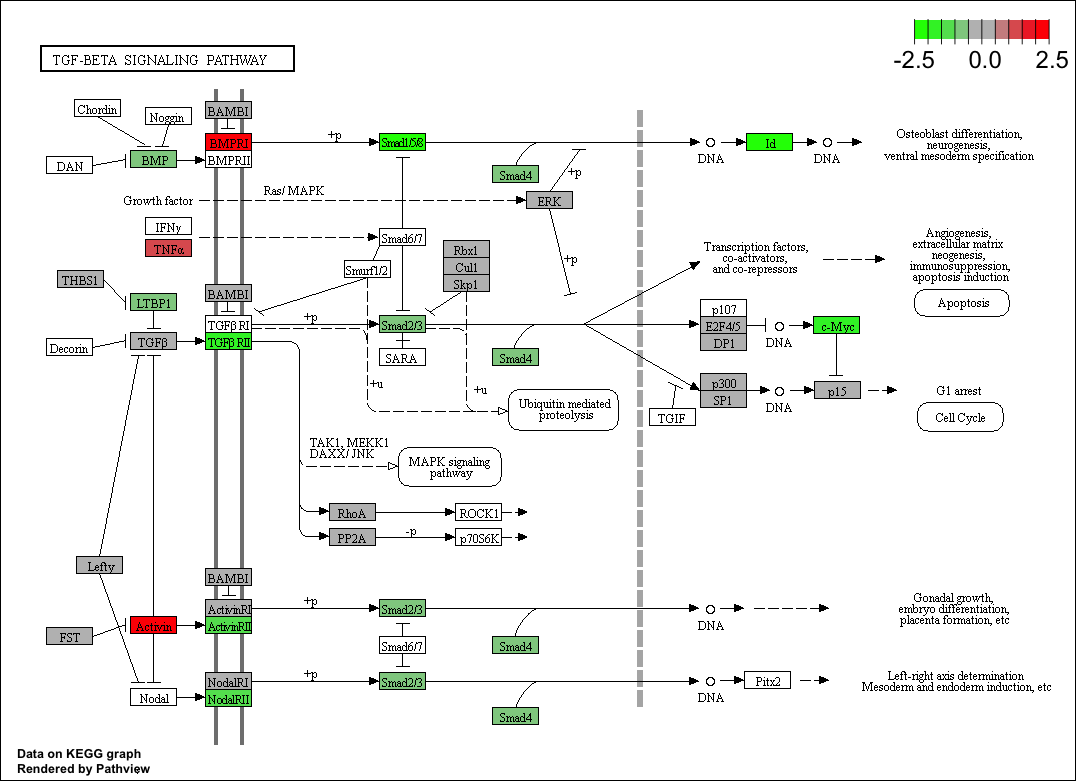
For each KEGG pathway, genes within the panel are mapped to the pathway and differential expression information is overlaid on the protein-based KEGG pathway image. Pathway nodes shown in white have no genes in the panel that map to them. Pathway nodes in grey have corresponding genes in the panel, however no significant differential expression is observed. Nodes in green denote downregulation relative to the selected baseline, whereas nodes in red denote upregulation relative to the selected baseline.
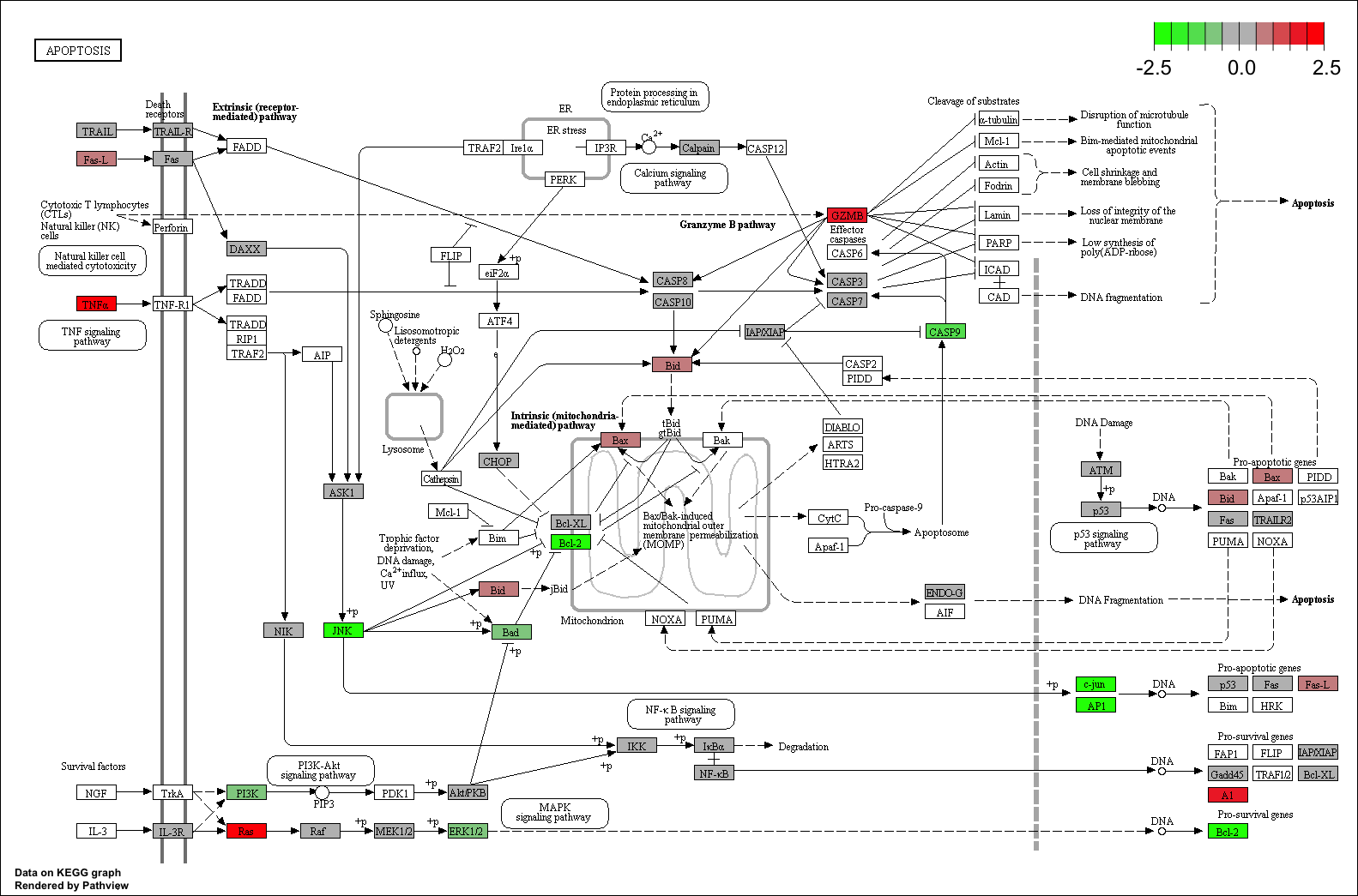
For each KEGG pathway, genes within the panel are mapped to the pathway and differential expression information is overlaid on the protein-based KEGG pathway image. Pathway nodes shown in white have no genes in the panel that map to them. Pathway nodes in grey have corresponding genes in the panel, however no significant differential expression is observed. Nodes in green denote downregulation relative to the selected baseline, whereas nodes in red denote upregulation relative to the selected baseline.

For each KEGG pathway, genes within the panel are mapped to the pathway and differential expression information is overlaid on the protein-based KEGG pathway image. Pathway nodes shown in white have no genes in the panel that map to them. Pathway nodes in grey have corresponding genes in the panel, however no significant differential expression is observed. Nodes in green denote downregulation relative to the selected baseline, whereas nodes in red denote upregulation relative to the selected baseline.

For each KEGG pathway, genes within the panel are mapped to the pathway and differential expression information is overlaid on the protein-based KEGG pathway image. Pathway nodes shown in white have no genes in the panel that map to them. Pathway nodes in grey have corresponding genes in the panel, however no significant differential expression is observed. Nodes in green denote downregulation relative to the selected baseline, whereas nodes in red denote upregulation relative to the selected baseline.
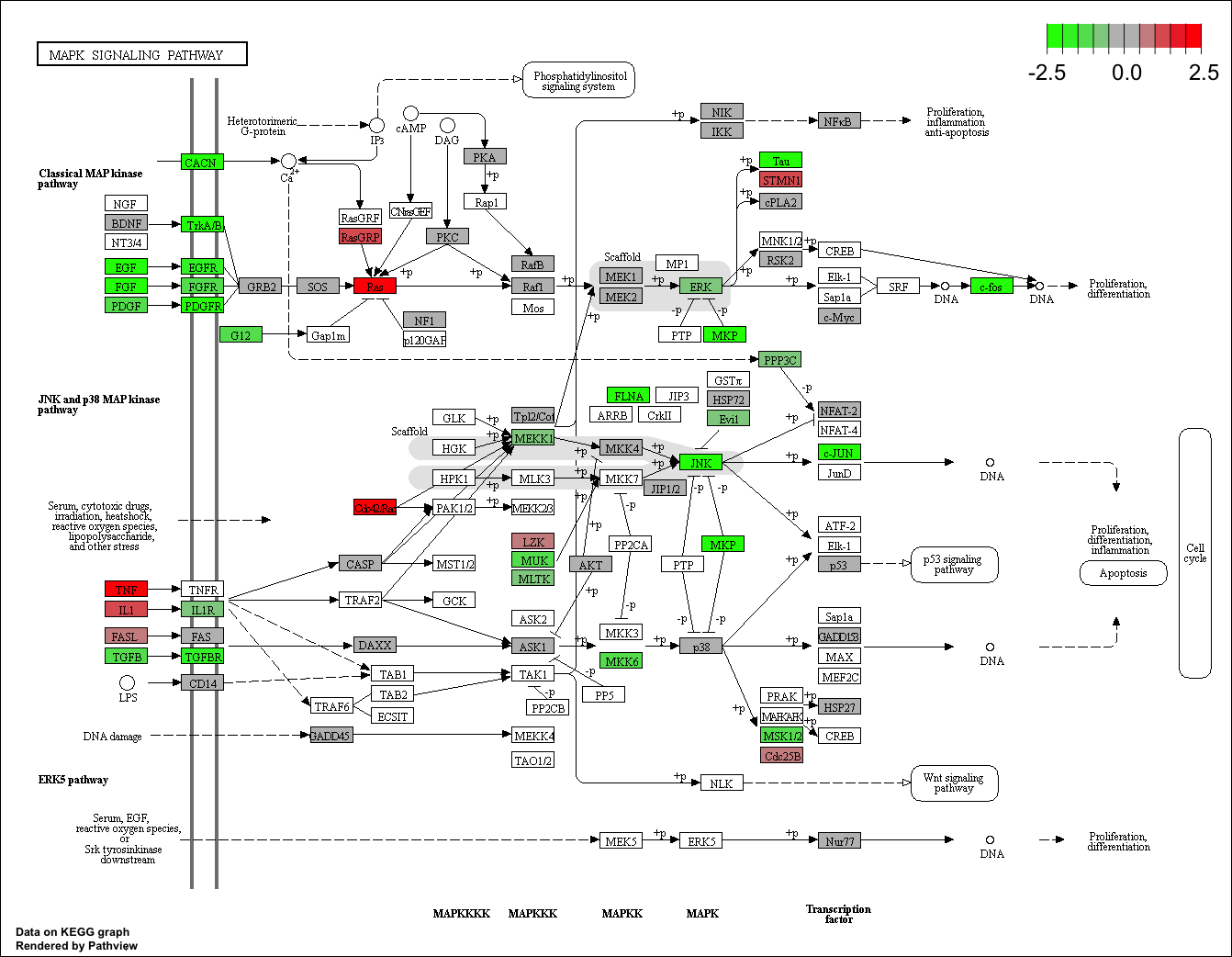
For each KEGG pathway, genes within the panel are mapped to the pathway and differential expression information is overlaid on the protein-based KEGG pathway image. Pathway nodes shown in white have no genes in the panel that map to them. Pathway nodes in grey have corresponding genes in the panel, however no significant differential expression is observed. Nodes in green denote downregulation relative to the selected baseline, whereas nodes in red denote upregulation relative to the selected baseline.
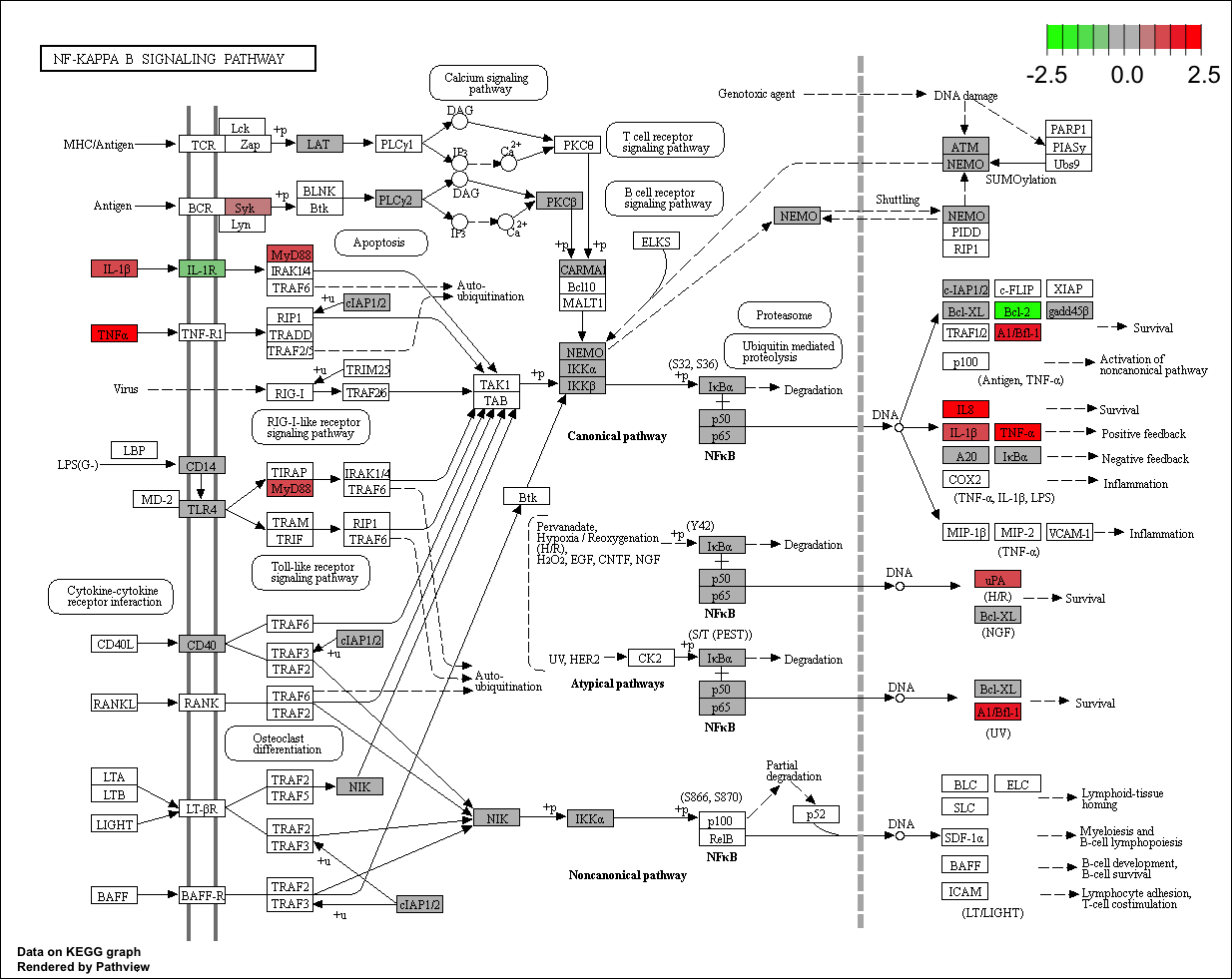
For each KEGG pathway, genes within the panel are mapped to the pathway and differential expression information is overlaid on the protein-based KEGG pathway image. Pathway nodes shown in white have no genes in the panel that map to them. Pathway nodes in grey have corresponding genes in the panel, however no significant differential expression is observed. Nodes in green denote downregulation relative to the selected baseline, whereas nodes in red denote upregulation relative to the selected baseline.
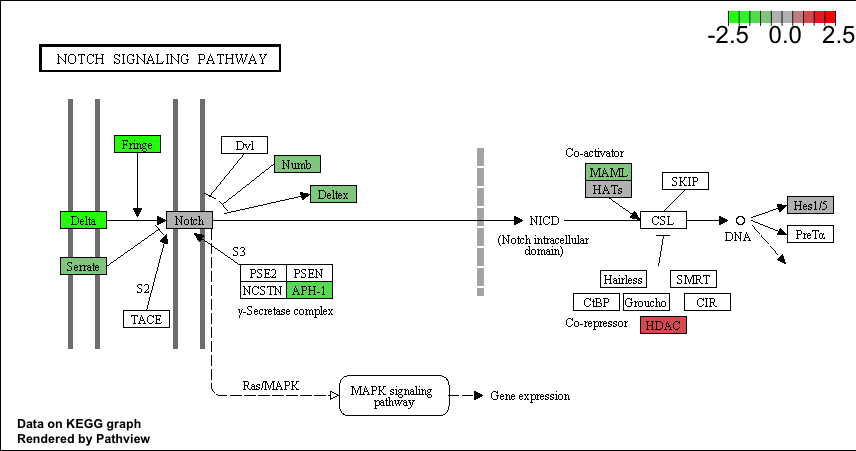
For each KEGG pathway, genes within the panel are mapped to the pathway and differential expression information is overlaid on the protein-based KEGG pathway image. Pathway nodes shown in white have no genes in the panel that map to them. Pathway nodes in grey have corresponding genes in the panel, however no significant differential expression is observed. Nodes in green denote downregulation relative to the selected baseline, whereas nodes in red denote upregulation relative to the selected baseline.
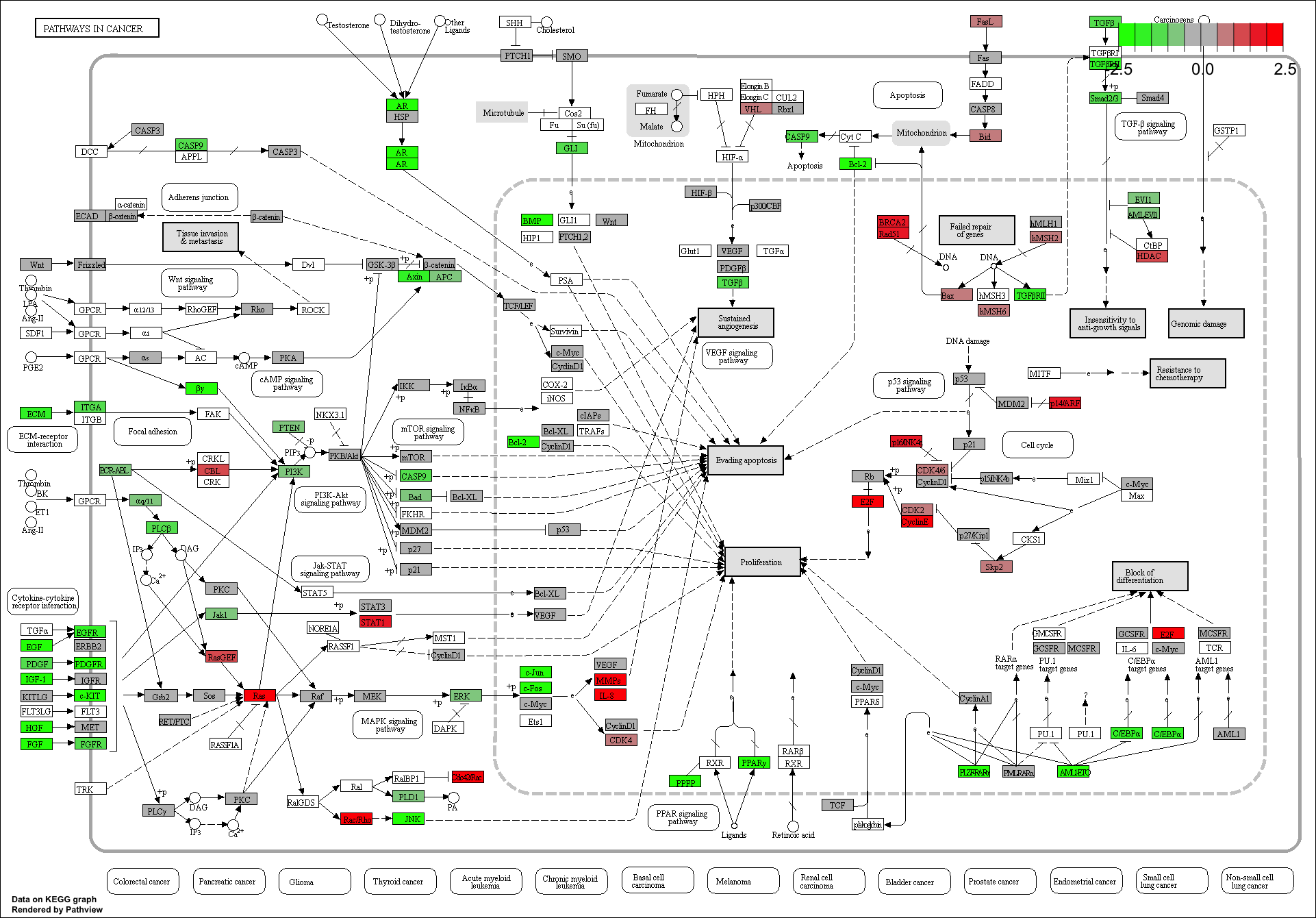
For each KEGG pathway, genes within the panel are mapped to the pathway and differential expression information is overlaid on the protein-based KEGG pathway image. Pathway nodes shown in white have no genes in the panel that map to them. Pathway nodes in grey have corresponding genes in the panel, however no significant differential expression is observed. Nodes in green denote downregulation relative to the selected baseline, whereas nodes in red denote upregulation relative to the selected baseline.
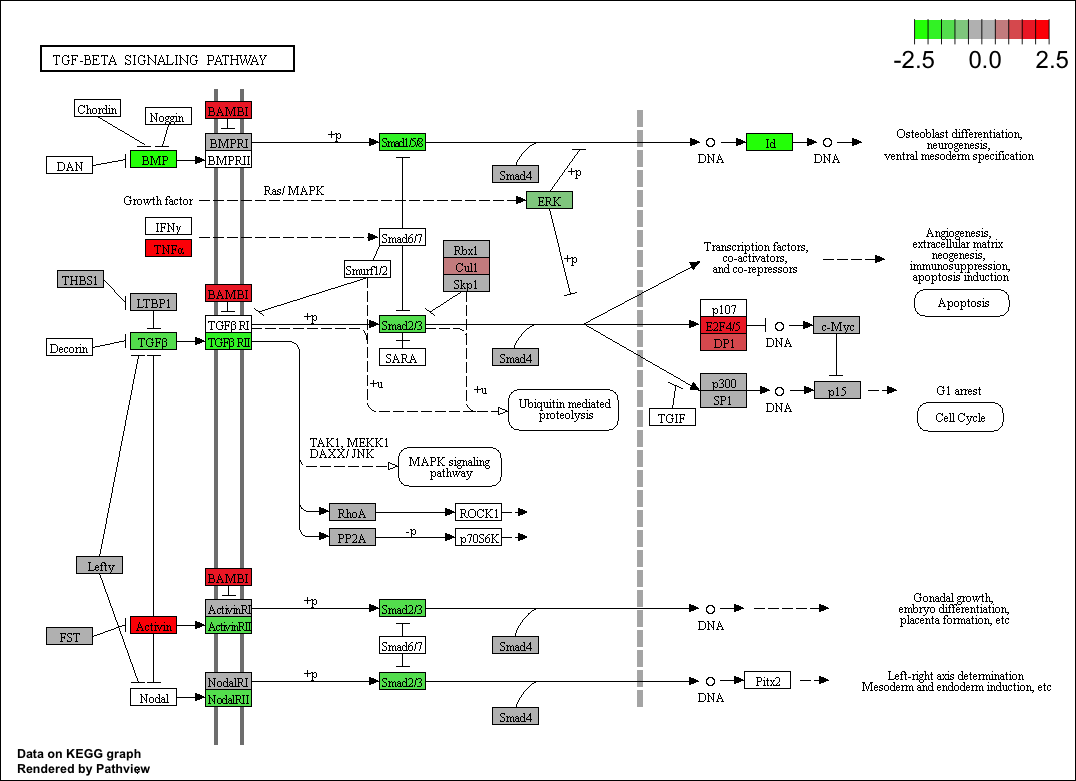
For each KEGG pathway, genes within the panel are mapped to the pathway and differential expression information is overlaid on the protein-based KEGG pathway image. Pathway nodes shown in white have no genes in the panel that map to them. Pathway nodes in grey have corresponding genes in the panel, however no significant differential expression is observed. Nodes in green denote downregulation relative to the selected baseline, whereas nodes in red denote upregulation relative to the selected baseline.
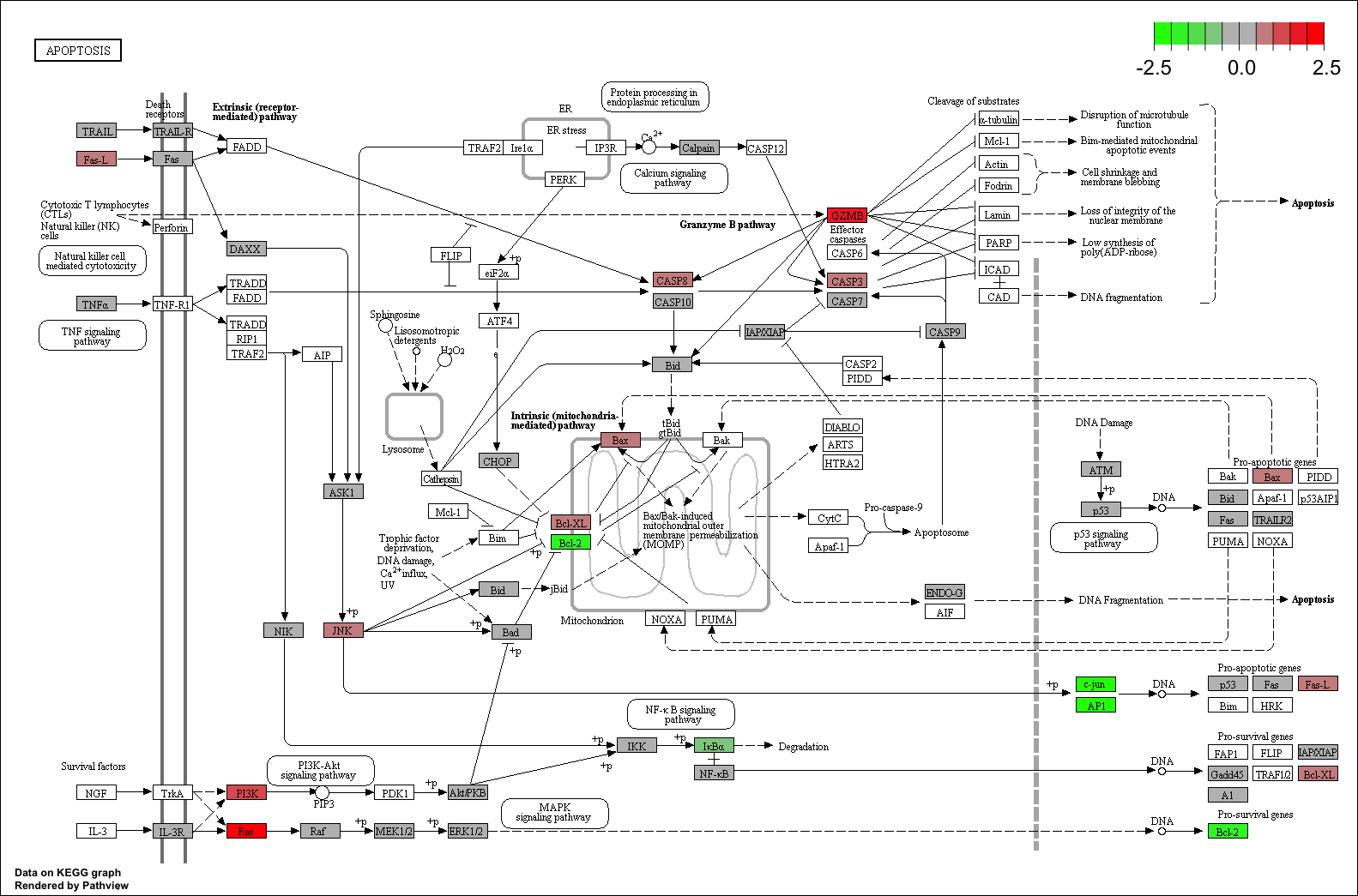
For each KEGG pathway, genes within the panel are mapped to the pathway and differential expression information is overlaid on the protein-based KEGG pathway image. Pathway nodes shown in white have no genes in the panel that map to them. Pathway nodes in grey have corresponding genes in the panel, however no significant differential expression is observed. Nodes in green denote downregulation relative to the selected baseline, whereas nodes in red denote upregulation relative to the selected baseline.
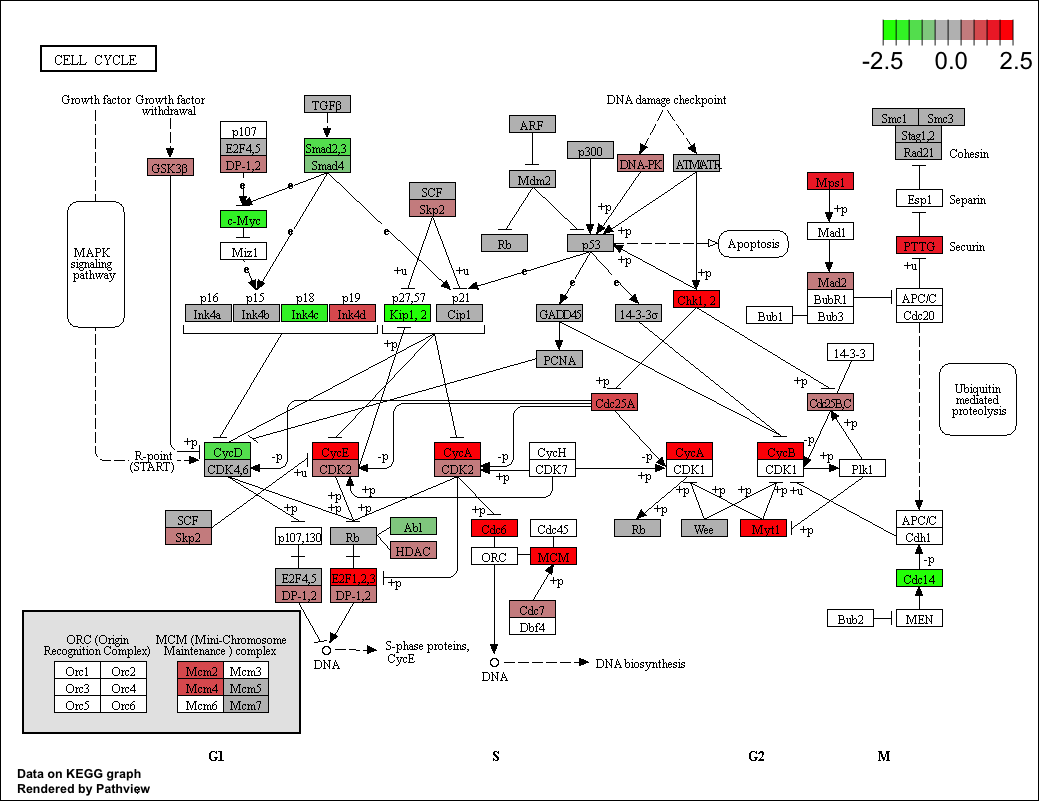
For each KEGG pathway, genes within the panel are mapped to the pathway and differential expression information is overlaid on the protein-based KEGG pathway image. Pathway nodes shown in white have no genes in the panel that map to them. Pathway nodes in grey have corresponding genes in the panel, however no significant differential expression is observed. Nodes in green denote downregulation relative to the selected baseline, whereas nodes in red denote upregulation relative to the selected baseline.
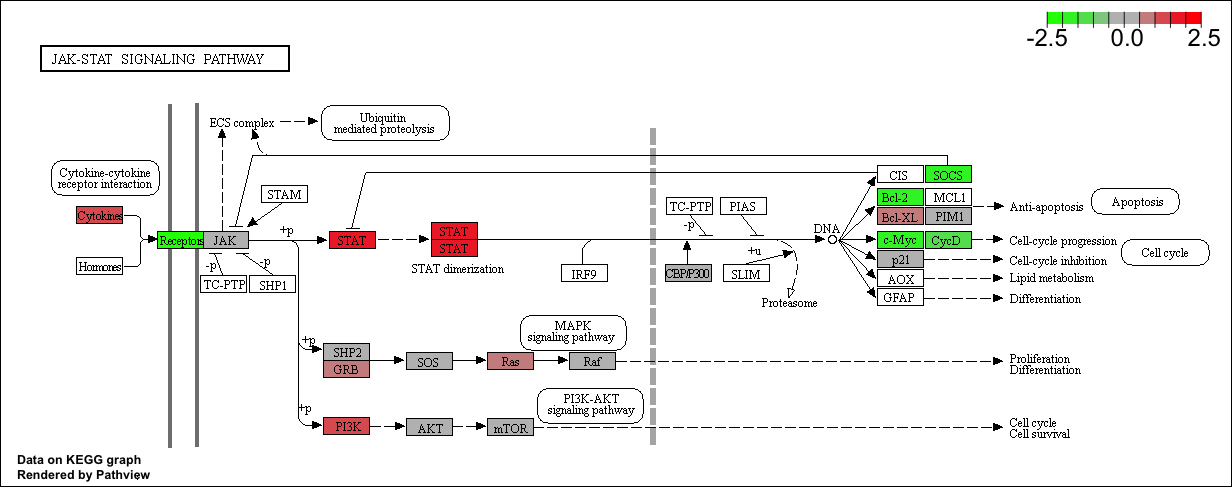
For each KEGG pathway, genes within the panel are mapped to the pathway and differential expression information is overlaid on the protein-based KEGG pathway image. Pathway nodes shown in white have no genes in the panel that map to them. Pathway nodes in grey have corresponding genes in the panel, however no significant differential expression is observed. Nodes in green denote downregulation relative to the selected baseline, whereas nodes in red denote upregulation relative to the selected baseline.
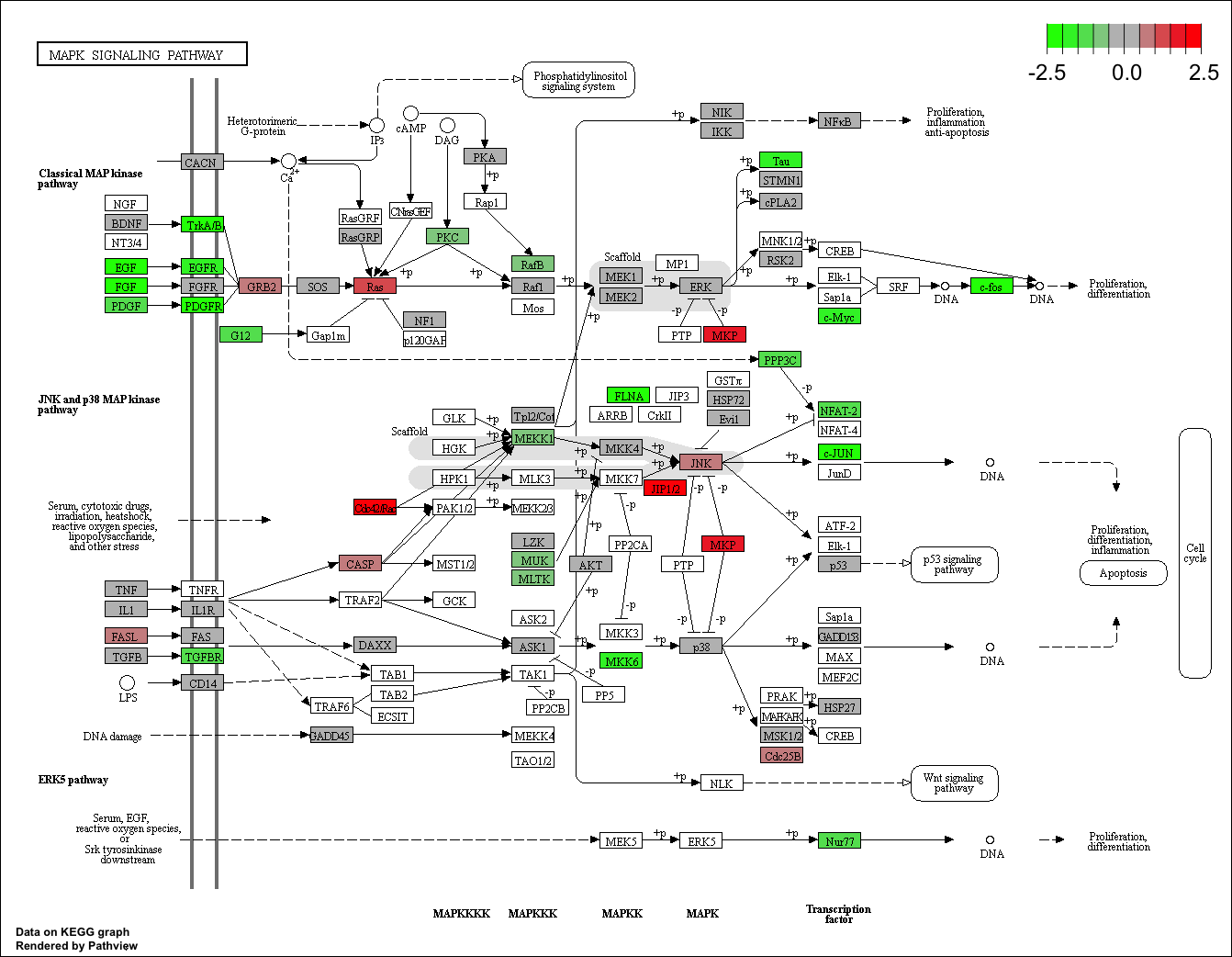
For each KEGG pathway, genes within the panel are mapped to the pathway and differential expression information is overlaid on the protein-based KEGG pathway image. Pathway nodes shown in white have no genes in the panel that map to them. Pathway nodes in grey have corresponding genes in the panel, however no significant differential expression is observed. Nodes in green denote downregulation relative to the selected baseline, whereas nodes in red denote upregulation relative to the selected baseline.
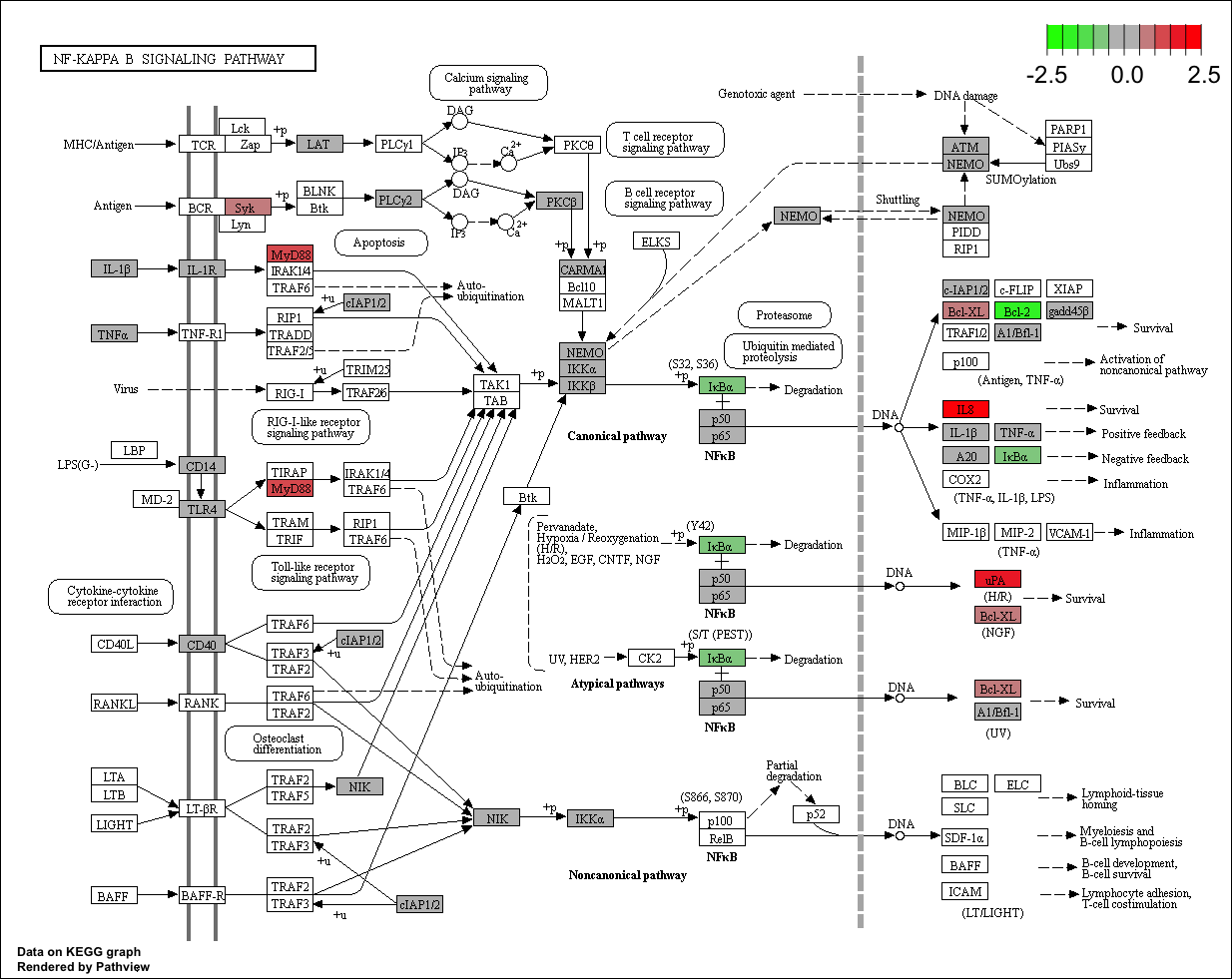
For each KEGG pathway, genes within the panel are mapped to the pathway and differential expression information is overlaid on the protein-based KEGG pathway image. Pathway nodes shown in white have no genes in the panel that map to them. Pathway nodes in grey have corresponding genes in the panel, however no significant differential expression is observed. Nodes in green denote downregulation relative to the selected baseline, whereas nodes in red denote upregulation relative to the selected baseline.
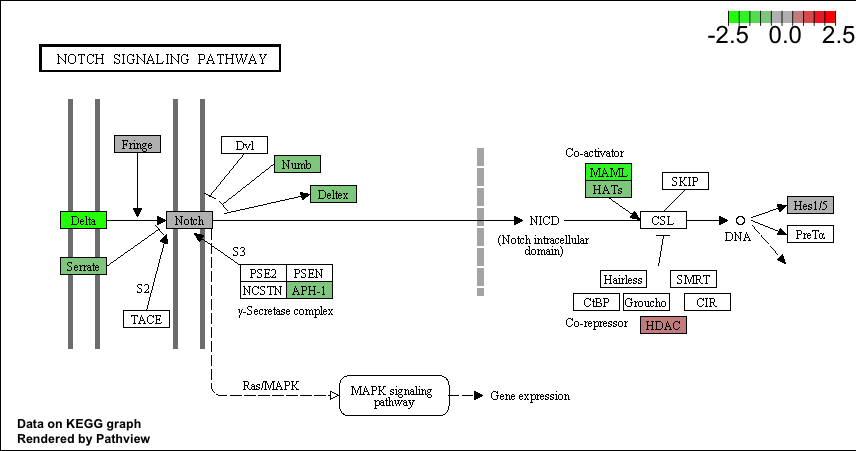
For each KEGG pathway, genes within the panel are mapped to the pathway and differential expression information is overlaid on the protein-based KEGG pathway image. Pathway nodes shown in white have no genes in the panel that map to them. Pathway nodes in grey have corresponding genes in the panel, however no significant differential expression is observed. Nodes in green denote downregulation relative to the selected baseline, whereas nodes in red denote upregulation relative to the selected baseline.
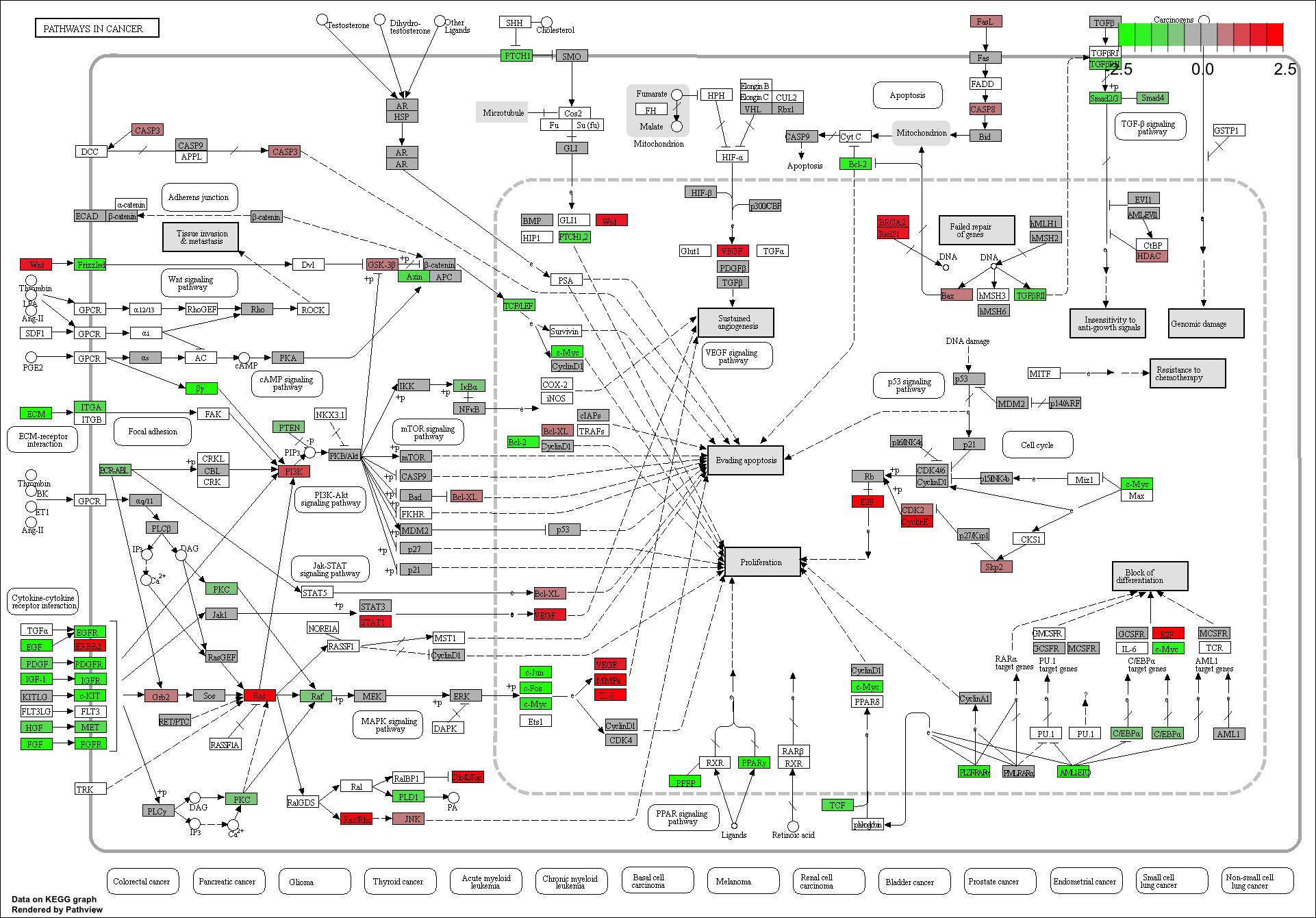
For each KEGG pathway, genes within the panel are mapped to the pathway and differential expression information is overlaid on the protein-based KEGG pathway image. Pathway nodes shown in white have no genes in the panel that map to them. Pathway nodes in grey have corresponding genes in the panel, however no significant differential expression is observed. Nodes in green denote downregulation relative to the selected baseline, whereas nodes in red denote upregulation relative to the selected baseline.
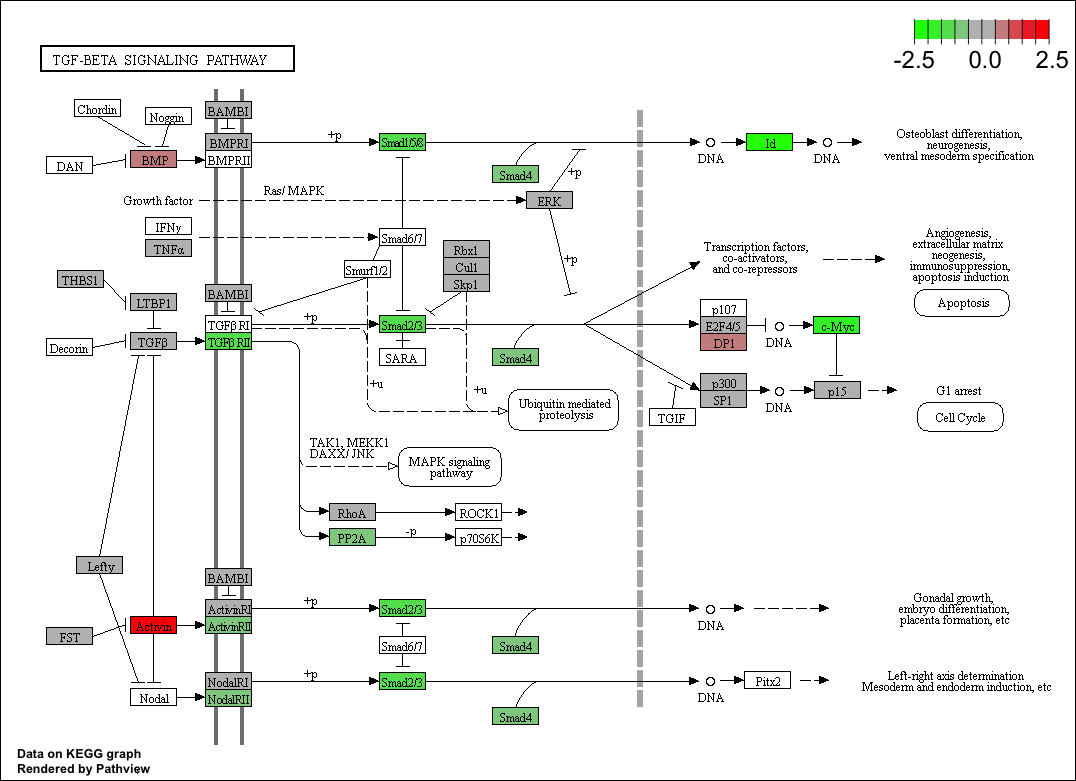
For each KEGG pathway, genes within the panel are mapped to the pathway and differential expression information is overlaid on the protein-based KEGG pathway image. Pathway nodes shown in white have no genes in the panel that map to them. Pathway nodes in grey have corresponding genes in the panel, however no significant differential expression is observed. Nodes in green denote downregulation relative to the selected baseline, whereas nodes in red denote upregulation relative to the selected baseline.
Genes previously shown to be characteristic of various immune cell populations are used to measure these populations' abundance. QC plots explore the validity of each cell type's measurements, Summary plots explore the joint behavior of cell types, and Covariates plots compare cell type measurements to covariates. In addition to raw cell type abundance measurements, relative abundances measuring various contrasts between cell types are reported.
- QC
- Summary
- Covariates
- B-cells
- Cytotoxic cells
- Neutrophils
QC Plot for Cell Type Measurements: B-cells
More Plot Information
QC Plot for Cell Type Measurements: B-cells
Normalized expression of the genes characteristic of B-cells. If a cell type's characteristic genes are specific to the cell type and stably expressed within it, they will be strongly correlated with a slope of 1. Substantial departures from this pattern indicate noisier quantification of cell type abundance.
QC Plot for Cell Type Measurements: Cytotoxic cells
More Plot Information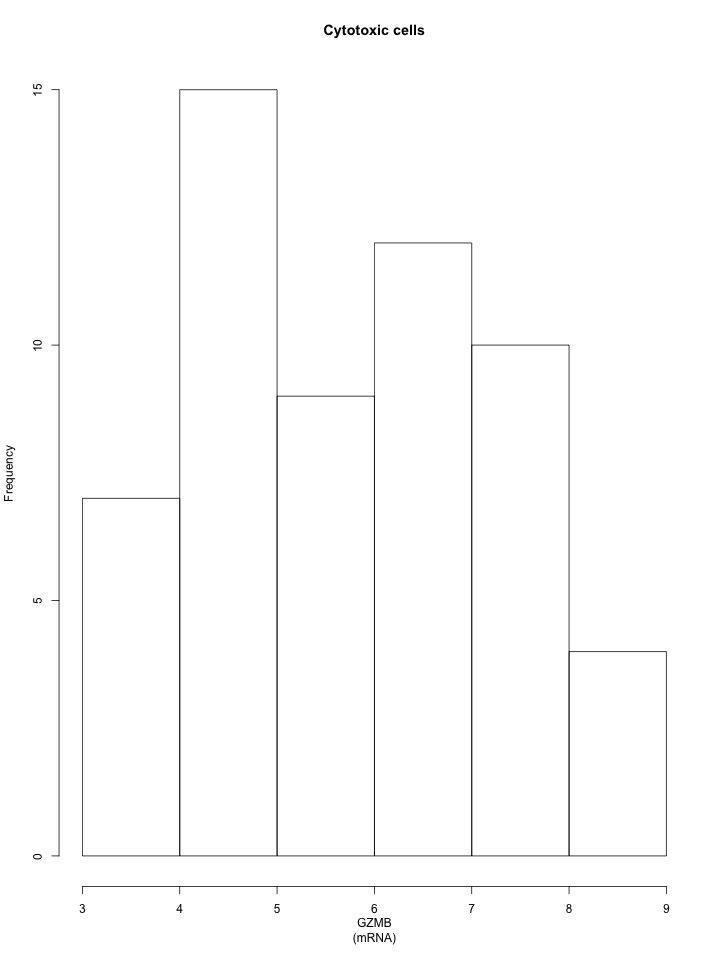
QC Plot for Cell Type Measurements: Cytotoxic cells
Normalized expression of the genes characteristic of Cytotoxic cells. If a cell type's characteristic genes are specific to the cell type and stably expressed within it, they will be strongly correlated with a slope of 1. Substantial departures from this pattern indicate noisier quantification of cell type abundance.
QC Plot for Cell Type Measurements: Neutrophils
More Plot Information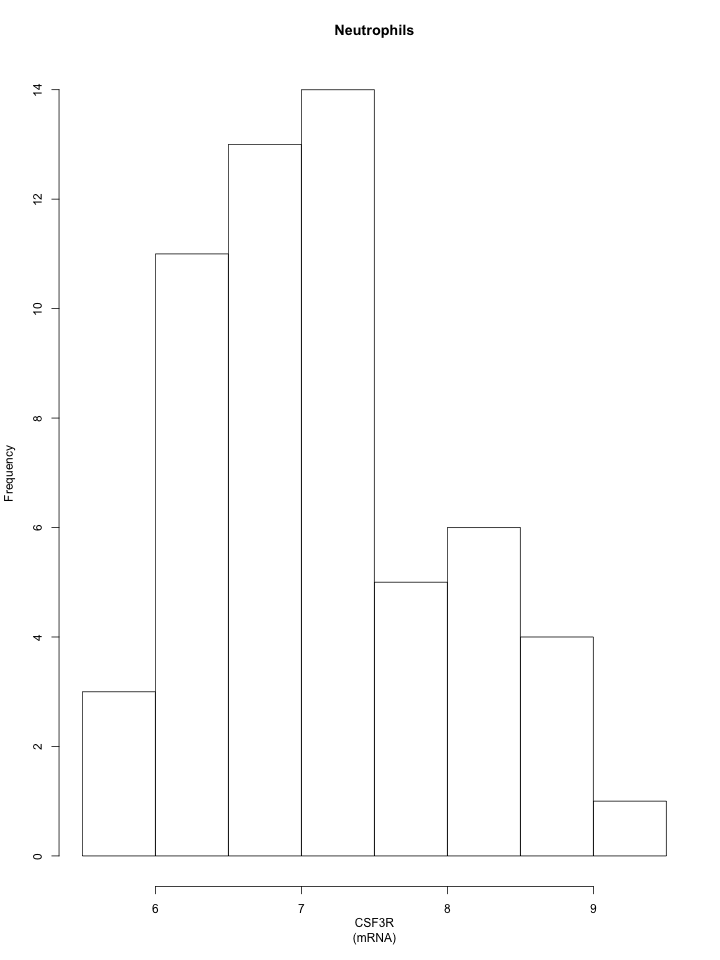
QC Plot for Cell Type Measurements: Neutrophils
Normalized expression of the genes characteristic of Neutrophils. If a cell type's characteristic genes are specific to the cell type and stably expressed within it, they will be strongly correlated with a slope of 1. Substantial departures from this pattern indicate noisier quantification of cell type abundance.
- Summary
- Cytotoxic cells
- Neutrophils
- B-cells
Heatmap of Raw cell type measurements
More Plot Information Download raw cell type measurements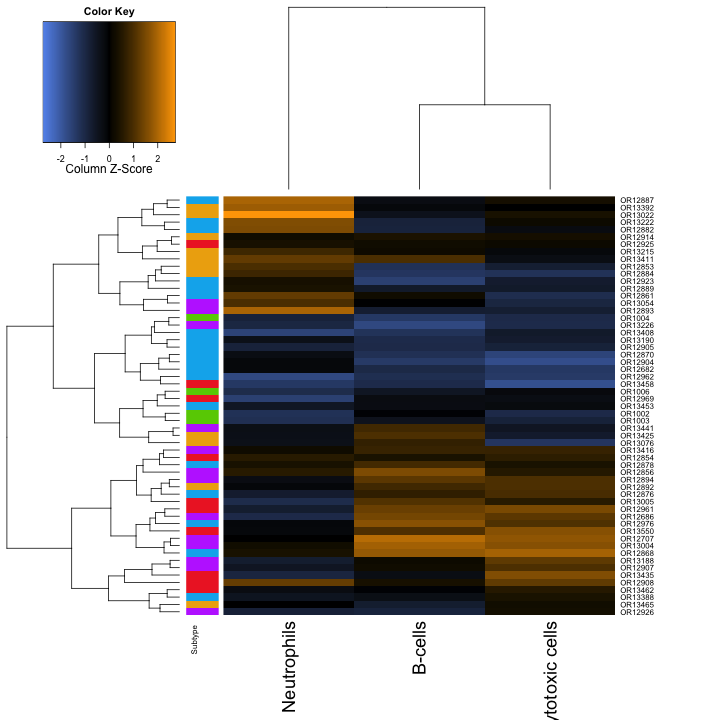
Heatmap of Raw cell type measurements
Heatmap showing raw abundance of immune cell types. Orange indicates high abundance; blue indicates low abundance. Note that our methods do not support the conclusion that one cell type is more abundant than another. Rather, they support the claim that a given cell type is more abundant in one sample than in another.
Heatmap of Correlation Matrix of Raw cell type measurements
More Plot Information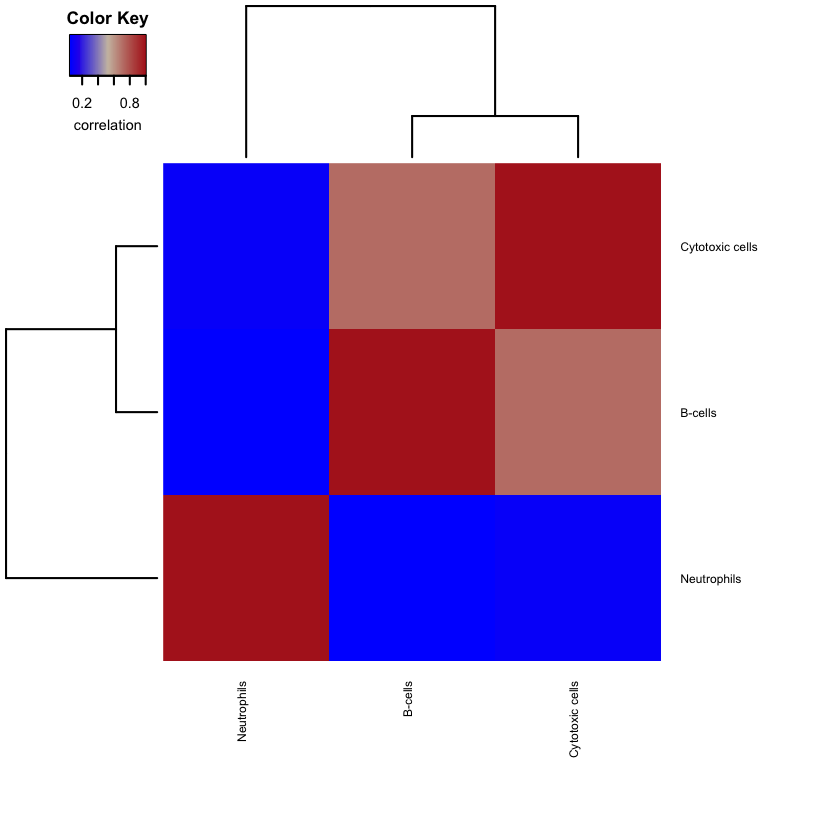
Heatmap of Correlation Matrix of Raw cell type measurements
Heatmap showing the correlation matrix of raw immune cell abundance. Red and blue indicate positive and negative correlation, respectively.
Cytotoxic cells measurements vs. other cell type measurements
More Plot Information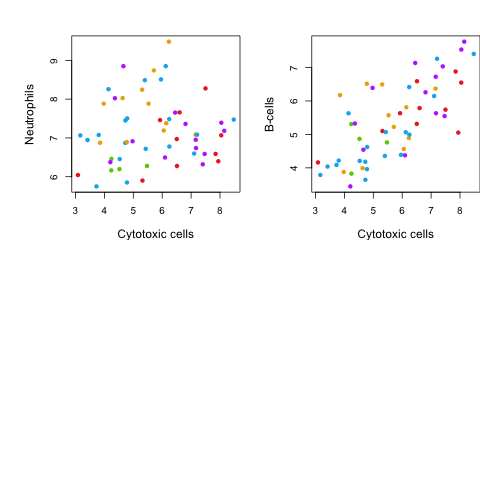
Cytotoxic cells measurements vs. other cell type measurements
Each panel plots Cytotoxic cells against another raw abundance measurements. Points are colored by Subtype.
Neutrophils measurements vs. other cell type measurements
More Plot Information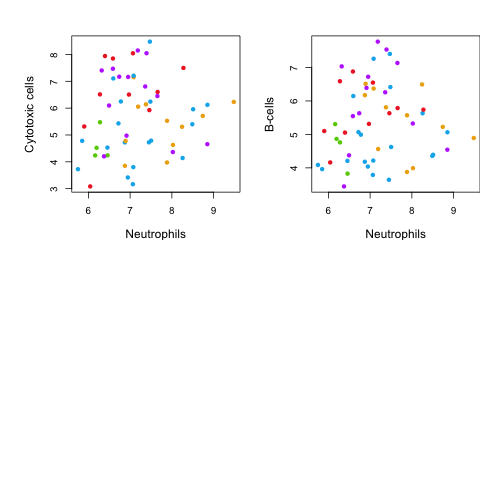
Neutrophils measurements vs. other cell type measurements
Each panel plots Neutrophils against another raw abundance measurements. Points are colored by Subtype.
B-cells measurements vs. other cell type measurements
More Plot Information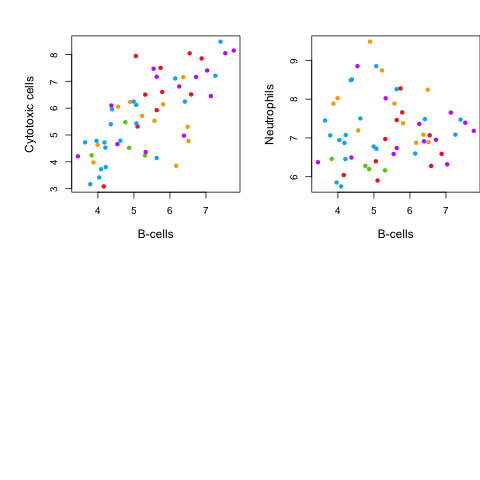
B-cells measurements vs. other cell type measurements
Each panel plots B-cells against another raw abundance measurements. Points are colored by Subtype.
- Summary
- Cytotoxic cells
- Neutrophils
- B-cells
Raw cell type measurements vs. Subtype
More Plot Information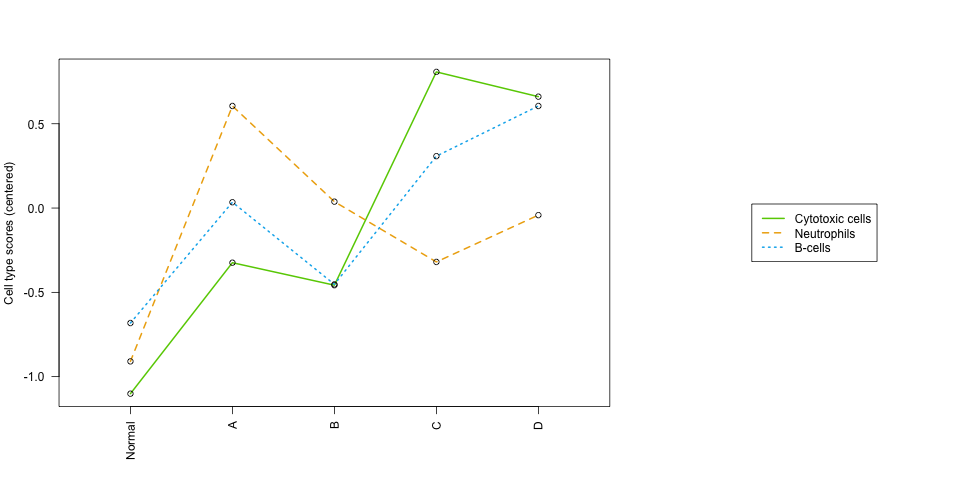
Raw cell type measurements vs. Subtype
Plots the raw cell type abundance measurements against Subtype.
Cytotoxic cells Measurement vs. Subtype
More Plot Information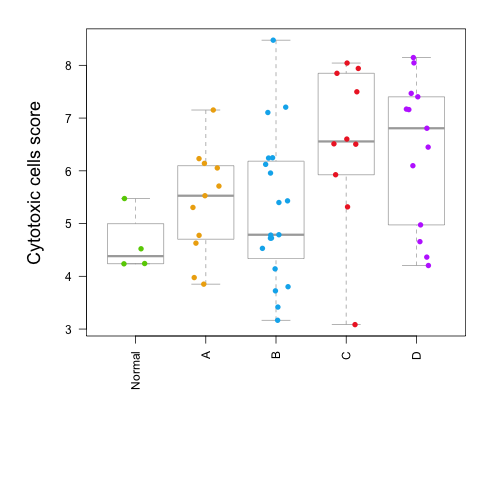
Cytotoxic cells Measurement vs. Subtype
Plots Cytotoxic cells measurements against Subtype.
Neutrophils Measurement vs. Subtype
More Plot Information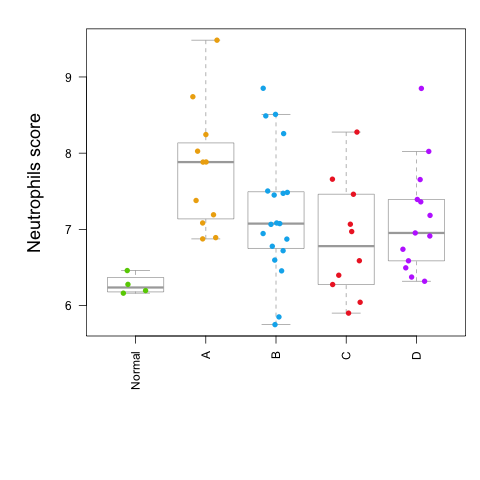
Neutrophils Measurement vs. Subtype
Plots Neutrophils measurements against Subtype.
B-cells Measurement vs. Subtype
More Plot Information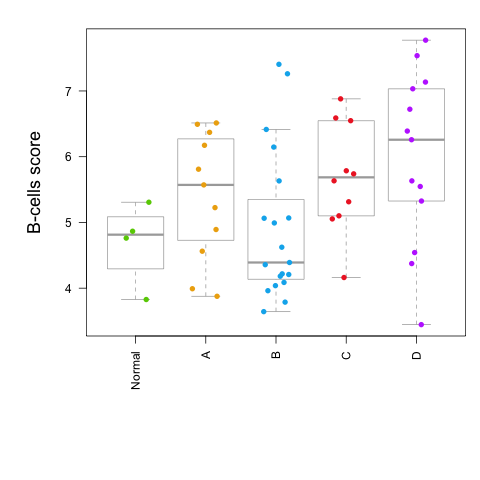
B-cells Measurement vs. Subtype
Plots B-cells measurements against Subtype.
Choose a Cell Type:
Choose a Cell Type:
Choose a Cell Type:
This module provides descriptive plots for up to 15 user-selected genes relative to user-defined covariates of interest. Depending on whether a single gene or multiple genes are selected, bivariate or multivariate analyses plots are generated. Furthermore, the module provides trend plots when trending covariates are provided.
- Univariate Plots
- Correlation Plots
- PCA Biplots
- Parallel Coordinate Plots
- Interaction Network
Univariate Plots
More Plot Information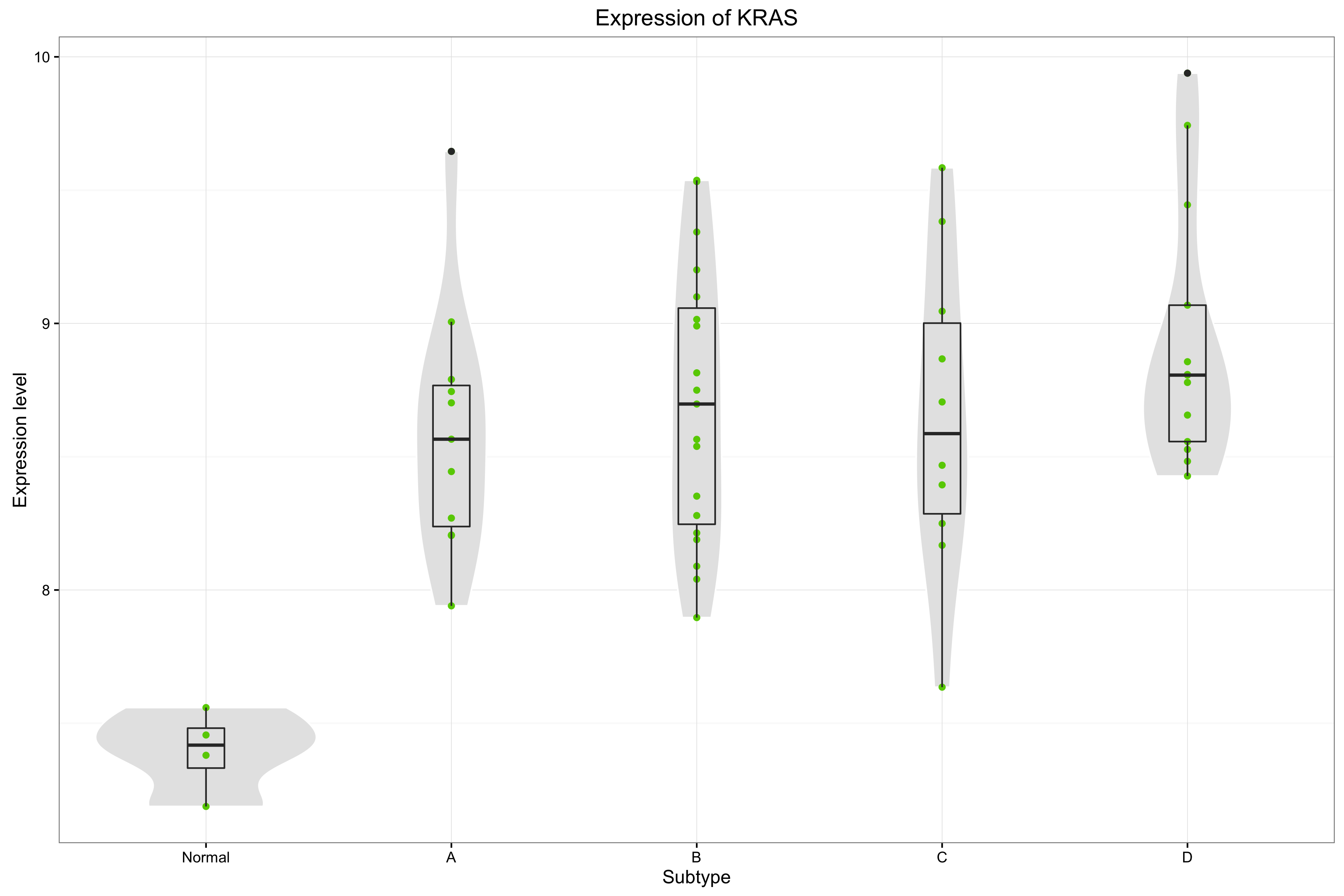
Univariate Plots
Scatter or box/voilin plot visualizes the association of each selected gene relative to the covariate of interest.
Univariate Plots
More Plot Information
Univariate Plots
Scatter or box/voilin plot visualizes the association of each selected gene relative to the covariate of interest.
Univariate Plots
More Plot Information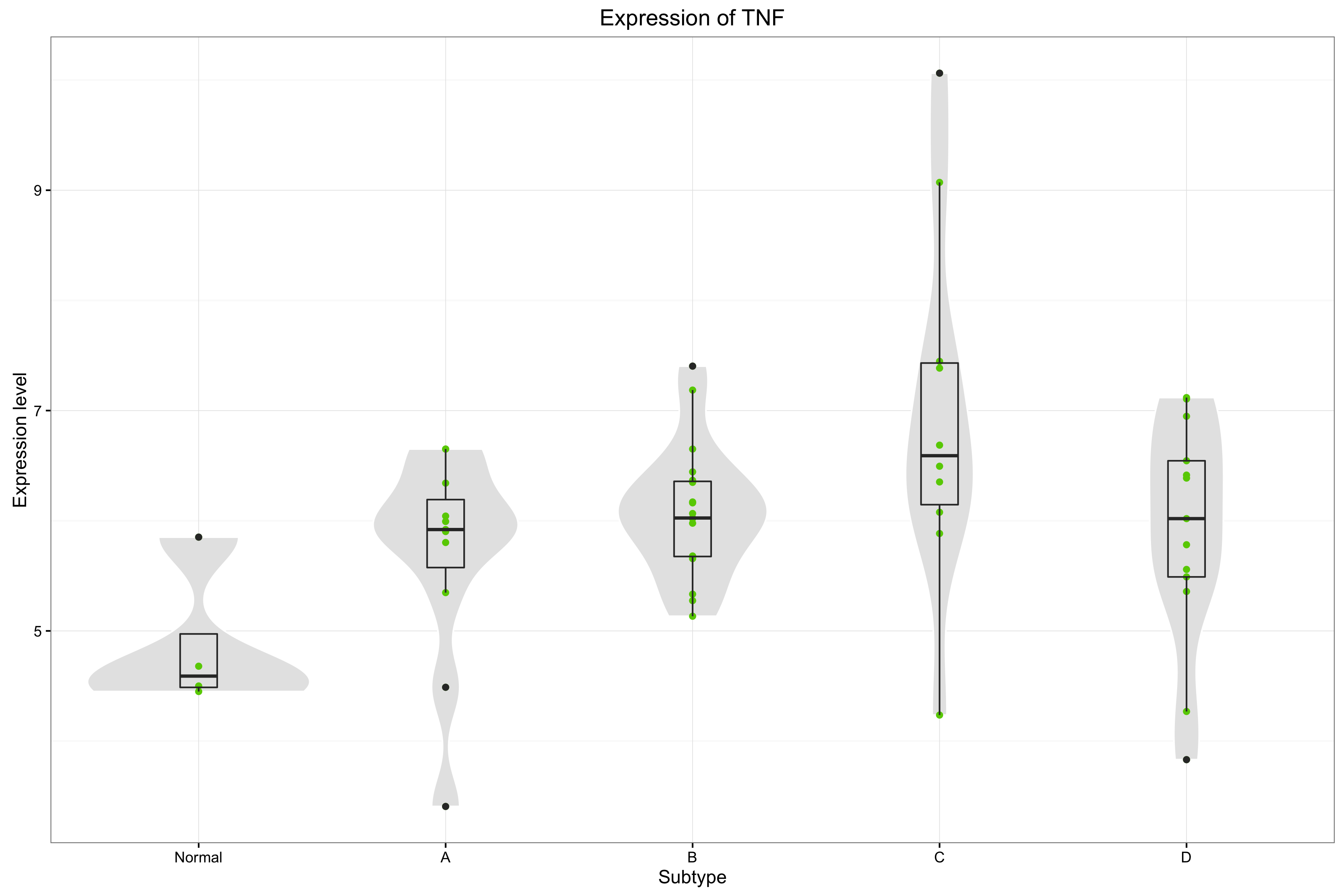
Univariate Plots
Scatter or box/voilin plot visualizes the association of each selected gene relative to the covariate of interest.
Univariate Plots
More Plot Information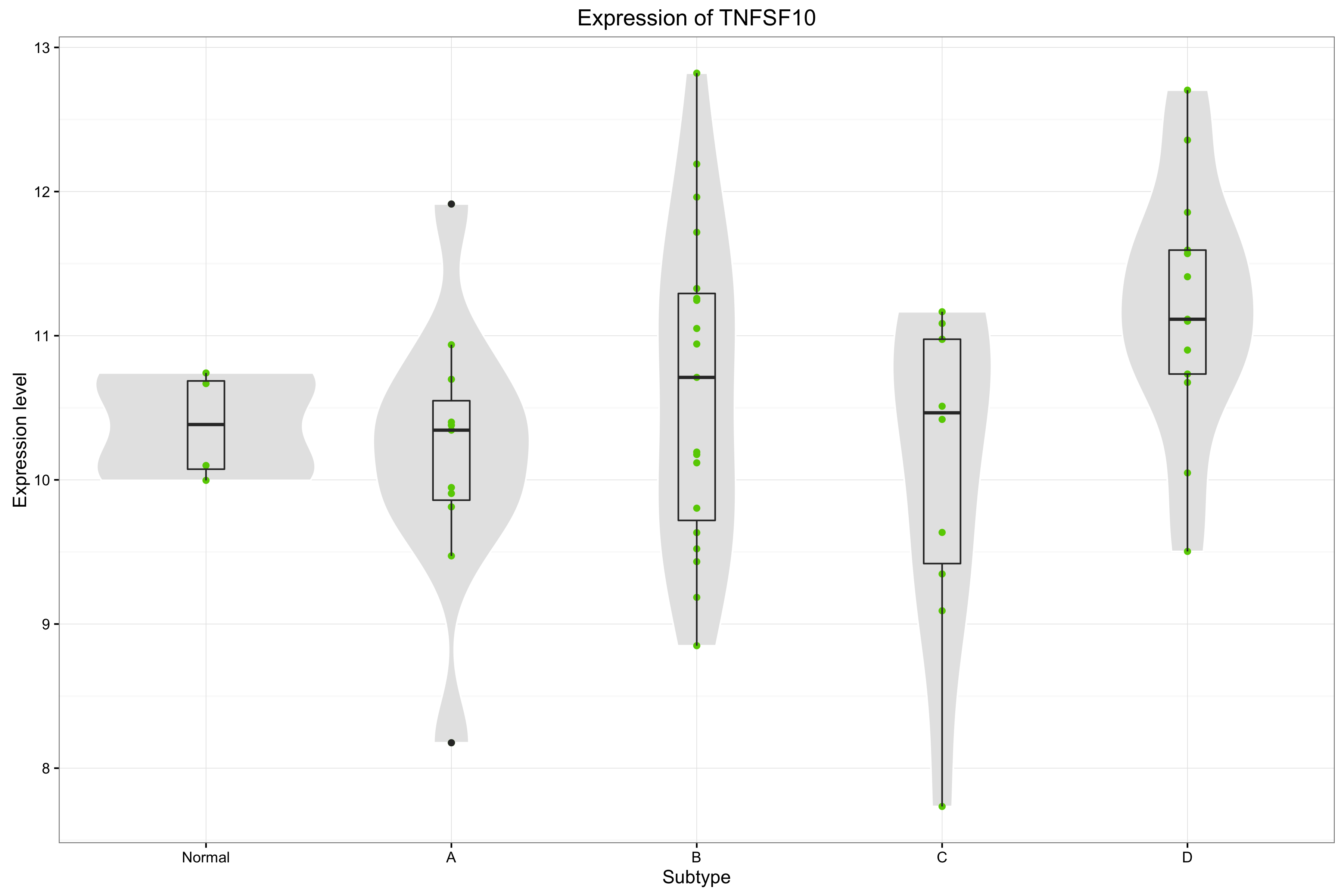
Univariate Plots
Scatter or box/voilin plot visualizes the association of each selected gene relative to the covariate of interest.
Univariate Plots
More Plot Information
Univariate Plots
Scatter or box/voilin plot visualizes the association of each selected gene relative to the covariate of interest.
Univariate Plots
More Plot Information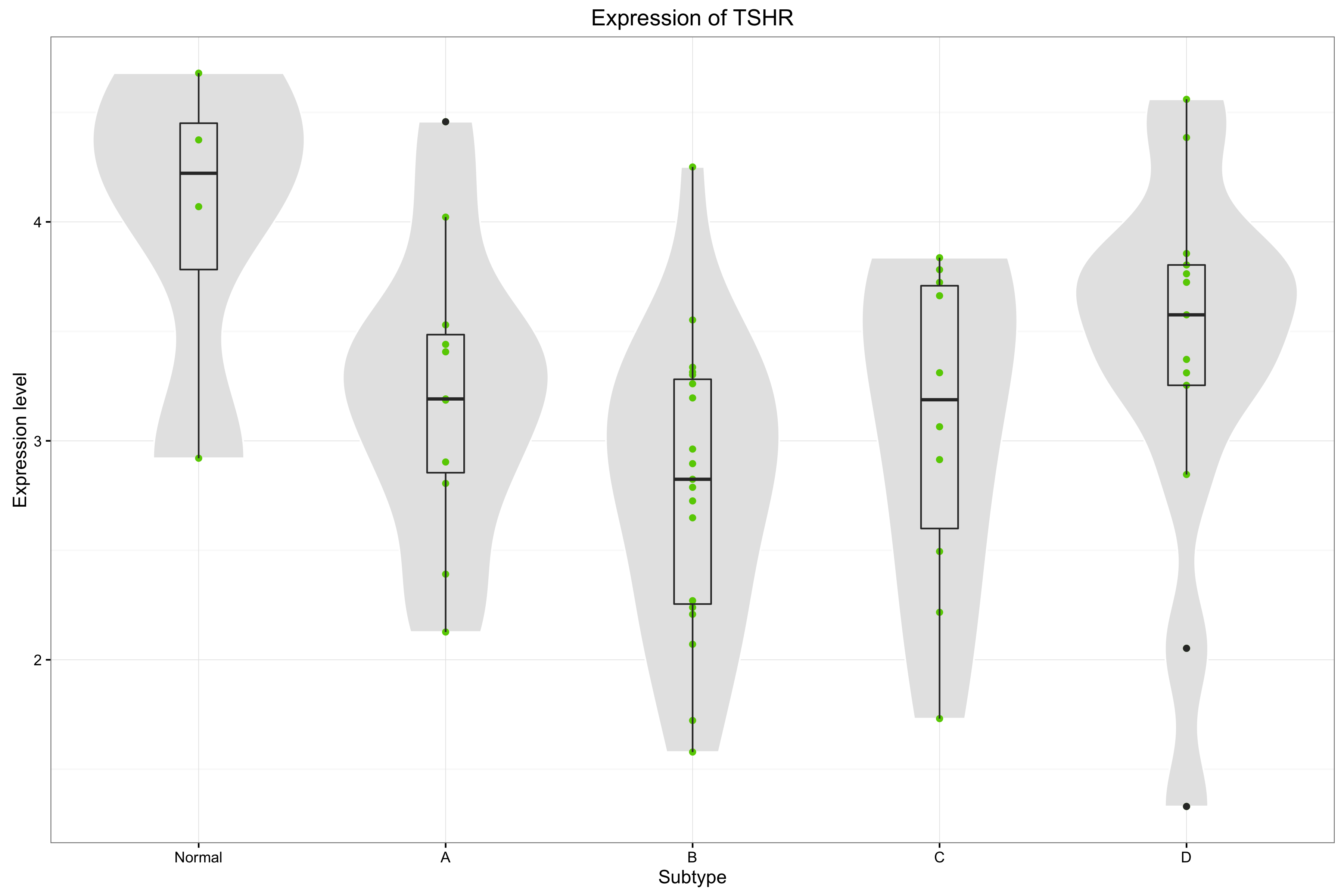
Univariate Plots
Scatter or box/voilin plot visualizes the association of each selected gene relative to the covariate of interest.
Correlation Plots
More Plot Information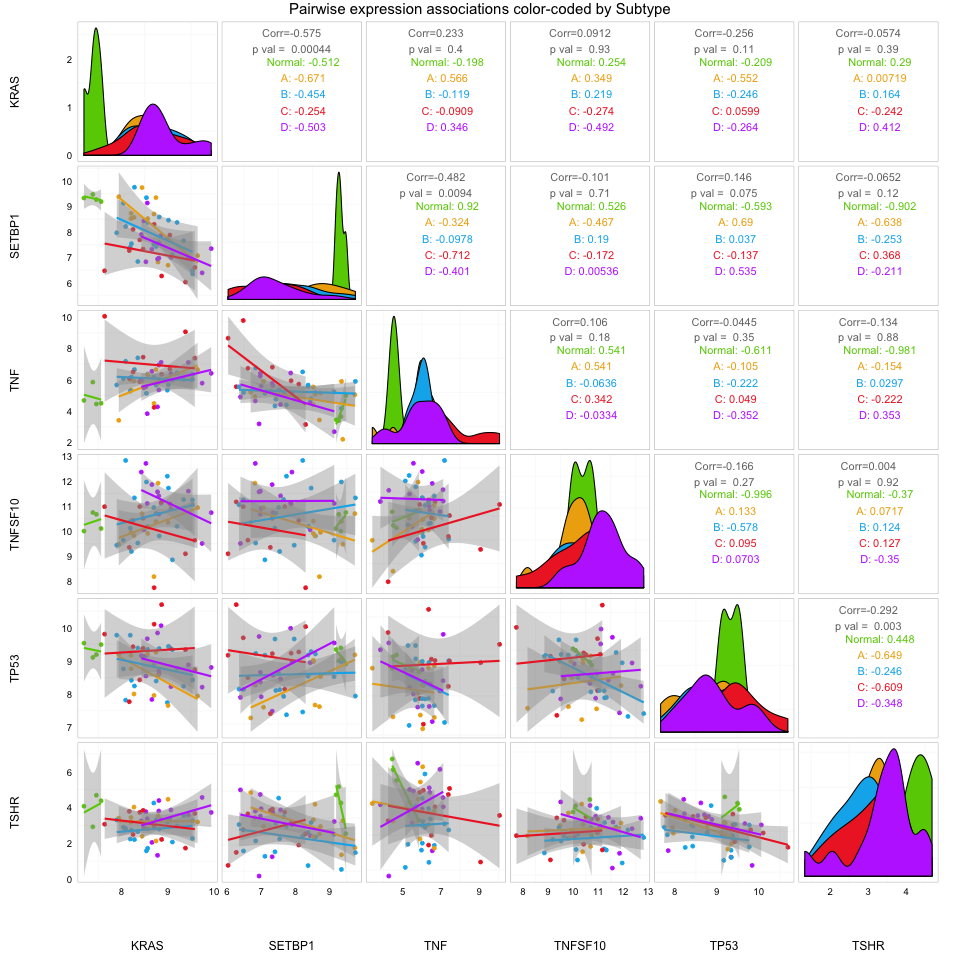
Correlation Plots
This plot visualizes pairwise co-expression of a set of probes. The diagonal element shows the univariate expression distribution of row/column probe. When sample annotation is provided the data is stratified and color-coded by sample annotation.
PCA Biplots
More Plot Information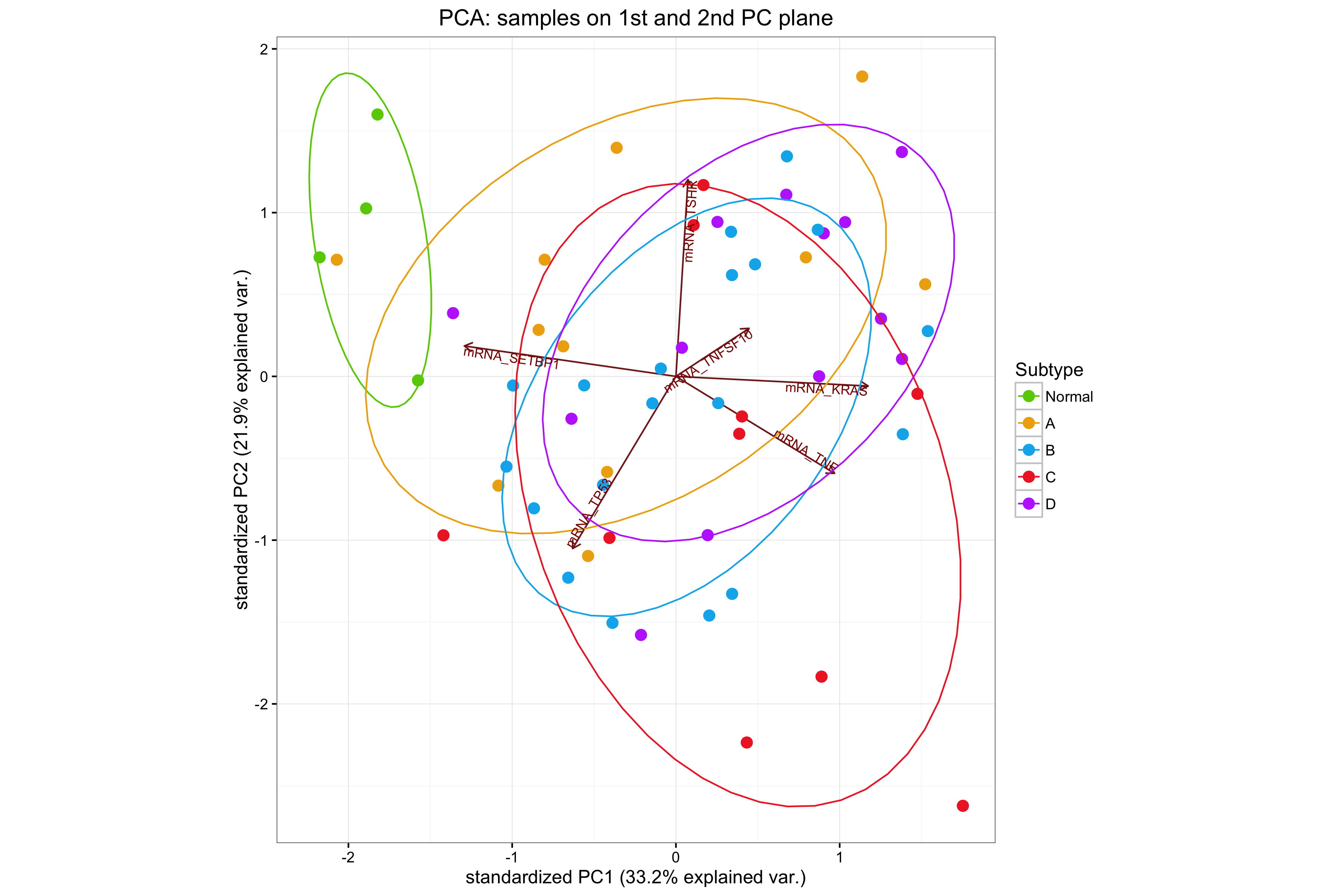
PCA Biplots
This plot visualizes the data on the first three PC axes while also showing the projection of the original axes of the data (i.e. the genes) onto the PC planes. When sample annotation is provided, the data is stratified and color-coded by sample annotaiton.
PCA Biplots
More Plot Information
PCA Biplots
This plot visualizes the data on the first three PC axes while also showing the projection of the original axes of the data (i.e. the genes) onto the PC planes. When sample annotation is provided, the data is stratified and color-coded by sample annotaiton.
PCA Biplots
More Plot Information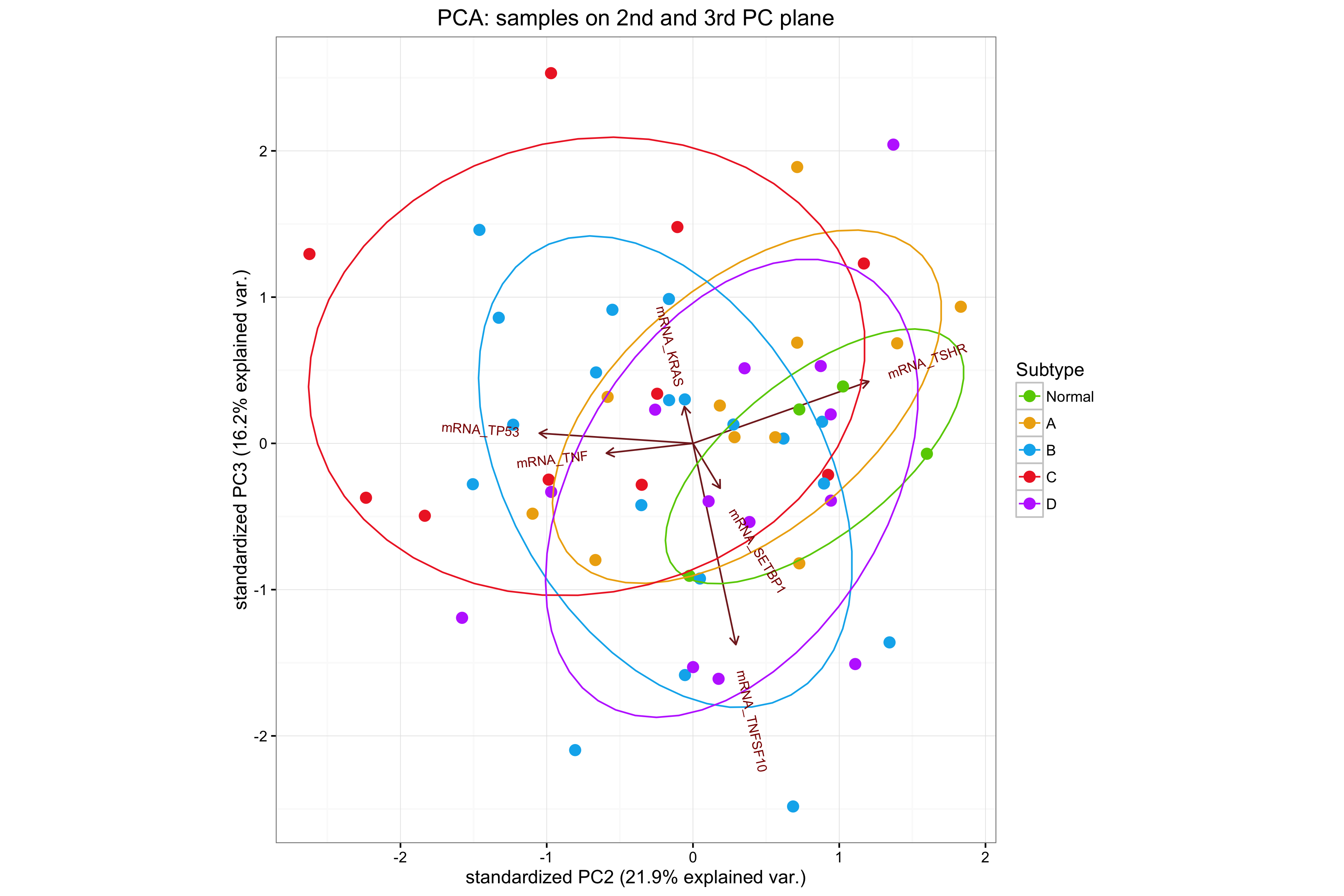
PCA Biplots
This plot visualizes the data on the first three PC axes while also showing the projection of the original axes of the data (i.e. the genes) onto the PC planes. When sample annotation is provided, the data is stratified and color-coded by sample annotaiton.
Parallel Coordinate Plots
More Plot Information
Parallel Coordinate Plots
This plot visualizes up/down regulation of a set of probes in defined subsets relative to one another. Here, expressions are scaled for each genes across all samples.
Interaction Network
More Plot Information
Interaction Network
This plot visualizes a conditional dependency network among the selected probes that best describes the observed data. An edge between two nodes implies that after accounting for all other nodes, there remains an association between the connected nodes.
Summary of the options that were chosen when running this analysis.
Analysis Details
Analysis name: New Analysis
Location of results: //Users//JayM//Desktop//untitled folder
File type of plots: png
Sample Annotation Details
Unique sample identifier: Sample.Name
Covariate1: Subtype; Variable Type: categorical; Reference Level: Normal
Gene Annotation Details
Column defining probe set membership: Probe.Annotation
Probe annotation column giving cell type-specific probes: Cell.Type
Normalization Details
Perform normalization on: mRNA
Number of normalization probes: mRNA: Dynamic
Pathway Scoring Analysis Details
Perform pathway scoring analysis: TRUE
Covariates to include in plots: Subtype
Differential Expression Analysis Details
Perform differential expression testing: TRUE
Predictors: Subtype
Confounders: none
P-value adjustment: BY
Run gene set analysis TRUE
Pathview Details
Display results using Pathview: TRUE
Color Pathview pathview plots by: Fold-change
P-value threshold: 0.05
Additional KEGG IDs: none
Immune Cell Type Profiling Details
Perform immune cell type profiling: TRUE
Covariates to include in plots: Subtype
Use all cell type genes or dynamically select a subset:
P-value threshold for reporting a cell type's results: 1
Show results at the level of raw cell type abundance: TRUE
Show results at the level of relative cell type abundance: TRUE
Use default contrasts for calculating relative cell type abundance: TRUE
Probe Descriptive Analysis Details
Run Probe Descriptive analysis: TRUE
probe name 1 : KRAS-mRNA
probe name 2 : SETBP1-mRNA
probe name 3 : TNF-mRNA
probe name 4 : TNFSF10-mRNA
probe name 5 : TP53-mRNA
probe name 6 : TSHR-mRNA
Grouping variable 1 : Subtype
Interval ID: none
Series ID: none
Stratifying variable: none
Generate Interaction Network: Yes
Adjust Interaction Network: Subtype
Related Analytes Analysis Details
Related Analytes Analysis: FALSE
Warning: the following cell types in the cell types contrast file were not found in the probe annotation file's cell type column:
CD45,DC,Exhausted CD8,Macrophages,Mast cells,NK CD56dim cells,NK cells,T-cells,Th1 cells,Treg,CD8 T cells
Therefore the following contrasts have been discarded:
Total.TILs
B.cells.vs..TILs
Cytotoxic.cells.vs..TILs
DC.vs..TILs
Exhausted.CD8.vs..TILs
Macrophages.vs..TILs
Mast.cells.vs..TILs
Neutrophils.vs..TILs
NK.CD56dim.cells.vs..TILs
NK.cells.vs..TILs
T.cells.vs..TILs
Th1.cells.vs..TILs
Treg.vs..TILs
CD8.T.cells.vs..TILs
CD8.vs..Exhasuted.CD8
CD8.vs..Treg
CD4.vs..T.cells
Warning: no cell type contrasts remained with valid data. Only raw cell type abundance will be reported.
